

Become a B2B SaaS Ads Expert
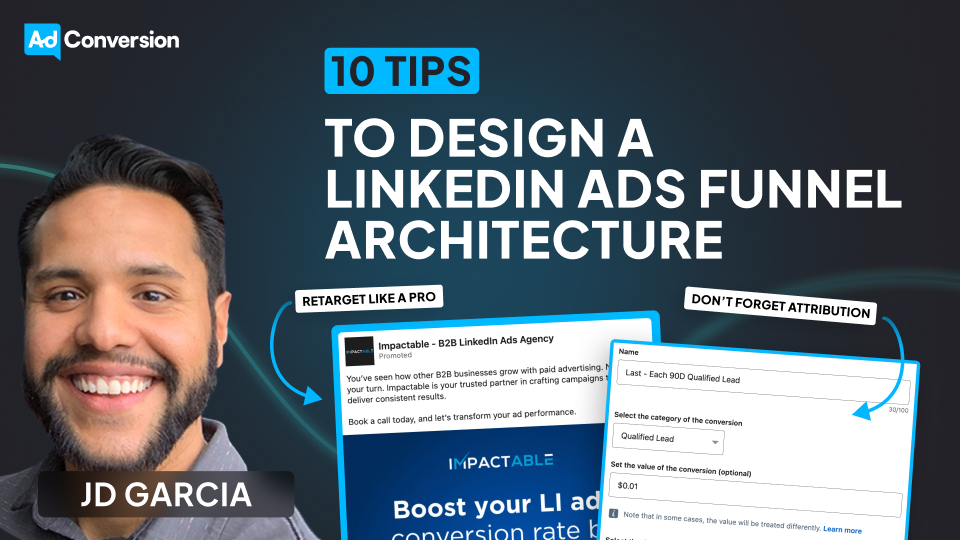
10 Tips to Design an Effective LinkedIn Ads Funnel Architecture
Over the past 5 years, I’ve helped hundreds of B2B SaaS companies develop a strong LinkedIn Ads funnel architecture.
This has allowed them to show up in front of the right audiences, with the right messages, at the right time, ultimately leading to more pipeline and revenue.
I’ll be breaking down my entire methodology below.
Let’s dive in.👇
TABLE OF CONTENTS
- Tip #1: Outline your variables
- Tip #2: Whiteboard your funnel
- Tip #3: Set clear campaign goals
- Tip #4: Create ads that match the funnel stage
- Tip #5: Don’t forget attribution
- Tip #6: Get efficient before getting fancy
- Tip #7: Retarget like a pro
- Tip #8: Test smart, not random
- Tip #9: Keep tabs on performance
- Tip #10: Learn, improve, repeat
Tip #1: Outline your variables
Before you do anything else, you want to outline all your variables.
What audiences do you need to target? Are they actually active on LinkedIn or will you have to try with a different platform? How large are your audience sizes? How much budget do you have? What content do you have available to you and what gaps do you currently have?
You need to put all those pieces on the table to understand if LinkedIn is a viable channel for you in the first place.
If you have minimal content, a small budget, and an audience that isn’t very active on LinkedIn, you’re setting yourself up for failure.

Tip #2: Whiteboard your funnel
Once you have your pieces on the table, you can use Figma, Miro, or simply pen and paper (my personal preference) to start mapping out your funnel.
For example, let’s say you’ve created your audience and have identified that your TAM is around half a million people. But maybe your ideal ICP — which you want to start targeting with ads — is only 65K people.
Now, you need to ask yourself the question: what type of content would this audience find interesting and push them further down the funnel?
Maybe, to start, they’d want to see something funny related to a pain point they’re having. Next, they might want to see more content related to this pain point, in addition to product videos and testimonials. Eventually, they might be open to requesting a demo.
Ultimately, you want to map out the journey that you want your prospects to take; even if they don’t follow this exact journey — which they probably won’t — doing this exercise forces you to have empathy for them, and your content ecosystem will be more likely to move the needle.
Tip #3: Set clear campaign goals
A goalie, defender, midfielder, and striker all have different roles and shouldn’t be judged by the same criteria.
The same is true for ad campaigns.
Top of funnel, bottom of funnel, cross-sell, upsell, and pipeline acceleration campaigns are completely different, and need to be judged by completely different metrics.
Before spending any money, it’s important to clearly define the KPIs for your campaigns.
For example, for a top of funnel campaign to a cold audience, your goal might be to maximize engagement, and you might be looking at metrics such as engagement rate and cost per engagement.
For a bottom of the funnel campaign, you might be assessing performance by looking at metrics such as cost per demo, cost per SQL, or cost per opportunity.
Defining these key metrics is essential — if you fail to define them, your leadership team might ask you to pause all your top of funnel/awareness campaigns because they haven’t generated enough demo requests 😥
Tip #4: Create ads that match the funnel stage
A lot of people these days say things like the B2B buyer’s journey isn’t linear and the funnel isn’t actually real, and sure, that’s true, but it’s still meaningful to match the content/offer to the level of awareness of your prospect.
Someone who visited your LinkedIn company page 11 months ago probably shouldn’t be seeing the same content as someone who visited your pricing page yesterday.
With the ads in the cold layer, you’re showing up unannounced in someone’s feed, and you’re simply looking to pique their curiosity.
Once they’ve engaged with you multiple times, you can start being a bit more direct (promoting demos, trials, sign ups, etc.).
Aside from the funnel stage, you also might want to segment your ads by persona — for example, CFOs, salespeople, and product people will all care about different things, and should be seeing customized messaging based on their needs and concerns.
One caveat: you have to be careful to not make your audience too small.
If you segment by region, funnel stage, and persona, you may not have a large enough audience size to run a campaign.
If this happens, you’ll have to triage and decide which targeting criteria to prioritize.
Tip #5: Don’t forget attribution
This might seem basic but it has to be said.
You don’t need a super complex attribution setup, but you do want to have an idea of what campaigns are driving an incremental lift in pipeline.
If you don’t have access to an attribution tool like Dreamdata or HockeyStack, here’s a simple way to start doing this:
For high-value conversions (ie qualified lead, demo request, or opportunity), in addition to your standard last touch/last conversion event, set up a duplicate last touch/each conversion event, with a 90-day click/90-day view window and a very small value (ie 1 cent).

By doing this, you’ll find that some campaigns that you believed weren’t performing are actually driving — or at least influencing — a significant amount of conversions.
Aside from this, it’s a good idea to look at different sources to build a more complete picture of what’s working: in-platform attribution, your CRM, self-reported attribution, Gong call mentions, conversion API, the revenue attribution report, etc.
It’s also helpful to look at both directly attributed and blended pipeline quarter over quarter. If these numbers, along with your pipe-to-spend ratio, are consistently increasing, it’s a good indicator that your campaigns are working.
Tip #6: Get efficient before getting fancy
In order to be effective, you first need to be efficient.
I like using the example of a car: if you need to drive 50 miles, it’s going to be much more difficult if your oil hasn’t been changed, your tires are flat, and you only have a quarter tank of gas.
The same thing is true for LinkedIn Ads: using the LinkedIn audience network, enabling audience expansion, not leveraging exclusions, using too many exclusions, targeting too many people, not targeting enough people, using OR instead of AND or AND instead of OR, using the wrong campaign objective, choosing the wrong bid strategy, etc.
These are issues I see all the time, and though they may seem minor, they have a huge impact on overall performance.
You won’t hit your pipeline and revenue targets if you don’t pay attention to the smaller details.
Tip #7: Retarget like a pro
Effective retargeting requires a nuanced approach.
Prospects who have visited your site in the past 30 days are more likely to request a demo/book a call, so it’d be appropriate for them to see ads with a more direct CTA.
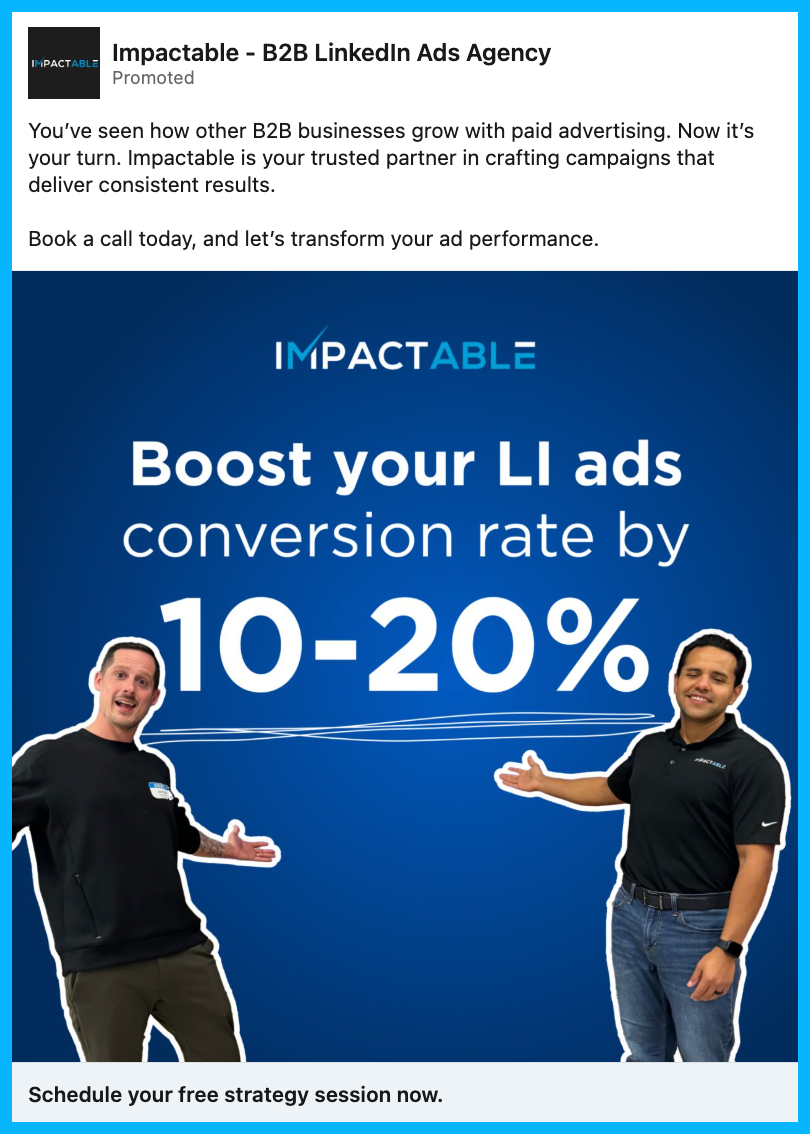
Prospects in your general 90-day remarketing audience might be considering different products/services, so case studies, testimonials, thought leadership, and other trust-building content might push them further down the funnel.
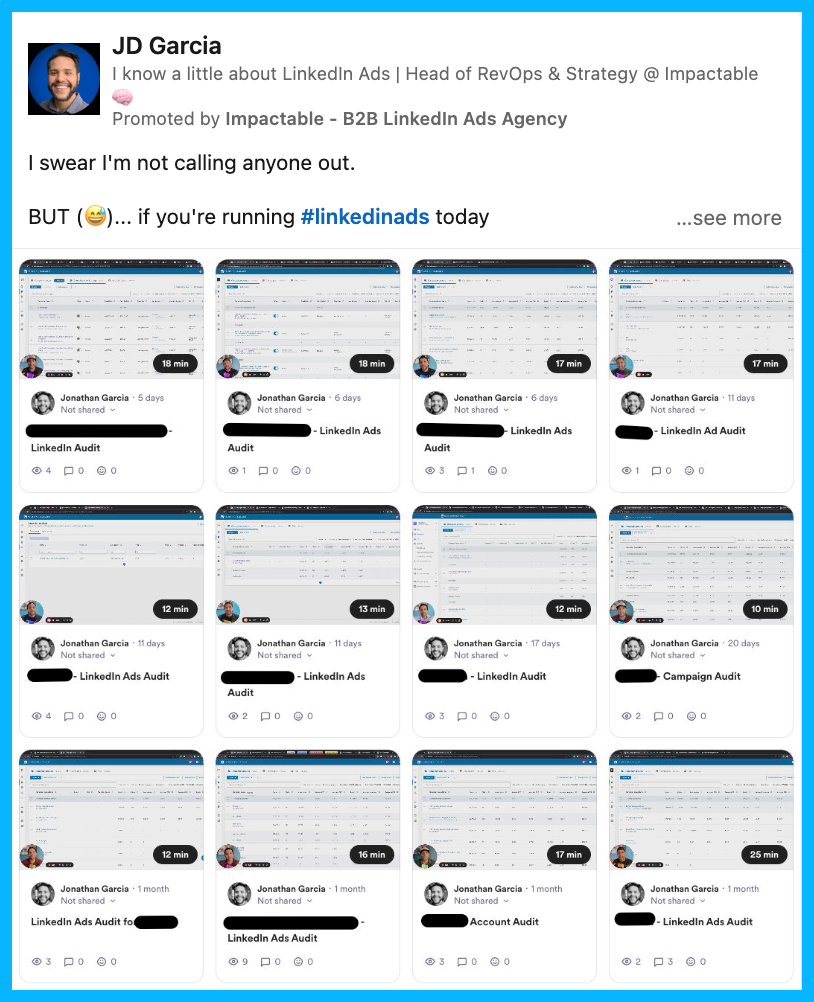
People in your 180-day remarketing audience may not be in-market anymore, but you can stay in front of them for a very low cost using different LinkedIn ad formats such as text and spotlight ads.
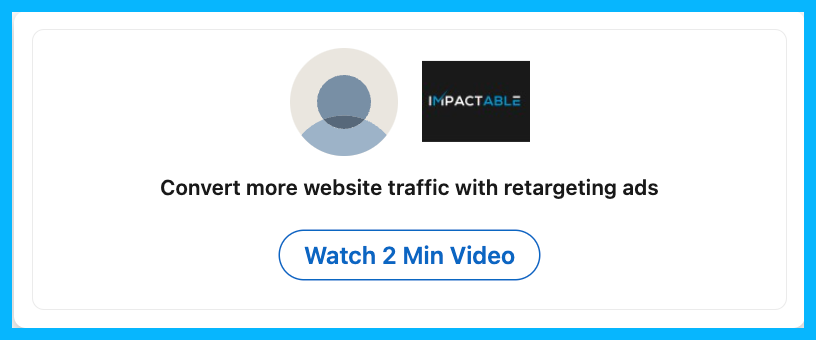
If the prospects in your 90 or 180-day remarketing audiences engage with your ads and visit your site, they’ll enter the 30-day remarketing audience and see more direct demo request/book a call ads.
If the prospects in the 30-day remarketing audience don’t engage with your demo ads, they’ll get pulled into the 90-day remarketing layer.
Ultimately, by creating this remarketing ecosystem, you’ll make sure you’re A) capitalizing on people who are in-market and B) staying top of mind with prospects who aren’t ready to buy just yet.
To learn exactly how to set up your retargeting audiences, take a look at this retargeting blueprint.
Tip #8: Test smart, not random
You should be constantly testing elements in your campaigns to maximize performance: different copy, pain points, landing pages, targeting criteria, etc.
But you want to make sure that all your tests are both meaningful and insightful.
For example, testing a blue creative vs. a red creative wouldn’t be meaningful; instead, you’d want to test more significant elements, e.g. testing one messaging angle vs. another, or testing a native audience vs. an ABM audience.
Also, it’s important to conduct proper A/B tests — they’re called A/B tests and not A/B/C/D/E/F/G tests for a reason 😅— to extract accurate insights from your experimentation. If you’re simultaneously testing copy, creatives, pain points, landing pages, and targeting, you’ll have no idea what led to an improvement in results.
Pro tip: To ensure that your tests are both meaningful and insightful, you can use this simple experimentation formula If we do X, I believe Y, as measured by Z.
Tip #9: Keep tabs on performance
This is another tip that might seem obvious, but is often overlooked.
If you’re testing campaigns with different audiences, you need to keep a close eye on which audience performs better.
If you’re testing two ads with different messaging angles, you need to see which ad has more engagement and a higher CTR.
If you’re testing two different landing pages, you need to see which page has the most engaged visits and conversions.
To be clear, I’m advocating for keeping a close eye on performance — not constantly tweaking things in your account.
If you’ve set your campaigns up strategically, you don’t need to be making changes every day, and want to give LinkedIn’s algorithm the time to optimize and learn.
Pro Tip: I typically recommend allowing an ad to spend around $100 before shutting it down — sometimes, an ad that starts out slow can end up being a top-performer.
Tip #10: Learn, improve, repeat
With ad campaigns, you never reach a final destination; in other words, your job is never finished.
If your ads performed well this quarter, you’ll need to find a way to improve performance the following quarter.
You’ll have to sit down and ask yourself:
1. What worked well that we should continue doing in the future?
2. What didn’t go well that we should pause moving forward?
3. Based on what we’ve learned, are there any new tests that could move the needle and improve results?
If you aren’t constantly improving, you’ll likely get left behind by the competition.
Hope you found this article helpful!
If you’re looking to learn more about LinkedIn Ads, check out these free LinkedIn Ads courses, that will teach you how to launch, optimize, and scale LinkedIn Ads campaigns effectively.
And if you have any questions about LinkedIn Ads, feel free to send me a message on LinkedIn.
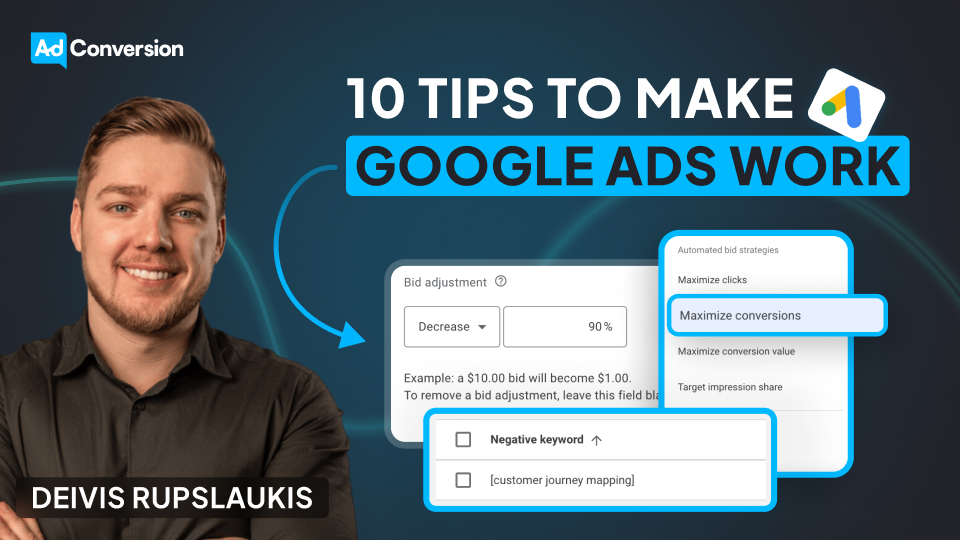
10 Tips to Make Google Ads Work for Your B2B SaaS Company
Running Google Ads today isn’t the same as running Google Ads in 2015.
What years ago was a winning strategy no longer is, and will only lead to headaches, poor leads, and wasted spend.
Many marketers have already abandoned Google entirely, claiming that it doesn’t work anymore or it’s a waste of money — but this, in my experience, isn’t true.
Over the past few years, I’ve helped B2B SaaS companies such as Dreamdata, Airtame, and Templafy drive millions in revenue through Google Ads, and have developed a repeatable strategy to maximize performance.
I’ll be sharing my tips for success below 👇
TABLE OF CONTENTS
- Tip#1: Set up quality conversion tracking
- Tip #2: Consolidate your campaigns and ad groups
- Tip #3: Focus on exclusions
- Tip #4: Create fast and relevant landing pages
- Tip #5: Leverage smart bidding
- Tip #6: Decrease the amount of RSAs per ad group
- Tip #7: Pin you headlines
- Tip #8: Don’t forget about device adjustments
- Tip #9: Figure out whether you should bid on your own brand or not
- Tip #10: Separate Brand and Non-Brand in your reporting
- Bonus tip: Dive deeper into your performance by country
Tip #1: Set up quality conversion tracking
Many companies are simply tracking form submits, without paying attention to lead quality. This makes optimization challenging, both for the performance marketer managing the account and for the Google Ads algorithm.
To improve performance, make sure you send all the lifecycle stages from your CRM back into the Google Ads platform — this might look like MQLs, SALs, opportunities, etc. — and assign higher values to higher value conversions, so that Google’s algorithm understands what to optimize for.
If you’re using HubSpot as a CRM, this process will be very simple, as your Click IDs will automatically be captured without requiring a manual setup.
If you’re using a different CRM, you’ll need to manually push your click IDs into your CRM using hidden fields — this process might seem complicated, but you should be able to find a marketing operations specialist on Upwork that can help you with the initial setup.
Tip #2: Consolidate your campaigns and ad groups
In the past, when exact match was still exact, SKAGs (single keyword ad groups) made sense.
By including one keyword per ad group and using that keyword in the ad and landing page copy, you could improve your overall quality score.
Now that exact match is a lot less exact, this approach doesn’t make sense anymore.
These days, consolidation is the way to win — by grouping relevant keywords into the same ad group, we give the Google Ads algorithm more data points to make optimizations.
Tip #3: Focus on exclusions
With exact match being less exact, exclusions are now more important than inclusions.
In other words, instead of trying to come up with hundreds of keywords to include in your campaigns, it’s better to spend your time excluding hundreds of irrelevant keywords.
For example, maybe you want to show up for the keyword customer journey tracking, but notice in your search terms report that you’re consistently showing up for the term customer journey mapping, which isn’t relevant to your core offering. By excluding different variations of customer journey mapping, you’ll be able to improve your overall targeting and get in front of more relevant prospects.

Pro tip: In the Google Ads reporting section, you can easily create a search terms report and schedule it to be emailed to you on a weekly basis. This will allow you to be more proactive about making exclusions in your account.
Tip #4: Create fast and relevant landing pages
Landing pages are one of the most overlooked aspects of Google Ads performance.
If they aren’t loading quickly, Google will lower your quality score and it will be nearly impossible to get in front of your prospects. Before launching any campaign, double check that your landing pages are loading quickly on both mobile and desktop devices.
Next, make sure your landing page is as closely related as possible to the keywords in your ad group. For a product analytics ad group, you’d want your landing page to focus on product analytics. For a marketing analytics ad group, you’d want your landing page to focus on marketing analytics.
Take a look at the customized landing pages below:
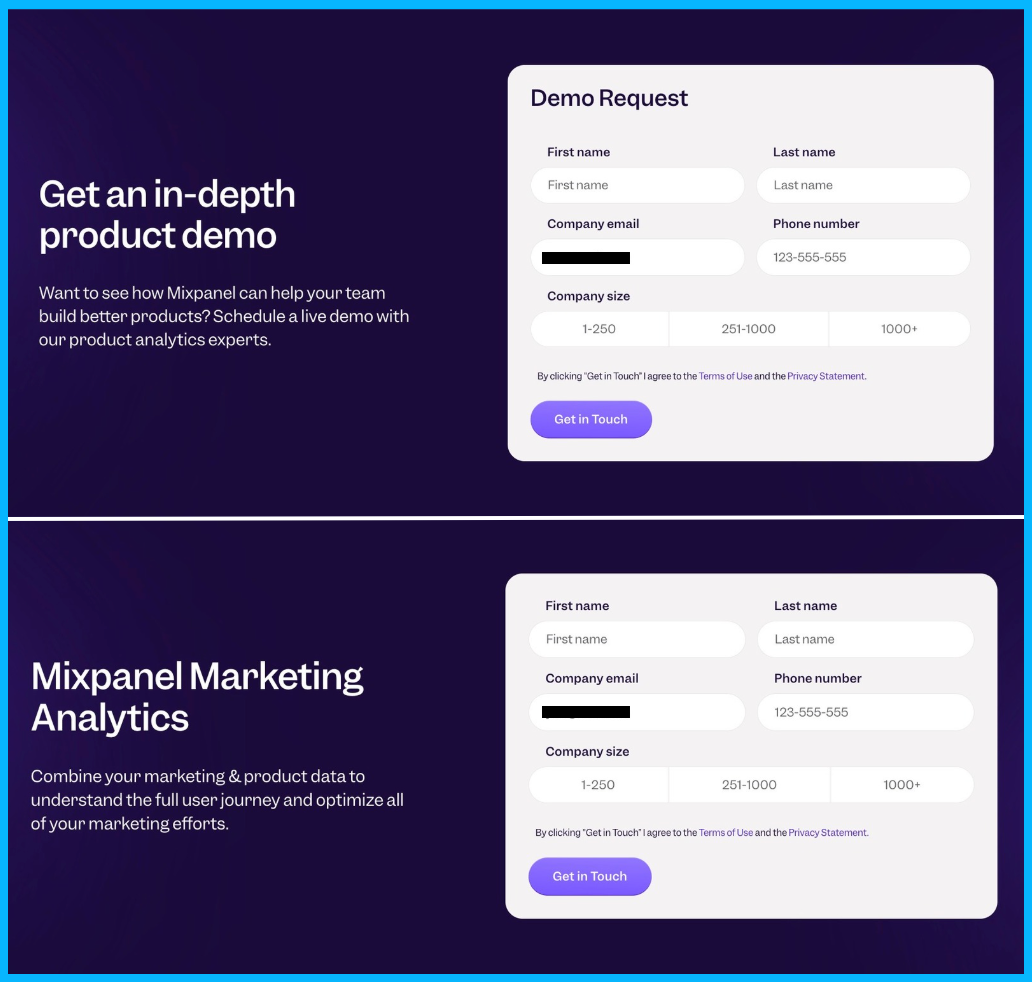
This message match will improve your quality score and will also improve the relevance for your prospects, leading to better performance.
I know that creating new landing pages can be a heavy lift, especially if you have a small team. If this is the case, I recommend duplicating an existing landing page and simply modifying the hero section. Once you start seeing some initial traction from this simple landing page, you can put in the extra effort to create a fully customized experience.
Pro tip: To check the speed of your landing pages, you can use a free tool such as PageSpeed Insights.
Tip #5: Leverage Smart Bidding
Sometimes, smart bidding doesn’t make sense. For example, if you’re starting a new campaign and have zero conversions, it’s a better idea to start with manual CPC or maximize clicks with a bid cap.
However, once you have 10+ conversions per campaign, you’ll typically see better performance if you switch over to smart bidding and let Google optimize for you.

This wasn’t always the case — in the past, Google’s algorithm was much less sophisticated, and you were better off trying to control every single bid adjustment.
But these days, you’ll usually see more traffic and an increase in conversions by letting go of control, as long as you’re feeding Google high quality signals from your CRM.
As with everything in marketing, there are exceptions, and there are instances where you’ll switch to smart bidding and your CPCs will skyrocket 😨
If this happens, consider testing a portfolio bidding strategy with a target CPA and a bid cap — this will mimic max conversions bidding while giving you more control over the cost per click.
Tip #6: Decrease the amount of RSAs per ad group
Most people think that having more responsive search ads = more variations for Google = better performance.
But the opposite is actually true.
Let’s say you create 3 RSAs, and have 15 headlines per ad. This means that Google will have to test 45 different headlines until it finds a winning combination, which could take years 😅
If you only include 1 RSA per ad group (maximum two), your headlines will be tested much faster and Google will be able to find a winning combination more easily, minimizing wasted spend and improving overall results.
Pro tip: If you have a small budget, you might want to take things a step further, and test 6-9 headlines instead of 15. This way, Google will be able to test all the headlines in a matter of weeks (not years).
Tip #7: Pin your headlines
There’s still a lot of debate around pinning vs not pinning headlines.
Some people say that pinning is a bad idea, since it will negatively impact your ad strength, but ultimately, Google’s ad strength has no bearing on performance.
I’ve seen more success with pinning because it makes your headlines more legible — if your ads are clear and searchers have a better understanding of what your company does, you’ll see an improvement in performance.
If your headlines are redundant — as often happens with unpinned headlines, which leads to words like Google Ads agency and Google Ads consultant being next to each other — prospects are less likely to trust you, and much less likely to click.
Here’s the exact formula that I like to follow for my headlines:
Headline 1: Include your target keyword to maximize relevance
Headline 2: Include unique selling points or social proof
Headline 3: Include your company name or a relevant CTA

For each headline, I like to create 2-3 variations that Google can test.
Pro tip: Spend most of your time crafting headlines 1 and 2. Headline 3 is much less important these days, as Google rarely displays it in the SERP.
Tip #8: Don’t forget about device adjustments
Oftentimes, certain devices will significantly outperform others.
For example, if you see that 20% of your spend and 90% of your conversions are happening on desktop, you might want to add a negative bid adjustment to mobile devices or tablets, in order to increase the budget allocated to desktop.

You could argue that mobile impressions are still valuable, and that decreasing spend on mobile could negatively impact performance if people are researching on their phones and then converting on desktop, but based on my experience, it’s best to work with the data that’s available to you — if a certain device is converting at a higher rate, I would recommend adding negative bid adjustments to the other devices.
Tip #9: Figure out whether you should bid on your own brand or not
Running brand campaigns vs not running them at all is a controversial topic.
Some people say that the impact of brand campaigns is minimal — prospects were already looking for you and may have converted organically — and that they simply exist to inflate performance marketing metrics.
However, in my experience, this isn’t the case, and it usually is a good idea to run brand campaigns to protect your brand, especially if competitors are bidding on your company name.
Back when I was working at Momondo, a B2C company, we were driving a ton of revenue from competitive campaigns, bidding on our competitor, Kayak, who wasn’t running brand campaigns to protect themselves.
Now, you might be thinking: sure, that’s B2C, but in B2B, especially enterprise B2B, you probably won’t change the course of a deal with a single ad.
But from what I’ve seen with my B2B clients, this isn’t true — my clients have driven a significant amount of revenue by bidding on competitor terms, which validates that bidding on your own terms to protect yourself is a good idea.
Check out the example from Mixpanel below. If they didn’t bid on their own brand name, competitors like Pendo and Heap might end up stealing some of their prospects.
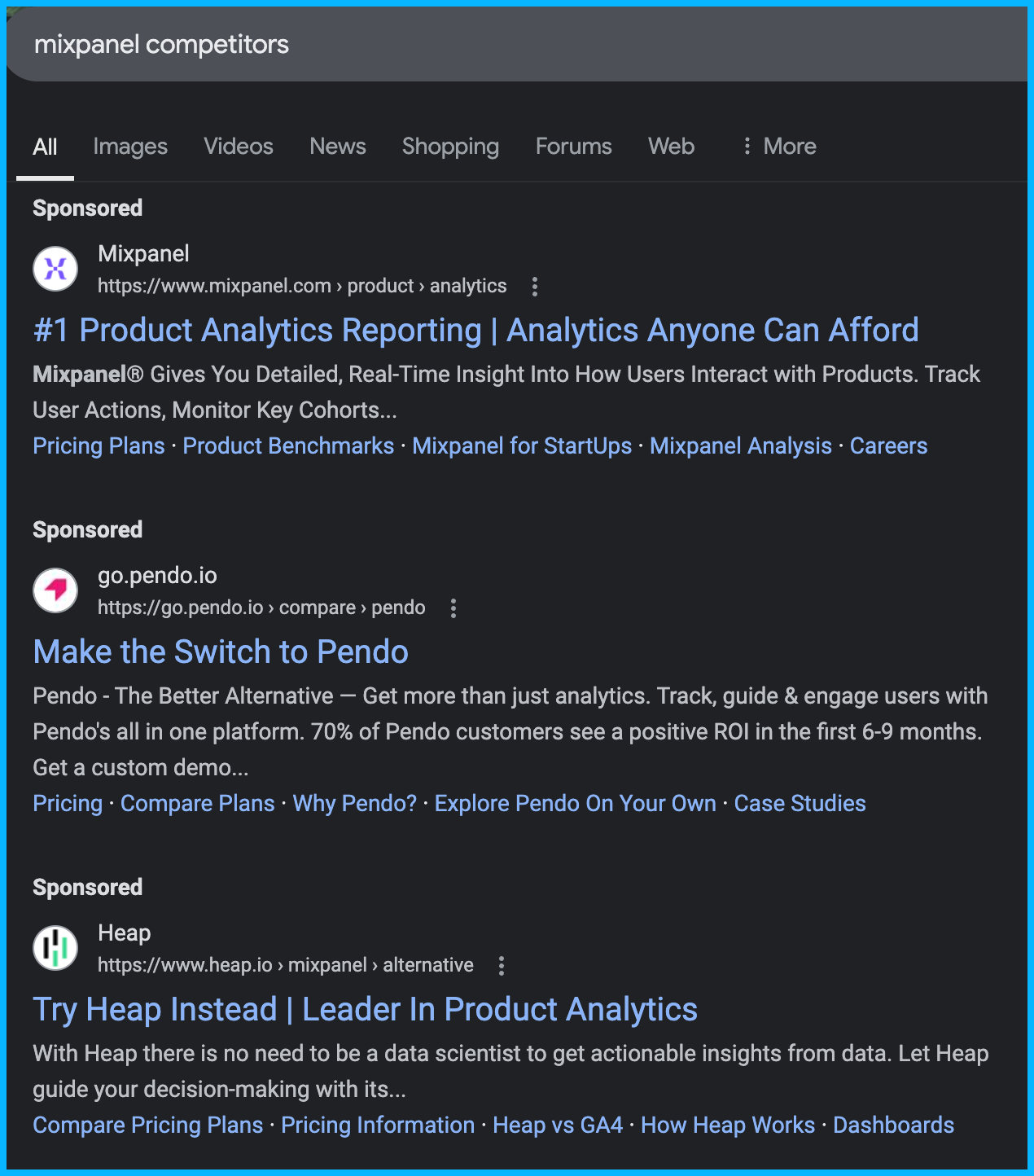
If you’re undecided about whether you should run brand campaigns or not, you can run a holdout study.
Stop running brand campaigns in a specific region — maybe start with one of your less important regions — and see if the amount of demos or trials goes down. If it does, you can assume that you’re losing out on pipeline and revenue by not bidding on your own terms.
Tip #10: Separate Brand and Non-Brand in your reporting
Brand and non-brand campaigns are completely different.
Brand campaigns are defensive. Someone already found out about your brand through other marketing efforts, and they’re looking for you specifically — you’re bidding on your own name in order to protect your brand from competitors trying to steal your traffic.
On the other hand, non-brand campaigns are offensive. You’re trying to show up for relevant solutions that your prospects might be looking for, and you’re trying to drive interest from a colder audience.
In other words, getting a conversion on a non-brand campaign is significantly more challenging than driving a conversion on a brand campaign; you need to separate these campaign types in your reporting to truly understand what’s working.
Bonus tip: Dive deeper into your performance by country
Most companies and ad agencies tend to look at performance by region, but completely ignore performance by country, which results in inefficient spending.
For example, if you’re targeting France, Italy, Spain, DACH, Nordics, and the UK in the same campaign, if you drill down and analyze performance by country, you might realize that all your spend is going to the southern European countries, which typically have more affordable CPCs.
And if you look further down the funnel, you might see that Spain, DACH, and Nordics are generating a lot of form submissions, but that all your pipeline is actually coming from the UK.
Ultimately, you want to ask yourself:
1. Are any countries cannibalizing my spend and do they need to be separated into different campaigns?
2. Are there countries that aren’t generating any form submissions that we might want to pause?
3. Are there countries that are generating submissions but never convert into pipeline that we might want to invest less money in?
If you ask yourself these questions consistently, you’ll be in a much better position than 99% of companies.
Hope you found this article helpful!
If you’re looking to learn more about Google Ads, check out these free Google Ads courses, that will teach you how to launch, optimize, and scale Google Ads campaigns effectively.
And if you have any questions about Google Ads or paid media in general, feel free to reach out on LinkedIn.

10 Unorthodox Tips to Maximize the Impact of Your LinkedIn Ad Campaigns
If you’re a marketer with some paid media experience, you’ve likely heard the same LinkedIn Ads advice many times: disable audience expansion, turn off the LinkedIn audience network, use manual bidding, etc.
This is all great advice, but following it doesn’t guarantee success – as the LinkedIn Ads market becomes increasingly saturated, it takes a more advanced approach to be successful.
Below, I’ll be sharing some less common strategies that my LinkedIn Ads agency has used to generate millions in revenue, and that you can implement to take your LinkedIn Ads performance to the next level.
TABLE OF CONTENTS
- Tip #1: Leverage the LinkedIn Insight Tag
- Tip #2: Implement a solid paid search strategy
- Tip #3: Review the intent of your search terms on Google
- Tip #4: Use video
- Tip #5: Communicate with your sales team
- Tip #6: Have a monthly and quarterly maintenance plan
- Tip #7: Experiment with organic content
- Tip #8: Use thought leader ads
- Tip #9: Leverage ad scheduling
- Tip #10: Use LinkedIn Sales Navigator to connect with your ICP
- Conclusion
Tip #1: Leverage the LinkedIn Insight Tag
This might sound silly, but I think it’s important to say it: Make sure you’re leveraging the LinkedIn Insight Tag to its full potential.
I’ve audited so many accounts where the insight tag isn’t installed and all the spend is going to cold audiences, and I’ve also seen accounts where the tag is installed, but the right audiences haven’t been set up.
As soon as you create your account, set up your 30, 90, and 180-day website visits remarketing audiences – these audiences are extremely high value and aren’t retroactive.
In other words, if you set them up 6 months after creating your account, you’ll miss out on 6 months of website traffic that you could retarget 😢

If you haven’t installed the insight tag already, check out this tutorial.
And for a full breakdown of the remarketing audiences you can create in LinkedIn Campaign Manager, take a look at this comprehensive guide.
Tip #2: Implement a solid paid search strategy
One of the best ways to improve your LinkedIn Ads results is to implement a solid paid search strategy – this could be Google Ads, Bing, or another paid listing.
Although LinkedIn’s targeting capabilities are incredible, you’re typically reaching a colder audience that isn’t actively searching for your solution, and have to take them from unaware to aware before driving conversions, which means longer sales cycles.
Meanwhile, with paid search, you can target people who are looking for your exact solution or researching the pain points you solve and shopping for vendors/solutions.
By running search ads and then retargeting with LinkedIn Ads, you can stay in front of in-market, warm audiences that are already problem and brand-aware, and significantly shorten your sales cycle. You can even qualify this in-market search traffic by layering in LinkedIn’s demographic and firmographic targeting filters on top of your warm website traffic to only retarget high-fit prospects.
Pro tip: If you’re investing a lot of money in paid search (30K+/month), you might be able to create a custom LinkedIn Ads remarketing audience with the UTM source “paid_search”, or “cpc”, or “google”. This way, you’ll only retarget high-intent prospects who have already clicked on your search campaigns.

Tip #3: Review the intent of your search terms on Google
There’s no point in running search campaigns if you’re not getting in front of your ICP.
If you’re a performance marketer working at an agency, make sure you communicate with in-house marketers to confirm you’re showing up for the right search terms – their feedback is essential, because they know their business and ICP better than you do.
To make things simple, send the team a search terms report bi-weekly or monthly, and ask for feedback on what to exclude.
By doing this, you’ll improve the quality of your Google Ads traffic, and also significantly improve the quality of your LinkedIn Ads remarketing audiences.
Tip #4: Use video
Video is one of the most impactful formats on LinkedIn, as it allows you to build trust, communicate your value, and showcase your personality more effectively than images.
If you work at a service-based company, you can steal the exact strategy I use at my agency:
1. Target your cold audience with videos that clearly describe what you do and what problems you solve – these videos don’t have to be super exciting, but they do have to be relevant to the right audience and weed out people who aren’t in your ICP.
2. In remarketing, use clips of yourself speaking on well-known podcasts – this will help you build more credibility with your ICP and make them more likely to reach out.
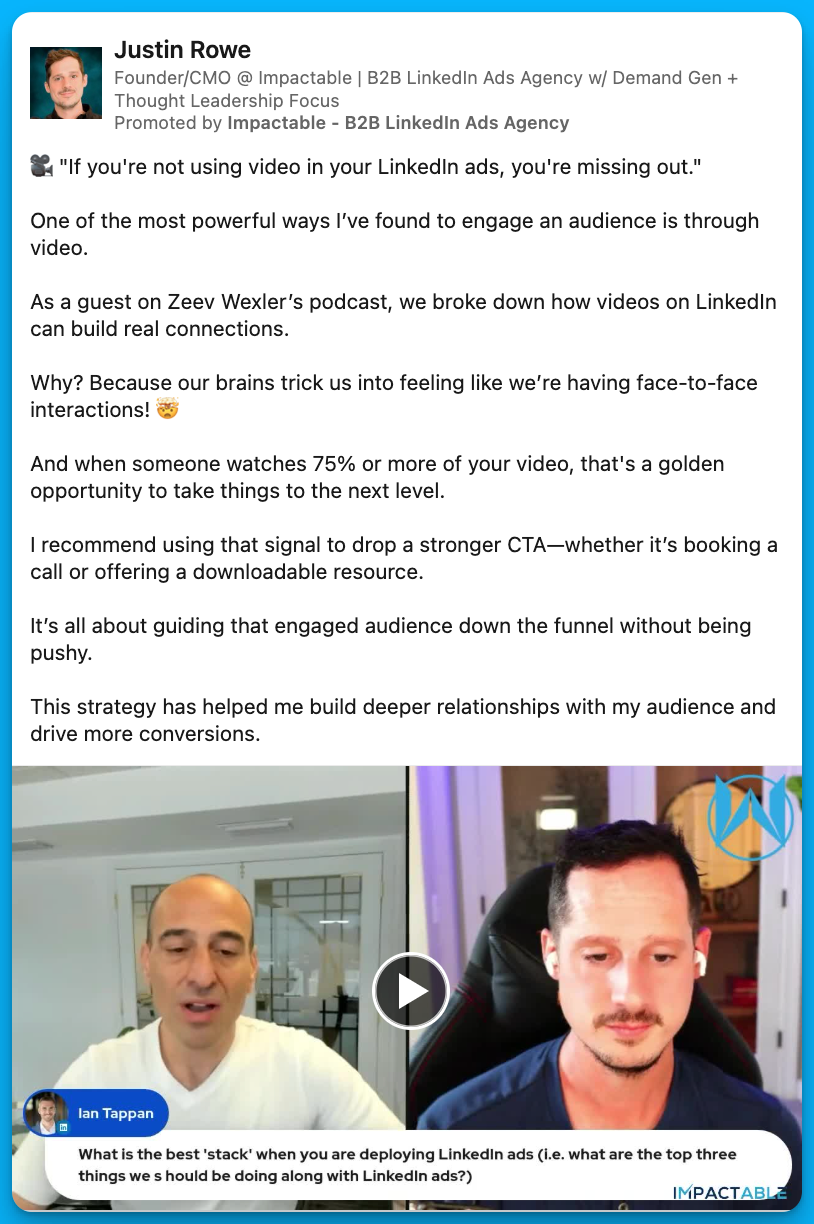
If you‘re selling a product instead of a service, run video ads showcasing how leaders in your industry use your product to solve their problems – this third-party validation is extremely powerful and has helped my SaaS clients generate millions in revenue over the past few years.
Tip #5: Communicate with your sales team
There’s no point in having great CPCs, CTRs, and CPLs if the sales team has no interest in working with your leads.
At minimum, I’d recommend meeting with your sales team once a month to go over your lead quality – these conversations will help you refine your targeting and exclusions, and minimize the amount of ad dollars being wasted.
In addition to this monthly check-in, you can go one step further and set up automated lead alerts in Slack (using Zapier). When these alerts come in, your sales team can react – thumbs up for a good lead and thumbs down for a bad one – and you can use these reactions to get real-time feedback and make quick pivots in targeting.
Tip #6: Have a monthly and quarterly maintenance plan
This might seem a bit boring, but it’s important to have a monthly and quarterly maintenance plan for your account – the same way you have a maintenance plan for your car or for your health.
For example, if you launched new video campaigns, did you create video view audiences and add them to your remarketing campaigns? Is your insight tag still active and picking up website traffic? Is your ad budget staying on LinkedIn and not being wasted on the LinkedIn audience network? Are your conversion events still functional, or do you have to update them due to changes in your website URLs?
Without these consistent checks, things can easily go awry and you can waste thousands or even millions of dollars.
Here’s the exact maintenance checklist that we use with our clients – feel free to make a copy and use it for your own accounts.
Tip #7: Experiment with organic content
If a piece of content performs well organically, it will most likely also perform well as an ad.
Use organic social media as a testing ground – test different pain points, messages, formats, and styles, on both personal accounts and your company page, and make note of what’s attracting meaningful DMs and high-quality leads.
Once your posts have received a solid amount of engagement, you can boost them to your ICP and turn them into evergreen assets that will continue to generate inbound leads with minimal effort.
By maximizing distribution via paid, you’ll improve your organic performance, and by testing new concepts via organic social, you’ll improve the ROI on your paid media efforts.
Tip #8: Use thought leader ads
Posts from thought leaders will consistently outperform ads from company pages. This is partially due to a mindset shift – when we post from our personal pages our reputation is on the line, so we try to be less promotional and more helpful.
That being said, even if you promote the same exact post from a company page vs a thought leader’s page, the thought leader ad will typically perform better – this confirms that the saying is true: people want to buy from people, not companies.
By running thought leader ads, you can expect to see:
1. Increased engagements, which will allow you to build your remarketing audiences more quickly
2. An increase in LinkedIn DMs from qualified prospects
3. A spike in organic search traffic
4. An incremental lift in conversions (my agency saw a 15-20% increase)

Pro tip: Experiment with different types of thought leader ads (videos, images, text, custom graphics) and double down on whatever works best.
Tip #9: Leverage ad scheduling
LinkedIn Ads start running on UTC time (8 p.m. EST), which means that a lot of companies are spending their money at nighttime and run out of budget by 5 or 6 a.m. – this leads to poor performance, as prospects are typically not as receptive to ads at these hours.
With ad scheduling, you can ensure that your ads are showing up at the right times.
For my agency, I like to run ads from 5 a.m. to 2 p.m. EST, pause in the afternoons, and restart in the evenings. For you, this schedule might look a bit different, based on when your ICP is most active.
In addition to scheduling, it can also be interesting to experiment with ad rotation, especially if you’re a smaller company with limited budget.
For example, you could run 3 campaigns on Monday, Wednesday, and Friday, and 3 different campaigns on Tuesday, Thursday, and Saturday.
Typically, to run 6 campaigns you’d need a budget of at least $60/day (due to LinkedIn’s $10/day per campaign minimum), but with ad rotation, you’d only need $30/day – in other words, your budget would go a longer way and you’d be able to reach more audiences.
Ad scheduling and rotation may not be necessary if you have a massive budget and are targeting a broad audience, but it can make a huge difference if you’re spending under $30K/month and want to make the most of your budget.
To get started with ad scheduling and ad rotation, you can use DemandSense, a tool that we developed at my agency.
Tip #10: Use LinkedIn Sales Navigator to connect with your ICP
If you’re experimenting with LinkedIn organic, paid, and thought leader ads, it’s a great idea to connect with your LinkedIn profile visitors to maximize the impact of your efforts.
Here’s exactly how you can do this:
1. Set up a filter in LinkedIn Sales Navigator for people who have visited your profile, aren’t connected with you (2nd or 3rd degree connections), and fit your ICP criteria (right company size + seniority level)
2. Send connection requests to these people on a weekly basis – in my experience, it’s best to send blank connection requests to avoid coming across as a salesperson
3. Once your connection request has been accepted, send a simple intro message such as: Hey X, saw you checked out my profile and thought it would be good to connect. If you ever have any questions about LinkedIn Ads or want to talk about B2B marketing, let me know. Here's the link to some resources that people commonly ask me for: [insert valuable link]
With this approach, I typically see about a 60% acceptance rate, and I always get a lot of follow up questions, such as: Do you work for X company? Have you experienced X problem?
Plus, a lot of prospects end up visiting my company website, which means that I can stay in front of them for a longer period of time, since they get pulled into my LinkedIn remarketing audience.
Pro tip: You can start by doing this process manually with LinkedIn Sales Navigator, but you can also automate and simplify the process by using a tool like PhantomBuster.
Conclusion
Even if you’re doing everything right on LinkedIn – communicating with sales, using video, experimenting with organic social, amplifying your thought leadership, etc. – don’t expect to see tons of demos and opportunities right away.
Facebook Ads, Google Ads, and email are very transactional channels, but LinkedIn Ads are more similar to SEO – it takes time to see results but your efforts will pay dividends down the road.
Hope you found this article helpful!
Feel free to reach out with any questions about LinkedIn Ads or paid media.

10 Tips to Drive Pipeline Acceleration with Paid Media
Most B2B SaaS companies have a two-dimensional approach to paid media: prospecting campaigns to generate awareness, remarketing campaigns to capture demand.
This isn't necessarily wrong, but there are so many more possibilities, such as moving existing open deals faster to close – this is called pipeline acceleration.
As a Demand Marketing Manager at Unmuted, I've helped my B2B SaaS clients drive revenue through pipeline acceleration.
Here are my 10 tips on how to make this playbook work for you 👇
TABLE OF CONTENTS
- Tip #1: Communicate the goal to your internal stakeholders
- Tip #2: Start targeting your open opportunities with LinkedIn Ads
- Tip #3: Tailor your messaging to different personas
- Tip #4: Measure the impact of your campaigns
- Tip #5: Don’t forget to exclude your customers
- Tip #6: Apply the same playbook to upsells and cross-sells
- Tip #7: Incorporate different channels into the mix
- Tip #8: Use thought leader ads
- Tip #9: Leverage signals to understand how deals are progressing
- Tip #10: Use insights from closed lost campaigns to tweak your strategy
Tip #1: Communicate the goal to your internal stakeholders
Before running any pipeline acceleration campaigns, make sure your executive team understands that the goal is NOT to drive new opportunities, but to increase the rate (and speed) at which open opportunities turn into revenue.
This might seem basic, but without this alignment, your campaigns may be considered a failure and paused prematurely, even if they’re extremely successful.
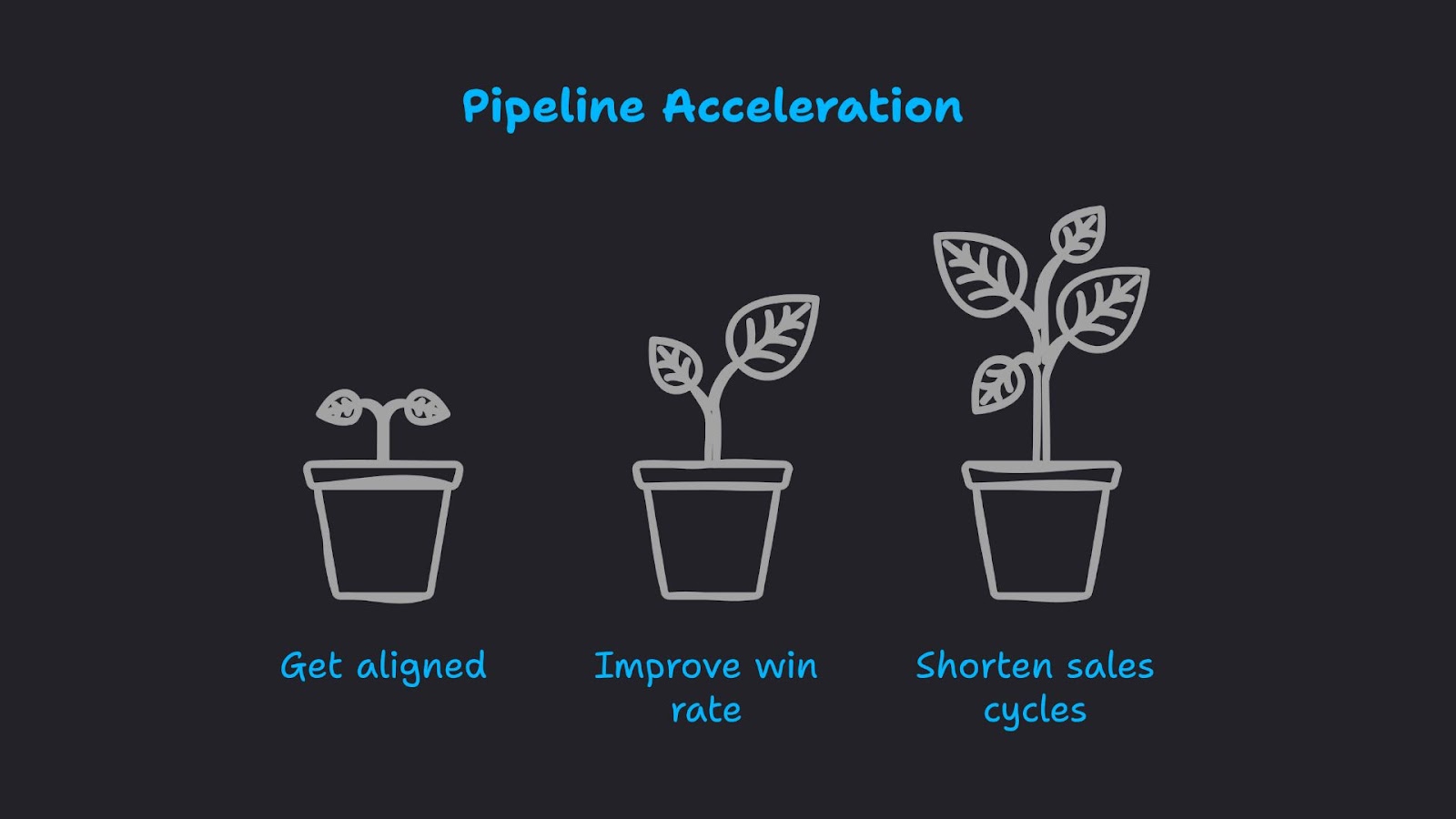
Tip #2: Start targeting your open opportunities with LinkedIn Ads
Once you have buy-in from internal stakeholders, I recommend getting started with LinkedIn Ads.
For your targeting, you can create a dynamic list of open opportunities in HubSpot and connect it to LinkedIn Campaign Manager. And if you’re using another CRM, such as Salesforce, you can send your open opportunities to LinkedIn Campaign Manager via Zapier.
On top of this company list of open opportunities, you’ll want to layer on job titles within your DMU (decision-making unit) – these are all the people that may be involved in sales conversations.
For example, if you’re selling an attribution tool, you might want to reach RevOps, Marketing, Sales, and Business Development job titles at your target accounts.
Marketing job titles (VP of Marketing, Head of Demand Gen, Chief Marketing Officer) will likely push the deal forward, but other departments will need to sign off in order for a purchase to be made. By building trust within all these key departments, you’ll increase the likelihood of a deal moving over the finish line.

Pro tip: If you don’t have a massive list of open opportunities, you may not be able to layer on job titles, as your audience size will be too small. If you run into this issue, try using job function targeting instead.
Tip #3: Tailor your messaging to different personas
If you have a large enough audience size to do so, consider creating different campaigns for each persona within your DMU (decision-making unit). For example:
Campaign 1: Open opportunity companies + Marketing job titles

Campaign 2: Open opportunity companies + Finance job titles

Campaign 3: Open opportunity companies + Sales job titles

By separating these different personas into different campaigns, you can create messaging that’s more relevant to each department – marketing ads could focus on measurement, finance ads could focus on revenue, sales ads could focus on closing more deals, etc.
With more tailored messaging, your ads are more likely to resonate and leave an impression on different departments.
Tip #4: Measure the impact of your campaigns
Once your campaigns are live, you need a way to measure (and prove) that they’re working.
Here’s how I recommend doing it:
1. When a deal closes, go to the Companies tab in LinkedIn Campaign Manager and see how many impressions (and engagements) the Closed Won company received. If you see a lot of impressions and engagements, it’s safe to assume that your ads played a role in the eventual conversion.

2. To take things up a level, consider using a tool like Fibbler, which sends ad impressions on a company level back into HubSpot – this will allow both your marketing and sales team to see how many ads companies saw before making a purchase.
3. If you have a larger budget, consider investing in a tool like Dreamdata or HockeyStack, which will provide more details on the incremental lift driven by your pipeline acceleration campaigns.
4. For a true A/B test, manually split your open opportunities into two different groups, and expose only one of them to the pipeline acceleration ads. Are the exposed companies closing faster and at a higher rate?
5. To further understand the impact of your campaigns, ask the POC of your new customers if they happened to see your ads, and if those ads influenced their decision in any capacity.
Tip #5: Don’t forget to exclude your customers
This is simple, but extremely important: Don’t forget to exclude new customers from your pipeline acceleration campaigns.

If your customers continue seeing ads from your company during their onboarding phase, you may end up annoying them, in addition to throwing money down the drain.
Making these exclusions is straightforward: when a company transitions from opportunity to closed won in HubSpot, they should be added to a new dynamic list of customers, which can be connected to LinkedIn Campaign Manager and added as an exclusion list in your pipeline acceleration campaigns.
If you’re using a different CRM, the process is similar, you’ll just have to make the connection through Zapier instead.
Tip #6: Apply the same playbook to upsells and cross-sells
Once this playbook is working well for pipeline acceleration, you can apply it (with a few modifications) to upsells and cross-sells.
For example, if you launch a new product, you could target a list of all your existing customers highlighting its capabilities, and outlining how it will enhance their existing workflows. Check out an example from ZoomInfo below:

The possibilities are endless once you understand the fundamentals of LinkedIn’s targeting – any lifecycle stage can be targeted with relevant content and offers.
Tip #7: Incorporate different channels into the mix
Once LinkedIn Ads are working well for you, consider adding other channels and strategies into the mix to create a sense of omnipresence.
For example, maybe you could test Meta or Reddit retargeting ads (depending on where your audience spends the most time).
It’s also a great idea to leverage LinkedIn organic, to expand your reach beyond paid ads.
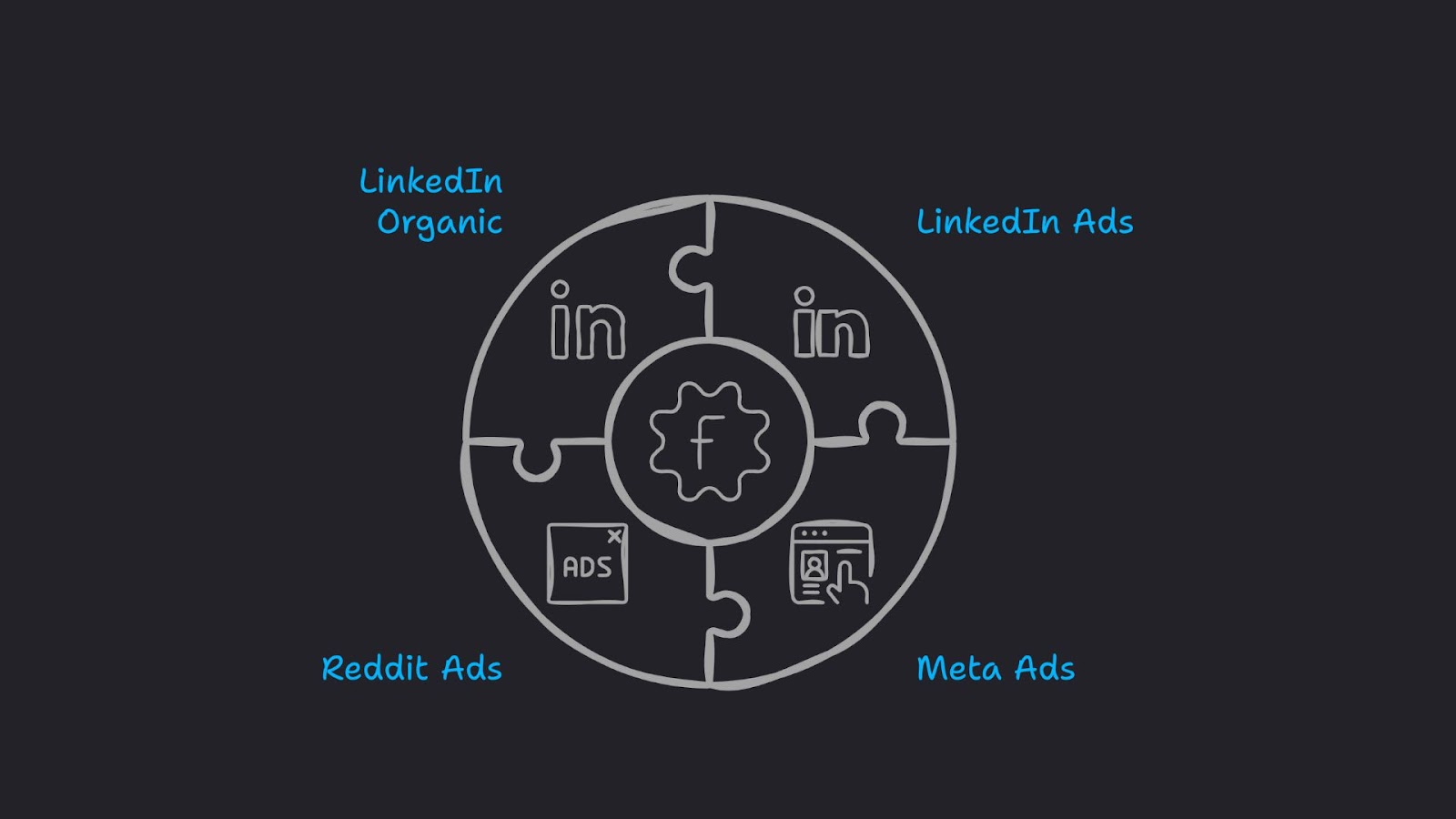
Your Head of Sales, Chief Commercial Officer, members of your marketing team, and other employees who are consistently posting on LinkedIn can connect with people within the DMU (Decision-making unit) at your open opportunity companies – this way, they’ll be seeing content from your organization constantly, and you’ll be top of mind throughout the entire sales process.
Tip #8: Use thought leader ads
To maximize the impact of your ads, you ideally want your team to be posting relevant content on LinkedIn, and you can take things to the next level by running thought leader ads, boosting the top performing posts from your team members to your list of open opportunities.
For example, if your Head of Sales makes a post related to the capabilities of your product and it goes viral, you can put some ad spend behind this post, targeting all your open opps – this will serve as great social proof, reassuring members of the DMU that working with your company is the right decision.
The added benefit of thought leader ads is that they don’t look like ads at all, and typically drive more interest and engagement than standard company ads.
Here’s a good example from Sendoso:
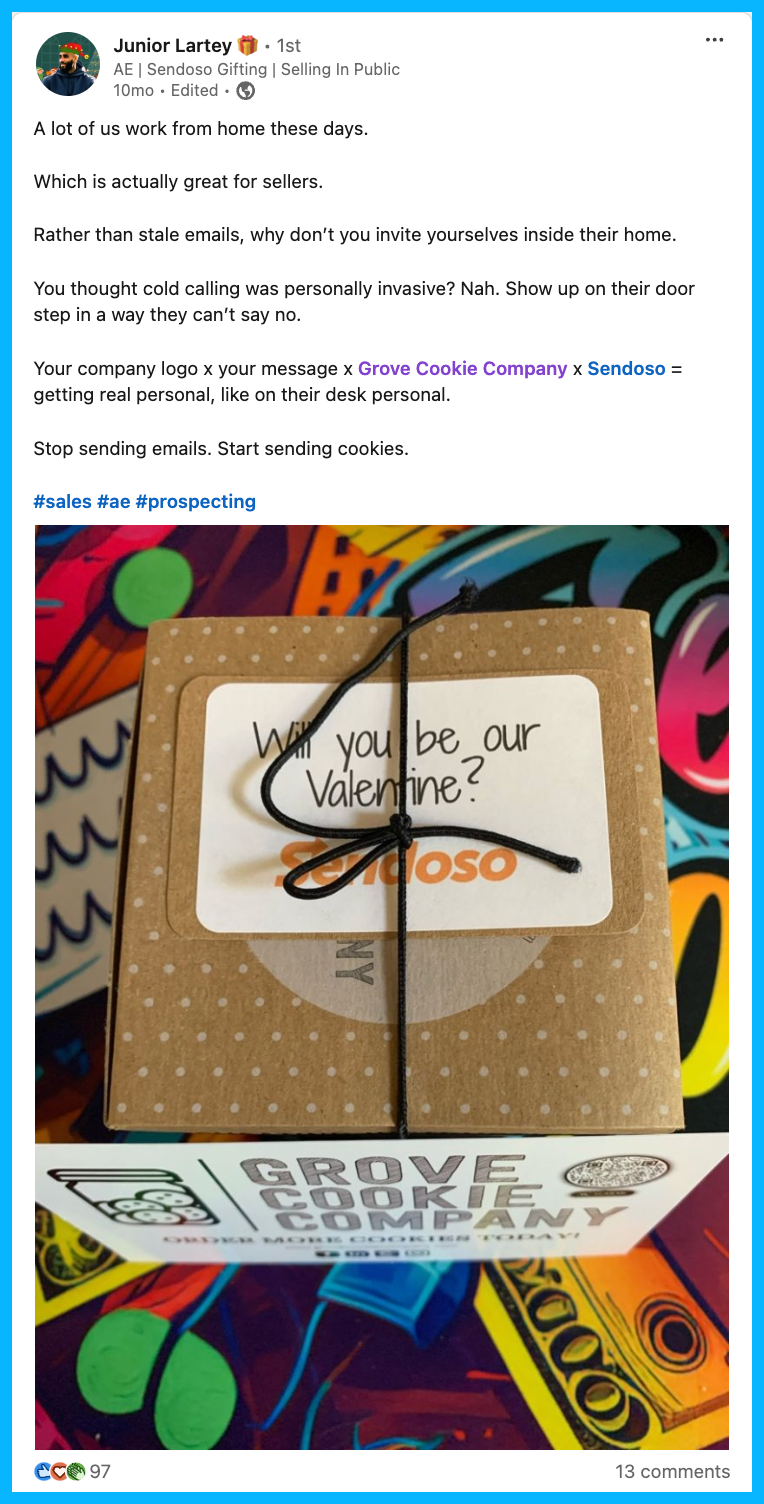
Tip #9: Leverage signals to understand how deals are progressing
To understand how deals are progressing, take a look at the signals that are available to you.
Is a specific company seeing your ads a lot? Are they engaging frequently? Are they going a step further and visiting your website? (you can easily see this using a tool like Warmly, LeadInfo, or Leadfeeder)

If you’re in the US and have access to person-level identification tools, you can even see some of the people that are visiting your site. For example, if the CFO, CMO, and CTO are all visiting your website, you can infer that the deal is progressing rapidly and chances of a purchase are high.
Tip #10: Use insights from closed lost campaigns to tweak your strategy
Keep a close eye on closed lost deals and look for recurring patterns.
Are you consistently losing on pricing, timing, or to a specific competitor?
This is great intel for messaging in future pipeline acceleration campaigns – if you can get ahead of potential objections, the likelihood of an opportunity closing is significantly greater.
For example, let’s say you’re reviewing a year of data and notice that you lost most of your deals to a specific competitor.
In your future pipeline acceleration campaigns, you might want to run competitive ads, highlighting the benefits of choosing your product. This might help prospects who are thinking of working with your competitor choose to work with your company instead.
Here’s a great example from Cognism:
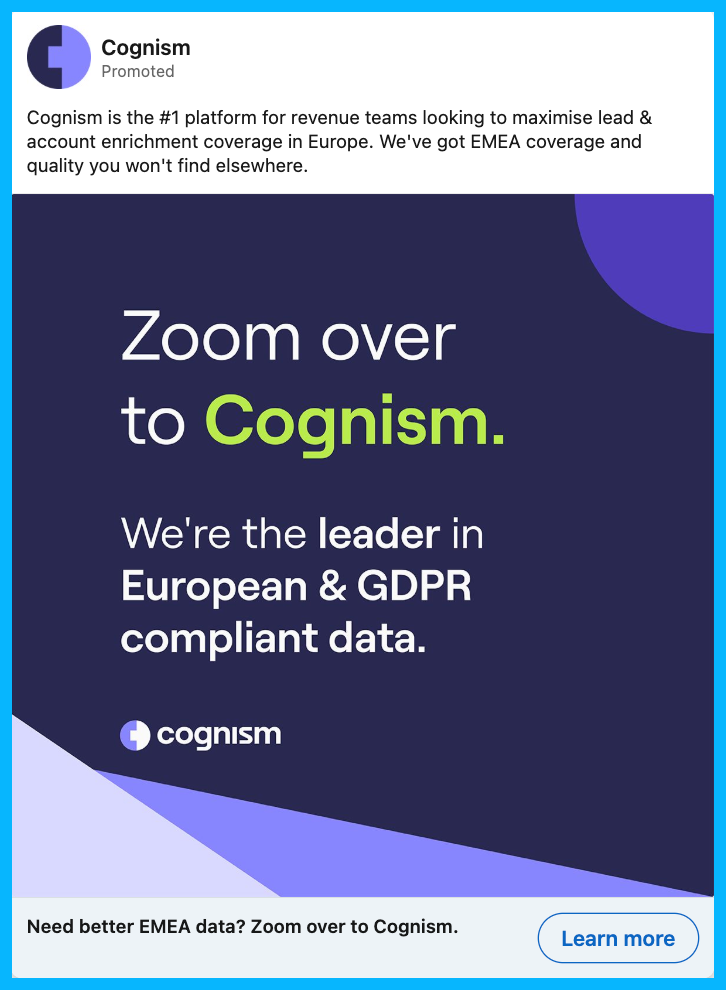
Hope you found this article helpful!
Feel free to reach out on LinkedIn with any questions about pipeline acceleration, paid media strategy, or B2B marketing.

How to Scale Outside of Paid Search with YouTube Ads & Demand Gen Campaigns for B2B SaaS
Hey there, if you’re a B2B marketer looking to scale your Google Ads campaigns, you’re in the right place.
In this article, I’ll walk you through how to effectively use YouTube Ads and Google Demand Generation (previously known as Discovery) campaigns to scale beyond paid search and stay top of mind while keeping costs low.
So let’s dive in! 👇
TABLE OF CONTENTS
- Why You Need to Scale Beyond Paid Search
- How to Leverage Custom Audiences
- How to Stay Omnipresent with Remarketing
- From Clicks to Conversions: Master Google Ads for B2B
Why You Need to Scale Beyond Paid Search
Search campaigns are fantastic for capturing high-intent users, but eventually you’ll hit a wall. Why? There’s only so much traffic coming from people searching for your keywords (especially in B2B).
As I always say, Google Ads is a blessing and a curse. You’re blessed with intent but cursed with scale.
So to break through, it’s necessary to explore other types of Google Ads campaigns.

Video and Demand Gen campaigns, in particular, are great for that because they let you reach a broader audience on YouTube, Gmail, and Discover at a fraction of the cost per click you’d pay for high-intent search terms.
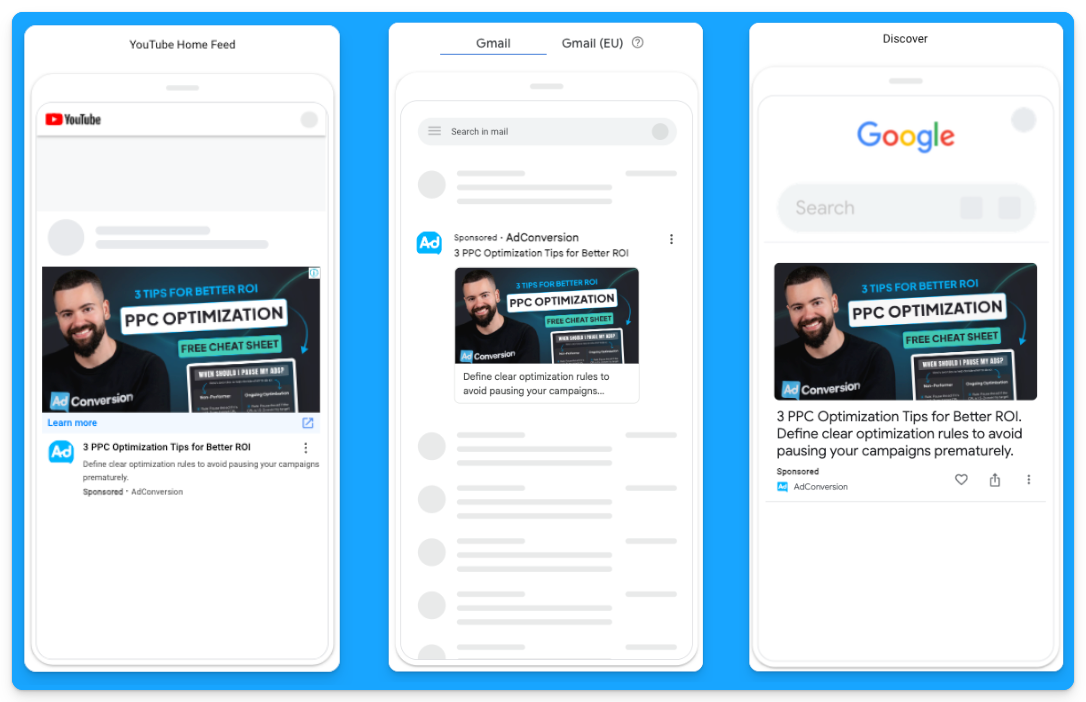
For example, instead of paying $100 per click for “CRM software”, you could pay just $0.05 per view on YouTube, targeting the same audience.
It’s a game-changer for SaaS companies looking to grow.
How to Leverage Custom Audiences
You may ask how you can get LinkedIn-like targeting with YouTube Ads and Demand Gen campaigns since we can’t rely on job titles or target specific companies.
The secret to successful prospecting with these channels lies in custom audiences.
These are people actively searching for your top-performing keywords, competitors, or industry terms.
Custom segments let you target users based on search behavior, getting your brand in front of highly relevant prospects at just the right time.
Here’s how you can create custom segments on Google Ads:
- Go to “Tools” on the left-hand side of your Google Ads manager
- Click to expand the “Shared library” option and go to “Audience Manager”
- Click on the “Custom segments” option
- Click on the plus sign to create a new custom segment

Below is a custom segment I created to target people with any interest or purchase intentions in B2B-related terms and tools and how many impressions I can get per week with this segment.

I also recommend creating custom segments with the following:
- Relevant B2B Apps (especially if they integrate with your product)
- Your competitors
- Relevant B2B Brands
- Your high-converting paid search keywords
- Irrelevant B2C Interests/Searches for exclusion if needed
As I pointed out, by using these custom audiences, you can target people who have searched specific terms on Google through Demand Gen or YouTube campaigns. Instead of paying a premium cost for search clicks, you’re reaching them on different platforms for dramatically less.
If you want to learn more about YouTube costs check out this benchmark data we pulled from $1,041,988 in ad spend from our own B2B SaaS clients.
Staying Omnipresent with Remarketing
In B2B marketing, sales cycles can range from months to years, so another great option to leverage Video and Demand Generation campaigns on Google Ads is using remarketing audiences to stay top of mind with your prospects.
Running remarketing campaigns on YouTube, Gmail, Discovery and Google Display allows you to re-engage visitors who’ve interacted with your site or content.
For example, you can create specific segments based on user activity, such as visiting your pricing page, blog, case studies, or downloading a resource.
Here are some of the remarketing segments I recommend most for B2B SaaS companies:
- Pricing Page Visits
- Product Page Visits
- Prospects that downloaded a resource
- Prospects that attended webinars or in-person events (custom list)
- Demo Page Visits (excluding users that filled out the form)
- Trials (for PLG companies)
- Case Study Visits
If you’re running LinkedIn Ads and confident in your audience targeting, you can also steal that LinkedIn Ads traffic by remarketing them on Google 🔥
To do that, you just need to build a retargeting audience using utm_source=linkedin or whatever utm_source you use for your LinkedIn Ad campaigns.
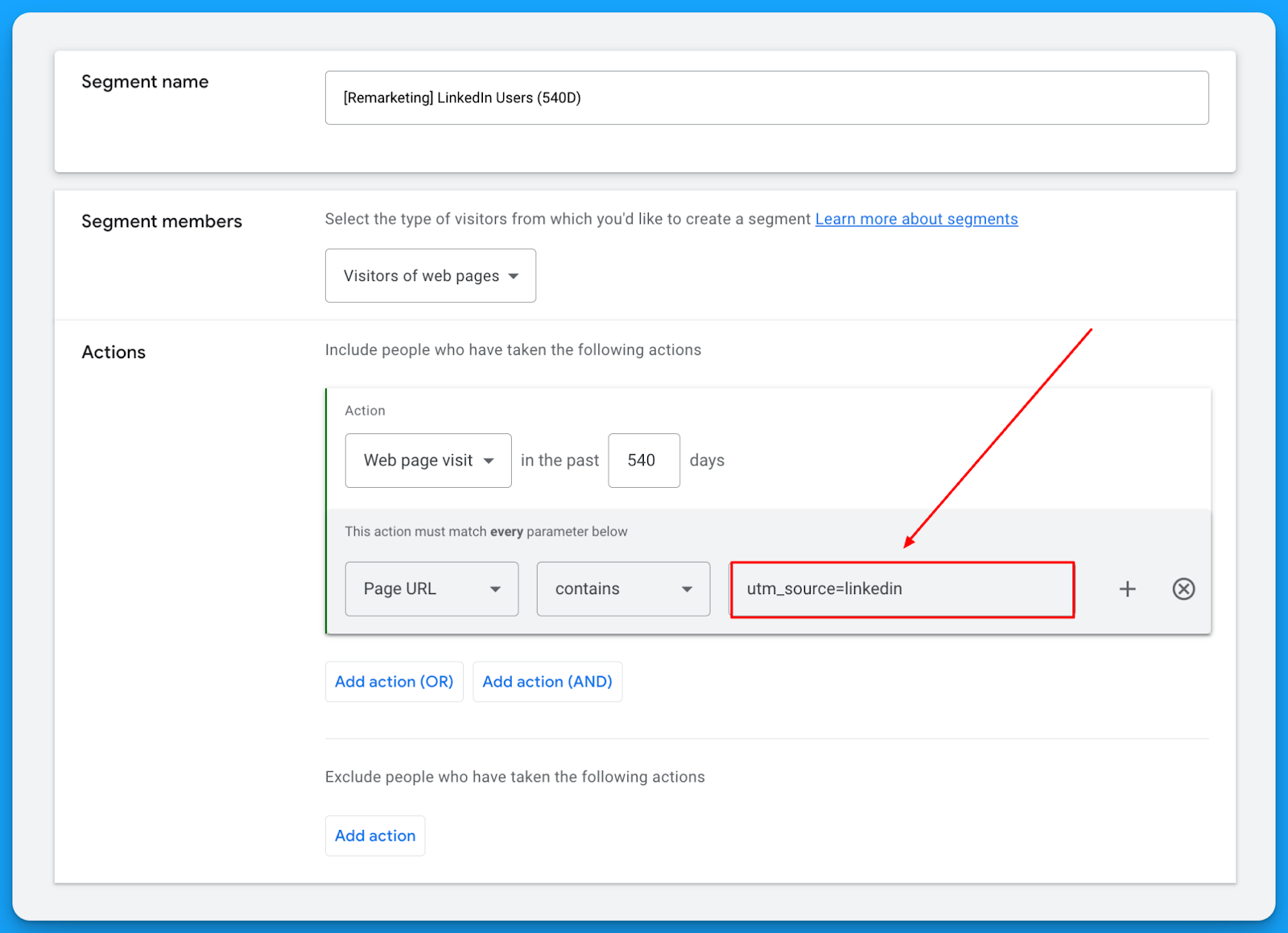
This will let you get in front of the same users on YouTube, Gmail, Discovery, and Display for a fraction of the cost you’re paying on LinkedIn. 🤓
Check out our free LinkedIn Ads courses to master this channel:
- B2B LinkedIn Ads 101: The Ultimate Crash Course for New LinkedIn Advertisers
- B2B LinkedIn Ads 102: The Blueprint for LinkedIn Ads Optimization
- B2B LinkedIn Ads 103: Advanced Scaling Strategies From $25M in Ad Spend
The beautiful thing about remarketing is that it deals with smaller audience sizes and requires less budget, but it keeps you in front of the people who matter most.
So I highly recommend building a multichannel B2B retargeting strategy to ensure your brand stays visible, nurturing prospects throughout their long decision-making process.
You can steal my YouTube Remarketing Checklist to ensure you don’t forget anything when creating your campaigns.
Final Words
Scaling beyond search campaigns, leveraging custom audiences, and using remarketing are your keys to running successful B2B SaaS campaigns on YouTube and Google Demand Generation.
These strategies let you break free from search constraints, attract new prospects efficiently, and remain top of mind throughout the sales cycle.
If you have any questions, feel free to connect with me on LinkedIn.
From Clicks to Conversions: Master Google Ads for B2B 🔥
If you want to become a Google Ads pro, check out our free B2B Google Ads courses, where you'll learn how to launch, optimize, and scale your campaigns to drive pipeline and revenue.

Here's what you'll learn in each course:
⚙️ B2B Google Ads 101 - How to Launch Dangerously Effective Campaigns for Beginners
- The Googleverse: The Game You're Playing & How To Win
- Measurement: How to Make Sure You're Profitable
- Targeting: How to Show Up For the Right Searcher
- Planning: Putting It All Together
🎯 Google Ads 102 - How to Clicks Into Profit
- Visibility: How To Find the Hole Sucking Profits
- Workflows: How to Optimize On a Daily, Weekly, Monthly & Quarterly Basis
- Experimentation: How to Test & Automate Profitability
- Troubleshooting: How To Solve Inevitable Problems
🚀 Google Ads 103 - How to Scale Google Ads For Advanced Advertisers
- Methodology: How to Vertically Scale Google Ads From A-Z
- Campaigns: Scaling Horizontally Through Campaign Themes
- Channels: Scaling Outside of Paid Search
Click Here to Join 1,000+ B2B Marketers Today and start leveling up your advertising skill set.
Takes < 90 seconds to sign up (seriously we timed it 😂)
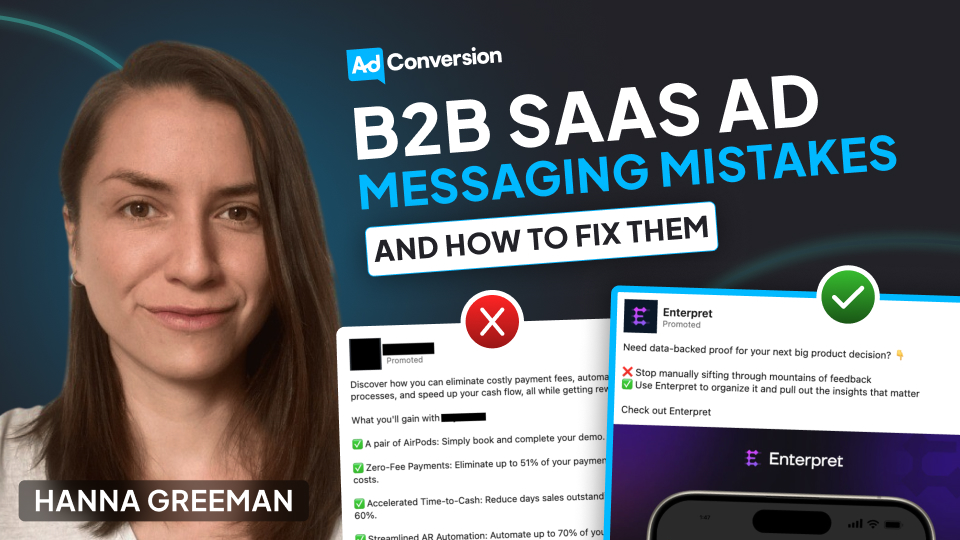
3 Messaging Mistakes B2B SaaS Companies Make in Their Ads (and How to Fix Them)
Paid ads have the potential to be the biggest revenue driver in your business. Not to mention, they are one of the fastest ways to build brand awareness.
But if you are like most B2B SaaS companies, you probably find that a large portion of ads you run drive a less-than-impressive CTR or an astronomical CPL.
Before you switch strategies or try another platform, we need to look at your ad copy. One study found that 75% of B2B LinkedIn ad creative was ineffective, ranking just one star or less out of five 😱
Here are 3 common mistakes SaaS companies make in their ad messaging. Read on to learn what they are and how you can fix them today.
TABLE OF CONTENTS
- Mistake #1: Showing the what but not the how
- Mistake #2: Trying to fit too much in one ad
- Mistake #3: Using buzzwords
Mistake #1: Showing the what but not the how
You need to get specific about the core features of your product.
You might be thinking, well duh!
But you would be surprised at how many ads fail to clearly communicate how their product actually achieves the awesome results that it does.
If you search the LinkedIn ad library, you’ll find it awash with ads like this ⤵
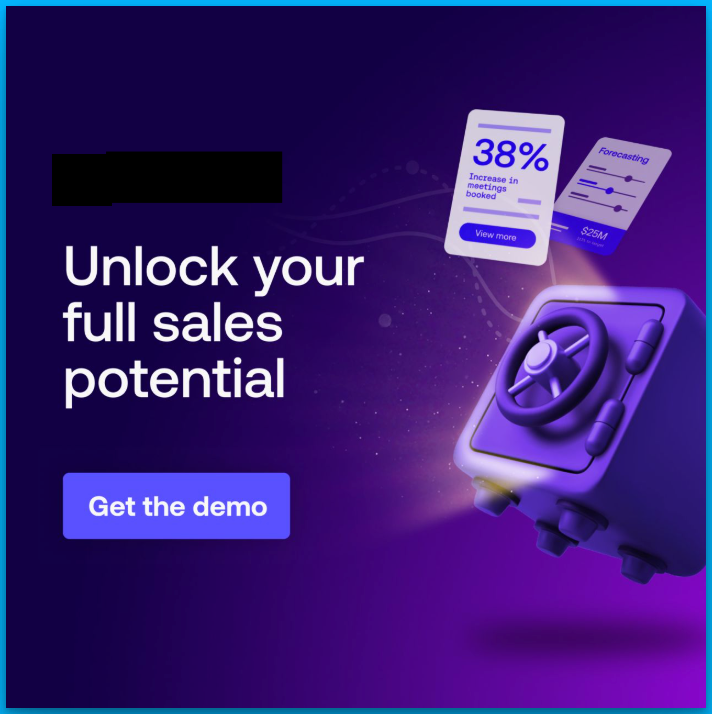
And while, yes, everyone wants to make more sales, statements that solely focus on a result, without explaining the how, leave people in the vague zone.
The mind craves certainty, tangibility and proof. So you’ll want to get out of the vague zone and into the land of specificity as quickly as possible.
Here’s how to fix it
In our B2B ad agency, we have consistently seen this formula perform again and again.
1. Hone in on one specific feature
2. Clearly tie it to a very specific outcome
3. Show how the feature actually achieves that outcome
(Bonus if you combine it with a visual snapshot of this process happening on the platform)
Let’s take an example.
Imagine you are an analytics company that tracks user behavior on your website.
Your product has a LOT of functions, but it essentially allows marketing teams to understand what users do on your website, so they can improve user experience and ultimately make more sales.
Usually, something like this happens. You simplify the whole process and end up with a headline like “Turn data into dollars.”
Short and catchy, right?
Maybe. But if you ask the marketing manager reading the ad to explain what they’re actually getting? They will have no idea.
Try this instead.
Think about one core feature of your product that customers like.
In this case, it could be tracking when customers drop off during the sales process.
Focus the whole ad around that feature.
For example, we could say something like “See when customers drop off, remove obstacles that stop them buying.”
Ok, you can make it catchier than that.
But this version allows our audience to really understand how the product helps them.
Combining this with a visual to show what we mean is also a game changer. Here this might look like a simplified snapshot of a tracking dashboard, with a notification that says “462 users dropped off at checkout.”
This ad is now:
⤷ Tangible
⤷ Our audience gets what our product does
⤷ And instead of spelling out the result, we make it easy to make the connection between this feature and making more sales.
Here’s a real example from one of my clients, a data analytics platform. It hones in on one specific feature that allows you to watch replays of users navigating your platform:
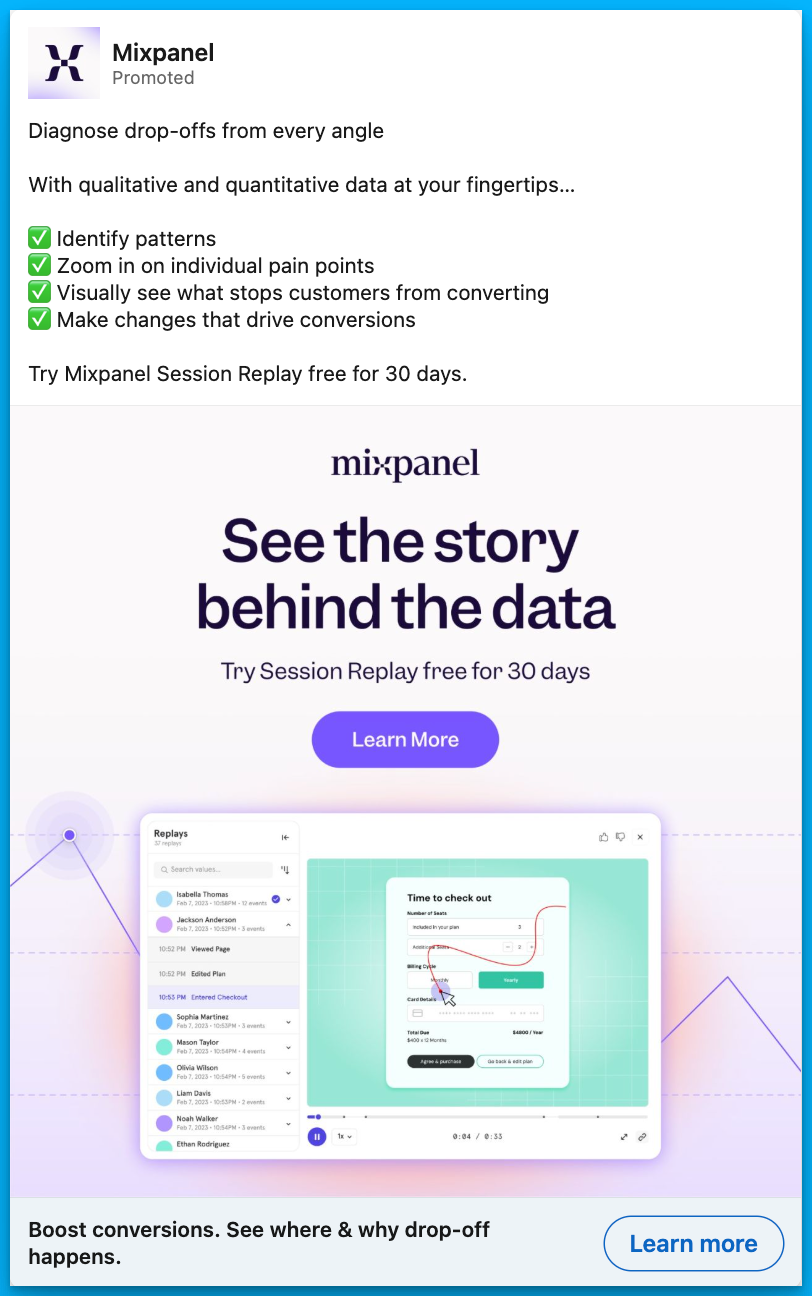
Mistake #2: Trying to fit too much in one ad
When you work closely on a product, you are acutely aware of ALL its awesome features.
But, that doesn’t mean you should mention them all in a single ad.
While you might think everything is important, speaking to too many benefits or features can confuse or overload your audience, ending up something like this ⤵
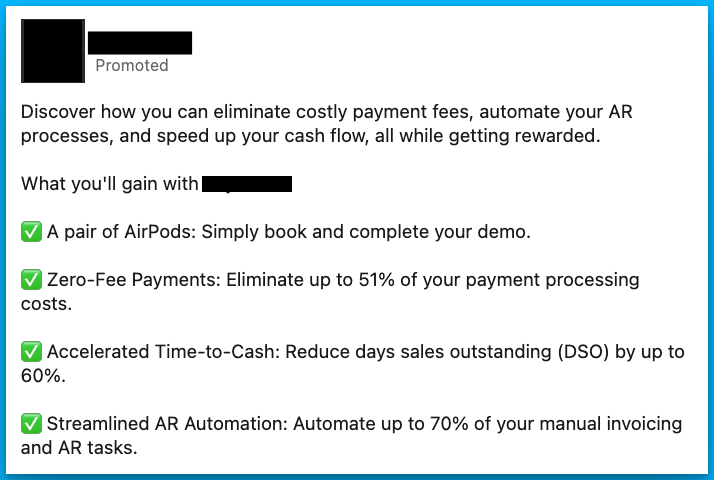
The more you make your audience work to understand your product, the more likely they won’t remember your ad at all.
Speaking to one benefit in one ad is typically much more memorable.
The goal of an ad in SaaS isn’t usually to make an outright sale – B2B sales processes are far too long and convoluted for that.
Instead, we want to pique our audience’s interest just enough to click to learn more.
They can then dig further into your features on the website or landing page.
Here’s how to fix it
So how can you avoid saying too much?
Let’s take an example.
Imagine you have a marketing automation software that:
- Automates email campaigns
- Segments audiences
- Includes prebuilt templates
- Connects to a CRM
- Integrates with tools
- AND has analytics capabilities
You might be struggling to know what to focus on.
Try this.
Choose a real-life use case. For example, reviving abandoned cart sales with automated emails.
Instead of listing features, your ad might say something like:
“70% of shoppers abandon their cart. Bring them back with set-and-forget followups you can activate in a few clicks.”
Not only does this hone in on one easy-to-grasp feature, it also helps your audience imagine implementing and benefiting from the product.
Here’s another example from one of my clients, a customer feedback analytics platform. It focuses on the use case of automating feedback tagging:

Mistake #3: Using buzzwords
We know we shouldn’t use buzzwords, but still, it’s a constant battle not to let them worm their way into B2B content.
I get it.
⤷ Everyone else is using them
⤷ They are an industry norm
⤷ And they neatly encapsulate what we want to express
But ultimately, they are the lazy way out. And they are killing your conversions.
So the next time you feel the urge to harness, unlock, optimize, revolutionize, supercharge, streamline, or transform in your B2B ads, try this 👇
Do the tangibility test.
- Can your claim be proved right or wrong?
- Could you go away and draw it on a piece of paper?
If the answer is no, keep reworking it until it’s a yes.
Here’s how to fix it
Let’s take the headline of this ad ⤵
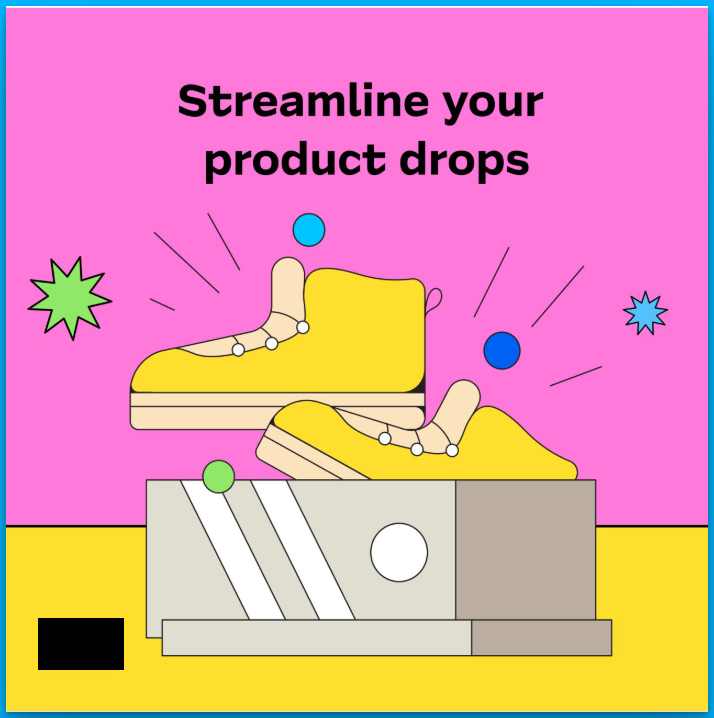
Could you prove with a yes or no if this company can ‘streamline product drops’? Erm, I’m not really even sure what that means.
Could you draw ‘streamlining a product drop’ on a notepad? Me neither.
I did some digging and learned that this company offers a platform where brands can run eCommerce launches.
So let’s adapt the headline to something like this.
“Launch your new clothing line on a platform that will never crash.”
Could you prove it’s possible or not to launch products on this platform? Yes.
Could you prove it to be true or false that the platform will never crash? Yes.
Could you draw this concept on a piece of paper? I could give it a good shot.
Here’s an example for one of my clients, where I used conversational and human language over buzzwords to promote a webinar:

Final Thoughts
Great SaaS ads don’t have to be flashy or loaded with buzzwords. They succeed when they:
- Show how they achieve the outcome
- Focus on a single message at a time
- Use clear, tangible language over jargon
By avoiding these three common messaging mistakes, you’ll not only boost your click-through rates but also connect with your audience in a way that builds trust and drives action.
Now, go audit your ad copy—what changes can you make today?
Hope you found this article helpful! 👏
Feel free to reach out on LinkedIn with any copywriting questions.
And for more B2B SaaS copywriting tips, check out this article by Eden Bidani.
Free Resources to Build a Full-Funnel Paid Media Program
If you want to build a full-funnel B2B paid media program, then you should definitely check our free course Building a Paid Media Program: Scale Your B2B SaaS Advertising.
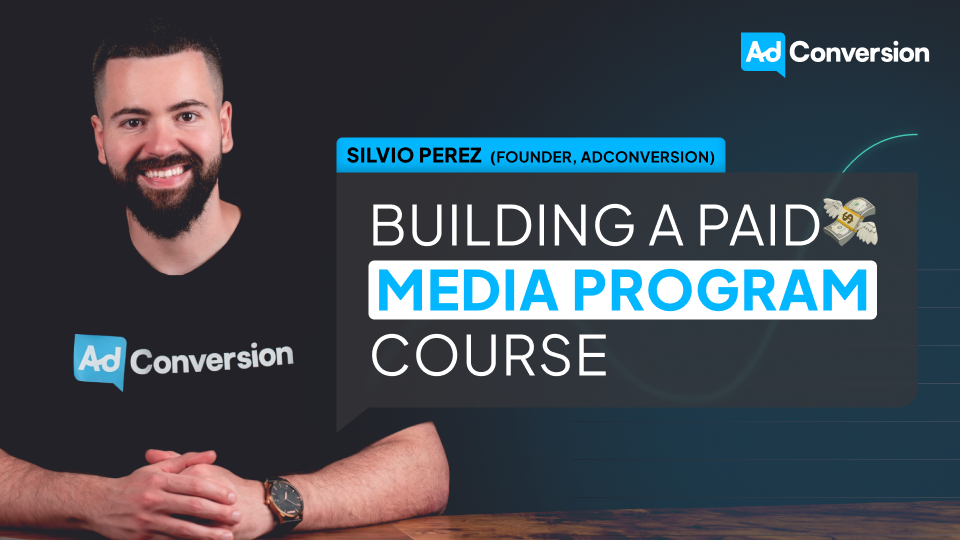
Here’s what is in for you:
- Module 1: you'll learn the S.C.A.L.E framework for building a paid program.
- Module 2: you'll learn how to create your paid strategy with the five stages.
- Module 3: you'll learn how to measure your paid media program correctly.
- Module 4: you'll learn how to create world-class campaigns from A-Z.
- Module 5: you'll learn how to create an experimentation engine.
- Module 6: you'll learn how to scale with the Scaling Quadrant.
It doesn’t matter if you’re a seasoned B2B advertiser or a complete newbie.
You’re going to walk away with frameworks and repeatable processes for building a paid media program that scales.
Click Here to Join 1,000+ B2B Marketers Today and start leveling up your advertising skill set.
It takes < 90 seconds to sign up (seriously we timed it 😂)
People Also Ask
How can I effectively measure the impact of improved ad messaging on my campaign performance?
Utilize A/B testing to compare different ad copies and analyze metrics like click-through rates (CTR), conversion rates, and cost per acquisition (CPA) to determine which messaging resonates best with your audience.
What are some strategies to ensure my ad messaging aligns with my target audience’s pain points and needs?
Conduct thorough market research, including customer surveys and interviews, to gain insights into your audience’s challenges. Use this information to craft messages that directly address their specific concerns.
How can I balance creativity and clarity in my ad messaging to effectively communicate my value proposition?
Focus on clear and concise language that highlights the unique benefits of your product. While creativity can capture attention, clarity ensures the message is understood and compelling.
What role does audience segmentation play in crafting effective ad messages for B2B SaaS products?
Segmenting your audience allows for personalized messaging that speaks directly to the needs of different groups, increasing relevance and engagement. Tailor your ad copy to address the specific pain points of each segment.
How can I avoid using jargon or buzzwords in my ad messaging while still appearing knowledgeable and credible?
Use straightforward language that clearly explains your product’s benefits. Focus on how your solution solves problems rather than relying on industry jargon, which can alienate or confuse potential customers.
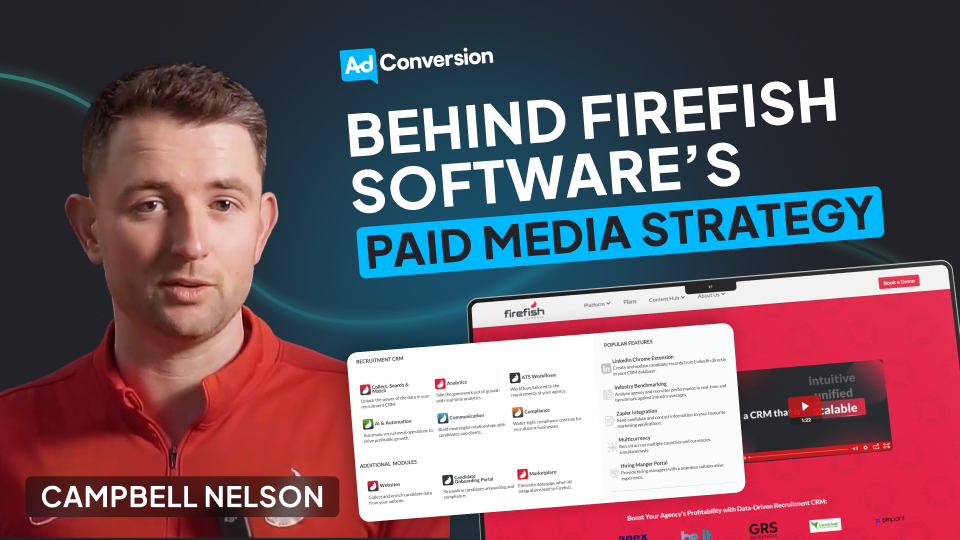
Behind Firefish Software’s Paid Media Strategy
Hey everyone 👋
I’m Campbell Nelson, Marketing Director at Firefish Software, a CRM designed for recruitment agencies.
Over the last 12-18 months, I’ve led Firefish Software’s transition from a traditional lead gen strategy to a demand gen approach, which has helped us significantly increase both pipeline and brand awareness.
I’ll be breaking down our entire paid media strategy & sharing my learnings below👇
TABLE OF CONTENTS
Background
Last year, we made the transition from lead gen to demand gen for the following reasons:
1. While we were generating a ton of MQLs, our lead to opportunity and opportunity to closed won conversion rates were poor. We hypothesised that by going ungated, we could build more trust and increase conversion rates.
2. New clients acquired through lead gen campaigns had a relatively low LTV and were problematic when it came to stickiness, which seemed to indicate a lack of brand affinity. By switching to a demand gen approach, we believed that we could solve this issue and increase retention further through the lifecycle.
3. In the CRM space, buying cycles are dictated by contract renewals which can sometimes run for up to 4 years, meaning that most prospects are out of market. By shifting to ungated content, our goal was to maximize distribution and increase long-term mental availability, which would be crucial for predictable growth.
4. When attending conferences and expos, a lot of prospects mentioned our blog but had no idea that we were a CRM software – this was indicative of a lack of product awareness. We decided that ungated content would be necessary to distribute our value propositions more widely and be in the consideration set when prospects entered the market.
So far, this shift has been highly successful. Since going ungated and removing lead gen forms, we’ve seen a 40% year-on-year increase in opportunities from direct and organic branded search channels. Further down the funnel, we’ve seen a 50% increase in closed-won revenue from branded organic search and each quarter we are seeing incremental improvements in our win rates from each demand focussed channel – all associated with increased awareness.
Our Strategy
Here’s the full breakdown of the paid media strategy that has led to our success👇
30% of our LinkedIn budget goes to content. These are typically playbooks and other resources that will help recruiters (key members of the buying committee) become better at their jobs. If everyone in the buying committee trusts us and has an awareness of our value, we know that they’ll champion us and push deals over the finish line.
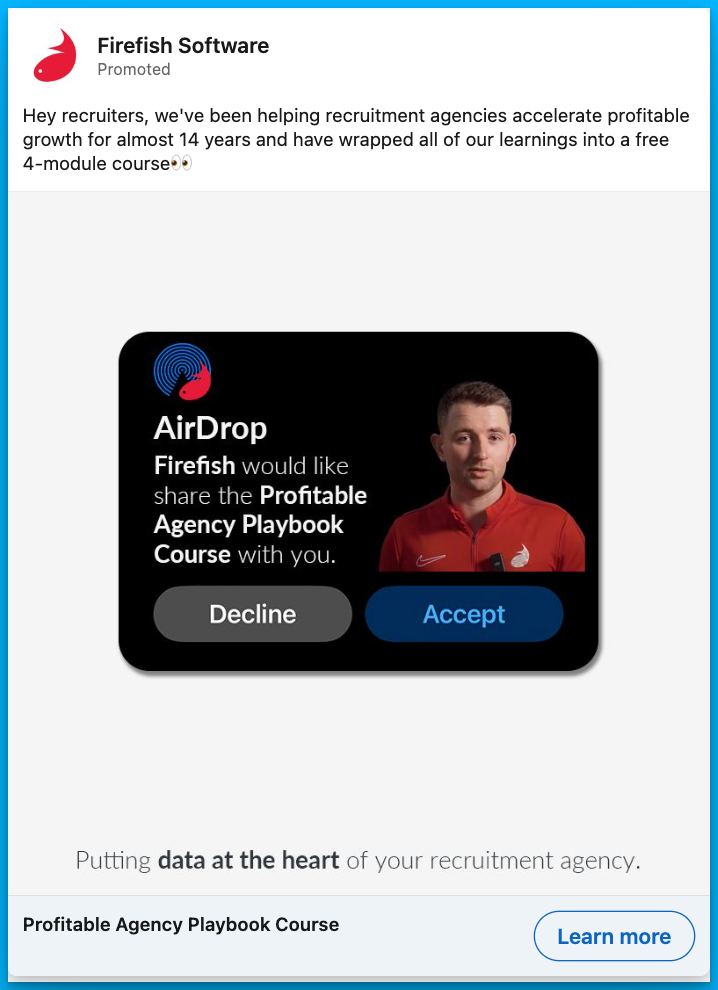
50% of our budget goes to product ads, aimed at our key decision makers (C-suite, VPs, Directors). These ads are all related to our main value propositions, and they clearly articulate how we can solve their biggest problems.
By consistently highlighting these pain points, we know that we’ll be top of mind when decision-makers start actively searching for solutions.

Finally, the remaining 20% of our LinkedIn budget goes to social proof. We show these ads to both champions (recruiters) and decision-makers (VPs and execs) that have entered our remarketing audience, either by visiting our website or engaging with other ads in some capacity.
The goal of these ads is to continue to build trust and increase the likelihood of a conversion.
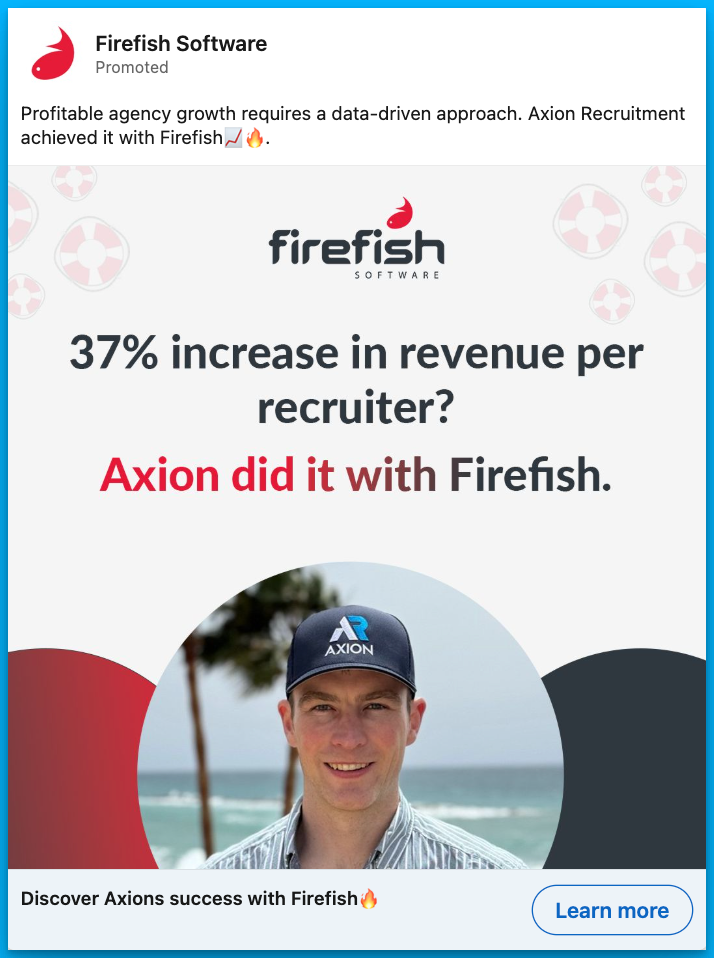
YouTube
While most of our spend happens on LinkedIn, we also run YouTube Ads to stay in front of prospects across multiple channels.
All of these ads clearly highlight our value propositions and show exactly how our product works.
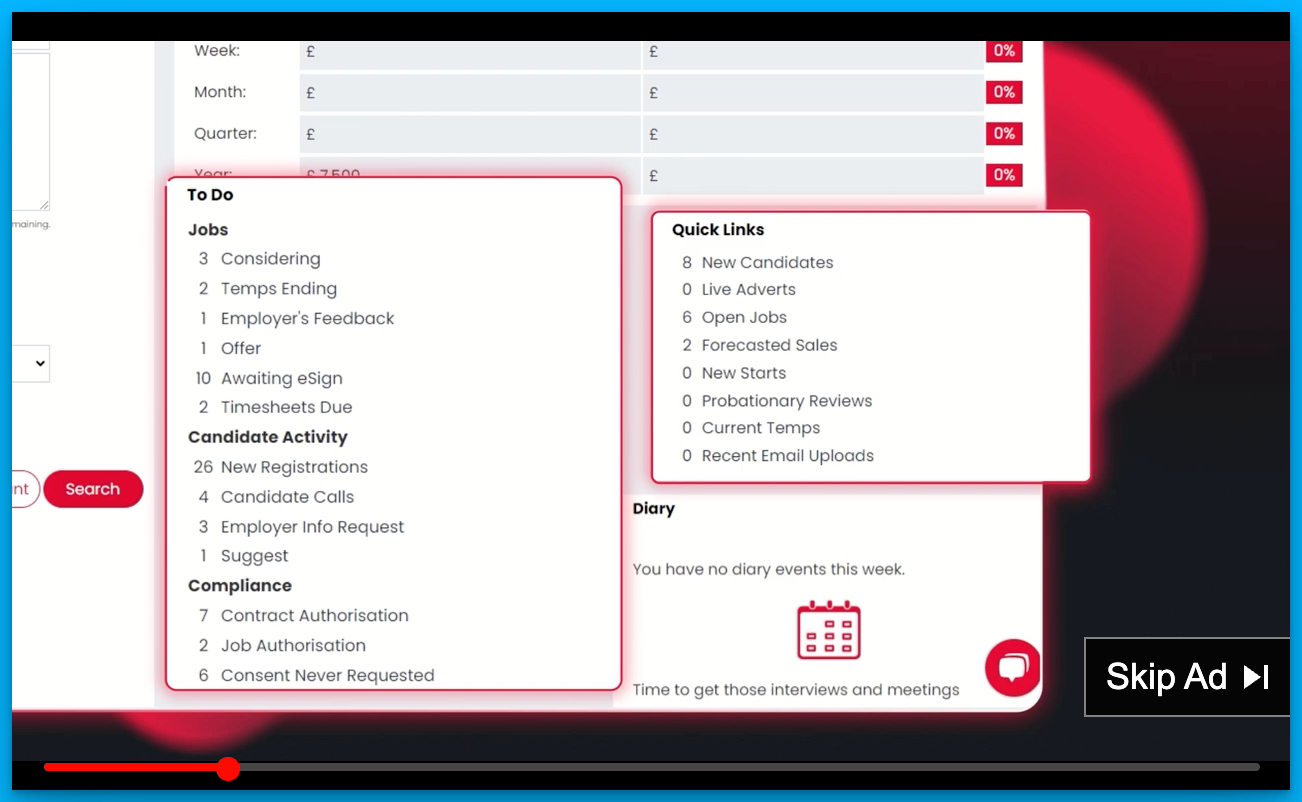
To minimize wasted spend, we run these 30-second video ads to our warmest audiences:
1. Remarketing, staying in front of people who have already visited our site
2. Prospecting, targeting people who have searched our dream product-related keywords on Google (doing this via YouTube is great because we can get in front of high-quality prospects without paying Google’s insanely high CPCs)
Lessons Learned
By leading Firefish Software’s marketing and implementing this strategy, I’ve learned a lot of important lessons – here are the biggest ones:
1. It’s okay to make mistakes
You’re not going to get everything right the first time around. Sometimes your message won’t resonate and your ads will flop, and that’s okay. Marketing is all about failing, learning from the failures, and trying again.
2. Nail down your value proposition
This is something that so many B2B SaaS companies get wrong 😢
In the early days, we were testing a lot of different messages in our ads, but we hadn’t clearly outlined our value proposition or the problems we were solving with our product.
Now that we’ve clearly outlined our core value props, all our ads highlight them in some capacity. Also, most of our content now relates to these value props as well, so we can easily repurpose it for our ad campaigns.
Ultimately, having alignment across your entire marketing department on overall messaging is essential to maximize your ROI and return on effort.
3. Create a memorable experience
It’s so easy to fall into the trap of copying exactly what’s already being done in your industry.
But by doing this, you’ll likely end up with vanilla B2B ads that your prospects won’t remember. I know we definitely fell into this trap, running generic ads with boring “click here” CTAs 🥱
No matter what type of ads you’re running – product, content, social proof, etc. – the most important question you should ask yourself is:
Are my ads memorable?
If they aren’t, prospects probably won’t think of your brand when it’s time to buy.
4. Figure out attribution
If you’re switching to a demand gen strategy, you need to get good at stakeholder management and bring your CRO/CFO along on the journey – otherwise, they might be alarmed by the sudden decrease in leads.
To prove that your strategy is working, I highly recommend using an attribution tool like Dreamdata or HockeyStack (Dreamdata has a free version that you can get started with) to demonstrate that certain touchpoints are having an impact on pipeline.
In addition to this, it’s a good idea to set up microconversion events, such as engaged visits, to demonstrate that your ICP is finding value in your content.
Finally, make sure you’re also tracking positive comments and mentions of your ads in self-reported attribution – showing these to the leadership team will increase their confidence in your new demand gen approach.
5. Have fun
We often forget this in B2B, but marketing is supposed to be fun.
It’s supposed to be about creativity and testing new ideas, not just measurement and graphs. If you’re having fun, your prospects will take notice, and will likely be more interested in working with you.
Hope you found this article helpful!
Feel free to reach out on LinkedIn with any questions about paid media or B2B marketing.
Free Resources to Build a Full-Funnel Paid Media Program
If you want to build a full-funnel B2B paid media program, then you should definitely check our free course Building a Paid Media Program: Scale Your B2B SaaS Advertising.

Here’s what is in for you:
- Module 1: you'll learn the S.C.A.L.E framework for building a paid program.
- Module 2: you'll learn how to create your paid strategy with the five stages.
- Module 3: you'll learn how to measure your paid media program correctly.
- Module 4: you'll learn how to create world-class campaigns from A-Z.
- Module 5: you'll learn how to create an experimentation engine.
- Module 6: you'll learn how to scale with the Scaling Quadrant.
It doesn’t matter if you’re a seasoned B2B advertiser or a complete newbie.
You’re going to walk away with frameworks and repeatable processes for building a paid media program that scales.
Click Here to Join 1,000+ B2B Marketers Today and start leveling up your advertising skill set.
It takes < 90 seconds to sign up (seriously we timed it 😂)
People Also Ask
How can transitioning from a lead generation to a demand generation approach impact the quality of leads and overall customer retention?
Shifting to demand generation focuses on creating awareness and interest, potentially attracting more engaged prospects who have a genuine need for your solution, leading to higher-quality leads and improved customer retention.
What are the key considerations when deciding to ungate content in a B2B marketing strategy?
Consider the trade-off between lead quantity and quality. Ungating content can enhance trust and reach, but it’s essential to have alternative methods for capturing prospect information and nurturing leads effectively.
How can a company effectively measure the success of a demand generation strategy compared to traditional lead generation?
Evaluate metrics such as brand awareness, website engagement, lead-to-opportunity conversion rates, and customer lifetime value to assess the effectiveness of demand generation efforts.
What challenges might arise when shifting from a lead generation to a demand generation model, and how can they be addressed?
Challenges include aligning internal teams, redefining success metrics, and adjusting marketing tactics. Address these by providing training, setting clear goals, and maintaining open communication across departments.
How can a demand generation approach be tailored to accommodate long buying cycles, such as those influenced by multi-year contracts?
Implement strategies that maintain ongoing engagement with prospects, such as regular content updates, nurturing campaigns, and staying top-of-mind until they are ready to make a purchasing decision.

3 Simple B2B PPC Optimization Tips For Better ROI [+Free Cheat Sheet]
Hey B2B marketer! Without clearly defined rules for testing and optimizing your PPC campaigns, you’re either going to pause things prematurely, or you’re going to scale too early.
In this article, you’ll learn how to make decisions based on logic instead of emotions when managing your PPC campaigns.
Let’s dive in! 👇
TABLE OF CONTENTS
- 1 - Find Your Breakeven Costs
- 2 - Non-Performer Rule
- 3 - Maintenance Rule
- 4 - Free PPC Optimization Cheat Sheet
- 5 - Free Resources to Build a Full-Funnel Paid Media Program
1 - Find Your Breakeven Costs
Your goal is to drive more pipeline and revenue, so knowing how much you can afford to spend per lead or click is the first step to ensure you don’t lose money while optimizing for performance.
Breakeven Cost per Lead
Here’s what you will need to calculate your breakeven cost per lead:
- Take your average deal size
- Multiply that towards your lead to close won rate.
Example:
If your deal size is $3,000 and your close rate is 10%, your breakeven cost per lead is $300.
This means that when optimizing your ppc campaigns, you can spend up to $300 to break even. So you’ll start to lose money if anything goes after $300.

Breakeven Cost per Click
This is a step further and will inform what you’re willing to pay the channel for a click.
Here’s what you will need to calculate your breakeven cost per click:
- Take the breakeven cost per lead target
- Multiply that towards your landing page or form conversion rate if you use lead gen forms.
Example:
If your breakeven cost per lead is $300 and your landing page/form conversion rate is 5%, your breakeven cost per click is $15.

This foundational math grounds your optimization decisions and eliminates emotional bias, ensuring you stay within profitable bounds.
2 - Apply a Non-Performer Rule
When ads fail to deliver results, emotions often lead us to either pause campaigns too soon or let them run too long.
This is where the non-performer rule saves the day.
The rule is simple:
- Pause any ad that spends 2-3x your target cost per lead without generating conversions.
- Timeframe: All time.
Example:
If your target is $300 per lead and you spend $600-$900 without results, it’s time to hit pause.
This removes emotional bias and gives your ads a fair shot before deciding their fate.
By doing this, you stop wasting money and gain clarity on what isn’t working, allowing you to allocate your budget more effectively.
3 - Apply a Maintenance Rule
Even great ads don’t perform forever. Over time, performance may drop due to ad fatigue or other factors.
The maintenance rule will help you handle these scenarios with logic, not guesswork.
Here’s how it works:
- If an ad’s cost per lead increases to 1.5-2x your target over a 7-14-day period, it’s time to pause.
Example:
If your cost per lead target is $300, an ad costing $450-$600 per lead is no longer viable, and you should pause it.
Free B2B PPC Optimization Rules Cheat Sheet
Save this cheat sheet below to have these rules on hand when optimizing your B2B PPC campaigns. 🙂
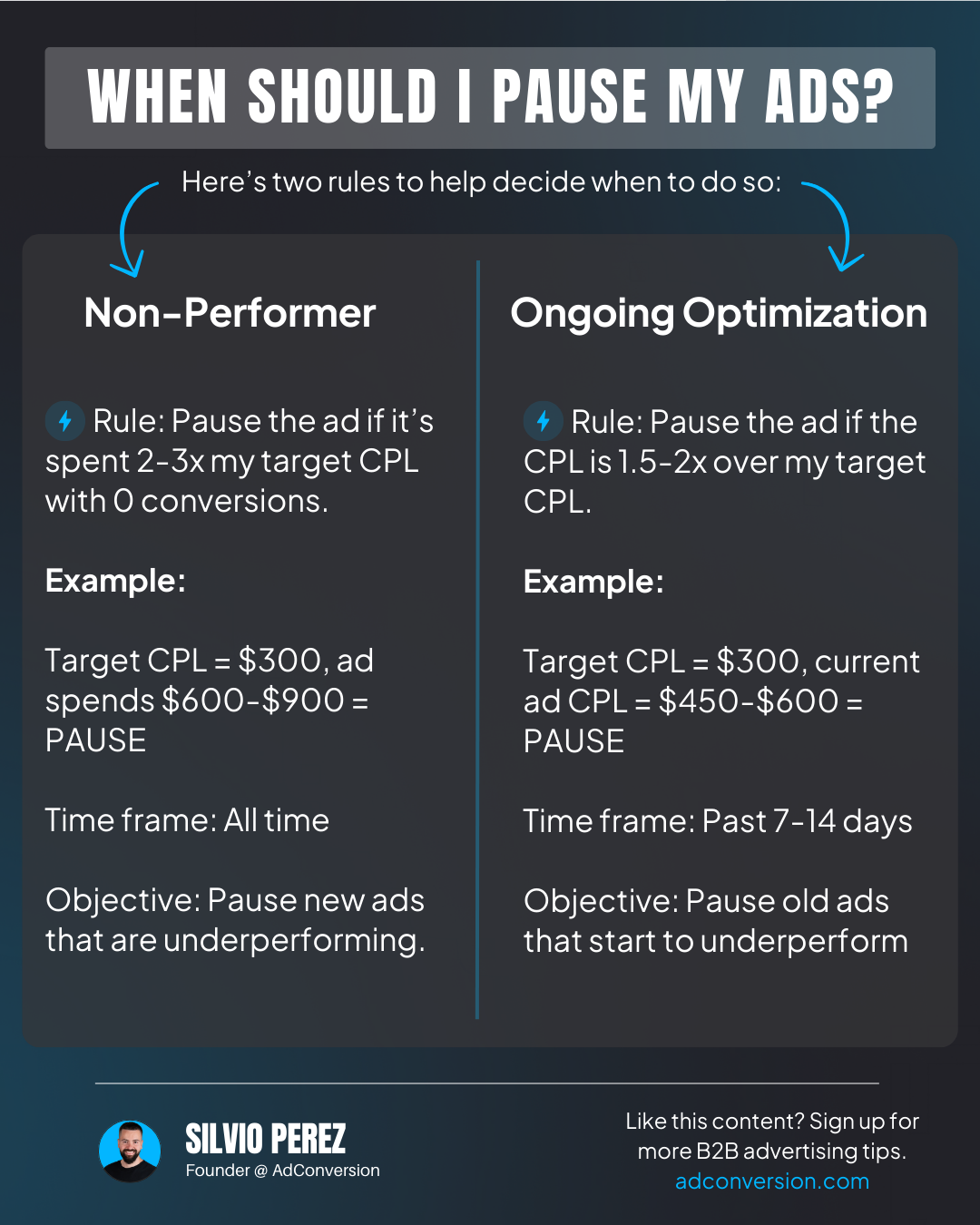
This isn’t statistically significant, but it’s an easy approach grounded in logic that helps to remove emotion.
Remember: The best advertisers think like investors, and they execute like scientists, so rational thinking is key.
By calculating breakeven costs, applying the non-performer rule, and using the maintenance rule, you can make logical, repeatable decisions that keep your B2B campaigns profitable and focused.
With the automated rules feature, you can even automate some of these actions for certain channels like Google Ads. To learn more about that, check out my free B2B Google Ads 102 Course - How To Convert Clicks Into Profit.
I hope you found this article helpful ✌️
If you have any questions, feel free to connect with me on LinkedIn.
Free Resources to Build a Full-Funnel Paid Media Program
If you want to build a full-funnel B2B paid media program, then you should definitely check my free course Building a Paid Media Program: Scale Your B2B SaaS Advertising.

Here’s what is in for you:
- Module 1: you'll learn the S.C.A.L.E framework for building a paid program.
- Module 2: you'll learn how to create your paid strategy with the five stages.
- Module 3: you'll learn how to measure your paid media program correctly.
- Module 4: you'll learn how to create world-class campaigns from A-Z.
- Module 5: you'll learn how to create an experimentation engine.
- Module 6: you'll learn how to scale with the Scaling Quadrant.
It doesn’t matter if you’re a seasoned B2B advertiser or a complete newbie.
You’re going to walk away with frameworks and repeatable processes for building a paid media program that scales.
Click Here to Join 1,000+ B2B Marketers Today and start leveling up your advertising skill set.
It takes < 90 seconds to sign up (seriously we timed it 😂)
People Also Ask
1 - What’s PPC optimization all about?
Think of PPC optimization as fine-tuning your paid ads to get the most bang for your buck. It’s about tweaking keywords, targeting the right B2B audiences, crafting killer ad copy, and making sure your landing pages are on point. The goal? To get your ads in front of the right decision-makers and drive those valuable actions that matter to your business.
2 - How does ad copy make or break a B2B PPC campaign?
Your ad copy is your first impression—so make it count! Speak directly to your audience’s pain points and needs. Highlight what makes you stand out, whether it’s a solution to their problem or something that saves them time and money. Test out different versions (because A/B testing is your best friend) and see what clicks—literally.
3 - Why are landing pages such a big deal in B2B PPC?
Landing pages are where the magic happens. When someone clicks your ad, they expect to land on a page that delivers exactly what was promised. If your landing page is laser-focused, speaks to their needs, and makes it easy to take the next step, your conversion rates will thank you.
4 - What metrics actually matter in B2B PPC campaigns?
In B2B, it’s not just about clicks—it’s about qualified leads and pipeline growth. Watch metrics like CTR, CPC, conversion rate, cost per MQL/SQL, pipeline generated, and ROAS. For Google Search campaigns, don’t ignore quality score. These numbers will tell you if you’re spending wisely or burning budget.
5 - Why is monitoring your B2B PPC campaigns so important?
Things change fast in PPC—your audience, your competition, and even market trends. Keeping a close eye on your campaigns helps you pivot quickly when needed, refine your approach, and keep your ROI looking sharp. Regular check-ins = better results. Simple as that.

How to Audit B2B Google Ads Accounts [+Free Template]
Google Ads is not getting any cheaper, so frequently auditing your account is critical to keep your campaigns profitable.
In this step-by-step guide, I will walk you through the exact same process we use internally to audit our clients’ Google Ads accounts.
As a bonus, you can get a free copy of my 8-Part Google Ads Audit Checklist from Module 1, Lesson 5 of my B2B Google Ads 102 free course, so you can have it on hand while you go through the tasks below.
So let’s get started 👇
TABLE OF CONTENTS
- Part 1 - Account Review
- Part 2 - Campaign Review
- Part 3 - Ad Group Review
- Part 4 - Keyword Review
- Part 5 - Ads & Extensions Review
- Part 6 - Landing Page Review
- Part 7 - Budget & Performance Review
- Part 8 - Visibility Review
- Resources to Master B2B Google Ads
- Google Ads Audit FAQ
Part 1 - Account Review
First and foremost, you can’t improve your account performance without mastering the basics. So let’s dive in!
1. Billing Information
Is your billing information correct?
Checking this will ensure that your ads continue to run smoothly and you don't face any unexpected billing issues.
To check your billing information, follow these steps:
- Sign in to your Google Ads account.
- Click on the "Billing" icon on the left-hand menu.
- Click on "Settings" to view your current billing information.

Here, you can view your payment method, payer details (name, address, etc), and other important details.
Make sure all the information is correct and up-to-date. If you notice any errors, click on the pencil next to each detail to make the necessary changes.
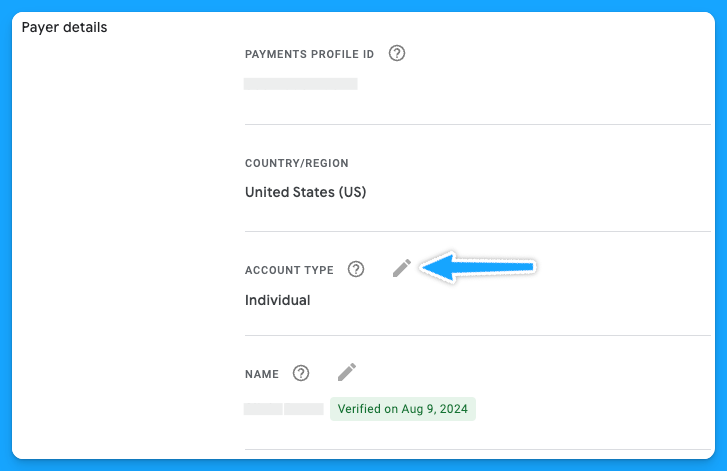
It's important to note that any changes you make to your billing information may take up to 24 hours to take effect.
Additionally, if you have any pending charges on your account, you won't be able to make changes until those charges are paid off.
2. Is your time zone correct?
The accuracy of your account's time zone setting is more crucial than it may seem at first glance. The time zone affects how you schedule ads, interpret performance data, and manage billing cycles.
You cannot change your time zone manually, and it can only be reset once, so as Google advises, choose your new time zone carefully.
To request a change, you’ll need to fill out this form and follow the instructions below:
- The form must be filled out by an Admin user of a manager account.
- Your time zone can only be shifted eastward, for example, from GTM (Greenwich Mean Time) to IST (India Standard Time).
3. Do you have auto-tagging turned on?
Auto-tagging is an easy 3-step process:
- Sign in to your Google Ads account
- On the left-hand side, under admin> click on Account Settings
- Click on “Auto-tagging” - check the box and save.
Once you enable this feature, Google will automatically mark your source_medium as “cpc”
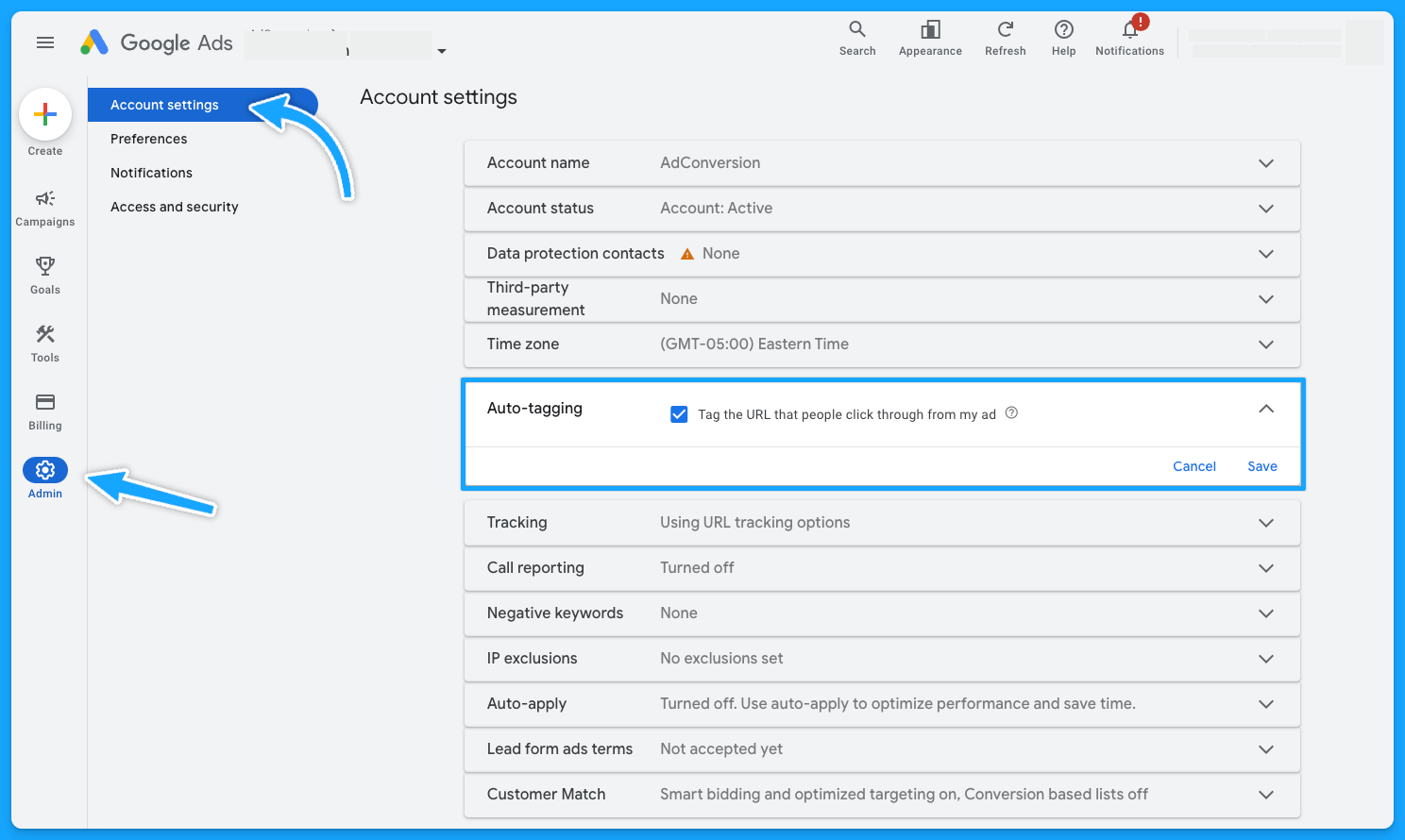
4. Did you turn off ad suggestions?
Have you ever gone to your Google Ads account and noticed a bunch of changes that weren’t made by you or anyone on your team?This probably happened because you didn’t turn off the ad suggestions 😅
So follow these steps to have peace of mind:
- Sign in to your Google Ads account.
- Click on the "Campaigns" on the left-hand menu.
- Click on "Recommendations" and go to “Auto-apply”

Make sure you turn off all of the recommendations that aren’t relevant to your account.
I personally like to turn off all of them, so I don’t have any changes made by Google without my consent.
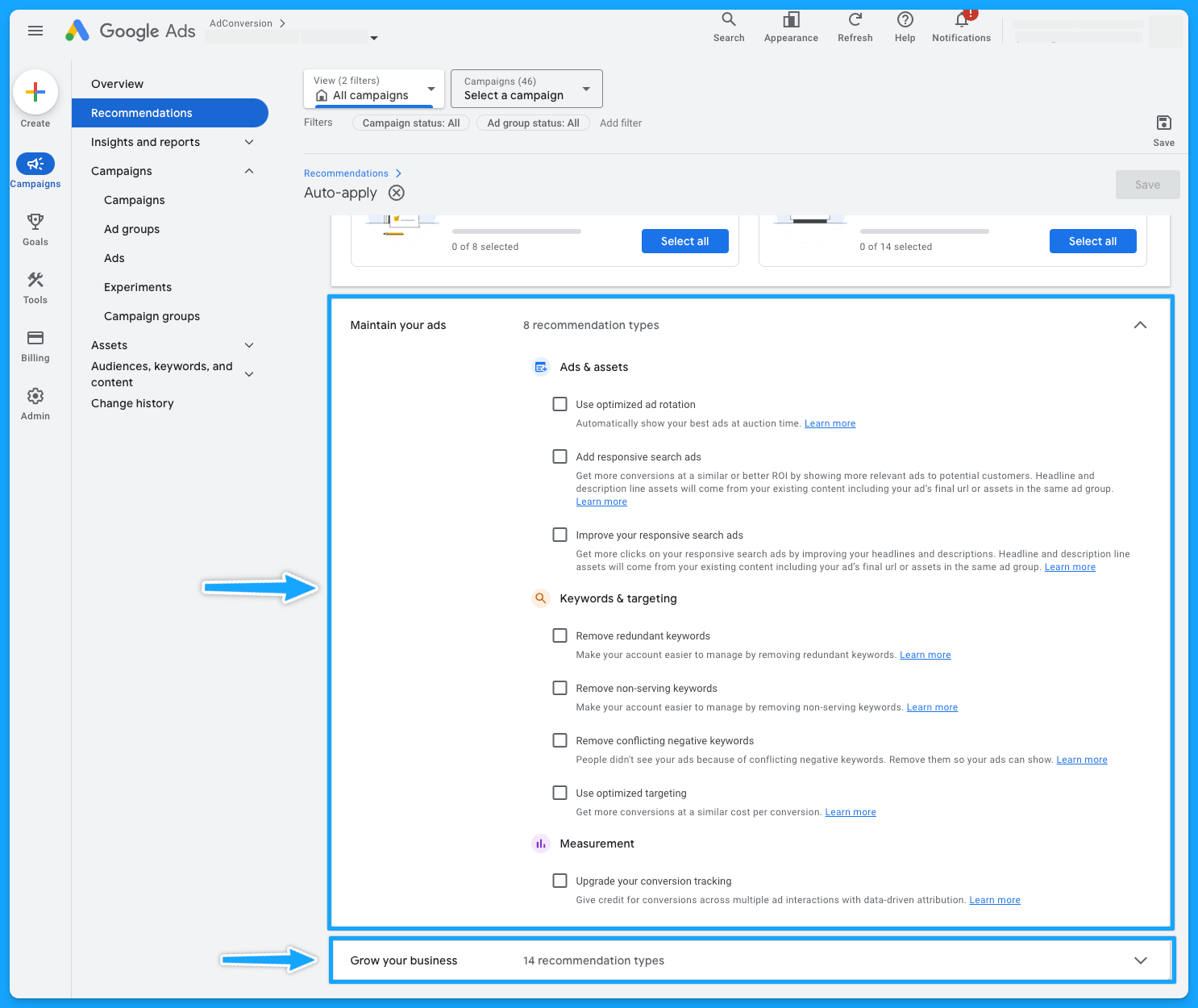
5. Is your conversion tracking still working accurately?
This is crucial because if your conversion tracking is not working correctly, you won’t feed Google’s algorithm with essential data to make the best bidding choices for your conversion-based strategies.
Here’s how you can check if your tracking is in place:
- Sign in to your Google Ads account.
- Click on the "Goals" on the left-hand menu.
- Click on "Conversions" and go to “Summary”
- You’ll be able to see the status of your conversions - you want to see “Active”
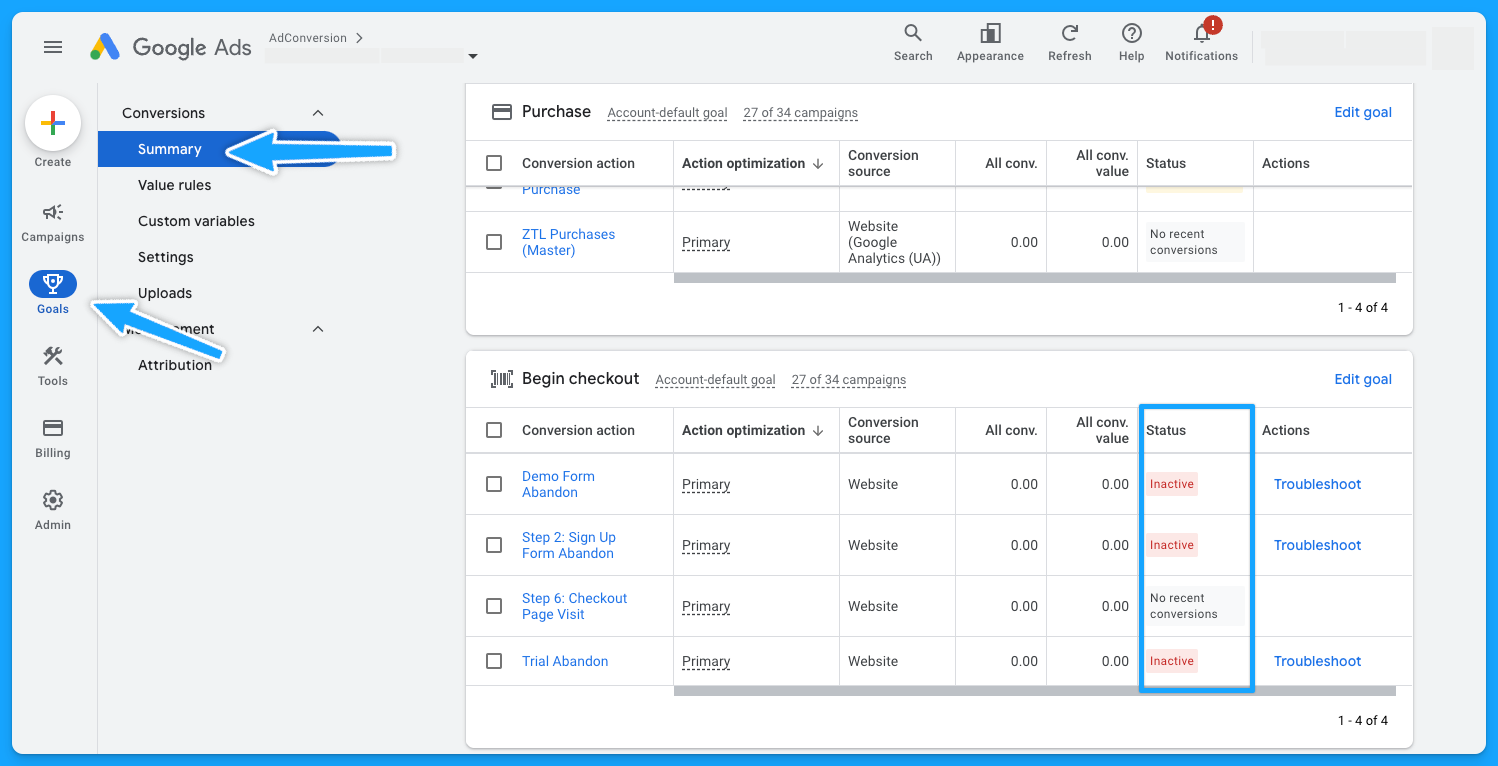
Pro-tip: If you see the status “No recent conversions” - search for your keyword on Google and submit a test.
If you don’t see any activity and have been running Google Ads campaigns for a while, it probably means you’ll need to see what’s going on to ensure the tracking setup is in place.
Part 2 - Campaign Review
Depending on the size and organization of the account, this step will take longer or shorter. So let’s go 👷♂️
1. Do your campaigns follow a logical naming convention?
Having a solid naming convention in place isn’t just about aesthetics, it’s the foundation for good account management.
My campaigns usually have a naming convention that follows this structure:
- Region (NA, EMEA, APAC)
- Campaign Theme (Brand, NonBrand, Generic, Competitor)
- Keyword Topic
- Network (Search, Display)
- Keyword Match Type (Exact, Phrase, Broad)
- Device (Desktop, Mobile, All Devices)
- Offer (Demo, Trial, etc)

So if you have disjointed campaign names, it’s an opportunity to adjust that and make your life easier.
2. Are you targeting the right networks (display unchecked)?
You want to focus on the Search Network and search partners, avoiding the Display Network unless it’s a separate campaign.
- Select the desired campaign
- Go to “Campaign Settings” (on the right-hand side)
- Click on Networks
- Choose the desired Network and save

- At the campaign level
- Scroll over your campaign
- Setting logo will appear
- Click on the logo
- Under Networks, choose the desired Network and save.

3. Is your location targeting and options still accurate?
If you have a proper naming convention, you should be able to tell where you intend to target your campaigns, but you still need to ensure the correct locations are selected.
Similar to Networks, there are two ways to check your locations:
- Select the desired campaign
- Go to Locations (on the left-hand side - Audiences, keywords and content)
- Click on the pencil icon
- Choose the desired locations and save
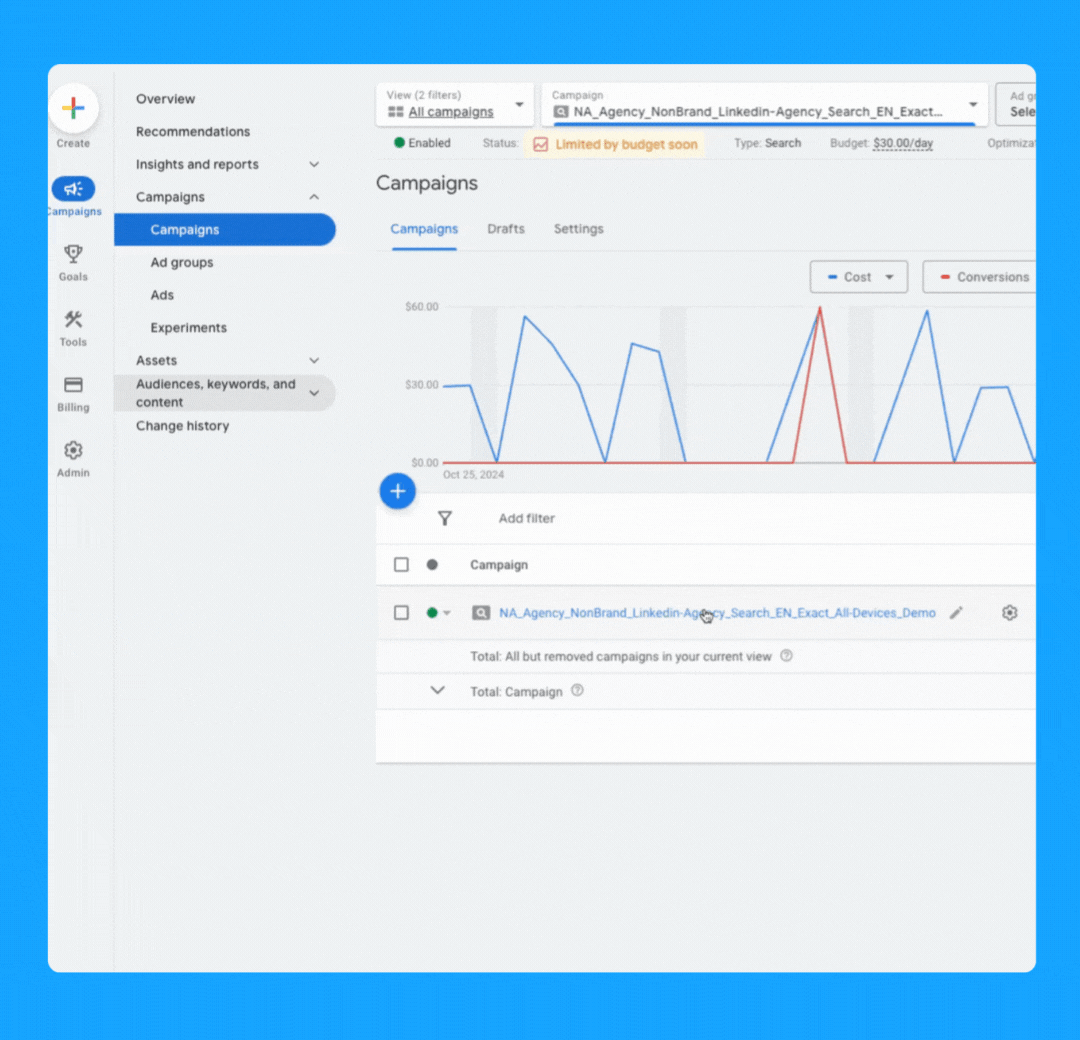
- At the campaign level > Scroll over your campaign
- The settings logo will appear
- Click on the logo
- Under Locations, Enter location(s) and Save.

4. Are you targeting one language per campaign (with relevant ads + landing pages)?
In a perfect world, your ads and landing pages should match the primary language of the targeting locations.
Here’s how you can change the language of your campaigns:
- At the campaign level, toggle over your campaign name
- Click on the icon setting once it appears
- Under “Languages” you can select the desired language and click Save.
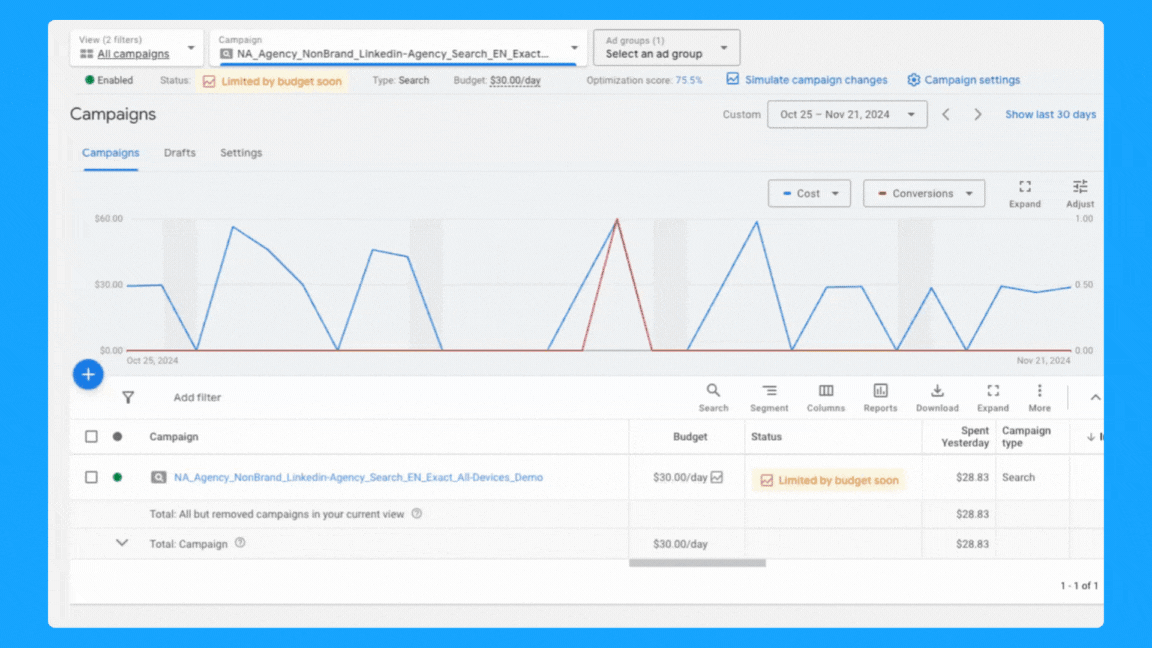
5. Is your daily budget still aligned with your goals?
Being an effective marketer involves strategically allocating your budget over the designated campaign duration while achieving the goals.
Ex. If your average cost per demo is $300 and you need to generate 10 demos, then you must have at least $3,000 - Now, if the plan is to run the campaign for 30 days, then you must allocate a $100 daily budget and check daily to make sure it’s pacing well.
Generally speaking, I don’t recommend running campaigns with less than $50/day for B2B campaigns, but this will obviously depend on your average cost per click.
Check our Google Ads Budget Calculator tool if you need help to define your budget 🙌
6. Are you using the correct bidding strategy?
When you’re first starting out, getting as many clicks as possible is important to get some early conversions, so the “Maximize Clicks” strategy is a good option.
If you have more than 15 conversions, you can switch to the “Maximize Conversions” strategy if your goal is to get as many conversions as possible.
If you have offline conversions set up, you can use the “Maximize Conversion Value” strategy or the “Target ROAS” strategy. These will help you get more relevant conversions.
Here are two ways to check your bidding options:
- Select the desired campaign
- Go to Setting (on the right-hand side)
- Click on Bidding > “Change bid strategy”
- From the dropdown menu, select the desired bidding strategy and save.
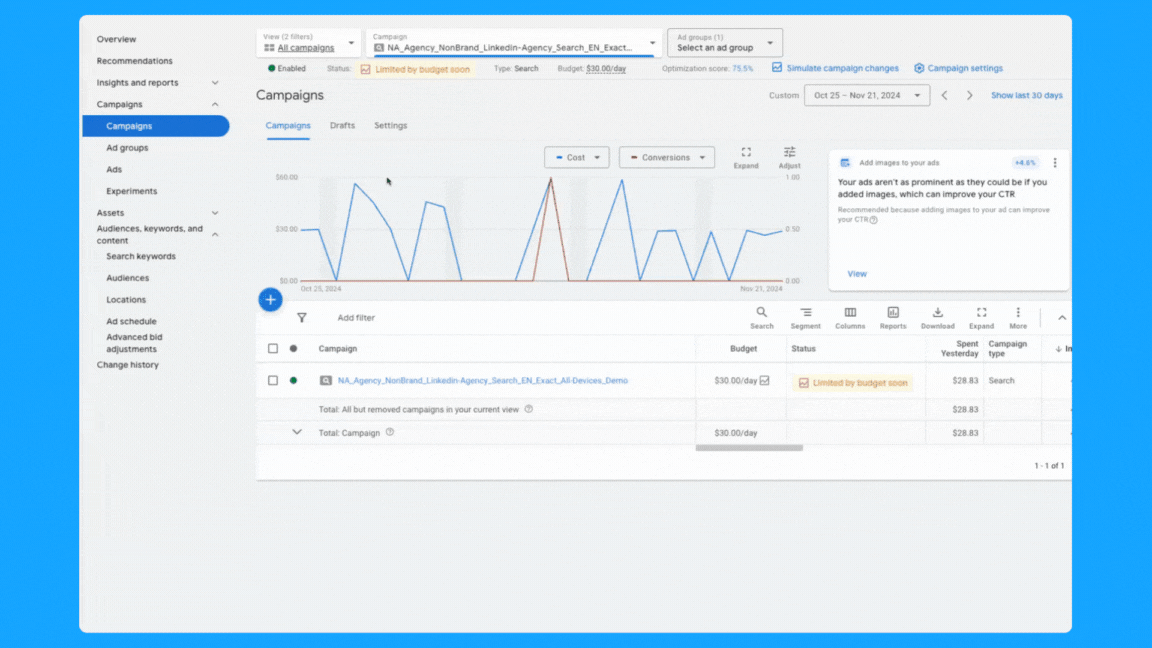
- At the campaign level > scroll over your campaign > Setting logo will appear
- Click on the logo
- Under Bidding, “Change bid strategy”
- From the dropdown menu, select the desired bidding strategy and save.
7. Do you have the correct conversion actions set? (if applicable)
Campaigns can inherit account-level conversions or have specific conversion actions set.
Both approaches are valid, but it’s essential to use the one that aligns with your campaign goals.
For instance, if a campaign-specific conversion action set is used, make sure it includes all relevant actions in the conversion funnel.
Follow the steps below to add/check conversion actions:
- At the campaign level > scroll over your campaign
- Setting logo will appear, click on the logo
- Under Goals, “Use campaign-specific goal setting”
- Click the pencil icon
- Select the appropriate (previously tested) conversions and save.

8. Are your ad rotation settings still accurate?
Generally speaking, I recommend using the “Best Performing Ads” option. This way, the Google algorithm will analyze your ads' performance and prioritize delivering the the ads with the best performance.
But if you see that Google is serving some ads dramatically more than others, then you can select “Rotate Ads Indefinitely” and Google will distribute each ad individually.
For conducting A/B testing on multiple ads, I recommend selecting the "Do not optimize" setting to make sure you’re collecting more precise data.
To review your ad rotation settings, follow these steps:
- At the campaign level > scroll over your campaign
- Setting logo will appear, click on the logo
- Click on additional settings > Ad rotation
- Click the pencil icon
- Select the preferred method and save.
You can also follow the steps above at the Ad Group level
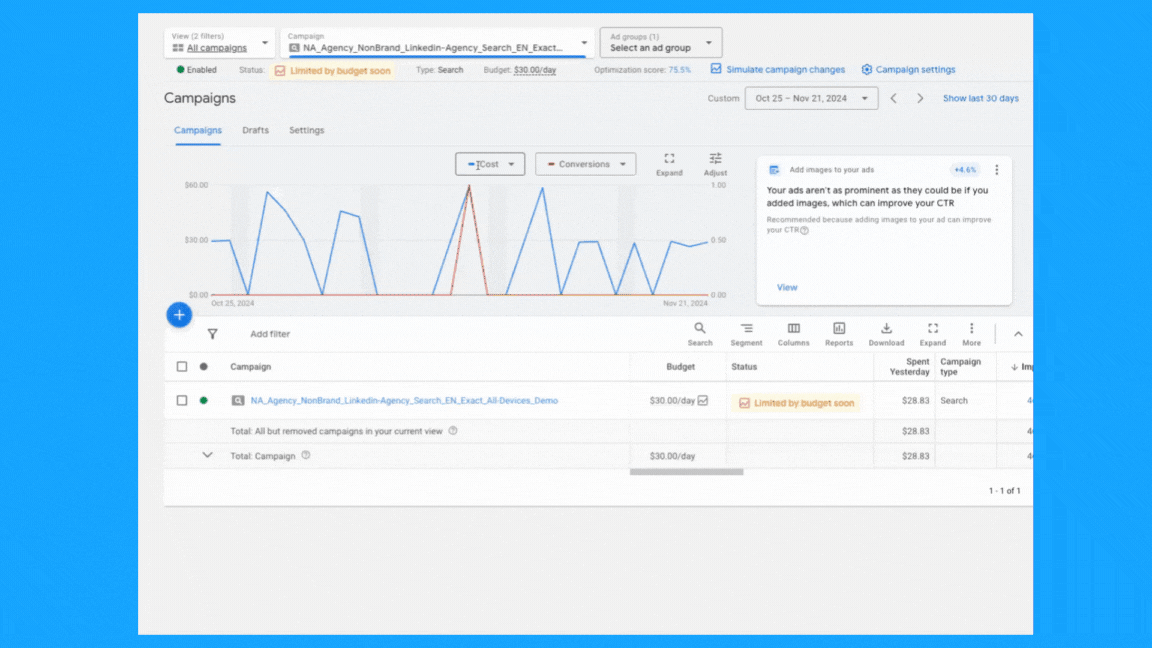
9. Is your ad schedule still up to date?
You can review your campaign's performance by day of the week and time of day, then adjust your ad schedule as needed. To do so, follow these steps:
- Click on “Overview” on the left-hand side
- Under the “Day & Hour” table, you can choose the metrics that matter the most to you to view performance by Day and/or Hour.

Now that you know which days and times generate the best results, you can tailor your ad scheduling accordingly.
- Select the campaign or ad group
- Click on Ad Schedule on the left-hand side
- Click the pencil icon
- Choose the optimal time and save.

10. Are you targeting the right devices?
Similar to the ad schedule, you can follow the same steps to find the best performance by device and make adjustments. Steps as follows:
- Click on “Overview” on the left-hand side
- Under the “devices” table, you can choose the metrics that matter the most to you.

You can now update your targeting by device accordingly.
- Select the campaign or ad group
- Click on “When and where ads showed” on the left-hand side
- Edit bid adjustment
- To stop showing on a specific device, choose “Decrease with 100% ratio > Save

If you’re using the device on the campaign naming convention, you want to make sure the campaign is targeting the device it has on its name.
11. Are you excluding existing leads and sales from your campaigns? (bonus)
A practical approach to lowering costs involves not targeting existing leads and customers.
Google enables the upload of first-party data for use primarily in Remarketing Lists for Search Ads (RLSA) and for creating exclusions. Steps below:
- Select audiences on the left-hand side
- Edit exclusions
- Select the Campaign or Ad group
- Choose the previously uploaded audience > Save

12. Do you have observational audiences added to your campaigns? (bonus)
Gain insights into how different audiences interact with your campaigns without altering who sees your ads:
- Select audiences on the left-hand side
- Audience segments
- Select Campaign or Ad Group
- Under observation, choose what is important to you and save.

13. Have you been actively running campaign experiments in the past? (bonus)
With the Experiments feature, you can execute A/B tests without needing to set up new campaigns.
If the outcome proves successful, the winning campaign can then be chosen as the primary one.
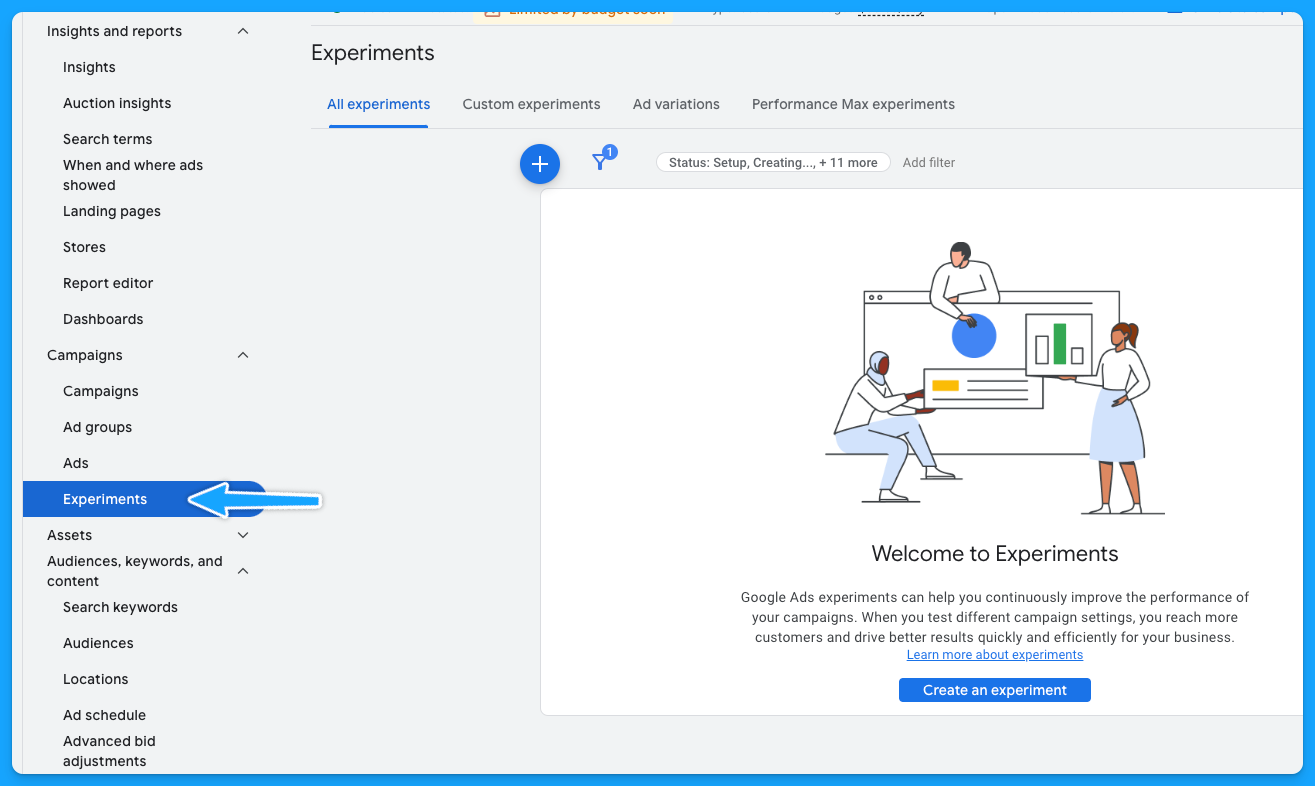
Part 3 - Ad Group Review
1. Are your ad groups broken out logically into related themes?
There are generally 6 buckets of themes for search ads:
- Brand
- Non-brand
- Competitive
- RLSA (Search Remarketing)
- Content
- Dynamic Search Ads
A clear naming convention aids in quickly identifying campaign and group themes. Example:
Campaign: NA_Non-Brand_Search_EN_Exact_All-Devices_Demo
Group: Non-Brand_Software
If there is no proper naming convention, then we have some cleaning to do:
- Download the data at the keyword level
- Delete: Ad spend < $ 1
- Open a new column called “Theme” beside the Keywords
- Tag the Theme of the campaign/group according to the Keyword
- Turn it into a pivot table to get the data by Theme
- Update the naming convention
If you don’t do a good job separating your keywords into themed ad groups, it will hurt your quality score.
Because if you have too many keywords in your ad group, it’s hard to make sure that the ads are relevant to all these keywords.
2. Do you have less than 15 keywords per ad group?
This is not a set-in-stone law, but it will help you mitigate the damage to your ad relevance.
Google allows up to 15 headlines and 4 descriptions in Responsive Search Ads. The goal is for keywords within each group to have a relevant ad to boost the quality score.
At the end of the day, you know you are doing a good job with your ad groups and how you structured your keywords if you see that your ad relevance is above average.

3. Are your ad groups filled with relevant keywords, ads, and landing pages?
Each group’s keywords should align with an ad in the same language, context, and call to action as well as a landing page contextualizing the search terms.
Here’s a good example of a great message match from the CRM software folk.
They’re bidding on the keyword “CRM software for startups”, their ad mentions “CRM for startups”, and if you click on the ad, their landing page talks exactly about CRM for startups. Everything is aligned.
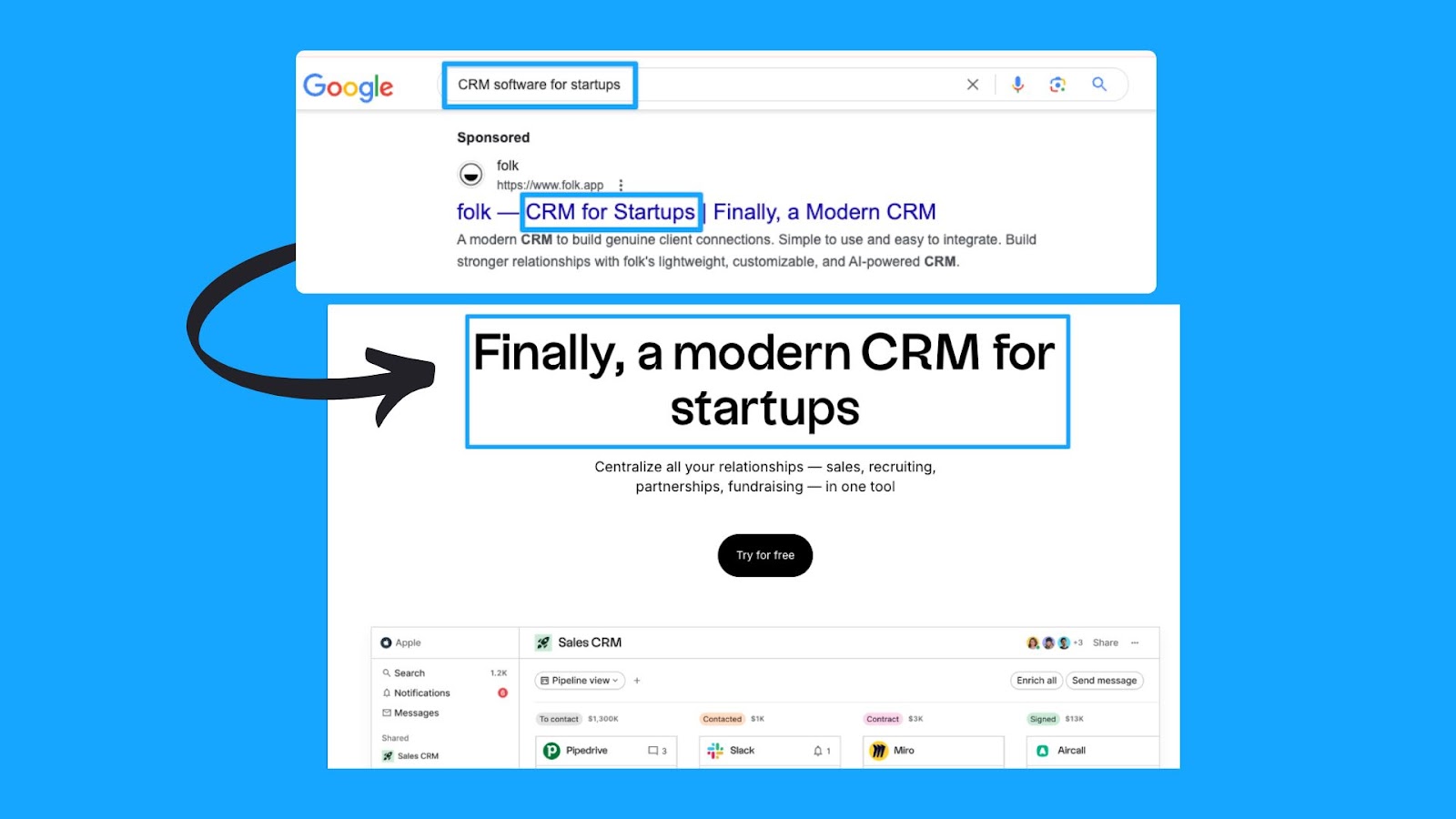
4. Are your best ad groups receiving enough budget?
With accurate conversion tracking in place for your campaigns (we covered this in Part 1), we can see which ad groups bring more conversions at a lower cost per conversion.After reviewing the ad group performance, you can optimize your ad groups in these ways:
- Pause the ad groups with more search volume that are just cannibalizing and eating up all the campaign budget without bringing conversions.
- Take the top performers' ad groups and put them into their own campaign.
- Run target CPA bidding and set different target CPA caps at the different ad group levels, so you can put a more restrictive cap on the one that’s eating up all the budget and then put a larger one on the one that hasn’t spent enough.
Part 4 - Keyword Review
1. Are your search terms as close to perfect as possible?
Regularly checking the search term report has 2 main benefits:
- Reduce CPA: Comparing the number of clicks to the number of conversions - exclude all irrelevant results.
- Increase Expected CTR: Compare the number of impressions to the number of clicks - exclude all irrelevant results.
How to check the search term report in Google ads:
- Under “Campaigns” on the left-hand side > Click “Insights and reports”
- Select “Search terms”
- Filter by campaign
- Evaluate the above recommendations.

2. Do you have a strong negative keyword list in place?
Negative keywords help us reduce the wasted budget and increase the overall quality of ads.
The broader the match type, the more important it is to have an extensive list of negative keywords.
However, even with Exact match type, search terms must be regularly checked, and negative keywords constantly be updated.
Maintaining a universal negative keyword list for your entire account can be beneficial. This list might include words related to profanity, employment, bargaining, etc.
Below you can access a sample list we use in our agency.
👉 Master Negative Keyword List
To avoid unintended blocking, please ensure these negative keywords apply to your business and do not overlap with any targeting keywords.How to create a new list in Google:
- Select “Tools” on the left-hand side
- Under “Shared library” click on “Exclusion lists”
- Select the “plus sign”
- Add the list of desired negative keywords and name the list accordingly.

3. Do you have the appropriate match types for your keywords?
If you don’t know which match type you should start with, then always start with the Exact match type and work your way up.
If you don’t get quality conversions with the Exact match type, then changing the match type won’t help.
Generally, Broad match types have the highest wasted budget - unless the campaign is layered with a first-data party audience.
4. Do you have underperforming keywords you can pause or optimize?
Usually, 20% of the keywords are responsible for 80% of the results. Make sure to check the performance of each keyword and pause underperformers continuously.
However, before pausing, analyze the relevance of search terms against keywords.
If they align, evaluate the click-through rate (CTR) to determine if the ad copy requires updates.
If users are still clicking on the ad without converting, consider revising the landing page.
5. Are your keyword bids set at an optimal amount? (if applicable)
If you're using automated bidding, you don't have to worry about this step.
But if you're using manual bidding, sometimes your manual bid is too low, so your ads won’t show on the first pages of the results.
I recommend that your Max. CPC amount is at least high enough to the first page bid estimate.
You can find the keyword bid simulator by hovering over the small chart in the Max. CPC field.

Part 5 - Ads & Extensions Review
1. Are your keywords in your ad copy?
This is an easy way to increase ad relevance and ultimately get more clicks.
I can’t stress enough the importance of having a strong message match.
When users encounter their specific search terms within your ad—especially if these terms are variations of your targeted keywords—the likelihood of them proceeding to your landing page significantly increases.

2. Are you title-casing the beginning of each letter in your ad?
Title casing is when you capitalize the letter of each important work in the sentence.
In my experience, title casing works better on paid search because your ads will look more professional, and it will enhance readability.

3. Do you have a minimum of two ads per ad group?
Running multiple ads allows for A/B testing or split testing, where different versions of ads can be compared to see which one performs better.
By consistently testing ads, you’ll drive a better click-through rate, and this will ultimately result in a better Expected Click-through rate, which will improve your quality score and reduce your costs while putting your ads in a better search results position.
4. Are you speaking one-to-one, communicating benefits, answering objections, and providing a CTA?
You want to make sure you are speaking one-to-one In your copy and not using corporate speak, where it seems you’re talking to an auditorium versus a person.Here are a few important points your ads should cover:
- Are you communicating benefits in the second headline to differentiate yourself from your competitors on the SERP?
- Are you answering objections? (If there are objections that you can answer on your copy)
- Are you providing a Call-to-Action (CTA) that moves people and motivates them?
Here’s a good example from Brevo:

- We can instantly see the benefit: 9000 emails free per month
- One-to-one communication: Don’t let them overcharge you
- CTA that motivates: Stop overpaying for email and get the best value in email delivery & email marketing tools.
5. Are you using all the characters available in your headline, description & path fields?
You don’t have to use every single one, but I recommend you use as many as you can.
Utilizing all available characters in Google Ads' headline, description, and path fields increases message clarity and impact, boosting click-through and conversion rates.
6. Are you using as many ad extensions (assets) as possible? (Especially core ones)
Extensions expand your presence on the search results page, improving the chances of receiving more clicks, which will increase your expected CTR and the overall quality score.
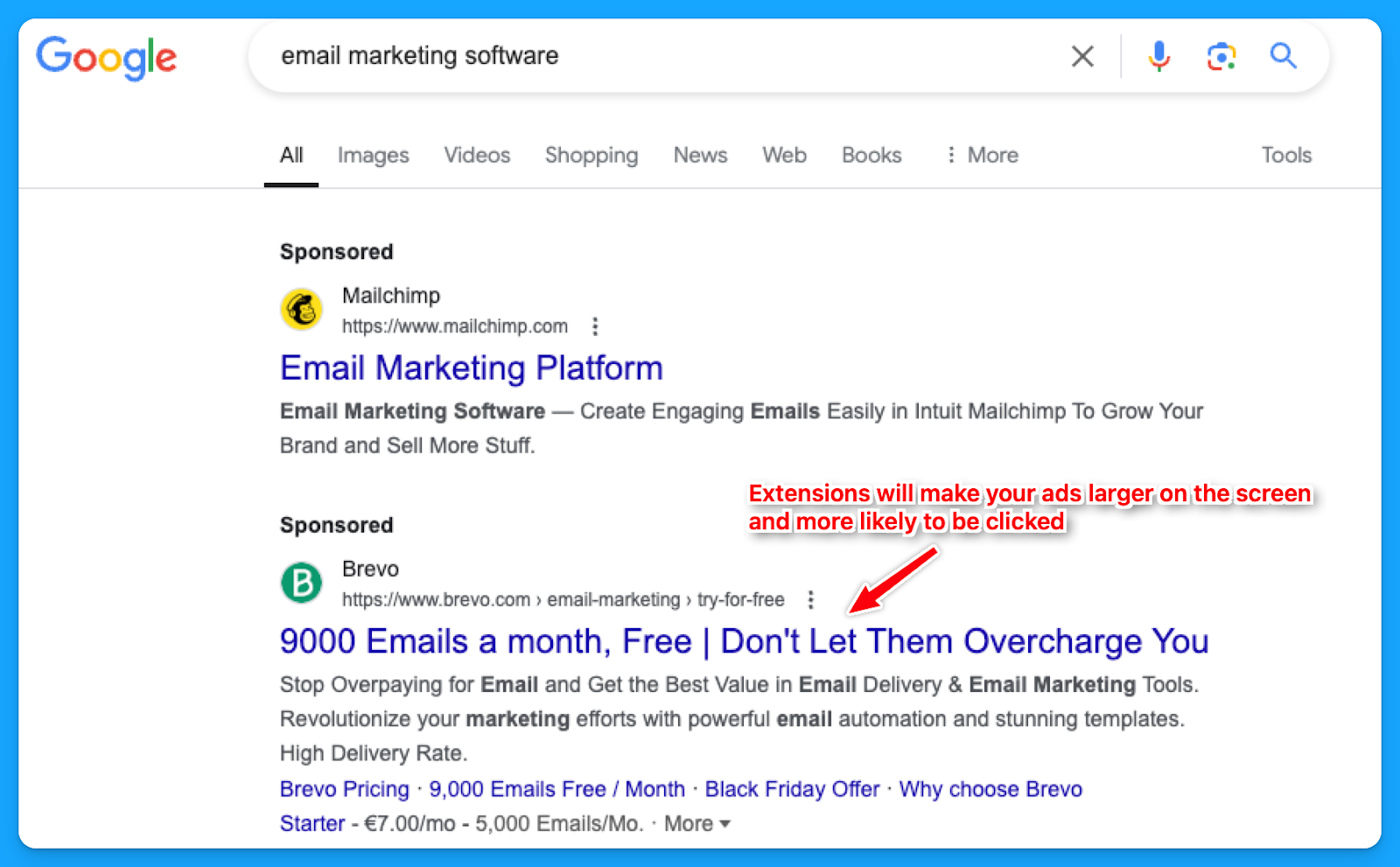
While assets such as the business logo and name are best set at the account level, it's often better to tailor other extensions, like callouts, structured snippets, sitelinks, etc., to reflect the the messaging of each campaign or ad group.
How to create new ad extensions in Google:
- Select “Campaigns” on the left-hand side
- Under “Assets” click on “Assets”
- Select the desired extension to see the ones you already have.
- Click on the “plus sign” to add new ad extensions.

7. Are you consistently testing new ad copy, types and modifiers?
If you are not doing this, you’ll know because you will see the click-through rate consistently going down week over week, month over month.
If you’re auditing someone else’s account, you can check the “Changes history” option to see if they are constantly testing new ads.
For modifiers, you can use dynamic keyword insertion in your ad copies to dynamically test different variations.
8. Are you sending searchers to relevant landing pages?
In my opinion, this is the most important thing.
If your prospects search for “CRM for startups”, your ads should say “CRM for startups”, and your landing page should say “CRM for startups”.

This sounds basic and trivial, but the amount of people who miss this is dramatic.
So make sure that you have a strong message match.
Part 6 - Landing Page Review
Remember that success will come from half traffic and half your landing page, so I highly recommend deep diving into your pages individually as you go through this.
1. Are you mirroring the message from your ad on the landing page?
As I mentioned in the last step of Part 5, the landing page experience is a crucial element of the quality score.
A page that fails to align with your ad's messaging is unlikely to offer value to the user.
2. Can the searcher understand what you do & why in 5 seconds or less?
This is called the five-second rule, and it’s essentially a test where if your prospects just look at the above the fold section of your landing page, can they understand in five seconds what you do and essentially why they should care?
In this example from Microsoft Clarity, we can easily understand that this is a free tool that will help you get insights into the behavior of users on your website so you can improve your products.
It’s also used by 100k+ sites worldwide and is GDPR & CCPA-compliant.
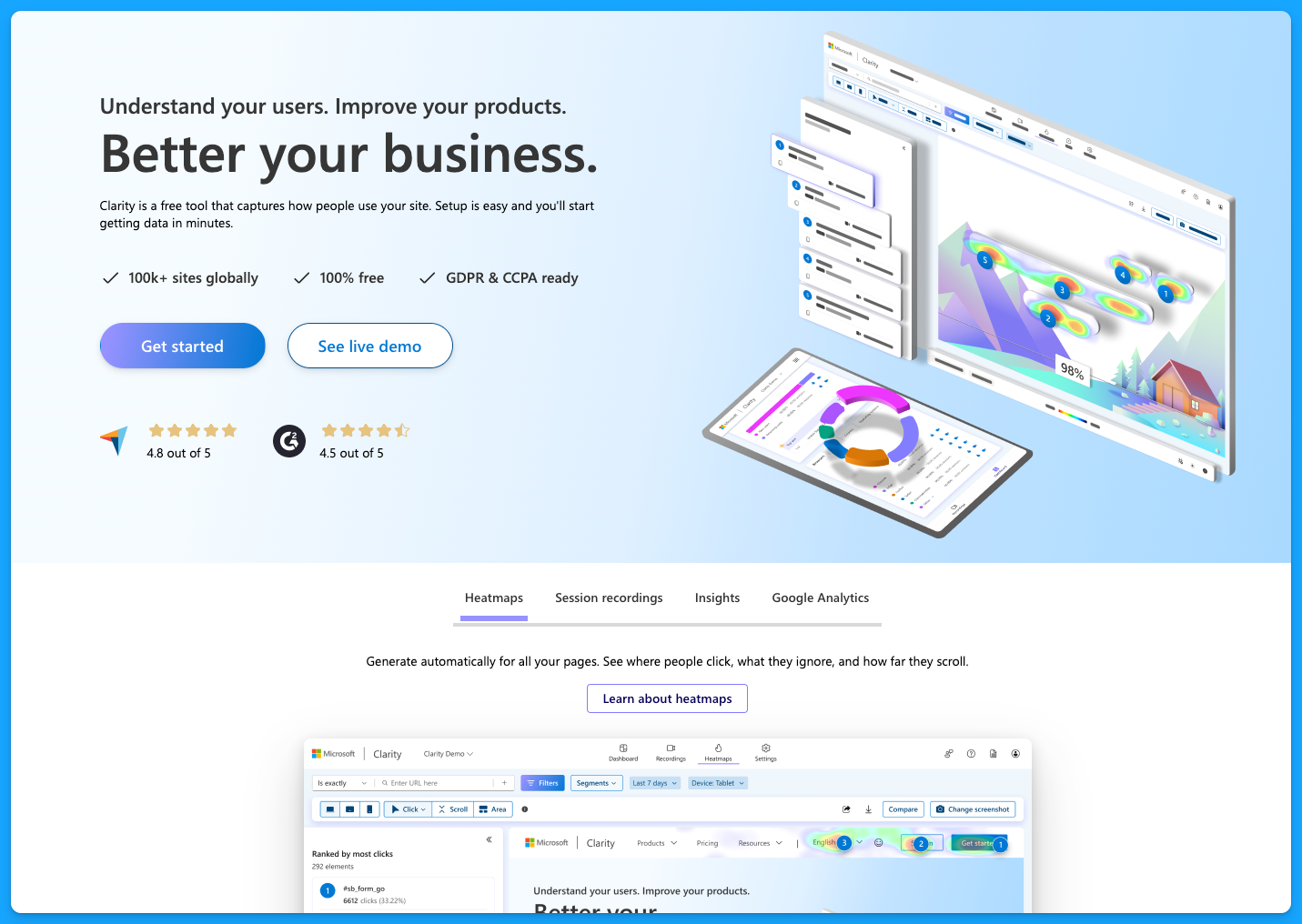
You don’t want to be vague on your landing pages, and you want to make sure that they have the following:
- Clear and concise headline
- Engaging subheadlines
- Visual elements
- Call to action (CTA) throughout the page
- Quick loading time for all devices
To learn more about landing page best practices, dive into the article below by Pedro Cortés:
10 Proven Landing Page Tips To Boost Your Conversion Rates
3. Is your landing page loading fast enough?
As mentioned above, the landing pages must load quickly on all devices. Tools like Lighthouse or PageSpeed Insights can help you better understand areas of opportunity.
I recommend you run your page through PageSpeed Insights and apply anything applicable.
You’re probably going to need the help of a developer, but it’s definitely worthwhile to improve the page speed because this is a big factor in terms of your landing page experience for quality score.

A simple thing to improve your landing page loading time is compressing the website images to reduce the file sizes.
4. Do you have one clear call to action on your landing page that mirrors your ad?
If your ad is talking about Downloading a Whitepaper but the landing page only has CTAs around Booking a Demo, then that will have a negative experience for the user.
Align landing page CTAs with ad promises to ensure a seamless user experience and encourage conversions.
5. Are you communicating benefits, answering objections, and providing a CTA?
The higher the ask, the more context must be provided on the page. This is specifically true for the “Book a Demo” CTA.
Ensure you address objections while emphasizing the key benefits of your product that will solve the users' problems.
I recommend that you talk with your sales team to get insights on different objections that come up in the sales process, this way you can add sections on your landing page to proactively communicate against those objections so that you can actually drive more quality leads.
6. Does your form, chatbot, or online booking widget still work?
Before launching any new offers, test the page to make sure everything is working as intended.
- Submit a fake test lead and see if it actually routes into your CRM.
- Go look for your lead record.
- Check if the page isn’t broken.
- Review what the experience looks like.
Make sure you audit that process because I can't tell you how many times people think their campaigns are failing, and then something just broke on the technical side.
Part 7 - Budget & Performance Review
1. What is the spread of budget and performance by campaign theme? (NonBrand, Brand, Competitive, RLSA, Content)
This is where you will need to export a lot of data from Google Ads and use Excel/Google Sheets.
👉 I recommend watching the Part 7 video above if you need a walkthrough on exporting and labeling the data to perform this analysis.
Here’s a common successful budget distribution you can use as guidance:
- Brand: < 20%
- Non-brand > 60%
- Competitive > 20%
You can use our free Google Ads Budget Calculator to find your ideal Google Ads budget.
2. What is the spread of budget and performance by region?
If you are targeting multiple regions, break out the campaign as such (ex: NA, EMEA, APAC).
👉 Check out the Part 7 video above if you need a walkthrough on the data analysis methodology using Excel.
Look for the highest-performing locations for each region and make sure low-quality conversions are not wasting your budget. If you’re not separating your campaigns into regions, you can still check how the budget has been spread around different locations through the Locations report:
- Select “Campaigns” on the left-hand side
- Go to “Locations”, under “Audiences, keywords, and content”
- Select the desired campaign
- Download the data under Location
- Summarize into a pivot table to get:
- Ad spent
- Conversions
- Cost per conversion

3. What is the spread of budget and performance by offer?
If you are separating the campaigns by offer, break out the campaign as such (Demo, Trials, eBooks, etc)
👉 Check out the Part 7 video above if you need a walkthrough on the data analysis methodology using Excel.
Here’s how to download the landing page report:
- Select “Campaigns” on the left-hand side
- Go to “Landing Pages”, under “Insights and Reports”
- Select the desired campaign
- Download the data
- On Excel:
- Delete: Ad spend <$1
- If there is no proper naming convention:
- Open a new column (Offer) beside the landing page (LP)
- Tag the offer of the campaign according to the LP
- Summarize into a pivot table to get:
- Ad spent
- Conversions
- Cost per conversion
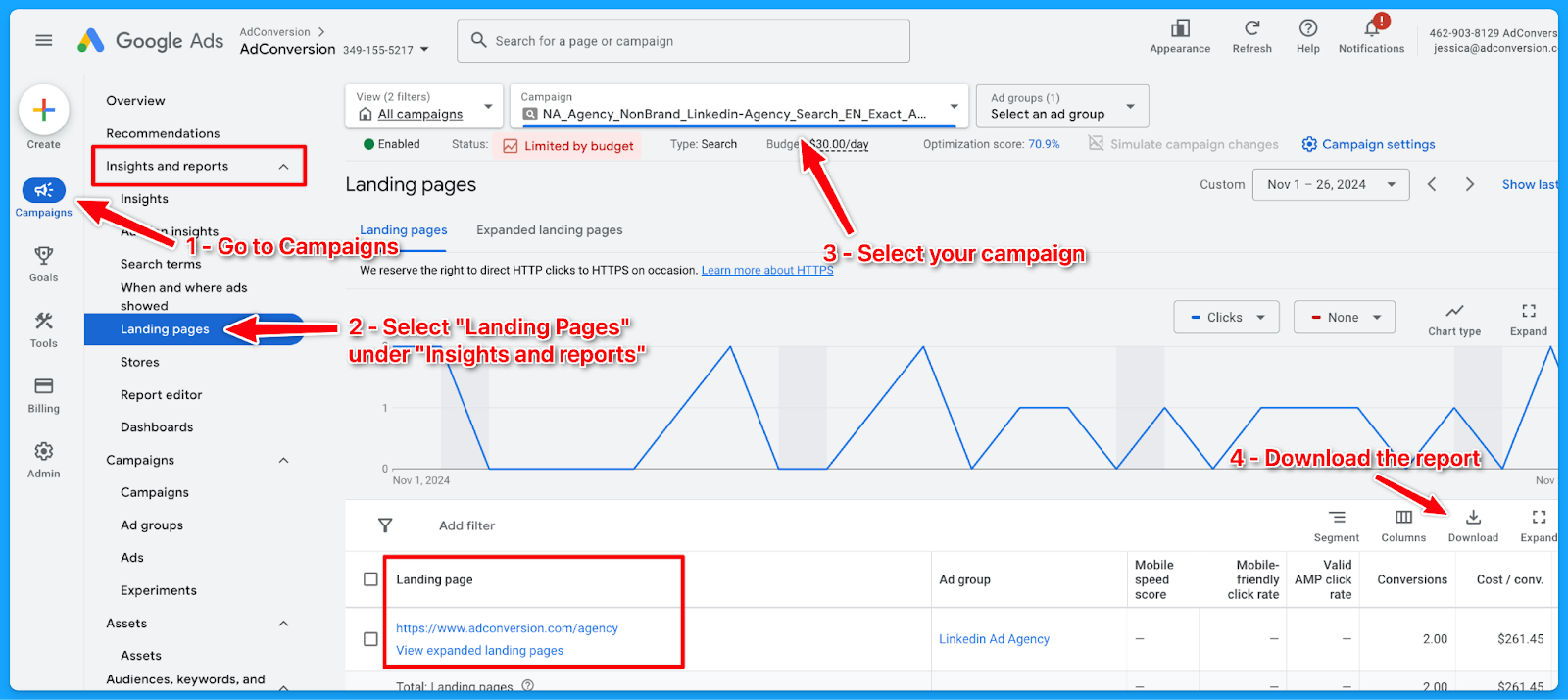
6. What is the spread of budget and performance by match type?
If you are separating the campaigns by match type, break out the campaign as such (Exact, Phrase, Broad)
👉 Check out the Part 7 video above if you need a walkthrough on the data analysis methodology using Excel.
Here’s how to download the match type report:
- Select “Campaigns” on the left-hand side
- Go to “Search Keywords”, under “Audiences, keywords, and content”
- Select the desired campaign
- Add the column “Match type”
- Download the data
- On Excel, summarize into a pivot table to get:some text
- Ad spent
- Conversions
- Cost per conversion
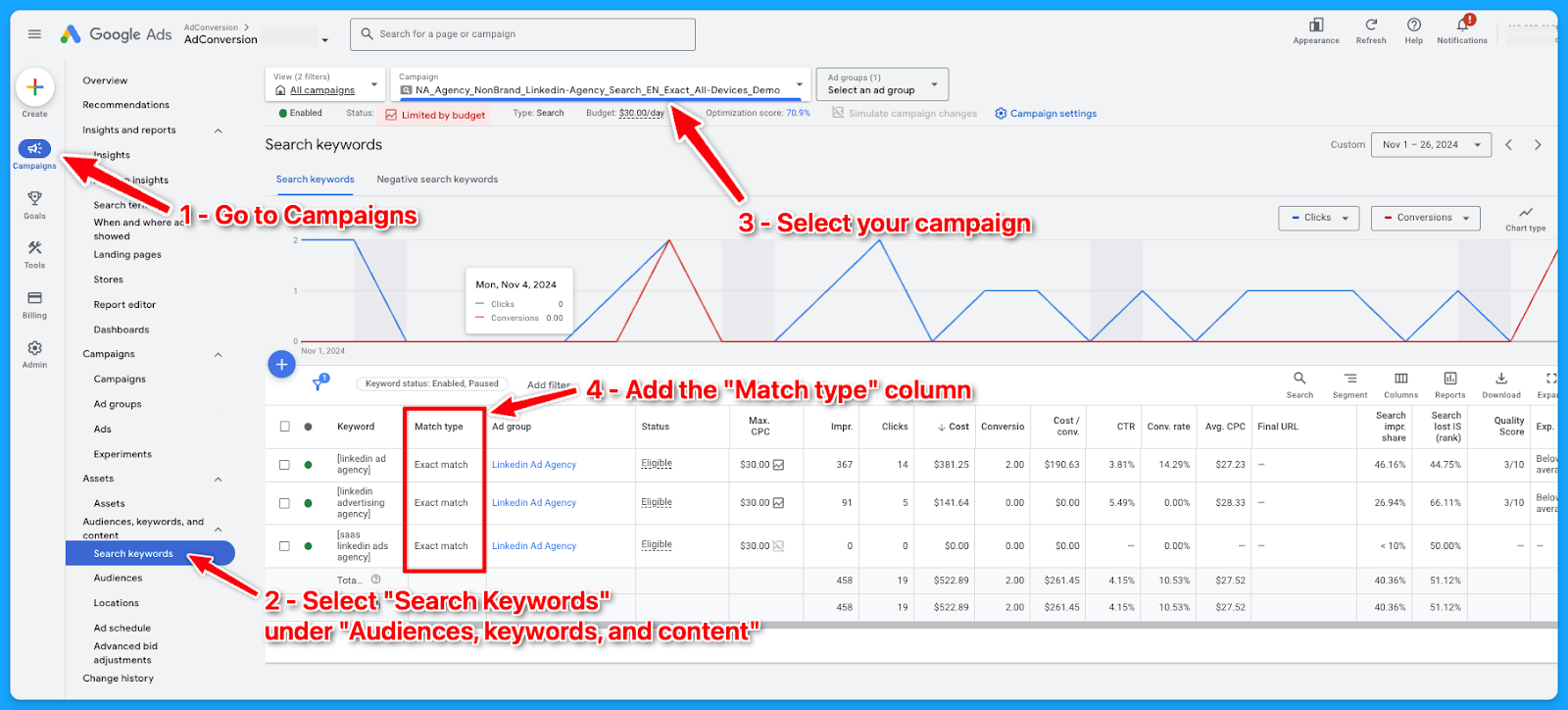
7. What is the spread of budget and performance by device?
If you are separating the campaigns by devices, break out the campaign as such (Desktop, Mobile, Tablet, All Devices)
👉 Check out the Part 7 video above if you need a walkthrough on the data analysis methodology using Excel.
If the campaigns are not separated into devices, here’s how you can check the spread of budget and performance by device downloading the device report:

8. What is the spread of budget and performance by week days?
Check if you’re targeting all days of the week and if there’s opportunities to exclude some days when the performance is not good, so you can free up budget for the strongest days.Here’s how to download the day of the week report:
- Select “Campaigns” on the left-hand side
- Go to “When and where ads showed”, under “Insights and reportst”
- Select the desired campaign
- Choose “Day” in the right-side navigation if you only want to see the day of the week
- Download the data
- On Excel, summarize into a pivot table to get:some text
- Ad spent
- Conversions
- Cost per conversion
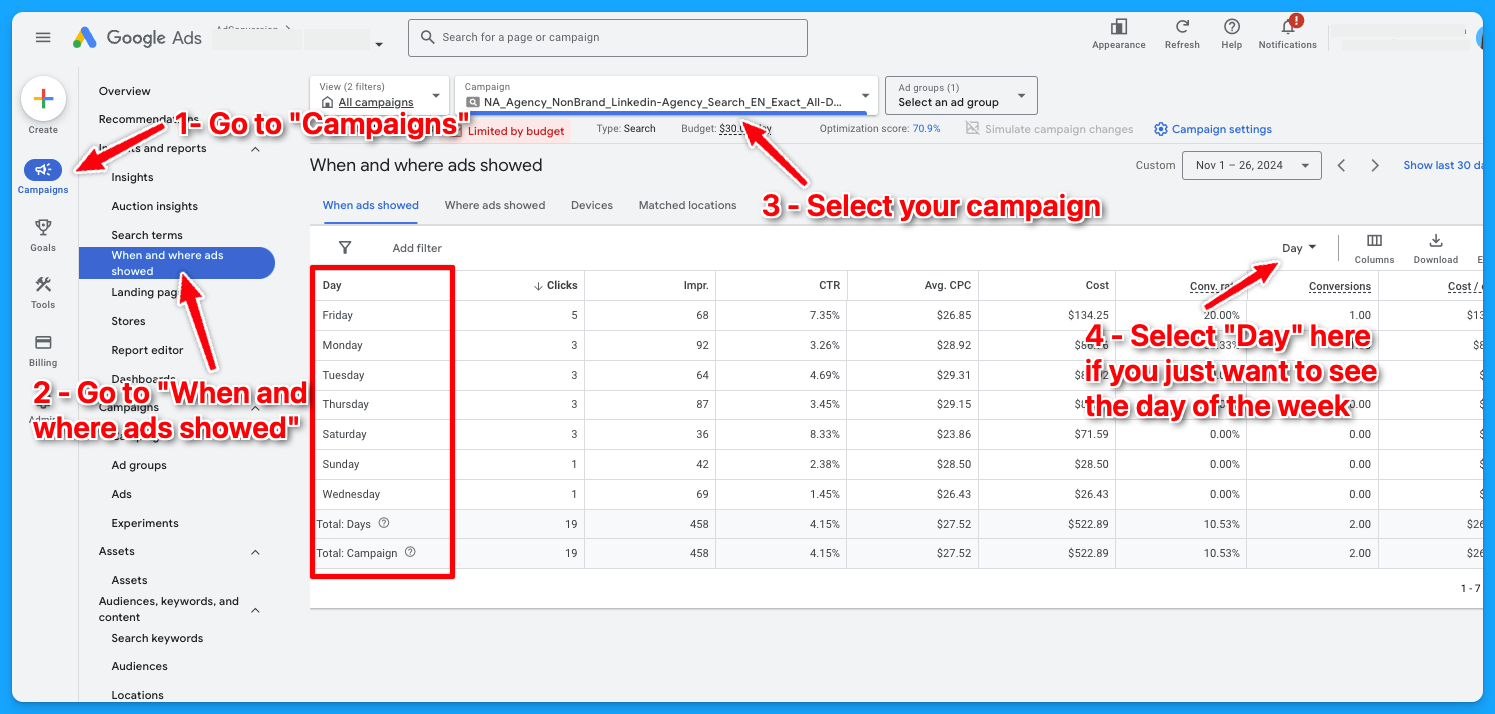
To learn more about how to create a winning Google Ads budget strategy, dive into the article below:
How to Create a Winning Google Ads Budget Strategy for B2B SaaS
Part 8 - Visibility Review
Here’s where we will talk more about Impression Share and Quality Score.
1. What is the search impression share by campaign theme? (NonBrand, Brand, Competitive, RLSA, Content)
There are different ways you can see the impression share by the campaign theme.
You can use Excel as I showed previously in Part 7, or you can go into your account and filter by campaign name, assuming you have good campaign naming conventions.
👉 Check out the Part 8 video above if you need a walkthrough on how to find this data.

2. What is the search lost rank by campaign theme? (NonBrand, Brand, Competitive, RLSA, Content)
The process here is the same from the previous task. The only difference is that you need to add the “Search lost IS (rank)” column.
👉 Check out the Part 8 video above if you need a walkthrough on how to find this data.
3. What is the search lost to budget by campaign theme? (NonBrand, Brand, Competitive, RLSA, Content)
The process here is the same from the previous tasks. The only difference is that you need to add the “Search lost IS (budget)” column.
👉 Check out the Part 8 video above if you need a walkthrough on how to find this data.
4. What is the search top IS by campaign theme? (NonBrand, Brand, Competitive, RLSA, Content)
The process here is the same from the previous tasks. The only difference is that you need to add the “Search top IS” column.
👉 Check out the Part 8 video above if you need a walkthrough on how to find this data.
5. Do 70% of your keywords have above 7 quality scores?
This is something I learned from Brad Geddes years ago, the OG of Google Ads.
Check the video below to see a complete guide on Quality Score and how to perform a Quality Score analysis:
6. What aspects of quality score do you need to improve?
After going going through the data in the previous task, summarize your findings to know where you have opportunities to improve.
Example:
- 100% of keywords have a Quality Score below 7.
- 94% of keywords are rated as “Below Average” for landing page experience.
- 45% have “Above Average” ad relevance.
- 100% have “Below Average” expected CTR.
Optimization strategies you can adopt to improve your Quality Score:
- Improve Landing Page Experience:
- Ensure pages are fast, relevant, and mobile-friendly
- Align ad copy with landing page content for a seamless message match.
- Ensure pages are fast, relevant, and mobile-friendly
- Refine Ad Relevance
- Group keywords into tightly themed ad groups.
- Write ads tailored to the specific intent of each group.
- Group keywords into tightly themed ad groups.
- Boost Expected CTR
- Test compelling ad headlines and descriptions.
- Use ad extensions to enhance visibility and clickability.
- Test compelling ad headlines and descriptions.
I hope you received a ton of value from this Google Ads Audit guide.
If you have any questions, feel free to connect with me on LinkedIn.
From Clicks to Conversions: Master Google Ads for B2B 🔥
If you want to become a Google Ads pro, check out our free B2B Google Ads courses, where you'll learn how to launch, optimize, and scale your campaigns to drive pipeline and revenue.

Here's what you'll learn in each course:
⚙️ B2B Google Ads 101 - How to Launch Dangerously Effective Campaigns for Beginners
- The Googleverse: The Game You're Playing & How To Win
- Measurement: How to Make Sure You're Profitable
- Targeting: How to Show Up For the Right Searcher
- Planning: Putting It All Together
🎯 Google Ads 102 - How to Clicks Into Profit
- Visibility: How To Find the Hole Sucking Profits
- Workflows: How to Optimize On a Daily, Weekly, Monthly & Quarterly Basis
- Experimentation: How to Test & Automate Profitability
- Troubleshooting: How To Solve Inevitable Problems
🚀 Google Ads 103 - How to Scale Google Ads For Advanced Advertisers
- Methodology: How to Vertically Scale Google Ads From A-Z
- Campaigns: Scaling Horizontally Through Campaign Themes
- Channels: Scaling Outside of Paid Search
Click Here to Join 1,000+ B2B Marketers Today and start leveling up your advertising skill set.
Takes < 90 seconds to sign up (seriously we timed it 😂)
People Also Ask
How can a Google Ads audit improve my campaign performance?
- A Google Ads audit can significantly enhance your campaign performance by identifying inefficiencies and areas for optimization within your account.
How often should I conduct a Google Ads audit?
- It is recommended to conduct a Google Ads audit at least once every quarter. For accounts with significant spending or those in highly competitive industries, more frequent audits may be beneficial to stay ahead of competitors and efficiently manage advertising spend.
What are the key components of a Google Ads audit?
- Budget Allocation: Analyzing how the budget is distributed across various channels and campaigns to identify opportunities for reallocation.
- Campaign Themes: Reviewing the balance between branded, non-branded, and competitive campaigns to ensure optimal allocation for reaching new customers.
- Device Usage: Evaluating performance across devices (mobile, computer, tablet, TV) to tailor strategies for each device type.
- Match Types: Assessing the use of exact, phrase, and broad match types in campaigns to ensure efficient targeting.
- Quality Score: Examining the quality score of keywords, focusing on ad relevance, landing page experience, and expected CTR to identify areas for improvement.
- Visibility Metrics: Analyzing impression share and losses due to rank and budget to optimize bid strategies and campaign visibility.
How often should I perform a Google Ads audit?
It’s recommended to conduct a comprehensive audit at least quarterly. However, for high-spending accounts or during periods of significant change (e.g., new product launches or market shifts), more frequent audits may be beneficial.
Can I perform a Google Ads audit myself, or should I hire a professional?
While self-auditing is possible, hiring a professional can provide deeper insights and a fresh perspective. Professionals are often equipped with advanced tools and expertise to identify issues that might be overlooked otherwise.

10 Techniques You Should Steal From Great B2B Ads
Hey there, B2B marketer! If you're having trouble with high CPLs and low CTRs, bad creatives could be the problem.
In this article, I’ll unpack what great B2B advertising looks like and 10 techniques you can steal from these top B2B ads.
So let’s dive in 👇
TABLE OF CONTENTS
- #1 - Address ICP (Ideal Customer Profile) Needs
- #2 - Clear CTA (Call to Action)
- #3 - Optimized Elements
- #4 - Channel-Savy Ads
- #5 - Direct Language
- #6 - Plain Speak
- #7 - Concise Copy
- #8 - Authentic Imagery
- #9 - Break Norms
- #10 - Build Trust
- Free Resources to Jumpstart Your B2B Marketing Career
1. Address ICP (Ideal Customer Profile) Needs
If you don’t know what your audience cares about, you’ll miss the mark entirely.
The first thing to do is identify the job your customers are hiring your product or service to do so your ads will speak directly to their needs. Because remember, it's not about you. It’s about them.
In the Dooly example below, you can notice within the first five seconds that:
- The ad is talking to sales teams and sales representatives.
- It addresses a major pain point these audiences experience from deeply knowing their audience and having well-defined ad personas.
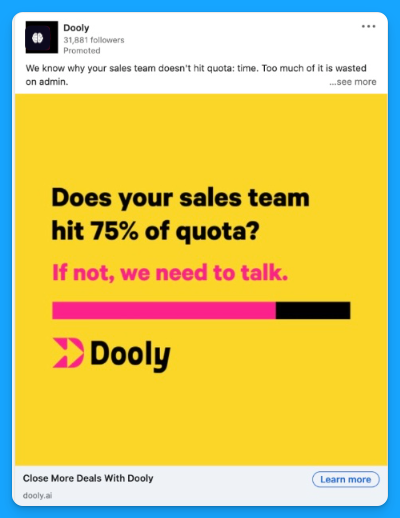
2. Clear CTA (Call to Action)
Clarity equals high conversions. Your ads need to have a clear call to action that is compelling and stands out in the headline.
Look at the Lusha ad call to action: “Turn prospects into sales faster with Lusha”. Pretty clear!
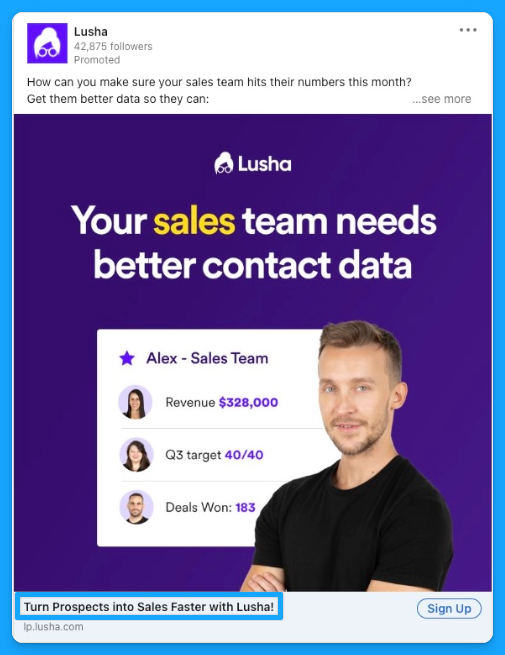
3. Optimized Elements
High-converting ads optimize the elements. They effectively use all the ad components to avoid repetition and tailor the ads to the medium for the most impact, making it easier to convert.
Everyone is busy, and no one wants to waste time. So, by understanding how people use the platform you're advertising on, you can maximize your ad experience and use all the elements meaningfully.
Warning 🚨: When using a lead-gen form or landing page to convert demo requests, make sure the entire experience is as easy as possible to navigate, understand, and convert.
Too often, I’ve seen forms or landing pages that do not match the message in the ad, which is not only confusing but also more challenging to convert.
Here’s a winning example from Zingtree. The goal is to book a demo using a lead gen form:
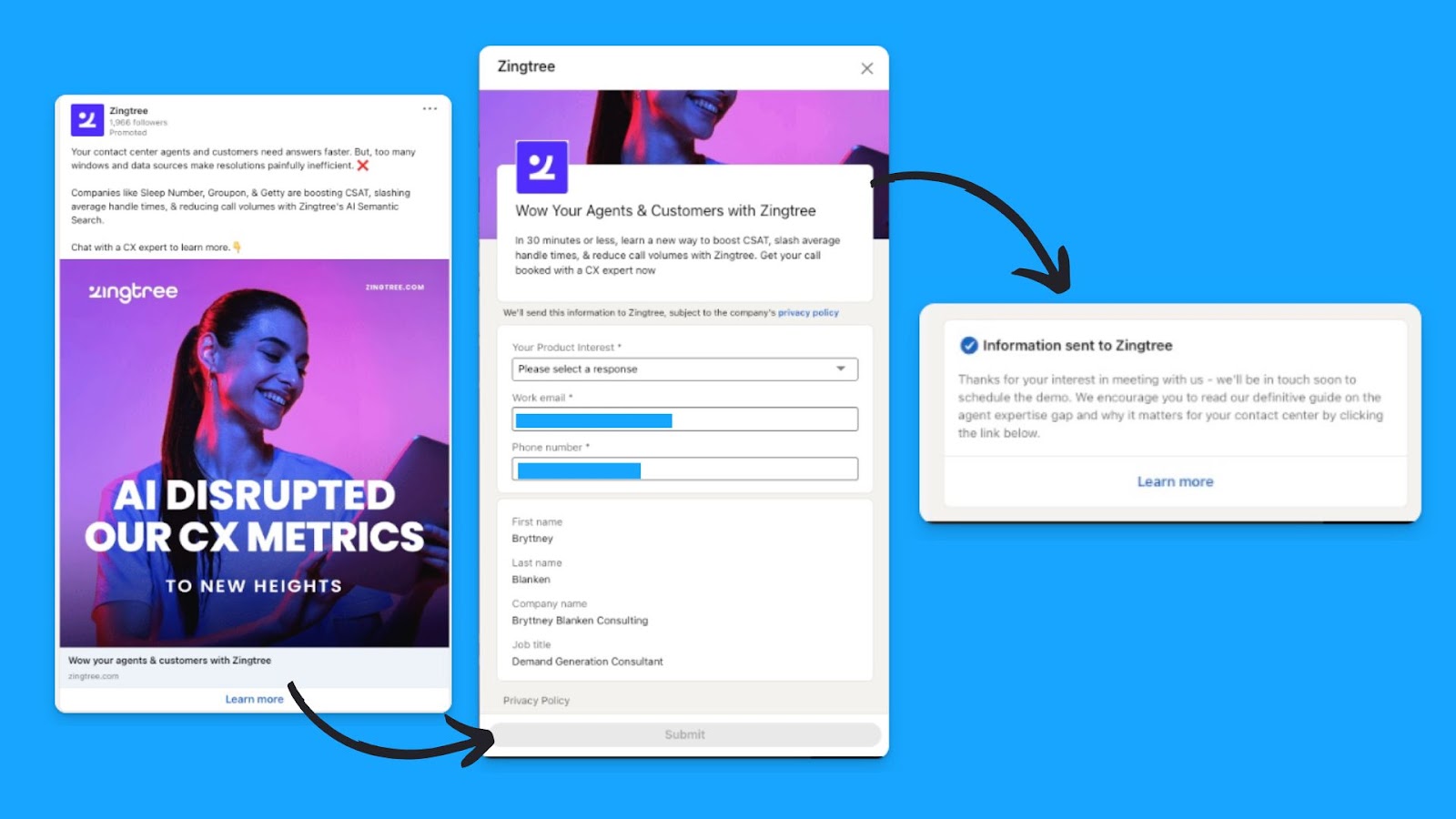
Why this is a winning ad
- The ad copy clearly states that you can chat with an expert to learn more with a “Learn More” CTA button.
- Matching ad and lead gen form headlines
- Lead gen form copy is clear on what is involved with filling out the form and what will be on the call.
- Lead gen form uses prefilled-in forms as much as possible to decrease the user needing to fill them in – only requiring one form field to be selected.
- The lead gen form confirmation message clearly explains what happens next and points to helpful content.
Where it can improve
- It should say how many business days or hours the team will reach out to schedule the demo
- It could have also pointed to a booking link in the thank you message so leads could automatically book their meeting instead of pointing to content. This helps capture the attention you already have in a more impactful way
4. Channel-Savy Ads
Tailor ads to the medium for impact. “The medium is the message”.
This ad from Cognism is a great example. They repurposed the results from a poll on their organic page comparing their brand with their 2 most significant competitors in EMEA. Genius 😎
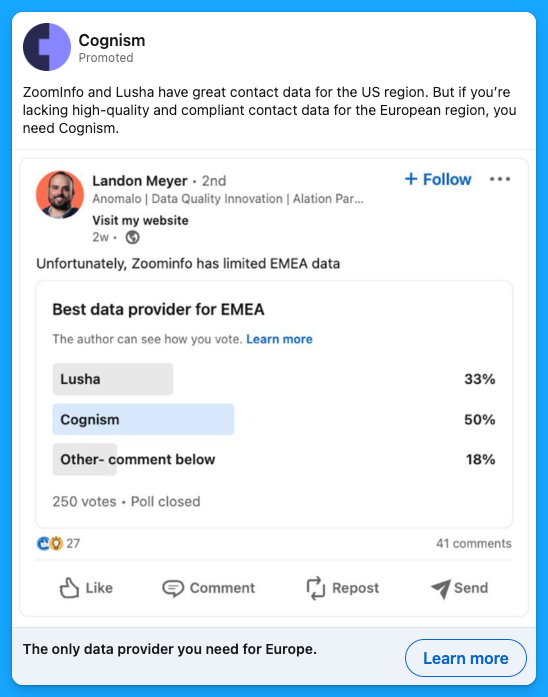
5. Direct Language
Use 'you' and 'your' for engagement.
Let’s not forget that it’s B2B, but we’re still talking to people.
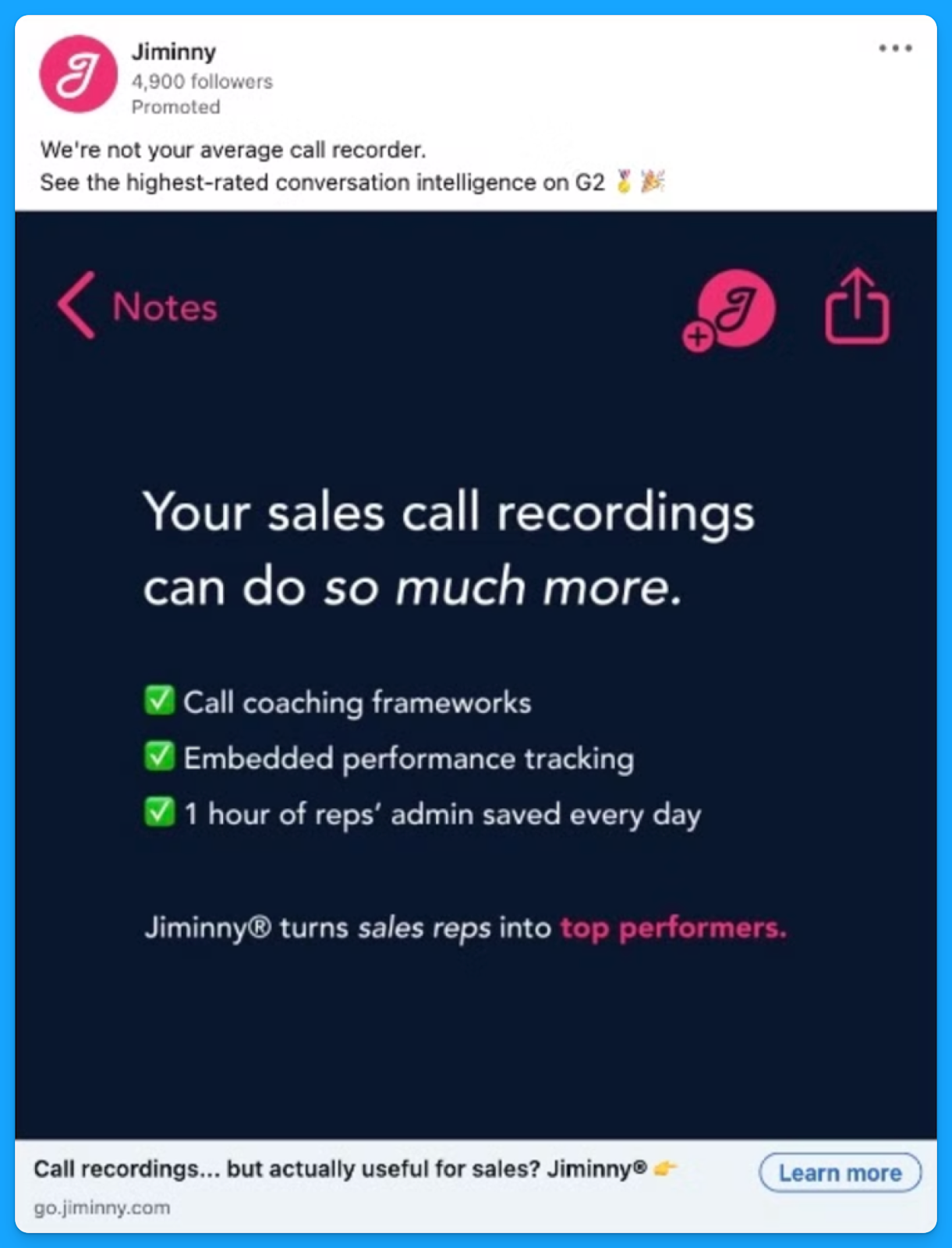
6. Plain Speak
Cut the jargon and use the customer's words in the ads.
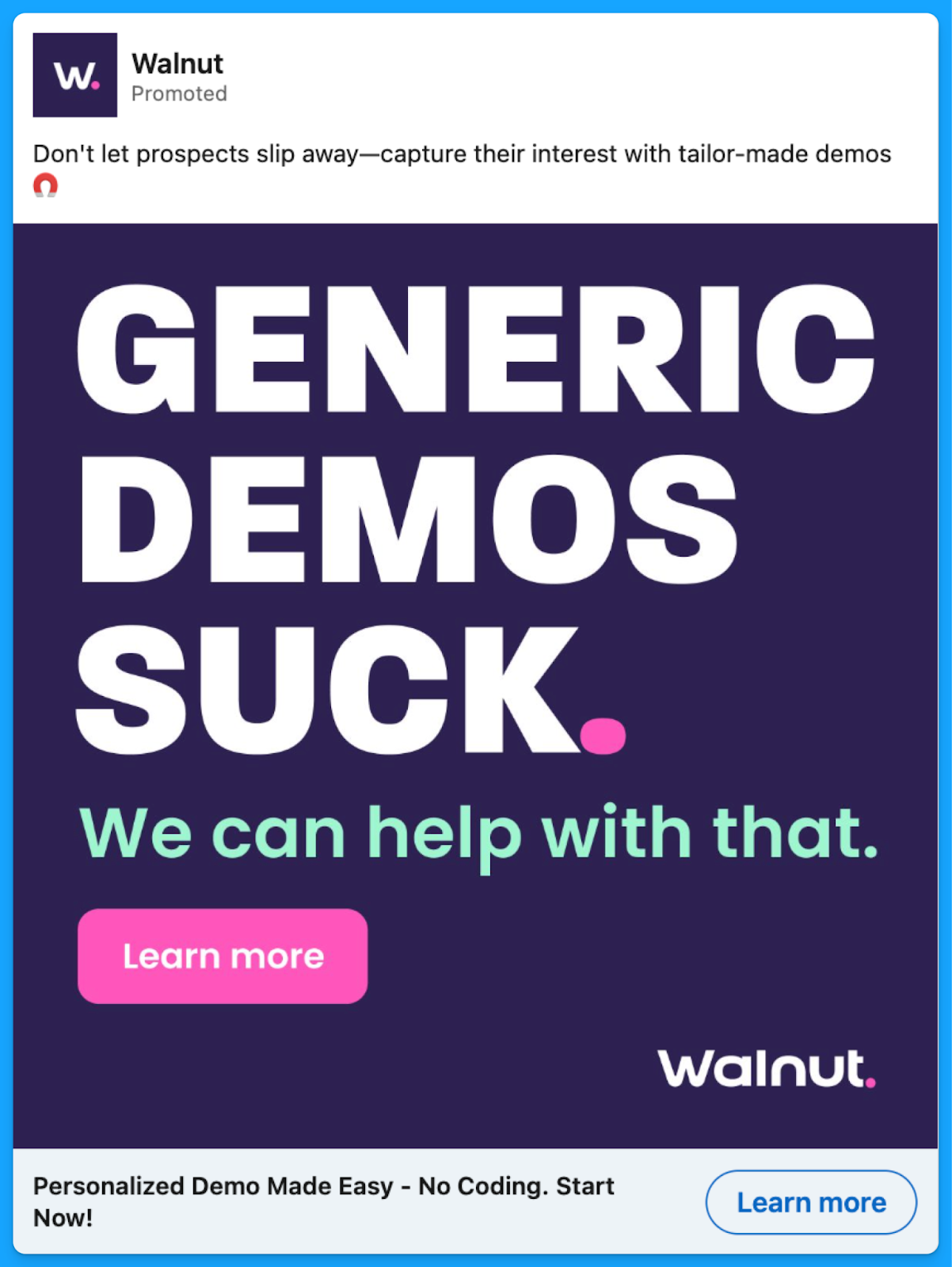
7. Concise Copy
Keep your copy short, ideally between 60 to 120 characters, so it’s easy to consume.Your goal isn’t to explain everything your product does in the ad, it’s to make the prospect take the next step, which could be visiting your website, scheduling a demo, or signing up for a free trial.
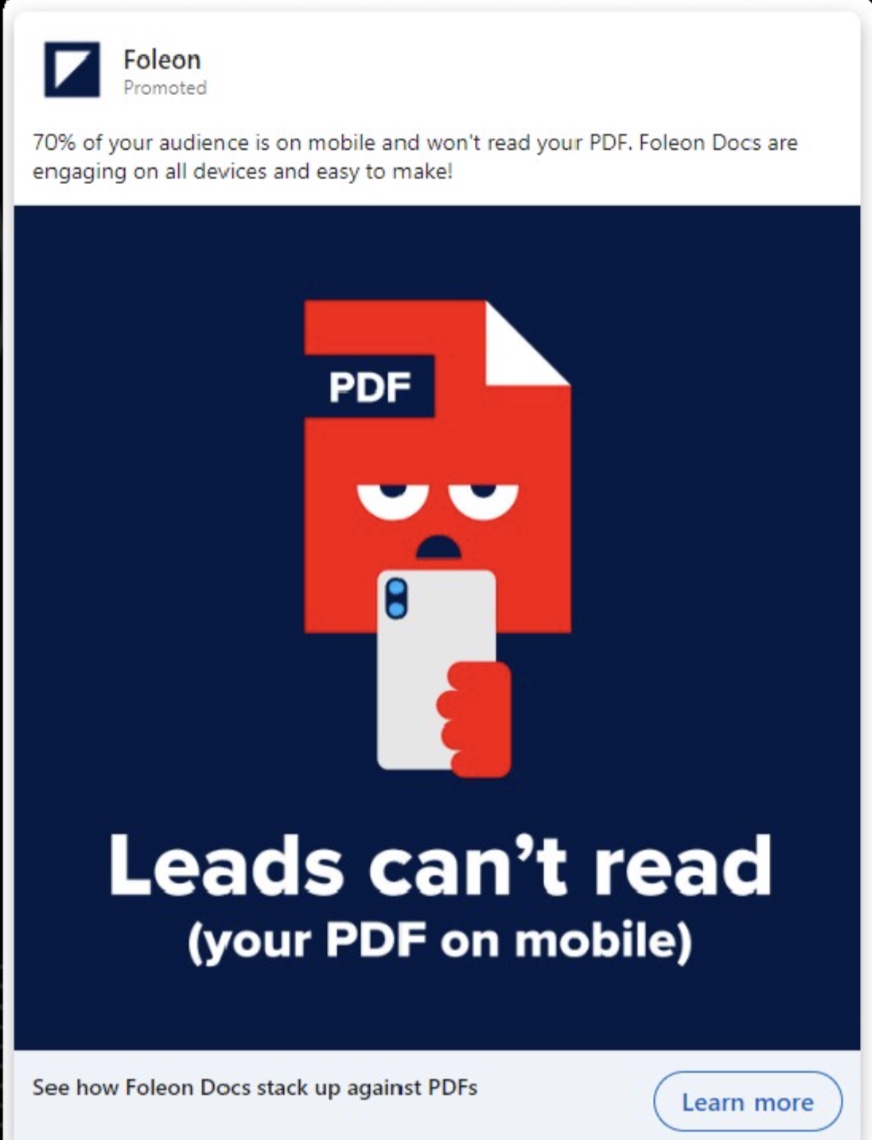
8. Authentic Imagery
Use authentic human images, no stock photos.
There are millions of studies and experiments showing the psychological effect of adding people to the ads (this one from Incivus is a good one), but one of the main reasons is that it connects with the viewer on a human level and builds trust.

9. Break Norms
Create ads that defy traditional expectations.
This ad from UserGems is pretty cool because it mimics the in-platform alerts to grab the audience's attention and lean into the pain point they were trying to talk about with their ICP.

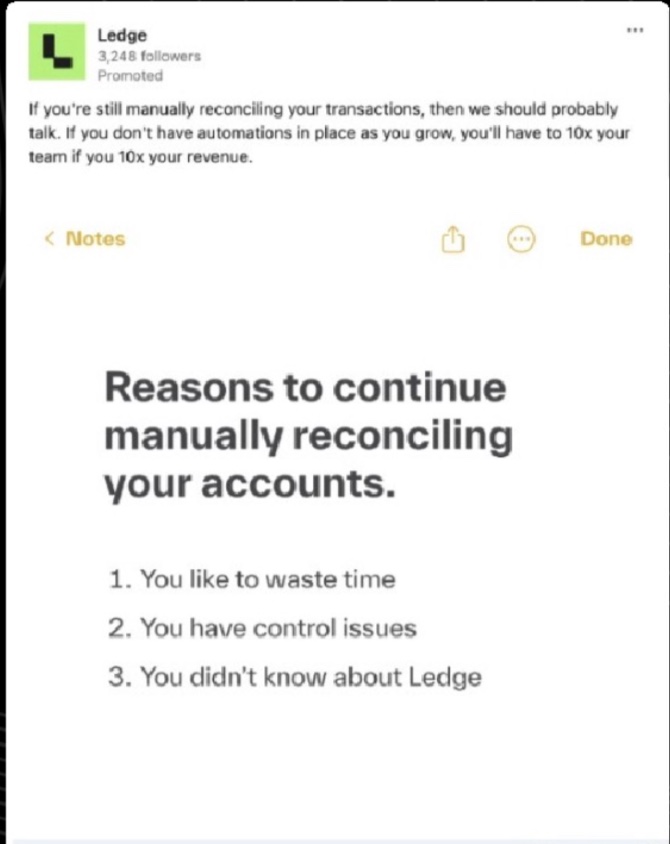
10. Build Trust
Leveraging social proof and addressing objections early can have a big impact.
Social proof helps build trust, and your prospects will see all the other big brands and competitors using your tool, so it will also give them FOMO (Fear of Missing Out).
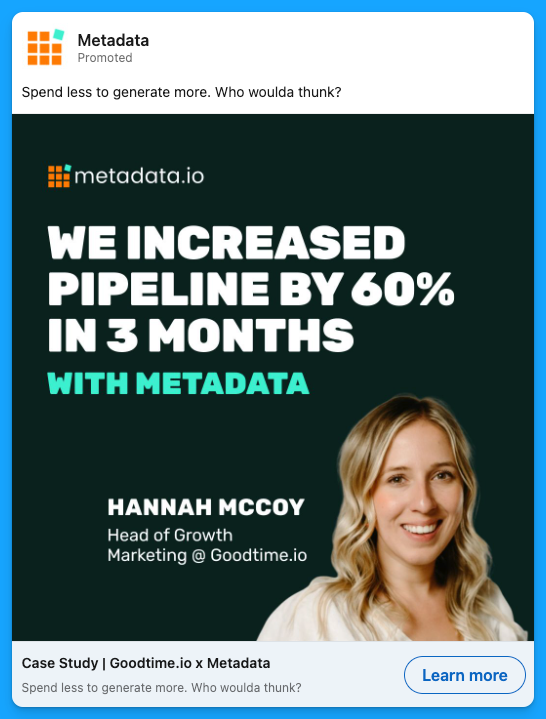
Great B2B ads don’t just happen, they’re built on understanding your audience, removing friction, and breaking the norms.
I hope you found this article helpful!To learn more about B2B ads best practices, dive into the articles below:
Connect with me on LinkedIn, and let’s keep the conversation going.
You can also visit my website here for more valuable content.
Jumpstart Your B2B Marketing Career
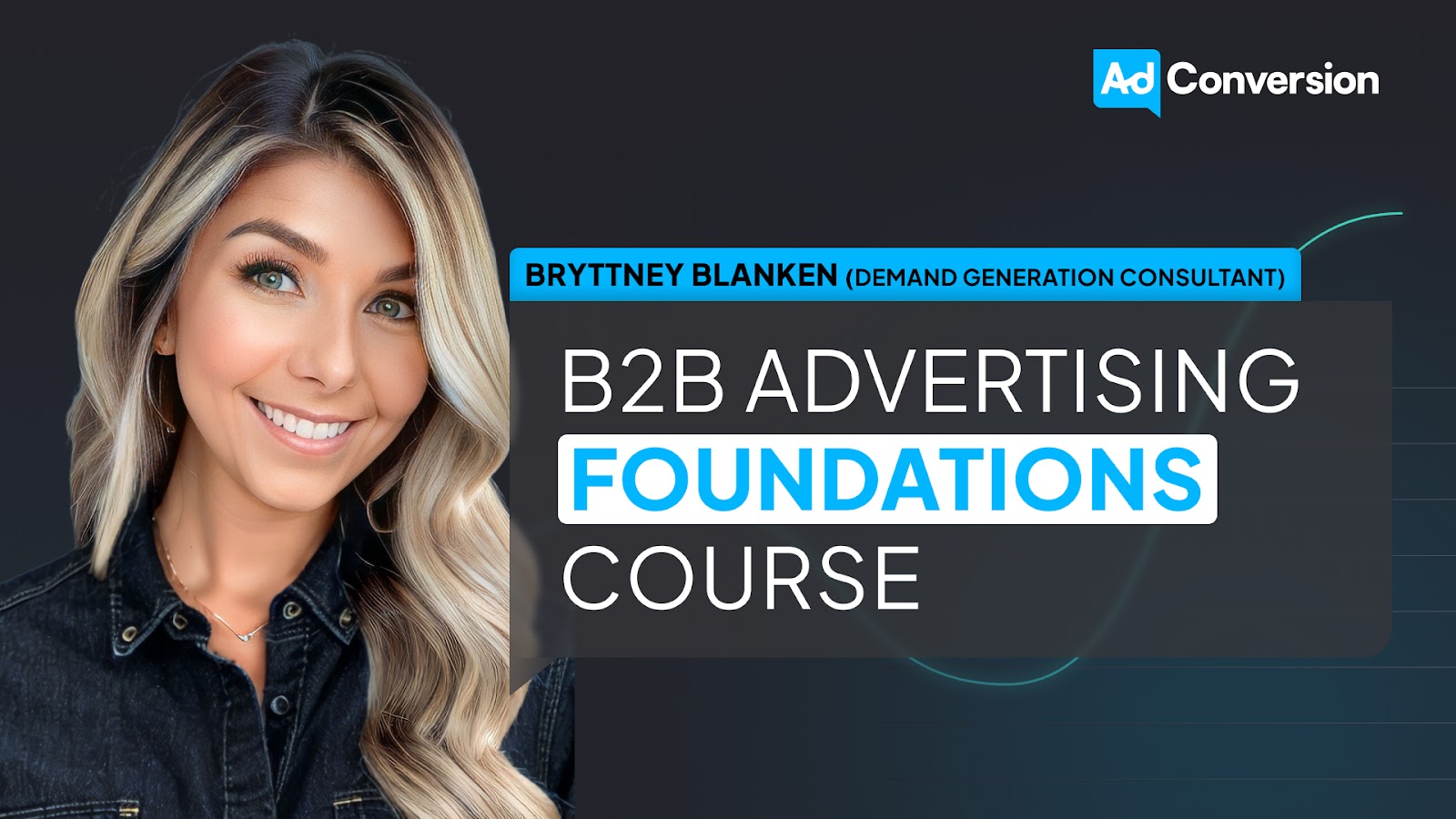
If you’re serious about mastering B2B advertising, then you definitely need to check out my free course that will teach you the foundational knowledge to becoming a high-performing B2B marketer who knows how to use advertising to drive legit business and revenue impact without the fluff or wasting your time and money learning the ropes the hard way.
- Module 1: You’ll get a crash course in the B2Bverse and master terminology, sales processes, and working across teams.
- Module 2: You’ll learn how to become your customers' psychologists and understand them deeply through buyer personas that allow you to craft effective messaging.
- Module 3: You’ll master the B2B funnel and learn how to think like a CEO to identify performance bottlenecks and convert more leads into revenue.
- Module 4: You’ll learn how to put it all together and build your go-to-market strategy that gets your ad in front of your dream buyers and converts attention.
This course was designed with absolute beginners in mind.Accelerate your learning curve and start the course today for free.
People Also Ask
How can I effectively measure the success of my B2B ad campaigns?
Utilize key performance indicators (KPIs) such as click-through rates (CTR), conversion rates, and return on investment (ROI) to assess campaign effectiveness. Implement tracking tools like Google Analytics to monitor user engagement and conversions.
What are the best practices for aligning ad creatives with my Ideal Customer Profile (ICP)?
Conduct thorough market research to understand your ICP’s pain points and preferences. Develop ad content that directly addresses these needs, using language and visuals that resonate with your target audience.
How can I ensure my call-to-action (CTA) is compelling and drives conversions?
Craft clear and concise CTAs that communicate the value proposition. Use action-oriented language and place the CTA prominently within the ad to encourage immediate response.
What strategies can I employ to create authentic imagery in my B2B ads?
Use real customer photos or behind-the-scenes images of your team to build trust. Avoid generic stock photos; instead, opt for visuals that genuinely represent your brand and resonate with your audience.
How can I break industry norms in my advertising to stand out without alienating potential clients?
Innovate within the boundaries of your brand identity. Experiment with unique ad formats, storytelling techniques, or humor, ensuring that these elements align with your brand values and appeal to your target audience.

SEO for B2B SaaS: 10 Tips to Drive Pipeline and Revenue
Over the past five years, I’ve helped B2B SaaS companies like Clickhouse, WildSparq and EventsAir drive millions in pipeline and revenue through SEO.
My lesser-known strategies have been featured by CXL, Ahrefs, The Marketing Millennials and more.
Along the way, I’ve developed an SEO playbook that B2B SaaS companies can follow (step by step) to start seeing high quality inbound leads in a matter of months.
I’ll be breaking down my entire process below 👇
TABLE OF CONTENTS
- Tip #1: Define Your Money Keywords
- Tip #2: Understand What's Already Ranking
- Tip #3: Build a Best-in-Class Page
- Tip #4: Nail the basics
- Tip #5: Build Quality Backlinks for $0
- Tip #6: Publish At Scale
- Tip #7: Design Pages That Convert
- Tip #8: Leverage sales calls, customer success calls, and customer research
- Tip #9: Keep Improving
- Tip #10: Scale as you grow
Tip #1: Define Your Money Keywords
Most B2B SaaS companies see SEO as a checkbox on their to-do list.
The CMO or CRO says, “Competitors are outranking us, we need to do some SEO.”
And marketers, who are already juggling a million different tasks, simply go to Semrush or Ahrefs, find some keywords with low difficulty and high search volume, throw them into ChatGPT, and publish a few articles.
Unsurprisingly, this doesn’t yield inbound leads and has minimal impact on revenue.
For SEO to actually drive results, you need to focus on the keywords that your dream clients are searching, or what I like to call “money keywords.”
Here’s a matrix that you can use to identify them:

Column 1: Make a list of your main offers (ie calendar scheduling)
Column 2: Make a list of the industries you serve best (ie sales, HR, marketing, etc.)
Column 3: Make a list of your main competitors (ie Chili Piper, Calendly, HubSpot)
Column 4: Make a list of the problems you solve, or jobs to be done (ie struggling to route leads efficiently)
Now, you can use these columns to create high-intent long-tail keywords. For example:
1. Best calendar scheduling software
2. Calendar scheduling for sales teams
3. Chili Piper alternatives
4. How to route leads more efficiently
Keep in mind, these “money keywords” will probably have a low search volume, and that’s okay. At the end of the day, you want traffic that will convert into pipeline, not a large number of visitors outside of your ICP.
When you’re doing this exercise, make sure to involve your founder (if you’re a smaller founder-led company) or your sales team (if you’re a larger sales-led organization) – they’ll likely have great insights related to the problems you solve.
Tip #2: Understand What’s Already Ranking
Now that you’ve identified those money keywords, type them into Google to see what type of content is already ranking organically.
For example, if you type in “Chili Piper alternatives” you’ll find that the top organic search results are something along the lines of “Top 10 Chili Piper alternatives to consider”, or what is commonly referred to as a product listicle.

Look through these existing articles and think about what your company can do even better. Can you include a comparative table or social proof, and clearly demonstrate why you’re the best without sounding overly biased?
Or, if you’re creating an article on how to speed up the lead routing process, look at the guides at the top of the SERP and think:
How can I create similar articles that are even more helpful? How can I demonstrate greater experience, expertise, authority, and trustworthiness?

Maybe it’s by going much more in-depth, or weaving in relevant videos, or highlighting screenshots of your product.
Pro tip: Don’t be afraid of highlighting your product throughout your articles. As marketers, we often worry about sounding too promotional, but the truth is, you need to show that your product is the obvious solution to a problem in order to drive revenue.
Tip #3: Build a Best-in-Class Page
Once you’ve researched what top-ranking pages are doing, it’s time to figure out how to blow them out of the water.
If you’re creating a listicle, can you add better visuals, weave in your product more, or add relevant CTAs?
If it’s a how-to article, can you link to a lead magnet or a YouTube video with more helpful context?
If it’s a landing page, can you add a more comprehensive FAQ section that answers all of your prospect’s questions?
Pro tip: Always consider where your prospect might be in their journey based on their search query. For a more top of funnel how-to article, you can include more subtle CTAs and connections to your product, while for a competitor comparison article, it makes more sense to include a clear demo request CTA.
Tip #4: Nail the basics
Technical SEO is important for e-commerce sites with thousands of pages, but most B2B SaaS websites (which are often 50 pages or less) don’t need a ton of technical SEO to win.
Sure, you still need the basics.
For example, let’s say you write an article related to the keyword “Best calendar scheduling software.”
You’d want your slug to be “best-calendar-scheduling-software”; you’d want to include your keyword in your H1, meta title, and meta description; and you’d want to incorporate the keyword naturally throughout your article.
You’d also want good UX, a clear menu nav, solid design and UI on both mobile and PC, some internal links to relevant topics throughout your website, and some other pages linking back to your article.
That’s really all you need.
After you have these basics in place, focus on producing a high volume of content that’s relevant to your prospects, and don’t lose sleep over technical optimizations.
Tip #5: Build Quality Backlinks for $0
Even if you have the best content, ranking for your dream keywords isn’t easy, especially if your competitors have been around for decades and have extremely high domain authorities.
To compete against the giants and set yourself up for success, you need high quality backlinks to your website.
Here’s one of my favorite ways to get them:
1. Go to Semrush or Ahrefs, whichever keyword research tool you prefer, and paste the LinkedIn profile URLs of your thought leaders (Founder or other execs) into the backlinks tab.

2. In the results, you’ll find a list of all the articles featuring your thought leaders and linking out to their LinkedIn profiles.

3. Message these companies and see if they can update the articles to link to your website, not just to the LinkedIn profile URL. Even better if you can get a backlink to one of your high-intent pages.
After doing this, you can go a step further and visit the podcast search engine Listen Notes, type in your niche (ie B2B ads, recruitment, sales enablement), filter by top podcasts in your space, and make a list on a Google sheet.

Next, have your thought leaders reach out to the podcast hosts via LinkedIn.
The message can be short and simple, such as: Hey Sam, enjoyed your recent episode on X, had an unusual idea for your show. Are you against a conversation?
From my experience, around 20% of hosts will respond, and your thought leaders will start getting featured on amazing podcasts, which will eventually lead to more backlinks to the company website.
Pro Tip: To start seeing results quickly, aim to send 5-10 messages per week to podcast hosts in your space.
Tip #6: Publish At Scale
With SEO, quality matters, but quantity is a massive competitive advantage.
Larger companies are spending a lot of money on ads, content marketing, and events, but they typically have a ton of red tape.
They may take two weeks to approve a topic, a month to plan out the content, a month for design, a month for web development, a month to publish… Which is to say, by the time they’ve published 2 or 3 pages, you could have published 30, 40, or 50 quality articles, and started stealing some of the market share.
To start seeing results, publish as much content as possible focused on your money keywords (occasionally weaving in more top of funnel content).
Also, remember, unless you’re a super authoritative company, it’ll usually take 2-3 months for Google to crawl your pages, so the content you publish today is setting you up for success 90 days from now.
Tip #7: Design Pages That Convert
If you’re investing a lot of money in content, make sure you also invest in great design. The better the user experience, the more likely you are to drive conversions.
Here are some questions to ask yourself:
- Are your pages aesthetically pleasing?
- Is your content skimmable on both mobile and PC?
- Are you including screenshots, videos, or aha moments that relate to your product?
- Can you add more social proof (customer quotes, guides, walkthroughs) to increase trust?
- Are you sprinkling relevant CTAs throughout your content?
- Can you add sticky CTAs that are aligned with the funnel stage of each article (ie subscribe to newsletter for more top of funnel articles, request a demo for more bottom of funnel content)?

These changes, which might seem small, can lead to massive improvements in performance.
Tip #8: Leverage sales calls, customer success calls, and customer research
You can rank pages using generic AI-generated content that says things like “turbocharge your revenue” or “10X your productivity,” but prospects will immediately bounce.
If you want them to stay on your page – and possibly even schedule a demo – you need to write in-depth content that resonates with their exact pain points.
Looking at customer research and listening to calls is a great starting point. Even better if you can take your sales and CS teams out to lunch, walk them through the topics you’re tackling in your content, ask for additional insights, and weave these insights into your articles.
This way, all the content you create will be amazing for sales enablement in addition to SEO.
Tip #9: Keep Improving
As I mentioned previously, to win with SEO, you need to publish content quickly – when it’s ready, not when it’s perfect.
That being said, you should always be looking for ways to improve the content you’ve already published.
About 2 or 3 months after publication, check how your article is ranking.
For example, let’s say you write an article, and after a few months it settles at position number 7. You could look at this article more closely, and think of ways to get it closer to number 1.
Could you add a more comprehensive FAQ section, embed a relevant YouTube video, add nicer images of your product, include more customer quotes, or earn a few high quality backlinks?
These consistent optimizations can go a long way if you want to move up in the rankings.
Tip #10: Scale as you grow
SEO isn’t something you can set and forget – even if you’re an established company, there’s always room for improvement.
Once you’ve implemented tips 1-9, think of ways you can scale your efforts even further.
Can you increase your article production by hiring more team members or working with freelancers? Or create incredible resources (such as custom tools) that will be highly valuable to your ICP?
Also, don’t just think about SEO – after all, SEO is only a piece of the marketing ecosystem – think of ways to improve your ads, your YouTube channel, your podcast, your LinkedIn page, etc.
Improvements in all these areas will lead to greater brand awareness and trust, which will lead to more successful SEO.
Hope you found this article helpful!
Feel free to reach out on LinkedIn with any questions, or check out the Breaking B2B website or Breaking B2B podcast for more unusual B2B/SaaS SEO insights.
Resources for mastering B2B advertising
If you’re serious about mastering B2B advertising then you definitely need to join 1,000+ B2B marketers leveling up their paid advertising skill sets in AdConversion.
Here’s 4 reasons why you should consider joining. Every one of our on-demand courses are:
✅ 100% free access.
✅ Taught by vetted industry experts.
✅ Have workbooks, resources, and templates.
✅ Less than 10 minutes per lesson.
We believe every marketer should know how to scale paid ads so they can:
- Scale their ideas
- Level up their careers
- Make a positive impact
Click Here to Join 1,000+ B2B Marketers Today and start leveling up your advertising skill set.
Takes < 90 seconds to sign up (seriously we timed it 😂)
People Also Ask
How can I effectively measure the ROI of my SEO efforts in a B2B SaaS context?
Utilize key performance indicators (KPIs) such as organic traffic growth, conversion rates, and customer acquisition costs. Implement tools like Google Analytics and CRM systems to track the journey from organic search to lead conversion and revenue generation.
What are the best practices for conducting keyword research tailored to B2B SaaS audiences?
Focus on identifying high-intent keywords that align with your product’s solutions to specific business challenges. Consider the different stages of the buyer’s journey and develop content that addresses each phase, from awareness to decision-making.
How can I optimize my website’s technical SEO to support scalable growth for a B2B SaaS company?
Ensure your website has a clean architecture with logical URL structures, fast load times, and is mobile-friendly. Regularly audit for issues like broken links or duplicate content, and implement structured data to enhance search engine understanding.
What role does content marketing play in enhancing SEO for B2B SaaS, and how can I develop an effective content strategy?
Content marketing is pivotal in attracting and engaging your target audience. Develop a strategy that includes creating valuable, informative content such as blog posts, whitepapers, and case studies that address your audience’s pain points and demonstrate your expertise.
How can I build high-quality backlinks to improve my B2B SaaS website’s domain authority and search rankings?
Engage in thought leadership by contributing guest posts to reputable industry publications. Develop shareable content assets like original research or infographics, and foster relationships with industry influencers to encourage natural backlinking.

10 Tips to Create Winning LinkedIn Thought Leader Ads
Since their introduction in 2023, I’ve run hundreds of LinkedIn thought leader ads, for my demand gen agency, Omni Lab, and for my clients in B2B SaaS.
Through my experimentation with this format, I’ve developed a list of best practices to maximize the chances of success.
I’ll be sharing all my insights below 👇
TABLE OF CONTENTS
- Tip #1: Remember that thought leader ads are just sponsored posts
- Tip #2: Make sure your ads connect to your product
- Tip #3: Create content people would pay for
- Tip #4: Add Premium CTAs to your LinkedIn profile
- Tip #5: Test Non-Employee Influencer Campaigns
- Tip #6: Optimize your LinkedIn profile as if it were a landing page
- Tip #7: Look at the right metrics
- Tip #8: Give yourself a reality check
- Tip #9: Put yourself in your buyer’s shoes
- Tip #10: Focus on Awareness, Not Conversions
Tip #1: Remember that thought leader ads are just sponsored posts
First of all, remember that thought leader ads are not a silver bullet that will save your marketing program – they’re simply sponsored organic posts that can fit into your larger content strategy.
This isn’t to downplay the power of this format; targeting your ICP with content from your thought leaders is one of the most effective approaches to build brand awareness and mental availability.
That being said, your thought leader ads won’t be successful if you don’t have great positioning, messaging, content, or targeting.
The standard rules of marketing still apply.
Tip #2: Make sure your ads connect to your product
If you’re putting ad dollars behind organic posts, make sure they connect back to your product in some capacity.
I don’t mean adding a demo request CTA to every post, but the content you promote should have a core dotted line back to your product.
For example, at Omni Lab, I could promote a post highlighting our unique POV and approach to Google Ads, which is one of the services we offer. If this POV resonates with my audience, they’ll most likely think of me when they’re looking for support with their Google Ad campaigns.
Personal posts, such as occasional pictures of food or selfies on the beach, are okay, but they don’t deserve to be promoted.
At best, they won’t generate significant awareness for your product, and at worst, they’ll end up confusing your audience.
If your ICP loves you but they have no idea what you do, you probably won’t be in business for long 😬
Tip #3: Create content people would pay for
No matter how great your targeting or technical setup, you won’t get very far if you don’t have amazing content that people would be willing to pay for – this is true for ads in general, and especially true for thought leader ads.
Take some time to reflect on your offer. Are you just providing generic tips that people have heard many times? Or are you offering something unique and valuable that will pique the interest of your audience?
To give an example, for Omni Lab, I could run thought leader ads highlighting Google Ads bidding strategies. But it would be more effective to share in-depth campaign recommendations for my target accounts.
Or, if you’re a company like Navattic, you could run ads talking about interactive demos, but it would be more powerful to build out personalized interactive demos for your dream companies.
Next time you run a thought leader ad campaign, focus on increasing the perceived value of your offer, and you’ll see a massive improvement in performance.
Tip #4: Add Premium CTAs to your LinkedIn profile
If you’re looking to funnel people into an owned audience, such as your newsletter, consider adding a Premium CTA to your thought leader ads. This is something I do at Omni Lab, and it’s helped me generate hundreds of high quality email subscribers.

This CTA option is only available to LinkedIn Premium users: you can add CTAs such as View my newsletter, Visit my website, View my blog, etc., depending on the action you’d like your audience to take.
If you don’t have LinkedIn Premium, consider editing your post once the organic reach has died down (usually within 72 hours), adding a CTA with a link to your website.
Even though the primary goal of thought leader ads should not be to drive direct clicks and conversions, adding a CTA allows people to learn more about your company without having to go on a scavenger hunt.
Tip #5: Test Non-Employee Influencer Campaigns
After running hundreds of thought leader ads, both for Omni Lab and for my clients, I’ve found that thought leader ads from non-employees consistently outperform promoted posts from employees.
For example, at Omni Lab, we built out a media plan and campaign strategy for Navattic, and their Head of Growth and Operations (Natalie Marcotullio) made a post related to this.
We boosted this post to our target audience, and it was one of our top performing ads of all time, significantly outperforming all the thought leaders ads from me and my cofounder.

Clay is another great example of non-employee thought leadership. Members of their creator program post about how they use the software, and Clay promotes these posts to increase awareness for their company, while simultaneously expanding the reach of their creators – they’ve created a symbiotic relationship where everybody wins.

If you’re working with well-known people in your industry, consider how you might be able to partner with them: this could look like an audit, a strategy, a discount, access to exclusive features, etc. in exchange for promotion on LinkedIn.
Tip #6: Optimize your LinkedIn profile as if it were a landing page
When you’re running thought leader ads, your LinkedIn profile turns into your landing page – it’s the place where people go for more information about you and your company.
Here are a few tips to optimize your profile that I always share with my clients:
1. Make sure you have a banner image explaining what you do at a high level.

2. Make sure your profile photo is up to date, and use your primary brand color as the background.
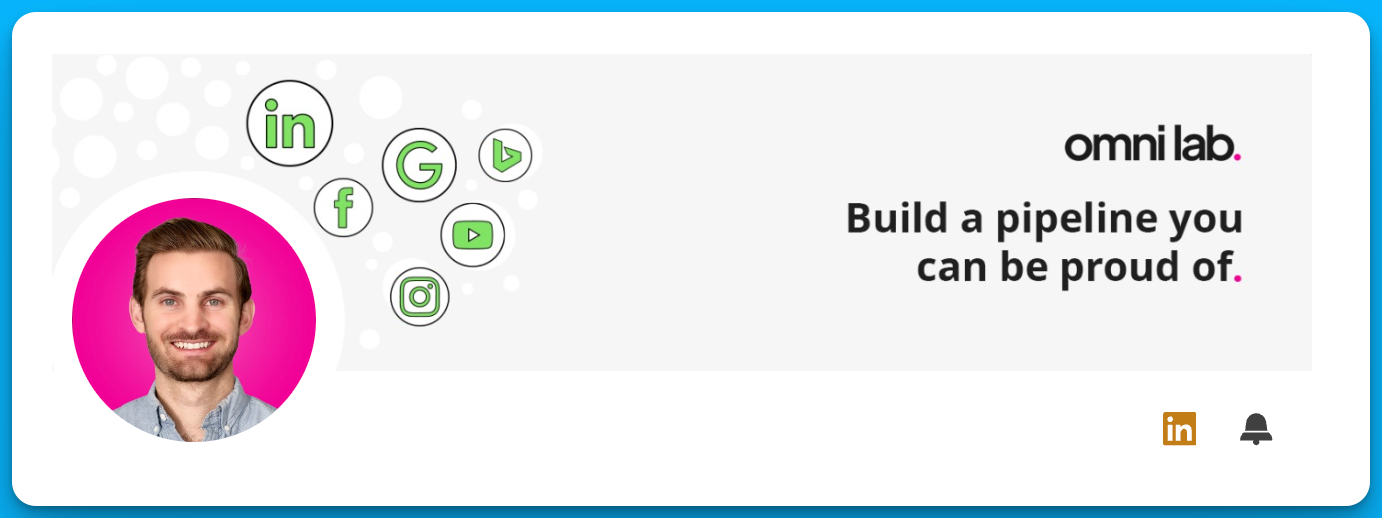
3. Add what you do + the category you play in to your headline

4. Use the About section to explain why your company exists and how you approach things differently (bonus if you can also add a few testimonials)

5. Use the featured section to highlight your core CTA + top performing posts demonstrating your expertise

Tip #7: Look at the right metrics
Let’s say you have all the fundamentals in place: an optimized profile, great content, solid targeting, etc.
Now, the next step is to ask yourself: What metrics should we look at to understand if our content is working?
Here’s what I recommend to my clients:
1. First of all, check your LinkedIn demographics report to make sure that you’re actually reaching your ICP.
2. Check in-platform metrics such as impressions, engagement, and CTR. If these metrics look healthy, you’ll know that your audience is finding value in your content.
3. Look at smaller microconversions, such as engaged visits on your website. Are the people reading your thought leader ads eventually navigating to your site to learn more?
4. Look at the self-reported attribution field on your demo request form. Are more people mentioning your thought leaders? If the answer is yes, you’ll know that your content is building trust with the right people.
5. Finally, you can look at more bottom of funnel metrics, such as sign ups or meetings booked, but ultimately, DO NOT obsess over these metrics. Prioritize numbers 1-4 to understand if your content is resonating – it might take a while to see a significant impact on pipeline and revenue.
Pro Tip: If you’re not sure what content to promote as thought leader ads, look for posts that had a 2-3% CTR organically. In my experience, these posts with a higher organic CTR are also the top performing ads.
Tip #8: Give yourself a reality check
Most people – and B2B buyers especially – aren’t making impulse decisions and can’t be pushed through a funnel.
As the Ehrenberg-Bass Institute has highlighted, if you look at how often prospects make a purchase in your category, you’ll quickly realize how few of the people you’re targeting are actually in-market.
Even if you run the greatest ads in the world, you can’t expect people to schedule a demo if they aren’t actively looking for a solution.
And even if they do book a demo, if you have a higher ACV, you’ll probably have an extremely long sales cycle.
My point is, you can’t expect hundreds of demos or millions in revenue right away.
Tip #9: Put yourself in your buyer’s shoes
This is a fun exercise I like to do with my clients.
I ask: “When you see posts on LinkedIn, what actions do you usually take?”
Usually, the response is something along the lines of:
“I read and keep scrolling…” or “If I like something, I might react or leave a comment…”
Then I ask the follow-up question: “If you see a post you like from a company you’ve never heard of before, would you immediately book a demo?”
And typically the answer is “No, of course I wouldn’t.”
Our prospects aren’t that different than we are; if we wouldn’t buy immediately, they probably won’t either.
If you’re getting good engagement and starting to see other signs of life (such as engaged website visits), you’re headed in the right direction, even if you’re not seeing more demos and sign ups right away.
Tip #10: Focus on Awareness, Not Conversions
Think of thought leader ads as a brand awareness play, not a direct response tactic.
Like any good brand marketing, your thought leader ads should relate to key buying situations, or category entry points.
For example, if I promote posts about how we help our clients improve their lead quality, prospects may think of Omni Lab if they ever run into lead quality issues.
Or maybe I talk about how we use paid media to increase brand awareness, and prospects may think of us if they’re having a brand awareness problem.
The key to succeeding with thought leader ads is putting the right messages in front of the right people. If you do this over a long enough period of time, the pipeline and revenue will follow.
Hope you found this article helpful!
Feel free to reach out on LinkedIn or Omni Lab with any questions about demand gen or paid media.
Master B2B LinkedIn Ads with these 3 Free Courses:
If you want to become a LinkedIn Ads pro, check out our free B2B LinkedIn Ads courses, where you'll learn how to launch, optimize, and scale your campaigns to drive pipeline and revenue.

Here's what you'll learn in each course:
⚙️ B2B LinkedIn Ads 101 - The Ultimate Crash Course for New LinkedIn Advertisers
- Foundations For LinkedIn Ads Success
- Measurement: Tracking & Key Principles
- Targeting: Reaching Your Dream Buyers
- Ads: Mastering The 9 Ad Formats
🎯 B2B LinkedIn Ads 102 - The Blueprint for LinkedIn Ads Optimization
- Monitoring: How To Spot Performance Trends
- Auditing: How To Find The Darlings You Need To Kill
- Reporting: How To Transform Data Into Insights
- Optimization: How To Make Your LinkedIn Ads Profitable
🚀 B2B LinkedIn Ads 103 - Advanced Scaling Strategies From $25M In Ad Spend
- Concepts of Scaling
- Divide and Conquer
- Learnings From $25M+ In LinkedIn Ad Spend
Click Here to Join 1,000+ B2B Marketers Today and start leveling up your advertising skill set.
Takes < 90 seconds to sign up (seriously we timed it 😂)
People Also Ask
What are LinkedIn Thought Leader Ads?
LinkedIn Thought Leader Ads are sponsored posts that promote content from personal profiles, allowing companies to leverage the personal brand and credibility of their thought leaders to engage target audiences authentically. 
How can I ensure my Thought Leader Ads align with my product?
Ensure that the content in your Thought Leader Ads connects back to your product or service, even subtly. While not every post needs a direct call-to-action, there should be a clear link between the content and what your company offers to maintain relevance and drive interest. 
What type of content works best for Thought Leader Ads?
Content that offers unique, valuable insights or information that your target audience would find beneficial tends to perform well. Aim to create posts that people would be willing to pay for, as this indicates high value and relevance. 
How should I optimize my LinkedIn profile for Thought Leader Ads?
Treat your LinkedIn profile like a landing page: use a banner image that explains your role, ensure your profile photo is professional, craft a headline that clearly states what you do, and utilize the ‘About’ section to detail your company’s mission and unique approach. 
What metrics are important to track for Thought Leader Ads?
Monitor metrics such as impressions, engagement rates, click-through rates (CTR), and audience demographics to assess whether your content resonates with your target audience. Additionally, track website visits and self-reported attribution to understand the broader impact on your marketing funnel.
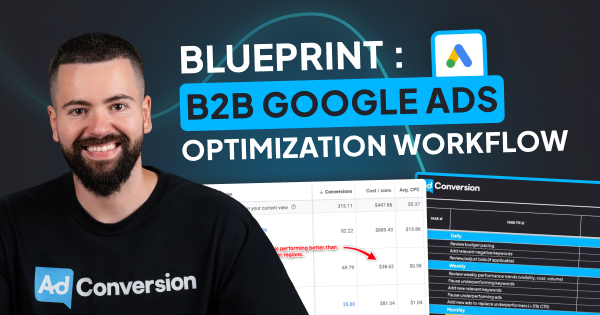
How To Create a B2B Google Ads Optimization Workflow [+Free Template]
Hey there, B2B Marketer. If you don’t have a well-structured optimization workflow, managing just a handful of Google Ads accounts can be a struggle (been there, done that 😅)
In this article, I’ll walk you through the Google Ads Optimization Workflow template, the exact process I used to go from barely managing five Google Ads accounts to easily managing 30+ 🚀
TABLE OF CONTENTS
- Google Ads Optimization Workflow Process
- Daily Google Ads Optimizations
- Weekly Google Ads Optimizations
- Monthly Google Ads Optimizations
- Quarterly Google Ads Optimizations
- Free Resources to Master B2B Ads 🔥
Why You Need a Google Ads Optimization Workflow Process
Without a consistent approach, managing Google Ads can feel chaotic. You may get lost in metrics that don’t matter or, worse, miss out on key optimizations that could boost your profitability.
I developed the Google Ads Optimization Workflow Template to help me stay organized and focus on impactful daily, weekly, monthly, and quarterly optimization tasks.
👉 Grab your free copy of the template in Module 2, Lesson 1 from the B2B Google Ads 102 - How To Convert Clicks Into Profit course.
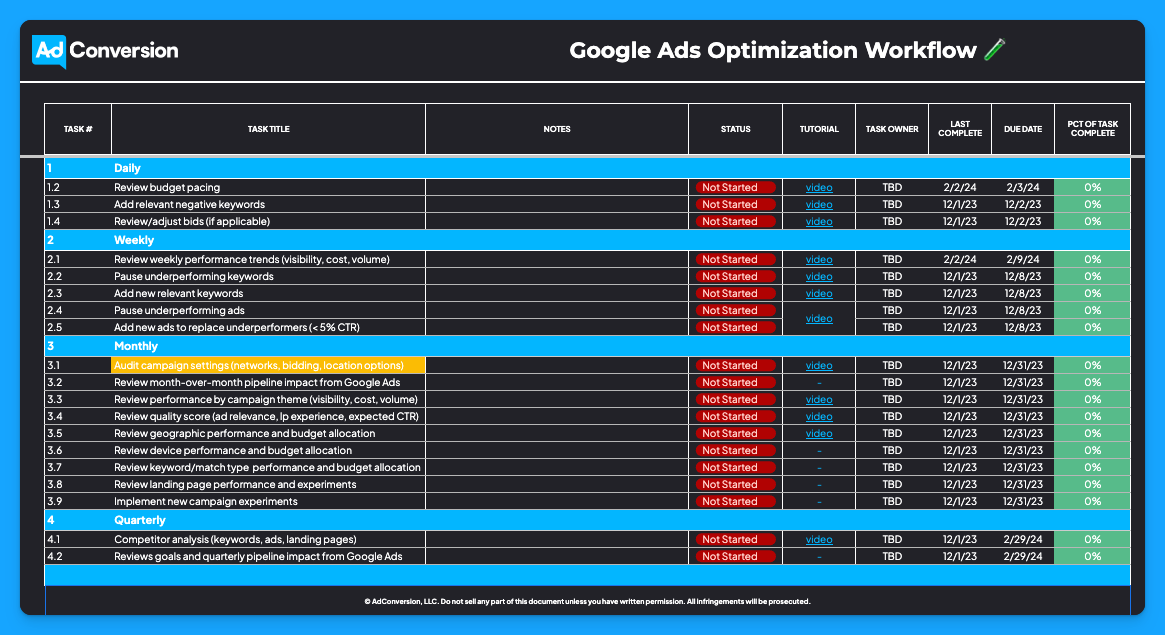
If you follow this approach, you’ll find yourself in control of your accounts, not the other way around.
Now let’s dive deep into the tasks by timeframes ⏰
Daily Google Ads Optimizations
Daily optimizations are essential for ensuring that your accounts are running smoothly. It’s your first line of defense against overspending and wasted ad spending.
Each day, you should:
1. Review your budget pacing
This way, you’ll ensure that you are not overspending or underspending.
2. Check for irrelevant search terms in the Search Terms Report
You want to add any irrelevant negative keywords. So every single day, you should review your search terms report and compare your search terms to your keywords to find the irrelevant ones and add them to your negative list.
3. Adjust bids as needed
If you’re using manual bidding, make sure to adjust your bids accordingly to get visibility.
If you’re using something like maximize clicks with a bid cap, make sure that you take a look at your average cost per click in relation to your bid cap. If you notice that your average cost per click is really close to your bid cap, you could be throttling yourself.

If you’re using Target CPA bidding, ensure that the CPA amount you set is large enough to get enough deliverability. I recommend increasing it by 20% if you notice you’re not spending your budget.
Pro Tip: Setting up Google Calendar reminders can be helpful, and something that I always tell my team that manages client accounts internally at our agency is to block an hour on their calendars every single day to go through their accounts and optimize them. We call it “optimization power hour”. ⚡️

By doing that, you will be proactive, and you’re going to catch things much sooner before they become potential fires.
Weekly Google Ads Optimizations
Weekly optimizations allow you to step back and review broader trends instead of getting caught up in the day-to-day fluctuations.
Instead of getting caught up in the day-to-day fluctuations, here you should:
1. Review weekly performance trends (visibility, cost, volume)
Every week you should look at search impression share, search lost to rank, search lost to budget, and search top impression share.
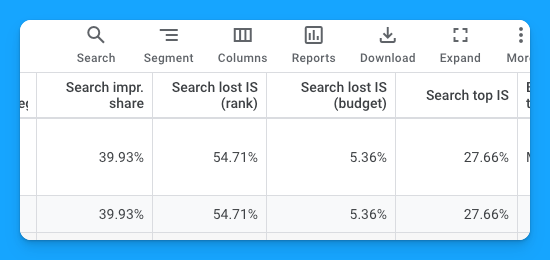
You also want to look at how much you have spent, your cost per conversion, your cost per custom conversion, meaning the cost per SQL, converted user, or whatever that KPI is that you’re measured against.

You will also want to look at volume. How many conversions are you getting? Is it trending up? Is it trending down? These are the things to keep an eye on every week.
Another thing you can do is check the charts in Google Ads to map different metrics and quickly see the trend of search impression share with this graph 👇

🚨Important: When you’re optimizing and looking at things weekly, don’t freak out if you see changes like 25% down search impression share. But if you see it happen consistently for two or three weeks in a row, then there’s definitely something that you need to make a decision about.
Lastly, breaking down your campaigns by themes like brand, non-brand, and competitive will help you to quickly identify underperforming segments and reallocate your budget where it will be most effective.
This will make the optimization process much more manageable.
2. Pause underperforming keywords
Pausing underperforming keywords is an opportunity to give more budget to the keywords with good performance.
You can quickly go to the keyword section in your account and filter by conversions to see which keywords have no conversions. Then, you can sort by cost and understand which ones are hemorrhaging the most budget and can be paused.
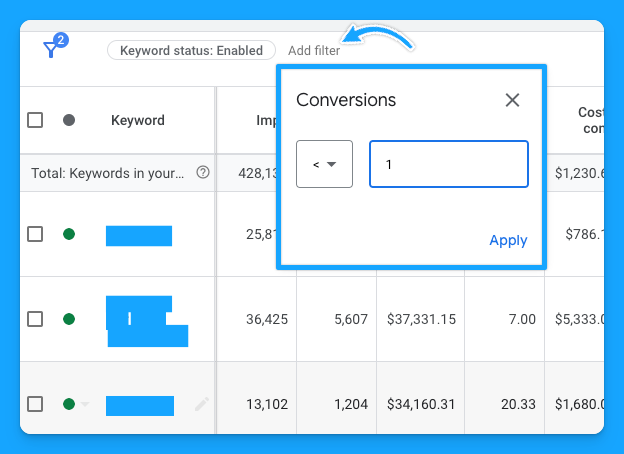
3. Add new relevant keywords
When you check the Search Terms report, there are certain search terms that can make sense to add to your campaign as keywords.
You can also go to the Google Ads Keyword Planner and find net new keywords that you might not be covering. This is an opportunity to expand your scope and reach, and it’s a good best practice to get into the habit.

4. Pause underperforming ads and add new ads to replace underperformers (<5% CTR)
Pausing underperforming ads is as simple as going to the ad section in your account and then pausing any ads that are not performing anymore.
So if you notice you have some underperformers, ideally anything less than a 5% click-through rate (but always compare it with your average performance), it’s time to shut off the underperforming ad and add a new ad into the mix.
This way you can continually improve your overall click-through rate performance to help boost your expected click-through rate and improve your quality score.
Monthly & Quarterly Google Ads Optimizations
Monthly and quarterly tasks focus on more strategic, higher-level adjustments.
Monthly Optimizations
It’s crucial to ensure that your campaign settings, quality score, and budget allocation align with your overall goals and haven’t been altered unintentionally.
This is also the time to assess the impact of your Google Ads efforts on your sales pipeline and to make necessary changes.
So at the end of each month, you should:
👉 Audit campaign settings (networks, bidding, location options)
This step is crucial if you manage multiple campaigns or accounts.
It’s important to double-check if you’re targeting the right network and don’t have display and search combined together.
You want to make sure your bids haven’t been updated by accident, or God forbid, you have the auto recommendations still turned on, and they’re automatically updating your bids without your consent. 💀
You also want to ensure that your location options are set to “presence” and that people are actually in your target location or regularly in, not people who are potentially in other areas and are interested in that location.

👉 Review month-over-month pipeline impact from Google Ads
We’re running ads to generate revenue, and revenue comes from initially having pipeline.
So you need a dashboard to track the performance month-over-month and connect your activity to revenue.
It can be as simple as having a report on a spreadsheet where you can see the evolution of your KPIs every month. You can create one from scratch or search for a template on the internet.
Pro tip: Check out our free Building a Paid Media Program course (Module 3, Lesson 2) to learn how to build an automated dashboard for less than $200/month using Google Sheets + a connector like Dataslayer or Supermetrics.
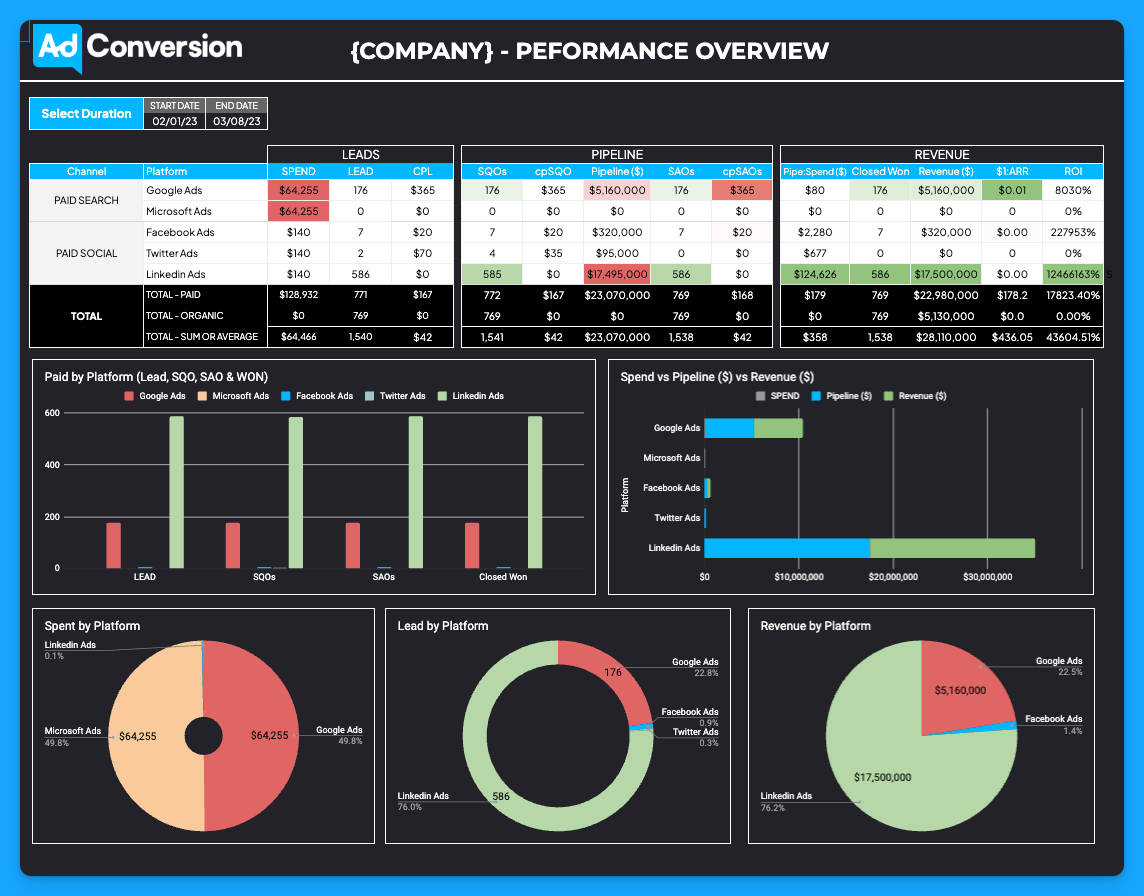
👉 Review performance by campaign theme (visibility, cost, volume)
The same analysis we discussed in the weekly optimizations above should be done on a monthly basis too.
How much are you spending per theme? What is your cost per conversion? What is your conversion rate? And what are the volumes?
Are you driving more volume in a certain theme versus another? Should you move the budget around?
These are the questions you should answer here.
👉 Review quality score (ad relevance, landing page experience, expected CTR)
How is your quality score by campaign theme? Is it increasing or decreasing month-over-month?
Ideally, you should aim for a quality score of 7 or above. If it’s lower than that, optimizing your ad relevance, expected CTR and landing page experience will improve things.
Check out this Quality Score Guide to learn the 80/20 of what you need to know about quality score to improve it.
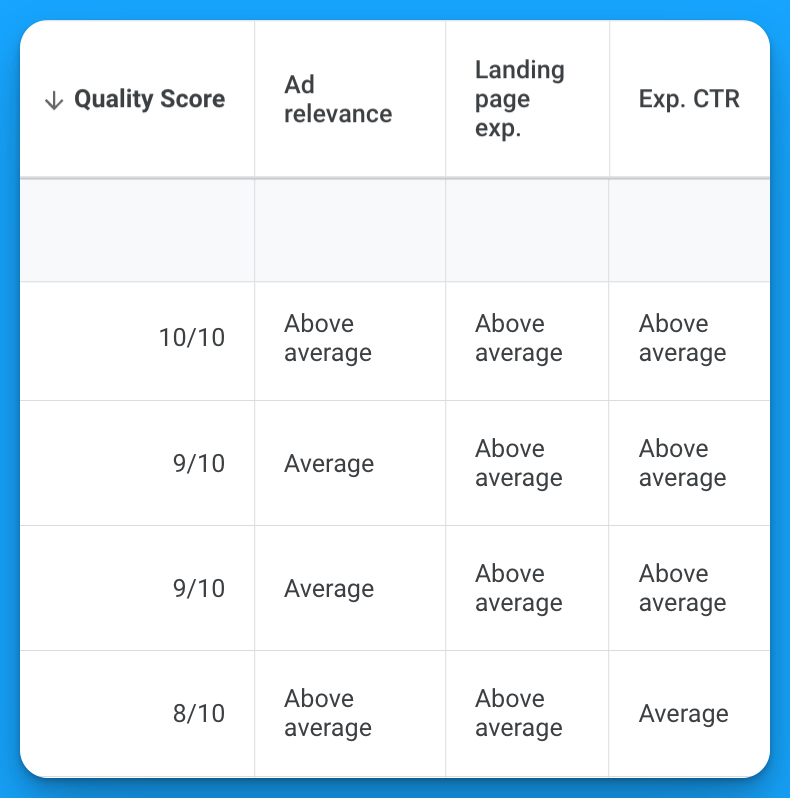
👉 Review geographic performance and budget allocation
Here you want to go ahead and see how the campaigns you’re targeting in each region are performing so you can make the necessary adjustments.
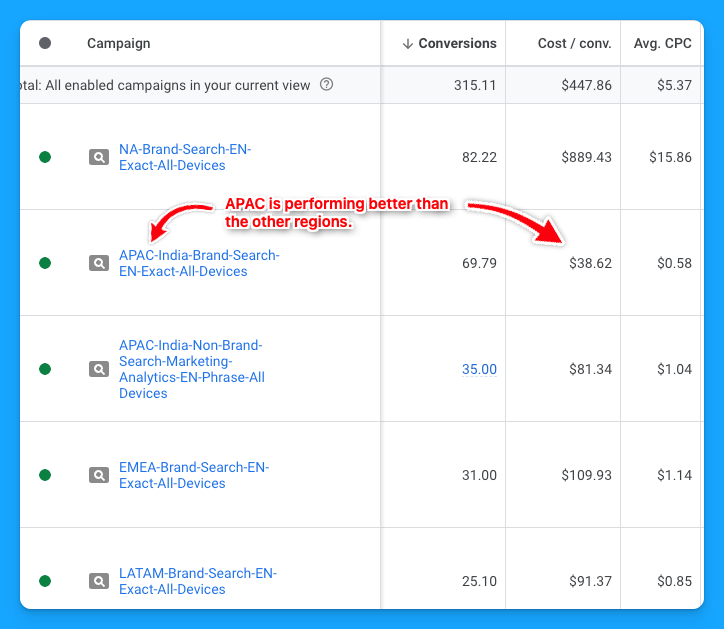
I also recommend checking the Locations report to have a granular view of how each country grouped into a region is performing.
By doing this, you can find opportunities for new campaigns targeting a single country if it has a good performance and the campaign is limited by budget, or excluding low-performing countries to free up some budget for the top performers.
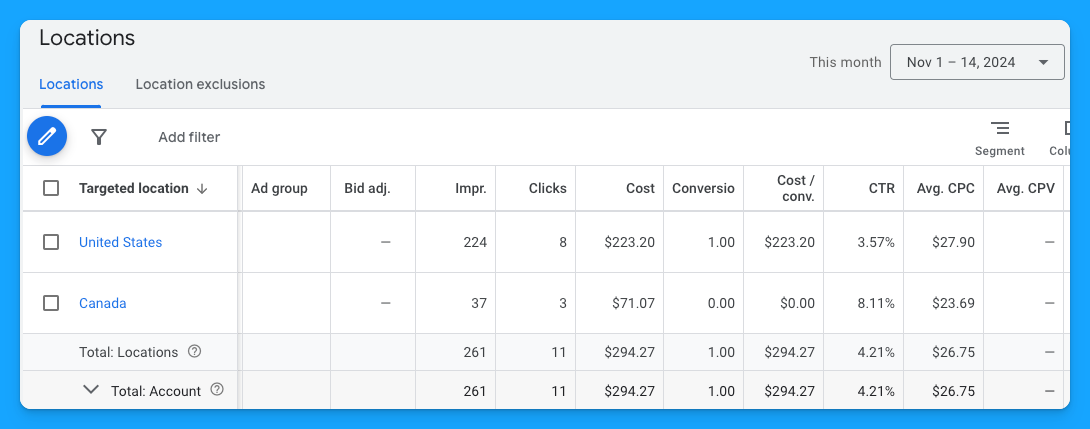
👉 Review device performance and budget allocation
In B2B, desktop usually performs better than mobile and tablet, so if you’re targeting all devices you can find opportunities to maximize conversions by breaking out the campaigns into different devices.

👉 Review keyword/match type performance and budget allocation
Are there certain keywords that are doing better for you than others? Certain match types? All of these are insights that will help you optimize your Google Ads campaigns.
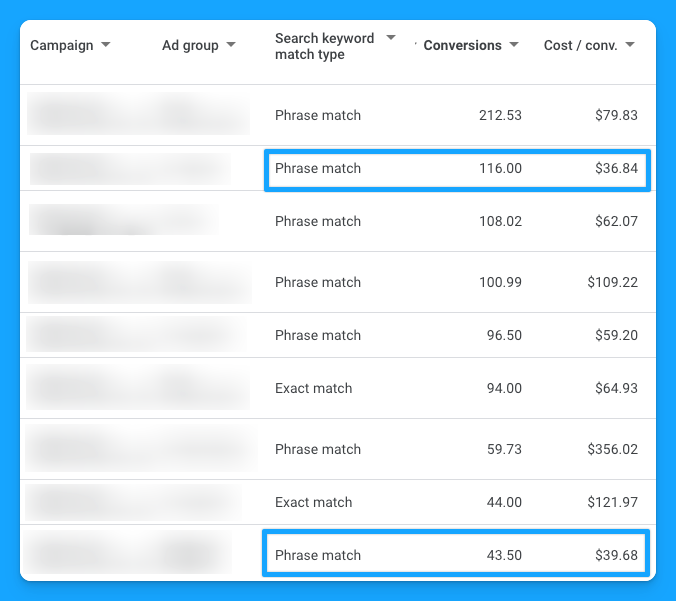
👉 Review landing page performance and experiments
How are your landing pages performing? Are you running experiments? If you're not, that's definitely an opportunity.

👉 Implement new campaign experiments
If you’re not testing new experiments, this is a massive opportunity to improve performance, and you can run experiments easily in Google Ads with their campaign experiments tool.
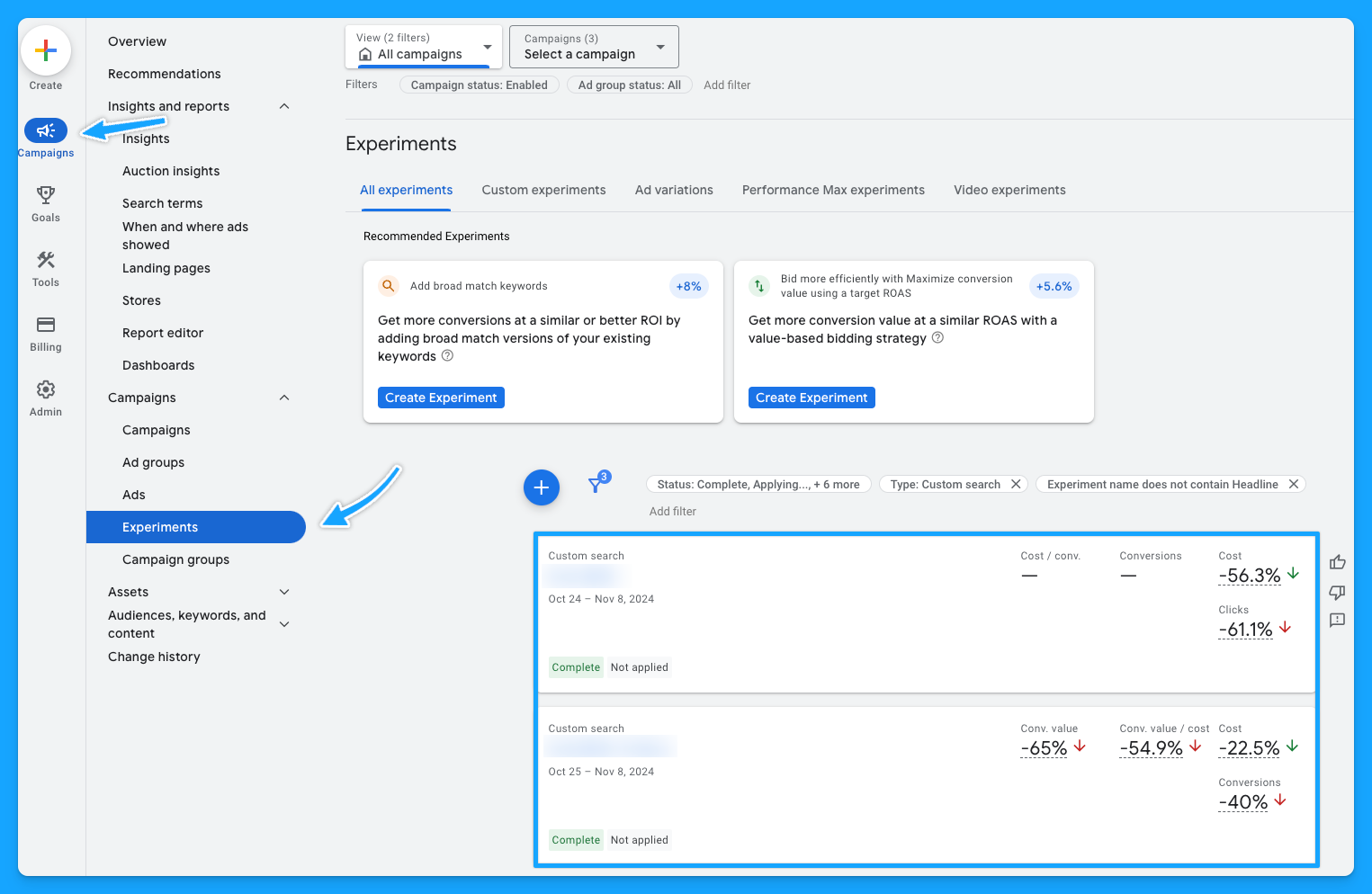
Quarterly Optimizations
Every quarter, take time to conduct a competitor analysis and review your goals. It’s a great practice to see what new ads and keywords your competitors are using, giving you inspiration and helping you stay ahead in the market.
Pro tip: The channel ad libraries are great resources for competitor research. Check out these 10 tips for free competitor research using them.
This periodic check-in will ensure that your optimizations are aligned with your business objectives, providing a clear path for growth 🙌
Stay organized with the Google Ads Optimization Workflow template
If you get your free copy of our Google Ads Optimization Template, you’ll notice that we have daily, weekly, monthly, and quarterly tasks discussed above on the template.
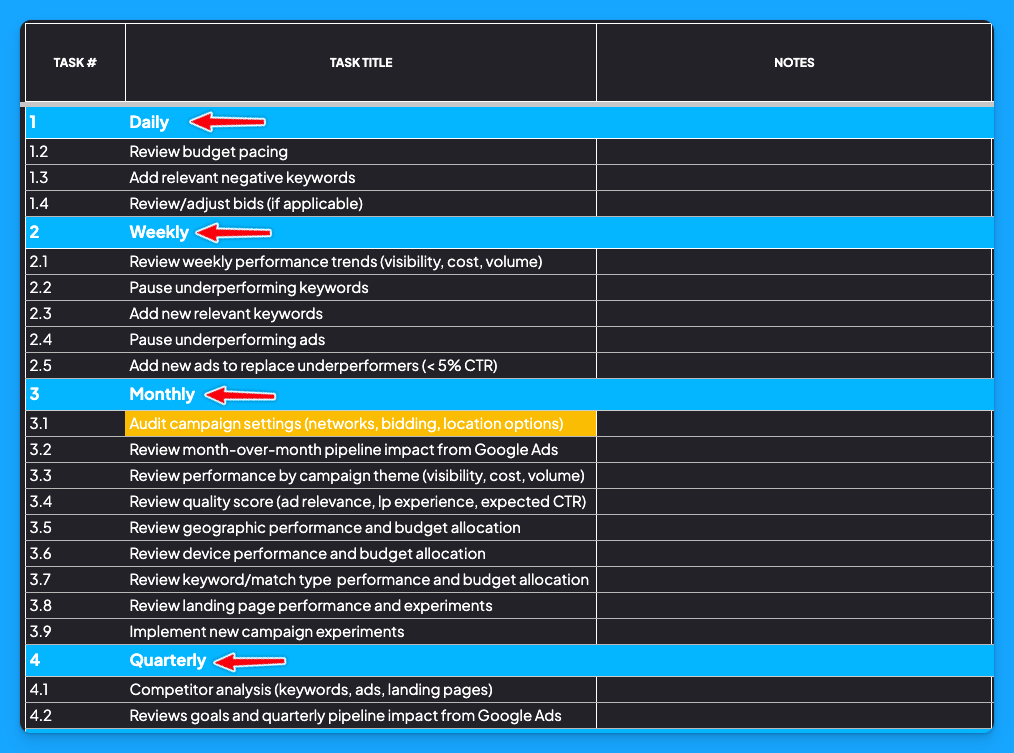
The way this template works is very simple. We have our tasks on the left, the task title, and the different timeframes. There’s also a space for you to take notes while optimizing your account.
Then you can change the status of each task, so you and your team will know if a task is done or if it’s in progress, as well as define the task owner.

There are also some formulas where, based on the timeframe, the due date will automatically update. So for example, if you set the Last Complete date of a daily task as 2/2/24, it’ll automatically say the due date for that task is 2/3/2024.
In addition, if you do the same thing for a weekly task, it will add seven days to the due date, and now it will say 2/9/2024.
Lastly, you’ll also find all the different tutorials covered in this guide linked to each task. The goal of these tutorials is to show you how to do each step so you can use this as a reference.
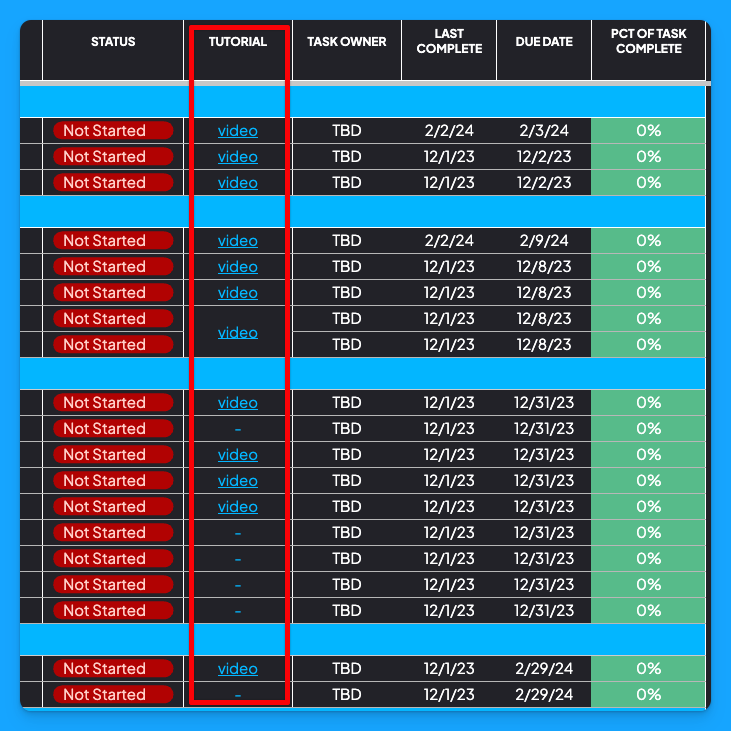
By implementing these daily, weekly, and monthly optimizations, you’ll stay ahead of potential issues and make data-driven adjustments that boost your account performance.
I hope this guide helps you to manage your accounts efficiently 🙌
If you have any questions, feel free to connect with me on LinkedIn.
From Clicks to Conversions: Master Google Ads for B2B 🔥
If you want to become a Google Ads pro, check out our free B2B Google Ads courses, where you'll learn how to launch, optimize, and scale your campaigns to drive pipeline and revenue.

Here's what you'll learn in each course:
⚙️ B2B Google Ads 101 - How to Launch Dangerously Effective Campaigns for Beginners
- The Googleverse: The Game You're Playing & How To Win
- Measurement: How to Make Sure You're Profitable
- Targeting: How to Show Up For the Right Searcher
- Planning: Putting It All Together
🎯 Google Ads 102 - How to Clicks Into Profit
- Visibility: How To Find the Hole Sucking Profits
- Workflows: How to Optimize On a Daily, Weekly, Monthly & Quarterly Basis
- Experimentation: How to Test & Automate Profitability
- Troubleshooting: How To Solve Inevitable Problems
🚀 Google Ads 103 - How to Scale Google Ads For Advanced Advertisers
- Methodology: How to Vertically Scale Google Ads From A-Z
- Campaigns: Scaling Horizontally Through Campaign Themes
- Channels: Scaling Outside of Paid Search
Click Here to Join 1,000+ B2B Marketers Today and start leveling up your advertising skill set.
Takes < 90 seconds to sign up (seriously we timed it 😂)
People Also Ask
How can I effectively prioritize optimization tasks within my Google Ads workflow?
Assess tasks based on their potential impact on key performance indicators (KPIs) like conversion rates and return on ad spend (ROAS). Focus on high-impact areas first, such as budget pacing and search term relevance, to ensure efficient use of resources.
What tools or templates can assist in organizing and tracking my Google Ads optimization activities?
Utilize the Google Ads Optimization Workflow Template provided in Module 2, Lesson 1 of the B2B Google Ads 102 course. This template helps structure daily, weekly, monthly, and quarterly tasks, ensuring a systematic approach to campaign management. 
How can I ensure that my optimization efforts align with my overall B2B marketing objectives?
Regularly review your marketing goals and ensure that your Google Ads strategies support these objectives. Align optimization tasks with broader business aims, such as lead generation or brand awareness, to maintain strategic coherence.
What are the common pitfalls to avoid when implementing a Google Ads optimization workflow?
Avoid neglecting regular reviews of budget pacing and search term reports, as this can lead to overspending or irrelevant traffic. Ensure that optimization tasks are performed consistently to maintain campaign effectiveness.
How can I adapt my optimization workflow to accommodate changes in campaign performance or market conditions?
Stay agile by regularly analyzing performance data and being prepared to adjust your workflow in response to trends or shifts in the market. Flexibility allows for timely optimizations that keep campaigns aligned with business goals.
-2.jpg)
Using the Jobs To Be Done Framework to Maximize Revenue in B2B Ads [+Free Template]
Understanding the Jobs To Be Done framework developed by Tony Ulwick can be confusing and overwhelming because most of the information you’ll find is focused on product development.
In this article, I’m going to unpack the Jobs To Be Done framework from a B2B advertising perspective.
Why? Because identifying what job your customers are truly “hiring” your product or service to do will be the secret to launching a powerful ad campaign.
This article is part of our B2B learning track so if you’re serious about learning B2B advertising you’re in the right place!
Let’s dive into it 👏
TABLE OF CONTENTS:
- Understand Why Customers Choose Your Product
- Using the Jobs to Be Done Interview Matrix Template
- Customize Your Messaging with Personality Insights
- Real Use Case of the JBTB Matrix Template
- Free Resources to Jumpstart Your B2B Marketing Career
Understand Why Customers Choose Your Product
In any industry, people don’t buy products, they invest in solutions to get a job done. It’s not just to buy another thing like your cat-hoarding grandmother. 😅🐈

For B2B marketers, Tony Ulwick’s Jobs to Be Done framework should be focused on why your customers “hire” your product or service, so you can put them and their needs at the heart of your advertising story.
This will help you to identify what pain points you’re helping your customers solve to get to the root of what motivates them because your advertising campaign should be about them — not you.
But how can you do that?
You can use the Jobs To Be Done framework when you're launching a new advertising campaign or when you want to improve the conversion rates of your existing advertising campaigns (aka your ads that aren’t converting)
The most impactful way to start is by identifying three to five recent customers who fit your target market (or Ideal Customer Profile - ICP).
If you need help identifying your ideal customer profile, check out this article: “How to Craft B2B Buyer Personas for Ad Targeting”
Select customers who either recently purchased or have the potential to represent your ideal buyer. These interviews will reveal why they chose your service and what specific pain points you helped them solve.
To make your life easier, I developed a free template called Jobs to Be Done Interview Matrix 🙌
You can find it in Module 2, Lesson 3 of my free B2B Advertising Foundations course, and it’s your roadmap for collecting insights during interviews.
Using the Jobs to Be Done Interview Matrix Template to Gather Actionable Insights

In this JTBD Interview Matrix Template, you’ll be looking for five key points that highlight your customer’s journey with your brand:
- Situation and Pain Points - What challenges are they facing?
- Motivation - Why did they start looking for a solution?
- Trigger - What prompted them to move forward with your service?
- Ideal Outcome - What result are they seeking?
- Competitor Evaluation - What other options were they considering?
The matrix helps you organize answers by each customer’s profile and offers a side-by-side comparison of their unique characteristics.
It also offers 8 helpful interview questions you can use to uncover the right golden nuggets that will make your campaign shine. ✨
Customize Your Messaging with Personality Insights
Finally, understanding your customer’s personality type is like having the key to crafting messaging that lands with confidence.
Resources like Crystal can help you determine each customer’s DISC personality type (Dominance, Influence, Steadiness, Compliance) by scraping their LinkedIn profiles, labelling how they like and prefer to be communicated with, and their style and tone because this will ultimately influence the messaging that you can create for each of your advertising personas.

Here’s a real use case for you to understand each step of the JTBD Interview Matrix
Let’s take Spotify as an example. I love Spotify, so if I were doing an interview with a Spotify customer, it would look like this:

Situation & Pain Points
I get tired of hearing the same songs on the radio. I can’t easily listen to the exact song I want to hear.
Motivation
I want to listen to specific songs when I want
Trigger
I’m in the gym, and I need a song to pump me up
Ideal Outcome
I want to listen to the music I choose, everywhere
Other Solutions/ Products Evaluated – Competitors
Radio, XM Radio, Pandora, Apple Music, Silence
Personality characteristics (DiSC type, DiSC archetype, etc)
Trailblazer - ID. Confident style, with a mix of informality and formality gets their attention.
- Pace: Speak slightly fast. Sounds like a ‘gets shit done’ person.
- Tone: Do not sound too eager, as if you have met a friend suddenly after a long time. Keep the tone calm but confident.
- Tactics To Win: Strong words, focus on results, respectful confidence
Based on the JBT Interview Matrix, here are some Spotify ad examples:


The main takeaway is that you can make your ad campaigns even stronger when you really know what “job” your customers are “hiring” your product or service to take care of.
Use the Jobs To Be Done matrix to dig deep into what matters most to them and adjust your messaging to connect on a personal level. 🙂
I hope you found this article helpful!
Connect with me on LinkedIn, and let’s keep the conversation going.
You can also visit my website here for more valuable content.
Jumpstart Your B2B Marketing Career

If you’re serious about mastering B2B advertising, then you definitely need to check out my free course that will teach you the foundational knowledge to becoming a high-performing B2B marketer who knows how to use advertising to drive legit business and revenue impact without the fluff or wasting your time and money learning the ropes the hard way.
- Module 1: you’ll get a crash course in the B2Bverse and master terminology, sales processes, and working across teams.
- Module 2: you’ll learn how to become your customer's psychologist and understand them deeply with buyer personas that allow you to craft effective messaging.
- Module 3: you’ll master the B2B funnel and learn how to think like a CEO to identify performance bottlenecks and convert more leads into revenue.
- Module 4: you’ll learn how to put it all together and build your go-to-market strategy that gets your ad in front of your dream buyers and converts attention.
This course was designed with absolute beginners in mind.
Accelerate your learning curve and start the course today for free.
People Also Ask
How can I effectively identify the ‘jobs’ my B2B customers are trying to accomplish with our product or service?
Conduct in-depth customer interviews and surveys to uncover the underlying tasks and objectives your clients aim to achieve. Focus on understanding their pain points and the desired outcomes they seek. 
What are the best practices for integrating the JTBD framework into our existing B2B advertising strategy?
Align your marketing messages with the specific jobs your customers need to be done. Develop content and campaigns that address these needs directly, demonstrating how your solution effectively fulfills their objectives. 
How can the JTBD framework assist in differentiating our B2B offerings from competitors in the market?
By focusing on the unique jobs your product addresses, you can highlight distinct value propositions that set you apart. This approach shifts the conversation from features to the specific benefits and outcomes your customers can expect. 
What role does customer feedback play in refining our understanding of their jobs to be done?
Regularly gathering and analyzing customer feedback helps in accurately identifying and prioritizing the jobs that need to be done. This ongoing process ensures your offerings remain relevant and effectively meet customer expectations. 
How can we measure the impact of applying the JTBD framework on our B2B advertising ROI?
Track key performance indicators such as conversion rates, customer acquisition costs, and customer satisfaction levels before and after implementing JTBD-informed strategies. Analyzing these metrics will provide insights into the framework’s effectiveness in enhancing your advertising efforts.
How to Create Tracking Templates in Google Ads
Hey there, Digital Marketer. Do you cringe a little when you hear the words “setting up tracking in an ad channel”? 😅
Tracking may be the unsexy side of marketing, but I promise that Google Ads Tracking Templates are simpler than they sound.
In this article, I’ll show you how to set up tracking right, capture accurate data, and see what’s really driving your conversions and revenue.
Let’s dive in! 👇
TABLE OF CONTENTS:
- What is a Google Ads Tracking Template?
- How to install Tracking Templates in Google Ads
- Benefits of adding Tracking Templates to your campaigns
- From clicks to conversions: Master Google Ads for B2B
What is a Google Ads Tracking Template?
Tracking templates allow you to streamline your link tagging process and pass static and dynamic values.
I created this little cheat sheet for you here to give you an understanding of a tracking template.
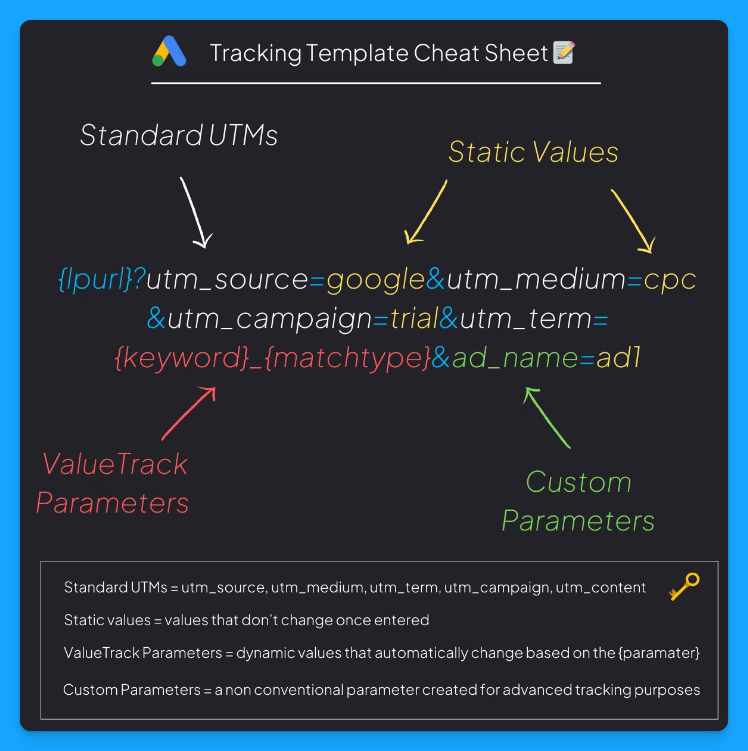
Here’s what each parameter means:
- {lpurl}: This is your landing page URL. So whatever the URL is in your ad, the template will automatically inherit it and then automatically append these different static and dynamic values based on these parameters.
- UTMs: These are your standard UTMs, like UTM source, UTM medium, campaign, term, and content.
Check out our Free UTM Tagger Tool to easily create them in bulk and for more info about each parameter. - Static Values: Static means it’s always the same, it’ll remain consistent. So a static value will always be a text.
So in the image example above, we always want the UTM Source to be google, the UTM Medium to be cpc, and the UTM Campaign to be trial. - Dynamic Values: Dynamic means it changes. The values here usually have squiggly brackets like {keyword} or {matchtype}, which tell Google Ads to populate that field dynamically.
For example, with {keyword}, the UTM Term will automatically insert the keyword that drove the click, giving you granular detail on the search behavior driving each visit. - Custom Parameters: These are parameters you can create that are not part of the UTM parameters, which are your standard ones.
You’ll probably want to use custom UTM parameters if you have some sort of advanced tracking setup.
Anything that is available in the URL, you can then set up with JavaScript the ability to pass the data from those parameters into hidden fields in your form, to then be able to route and track and do all sorts of things in your backend.
In the cheat sheet above, the ad_name parameter will give you details about which ad drove the visit.
So this is a tracking template, and it’s really important as this is going to allow you to get a lot better data and ultimately, better insights from your activities.
How to Install a Tracking Template in Google Ads
You can install a tracking template at the campaign, ad group, or ad level. You could even do it at the account level with the tracking script, but I recommend that you start off at the campaign level.
Here are the steps you need to follow in your Google Ads account 👇
- Open your account, then open the campaigns tab and choose one campaign. Now go into the settings by clicking on this little gear.

- Scroll down to additional settings.

- Go to the Campaign URL options and paste your tracking template in the “Tracking Template” field.

Here you’ll want to follow the format from the cheat sheet I shared at the beginning of this article because that is the syntax of the tracking template.
To be easier, you can copy this tracking template below and just add your static values in the highlighted fields:
{lpurl}?utm_source=entersource&utm_medium=entermedium&utm_campaign=entercampaign&utm_term={keyword}_{matchtype}&ad_name=enteradname
- UTM Source: People usually use Google or AdWords.
- UTM Medium: People usually put CPC or paid search. This 100% depends on you and your business, your company, and how you want to track things.
- UTM Campaign: You can put the name of your campaign. The downside is that you have to do this for each campaign.
- UTM Term: This will dynamically push the keyword that drove the click and the match type.
- Ad_Name (custom parameter): This is 100% optional, and most of the clients from our agency don’t really need custom parameters, but I just want you to be aware of it.
Once you’ve mastered basic tracking, custom parameters can add another layer of insights by capturing non-standard data. For instance, if you want to differentiate ad variations, you could set a custom parameter like ad_name=RSA1.
You can also find all the Value Track Parameters Google supports here:
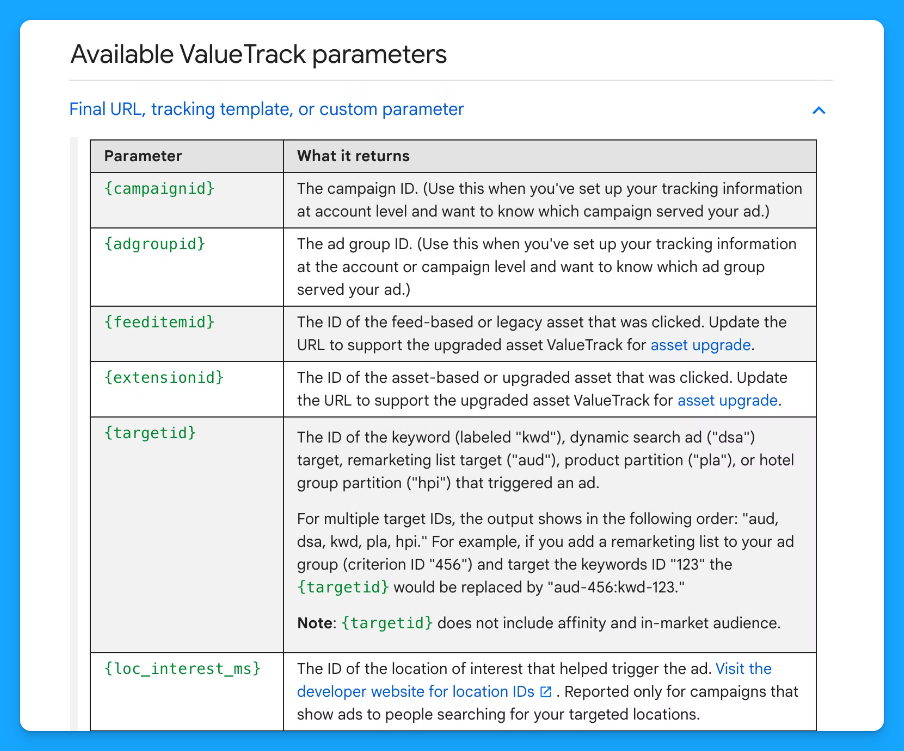
I usually like to set my tracking templates at the campaign level, which suffices. So, in this case, each campaign must have a unique tracking template.
Another cool thing about the tracking template is once you create the tracking template at the campaign level, you no longer have to worry about tagging your ads with UTM parameters at the ad level.
It'll automatically inherit the campaign URL tracking template and tag your links appropriately.
If you're just putting all of the tagged URLs at the ad level, it can be really problematic sometimes and time-consuming to make changes and miss things. This helps streamline things and push those dynamic parameters.
Benefits of Adding Tracking Templates to Your Campaigns
Setting up tracking templates in Google Ads is a powerful way to automate link tagging and capture high-quality data.
The better data we pass through our tracking template, the more insights we can receive.
With standard UTMs, dynamic parameters, and custom fields, you’ll get a clear view of what’s driving performance and find better ways to allocate budget, optimize campaigns, and ultimately boost results. 🚀
Why deny yourself incredible insights such as “which keywords drive the most revenue?..” when you can capture that information at no additional cost?
That’s it about tracking templates! 🎉
Now go build your first one and let the data guide your ad strategies! 🤓
I hope you found this article useful!
From Clicks to Conversions: Master Google Ads for B2B 🔥
If you want to become a Google Ads pro, check out our free B2B Google Ads courses, where you'll learn how to launch, optimize, and scale your campaigns to drive pipeline and revenue.

Here's what you'll learn in each course:
⚙️ B2B Google Ads 101 - How to Launch Dangerously Effective Campaigns for Beginners
- The Googleverse: The Game You're Playing & How To Win
- Measurement: How to Make Sure You're Profitable
- Targeting: How to Show Up For the Right Searcher
- Planning: Putting It All Together
🎯 Google Ads 102 - How to Clicks Into Profit
- Visibility: How To Find the Hole Sucking Profits
- Workflows: How to Optimize On a Daily, Weekly, Monthly & Quarterly Basis
- Experimentation: How to Test & Automate Profitability
- Troubleshooting: How To Solve Inevitable Problems
🚀 Google Ads 103 - How to Scale Google Ads For Advanced Advertisers
- Methodology: How to Vertically Scale Google Ads From A-Z
- Campaigns: Scaling Horizontally Through Campaign Themes
- Channels: Scaling Outside of Paid Search
Click Here to Join 1,000+ B2B Marketers Today and start leveling up your advertising skill set.
Takes < 90 seconds to sign up (seriously we timed it 😂)
People Also Ask
What is a tracking template in Google Ads?
A tracking template is a URL parameter setup in Google Ads that appends tracking information to your landing page URLs. This allows you to monitor specific details about ad clicks, such as the campaign, ad group, keyword, and device involved. 
Why should I use tracking templates in my campaigns?
Implementing tracking templates automates link tagging, ensuring consistent and accurate data collection across your campaigns. This leads to better insights into performance metrics, enabling more informed optimization decisions. 
How do I set up a tracking template in Google Ads?
To set up a tracking template:
- Log in to your Google Ads account.
- Navigate to the desired account, campaign, ad group, or ad level.
- Click on “Settings” and then “Additional settings.”
- Under “Tracking,” enter your tracking template URL, incorporating the necessary ValueTrack parameters.
- Save your changes.
This setup enables dynamic tracking of various metrics. 
What are ValueTrack parameters, and how do they work in tracking templates?
ValueTrack parameters are dynamic URL components that capture specific information about each ad click, such as the device used ({device}), the keyword that triggered the ad ({keyword}), and the campaign ID ({campaignid}). When a user clicks your ad, these placeholders are replaced with actual data, allowing for detailed performance analysis. 
How can I test if my tracking template is working correctly?
After setting up your tracking template, use the “Test” button in the “Tracking” section of your Google Ads account settings. This function combines your final URL with the tracking parameters to ensure it directs to the correct landing page and that all parameters are functioning as intended.
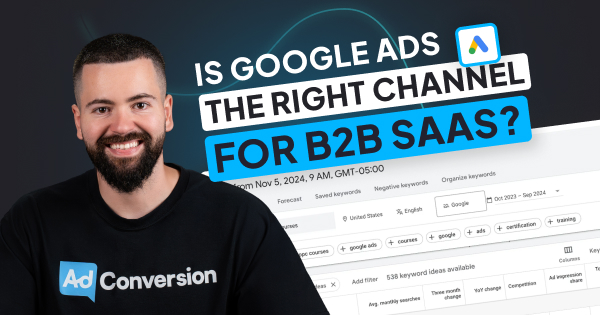
B2B Google Ads: How To Know If Google Is The Right Channel For Your SaaS
Hey there B2B SaaS marketer! Are you getting FOMO around Google Ads?
Every day thousands of SaaS businesses are converting clicks into profitable pipeline on Google Ads, and conversely thousands are burning clicks into wasted ad budgets.
After $10M in Google Ads spend management for incredible SaaS companies like ActiveCampaign, Mixpanel, and others, I’ve developed a criteria for Google Ads success.
I call it the Google Ads Sweet Spot. If you want Google to be a significant driver in your pipeline generation you need to make sure your SaaS company checks these 3 criteria.
After reviewing, it’ll be clear if Google is right for you, let’s dive into it 👇
TABLE OF CONTENTS:
Proven Concept
The first criteria in the Google Ads Sweet Spot is a Proven Concept.
You see, in order to succeed with Google Ads your product has to be built on a time-tested and proven concept.
Imagine running Google ads for a generative AI product before the invention of ChatGPT.
Because AI products still hadn’t gained popularity, you probably would have struggled to generate sufficient searches and clicks on your ads.
If you create an innovative product in a new category that no one understands, you likely won’t see a great return on effort from Google.
In this case, it’d make more sense to focus on educating the market about the problem you solve via demand gen channels such as paid and organic social.
Existing Demand
The second criteria of the Google Ads Sweet Spot is Existing Demand.
This is directly connected to the first criteria: you won’t generate pipeline or revenue if people aren’t actively looking for your solution.
If you only have, for example, 100 people searching for your product every month, it’s going to be impossible to generate significant results from Google.
For example, assuming the industry average conversion rate of 3%, and 5% clickthrough rate (CTR) you’re looking at 5 clicks from the 100 impressions, and you need a minimum of 33 clicks to generate a single lead. At 100 impressions/month it will take you six and a half months to generate ONE lead 🤯– extreme example but I hope you get the point.
You need enough search volume, so you have enough clicks, and ultimately conversions.
To verify that you have sufficient search volume, you can use the Google Ads keyword planner.
Let’s say you want to bid on the term Google Ads courses within the United States. You can see that there are approximately 2,900 searches every month for this specific term, which validates that there’s sufficient search volume to have a chance at success.
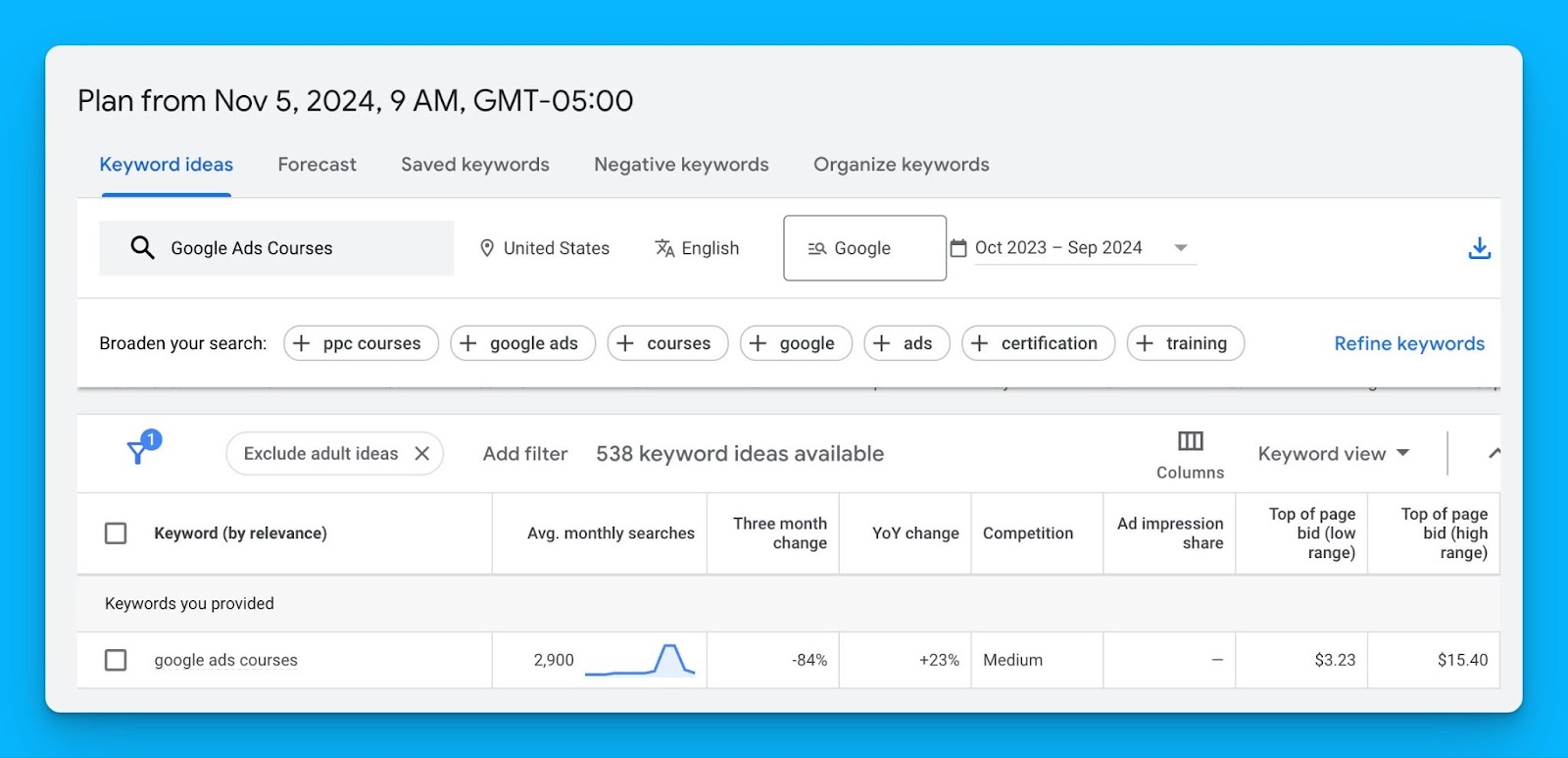
Keep in mind monthly searches in the keyword planner are just an average and always changing – use them to inform your estimates but take them with a grain of salt.
Sufficient Margin
The third criteria of the Google Ads Sweet Spot is Sufficient Margin.
You SHOULD NOT run Google Ads if you don’t have enough margin, or in other words, a high enough lifetime value (LTV) to offset acquisition costs. Without a high enough LTV, Google will never become a profitable channel for your company.
Here’s an example:
Let’s say you have an LTV of $100 per user, and your average cost per click is $10. In this case, the likelihood of running profitable campaigns is slim – you’d have to convert 10% of your total traffic just to break even 😅 (when the industry average conv rate is 3-5%).
If you’re selling a variety of products and you have a small budget (<$10K/month), I recommend running ads for the products with the highest lifetime value to maximize your chances of profitability.
If your campaigns aren’t profitable right away, that’s okay, as long as you know you’ll recoup your investment 3-6 months down the line.
If you want to see if the math adds up to run Google Ads profitably for your company, check out our free Google Ads Budget calculator.
I hope you found this article helpful!
Google Ads definitely is not for everyone but if your SaaS meets these three criteria your chances of success are far greater than not based on my experience.
If you have any questions, feel free to connect with me on LinkedIn.
From Clicks to Conversions: Master Google Ads for B2B 🔥
If you want to become a Google Ads pro, check out our free B2B Google Ads courses, where you'll learn how to launch, optimize, and scale your campaigns to drive pipeline and revenue.

Here's what you'll learn in each course:
⚙️ B2B Google Ads 101 - How to Launch Dangerously Effective Campaigns for Beginners
- The Googleverse: The Game You're Playing & How To Win
- Measurement: How to Make Sure You're Profitable
- Targeting: How to Show Up For the Right Searcher
- Planning: Putting It All Together
🎯 Google Ads 102 - How to Clicks Into Profit
- Visibility: How To Find the Hole Sucking Profits
- Workflows: How to Optimize On a Daily, Weekly, Monthly & Quarterly Basis
- Experimentation: How to Test & Automate Profitability
- Troubleshooting: How To Solve Inevitable Problems
🚀 Google Ads 103 - How to Scale Google Ads For Advanced Advertisers
- Methodology: How to Vertically Scale Google Ads From A-Z
- Campaigns: Scaling Horizontally Through Campaign Themes
- Channels: Scaling Outside of Paid Search
Click Here to Join 1,000+ B2B Marketers Today and start leveling up your advertising skill set.
Takes < 90 seconds to sign up (seriously we timed it 😂)
People Also Ask
What are some advanced targeting techniques for B2B SaaS Google Ads campaigns?
Utilize features like custom intent audiences to target users actively searching for solutions similar to your SaaS product. Combine these with demographic and location filters for precise audience targeting.
How can I effectively allocate my budget across different Google Ads campaign types for B2B SaaS?
Consider allocating your budget to a mix of search campaigns for high-intent keywords, display campaigns for brand awareness, and remarketing campaigns to re-engage potential leads.
How do I choose the right bidding strategy for my B2B SaaS Google Ads?
Select bidding strategies based on your campaign goals. Use target CPA (cost per acquisition) for lead generation or maximize clicks to drive traffic. Test different strategies to determine what works best for your objectives.
What are the common mistakes to avoid in B2B SaaS Google Ads campaigns?
Avoid broad targeting that wastes budget, neglecting negative keywords, and under-optimizing ad creatives. Regularly review and refine your campaigns based on performance metrics.
How can I use ad extensions effectively in B2B SaaS Google Ads?
Include ad extensions like callouts, sitelinks, and structured snippets to provide additional information, improve click-through rates, and enhance ad visibility. Highlight key features, testimonials, or unique offerings.

10 Tips to Create B2B Ads that Convert
If you want your ads to drive conversions, you need the right messaging, positioning, design, tone, format, offer, etc.
This is especially true in B2B, where pushing prospects from initial awareness to conversion is extremely challenging.
Below are my top 10 tips to maximize your chances of success, based on my own experience working with dozens of B2B clients.
TABLE OF CONTENTS:
- Tip #1: Figure out what you want to say
- Tip #2: Don't use big words or acronyms
- Tip #3: Make it quick
- Tip #4: Use visuals that make your ad stand out
- Tip #5: Create ads that don't look like ads
- Tip #6: Steal from the greats
- Tip #7: Use powerful hooks
- Tip #8: Take up as much space as possible
- Tip #9: Speak like a human
- Tip #10: Stay in tune with what your customer wants
Tip #1: Figure out what you want to say
This might sound obvious, but before creating any ad, you should get extremely clear on the problem your company solves.
All of your messaging should come back to this problem.
If you’re running case study ads, the case studies should be related to this problem.
If you’re promoting a GIF of your product, the animation should help tell the story of how you solve that problem.
As Eugene Schwartz said: The objective of advertising is to highlight a problem and demonstrate how you can solve it.
Here’s a template I like using with my clients to clearly articulate the problems they solve.
Tip #2: Don’t use big words or acronyms
The more simple you keep your ads, the better they’ll perform.
There’s no need to drop in words like CAC, ROI, or ARPU into your copy. Acronyms are poo.
Even if you’re talking about complex topics, aim to keep your explanation simple.
Also, keep in mind, it’s impossible to explain everything about your company in a single ad.
To fully understand what you do, a prospect might need to see 20, 30, or 40 different ads, highlighting what you do in different ways.
Think of the ads in your cold layer as an icebreaker.
The idea is to communicate the basics of what you do in a simple and interesting way – not to tell your entire story.

Here’s an ad we made at Revenu for a client, to do exactly that.
Tip #3: Make it quick
Prospects should know exactly what they’re signing up for in 3 steps or less.
We followed that formula for this ad we made for another client.

With very few words, you can easily understand the benefits of the product.
And if you’re thinking: There’s no way I could explain my offer in 3 steps or less… you need to simplify your process.
When you truly understand your product story, it’s easy to simplify it. That’s where the first tip comes in.
Tip #4: Use visuals that make your ad stand out
A picture is worth a thousand words.
Ads that are filled with words don’t grab a users attention.
Think about what you’re trying to say, and how you can visualise it.
You can see how we did this for Scytale below.
It’s a fairly typical advert, but the way it’s broken out visually makes it much easier to digest.

Pro tip: If you’re only using static image ads, try GIFs. Making something move makes people click it more… simples.
Tip #5: Create ads that don’t look like ads
Want to triple your CTR? Make an advert that doesn’t look like an advert.
Once you get a ton of clicks, you can then retarget them with more product-focused messaging, but they’ve now been introduced to your brand.
To create these types of ads, think of the things that you do on a daily basis. For example, listening to Spotify, watching Netflix, playing chess or other online games, etc. How can you incorporate these everyday concepts into your ads, so that they feel natural and less promotional?
Also, think of the memes that make you laugh while you’re scrolling through different social platforms. Can you create versions of these that are related to the problem your company solves?
Here are a few examples we made for inspiration:



P.S. If you want more examples, check out my Sexy Ads Library, which contains over 300 of my favorite ads.
Tip #6: Steal from the greats
As Pablo Picasso once said, “Good artists copy, great artists steal.”
Lately I’ve been diving into B2C ads to find inspiration for B2B, from companies like Porsche, Land Rover, McDonald’s, etc.
It’s extremely hard to create amazing ads if you’re starting with a blank canvas.
Here are a few great examples:


P.S. I’ll be dropping a new library on my LinkedIn soon with tons of B2C examples, drop me a follow to be the first to see it.
Tip #7: Use powerful hooks
To perform well, your ads need to have powerful hooks.
In other words, you need to give your prospects a very specific reason to take action.
Are you offering an incentive to take a meeting, such as a gift card, free lunch, or free coffee?
Are you sharing a company resource, such as ad credits, a price promotion, or a software add-on?
Are you providing knowledge, in the form of a consultation, an audit, a workshop, etc.?
If you don’t give your prospects an obvious reason to take action, they probably won’t.
P.S. The hooks with the highest conversion rates are typically ones related to your unique company knowledge and resources. Check out a great example from Google below…

And this great visual from Cognism, making a joke about gift card ads.

P.S. Don’t get discouraged if your offer isn’t working the first time around – most companies have to experiment with multiple approaches before they find one that works. And when you do, it’s your main driver of new business for the next 5 years.
Tip #8: Take up as much space as possible
Ads that take up more space on the screen are more likely to stop the scroll, and typically perform better.
On LinkedIn Ads, square images (1200X1200) usually perform much better than rectangular images (1200X628).
Test vertical images (628X1200) that only appear on mobile too.
This ad we made got a CTR in the 2%+ range on LinkedIn, with a CPC in the $3-6 range.

This tip also applies to Google Ads. Make sure you’re using ad extensions to take up more space on the SERP and increase the chances of getting a click.
P.S. If you’re curious about the ad specs you can use across different platforms, check out this comprehensive guide.
Tip #9: Speak like a human
When you’re writing ads for social, make sure you don’t sound like a company.
Be human – friendly, silly, colloquial, personable.
You’re literally on a social media platform… be sociable.
Influencers have all the power these days, because people want to hear from real individuals with a real personality.
So if you want people to listen to you, you need to sound like a human.
These ads we made follow that exact tone, and it’s much nicer to read.


P.S. Some companies have a more professional and corporate tone of voice, but that doesn’t mean you can’t be clear and straight to the point. There are ways of sounding human, without being cheeky.
Tip #10: Stay in tune with what your customer wants
Even if you follow tips 1-9, you’ll still fail if your story is crap.
The world is constantly changing. Over time, the problem you solve may stop being a problem. Or another company may solve it for a fraction of the cost.
When these changes happen, you need to update your product and story in order to stay relevant.
To verify that the problems you solve are important, talk to your customers and interview companies in your ICP that aren’t working with you.
- How much of a problem is XYZ to you?
- Are you currently solving XYZ problem?
- How are you solving it?
- Be honest, would you use our product to solve it?
- If not, why?
- Do you use another company to solve this problem instead?
- How much do you pay them?
Asking these questions will help you verify that your product and story make sense.
Pro tip: In addition to qualitative feedback from customer interviews, you can ask your G2 rep for an export of all your reviews and upload it into ChatGPT. Then, you can ask ChatGPT to identify the top pain points and benefits that are mentioned, which will help you further understand the problems your company solves.
Hope you found this article helpful!
Feel free to reach out on LinkedIn with any questions.
Resources for mastering B2B advertising
If you’re serious about mastering B2B advertising then you definitely need to join 1,000+ B2B marketers leveling up their paid advertising skill sets in AdConversion.
Here’s 4 reasons why you should consider joining. Every one of our on-demand courses are:
✅ 100% free access.
✅ Taught by vetted industry experts.
✅ Have workbooks, resources, and templates.
✅ Less than 10 minutes per lesson.
We believe every marketer should know how to scale paid ads so they can:
- Scale their ideas
- Level up their careers
- Make a positive impact
Click Here to Join 1,000+ B2B Marketers Today and start leveling up your advertising skill set.
Takes < 90 seconds to sign up (seriously we timed it 😂)
People Also Ask
What are the key elements to consider when creating B2B ads that drive conversions?
Effective B2B ads require clear messaging that addresses the specific problem your company solves, simple language free of jargon, concise content, attention-grabbing visuals, and a human tone that resonates with your target audience. 
How can I ensure my B2B ad stands out visually to capture attention?
Utilize compelling visuals that align with your message and consider incorporating movement, such as GIFs, to draw attention. Ads that don’t resemble traditional advertisements can also increase engagement by appearing more organic in users’ feeds. 
Why is it important to avoid complex language and acronyms in B2B ads?
Using simple language ensures your message is easily understood, broadening your ad’s appeal and effectiveness. Avoiding industry jargon and acronyms prevents confusion and keeps the focus on the value your solution provides. 
How can I create a compelling hook in my B2B ad to encourage action?
Offer clear incentives or unique value propositions that address your audience’s needs or pain points. This could include special offers, exclusive insights, or highlighting unique features that set your solution apart. 
What role does understanding the customer’s problem play in crafting effective B2B ads?
A deep understanding of the customer’s problem allows you to tailor your messaging to demonstrate how your product or service provides a solution, making your ad more relevant and persuasive.

10 Tips to Align Your Content and Paid Media Strategy
Over the past decade, I’ve led content marketing for multiple B2B SaaS companies, and I’ve noticed a common problem:
Content marketers and performance marketers rarely communicate.
This leads to inconsistent targeting, positioning, and messaging, which ultimately leads to lackluster results.
If you want to hit your revenue targets, your content and paid media strategies need to be part of the same equation, not completely separate entities.
Below are my top 10 tips on how to get aligned with your content team.
TABLE OF CONTENTS:
- Tip #1: Don't Create "Ads"
- Tip #2: Repurpose the content you already have
- Tip #3: Use paid media to guarantee distribution
- Tip #4: Have a clear POV
- Tip #5: Make sure you have consistent messaging
- Tip #6: Don't be afraid to be different
- Tip #7: Leverage user-generated content
- Tip #8: Share the right content for the right stage of the customer journey
- Tip #9: Leverage retargeting
- Tip #10: Be willing to adapt and change as you learn
Tip #1: Don’t Create “Ads”
It’s easy to fall into the trap of researching the ads of your competitors and trying to mimic them. Or creating ads with a preconceived idea of what an ad should look like.
But at this point, we’re all hardwired to scroll past the ads in our feed.
Ironically, in order to stop the scroll, your ads have to blend in with other organic content.
If you create great organic posts that are educational, memorable, and enjoyable, they’ll probably also perform well as ads.
Tip #2: Repurpose the content you already have
Are there carousels, newsletters, or podcasts that have performed well for you in the past?
Revisit this content.
Why do you think it performed well? How can you remix it to extend its longevity?
One caveat here: Just because something has performed well in the past doesn’t mean you should run it as an ad.
For ads, I recommend repurposing the content that has performed well AND:
- Has a clear POV
- Is consistent with your other content themes
- Is related in some capacity to what your company does
Otherwise, you may end up confusing your audience.
Tip #3: Use paid media to guarantee distribution
We need to stop seeing paid media as something separate from content.
Great ads are just incredible content with guaranteed distribution to the right people.
If you’re running ads, make sure you’re constantly talking to the content marketers on your team to understand what’s working.
What pieces of content are getting the most engagement, communicating important messages, or telling valuable stories?
Is there an opportunity to put money behind this content?
It’s hard to create winning ads if your team is working in silos.
Tip #4: Have a clear POV
There are so many ads that feel and sound the same.
Even if they're creative, they don’t feel different because they lack a unique POV.
What’s the core idea that you want to communicate to your audience?
How is your perspective or approach different from that of every other company?
If you’re not communicating this, your audience will forget about you almost immediately.
P.S. Don’t be afraid to have a slightly more controversial POV, as long as it makes sense for your brand. Sometimes, taking that risk is necessary in order to be memorable.
Tip #5: Make sure you have consistent messaging
When it comes to messaging, you shouldn’t be throwing spaghetti at the wall.
Instead, you should be repeating yourself constantly. Sharing your core message in different ways so that people can easily understand what you do.
A lot of marketers are afraid of repeating themselves. But in order for you to be known, liked, and trusted at scale, repetition is essential.
If you think of the brands that you trust, you’ve probably heard their core message millions of times, maybe without even realizing.
Tip #6: Don’t be afraid to be different
In order to succeed, you need to be interesting, and do things that other companies aren’t doing.
There’s so much noise these days.
If you’re running ads, everybody else is.
If you’re creating content, everybody else is.
So, ask yourself, what can you do that’s different?
Why should prospects pay attention to you instead of other companies in your space?
Look at what everybody else is doing. Is there an opportunity for you to do the opposite?
You have to be willing to take calculated risks in order to stand out.
Tip #7: Leverage user-generated content
User-generated content is a powerful and underutilized tactic to build trust with your prospects.
Do you have video testimonials or celebratory screenshots from your clients?
This is great for both organic content and ads.
Having testimonials from real people comes across as more authentic than the standard G2 reviews that everyone else uses.
P.S. I know it can be nerve-wracking to ask for testimonials, but I’ve found that clients are usually happy to help – all you have to do is send a simple email or LinkedIn DM. And if you work at a larger org, you can talk to your customer advisory board, or ask your sales or CS team to make the ask.
Tip #8: Share the right content for the right stage of the customer journey
A lot of companies make the mistake of promoting the same content to every single prospect, without considering what stage of the buyer’s journey they’re in.
If someone’s already heard of your brand and interacted with your company multiple times, they’ll likely want to learn more about your product features, and may even be interested in a demo.
But if someone has never heard of you before, they probably won’t be interested.
If you’re targeting a completely cold audience, your priority should be to educate them about the problems you solve, not to generate conversions right away.
The reality is – especially in B2B – the demos you get now are a product of the work you did 6 months ago.
P.S. There are no shortcuts when it comes to building trust. Sure, you can use an intent provider and target people who are technically in-market, but typically, even those people need to see more content before requesting a demo.
Tip #9: Leverage retargeting
By retargeting, I don’t mean offering a demo to every single person that has interacted with your brand.
A lot of people in your retargeting audiences won’t be ready for a demo yet.
But they might be interested in attending your event or joining your webinar. Or they might want to learn more about your product, hear from your thought leaders, see testimonials from similar companies, etc.
What interactions have the people in your retargeting audience taken?
Based on these actions, what type of content do you think they’d be most interested in seeing?
It’s important to do this exercise to create a positive experience for your prospects.
If all you do is offer demos they’ll get tired of you pretty quickly.
Pro tip: Think of your retargeting audience as a newsletter that prospects didn’t opt into. Just like a newsletter, you need a mix of different content to grow the trust of your audience over time.
Tip #10: Be willing to adapt and change as you learn
In both content and advertising, it’s important to create a strategy that’s firm but flexible.
It’s great to have a general plan in place, but it shouldn’t be an immovable object.
You have to be willing to adapt based on your audience’s response.
Are there certain messages that are resonating more?
Are there certain formats that are performing better?
Are there certain audience segments that are expressing more interest in your product?
Based on this feedback, you may have to modify your approach.
Hope you found this article helpful!
Feel free to reach out on LinkedIn with any questions about content strategy or distribution.
Resources for mastering B2B advertising
If you’re serious about mastering B2B advertising then you definitely need to join 1,000+ B2B marketers leveling up their paid advertising skill sets in AdConversion.
Here’s 4 reasons why you should consider joining. Every one of our on-demand courses are:
✅ 100% free access.
✅ Taught by vetted industry experts.
✅ Have workbooks, resources, and templates.
✅ Less than 10 minutes per lesson.
We believe every marketer should know how to scale paid ads so they can:
- Scale their ideas
- Level up their careers
- Make a positive impact
Click Here to Join 1,000+ B2B Marketers Today and start leveling up your advertising skill set.
Takes < 90 seconds to sign up (seriously we timed it 😂)
People Also Ask
Why is it important to align content marketing with paid media efforts?
Aligning content marketing with paid media ensures consistent messaging, maximizes reach, and enhances engagement by delivering valuable content to the right audience at the right time. This synergy leads to more effective campaigns and better return on investment. 
How can repurposing existing content benefit a paid media strategy?
Repurposing high-performing content, such as carousels, newsletters, or podcasts, extends its longevity and leverages proven engagement. By remixing successful content, you can maintain audience interest and ensure consistency across channels. 
What role does having a clear point of view (POV) play in content and paid media alignment?
A distinct POV differentiates your brand and makes your messaging memorable. Communicating a unique perspective helps your audience understand how your approach stands out from competitors, fostering stronger connections and recall. 
Why is consistent messaging crucial across content and paid media channels?
Consistent messaging reinforces brand identity and ensures that your audience receives a unified narrative, regardless of the platform. Repetition of core messages builds trust and aids in brand recognition, making your campaigns more effective. 
How can leveraging user-generated content enhance a paid media strategy?
Incorporating user-generated content adds authenticity and social proof to your campaigns. It showcases real customer experiences, building trust and encouraging engagement from potential clients who see relatable success stories.
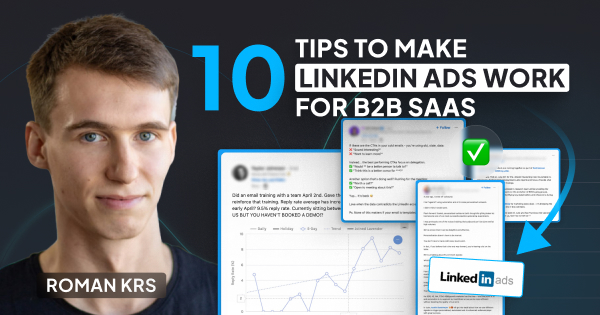
10 Tips to Make LinkedIn Ads Work for B2B SaaS
Over the past few years, I’ve helped dozens of B2B SaaS companies develop their LinkedIn Ads strategy.
Below, I’ll be sharing ten tips that I always give to my own clients, and that will significantly increase your chances of success with LinkedIn Ads 👇
TABLE OF CONTENTS:
- Tip #1: Research Your Customers
- Tip #2: Define Your Targeting
- Tip #3: Distribute Your Content
- Tip #4: Repurpose Your Content
- Tip #5: Test Lead Gen alongside ungated content
- Tip #6: Capture Demand With Retargeting
- Tip #7: Use Text and Spotlight Ads
- Tip #8: Leverage your SMEs for thought leader ads
- Tip #9: Set up the right tracking combination
- Tip #10: Make a commitment of at least 6 months
Tip #1: Research Your Customers
As a marketer, it can be challenging to fully understand your customers, especially since you’re not in direct contact with them.
In order to gain a better understanding, it’s a great idea to watch 3-5 sales calls, recommended to you by the Head of Sales.
Analyze how your sales team is presenting the product to make sure your messaging is aligned.
In addition to this, you can pull transcripts and summaries from hundreds of calls and have ChatGPT develop a content matrix and empathy map for you, summarizing the top pain points of your prospects.
Here is a templatized example of the outcome. ChatGPT can pull it out in this format based on the call summaries and give you a good foundation of commonalities for different prospects.
Once you’ve identified the top pain points and topics with the help of ChatGPT, send them over to a few people on your sales team to validate them. It can be very subjective but can help you to ensure that you haven’t missed any important nuances.
Tip #2: Define Your Targeting
Next, define your targeting.
What job titles, job functions, industries, and company sizes do you want to target?
Once you’ve drafted your audiences, you can share and refine with your stakeholders.
To start out, you can use a simple targeting combination such as Job titles + Company Sizes + Industries.
If your audience is too small using only job titles, you could substitute for Job Function + Seniority + Skills.
A few additional notes:
1. Make sure to check the audience insights section of LinkedIn Campaign Manager to find exclusions that you could potentially make. (video walkthrough)
2. If you have multiple personas, make sure to separate them into different campaigns so you can tailor your messaging.
3. There is no ideal audience size on LinkedIn Ads – small audiences of 10K can work well and larger audiences of 100K can also work well. Start by targeting your ideal customers, and you can expand over time.
Recommendation: Use a validated company list for better targeting and reporting.
Tip #3: Distribute Your Content
Once you’ve set up your audience, the next step is to distribute content towards them.
I highly recommend optimizing your ads for in-feed consumption – talk about the problems you solve directly in your ad copy.
This way, even if people don’t visit your landing page right away, they’ll still be learning about your company and can be retargeted later down the line with a more bottom of funnel offer.
Videos are a particularly great format for delivering these in-feed messages, and they also allow you to generate large retargeting pools.
When you run these ads, look at your impressions and views to make sure that you’re reaching your ICP. And check your engagement rate and dwell time metrics to ensure that the content is resonating.
Don’t expect demos or trials right away – the goal of these ads is to start generating some initial interest.
Tip #4: Repurpose Your Content
Do you have any great podcast or webinar clips related to your solution?
Has anyone on your team created a product demo walkthrough recently?
Do you have any customer testimonials from recent events?
This type of content can be easily repurposed for ads, and is great for both generating and capturing demand.
Before you start creating new content, look at the content that you already have.
Tip #5: Test Lead Gen alongside ungated content
I know lead gen is an unpopular strategy, but it can be a great approach to run lead gen campaigns alongside ungated content.
If you’re getting leads from incredible people within your ICP, you can show that to your stakeholders as proof that you’re reaching the right audience, and this can help you get approval to run more ungated content.
I don’t recommend lead gen as a standalone tactic, but it can be a solid way to get some initial results and build your retargeting audiences, while also validating the quality of your targeting.
Tip #6: Capture Demand With Retargeting
On LinkedIn, lead gen forms aren’t just for content like ebooks and whitepapers.
They’re also great for capturing demo requests.
The benefit of using lead gen forms is that people don’t have to leave the LinkedIn platform to request a demo, so it helps to simplify the process.
To start, I recommend running these ads to your retargeting audience, since people who have already interacted with your brand are the most likely to convert.
Also, when it comes to these demo campaigns, don’t be discouraged if you don’t see success right away.
In order to succeed, you need to test different types of messaging, different content, and different creatives until you find the right formula.
Another word of advice: Make sure you refresh the creatives in your retargeting audience at least once a month. Retargeting audiences tend to be small and have very high frequencies, so you may see signs of ad fatigue if you don’t refresh your creatives consistently.
Tip #7: Use Text and Spotlight Ads
Text and spotlight ads are an amazing and affordable way to stay top of mind with your retargeting audiences.
They’re very small and usually appear on the right side of the feed, and they get a ton of impressions but very few clicks.
I recommend setting these ads up with the website visits objective, so that you only pay when someone actually clicks.
Also, I recommend setting the lowest bid you can possibly set, along with a bid cap to avoid overpaying for clicks.
Another format to consider are follower ads, which are very similar to spotlight ads, but intended to drive more company page followers. This format is great for your colder audiences, and can help funnel your ICP into your organic audience for a longer term nurture.
You can use this template to draft the ad copy with ad specifications. You can also use dynamic macros in follower ads.
Tip #8: Leverage your SMEs for thought leader ads
If you have a founder or subject matter expert that’s active on LinkedIn, consider running their posts as thought leader ads.
Thought leader ads are great because:
1. They have high CTRs and very low CPCs compared to other formats
2. They allow you to get high-performing organic content in front of your ICP
Customer stories and educational content related to the problem you solve typically perform well as thought leader ads.
I’d avoid overly promotional and generic, AI-generated content – you want to distribute content that’s memorable and valuable to your ICP.
For more thought leader ad ideas, check out 14 Powerful LinkedIn Thought Leader Ad Strategies Worth Testing.
Tip #9: Set up the right tracking combination
There is no perfect tracking combination, but you do have to make sure that you’re collecting enough data to understand what’s happening inside your account.
First of all, you can track online conversions, like form submissions on your website. Then, you can also set up conversion API to have a deeper understanding of which campaigns are turning into pipeline and revenue.
Also, make sure you’re using UTM parameters — it’s much easier now because LinkedIn has dynamic UTM parameters — and pushing them into your CRM for full visibility.
And add “How did you hear about us” into your high-intent forms to capture additional insights about the sources that indirectly influence the prospects.
Just by having these basics in place, you should already have a solid understanding of what’s happening inside your account.
If you want even more insights on which campaigns and ads are influencing pipeline, you could use a tool like Fibbler to look at multi-touch attribution.
Tip #10: Make a commitment of at least 6 months
If you’re going to get started with LinkedIn Ads, make sure you make a commitment of at least 6 months.
Once you have your audience, targeting, messaging, and content ready to go, you need to decide what your game plan will be and how much budget you need.
How much money will you need to generate awareness within your cold layer?
How will your retargeting audiences expand over time?
What metrics will you look at to determine initial success? Maybe reach and engagement as leading indicators, and conversions as a lagging indicator?
Present a clear plan to your stakeholders so that they know what to expect and are on the same page. Also, emphasize that success won’t happen overnight, and that it takes time and patience to start seeing results.
Hope you found this article helpful!
Feel free to reach out on LinkedIn with any ad-related questions.
Master B2B LinkedIn Ads with these 3 Free Courses:
If you want to become a LinkedIn Ads pro, check out our free B2B LinkedIn Ads courses, where you'll learn how to launch, optimize, and scale your campaigns to drive pipeline and revenue.

Here's what you'll learn in each course:
⚙️ B2B LinkedIn Ads 101 - The Ultimate Crash Course for New LinkedIn Advertisers
- Foundations For LinkedIn Ads Success
- Measurement: Tracking & Key Principles
- Targeting: Reaching Your Dream Buyers
- Ads: Mastering The 9 Ad Formats
🎯 B2B LinkedIn Ads 102 - The Blueprint for LinkedIn Ads Optimization
- Monitoring: How To Spot Performance Trends
- Auditing: How To Find The Darlings You Need To Kill
- Reporting: How To Transform Data Into Insights
- Optimization: How To Make Your LinkedIn Ads Profitable
🚀 B2B LinkedIn Ads 103 - Advanced Scaling Strategies From $25M In Ad Spend
- Concepts of Scaling
- Divide and Conquer
- Learnings From $25M+ In LinkedIn Ad Spend
Click Here to Join 1,000+ B2B Marketers Today and start leveling up your advertising skill set.
Takes < 90 seconds to sign up (seriously we timed it 😂)
People Also Ask
What budget allocation strategies should I use for LinkedIn Ads to maximize ROI?
Consider allocating budgets based on campaign objectives, such as lead generation, brand awareness, or engagement. Use test campaigns to identify high-performing audiences and scale your investment in those areas.
How do I create LinkedIn Ads that effectively nurture leads through the sales funnel?
Use a multi-step approach by running awareness campaigns to introduce your brand, followed by engagement ads that highlight pain points, and finally conversion-focused ads with clear CTAs for demos or trials.
What are the best LinkedIn ad formats for driving B2B SaaS conversions?
Explore formats like Lead Gen Forms for collecting information, Carousel Ads for showcasing multiple features, and Sponsored InMail for direct and personalized messaging to high-value prospects.
How can I use LinkedIn retargeting to improve campaign performance?
Set up retargeting audiences based on website visits, video views, or previous ad interactions. Tailor your messaging to re-engage these prospects with personalized offers or content.
What are some common pitfalls to avoid when running LinkedIn Ads for B2B SaaS?
Avoid overly broad targeting, neglecting to optimize ad creatives, underutilizing LinkedIn’s advanced audience features, and failing to test different campaign approaches for continual improvement.

10 B2B SaaS Copywriting Tips for Better Ad Performance
I don’t need to be the one to tell you this, but B2B tech companies have it hard when it comes to getting their advertising to perform.
They’ve got complicated products. And sophisticated audiences (who are all but totally allergic to buzzwords and fluff). And together, they make communicating your company or product’s value super hard.
Having helped countless B2B companies over the past 9 years I’ve learned more than a thing or two about writing copy for these companies.
And today I’m sharing with you my top 10 copywriting tips – tips you can use right away (literally, try them out after you finish reading this) to evaluate your existing ad campaigns and improve their performance, stat.
TABLE OF CONTENTS
- Tip #1: Sell The Click, Not The Product
- Tip #2: Take Something Out Of Your Ad Instead Of Putting More In
- Tip #3: Write First, Edit Later
- Tip #4: Remember How People Interact With Ads
- Tip #5: Use The Slippery Slope
- Tip #6: Don’t Be Afraid to Try Long Copy
- Tip #7: Try to Use Your Voice of Customer As Much As Possible
- Tip #8: Clear Before Clever
- Tip #9: Tie Benefits Back to Something Realistic
- Tip #10: Make Sure Your Copy Passes the “So What” Test
Tip #1: Sell The Click, Not The Product
The first tip is more of a mindset shift: remind yourself that your ad is selling the click, not the product (as a whole).
Prospects don’t see your ad in isolation. They see it in the context of everything else that happens throughout their day, AND in the context of everything else they see on LinkedIn, Google, Facebook or whichever platform your ad is served to them. So unlike an ecom ad, the goal of your ad here is to build excitement and anticipation. You want your prospect to be inspired enough to click on the ad and go where they can learn more about what you have to offer.
This still applies even if you’re providing a free trial, or something else that is free.
Because if you have an average contract value of $50,000-$100,000/year your prospect is NOT going to click on your ad and buy right away.
Instead focus on giving the prospect something – a tip, an idea, an emotional twinge – that will motivate them to click.
This could be through:
- The messaging you use (make sure you’re talking about how you solve business problems, not just “hey our product is really cool”)
- The type of call-to-action (CTA) (making sure it’s not too pushy for people who didn’t know you existed until now)
- The visual in your ad creative (making sure it hits an emotional soft spot)
Remember: You can always go into more depth on the landing page. But that won’t happen if your prospect doesn’t click through in the first place.
Tip #2: Take Something Out Of Your Ad Instead Of Putting More In
Focus on getting one really memorable takeaway across in your ad copy.
Writing copy by committee is never a great strategy and it’s easy to end up with ads that are saying so many different things that the prospect won’t take away any one thing in particular.
Let’s say your product’s main value propositions are: it’s fast, it’s easy to use, and it saves money.
Instead of stuffing all of that information into the same ad, I would write 3 variations:
- Ad Variation 1: Fast
- Ad Variation 2: Easy
- Ad Variation 3: Saves Money
Test each message separately so you can see which performs better AND so the prospect can remember your core value proposition.
Pro tip: you can say the same message 1,000 different times or more by repurposing the way you communicate that message to the market through different creatives, ad types, and copy.
Tip #3: Write First, Edit Later
There are so many times when we sit down to try to write an ad and it’s really hard.
First get all your thoughts, ideas, and concepts out in a document, then let it sit for a couple of hours, and finally go back to it with fresh eyes.
If you just try to write it in one session it’s going to be messy and you’ll spend forever tweaking it.
The idea is that you get to write a really stupid first draft. But you KNOW that it’s going to be bad. So that gives you the chance to get the bad ideas out to make way for the good stuff. Your goal is to come back later to edit and make it better.
I’ve lost count of how many times my first line in the body copy becomes my headline or other parts of my copy shift places with each other because they’re better suited for a different part of the ad. But I’m only able to make these connections with fresh eyes.
Pro tip: you can use ChatGPT for brainstorming but even still you need to let the copy sit. Give yourself time to process it so you can edit it and not just run with it at face value.
Tip #4: Remember How People Interact With Ads
Each element of your ad is a part of the puzzle.
People will stop the scroll because the creative caught them. Then they'll look at the headline. Then they go up and read the body copy. And finally they go back down to the headline before clicking.
The prospect's eyes are going all over the place which means you can’t afford to have copy that’s disjointed.
The headline leads into the body copy and should support the creative. And the body copy should support the headline. All the elements have to work together.
As Eugene Schwartz once said “copy is not written, it’s assembled".
Treat each element of your ad with equal importance and make sure it makes sense when you look at it from the eyes of your prospect.
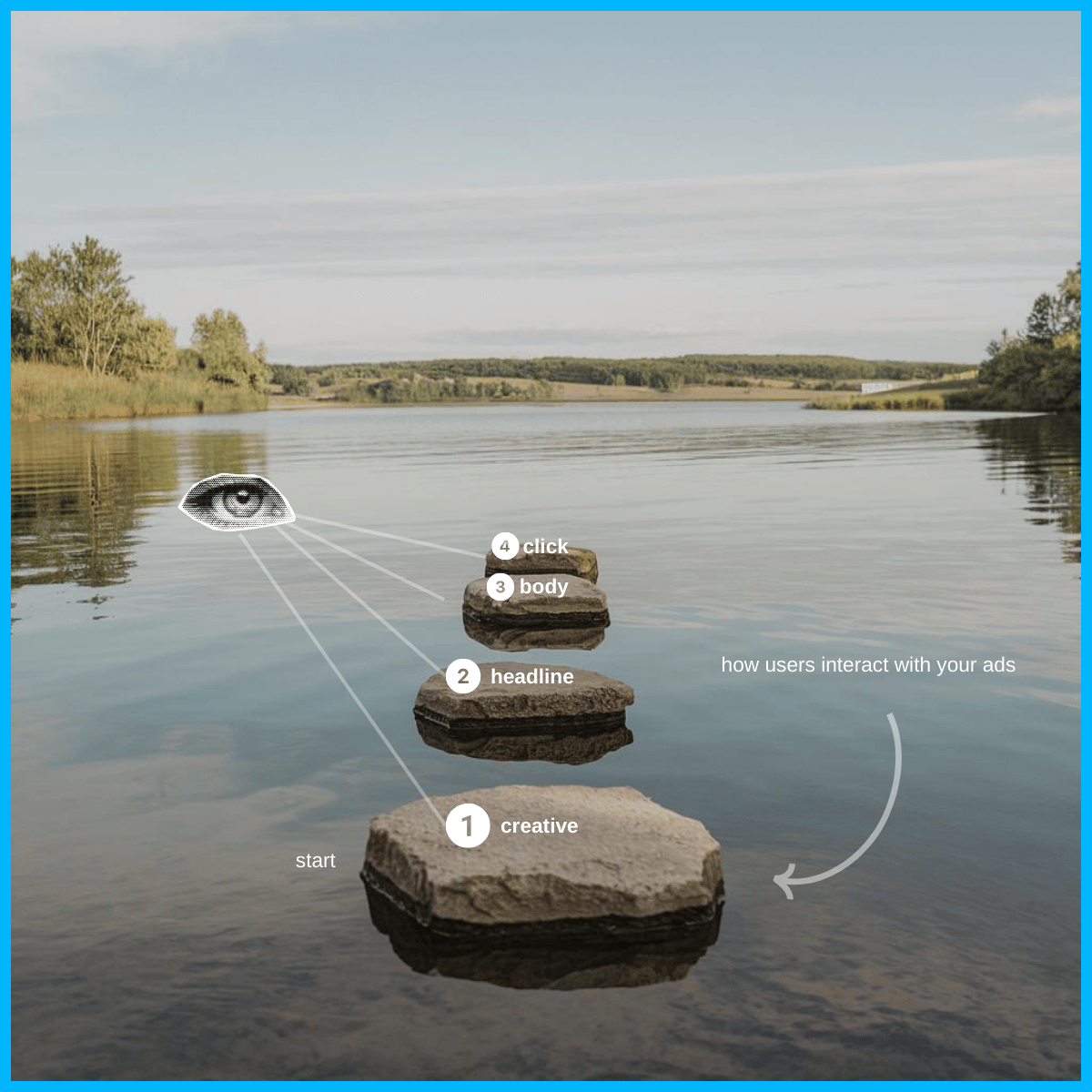
Pro tip: you can’t create ads in isolation, you need your designer and copywriter working together to ensure each variable in your ad works together (headline, body copy, creative).
Tip #5: Use The Slippery Slope
Your first line of copy should get the reader excited to read the second line. The second line should motivate the reader to read the third line. And so on. Direct marketer Joseph Sugarman calls this the “slippery slope”. It makes sure your ad is interesting to read and that the ideas inside it are easy to digest.
The best way to check and test your messaging for clarity and word choice is to read it out loud.
If you’re in the middle of a sentence and you paused for breath, you should place a period. That will help your sentences flow more naturally one into the other.
Tip #6: Don’t Be Afraid to Try Long Copy
I have a bone to pick with people who say “nobody reads online!” Because of course they don’t – if they don’t have something interesting to read.
People binge on Netflix series, video games, novel trilogies, and more for hours in one go.
When you have people's attention you can keep sharing with them new details. But you have to earn their attention, first. (Which won’t happen with clickbait.)
What can you give them in your ad that will make them feel they got value from this interaction, no matter how fleeting it was?
- Did they learn something new?
- Did you make them feel something?
- Did you make them think for a second?
If you can do at least one of those three things you’ll earn their attention.
It’s hard to do this in 150 characters which is why long form copy is so powerful.
Don’t be afraid to push up until that 600 character limit if needed.
Long copy will also lead to a greater dwell time and provide so much more context and opportunity for you to build motivation so they have a reason to click through.
The takeaway here is that people will read your long form ads if it’s interesting to them. But they won’t read even short copy if it’s terrible.
Side note: When writing ad copy I create 2-3 variations for the headline and the body, usually testing out different lengths (short vs long).
Here’s my simple but effective copywriting template I use in Google Docs:
LinkedIn ads template | Eden Bidani
Pro tip: it’s easy for ads to get stuck in the same creative loops, don’t forget to brainstorm new creative concepts to test.
Tip #7: Try to Use Your Voice of Customer As Much As Possible
If no one in the product marketing or CS team is interviewing your customers do this ASAP.
Get on a call with them and ask them questions such as:
- How do you use the product?
- What is the impact of your product?
The goal here isn’t to get testimonials, it’s to understand how your customers talk.
You’ll walk away knowing the benefits that matter to them and challenges.
I’d also recommend talking with sales and asking them what are the top customer objections that prospects say and exactly how they describe it.
Using the same words and language your customers use allows you to communicate in their voice.
These insights are so powerful that not even ChatGPT can brainstorm this for you.
For example I used to work with a company that created $700 work bags and I interviewed a customer that mentioned she used to carry around a “mom bag”.
What did she mean by that? “A shapeless, old ugly bag.”
That word “mom bag” is so unique and reflective of the voice of our customers that using that in our landing page copy instantly resonated and resulted in tremendous lifts in conversion rates.
Five customer interviews can be all it takes.
Tip #8: Clear Before Clever
Jay Abraham once said sometimes the easiest way to sell a horse is to say “horse for sale”.
You have a fleeting moment with your prospects engaging with your ads.
So even if you have to use specific, complicated terms (for your sophisticated audience) you need to focus on making your copy as clear as possible.
For example, try to simplify your language as much as possible. Yes, this might result in you using less voice of customer, or using a different brand tone of voice, and other elements of your messaging. But clear will always convert best.
Consider the words you are using and find synonyms that imply the same meaning with less cognitive load.
John Carlton refers to these as “power words” for example:
Sometimes you want to say fast but you should be saying swift.
Swift implies a very different connotation than fast.
It’s a whole different level of sophistication above “fast” but it’s still a simple word.
How would you say this same thing to a friend? Is a great frame to have.
Remember to avoid complicated and overdone words like omnichannel 🤮
Tip #9: Tie Benefits Back to Something Realistic
Everyone LOVES to talk about benefits – think: “Grow your business!”, “Transform your workplace!", “Win more customers!”, or “Optimize your life…!” 🙄
It’s not that it’s not true. They are. But they’re just so high-level and vague people struggle to grasp them. You need to tie them back to something tangible – something realistic that your prospects identify with. Otherwise, they just come off as fluff.
So make sure the claims you make in your ads are specific. And even better, back up your claims by connecting them to a feature or capability of your product.
Take the step to connect your benefits back to something realistic.
Pro tip: even better than talking about how your benefits connect to something realistic, SHOW PROSPECTS HOW this happens with supporting images or videos.
Tip #10: Make Sure Your Copy Passes the “So What” Test
You should be totally skeptical about your copy (just like prospects will be).
People aren’t stupid — even if they fall victim to clickbait they will bounce from your landing pages.
Every time you look at your copy ask yourself so what? And pick it apart to see where it’s fluff.
Sit back and look through to see where you’re missing proof points or what can be removed.
You’ll be able to find all those tiny things that will throw people off reading your ads.
At the end of the day your audience will look at the total sum of your ad (headline, body copy, creative) and if there are elements out of place such as:
- Run on sentences
- Improper formatting
- Typos and obvious errors
All of these details will affect whether the audience feels they can trust you with their click.
So what allows you a third person frame to find what looks off, and what can be stronger.
Pro tip: search for free ad mockup software on Google to find tools you can use to see what your copy will look like to your audience within the platform you’re advertising.
Hope you found this article helpful! 👏
Connect with me on LinkedIn and let’s keep the conversation going.
And if you’re in need of copywriting assistance check us out at CAPE Agency.
Resources for mastering B2B advertising
If you’re serious about mastering B2B advertising then you definitely need to join 1,000+ B2B marketers leveling up their paid advertising skill sets in AdConversion.
Here’s 4 reasons why you should consider joining. Every one of our on-demand courses are:
✅ 100% free access.
✅ Taught by vetted industry experts.
✅ Have workbooks, resources, and templates.
✅ Less than 10 minutes per lesson.
We believe every marketer should know how to scale paid ads so they can:
- Scale their ideas
- Level up their careers
- Make a positive impact
Click Here to Join 1,000+ B2B Marketers Today and start levelling up your advertising skill set.
Takes < 90 seconds to sign up (seriously we timed it 😂)
People Also Ask
How can I effectively measure the success of my B2B SaaS copywriting efforts?
Utilize key performance indicators (KPIs) such as conversion rates, click-through rates (CTR), and engagement metrics to assess the effectiveness of your copy. A/B testing different versions of your copy can also provide insights into what resonates best with your audience.
What are the best practices for aligning copywriting with the buyer’s journey in B2B SaaS marketing?
Tailor your copy to address the specific needs and pain points of your audience at each stage of the buyer’s journey—awareness, consideration, and decision. This ensures that your messaging is relevant and persuasive throughout the customer lifecycle.
How can I incorporate SEO strategies into my B2B SaaS copywriting to improve search visibility?
Conduct thorough keyword research to identify terms your target audience is searching for. Integrate these keywords naturally into your copy, including headings, meta descriptions, and body text, to enhance search engine optimization (SEO) without compromising readability.
What role does storytelling play in B2B SaaS copywriting, and how can I implement it effectively?
Storytelling helps humanize your brand and makes complex concepts more relatable. Incorporate customer success stories, use cases, or hypothetical scenarios that demonstrate the value and impact of your solution in real-world applications.
How can I ensure my B2B SaaS copywriting maintains a consistent brand voice across different platforms and materials?
Develop a comprehensive style guide that outlines your brand’s tone, language preferences, and messaging guidelines. Ensure all team members and stakeholders adhere to this guide to maintain consistency across all marketing channels and content.

How to Create LinkedIn Audiences that Convert
Sometimes, LinkedIn Ads fail due to poor creatives, messaging, or offers.
But many times — and in my experience, most of the time — the problem is actually the audience.
If you aren’t reaching your ICP, it’s almost impossible to drive conversions.
After running LinkedIn Ads for many hypergrowth startups, I’ve developed a methodology to ensure that I’m getting in front of the right people and minimizing wasted spend for my clients.
I’ll be breaking down my entire process below 👇
TABLE OF CONTENTS
- Step 1: Define your ICP
- Step 2: Brainstorm your targeting
- Step 3: Draft your audiences in LinkedIn Campaign Manager
- Step 4: Refine your audiences
- Step 5: Adjust based on insights
- Conclusion
Step 1: Define your ICP
If you’re taking over a new account and don’t have any audiences yet, here’s where I recommend starting:
1. Explore the website to get some initial ideas on the target job functions and industries of your personas.
2. Talk to your clients. Are there certain industries, company sizes, job titles, or job functions that have historically driven more revenue?
3. Listen to demo calls to gain a deeper understanding of a) what pain points their product solves and b) who resonates most with these pain points
Step 2: Brainstorm your targeting
Once you have a strong understanding of your ICP, it’s time to look at the targeting options available within LinkedIn Ads.
To do this, you can make a copy of this LinkedIn persona database sheet, which contains all the job titles and industries available within LinkedIn Campaign Manager.
If you want to target IT professionals, for example, you can add the filter Text contains “Information Technology”, and you’ll find all 389 IT-related job titles that are available.
Based on these results, you can determine exactly what job titles (or job function + seniority) you want to target.
Also, by looking through the industries tab, you can define the industries you want to reach in your campaigns.
Pro Tip: LinkedIn’s industry categorization can be a bit confusing. If you aren’t sure what industries you should be targeting, look up your best-fit customers on LinkedIn. What industries are they in? These are likely the ones you should be targeting.

Step 3: Draft your audiences in LinkedIn Campaign Manager
Once you have a solid understanding of your ICP and the job titles and industries you want to go after, you’re ready to go into LinkedIn Campaign Manager and create your audiences.
Here’s how you do it:
1. Navigate to the audiences tab, on the left hand side of LinkedIn Campaign Manager.

2. Go to “Saved”, and then click on “Create Audience”

3. Click on “Edit” and input your targeting criteria.

4. Apply your targeting criteria (in the bottom right corner of your screen)

5. Save your audience so you can come back to it later. You can do this in the top right corner of your screen.

Here are the top 3 audiences that I’ve seen the most success with for capturing demand (feel free to steal or adapt to your company’s needs)
1. Remarketing
90-day Website Visits + 90-day Video Views + 90-day Single Image Ad Interactions + 90-day Company Page Visitors + 90-day Content Lead Gen Form Submissions
AND
Target Locations
AND
Target Job Titles (Substitute for Job Function and Skills if audience is too small)
***Typically I like to go with a 90-day window, but you could go with a longer 180-day window if you have a longer sales cycle.
2. Tier 1 & Tier 2 Accounts
Tier 1 & Tier 2 Account Lists
AND
Target Job Titles
AND
Target Company Size
AND
Target Locations
3. Open opportunities
Companies in the open opportunity phase
AND
Target Job Titles
AND
Target Locations
Step 4: Refine your audiences
Now that you’ve drafted your audience, you’re almost ready to launch, but not quite.
Before going live, it’s important to refine your audiences by making exclusions.
Otherwise, you’ll end up wasting money on irrelevant people.
Here’s how you do it:
1. Access the saved audience you already created

2. Refine the Audience
Look at the “Member” and “Company” sections of your audience for exclusion ideas.
In the member tab, you can see what job titles, job functions, and seniorities you’re targeting.
For example, if you’re aiming to target the IT job function and 21% of your audience consists of Engineering or Military, you might exclude these irrelevant functions.
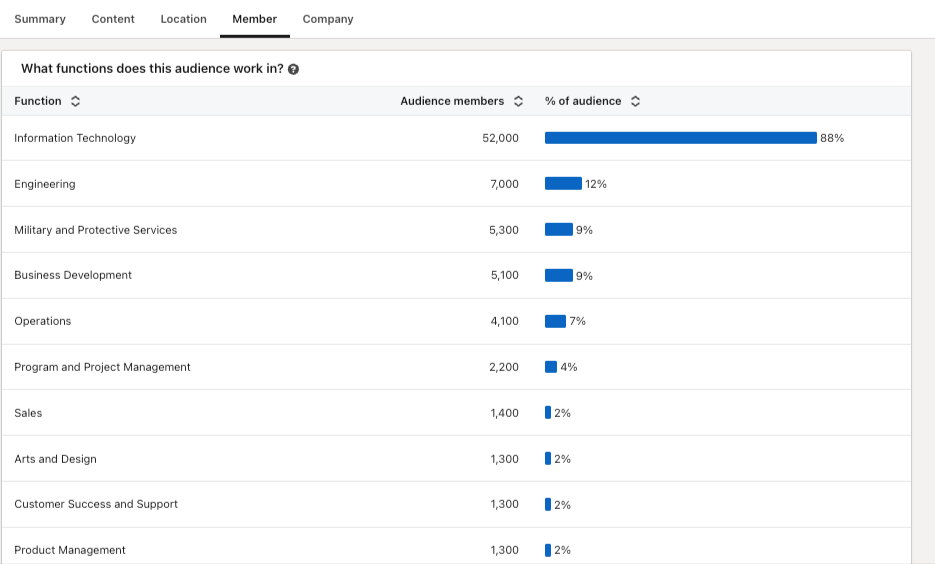
In the company tab, you can review what industries, company sizes, and companies you’re targeting.
For example, if you’re aiming to target FinServ and realize that 13% of your audience is in Hospitals and Healthcare, you may want to exclude it from your targeting.

Go through all available options in your saved audience and refine as much as possible.
Once you’re happy with the exclusions you’ve made, you can add this audience to your campaigns.
Here are the top exclusions that I typically make to avoid wasted spend (feel free to use as inspiration)
1. Irrelevant Industries
2. Irrelevant job functions
3. Irrelevant seniorities
4. Up-to-date list of customers and competitors
5. Current employees
6. People who have visited the login or support pages
7. Poor fit titles (ie students, teachers, retired, interns, analysts)
8. Company sizes outside of ICP
9. People who have recently filled out demo forms
Step 5: Adjust based on insights
After making exclusions and launching your campaigns, your work isn’t finished. In order to be successful with LinkedIn Ads, you need to continually check and adjust your targeting.
To do this, make sure you look at your demographics report on a weekly basis.
This can be found in the top right corner of LinkedIn Campaign Manager. To access it, simply select your campaign and click on “Demographics.”

Now, you’ll be able to see the job functions, job titles, companies, industries, seniorities, etc. that your campaigns are reaching.


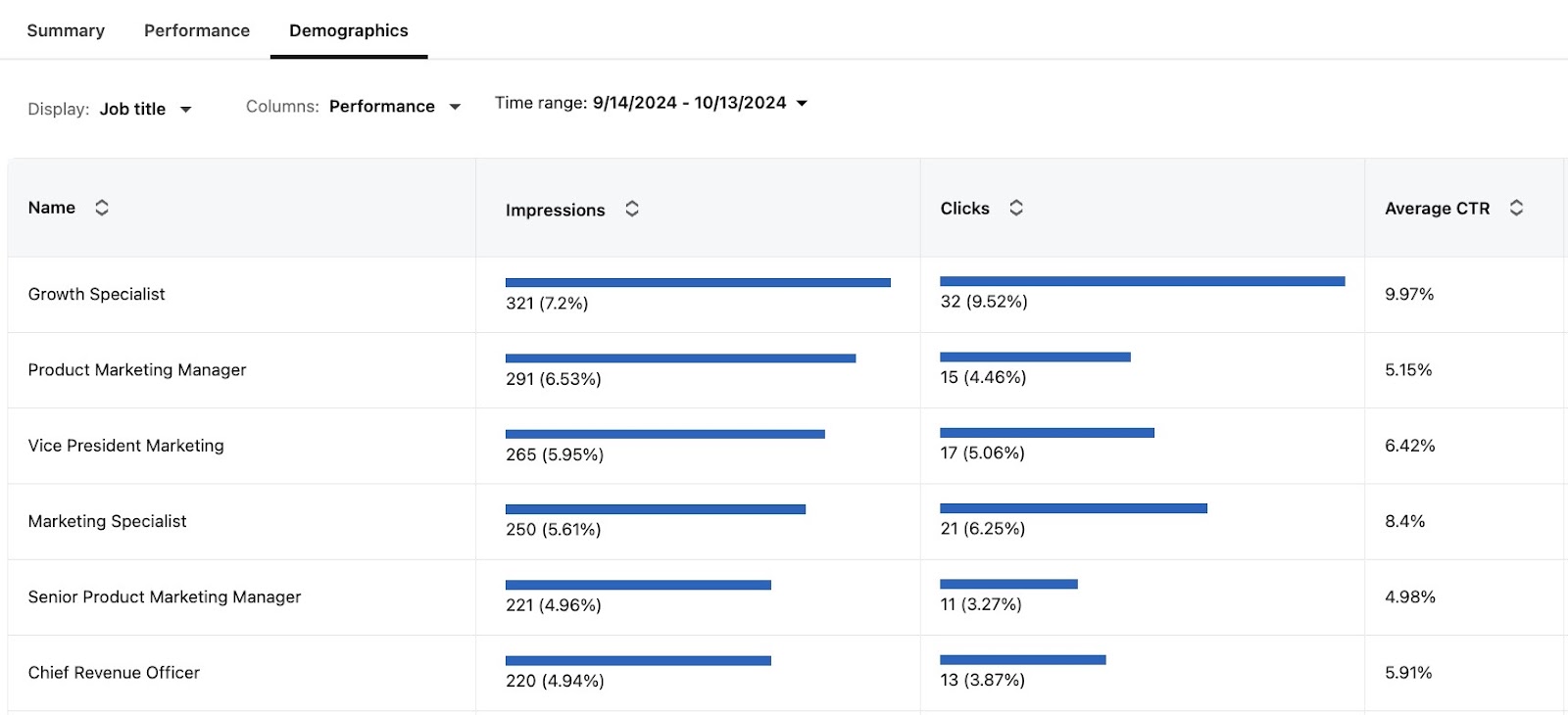
Look through all of these insights – are the people you’re reaching closely aligned with your intended targeting?
Are there certain job titles, functions, companies, industries, etc. that you want to exclude?
Doing this exercise may seem tedious or insignificant, but these small details are often the difference between success and failure.
Conclusion
To summarize, if you want to generate conversions on LinkedIn Ads:
1. Make sure you get extremely clear on who you want to target.
2. Consider testing proven targeting combinations, such as retargeting, tier 1 and tier 2 accounts, and open opportunities.
3. Audit your audiences in LinkedIn Campaign Manager and make all the necessary exclusions to avoid wasted spend.
4. After launch, consistently check your demographics report and adjust your audiences as needed.
P.S. If you have any questions and would like to get in touch, feel free to send me a message on LinkedIn
Master B2B LinkedIn Ads with these 3 Free Courses:
If you want to become a LinkedIn Ads pro, check out our free B2B LinkedIn Ads courses, where you'll learn how to launch, optimize, and scale your campaigns to drive pipeline and revenue.

Here's what you'll learn in each course:
⚙️ B2B LinkedIn Ads 101 - The Ultimate Crash Course for New LinkedIn Advertisers
- Foundations For LinkedIn Ads Success
- Measurement: Tracking & Key Principles
- Targeting: Reaching Your Dream Buyers
- Ads: Mastering The 9 Ad Formats
🎯 B2B LinkedIn Ads 102 - The Blueprint for LinkedIn Ads Optimization
- Monitoring: How To Spot Performance Trends
- Auditing: How To Find The Darlings You Need To Kill
- Reporting: How To Transform Data Into Insights
- Optimization: How To Make Your LinkedIn Ads Profitable
🚀 B2B LinkedIn Ads 103 - Advanced Scaling Strategies From $25M In Ad Spend
- Concepts of Scaling
- Divide and Conquer
- Learnings From $25M+ In LinkedIn Ad Spend
Click Here to Join 1,000+ B2B Marketers Today and start leveling up your advertising skill set.
Takes < 90 seconds to sign up (seriously we timed it 😂)
People Also Ask
How can I effectively measure the success of my LinkedIn ad campaigns in terms of audience engagement and conversion rates?
Utilize LinkedIn’s Campaign Manager to monitor key performance indicators (KPIs) such as click-through rates (CTR), conversion rates, and cost per conversion. Implement LinkedIn’s conversion tracking to assess how many ad interactions lead to desired actions, providing insights into campaign effectiveness.
What are the best practices for refining audience targeting to minimize wasted ad spend on LinkedIn?
Leverage LinkedIn’s advanced targeting options, including job titles, industries, company sizes, and seniority levels, to align your ads with your ideal customer profile (ICP). Regularly analyze campaign data to identify underperforming segments and adjust targeting parameters accordingly to optimize ad spend.
How can I utilize LinkedIn’s audience insights to enhance my ad creatives and messaging?
Analyze demographic data and engagement metrics to understand which audience segments interact most with your ads. Tailor your ad creatives and messaging to resonate with these segments, addressing their specific pain points and interests to increase relevance and engagement.
What strategies can I employ to test and optimize different audience segments on LinkedIn?
Implement A/B testing by creating multiple ad variations targeting different audience segments. Compare performance metrics to determine which segments yield the highest engagement and conversions, and allocate more resources to the top-performing audiences.
How can I integrate LinkedIn audience targeting with other marketing channels for a cohesive strategy?
Align your LinkedIn audience targeting with other platforms by creating consistent buyer personas across channels. Use LinkedIn’s Matched Audiences feature to retarget website visitors or upload contact lists, ensuring a unified approach that reinforces your marketing messages across different touchpoints.

How to get LinkedIn-like Targeting with YouTube Ads for B2B
LinkedIn has hands down the BEST targeting options available for B2B marketers.
Which leads most brands to only advertising on LinkedIn and not much else for social.
If you’re looking for a new channel to scale ABM and/or reach your ideal customer.
In this article you’ll learn 3 YouTube Ads targeting methods worth testing 👇
TABLE OF CONTENTS:
- Targeting option 1: Steal from LinkedIn
- Targeting option 2: Leverage tech
- Targeting option 3: Build custom audiences
Targeting option 1: Steal from LinkedIn
Let’s face it LinkedIn is the BEST for account-based targeting.
The first-party company data they have is unmatched and updated regularly.
This is why 99% of B2B marketers are forced to advertise on LinkedIn.
If you’re pushing a ton of site traffic from LinkedIn Ads and confident in your audience targeting.
Steal that LinkedIn Ads traffic by remarketing to them on YouTube! 🔥
Build a retargeting audience using utm_source = linkedin for YouTube

Or whatever your utm_source is for your LinkedIn Ad campaigns.
You can also further filter by utm_campaign if the size is large enough.
This way you’re getting in front of the same users on YouTube for a fraction of the cost.
Targeting option 2: Leverage tech
Google allows you to upload contact lists for audience targeting.
These lists can include; existing customers, sales qualified leads, leads in nurture and so much more.
As long as your matched lists exceed 100 in size you can use it for targeting or exclusion on YouTube.
Depending on your CRM (ex: Salesforce, HubSpot) there are different technologies you can use to automatically import contact lists into Google Ads for targeting.
Some of those tools include:
Hubspot <> Google Ads Integration
If you’re a Hubspot user you’re in luck!
HubSpot makes it really easy to upload dynamic audiences to Google Ads via integration.

Salesforce <> Google Ads Integration
If you’re using Salesforce this also can be done via direct integration with Google Ads.
Simply link the two tools together via the Data Manager in your account.
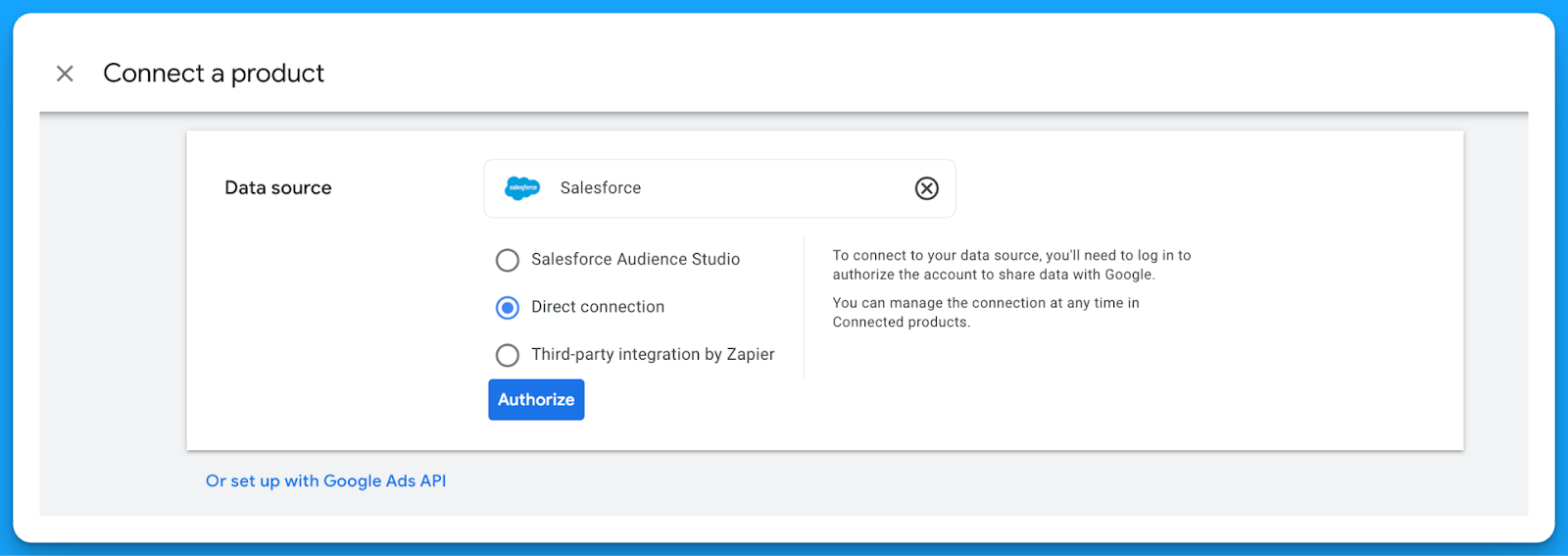
Zapier
Using a CRM that doesn’t have a direct integration with Google Ads?
If you’re in this bucket, I highly recommend exploring Zapier to automate your contact list uploads.
Zapier will act as the bridge between your CRM and Google Ads, here’s an example of how we automated contact lists imports from ActiveCampaign:
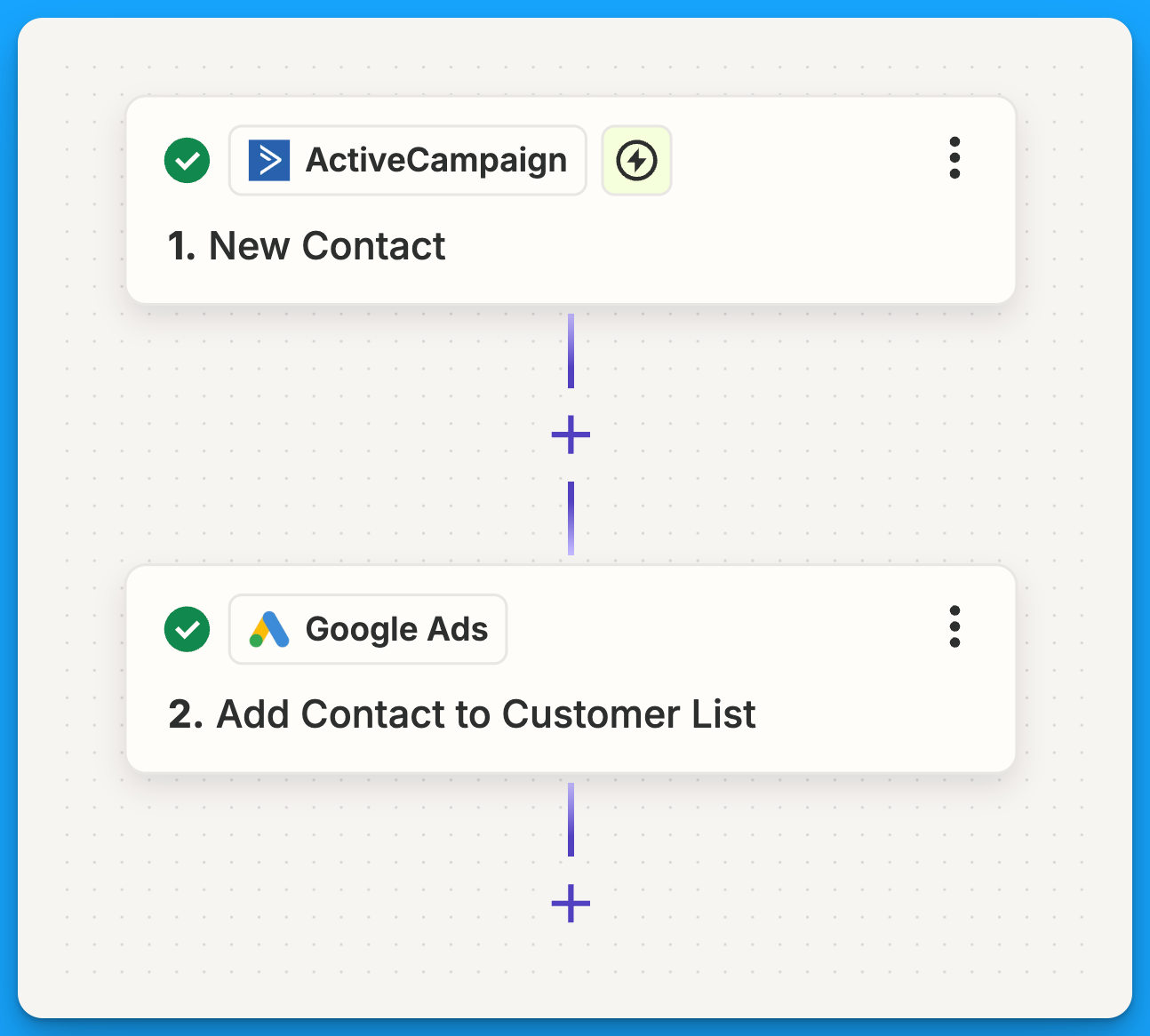
Targeting option 3: Build custom audiences
Fun fact! Google owns YouTube, arguably the second largest search engine in the world.
The amount of behavioural data Google has is incomprehensible 🤯
Lucky for us we can take advantage of it with custom audiences.
Custom audiences allow you target based on:
- What they searched on Google: reach the same Google searchers on YouTube for a fraction of the cost.
- Interests or purchase intention: reach people based on relevant keyword interests or in-market behaviour.
- Websites browsed: add URLs to reach people who visit similar sites.
- Apps used: target users who use certain Google Play Store apps.
Here’s 3 ways to use custom audiences for B2B targeting:
- Brand keywords of your target accounts

- Company page & LinkedIn page URLs of your target accounts

- Google Play Apps of your target accounts (if applicable)
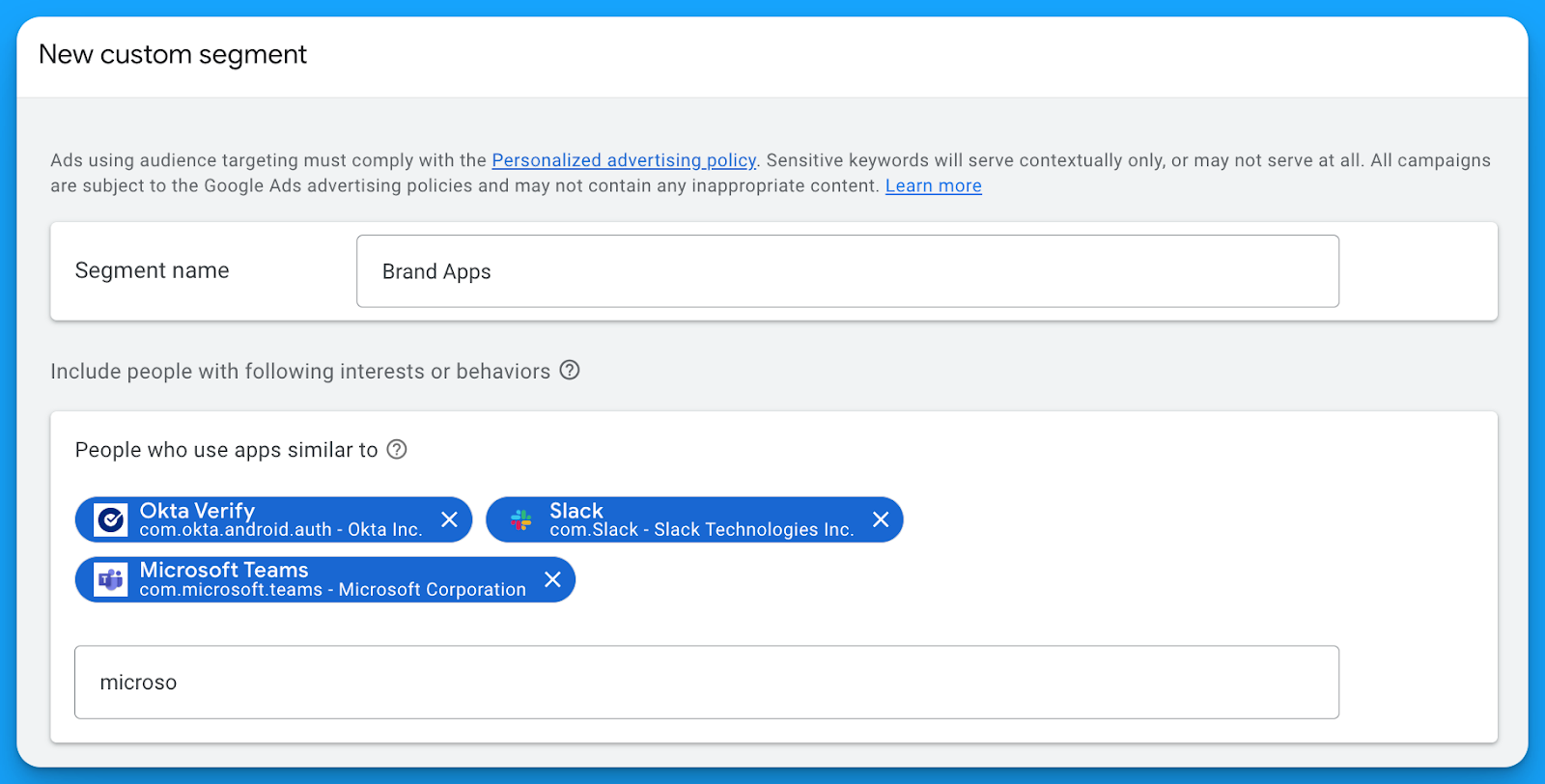
You can also target high-intent solution keywords, and competitor names.
The opportunities are truly endless in terms of the types of keywords you can target.
Start as specific as you can and expand based on your reach.
Hope you found this article helpful!
From Clicks to Conversions: Master Google Ads for B2B 🔥
If you want to become a Google Ads pro, check out our free B2B Google Ads courses, where you'll learn how to launch, optimize, and scale your campaigns to drive pipeline and revenue.

Here's what you'll learn in each course:
⚙️ B2B Google Ads 101 - How to Launch Dangerously Effective Campaigns for Beginners
- The Googleverse: The Game You're Playing & How To Win
- Measurement: How to Make Sure You're Profitable
- Targeting: How to Show Up For the Right Searcher
- Planning: Putting It All Together
🎯 Google Ads 102 - How to Clicks Into Profit
- Visibility: How To Find the Hole Sucking Profits
- Workflows: How to Optimize On a Daily, Weekly, Monthly & Quarterly Basis
- Experimentation: How to Test & Automate Profitability
- Troubleshooting: How To Solve Inevitable Problems
🚀 Google Ads 103 - How to Scale Google Ads For Advanced Advertisers
- Methodology: How to Vertically Scale Google Ads From A-Z
- Campaigns: Scaling Horizontally Through Campaign Themes
- Channels: Scaling Outside of Paid Search
Click Here to Join 1,000+ B2B Marketers Today and start leveling up your advertising skill set.
Takes < 90 seconds to sign up (seriously we timed it 😂)
People Also Ask
How can I effectively measure the success of my YouTube Ads campaigns in reaching B2B audiences?
Utilize YouTube’s analytics to monitor key performance indicators (KPIs) such as view rates, click-through rates (CTR), and conversion rates. Implement tracking pixels and UTM parameters to assess the impact on lead generation and sales.
What are the best practices for creating engaging video content that resonates with B2B audiences on YouTube?
Develop content that addresses specific pain points and interests of your target audience. Incorporate clear messaging, professional visuals, and strong calls-to-action to encourage engagement.
How can I integrate YouTube Ads into my existing B2B marketing strategy?
Align your YouTube Ads with broader marketing campaigns to ensure consistent messaging across channels. Use insights from other platforms, like LinkedIn, to inform your YouTube targeting and content strategies.
What are the cost considerations when using YouTube Ads for B2B marketing?
YouTube Ads operate on a pay-per-view or pay-per-click basis, allowing for flexible budgeting. It’s essential to monitor spending closely and adjust bids and targeting to optimize return on investment.
How can I ensure compliance with data privacy regulations when uploading contact lists for targeting on YouTube?
Ensure that all contact data is collected and used in accordance with relevant data privacy laws, such as GDPR or CCPA. Obtain explicit consent from individuals before using their information for targeted advertising.
.jpg)
10 Tips You Need to Know Before Hiring Your Next Ad Agency or Consultant
Working with an advertising agency, freelancer, or consultant?
After the past 12 years working in-house I know what good and bad looks like.
In this article I’m going to share with you my hard lessons learned on working with these partners.
And if you’re an agency owner, freelancer, or consultant reading this (take notes!) 📝
These tips are bucketed into four parts: people, product, process, and results.
Let’s dive in!
TABLE OF CONTENTS:
- Tip #1: Be clear on your communication needs and expectations
- Tip #2: Decide your meeting cadence
- Tip #3: Get clear on who and what for your tools
- Tip #4: Review your brand foundations
- Tip #5: Make sure your extended team knows the audience targeting
- Tip #6: Define your operational plumbing
- Tip #7: Share your historical benchmarks
- Tip #8: Be clear on your naming conventions
- Tip #9: Have clear trackable goals
- Tip #10: Set clear timelines and deliverables
[process] Tip #1: Be clear on your communication needs and expectations
You have to be upfront about this from the beginning.
Where and how often are the two key questions here:
- Where will we be communicating? (ex: Slack)
- How soon should you expect a response? (ex: within 24 hours)
- How fast can I expect a certain task to be completed? (ex: 72 hours)
You need to tell your partners what you expect from them in terms of communication.
Steal this template:
“Hey {Name}, I want to be really clear that with the agencies I work with I expect a response from my slack or emails within {timeframe, ex: 12 business hours}”.
This is equally as important for those of us managing clients as it allows you to more effectively prioritize your communications with clients and triage your day.
[process] Tip #2: Decide your meeting cadence
This tip connects with the previous around framing expectations.
You have to get clear on how often you’re going to be meeting, is it weekly, bi-Weekly, monthly?
Communicate your expectations on how often you’ll meet and the options available.
By getting clear on your needs and how fast you want to get things done will allow you to answer this.
The best part about defined meeting cadences is that it allows you to hold people accountable.
It’s a forcing function that makes sure you’re getting what you need fast enough.
My preferred meeting cadence:
Weekly for the first six weeks to build trust and create momentum then move towards bi-weekly.
Within the first 6-weeks of working with a new agency or consultant you’ll want to ensure they are set up with:
- Systems access
- Clearly defined goals
- Clarity on your ICP and audience
From here everything is addressed and you can move to a bi-weekly cadence.
Again this is my personal preference align according to your needs!
If you want some tips on how to run an effective meeting check out my LinkedIn post 🎉
[process] Tip #3: Get clear on who and what for your tools
The last thing you want is for it to take four weeks for your agency to get plugged into your system.
Get your new partners access to your systems as fast as possible so they can begin adding value.
Build a document with a clear list of all the primary tools they’ll need access for and who to contact.
If the agency, consultant, or freelancer you’re onboarding already has clear documentation already on how you can provide them access to their primary tools this is a green flag! 🟢
If you can take the initiative to build an internal version of this document even better.
You know your marketing operations person's name, make sure they know as well.
The more people working together across teams the more important this becomes.
[product] Tip #4: Review your brand foundations
Make sure your agency, freelancer, or consultant understands your brand.
Your brand foundations consists of:
- What does your solution do?
- What’s your unique value prop?
- What’s your origin story?
- Who are your competitors?
- What’s your tone of voice?
Even better if your partners can sit in on a live demo (or at the minimum watch a recording).
If your partners don’t get sold on the unique value you provide they will never be able to make an impact with the campaigns they create for you (and red flag if they don’t want to know! 🔴).
[product] Tip #5: Make sure your extended team knows the audience targeting
We touched on this on tip #4 but this is so important it deserves its own tip.
Audience targeting is the foundation of everything you’re going to be doing.
You need to be absolutely clear on:
- Job titles
- Job functions
- Company size
- Industries
Really, really, really hone in on this! 🙏
Make sure your extended teams knows this as well.
This is where your buyer persona comes into play, if you need help on how to craft one check out Module 2 of my B2B Advertising Foundations course where I show you how to piece it together.
Give them as much customer information as possible because they have to know this.
They need to know what good vs bad leads look like.
Pro tip:
Keep all this customer information in a shared document so your partners can refer back to it in the future when needed and setup a shared channel to monitor lead quality 🔥
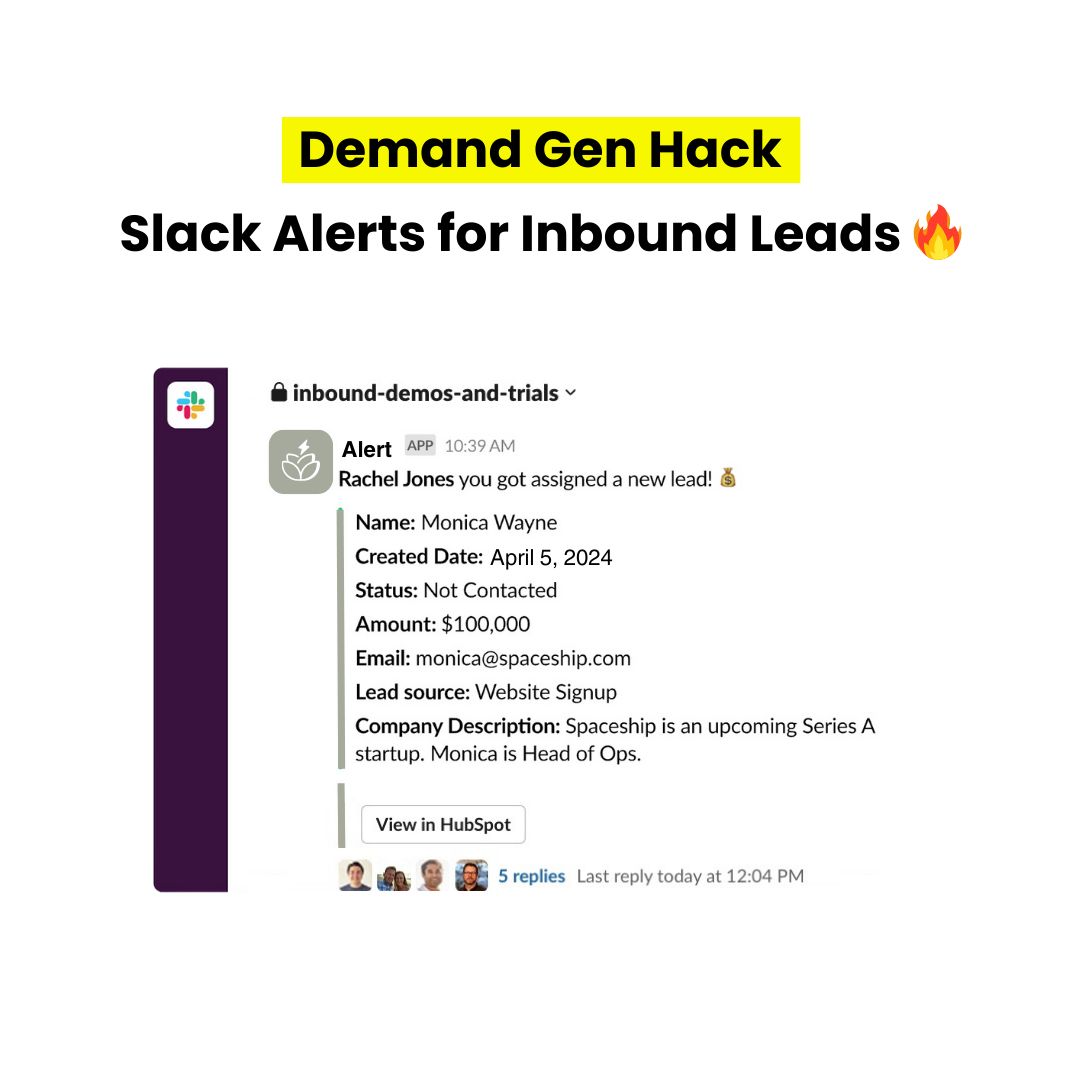
[process] Tip #6: Define your operational plumbing
You need to be specific on how things should be tracked.
The goal isn’t to just drive leads, it’s to scale legit qualified pipeline and revenue.
Work with your extended teams to map out your customer lifecycle operations.
For example, they should be clear on:
- Once someone fills out a form, now what?
- How are leads being handed off to sales?
- How is the team being notified on new leads?
- How are they being followed up with?
From here it’s piecing together the right UTM conventions for measurement, connecting forms in our marketing automation tools so be able to route appropriately.
Walk through all of these steps and the points in-between so things are tracked.
Take my word for it, defining this will save you a lot of headaches at the end of the quarter! 😅
[results] Tip #7: Share your historical benchmarks
You need to first understand your historical benchmarks so you can share them.
Reverse engineer your funnel to understand your performance between steps.
This will look different for every company but here’s an example for sales led:
- Meetings Booked
- Meetings Completed
- Opportunities
- Pipeline
- Revenue
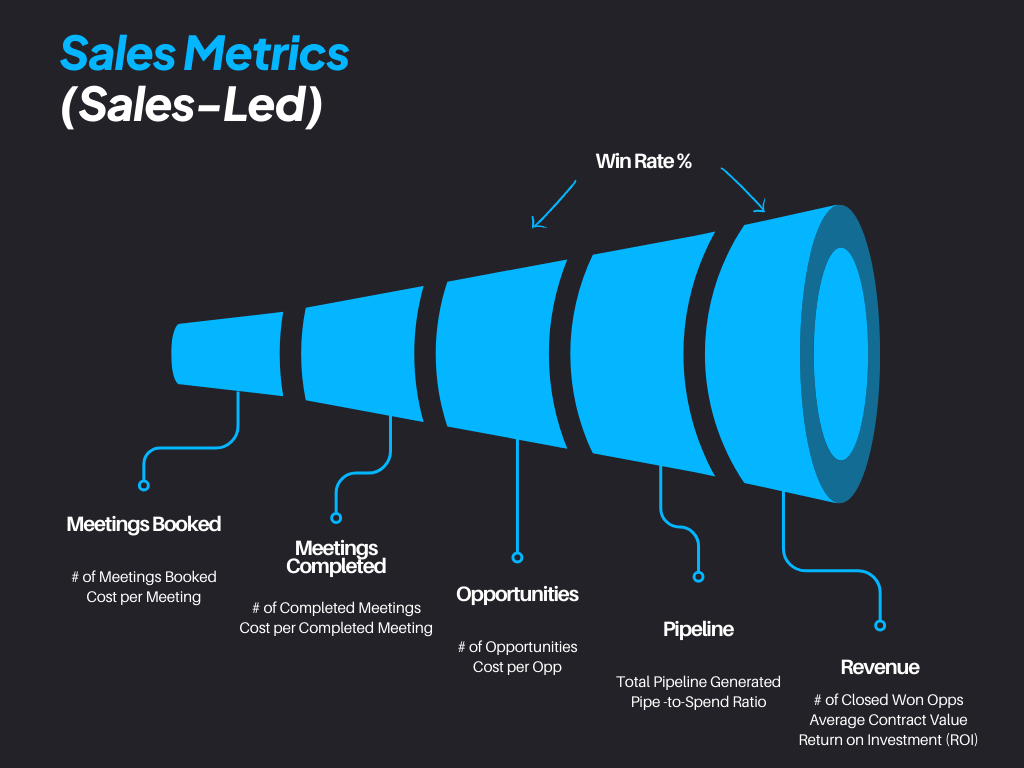
Knowing the difference between steps is crucial to improve efficiency.
If your agency or consultant isn’t trying to reverse engineer your funnel that’s a red flag! 🔴
Share these historical benchmarks and hold them accountable.
[Process] Tip #8: Be clear on your naming conventions
Your partners need to be able to jump inside your ad accounts and understand what’s happening.
The first step is making sure they are informed on your naming conventions.
Align on naming conventions for:
- Forms
- Campaigns
- Creatives
And if you’re reading this and don’t have existing naming conventions, ask yourself:
What are the questions I’d like to answer from my campaigns?
For example, I want to know:
- What’s my performance by region?
- What’s my performance by campaign objective?
- What’s my performance by ad?
Then use these answers to include them in your naming convention.
This is a really small in the weeds tactical step but worth sharing.
[results] Tip #9: Have clear trackable goals
Determine the metrics that matter that your advertising partners should track and the frequency in which they should be reporting on these goals to you.
I personally like to report on these weekly to make sure everything is pacing appropriately.
This also allows you to pivot quickly when things start to go off track.
When determining the metrics that matter, also brainstorm your leading indicators.
Leading indicators are clear metrics that help you determine early signs of success.
For example, depending on your campaigns objective it might look a bit different:
- Lead gen = qualified leads created
- Awareness = engagement rate by ad type
Just choose something that can happen quickly within the first 7 days of a campaign going live and is a relevant milestone that will ultimately lead to your end goal.
🟢 An early and specific goal is better than no goal at all.
Without this clarity you or your partners won’t be able to prioritize what needs to be done.
If you’re struggling with deciding on your goals go back to tip #7 and understand your benchmarks.
[results] Tip #10: Set clear timelines and deliverables
Defining the success metrics that matter and the roadmap to get there is CRUCIAL.
You have to be clear upfront timelines for both parties or it’s going to get squirrely 🐿😅
If it’s not defined upfront as you go things will go sideways.
Communicate to your agency, consultant, or freelancer:
Here’s what we expect from month 1, 2, and so on…
You’re hiring these experts to come in and solve a specific problem.
The goal is to hold your partner accountable to the outcome and not tasks.
This keeps you focused on the things that matter (ex: funnel optimization, benchmarks, goals).
I hope you found these 10 tips helpful and the best of luck in your future partnerships! ♥️
Connect with me on LinkedIn, and let’s keep the conversation going.
You can also visit my website here for more valuable content.
Jumpstart Your B2B Marketing Career

If you’re serious about mastering B2B advertising, then you definitely need to check out my free course that will teach you the foundational knowledge to becoming a high-performing B2B marketer who knows how to use advertising to drive legit business and revenue impact without the fluff or wasting your time and money learning the ropes the hard way.
- Module 1: you’ll get a crash course in the B2Bverse and master terminology, sales processes, and working across teams.
- Module 2: you’ll learn how to become your customer's psychologist and understand them deeply with buyer personas that allow you to craft effective messaging.
- Module 3: you’ll master the B2B funnel and learn how to think like a CEO to identify performance bottlenecks and convert more leads into revenue.
- Module 4: you’ll learn how to put it all together and build your go-to-market strategy that gets your ad in front of your dream buyers and converts attention.
This course was designed with absolute beginners in mind.
Accelerate your learning curve and start the course today for free.
People Also Ask
What should I look for when evaluating a digital marketing agency’s or freelancer’s portfolio?
Look for case studies or examples of work relevant to your industry or goals. Examine metrics like ROI, lead generation, or brand awareness improvements. Ensure their style and results align with your business objectives.
How can I assess the expertise of a digital marketing agency or freelancer before hiring?
Ask about their certifications (e.g., Google Ads, HubSpot), years of experience, and client testimonials. Request examples of campaigns they’ve worked on and inquire about their understanding of your niche.
What key questions should I ask during the discovery call with a potential agency or freelancer?
• Questions might include:
• What industries have you worked with?
• How do you approach campaign strategy?
• What KPIs do you typically focus on?
• How often will we receive updates or reports?
How can I ensure smooth communication and collaboration with a marketing agency or freelancer?
Establish clear communication channels (e.g., Slack, email) and agree on response times. Schedule regular check-ins or status meetings to align on progress and adjust strategies as needed.
What are red flags to watch out for when hiring an agency or freelancer?
Be cautious if they guarantee immediate results, avoid sharing clear metrics, or lack transparency about pricing or deliverables. A reputable partner will provide realistic expectations and detailed proposals.
Should I choose an agency or freelancer for my marketing needs?
Agencies offer a team with diverse expertise, while freelancers may provide more personalized attention. Choose based on your budget, the complexity of your campaigns, and the need for specific skills.
How can I track the ROI of hiring a digital marketing agency or freelancer?
Set clear goals and KPIs upfront, such as lead volume, cost per lead, or revenue growth. Use analytics tools to monitor campaign performance and schedule regular reviews with your partner to evaluate progress.

Google Ads Quality Score: Everything You Need To Know (2024)
Mastering quality score is essential if you want to pay less per click and outrank competitors.
In this article you’ll learn the 80/20 of what you need to know about quality score.
Let’s dive into it!
TABLE OF CONTENTS:
- Quality Score Simplified
- How is Quality Score Calculated?
- How to audit your Quality Score?
- How to improve your Quality Score?
- Quality Score FAQ
Quality Score Simplified
Back in 2005, Google released Quality Score.
This is a number from 1-10 that Google created to determine how relevant your ads are to what people are searching for (1 being the lowest relevance, and 10 being the highest).

Google want’s people who search to find what they are looking for.
This way they come back to Google and search again in the future.
Quality Score is how they gamified the system to achieve this objective.
It’s the perfect trinity between advertiser, searcher, and Google:
- Advertisers are rewarded with lower costs when having higher quality scores
- People searching for answers on Google will now find more relevant information
- Because people find relevant information they use Google again in the future
Before Quality Score was introduced Google was filled with tons of irrelevant ads leading to a poor experience for searchers and ultimately less people using Google in the future.
(In my opinion) Quality Score was one of the most important features released that transformed Google into the most dominant search engine in the world.
The secret to improving Quality Score is relevance.
How is Quality Score Calculated?
Ad relevance, landing page experience, and expected CTR are the three variables that go into calculating your Quality Score. Depending on how relevant each is to your keywords you’ll have a final score between 1-10 (1 being the lowest relevance, and 10 being the highest).
Ad Relevance
A metric that determines how relevant your keywords are to your ad copy.
Above average signifies great relevance, below average signifies room for improvement, below average signifies poor keyword and ad copy relevance.
Ad relevance is 100% in your control and below average ad relevance is usually the result of poor ad group structure resulting from too many keywords and/or few variations of ad copy.
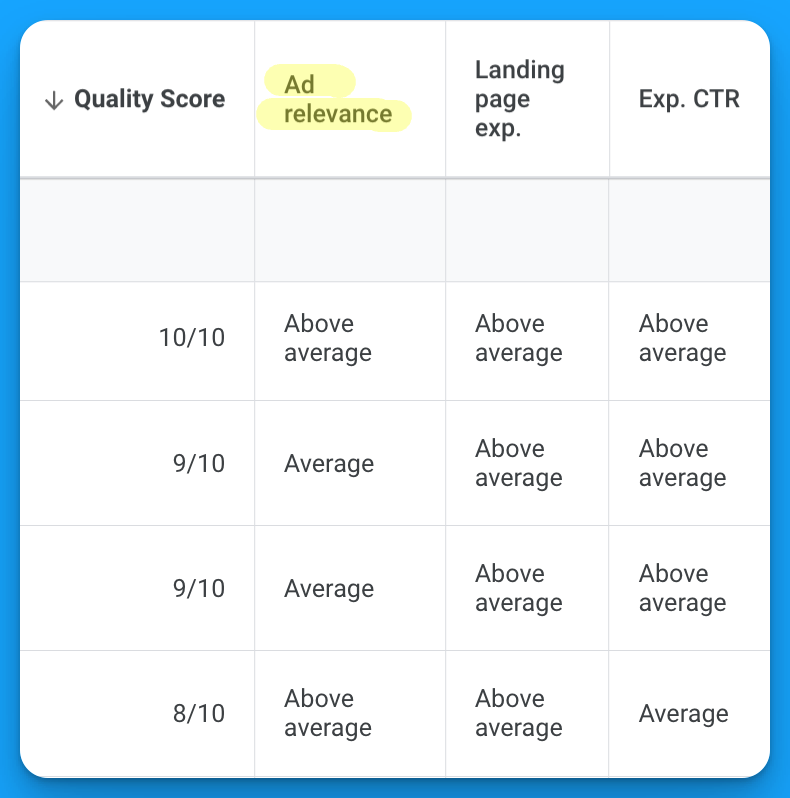
Landing Page Experience
A metric that determines how relevant your keywords, ads, and post click experience matches the search intent of the user.
It’s not just about having your keywords on the page, it also takes into consideration page load speeds, page structure (ex: H1, H2s, H3s), and mobile optimization.
Above average signifies a great landing page experience, average signifies room for improvement, and below average signifies poor post click experience.

Expected CTR
A metric that determines the likelihood of someone clicking on your ads once seen in the Google search results.
In my experience auditing Google Ads accounts this is the #1 most common variable that drags down quality score for most accounts since it’s the least in your control.
This is Google’s perception based on historical and predicted performance on how well you believe your ad will be engaged with.
Above average signifies a highly engaging ad, average signifies room for improvement, and below average signifies poor ad engagement.
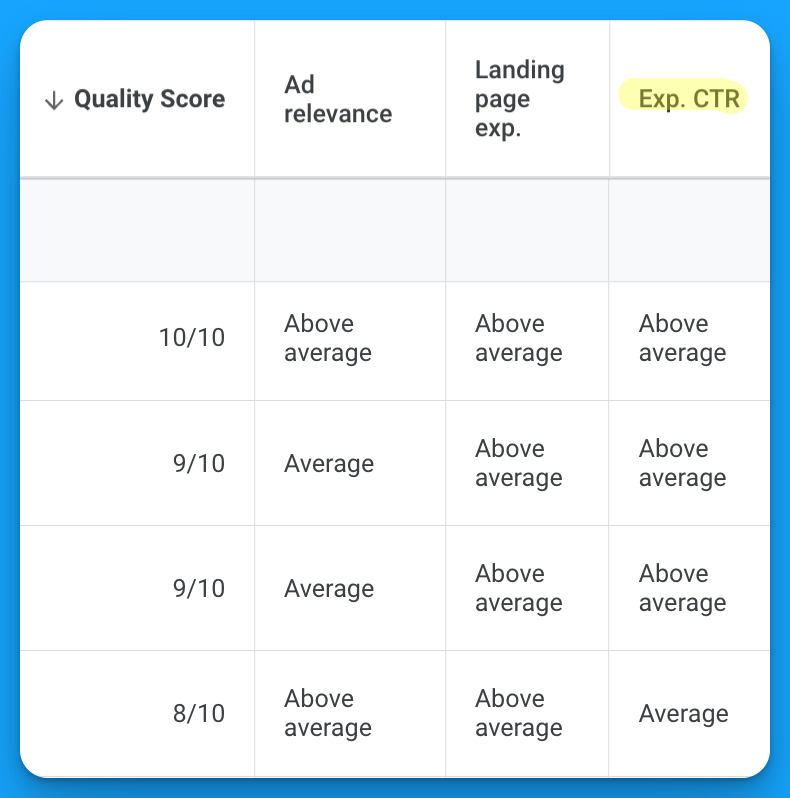
How to audit your Quality Score?
Once you understand the basics of quality score that it is a factor of relevance and three components that determine whether you’re a 1-10 the next logical question becomes:
What’s impacting my quality score performance?
Here’s how to run a Google Ads quality score to find what’s impacting your performance.
[EMBED YOUTUBE VIDEO]
Step 1 - Download a keyword report
Within your Google Ads manager navigate to the keywords section within your account:
Campaigns > Keywords (press G + K for a keyboard shortcut)
Modify your keyword columns to include:
- Quality Score
- Ad Relevance
- Landing Page Experience
- Expected CTR
Once completed download your keywords into a CSV.
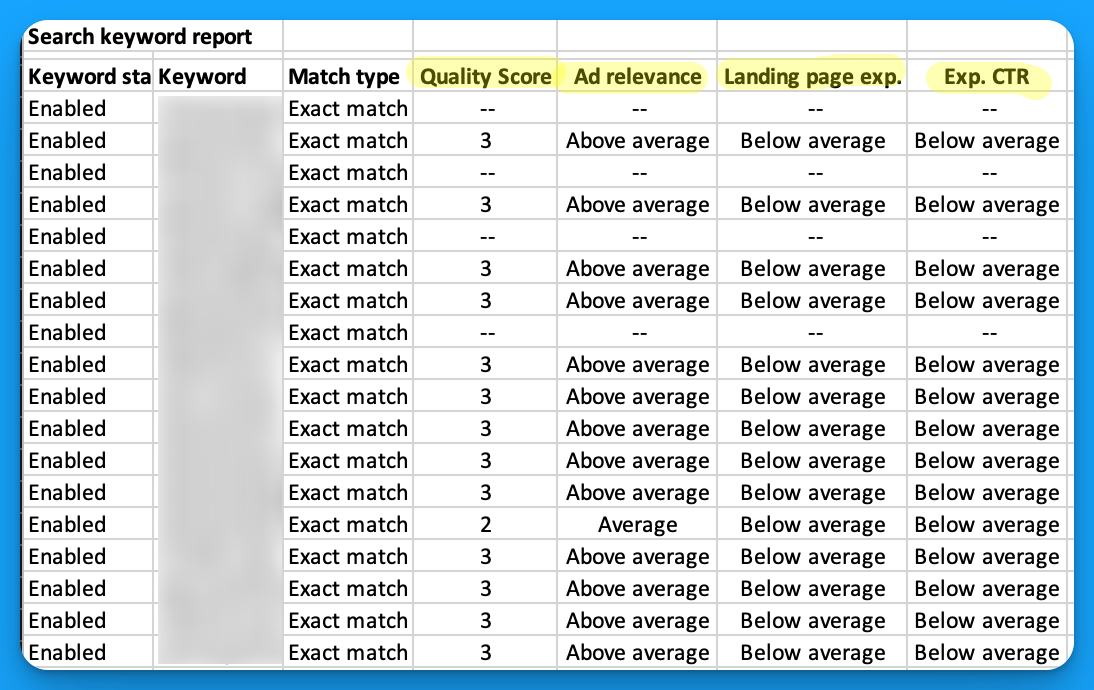
Step 2 - Summarize your keywords into a pivot table
Pivot tables are great for summarizing large amounts of data.
Within Excel navigate to Insert > PivotTable to summarize your keyword report.
Once complete format your table as follows:
- Rows = Quality Score
- Values = Count of Keywords
- Filter = Quality score 1-10 (exclude —)

Step 3 - Drill down to understand Quality Score performance
With your table setup now you can easily see overall quality score performance and drill down into specific elements such as ad relevance, landing page experience, and expected CTR.
Switch your rows to drill down into each element of quality score to diagnose performance:
- Ad Relevance; rows = Ad Relevance, values = count of keywords
- Landing Page Experience; rows = Landing Page Experience, values = count of keywords
- Expected CTR; rows = Expected CTR, values = count of keywords

How to improve your Quality Score?
After completing your Google Ads Quality Score audit it should be pretty clear which factor of QS is hurting your performance? (ex: ad relevance, landing page experience, expected CTR).
Here’s some recommendations on how to improve each QS factor:
Improving Ad Relevance
Below average ad relevance is a symptom of poor ad group structure.
If you have below average ad relevance, fear not! Because this is 100% in your control.
Here’s some tips to improve your ad relevance:
- Add more headline variations to your responsive search ads to include the keywords within your ad groups.
- Keep your ad groups tightly grouped with thematic keywords, for the keywords that can’t fit the theme consider putting it into its own group with relevant copy.
- Consolidate your active keywords and remove below average ad relevance variations that are not receiving any worthwhile impressions or clicks.
Improving Landing Page Experience
Below average landing page experience is a symptom of poor post click experience.
If you’ve been neglecting your landing pages this is where it’s going to bite you.
Here’s some tips to improve landing page experience:
- Include your primary keyword in your headline 1 to match search intent and your ad copy.
- Run your landing page through PageSpeed Insights to find how you can improve the mobile and desktop experience.
- Follow on page SEO best practices and have proper headline, and content formatting. Remember Google will crawl your landing pages so make sure it’s technically sound.
- Install a session recording tool to see how users behave on your landing page, the insights here are invaluable at understanding gaps.
Improving Expected CTR
This is Google’s perception on how likely your ads will be clicked.
Unfortunately this aspect of Quality Score is the least in your control but that doesn’t mean there isn’t anything you can do to improve it.
Here’s some tips to improve your expected clickthrough rate:
- Use as many ad extensions as possible (ex: sitelink, image, structured snippet, etc). Ad extensions provide more info to the searcher and make your ads larger.
- Test new RSA ad copy on a monthly basis to consistently try and improve your ad clickthrough rate performance on an ongoing basis.
- Monitor your account clickthrough rate trends month over month to combat negative trends. You can set up an automated rule within Google Ads to be notified automatically via email.
- Audit your search terms report and build your negative keyword lists. Block irrelevant impressions of your ads so that you can actually drive clicks.
- Experiment with dynamic keyword insertion to see if it positively affects your ad CTR.
Quality Score FAQ
How long does it take to improve your quality score?
Technically every time your keyword enters an auction quality score is recalculated to determine placement of your ad in relation to your competitors.
However in my experience it usually takes a month to see significant changes in your overall score.
Should you worry about low quality scores?
Yes, low quality scores should cause concerns but it shouldn’t be your initial priority. The first goal should be to drive relevant traffic and convert users.
If you’re not currently accomplishing this then stressing about quality score is pointless as it’s really only a factor of reducing your costs and improving visibility.
If you’re not already converting the visibility you do have, getting more of it won’t help.
What is a good quality score?
A good quality score will fluctuate depending on your keyword strategy but overall I’d recommend having 70% of enabled keywords in your account with a score > 7.
Just know this is highly circumstantial and if you’re running a competitive keyword strategy you will have lower quality scores by default given the difficulty of including your competitors in your ads.
Hope you found this article helpful! 🔥
Check out our video tutorial linked if you want a visual walkthrough.
From Clicks to Conversions: Master Google Ads for B2B 🔥
If you want to become a Google Ads pro, check out our free B2B Google Ads courses, where you'll learn how to launch, optimize, and scale your campaigns to drive pipeline and revenue.

Here's what you'll learn in each course:
⚙️ B2B Google Ads 101 - How to Launch Dangerously Effective Campaigns for Beginners
- The Googleverse: The Game You're Playing & How To Win
- Measurement: How to Make Sure You're Profitable
- Targeting: How to Show Up For the Right Searcher
- Planning: Putting It All Together
🎯 Google Ads 102 - How to Clicks Into Profit
- Visibility: How To Find the Hole Sucking Profits
- Workflows: How to Optimize On a Daily, Weekly, Monthly & Quarterly Basis
- Experimentation: How to Test & Automate Profitability
- Troubleshooting: How To Solve Inevitable Problems
🚀 Google Ads 103 - How to Scale Google Ads For Advanced Advertisers
- Methodology: How to Vertically Scale Google Ads From A-Z
- Campaigns: Scaling Horizontally Through Campaign Themes
- Channels: Scaling Outside of Paid Search
Click Here to Join 1,000+ B2B Marketers Today and start leveling up your advertising skill set.
Takes < 90 seconds to sign up (seriously we timed it 😂)

How To Use The Google Ads Editor In 2024: Bulk Upload Campaigns, Ads & Keywords
There’s nothing worse than making bulk changes natively in Google Ads.
If you’re ready to save hours bulk uploading campaigns, ads, and keywords.
Mastering the Google Ads Editor is essential.
Let’s cover everything you need to know 👇
TABLE OF CONTENTS:
- What is the Google Ads Editor?
- How to get started with the Google Ads Editor?
- How to bulk upload campaigns, keywords, and ads with the Google Ads Editor
60-second crash course on the Google Ads Editor
What is the Google Ads Editor?
It’s a free tool that you can install to update your campaigns offline including altering campaign settings, adjusting keyword bids, and creating new campaigns, ads, and ad groups.
Any serious Google advertiser uses the editor to save hours performing tedious tasks.
Make sure you download the latest version of the editor to follow along in this article.
How to get started with the Google Ads Editor?
After installation add your Google Ads account within the Account Manager and download all campaigns so you have the most recent version of your account.
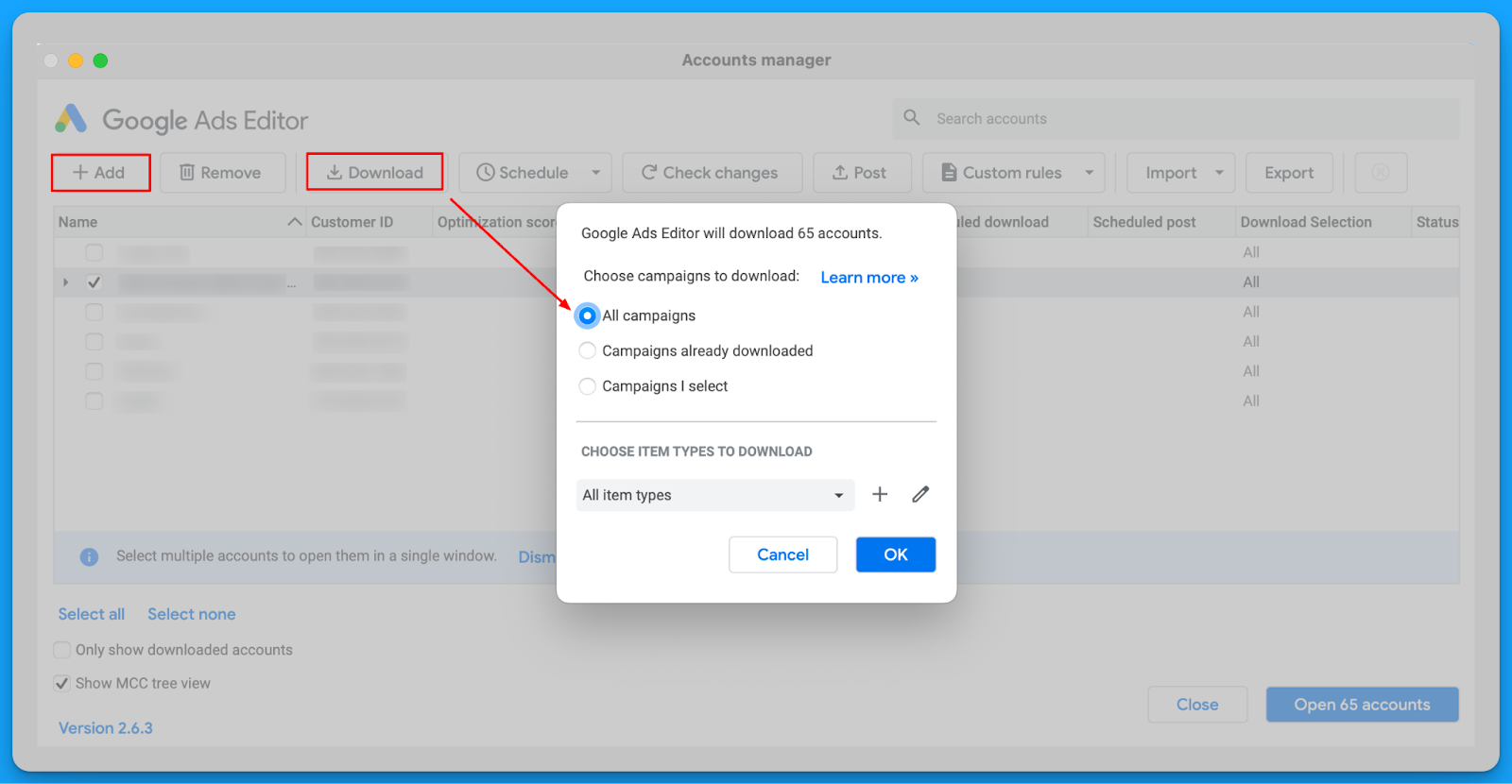
The Google Ads Editor follows the same account structure:
Account > Campaign > Ad Group > Keyword > Ads

Highly recommend using the Hide Empty Types filter to reduce irrelevant options visible.
How to bulk upload campaigns, keywords, and ads with the Google Ads Editor
The easiest way to bulk upload campaigns into the editor is using a google sheet template.
This template should have the following fields fields available (at minimum):
- Campaign
- Ad Group
- Keyword
Get a copy the example template below here <<

Once you have your template copy you’re ready to get started.
Step 1: configure your campaign import template
Fill in your import template with all the relevant campaign names, ad group, keywords, and ads.
Do not modify the column headers as these are meant to match the editors default fields.
Feel free to fill in whichever fields you find most relevant.
Step 2: Upload your campaign import template
Once you’ve completed setting up your campaign import template with all your relevant details it’s time to import your campaigns into the editor.
Navigate to Account > Import > Paste Text to begin the import process:

Once complete copy all of the column headers and rows you filled in in your import template and paste them into the import from text window:
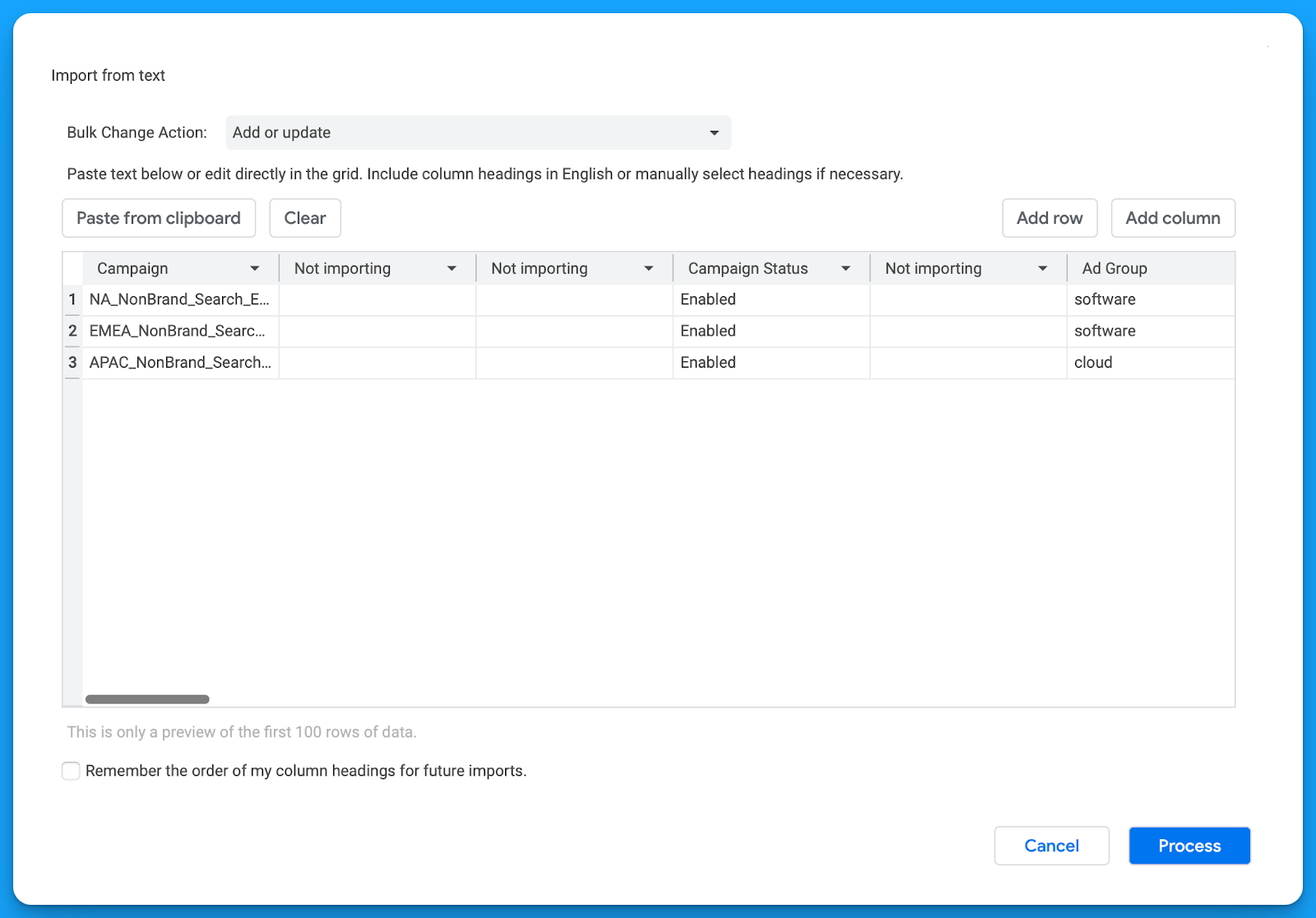
Don’t worry about the blank “Not importing” columns this is due to the formatting of the import template I provided, instead review the fields that are filled in the column headers.
Make sure everything is looking accurate according to what you want to import.
Once complete click Process to import the campaigns, keywords, and ads.
Step 3: Configure your campaign settings and publish
After reviewing your changes make sure to select Keep in order to retain them.
Now you should have all of your campaigns, ad groups, keywords, and ads that you filled into your import template visible within the Google Ads Editor.
The final step is to configure your campaign and publish your changes.
Highlight each of your new campaigns at the sametime to apply the same campaign settings across of all them at once 🚀
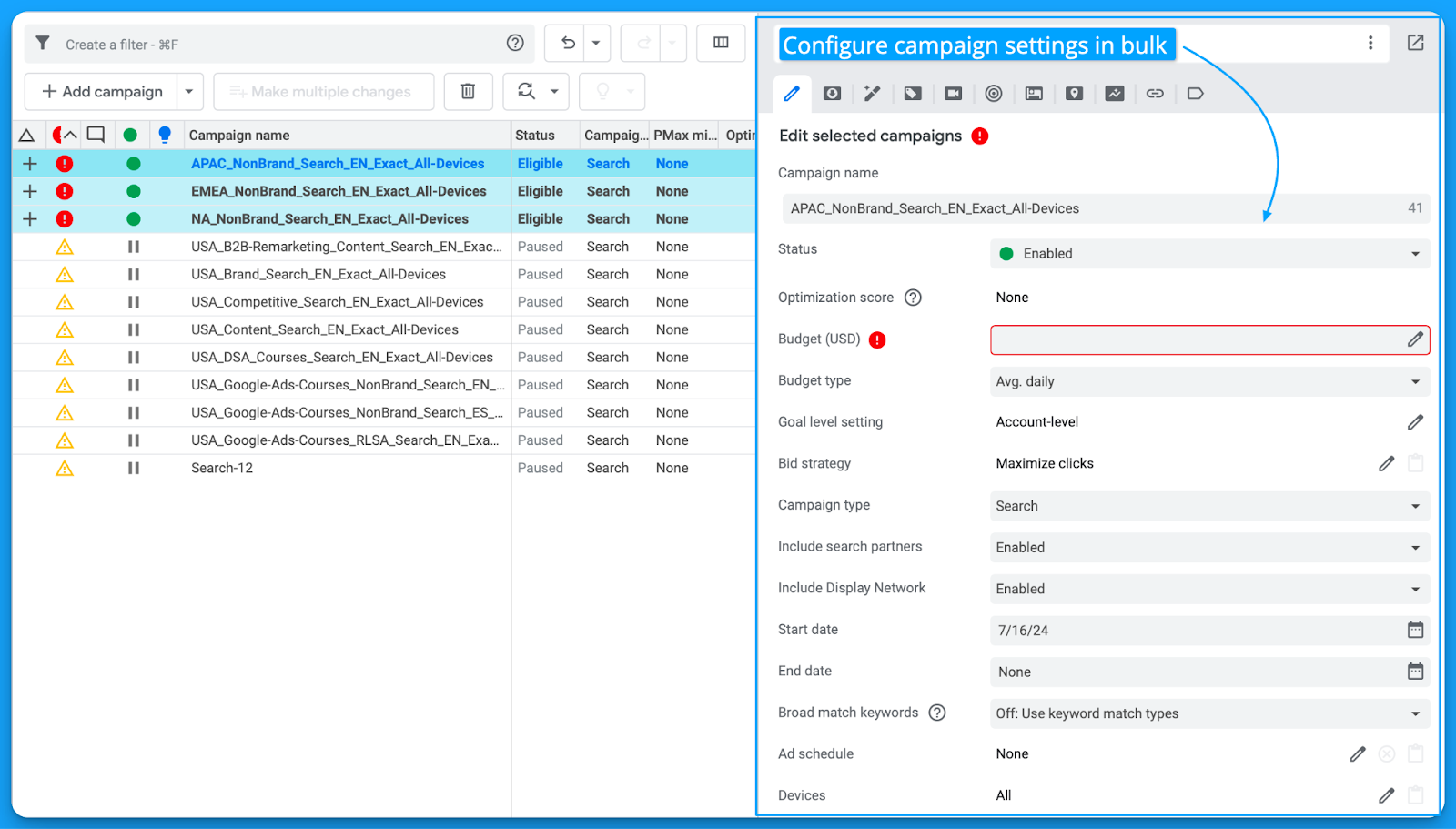
Review all available campaign settings and uncheck the Display Network for search.
If you don’t want your campaigns to spend when published, change the status to Paused.
Once your campaigns are ready to be published into your live Google Ads account.
Select Post > Post Changes > Selected Campaigns
That’s it! 🎉you’ve just saved hours and created campaigns in bulk.
Hope you found this article helpful, see you in the next one!
From Clicks to Conversions: Master Google Ads for B2B 🔥
If you want to become a Google Ads pro, check out our free B2B Google Ads courses, where you'll learn how to launch, optimize, and scale your campaigns to drive pipeline and revenue.

Here's what you'll learn in each course:
⚙️ B2B Google Ads 101 - How to Launch Dangerously Effective Campaigns for Beginners
- The Googleverse: The Game You're Playing & How To Win
- Measurement: How to Make Sure You're Profitable
- Targeting: How to Show Up For the Right Searcher
- Planning: Putting It All Together
🎯 Google Ads 102 - How to Clicks Into Profit
- Visibility: How To Find the Hole Sucking Profits
- Workflows: How to Optimize On a Daily, Weekly, Monthly & Quarterly Basis
- Experimentation: How to Test & Automate Profitability
- Troubleshooting: How To Solve Inevitable Problems
🚀 Google Ads 103 - How to Scale Google Ads For Advanced Advertisers
- Methodology: How to Vertically Scale Google Ads From A-Z
- Campaigns: Scaling Horizontally Through Campaign Themes
- Channels: Scaling Outside of Paid Search
Click Here to Join 1,000+ B2B Marketers Today and start leveling up your advertising skill set.
Takes < 90 seconds to sign up (seriously we timed it 😂)
People Also Ask
How can I ensure data accuracy when performing bulk uploads in Google Ads Editor?
Before uploading, validate your data by checking for formatting errors, duplicate entries, and alignment with Google Ads policies. Utilize the “Check Changes” feature in Google Ads Editor to identify and resolve any issues prior to posting.
What are the best practices for structuring CSV files for bulk uploads in Google Ads Editor?
Ensure your CSV files have clear headers corresponding to the fields in Google Ads. Maintain consistent formatting, use UTF-8 encoding, and include all required columns to prevent upload errors.
How can I manage and track changes made through Google Ads Editor?
Regularly download the latest account data to keep your offline version updated. After making changes, use the “Post Changes” feature to upload them. Keep detailed records of modifications for future reference and accountability.
What are common pitfalls to avoid when using Google Ads Editor for bulk changes?
Avoid making extensive changes without intermediate uploads, as this can complicate troubleshooting. Ensure all changes comply with Google Ads policies to prevent disapprovals. Regularly synchronize your offline and online accounts to maintain consistency.
How can I leverage Google Ads Editor to optimize campaign performance?
Utilize bulk editing features to efficiently adjust bids, update ad copy, and refine targeting across multiple campaigns. Regularly analyze performance data to inform strategic adjustments, enhancing overall campaign effectiveness.
.jpg)
10 Tips for Free Competitor Research Using Ad Libraries
With so many different tools available for competitor research it can be a bit overwhelming.
I’ve lived and breathed paid ads over the past eight years, and in this article I’m going to share with you 10 tips on how to conduct competitor research for free using ad libraries.
Grab a notebook and let’s dive in!
TABLE OF CONTENTS:
- Tip #1: Familiarise yourself with all the available ad libraries
- Tip #2: Leverage time and location filters
- Tip #3: Estimate platform demand by volume of creatives
- Tip #4: Build a swipe folder of ad inspiration
- Tip #5: Research brands in adjacent industries
- Tip #6: Build a matrix to document your competitors’ movements
- Tip #7: Build a checklist to uncover strategic insights
- Tip #8: Review the ad formats being used
- Tip #9: Clickthrough to review landing pages in use
- Tip #10: Review your competitors’ UTM string
Tip #1: Familiarise yourself with all the available ad libraries
The first step is to know what options you have available.
Here are the primary ad libraries available for the top 3 ad platforms:
LinkedIn Ad Library

Meta Ads Library

Google Ads Transparency Center

Within each library you can study creatives for your competitors and relevant brands.
Using them on a quarterly basis to spy on your competitors is a key habit to develop.
Tip #2: Leverage time and location filters
You can filter by time and location within each ad library to understand:
- Which markets are my competitors investing in?
- How many creative variations are my competitors testing?
- Are they testing localised campaigns outside of english?
You won’t know exactly how much your competitors are investing but you can use the volume of ads as a proxy to estimate the level of investment, and interest for a given market.
If you spot certain markets where you’re finding organic traction AND you see your competitors have gone through the commitment of localising these regions,these are great signals for you to consider running a pilot campaign.
Tip #3: Estimate platform demand by volume of creatives
We touched on using the volume of as a proxy to estimate the level of investment for a market.
The same logic applies to also understanding the demand for a specific ad platform.
Let’s use a hypothetical example, imagine you see the following for your competitor:
- LinkedIn Ads = 20 active ad variations in the past month
- Meta Ads = 10 active ad variations in the past month
- Google Ads = 5 active ad variations in the past month
Based on the volume of ads you can assume LinkedIn could be their primary platform followed by Meta, and finally Google. Look up your competitors and take note of their volume of ads by platform.
You’ll never know with 100% certainty but it’s a good approximation for at least the effort they are expending on each channel, if not their level of success.
Pro tip: get buy-in from leadership to test new ad platforms by showing them how active your competitors are within those channels, this creates FOMO which is quite powerful.
Tip #4: Build a swipe folder of ad inspiration
A swipe folder is a simple collection of screenshots of ads, landing pages, and offers that stand out.
As you’re going through the ad libraries take note of the ads that catch your attention from competitors, relevant brands, and from scrolling through social platforms.
Inspiration comes from all sources and by building this swipe folder you can:
- Better communicate and share guidance with your creative team
- Avoid reinventing the wheel with tested concepts
- Reduce the time to produce new creatives
This can be as simple as a folder in a Google Drive, it doesn’t need to be complicated.
If you want to be organised about it you can also group ads by concept, such as:
- Social Proof
- Thought Leadership
- Product Marketing
The most important piece to takeaway from this is you have some sort of folder to refer to.
Pro tip: create a shared slack channel for people across teams to upload examples of great ads they come across to crowdsource inspiration.
Tip #5: Research brands in adjacent industries
Oftentimes your competitors might be behind the ball when it comes to advertising.
In these instances researching them won’t be very helpful or worthwhile.
Instead what you can do is research brands in adjacent industries, for example:
- eCommerce
- E-learning
- Retail
You can take what works in other industries and adjust it to fit in yours.
Creativity is often taking what works from one sphere and applying it to another.
Tip #6: Build a matrix to document your competitors’ movements
If you want to take your competitors’ research to the next level, build a documented matrix.
This can be as simple as:
- Competitor Namesome text
- Month/Year
- Channel
- Ad Count
It will take a bit of work to put this together but the primary benefit is you can now monitor your competitors’ activity by ad platform on a quarterly basis.
Here’s a simple example of what this can look like in Google Sheets:

Pro tip: if you’re looking for a role in paid media, do a competitor research analysis on the brand you’re applying for. It's a great way to differentiate yourself against other candidates.
Tip #7: Build a checklist to uncover strategic insights
When reviewing your competitors’ ads in the library you’ll want to think deeper than just the surface level of the styles and examples of ads in front of you to uncover strategic insights.
Create a simple checklist to remind yourself to think about:
- Are the ads running to gated or ungated content?
- Is there a mixture of content that focuses on demand creation or capture?
- What stage of the funnel are their ads focused on? (ex: ToFu, BoFu)
- What mixture of offers are they testing? (ex: Conferences, Webinars)
- Are they driving to a landing page or lead form?
Compare the insights you uncover against your current approach.
If you notice 3 of your competitors are promoting events and you’re not then it’s worth testing.
Tip #8: Review the ad formats being used
This was touched on slightly before but it deserves to be in its own tip.
As you’re reviewing competitors in the library take notes of the ad formats being used.
For example, when it comes to LinkedIn are they testing:
- Image
- Video
- Spotlight
- Carousel
- Document
- Conversation
If you notice a large volume of a certain ad format it’s safe to say it must be working.
Compare the formats they are using against your own to inspire future experiments.
For videos take special note of aspect ratio, short vs long form, and other nuances like humour.
Pro tip:assign your competitor research tasks to an intern or junior person as pulling these insights is quite time-consuming and can be done by an entry level team member.
Tip #9: Clickthrough to review landing pages in use
The remarkable thing about these libraries is that you can click through on the ad and view the landing pages your competitors are using. This insight is not otherwise easily discoverable.
This all of sudden opens up a lot of homework for you to perform landing page teardowns.
- What are the calls to action on the landing page?
- How is the page structured compared to yours?
- Do they have better social proof than you?
Now suddenly your swipe folder can be filled with print screens of their entire landing pages.
Which can be shared with your team to test new page variations.
Pro tip:
If you’re using Google Chrome you can use the extension called GoFullPage to take screenshots of entire pages with the click of a button.
Tip #10: Review your competitors’ UTM string
To close out on our final tip, I wanted to share a more advanced approach.
When you’re clicking through to the landing page of your competitors’ ads take note of the UTM string in place to potentially uncover insights on how they’ve set up their campaigns.
By reviewing the URL structure I might gather the following information:
- Network = g | they’re advertising on Google Search
- Device = c | they’re running ads on Desktop devices
- Keyword = crm software | they’re bidding on crm software
- Matchtype = e | they’re using exact match

Hope you found this article helpful! 👏
Connect with me on LinkedIn and let’s keep the conversation going.
Resources for mastering B2B advertising
If you’re serious about mastering B2B advertising then you definitely need to join 1,000+ B2B marketers leveling up their paid advertising skill sets in AdConversion.
Here’s 4 reasons why you should consider joining. Every one of our on-demand courses are:
✅ 100% free access.
✅ Taught by vetted industry experts.
✅ Have workbooks, resources, and templates.
✅ Less than 10 minutes per lesson.
We believe every marketer should know how to scale paid ads so they can:
- Scale their ideas
- Level up their careers
- Make a positive impact
Click Here to Join 1,000+ B2B Marketers Today and start leveling up your advertising skill set.
Takes < 90 seconds to sign up (seriously we timed it 😂)
People Also Ask
How can I ensure the insights gained from ad libraries are effectively integrated into my marketing strategy?
Establish a systematic process for documenting and analyzing the information gathered from ad libraries. Regularly share these insights with your marketing team to inform campaign planning and creative development, ensuring alignment with current industry trends and competitor strategies.
What are the ethical considerations when using ad libraries for competitor research?
While ad libraries provide publicly available information, it’s important to use this data responsibly. Avoid directly copying competitors’ ads; instead, use the insights to inspire and inform your unique strategies, maintaining originality and respecting intellectual property.
How frequently should I review competitors’ ads in ad libraries to stay updated?
Conduct reviews on a regular basis, such as quarterly, to stay informed about competitors’ advertising activities and market trends. More frequent reviews may be necessary in rapidly changing industries to ensure your strategies remain competitive.
Can ad libraries provide insights into the performance of competitors’ ads?
Ad libraries typically showcase the creatives and targeting details but do not provide direct performance metrics. However, by analyzing factors like ad longevity and variations, you can infer which ads might be performing well for your competitors.
How can I use ad libraries to identify emerging trends in my industry?
By regularly reviewing a diverse set of competitors and industry leaders in ad libraries, you can spot recurring themes, new product offerings, and innovative ad formats, helping you stay ahead of emerging trends.
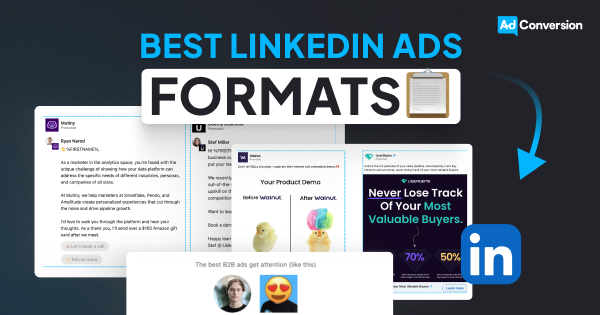
LinkedIn Ad Formats: How to Choose the Best One for Your Campaign
LinkedIn has become an essential platform for B2B marketers, offering a variety of ad formats designed to reach professionals and decision-makers.
But with so many options, how do you choose the right one for your campaign?
In this comprehensive guide, we’ll delve into LinkedIn's diverse ad formats, uncovering detailed insights and actionable best practices.
Whether you're looking to increase brand visibility, generate quality leads, or drive traffic to your website, mastering LinkedIn's ad formats can give you a competitive edge in the market.
TABLE OF CONTENTS:
- Overview of LinkedIn Ad Formats
- Single Image Ads
- Video Ads
- Carousel Ads
- Thought Leader Ads
- Text Ads
- Conversation Ads
- Message Ads
- Spotlight Ads
- Follower Ads
- Document Ads
- Lead Gen Forms
- Connected TV Ads
- How to Choose the Right Ad Format
- How to Measure Performance of Each Ad Format
Overview of LinkedIn Ad Formats
Selecting the right ad format depends on your marketing objectives and target audience.
Let’s explore each primary LinkedIn ad format in detail, and reference this article for all ad specs:
Single Image Ads
Single Image Ads are a staple of LinkedIn advertising.
These ads feature one static image and appear directly in the LinkedIn feed, making them highly visible and engaging.
- High engagement with minimal content.
- Simple to create and easy to manage.
.png)
Pro tip: Use images and copy that resonate with your target audience. The best-performing ones often use your Ideal Customer Profile's (ICP) language or even direct words. Remember, in B2B, we are still advertising to people, not to robots! 😃
Video Ads
Video Ads are perfect for storytelling and driving engagement.
They allow you to share dynamic content that captures attention and conveys your message effectively.
- Excellent for storytelling and capturing attention.
- Engaging format that can explain complex ideas
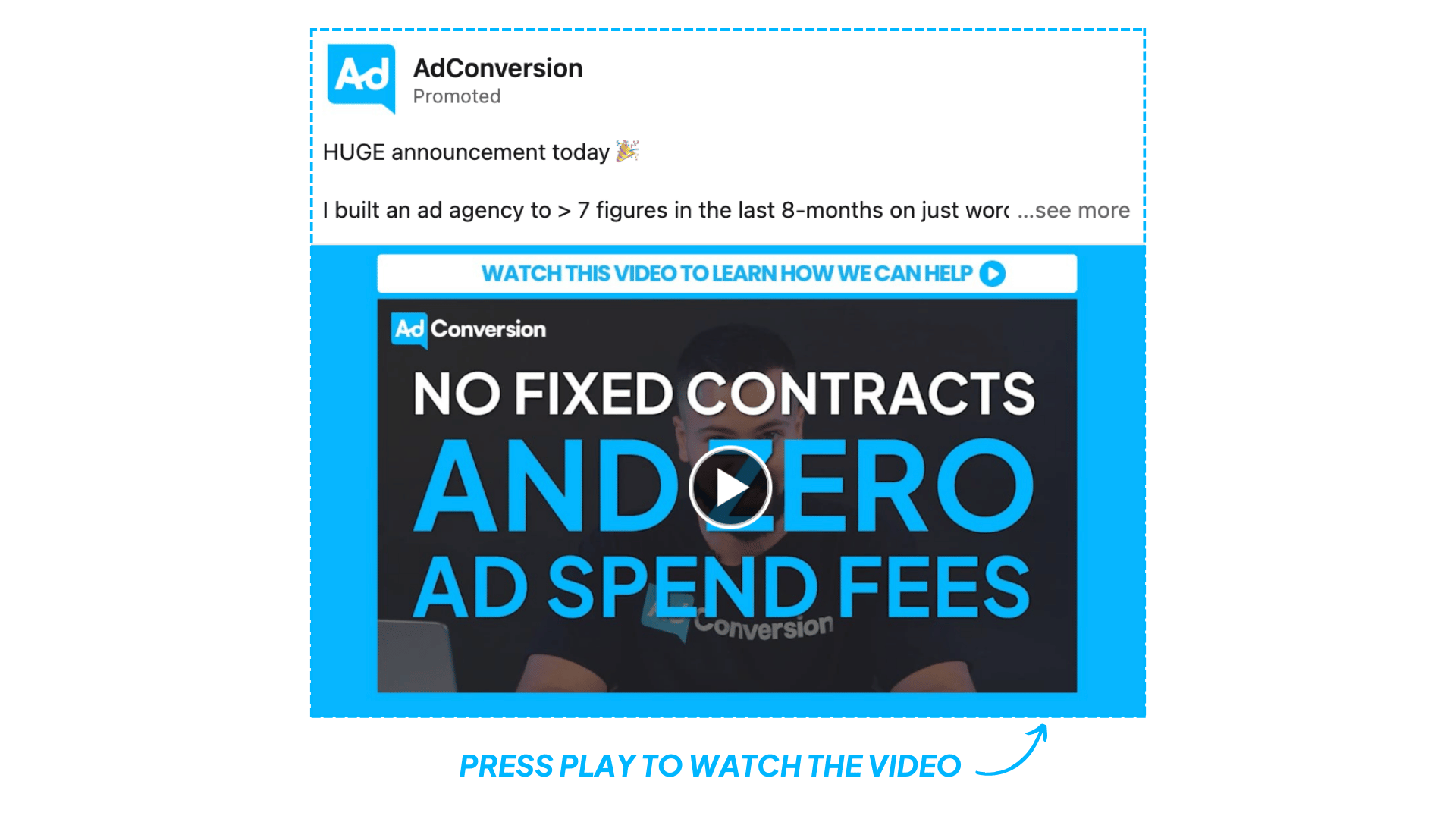
Pro tip: Video ads excel at both brand building and showcasing testimonials. They are particularly effective for demonstrating product functionality. Make sure to add subtitles, the videos usually autoplay on mute.
Carousel Ads
Carousel Ads allow you to showcase multiple images or videos in a single ad unit, each with its link.
This format is ideal for highlighting different aspects of a product or telling a story more interactively.
- Interactive format that encourages engagement.
- Multiple visuals to showcase different products or features.
.gif)
Pro tip: Carousel ads can be used for explaining the product, showcasing use cases and features, or explaining customer success stories in the feed. Ensure you have a consistent flow across all cards.
Thought Leader Ads
Thought Leader Ads are a powerful way to build brand credibility and engage your audience by leveraging the influence of key figures within your organization.
These ads allow you to sponsor posts from your company's thought leaders, positioning them—and by extension, your company—as industry experts.
- Build Credibility: Sponsoring posts from thought leaders enhances your brand's authority and trustworthiness.
- Engagement: These ads typically receive higher engagement rates as audiences are more likely to interact with content from recognized industry experts.
- Content Variety: Showcase a variety of content, from personal insights to industry analysis, that resonates with your audience.
.png)
3 tips for implementing thought leader ads:
- Authenticity: Ensure the content from thought leaders is authentic and reflects their genuine perspectives.
- Consistency: Regularly publish thought leadership content to maintain engagement and visibility.
- Interactive Content: Use content that encourages interaction, such as questions or calls to action, to drive higher engagement rates.
For more insights refer to 14 Powerful LinkedIn Thought Leader Ad Strategies Worth Testing.
Text Ads
Text Ads are simple yet effective.
They appear on the right-hand sidebar of LinkedIn and are great for driving traffic to your website or landing page.
- Cost-effective and easy to set up.
- Ideal for driving traffic to your website.
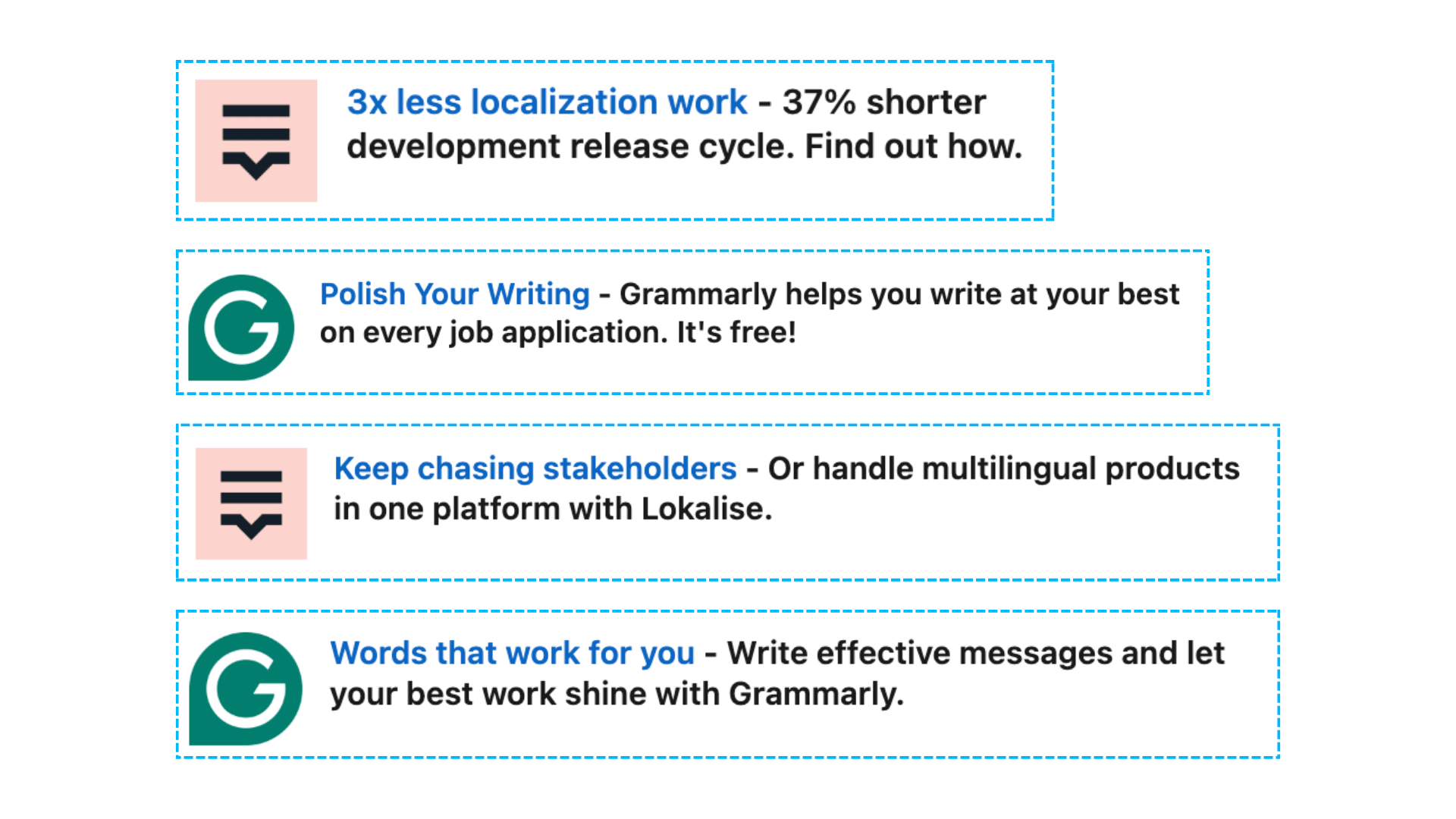
Pro tip: Text ads are very effective, allowing you to stay top of mind at a low cost in front of your target audience. Also, they always help to keep your logo in your ICP’s LinkedIn Feed.
Conversation Ads
Conversation Ads offer an interactive way to engage your audience by allowing recipients to choose their own path through multiple call-to-action buttons.
This format fosters engagement and ensures high visibility in LinkedIn Messaging inboxes.
- Highly engaging format that fosters engagement.
- High visibility in LinkedIn Messaging inboxes.
- Great for generating leads
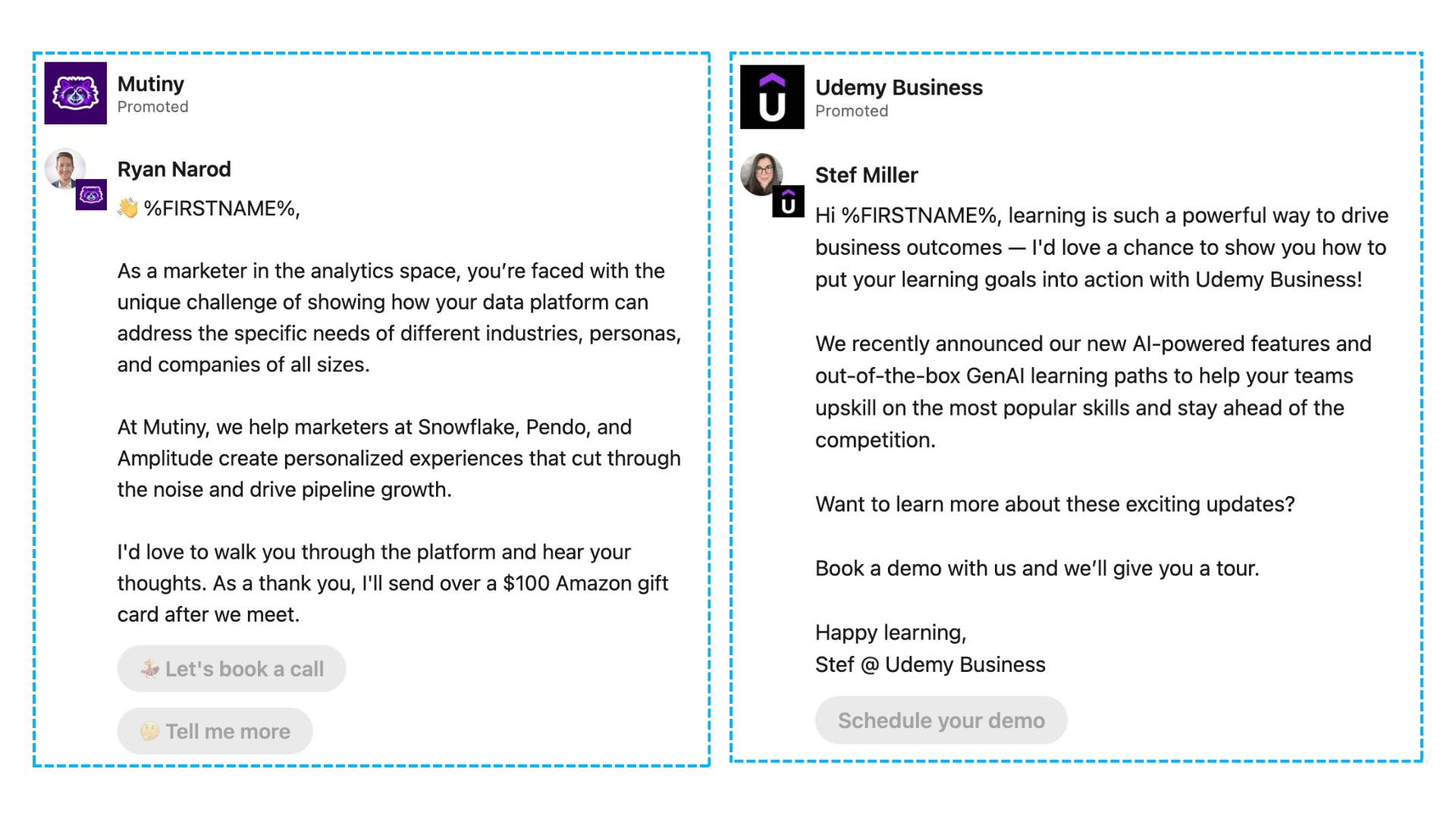
Pro tip: Create engaging and relevant conversation flows tailored to your audience's needs and interests. The message subject can be a game changer for open rates! Also, try incentivized ads, sometimes they can work miraculously 🚀
Message Ads
Message Ads are direct messages sent to LinkedIn members’ inboxes, making them highly personal and effective for driving immediate action.
- High visibility in LinkedIn Messaging inboxes.
- Personalized and direct communication.

Pro tip: Craft personalized messages that speak directly to your target audience’s pain points and offer clear, actionable solutions. Keep the tone to the one that your target audience is using.
Spotlight Ads
Spotlight Ads are personalized ads that appear on the right-hand side of the LinkedIn feed.
These ads use the viewer's LinkedIn profile data, such as their photo, company name, and job title, to dynamically personalize the ad content.
- Lower CPM and High Ad Recall
- Personalized Ad Content
Check out LinkedIn Spotlight Ads In 2024: Are They Worth The Investment? to dive deeper into this ad format.

Pro tip: Spotlight ads are particularly effective for remarketing, allowing you to stay top of mind at a low cost in front of audiences that already know and trust your brand.
Follower Ads
Follower Ads help increase the number of followers for your LinkedIn page, promoting your company to a wider audience.
- Effective in promoting LinkedIn pages to acquire followers.
- Increases organic reach on LinkedIn.
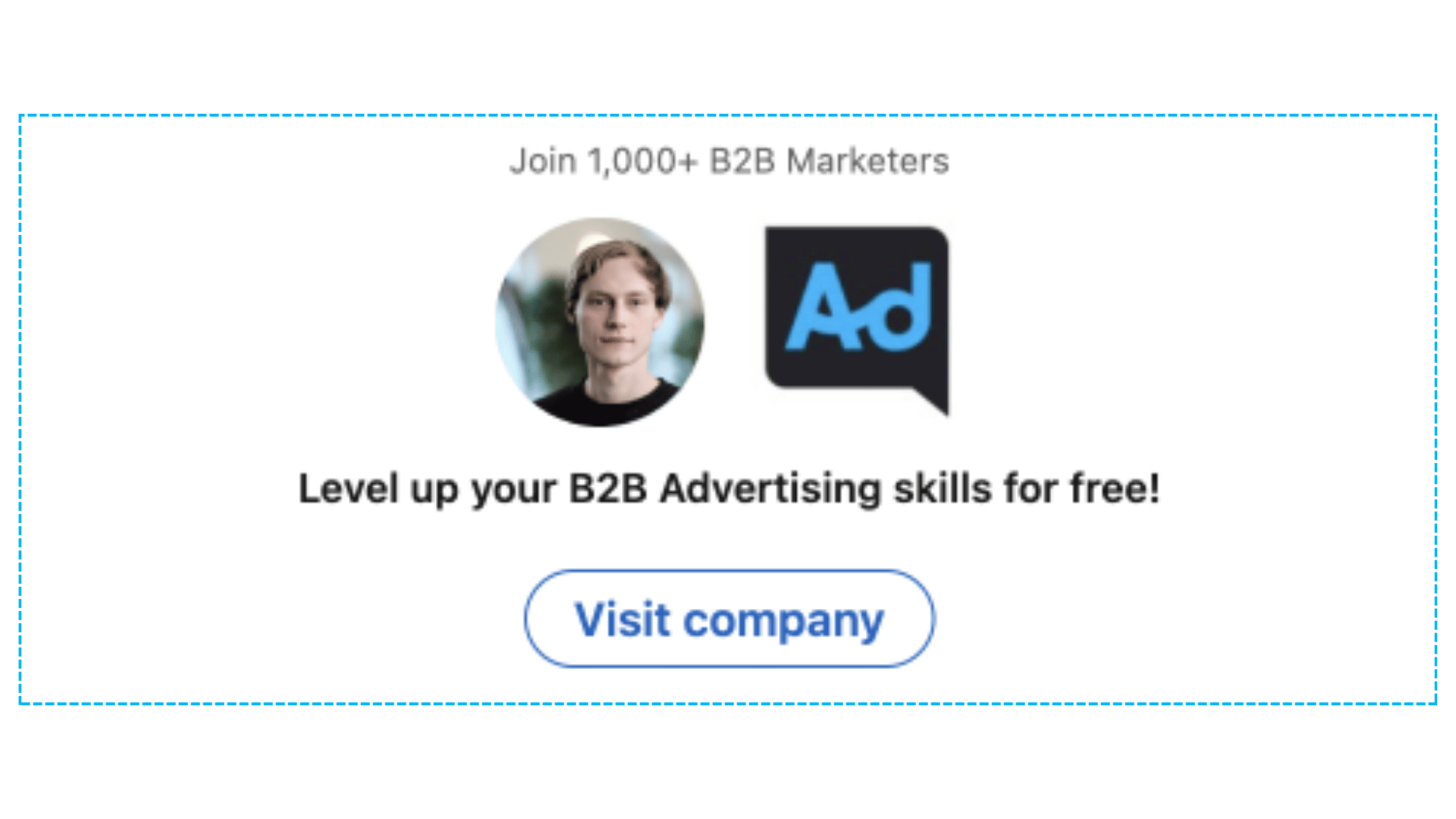
Pro tip: Highlight the unique value your LinkedIn page offers to followers. Use eye-catching visuals and compelling copy that resonate with your target audience.
Document Ads
Document Ads allow you to share in-depth content directly within the LinkedIn feed.
You can share whitepapers, e-books, or case studies that members can view and download without leaving LinkedIn.
- Share in-depth content directly within the LinkedIn feed.
- Options to gate content with a Lead Gen Form to capture leads or share freely to build brand awareness.
.gif)
Pro tip: Offer valuable content that addresses your audience's challenges or interests. Use a strong call-to-action to encourage downloads and interaction with your documents. Some say they prefer Document Ads to Carousel Ads because you can build retargeting audiences for Document ads.
Lead Gen Forms
Lead Gen Forms are a versatile tool that can be used with various ad formats to capture quality leads directly on LinkedIn. These forms are pre-filled with LinkedIn profile data, making it easy for users to submit their information.
- Captures quality leads with pre-filled forms.
- Provides a seamless user experience.
- Can be used for booking demos, downloading guides and templates, event registrations

Pro tip: Minimize the number of fields in your form to reduce friction. Use pre-filled form fields to make it easier for users to submit their information quickly. Don’t use “work mobile” or “work email” because they are usually not pre-filled.
Connected TV Ads
Connected TV Ads allow you to reach professional audiences through streaming content.
These ads appear on connected TV platforms and are ideal for reaching a hard-to-reach professional audience in a large-screen environment.
- Reach professional audiences through streaming content.
- High visibility on large screens.

For detailed ad specifications and additional tips, check out 50+ Ad Specs for The Top 10 Ad Platforms.
How to Choose the Right Ad Format
Choosing the right LinkedIn ad format is crucial for achieving your marketing goals. Here’s a guide to help you align your campaign objectives with the most effective ad formats and measure their performance.
What's Your Primary Campaign Goal?
First, identify your primary campaign goal. Are you aiming to capture demand, create demand, accelerate open cases, or brand awareness?
How to Measure Performance of Each Ad Format
Effectively measuring the performance of your ad campaigns is key to optimizing and achieving your marketing goals.
Here are the KPIs and bidding recommendations for each ad format:
By aligning your ad formats with your campaign goals and following these tips for measuring performance, you can create more effective LinkedIn ad campaigns that drive results and maximize your ROI.
You can read more about Objectives and Bid strategies here.
Hope you found this article helpful! Connect with me on LinkedIn, and reach out with any questions.
Master B2B LinkedIn Ads with these 3 Free Courses:
If you want to become a LinkedIn Ads pro, check out our free B2B LinkedIn Ads courses, where you'll learn how to launch, optimize, and scale your campaigns to drive pipeline and revenue.

Here's what you'll learn in each course:
⚙️ B2B LinkedIn Ads 101 - The Ultimate Crash Course for New LinkedIn Advertisers
- Foundations For LinkedIn Ads Success
- Measurement: Tracking & Key Principles
- Targeting: Reaching Your Dream Buyers
- Ads: Mastering The 9 Ad Formats
🎯 B2B LinkedIn Ads 102 - The Blueprint for LinkedIn Ads Optimization
- Monitoring: How To Spot Performance Trends
- Auditing: How To Find The Darlings You Need To Kill
- Reporting: How To Transform Data Into Insights
- Optimization: How To Make Your LinkedIn Ads Profitable
🚀 B2B LinkedIn Ads 103 - Advanced Scaling Strategies From $25M In Ad Spend
- Concepts of Scaling
- Divide and Conquer
- Learnings From $25M+ In LinkedIn Ad Spend
Click Here to Join 1,000+ B2B Marketers Today and start leveling up your advertising skill set.
Takes < 90 seconds to sign up (seriously we timed it 😂)
People Also Ask
What are the different ad formats available on LinkedIn?
LinkedIn offers various ad formats, including Single Image Ads, Video Ads, Carousel Ads, Thought Leader Ads, Text Ads, Conversation Ads, Message Ads, Spotlight Ads, Follower Ads, Document Ads, Lead Gen Forms, and Connected TV Ads. Each format serves distinct marketing objectives and engages audiences differently. 
How do Single Image Ads function on LinkedIn?
Single Image Ads feature a static image and appear directly in users’ LinkedIn feeds. They are designed for high engagement with minimal content and are simple to create and manage. 
What are the benefits of using Video Ads on LinkedIn?
Video Ads are ideal for storytelling and capturing attention. They allow you to share dynamic content that effectively conveys your message and engages your target audience. 
How can Carousel Ads enhance my LinkedIn advertising strategy?
Carousel Ads enable you to showcase multiple images or videos within a single ad unit, each with its own link. This format is perfect for highlighting different aspects of a product or telling a more interactive story. 
What are Thought Leader Ads, and how can they benefit my LinkedIn campaigns?
Thought Leader Ads allow you to sponsor posts from your company’s thought leaders, positioning them—and by extension, your company—as industry experts. This approach builds credibility and fosters trust with your target audience.

10 Expert Tips For Scaling Google Ads Demand Capture
Do you need to scale your paid search campaigns and find new ways to increase demand capture?
As the head of Marketing at Catalyst, I build and mentor teams to maximize ROI in paid ad channels including Google.
Here’s my top 10 tips & tactics to scale your Google ads efforts.
(In no particular order, they all matter)
TABLE OF CONTENTS:
- Tip #1 - Leverage Dynamic Keyword Insertion (DKI)
- Tip #2 - Tap into Device & Location Bid Modifiers
- Tip #3 - Shift Towards Smart Bidding ASAP
- Tip #4 - Sync Your CRM with Google Ads
- Tip #5 - Steer Away From Broad Match As Much As Possible
- Tip #6 - Take Advantage of the Google Ads Editor
- Tip #7 - Lean on Google Ads Script & Rules
- Tip #8 - Exclude Search Partners & Display Network
- Tip #9 - Install Behavioral Analytics Tools for Landing Page Optimizations
- Tip #10 - Consider Bing as a Second Demand Capture Channel
Tip #1 - Leverage Dynamic Keyword Insertion (DKI)
DKI is a powerful method to improve the relevancy of your ads based on user search terms.
When managing ad groups with multiple keywords on a similar theme, this technique ensures that you are displaying ads that closely align with users' query terms.

How Dynamic Keyword Insertion Works:
DKI automatically updates the ad’s headline to include the exact keywords that triggered the ad.
This way, the ad's first impression is highly relevant to the user's search, which improves overall engagement.
Even a slight increase in click through rate (CTR) can impact the performance of a campaign by driving more traffic to the landing page.
Best Practices for Using Dynamic Keyword Insertion:
Prioritize the First Headline: Always aim to have the first headline of your ad matches as closely as possible to the user’s search query.
Group Keywords by Theme: Make DKI more effective by grouping your keywords by themes.
There are generally 6 buckets of themes for search ads:
- Brand
- Non-brand
- Competitive
- RLSA (Search Remarketing)
- Content
- Dynamic Search Ads
With this organization, DKI can create more coherent ads that display the most relevant headline for each bucket.
Tip #2 - Tap into Device & Location Bid Modifiers
A critical aspect often overlooked in Google ads is the optimization of device and location modifiers.
For most B2B SaaS campaigns, the quality of traffic can vary significantly across different devices.
Desktop vs. Mobile vs. Tablet:
Typically, desktop traffic yields the highest quality in terms of conversion rates and user intent.
Users on desktops are generally more engaged and possibly in a professional setting, compared to mobile users who might be multitasking or browsing casually.
Tablets often perform the worst in terms of conversion rates and traffic quality, which is why many advertisers choose to exclude them entirely from campaigns.
Strategic Use of Location Modifiers:
If you target several states or countries, you should modify your bids based on the areas that perform best.
This could mean adjusting bids upward in high-performing regions to capture more traffic or decreasing bids in lower-performing areas to conserve budget.
In extreme cases, you can exclude low-performing regions altogether.

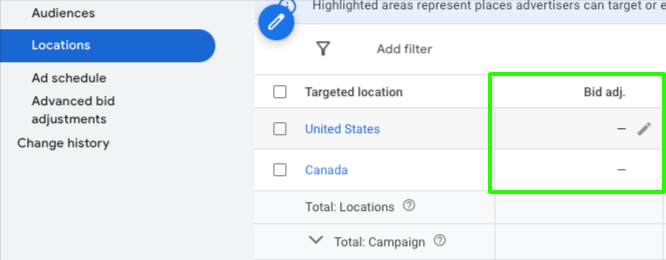
Pro Tip:
Start with a conservative approach focused on proven strategies. As results come in and budget allows, gradually introduce new variables and expand your focus to optimize the overall campaign performance. Maintain detailed records of campaign performance across different devices and platforms. This data will be invaluable for making informed decisions about where to allocate resources most effectively.
Tip #3 - Shift Towards Smart Bidding ASAP
Smart bidding strategies can help improve campaigns’ performance by focusing on conversions rather than clicks.
The Maximum Conversion strategy is particularly effective, as it lets Google optimize your bids to meet a specific CPA target, ideal for campaigns with regular conversions.

Key Considerations for Smart Bidding:
Google recommends having at least 30 conversions per month to effectively utilize Target CPA.
However, for campaigns with lower conversion rates, setting a minimum threshold of 10-15 conversions can still be sufficient.
Ensure that your conversions are properly set up and that Google receives clear signals about which conversions to prioritize by setting specific values for each conversion action.
This is crucial for smart bidding algorithms to function properly, as mixed signals can dilute the focus of your campaign optimization.
Pro Tip:
For businesses, especially in B2B sectors where conversion volumes are low, it's important to track higher funnel events. These can include engaged visits, interaction with forms, and even form abandonment. Each of these steps can be set through Google Tag Manager (GTM), providing richer data for optimization. Apply a structured conversion funnel that captures various stages of user engagement. From initial website interaction to form submissions or CRM entries, each stage should be defined and tracked as separate conversion events. You can then design custom goals and bundle your conversion actions together to add them to your campaigns.
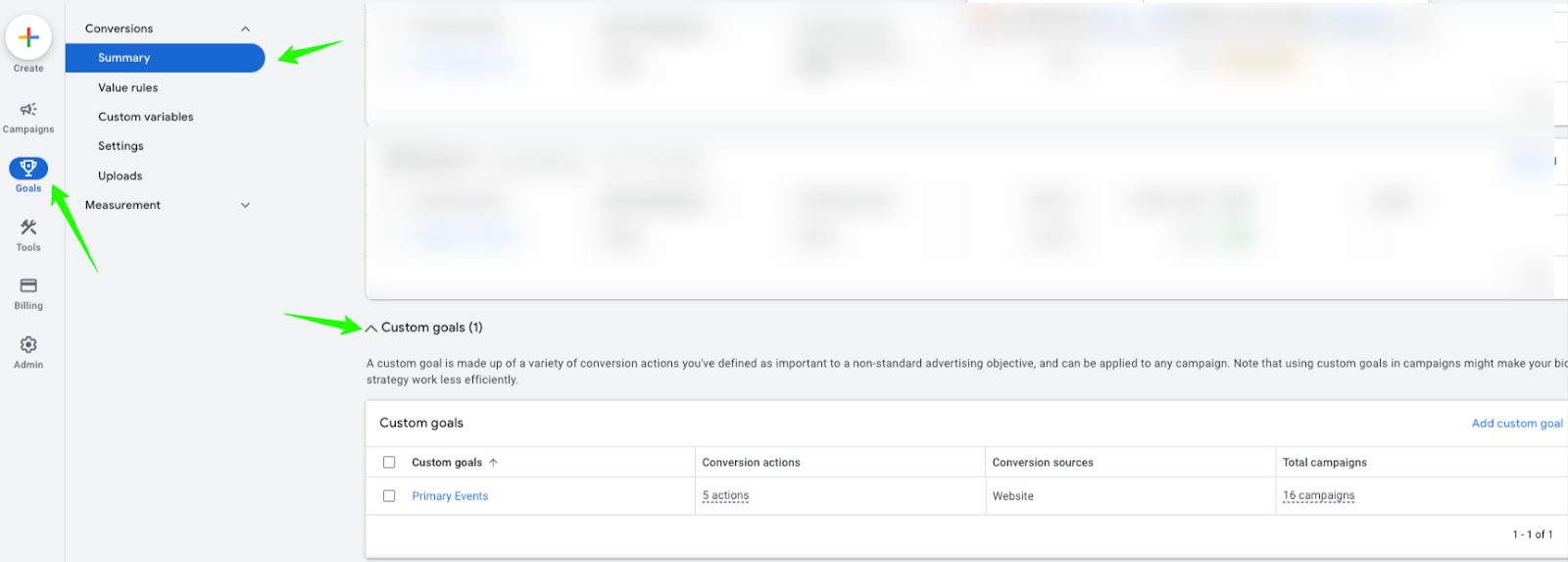
Tip #4 - Sync Your CRM with Google Ads
Performance marketers thrive on optimizing for meaningful conversions. It will take emotions out of the decision-making process.
Integrating CRM lifecycle stages into Google Ads can profoundly impact your ad optimization and overall marketing strategy.
By linking stages such as MQL (Marketing Qualified Lead), SQL (Sales Qualified Lead), opportunities, and customer status directly from a CRM platform like HubSpot, you enable a more nuanced and powerful approach to ad targeting and bid adjustments.
How to Implement Your CRM Sync:
Depending on your CRM system, various tools and plugins can facilitate this integration. Ensure that the tool you choose can sync data reliably and in real-time to maintain accuracy in your campaigns.
Define which CRM milestones are important for your campaigns and set Google Ads to track these as conversions
Use the data from your CRM to set up automation rules in Google Ads. For example, you could decrease bids or pause campaigns if the cost per SQL exceeds a certain threshold, ensuring you maintain profitability.
Regularly review the data flow and synchronization between Google Ads and your CRM to ensure accuracy. Adjust your strategies based on new insights and continually refine your approach to improve outcomes.
Tip #5 - Steer Away From Broad Match As Much As Possible
Broad match can drive a high volume of traffic due to its extensive reach. This can result in a large number of conversions, which initially might seem cost-effective.
However, the quality of these conversions often needs to be revised when scrutinized more deeply in the sales funnel.
Despite lower upfront costs, the conversions from broad match often fail to convert into valuable leads or sales.
They may also attract clicks from irrelevant queries, leading to wasted ad spend and diluted performance metrics.
Best Practices for Keyword Match Types:
Phrase match offers a balance by allowing your ad to show only when a searcher's query includes the exact phrase or close variations of the phrase, in the same order. This strikes a better balance between reach and relevance, providing more control than Broad match type.
Exact match targets queries that are much closer to the keywords.
While this reduces reach, it increases the relevance and quality of traffic, making it ideal for targeting high-intent users and optimizing conversion rates.
Regardless of the match type used, a comprehensive negative keyword list is crucial.
Finally, test different match types to see what works best for your specific campaigns. This could mean comparing the performance of Phrase match versus Exact match or testing different variations of your keywords.
Tip #6 - Take Advantage of the Google Ads Editor
Google Ads Editor is an indispensable tool for marketers aiming to streamline their campaign management processes.
This desktop application allows users to manage their Google Ads campaigns offline, offering robust functionalities for bulk editing and optimization.
Google Ads Editor is particularly advantageous for managing large accounts with numerous campaigns and extensive lists of keywords.
Best Practices for Using Google Ads Editor:
Develop a standardized template with predefined columns and settings that align with your campaign's requirements.
This setup ensures that you can quickly import data from spreadsheets directly into Google Ads Editor without compatibility issues.
Always synchronize Google Ads Editor with your online account to ensure all changes are up-to-date and to avoid discrepancies between offline edits and online status.
Before uploading changes to the live environment, use the review function to ensure accuracy and prevent potential errors from impacting your campaigns.
While Google Ads Editor is incredibly powerful, it does have a learning curve.
Invest time in learning its features and shortcuts.
Tip #7 - Lean on Google Ads Script & Rules
Automation is a key component in optimizing campaigns. Google Ads scripts and rules offer powerful tools to automate routine tasks and strategic operations.
Scripts allow for advanced, customized automation that can modify bids, pause ads, or adjust budgets based on specific conditions.
Rules can be set to trigger based on performance metrics such as CTR, conversion rates, or cost per acquisition.
For example, automatically increasing the budget for high-performing campaigns or reducing bids for underperforming keywords helps maintain efficient spending.
Utilize scripts to automatically apply a tracking template across all campaigns, incorporating dynamic elements like campaign and ad group names.
This will detach personal bias from campaign management. Scripts and rules operate based on data, not preference, enabling objective decisions that focus solely on performance metrics.
You must regularly review the outcomes of automated actions. Automation is powerful, but it requires oversight to ensure it aligns with changing campaign goals and market conditions.
Tip #8 - Exclude Search Partners & Display Network
When managing Google Ads, especially for substantial budgets, it's crucial to ensure that every dollar spent is driving quality traffic and conversions.
A common oversight is not excluding search partners and the display network from search campaigns.
While these features can increase visibility, they often compromise the quality of traffic and the overall effectiveness of your campaigns.
Understanding the Impact by Network:
Including Search Partners and Display Networks can inflate your impressions without a corresponding increase in clicks.
This dilution of CTR can harm your campaign's overall performance metrics, misleading you about its effectiveness.
Google's quality score is a critical metric in determining your ad rank and the cost per click (CPC) you pay.
A lower CTR resulting from irrelevant impressions on search partners and display networks can decrease your quality score, leading to higher costs and reduced ad placement.
Pro Tip:
Conduct regular audits of your Google Ads accounts to identify any inefficiencies or overlooked settings that could be draining your budget or diminishing your campaign’s effectiveness. While Google may provide recommendations, always assess them critically in the context of your specific campaign goals and historical data. Consider experimenting with settings on a smaller scale before applying them broadly, especially when dealing with large budgets. This cautious approach allows you to gather data and make informed decisions based on actual performance metrics.
Tip #9 - Install Behavioral Analytics Tools for Landing Page Optimizations
One of the most effective strategies for enhancing landing page effectiveness is to implement behavioral analytics tools, such as Hotjar or Microsoft Clarity.
These tools provide deep insights into how users interact with your page, allowing for data-driven improvements.
The Importance of Behavioral Analytics:
Most of these tools offer features like heatmaps, scroll tracking, and session recordings that reveal how users interact with your landing page.
You can identify which parts of the page attract the most attention and where users lose interest.
You can make informed decisions about layout adjustments, content placement, and calls to action.
For instance, if users frequently abandon a form, you might simplify it or adjust its placement on the page to increase completion rates.
Use the insights gathered to A/B test different versions of your landing page.
Pro Tip:
Before implementing any changes based on behavioral data, be clear about what you’re trying to improve. Having specific goals will guide your optimization efforts, whether it's increasing time spent on the page, reducing bounce rate, or boosting form submissions. Combine quantitative data from analytics tools with qualitative feedback from user surveys or feedback forms. Keep a detailed record of all changes made and the results they yield. This documentation will help you understand what works, what doesn’t, and how future landing pages can be designed for maximum impact.
Tip #10 - Consider Bing as a Second Demand Capture Channel
To extend the reach of your successful Google Ads campaigns without significantly increasing your budget, consider importing your best campaigns into Bing Ads.
Bing, while smaller than Google, still captures a unique audience segment that may not overlap completely with Google users. This can increase your campaign's overall reach and exposure.
Generally, competition on Bing is lower than Google Ads, leading to lower cost-per-click (CPC) rates.
Hope you found these 10 tips helpful!
For more tips or to connect, please reach out via LinkedIn.
From Clicks to Conversions: Master Google Ads for B2B 🔥
If you want to become a Google Ads pro, check out our free B2B Google Ads courses, where you'll learn how to launch, optimize, and scale your campaigns to drive pipeline and revenue.

Here's what you'll learn in each course:
⚙️ B2B Google Ads 101 - How to Launch Dangerously Effective Campaigns for Beginners
- The Googleverse: The Game You're Playing & How To Win
- Measurement: How to Make Sure You're Profitable
- Targeting: How to Show Up For the Right Searcher
- Planning: Putting It All Together
🎯 Google Ads 102 - How to Clicks Into Profit
- Visibility: How To Find the Hole Sucking Profits
- Workflows: How to Optimize On a Daily, Weekly, Monthly & Quarterly Basis
- Experimentation: How to Test & Automate Profitability
- Troubleshooting: How To Solve Inevitable Problems
🚀 Google Ads 103 - How to Scale Google Ads For Advanced Advertisers
- Methodology: How to Vertically Scale Google Ads From A-Z
- Campaigns: Scaling Horizontally Through Campaign Themes
- Channels: Scaling Outside of Paid Search
Click Here to Join 1,000+ B2B Marketers Today and start leveling up your advertising skill set.
Takes < 90 seconds to sign up (seriously we timed it 😂)
People Also Ask
How can Dynamic Keyword Insertion (DKI) enhance my Google Ads performance?
DKI automatically updates your ad’s headline to include the exact keywords that triggered the ad, increasing relevance and engagement by closely aligning with user search terms. 
What are the benefits of using device and location bid modifiers in Google Ads?
Adjusting bids based on device and location allows you to allocate budget more effectively, ensuring your ads reach the most relevant audience segments and improving overall campaign performance. 
Why should I consider implementing smart bidding strategies in my campaigns?
Smart bidding utilizes machine learning to optimize bids for each auction, enhancing conversion rates and return on investment by automatically adjusting bids based on performance data. 
How does integrating my CRM with Google Ads contribute to demand capture?
Syncing your CRM with Google Ads enables precise tracking of leads and conversions, allowing for more accurate measurement of campaign effectiveness and better-informed optimization decisions. 
What role do Google Ads scripts and rules play in campaign optimization?
Utilizing scripts and rules automates routine tasks and strategic operations, such as modifying bids or adjusting budgets based on specific conditions, leading to more efficient and effective campaign management.
.jpg)
10 Proven SaaS LinkedIn Ads Tips To Drive More ROI
Want to drive qualified pipeline and revenue from your LinkedIn Ads campaigns?
I’ve worked with 50+ startups, and managed 7-figure LinkedIn ads budgets for B2B SaaS.
My goal with this article is to show you ten proven tips for improving your LinkedIn ads ROI.
Irrelevant of the order, all of these tips have equal importance.
Let’s jump into it! 🚀
TABLE OF CONTENTS:
- Tip #1: Use auto bidding for the first 7 days of a new campaign
- Tip #2: Never use the Audience Network
- Tip #3: Penetrate your audience with the reach objective
- Tip #4: Leverage exclusions for focus
- Tip #5: Job functions give you best visibility and reach
- Tip #6: Always start with even rotation upon launch
- Tip #7: Check your demographics report weekly
- Tip #8: Target mobile devices exclusively with 628 x 1200
- Tip #9: Review your performance by device
- Tip #10: Use LinkedIn’s bulk import and export feature
Tip #1: Use auto bidding for the first 7 days of a new campaign
When launching a new LinkedIn Ads campaign start with automated bidding for the first week.
The thought process behind this is it will give LinkedIn’s algorithm enough time to learn and give you an average bid of what it takes to win auctions for your target audience.
After the first week switch to manual bidding and set the bid amount 20% lower than your average.
This works almost 99% of the time allowing you significant cost per click reductions.
Once you make the switch keep an eye on your daily spend over the next five days, if you set your bids too low it can negatively impact your visibility.
The key is to find the optimal bid between cost and maximum visibility (ex: impressions, views).
Give it a shot and send me a DM on LinkedIn with how much money you save! 🤑
This tip applies to traffic and conversion campaigns.
Tip #2: Never use the Audience Network
This one might be a bit controversial, but no matter what you LinkedIn reps say this is a no no.
If you’re not familiar, the LinkedIn audience network is a conglomerate of website partners.
This allows you to distribute your content outside of LinkedIn and on their websites.
Sounds amazing in theory but in practice the problem with the audience network is:
🔴 90-95% of your ENTIRE LinkedIn Ads budget is spent on websites outside of LinkedIn
Which completely destroys the point of running LinkedIn ads in the first place 😂
The LinkedIn algorithm always prioritizes the audience network because it’s cheaper and it’s trying to optimise for the greatest number of impressions for the lowest cost with your budget.
I’ve personally tested the audience network over multiple quarters with the same exact campaign and the only difference is one is using the audience network and other isn’t.
The campaign using the audience network had a CTR of 0.03% compared to 1% without.
You also have no ideas which websites placed your ads as it’s a black box.
Save your budget and improve your ROI by turning it off.
Tip #3: Penetrate your audience with the reach objective
If you’re trying to reach a large audience (ex: target account list) and want to do so in the most cost effective way, leverage the reach campaign objective.
Obviously if you’re trying driving the most clicks then this tip wouldn’t be applicable.
Instead in that case you should focus on using the website visits objective.
The caveat here is if you truly know:
- Your ideal customer profile
- That your content resonates with them
Then you can make the case that these people will click through anyways regardless of objective.
Through testing I’ve found that if you have great content using reach you’ll actually serve towards more people and generate more net new clicks given the reduction in CPM costs.
The major benefit of reach is that it is optimised for driving more unique impressions per viewer.
Pro tip:
Contact your LinkedIn Ads rep to send you a report on audience penetration on a monthly and quarterly basis to see how many unique users you’re reaching in your target audience.
Tip #4: Leverage exclusions for focus
Most LinkedIn advertisers underestimate the power of exclusions.
It’s one of those things most leveraged but not to its fullest capability.
Everyone knows you need to exclude the obvious things like competitors, students, customers, etc…
But they haven’t built the habit of checking LinkedIn Demographics Report once per week to find irrelevant titles for exclusion.
It’s really important to be mindful of multiple current roles when excluding as you can accidentally block your ads from being visible from high value audience members.
For example, let’s say you only help businesses with more than 1,000 employees.
Conventional logic would be exclude people who work at companies with < 1,000 employees but what happens when your perfect prospect:
- Volunteers at a nonprofit organization with < 100 employees
- Started a side hustle that only has with a size of “myself only”
The answer is, they won’t see your ads.
Remember that exclusions are always prioritised over inclusions.
When excluding focus on using job titles to refine your audience and prevent accidental conflicts.
Tip #5: Job functions give you best visibility and reach
This point is a bit controversial but from my own testing I’ve found job functions give you better visibility and reach than job titles.
This doesn’t mean you should never use job title targeting, I’ve actually found for certain personas titles work better than functions but if you’re in the following scenario:
- Targeting a high value account list
- Promoting ads that speak to a general pain point/benefit
- Your ideal audience has a million variations of the same title
Then you’re better off using job functions to reach as many relevant audience members.
Here’s some great combinations of job function targeting to test:
- Job functions AND seniority
- Job functions AND seniority AND member skills OR interest
Make sure you’re checking your demographics report on a weekly basis to find all the irrelevant job titles you’re reaching and exclude them on an ongoing basis.
This process can take up to two and half months but the goal is to eventually get to the point where you only see relevant titles inside of the demographics report.
Highly recommend excluding unpaid, training, and entry seniority as a starting point.
Pro tip:
Study LinkedIn profiles of your best prospects and take note of the member skills, certifications, and schools they’ve listed to find commonalities for targeting.
Tip #6: Always start with even rotation upon launch
When launching your new campaigns you have the option to choose how to serve your ads.
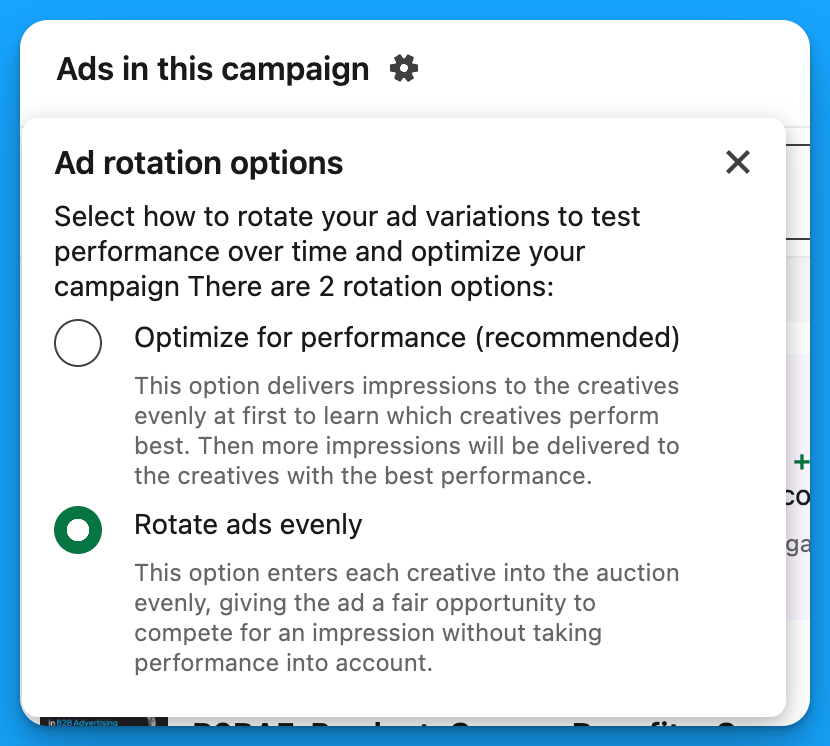
The thought process behind this is you want to understand which ad will perform the best by receiving enough budget for proper testing.
Unfortunately if you start with optimising for performance LinkedIn will prematurely assign 40-50% of your budget to one variation of ad while the others only receive what’s remaining.
In order to avoid this, start with rotating ads evenly for the first 7-14 days when launching a new campaign to serve budget equally and then switch to optimise for performance.
Tip #7: Check your demographics report weekly
I’ve hinted at this multiple times across all these tips but it’s so important to driving a return on investment with LinkedIn Ads that it deserves to be its own tip.
You need to know what’s happening across your account.
Review your demographics report for:
- Ad performance
- Campaign performance
- Campaign group performance
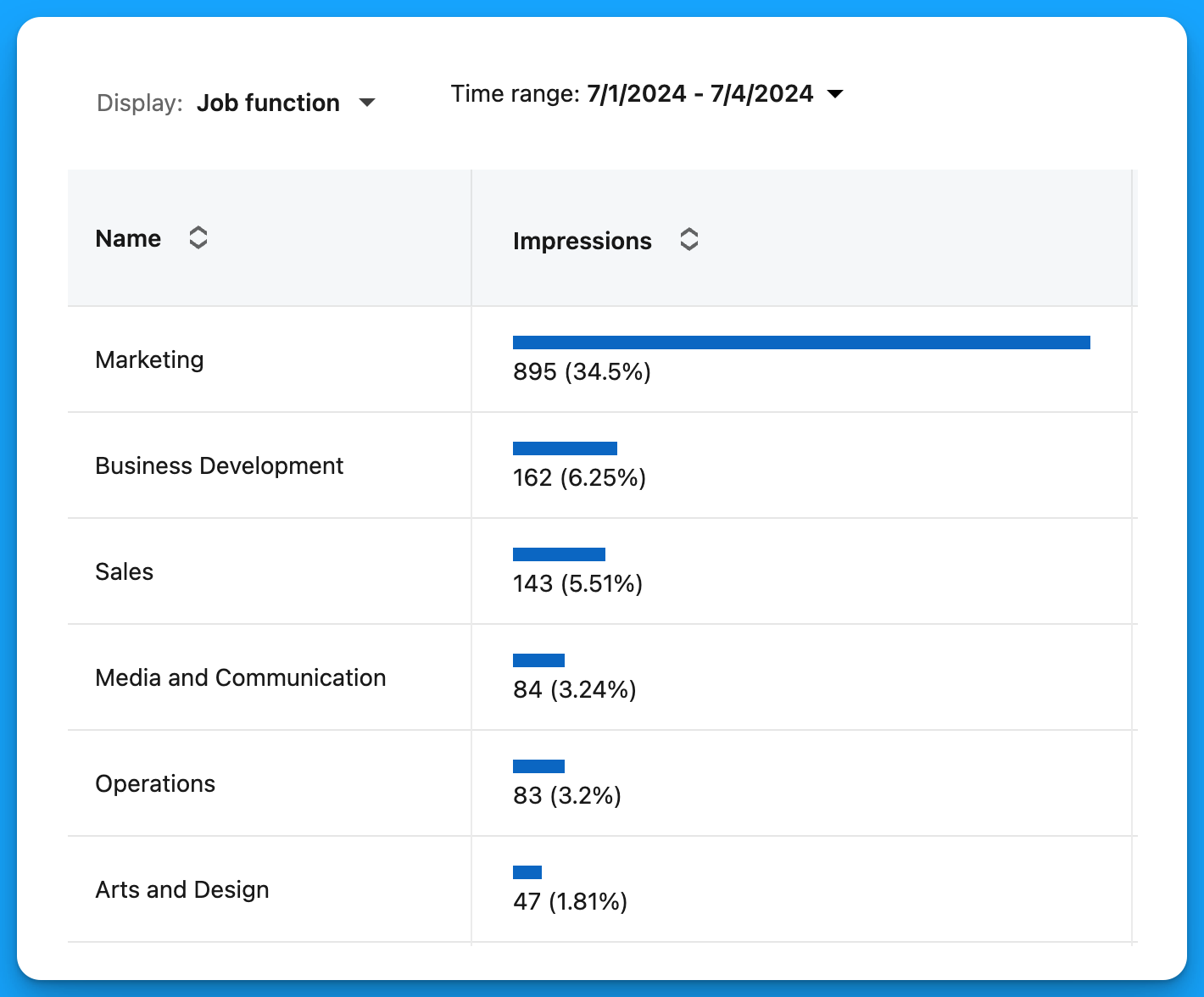
This will ensure your budget is going towards reaching the right people and companies.
Pro tip:
LinkedIn has reporting minimums when using the demographics report in platform, get around this by using a third party data connector to push the data into G-Sheet or Looker.
Tip #8: Target mobile devices exclusively with 628 x 1200
LinkedIn has a 628x1200 image ad spec that allows you to only appear on mobile devices.
If you know that your audience performs well for you on mobile devices you can set up a campaign leveraging this specific image ad dimension to serve exclusively on LinkedIn mobile.
The same is true for targeting desktop devices with text or spotlight ads.
Learn more about your audiences device behaviour with Google Analytics 4:

Tip #9: Review your performance by device
You can review your performance in LinkedIn by clicking on Breakdown > Impression by Device Type
The AdConversion team analysed 10,000,000+ impressions and found:
- 85.1% of impressions serve on Mobile App
- 9.6% of impressions serve on Desktop Web
- 5.3% of impressions serve on Mobile Web
That’s 90.4% of total impressions serving on mobile devices! 🤯

Pro tip:
Use the LinkedIn Ads preview to see what your ad will look like when displayed on mobile and optimise your copy to best fit this device over desktop.
Tip #10: Use LinkedIn’s bulk import and export feature
This tip is one that even my most savvy marketing friends aren’t aware of.
Changing bids, and creating campaigns on LinkedIn is a REAL pain.
You don’t need to suffer this pain and instead can use LinkedIn’s bulk import and export feature.
You can simply just export your ads, campaigns, or groups to make bulk changes.
Voila, a task that would take hours has been cut down into minutes.
Learn more about bulk actions in this article by LinkedIn.
Hope you found these 10 tips valuable! 👏
Implement the ones that resonate most with you to improve your ROI from LinkedIn Ads.
Connect with me on LinkedIn, if you have any questions or want to connect!
Master B2B LinkedIn Ads with these 3 Free Courses:
If you want to become a LinkedIn Ads pro, check out my free B2B LinkedIn Ads courses, where you'll learn how to launch, optimize, and scale your campaigns to drive pipeline and revenue.

Here's what you'll learn in each course:
⚙️ B2B LinkedIn Ads 101 - The Ultimate Crash Course for New LinkedIn Advertisers
- Foundations For LinkedIn Ads Success
- Measurement: Tracking & Key Principles
- Targeting: Reaching Your Dream Buyers
- Ads: Mastering The 9 Ad Formats
🎯 B2B LinkedIn Ads 102 - The Blueprint for LinkedIn Ads Optimization
- Monitoring: How To Spot Performance Trends
- Auditing: How To Find The Darlings You Need To Kill
- Reporting: How To Transform Data Into Insights
- Optimization: How To Make Your LinkedIn Ads Profitable
🚀 B2B LinkedIn Ads 103 - Advanced Scaling Strategies From $25M In Ad Spend
- Concepts of Scaling
- Divide and Conquer
- Learnings From $25M+ In LinkedIn Ad Spend
Click Here to Join 1,000+ B2B Marketers Today and start leveling up your advertising skill set.
Takes < 90 seconds to sign up (seriously we timed it 😂)
People Also Ask
How can I effectively research my customers to improve LinkedIn Ads targeting?
To gain a deeper understanding of your customers, watch 3-5 sales calls recommended by your Head of Sales. Analyze how the sales team presents the product and ensure your messaging aligns. Additionally, use tools like ChatGPT to develop content matrices and empathy maps from call transcripts, summarizing top pain points of your prospects. 
What strategies can I use to distribute and repurpose content for LinkedIn Ads?
Distribute valuable content that addresses your audience’s pain points and showcases your expertise. Repurpose high-performing content into different formats, such as turning a blog post into a video or infographic, to reach a broader audience and maintain engagement. 
How can I leverage Subject Matter Experts (SMEs) in my LinkedIn Ads?
Utilize your SMEs for thought leader ads by having them post insightful content on their personal profiles. Promote these posts through your company’s LinkedIn Ads to build credibility and trust with your target audience, positioning your brand as an industry leader. 
What tracking setup is recommended for LinkedIn Ads?
Implement a comprehensive tracking system that combines LinkedIn’s Insight Tag with your CRM and marketing automation platforms. This setup enables accurate tracking of leads and conversions, providing valuable data to optimize your campaigns effectively. 
Why is a long-term commitment important for LinkedIn Ads success?
Committing to at least six months allows sufficient time to test, learn, and optimize your LinkedIn Ads campaigns. This duration helps in understanding what resonates with your audience and enables continuous improvement, leading to better results over time.

4 Unique LinkedIn Ad Strategies To Drive More Webinar Registrations
Webinars can be amazing generators of pipeline and revenue.
They allow you to demo different use cases of your product, highlight success stories, and start actual conversations with your ICP.
But it’s hard to get prospects interested when you’re competing against a million different ads popping up in their feed.
Below are 4 unique LinkedIn ad strategies that I like to use to stand out and generate more registrations👇
TABLE OF CONTENTS:
- Strategy #1: Leverage your thought leaders
- Strategy #2: Boost high-performing social media content
- Strategy #3: Create a LinkedIn event
- Strategy #4: Use incentives
Strategy #1: Leverage your thought leaders
Ask your thought leaders who are participating in the webinar (from your company & other companies) if they’d feel comfortable posting about it.
If the answer is yes, draft a sample post for each of your thought leaders so that they don’t have to start with a blank page.
Ideally, they should post a couple weeks prior to the webinar date. After 4 or 5 days (once the organic reach has died down), you can boost the post to your ICP.
Example from DoWhatWorks
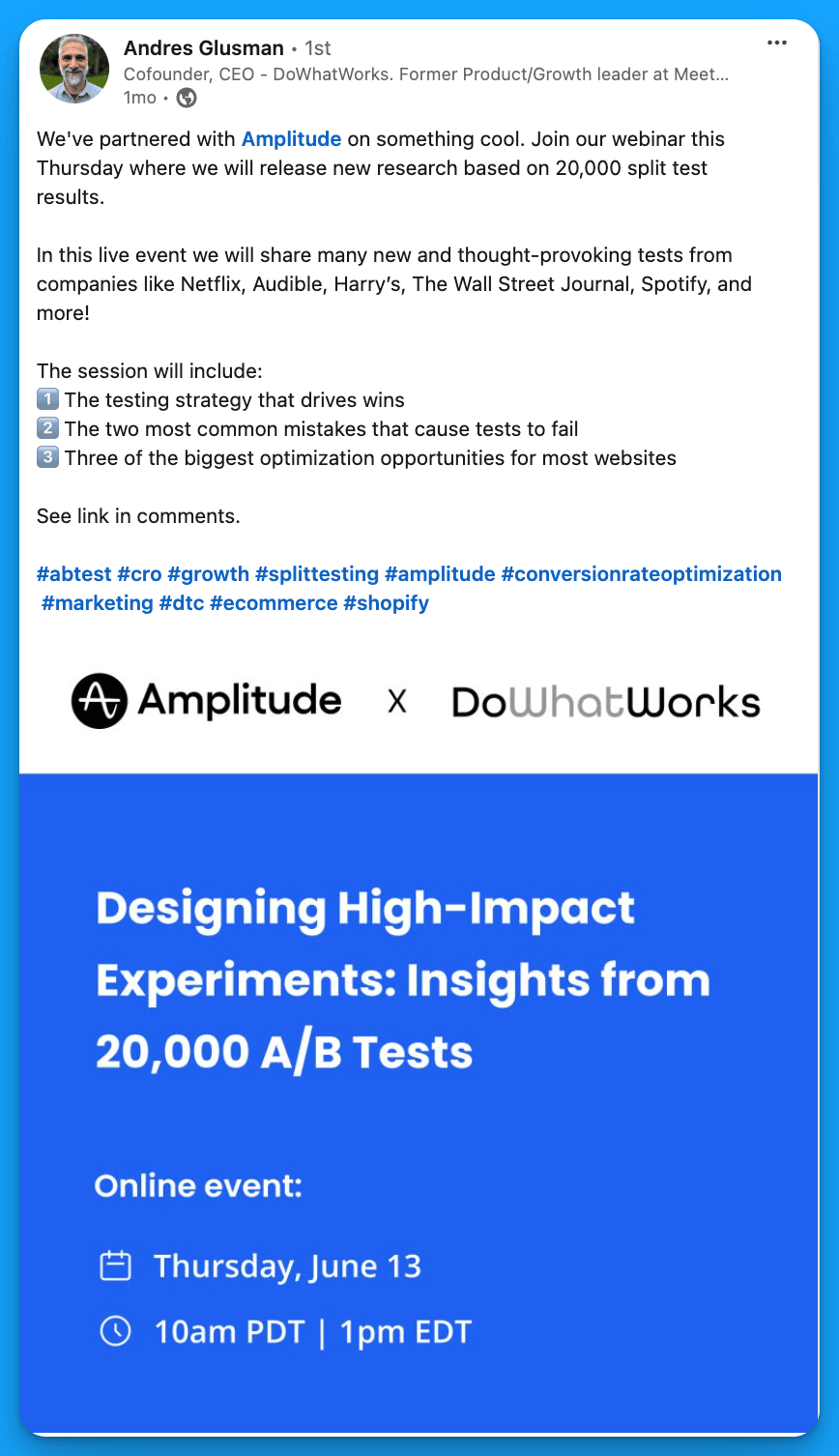
Strategy #2: Boost high-performing social media content
If your social media team posts about the webinar and it performs well organically, consider boosting this content and running it as an ad (instead of creating an ad from scratch). The benefit of boosting already high-performing content is the added social proof – prospects will take a closer look if a promoted post has tons of engagement.
Example from Uberflip
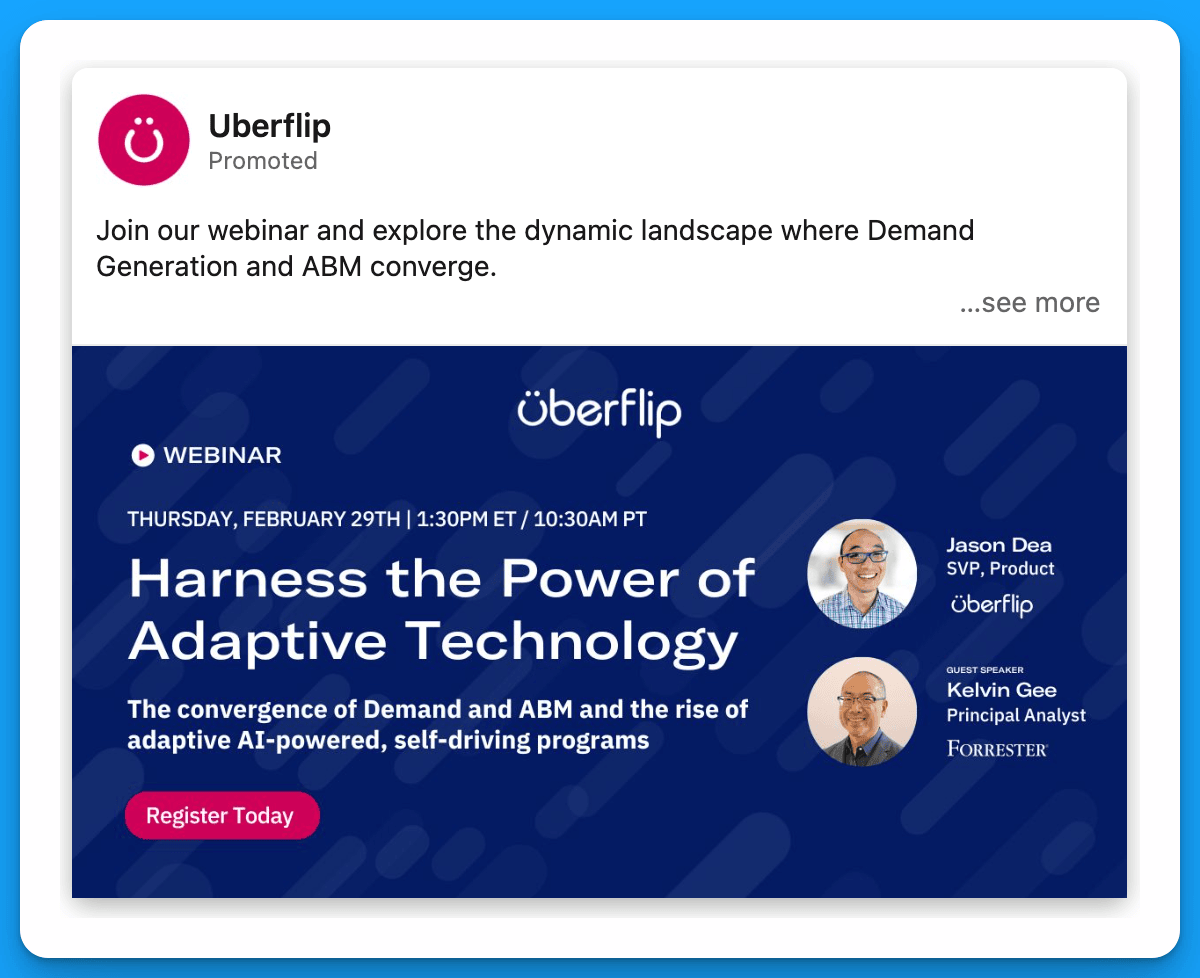
Strategy #3: Create a LinkedIn event
Most webinar ads take prospects to an external landing page, where they have to fill out a form to register. Although this can work well, a great alternative is to create a LinkedIn event (where people can sign up directly on the LinkedIn platform) and promote this event as an ad.
The main advantages of this approach are:
a) simplified registration (only takes a few clicks)
b) added social proof (event ads show how many people have already registered)
Example from Make

Strategy #4: Use incentives
A lot of companies use incentives for demo request offers, but few are using incentives to promote their webinars.
Give prospects an extra reason to register. Maybe by joining they’ll enter a raffle, get a free coffee, or gain access to certain templates.
Example from ZoomInfo

Final Recommendations
In addition to testing out the strategies above, here are a few final tips to maximize the ROI of your webinar program:
- If you’re having trouble getting webinar registrations on your landing page, consider switching to native lead gen forms to minimize friction.
- Don’t just promote your webinar to a cold audience. Think about other groups of people that might be interested in the content (i.e. retargeting audiences, open opportunities, churned customers, closed lost companies, previous webinar attendees, etc.)
- If you’re getting started, try different types of webinars to see what resonates most with your audience (and double down on whatever works)
If you want more tips around event promotion check out this article by Kirk Deis.
Hope you found this article insightful!
Connect with me on LinkedIn, and reach out with any questions.
Master B2B LinkedIn Ads with these 3 Free Courses:
If you want to become a LinkedIn Ads pro, check out our free B2B LinkedIn Ads courses, where you'll learn how to launch, optimize, and scale your campaigns to drive pipeline and revenue.

Here's what you'll learn in each course:
⚙️ B2B LinkedIn Ads 101 - The Ultimate Crash Course for New LinkedIn Advertisers
- Foundations For LinkedIn Ads Success
- Measurement: Tracking & Key Principles
- Targeting: Reaching Your Dream Buyers
- Ads: Mastering The 9 Ad Formats
🎯 B2B LinkedIn Ads 102 - The Blueprint for LinkedIn Ads Optimization
- Monitoring: How To Spot Performance Trends
- Auditing: How To Find The Darlings You Need To Kill
- Reporting: How To Transform Data Into Insights
- Optimization: How To Make Your LinkedIn Ads Profitable
🚀 B2B LinkedIn Ads 103 - Advanced Scaling Strategies From $25M In Ad Spend
- Concepts of Scaling
- Divide and Conquer
- Learnings From $25M+ In LinkedIn Ad Spend
Click Here to Join 1,000+ B2B Marketers Today and start leveling up your advertising skill set.
Takes < 90 seconds to sign up (seriously we timed it 😂)
People Also Ask
How can leveraging thought leaders enhance my LinkedIn Ads for webinars?
Encourage thought leaders participating in your webinar to post about it on their personal profiles. Provide them with sample posts to simplify the process. After the organic reach declines, boost these posts to your Ideal Customer Profile (ICP) to increase visibility and credibility. 
What is the benefit of boosting high-performing social media content for webinar promotion?
If your social media team shares a webinar post that performs well organically, consider boosting it as an ad. This approach leverages existing engagement and social proof, making the promoted post more appealing to prospects. 
How can creating a LinkedIn event aid in webinar registrations?
Instead of directing prospects to an external landing page, create a LinkedIn event where users can register directly on the platform. This method simplifies the registration process and displays the number of attendees, adding social proof. 
What are the best practices for targeting the right audience for webinar promotions on LinkedIn?
Leverage LinkedIn’s advanced targeting options to focus on specific industries, job titles, company sizes, and geographic locations that align with your ideal webinar attendees. Utilizing these parameters ensures your ads reach professionals who are most likely to be interested in your content.
How can I integrate LinkedIn ads with other marketing channels to maximize webinar attendance?
Coordinate your LinkedIn ad campaigns with email marketing, social media promotions, and content marketing efforts to create a cohesive promotional strategy. Consistent messaging across channels reinforces your webinar’s value and broadens its reach.
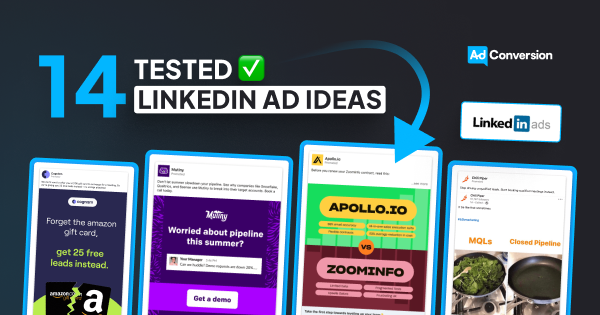
14 Tested LinkedIn Ad Ideas to Scale Demos
Getting demos isn’t easy, especially in B2B SaaS, with long sales cycles, lots of decision makers, and tons of competition.
In this article, I’ll break down the top 14 LinkedIn ads strategies you can use to break through the noise and capture existing demand.
(Irrelevant of order all ideas could be worth testing)
TABLE OF CONTENTS:
#2: Name the top companies you work with
#3: Demonstrate why you’re better than competitors
#4: Highlight integrations with partner technologies
#7: Try hyper-personalized messaging
#10: Show how much better life would be with your product
#11: Test ads in different languages
#12: Announce a new product update
#13: List the features that your ICP would be most interested in
#1: Use testimonials
Testimonials are one of the most effective ways to build trust and get prospects who are on the fence to take the next step.
Example 1: Chili Piper
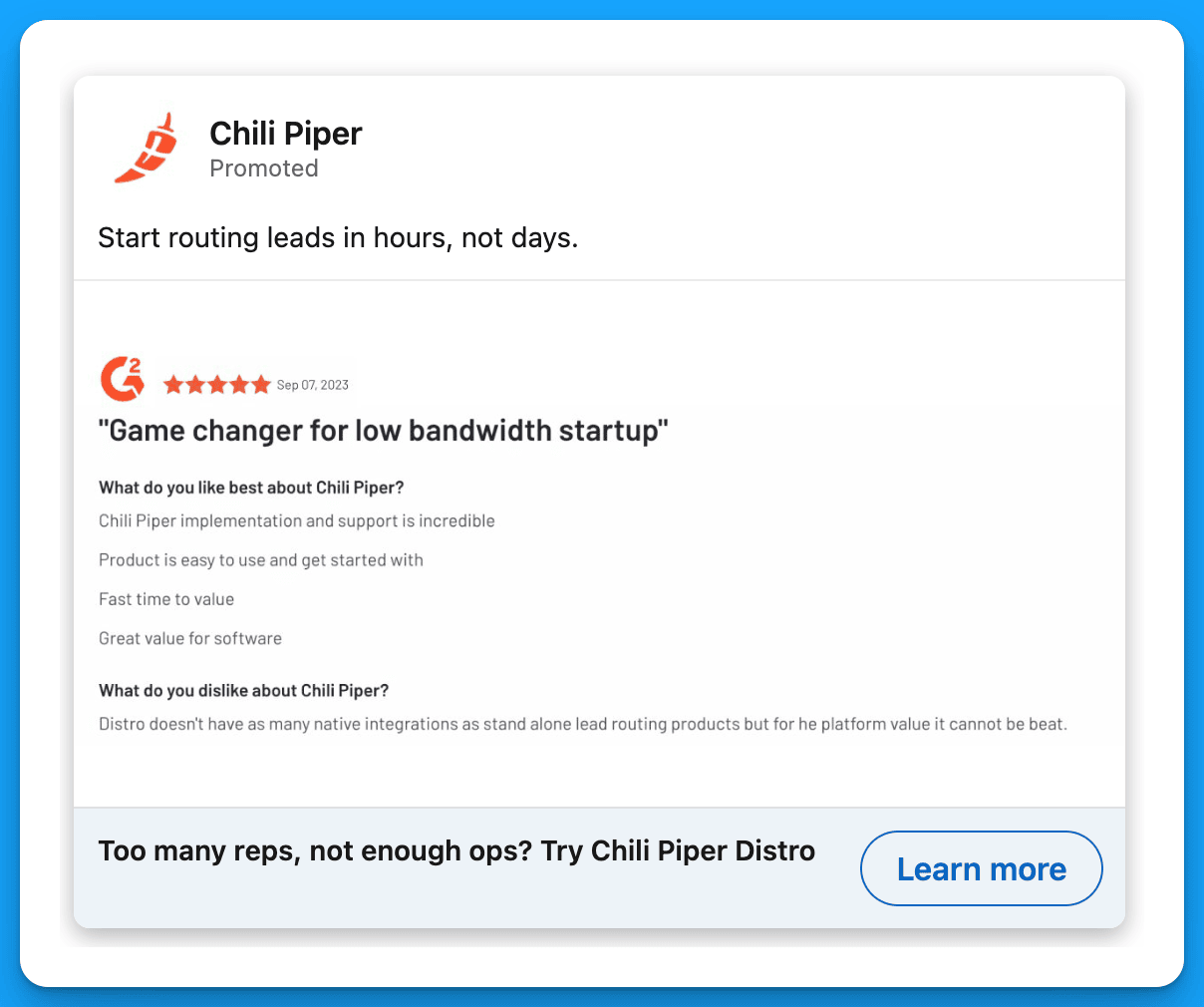
Example 2: Sendoso
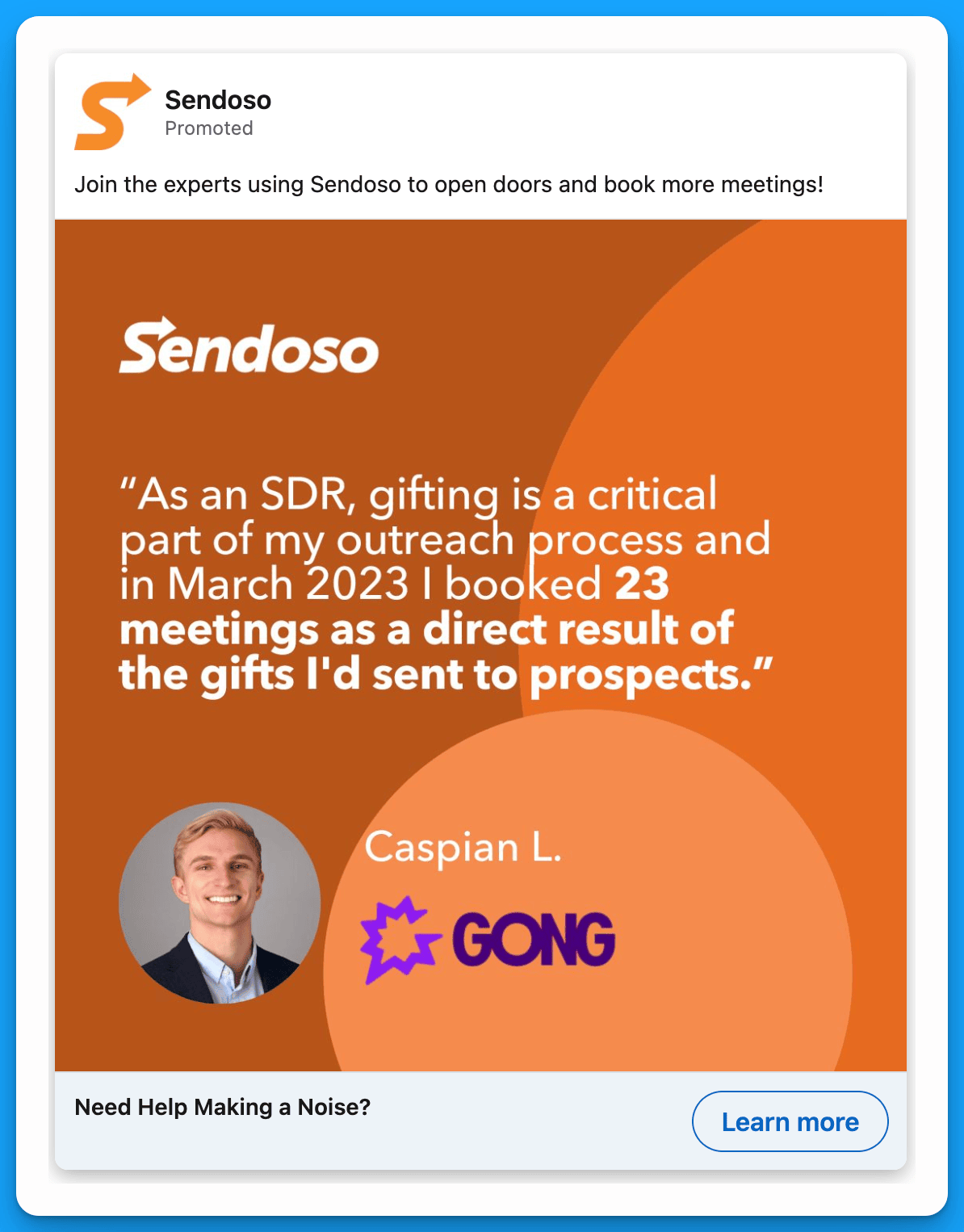
#2: Name the top companies you work with
By highlighting well-known companies that already work with you, you can gain the trust of senior leaders much faster and accelerate the sales process.
Example 1: MarketerHire
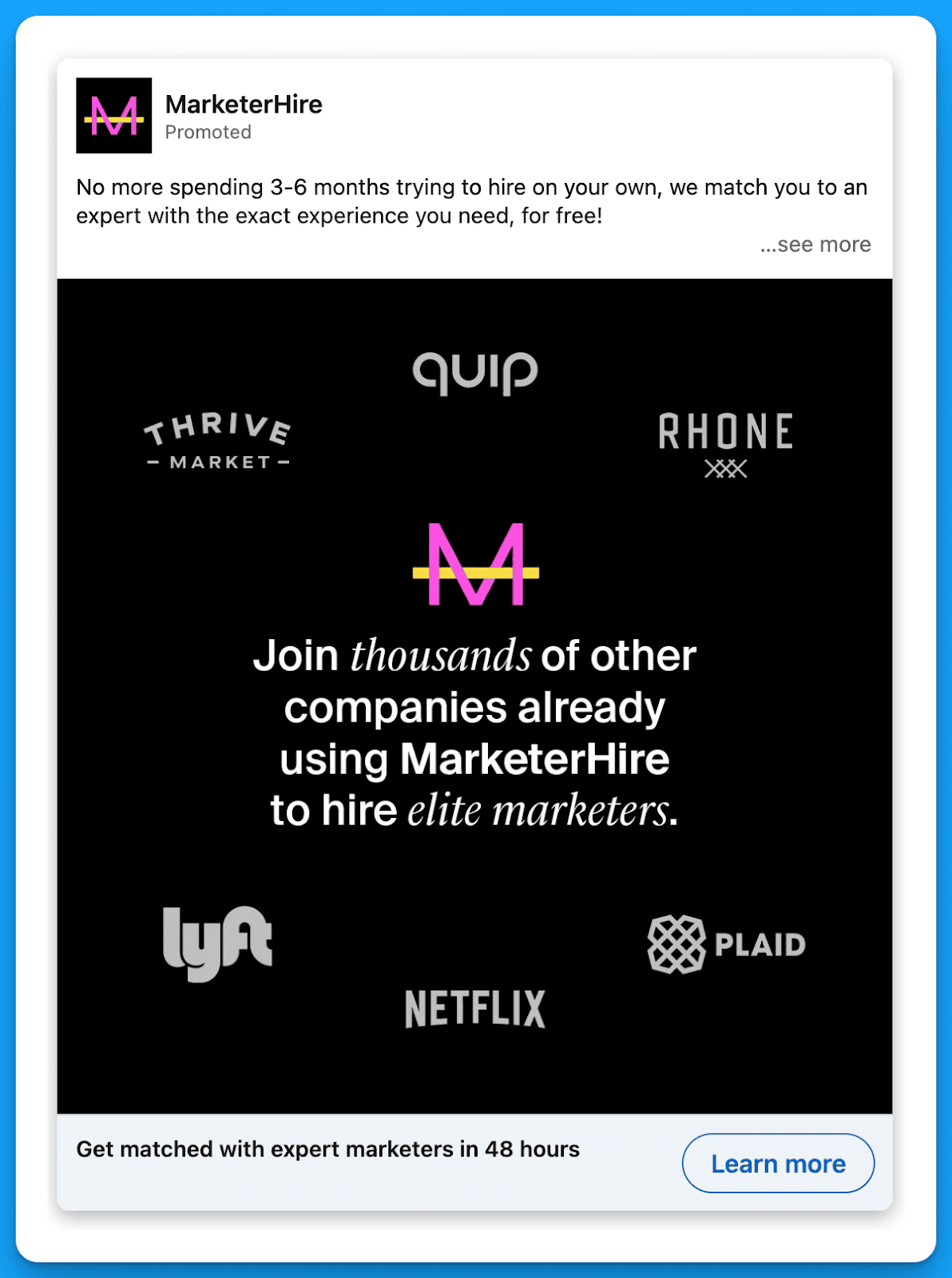
Example 2: Mutiny
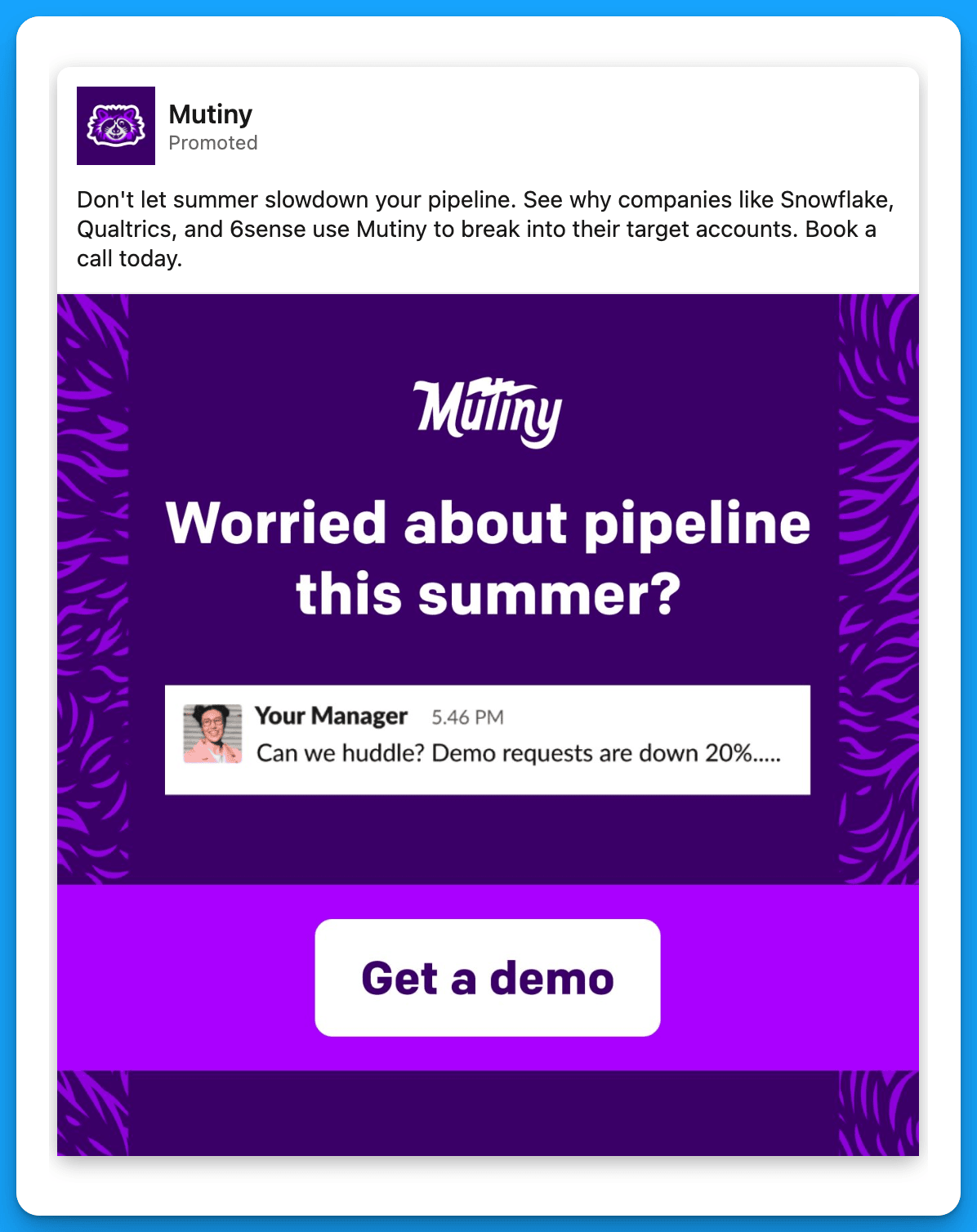
#3: Demonstrate why you’re better than competitors
This approach is powerful, especially when you target prospects who are currently using your competitors. Since they’re already in-market, if they’re frustrated with their current solution, they’ll likely end up switching over (or at least consider it).
Example 1: Apollo
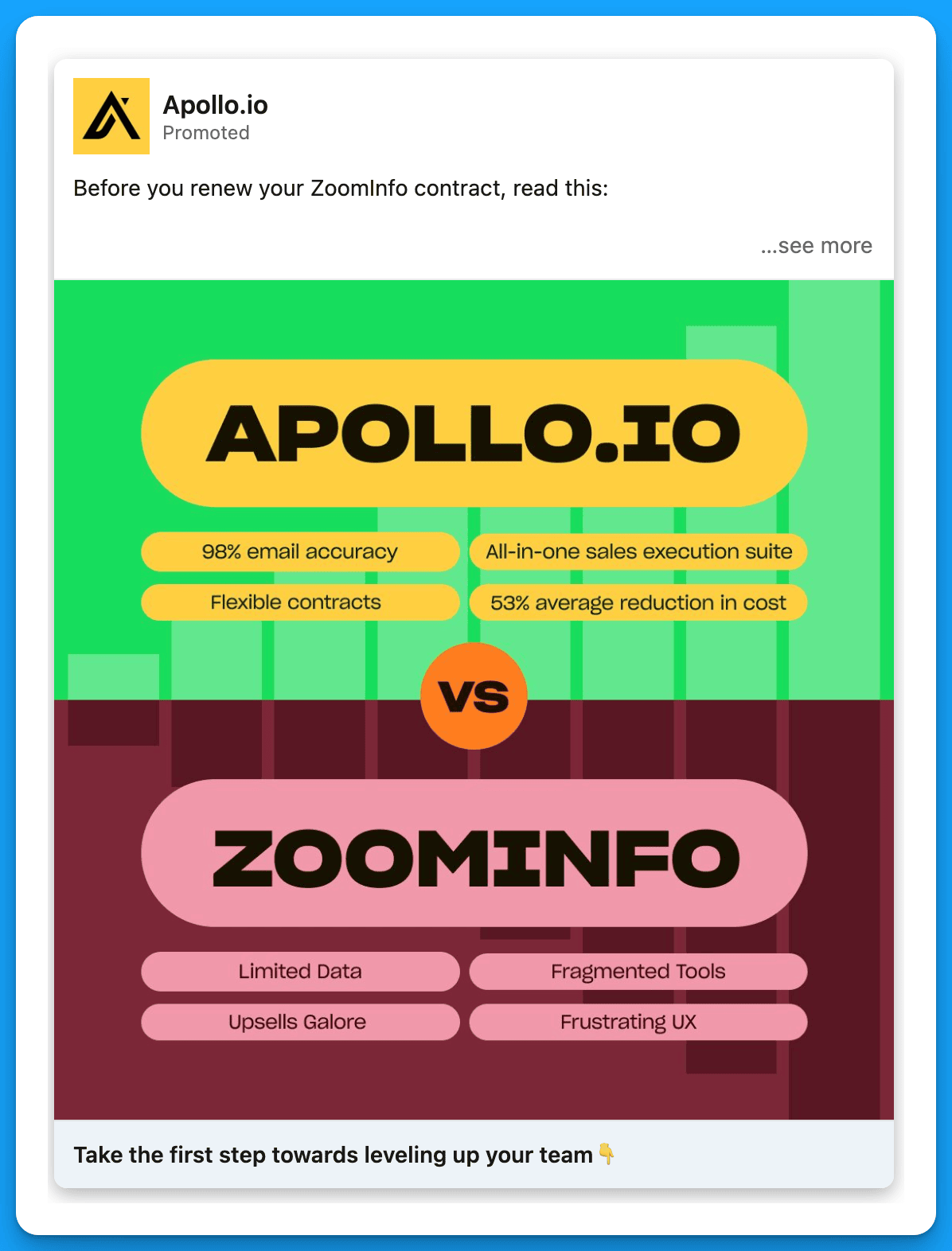
Example 2: Apollo

#4: Highlight integrations with partner technologies
This approach is particularly effective if you have a seamless integration with a well-known technology. Do you work well with HubSpot, Salesforce, Sales Nav, Wordpress, etc.? Target a list of companies within your ICP who are using the technology you integrate with, and show them why you’re the best choice.
Example 1: Typeform

Example 2: Typeform
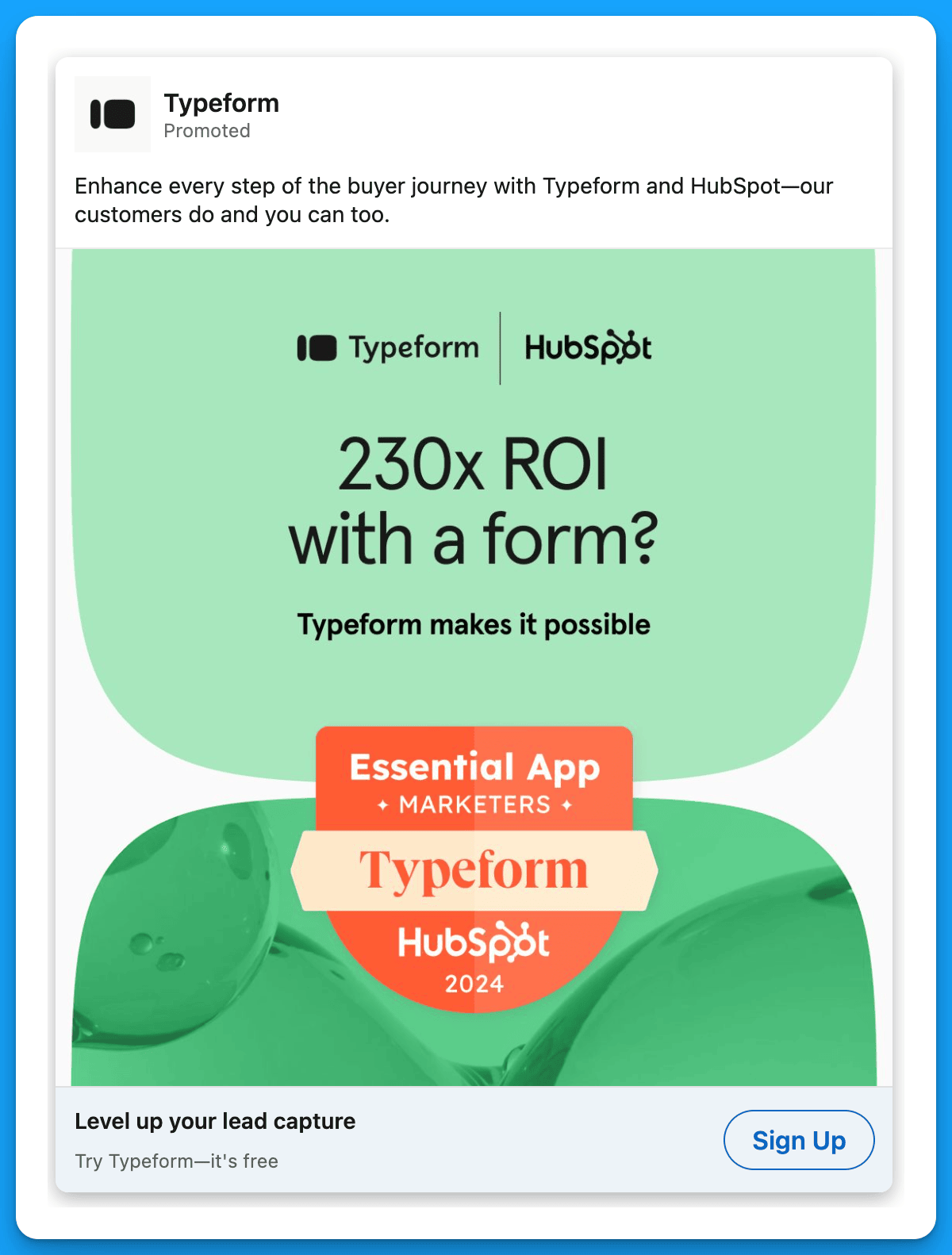
#5: Showcase your product
Many times, all prospects need to take the next step is to get a glimpse of your software. Also, this is an especially great approach because it sets the sales team up for success – when prospects jump on a demo call, they’ll already have some familiarity with the product.
Example 1: HockeyStack
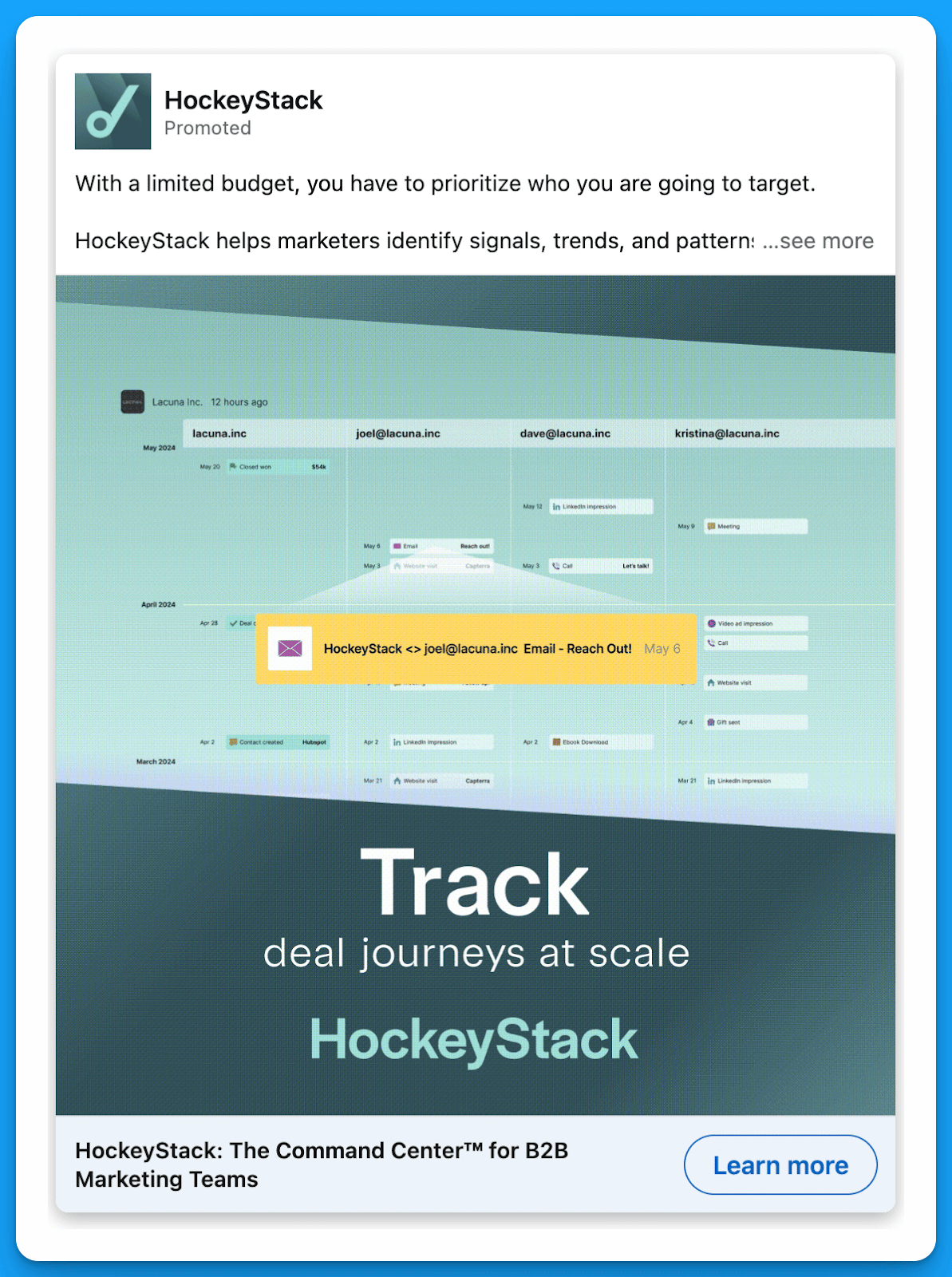
Example 2: Loxo
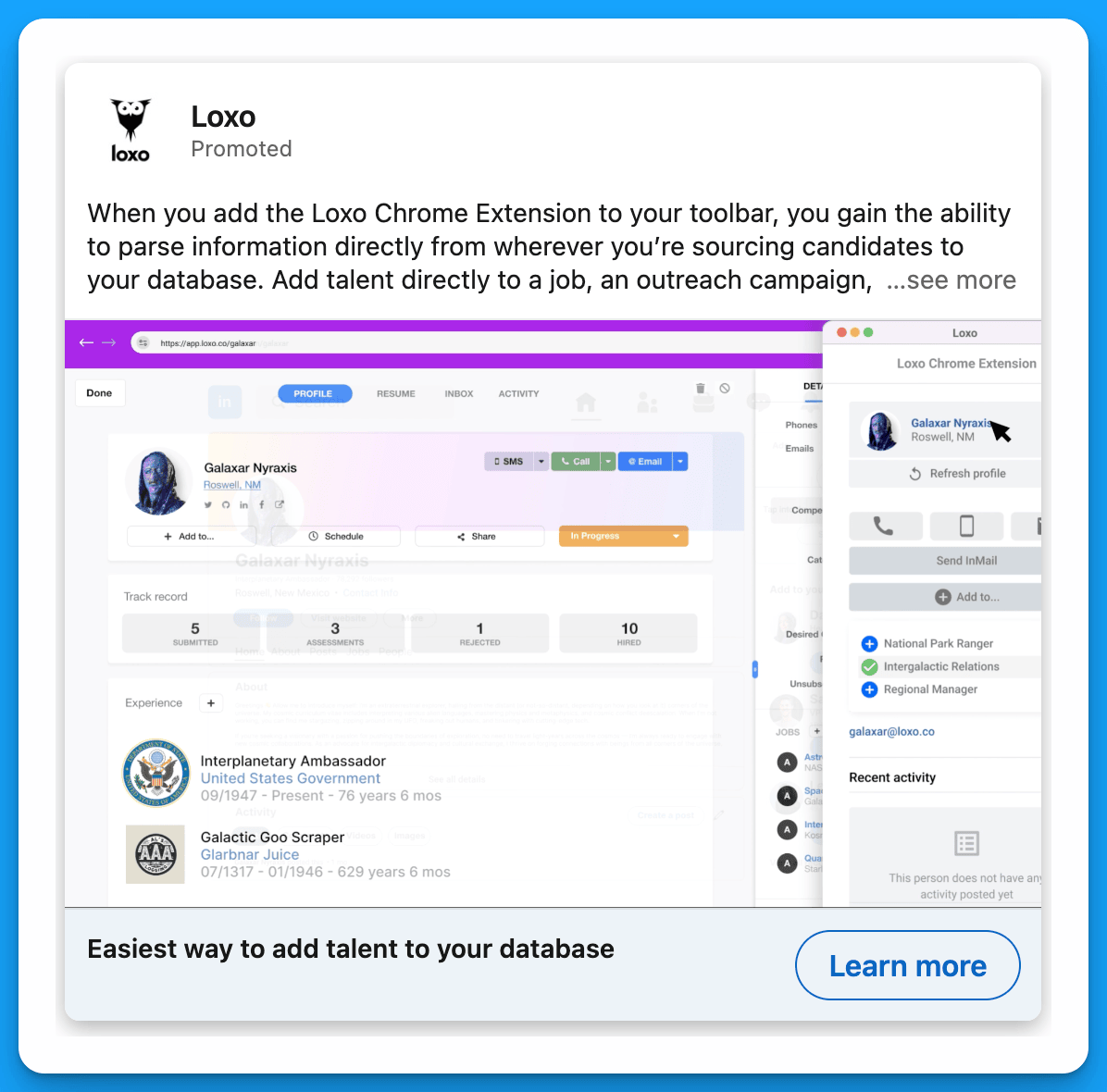
#6: Stand out with humor
B2B leaders are still people. Humor that’s relatable and clearly highlights a pain point works better than corporate jargon 99% of the time.
Example 1: Chili Piper

Example 2: Cognism

#7: Try hyper-personalized messaging
This approach, often referred to as 1:1 ABM, relies on extreme personalization. You specifically call out the company that you’re prospecting into, and maybe you take it a step further and create a personalized video or asset just for them. CTRs will be super high and even if prospects don’t convert on an initial touchpoint, you’ll make sales’s job significantly easier by generating awareness within a target account.
Example 1: UserGems

Example 2: HockeyStack
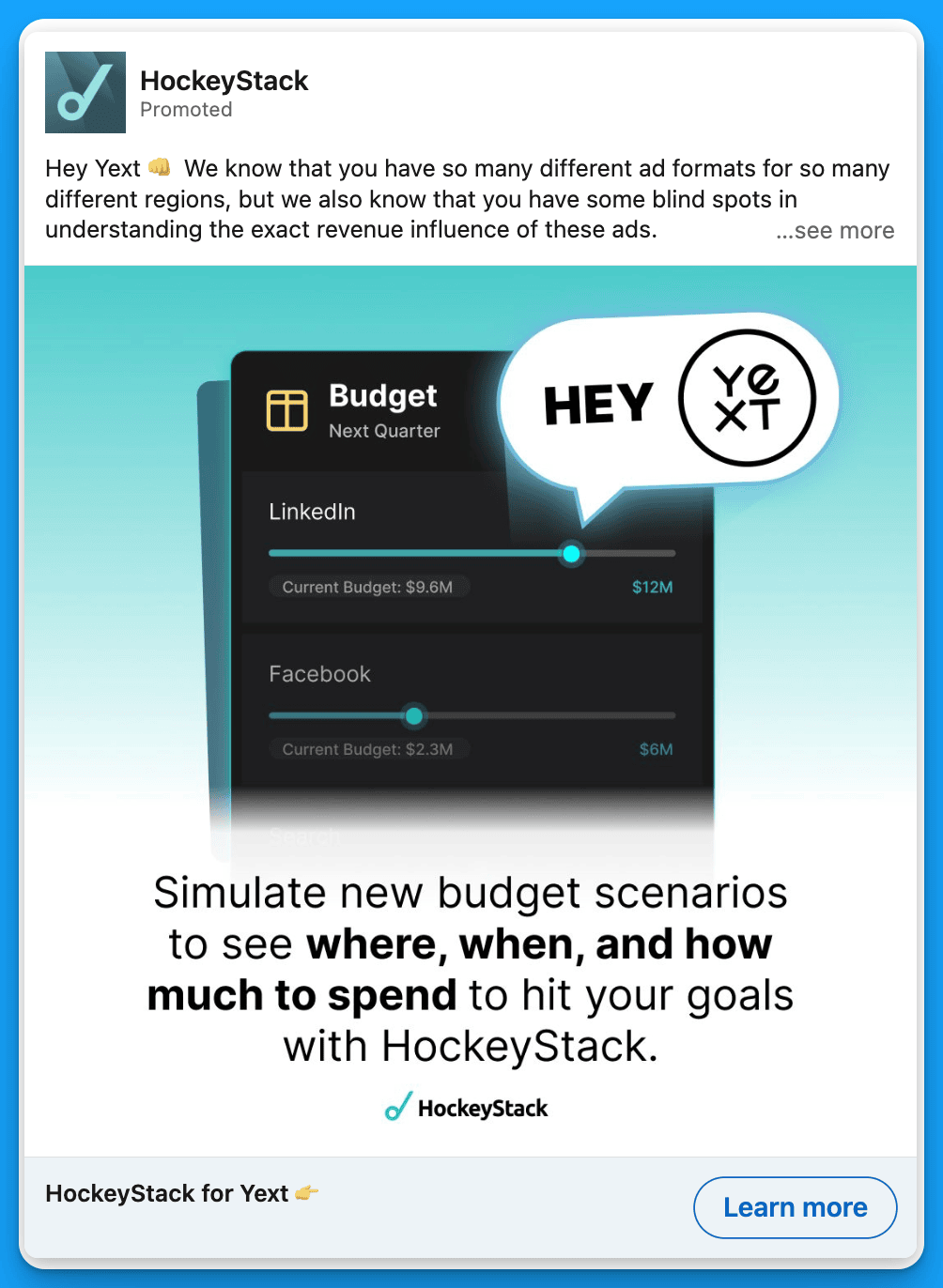
#8: Use statistics
This isn’t the flashiest or most exciting strategy, but it works. Numbers give prospects a sense of security that they’ll get a positive ROI if they invest.
Example 1: UserGems

Example 2: Lavender
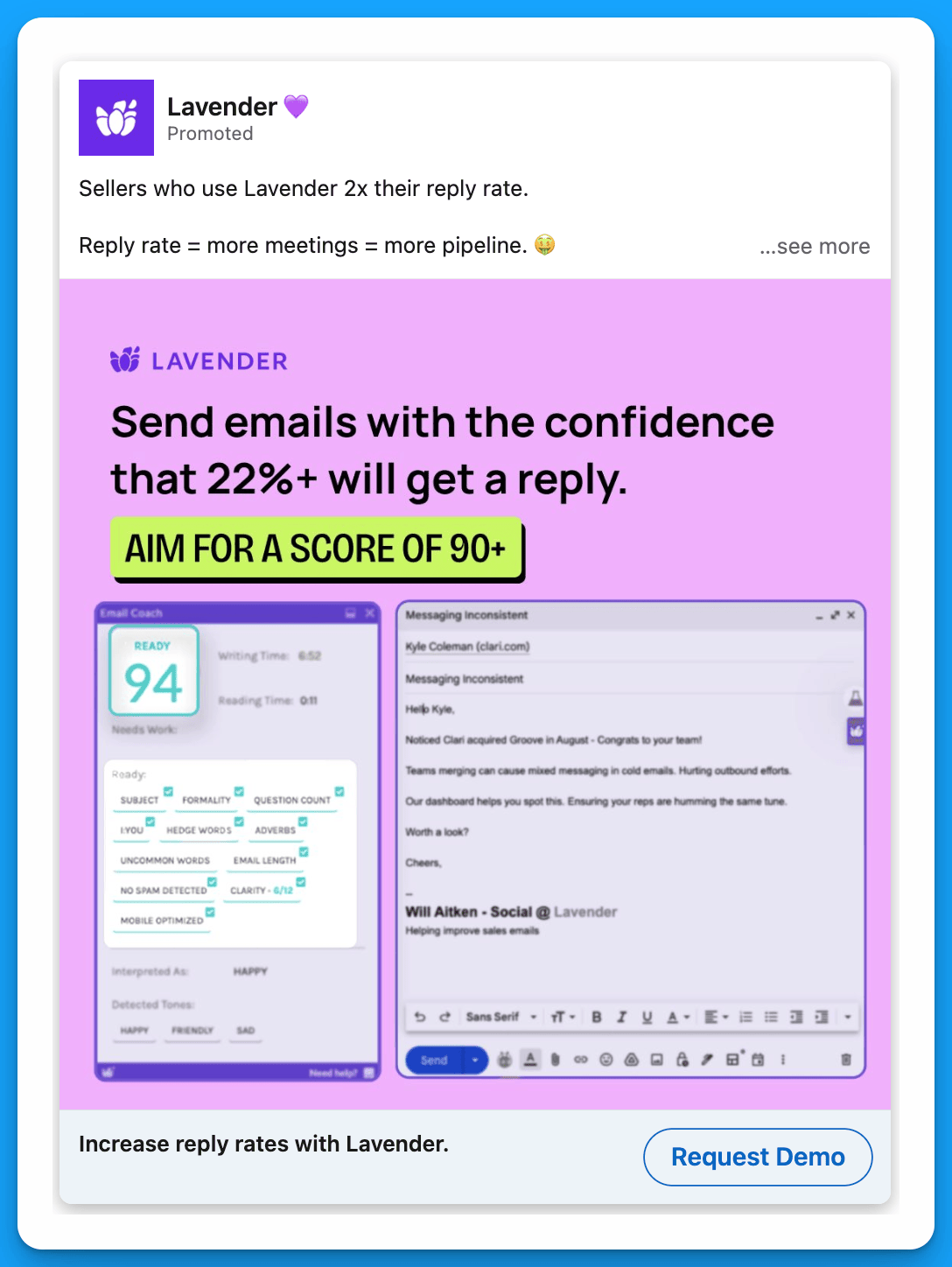
#9: Leverage Incentives
Incentives are controversial, which is understandable.
The concern is that by offering an incentive you lower the quality of your leads. But that’s only true if your targeting is weak. If it’s spot on, incentivized demo ads are amazing generators of pipeline and revenue – they serve as a tiny nudge to encourage leaders to find some time in their calendar.
Amazon or Doordash gift cards work well, but you can always get more creative with your offer.
Example 1: Metadata
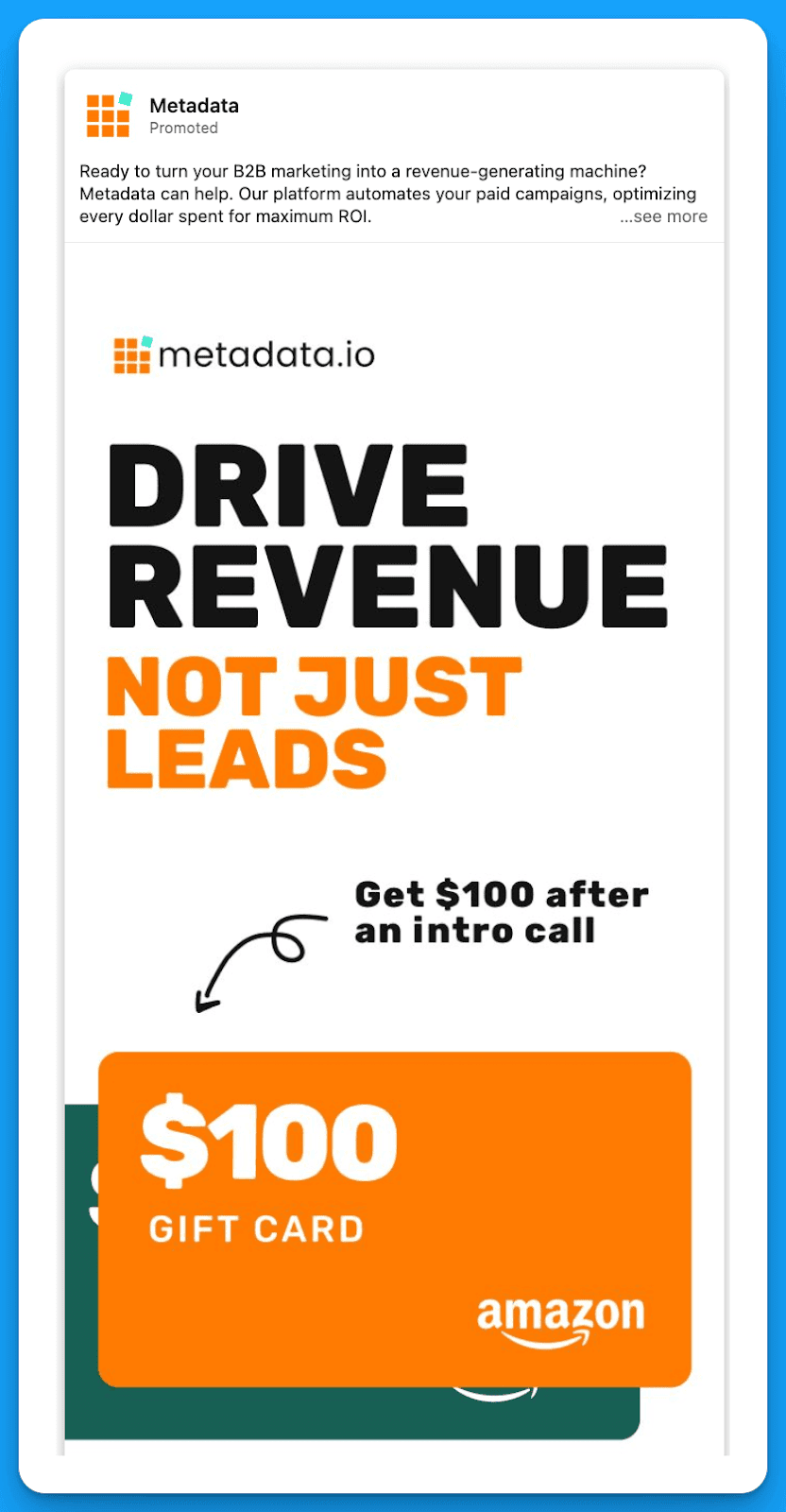
Example 2: Cognism

#10: Show how much better life would be with your product
This approach clearly emphasizes the pain point your product will solve, leading prospects to take action.
Example 1: Motion
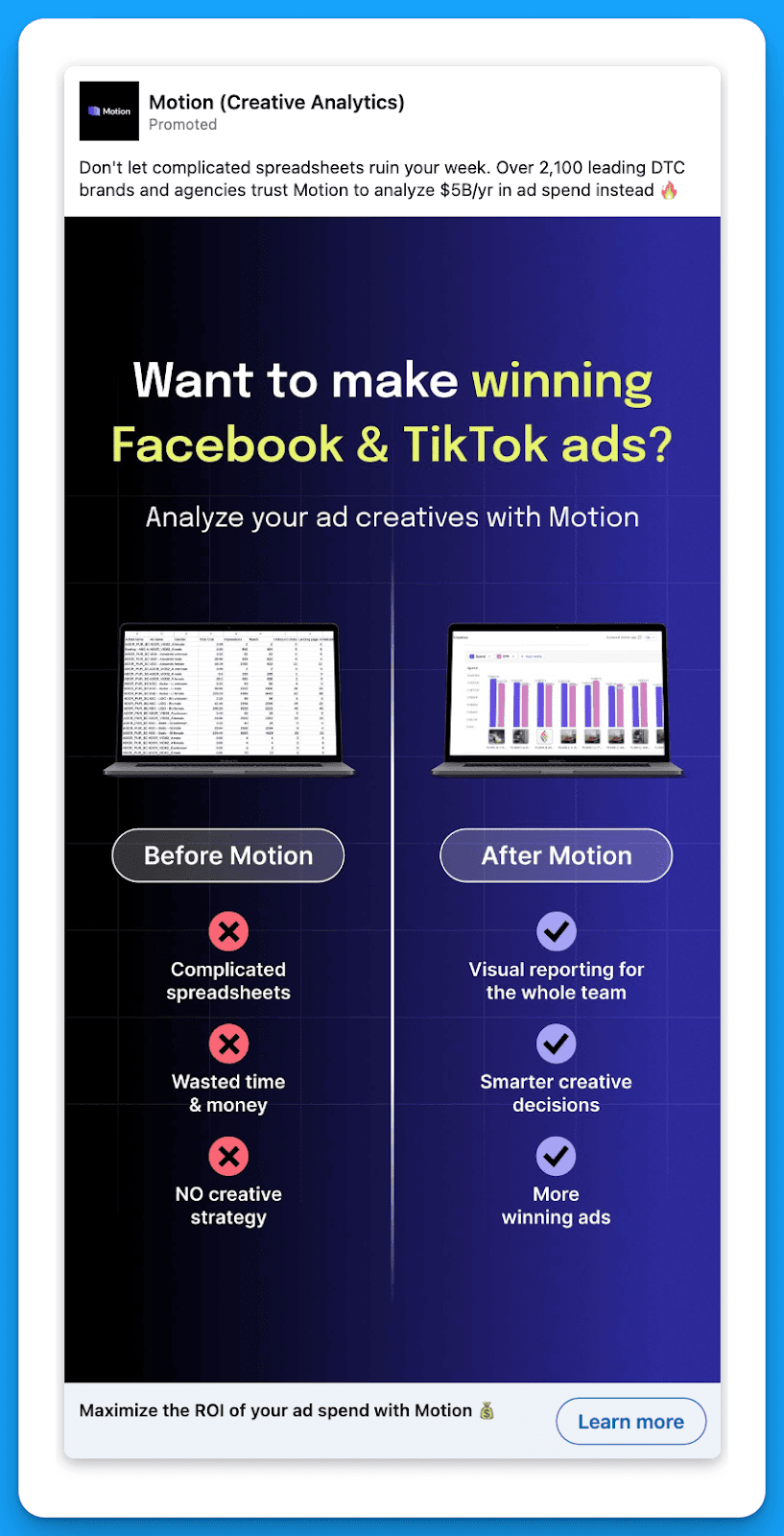
Example 2: Workvivo
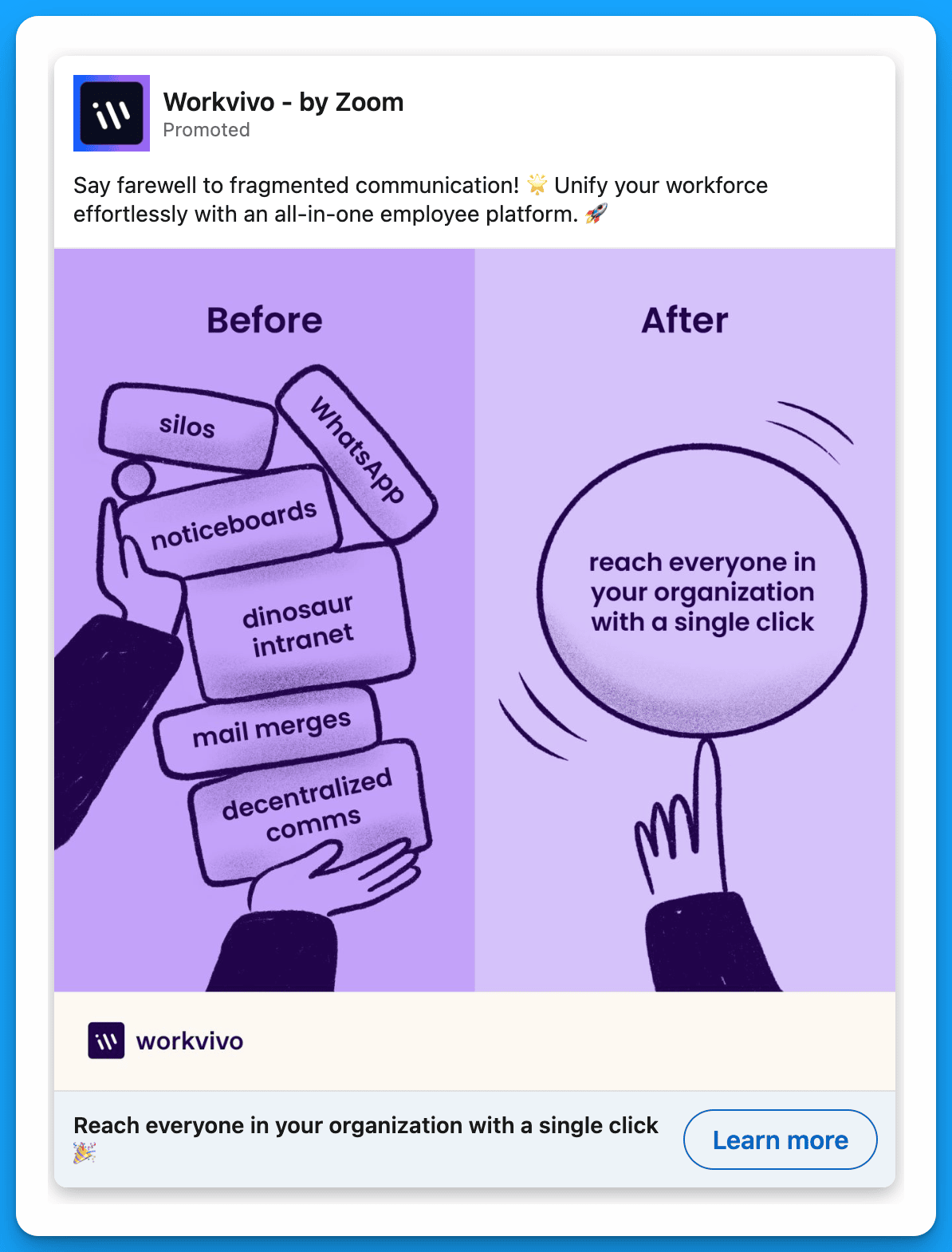
#11: Test ads in different languages
A lot of B2B SaaS companies are hyper-focused on North America, and their content for Latin America, EMEA, and APAC is just an afterthought. Running high quality ads in the language of the specific region you’re targeting can be a game changer as far as driving pipeline and revenue.
Bonus: If you take into account regional differences in consumer behavior and product usage when creating ads for different regions, your content will end up resonating even more.
Example 1: Pandadoc
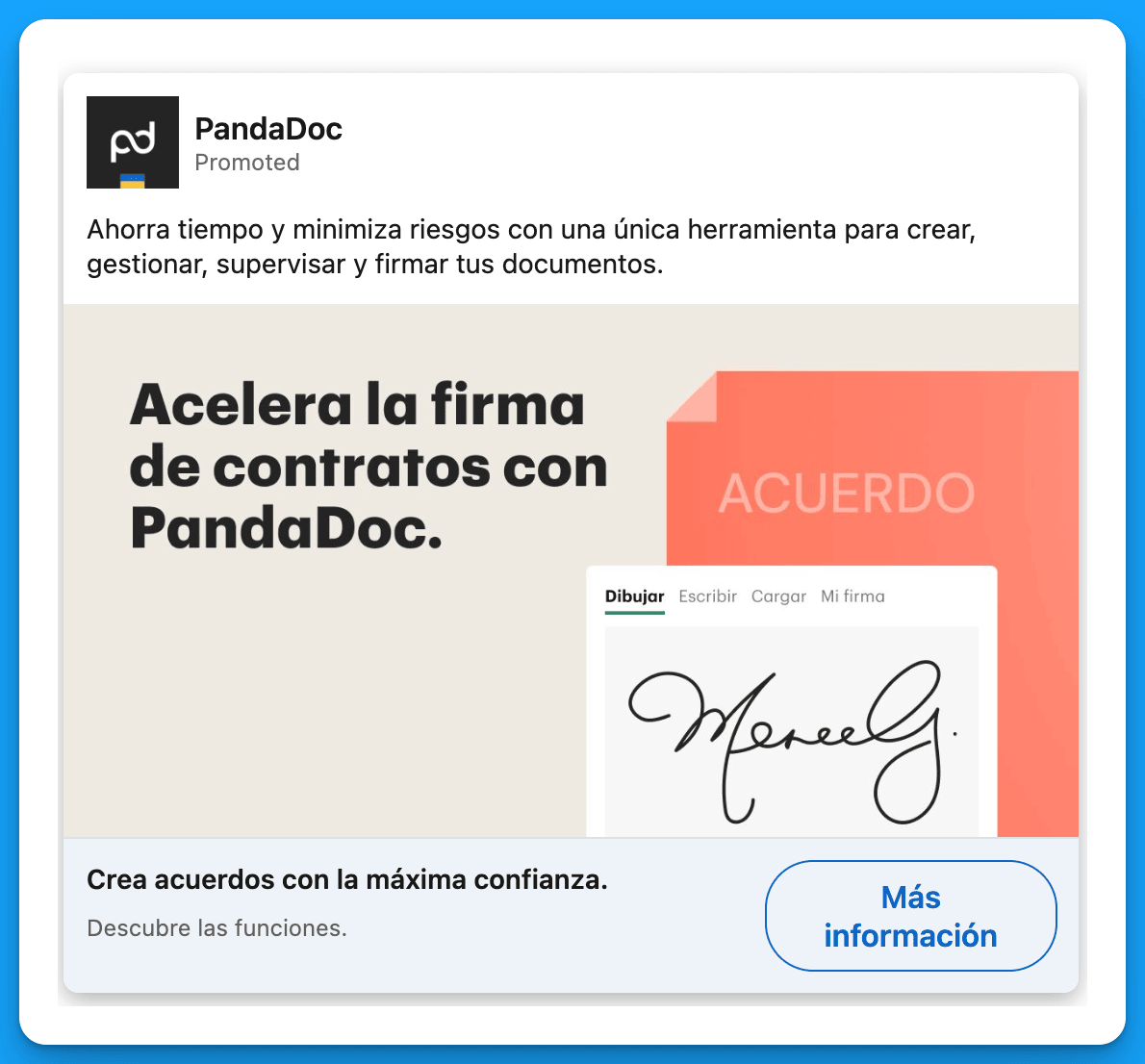
Example 2: Miro
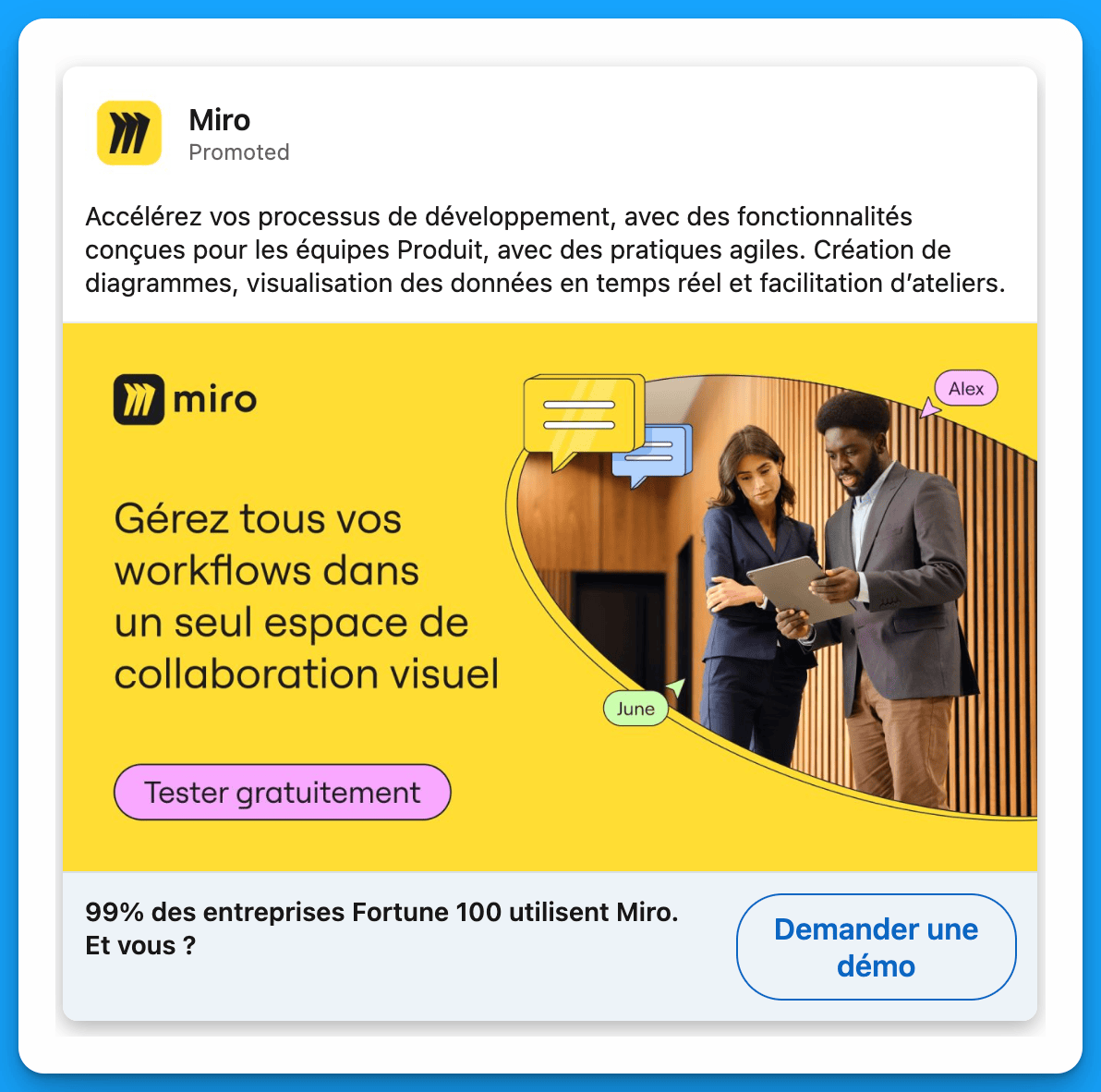
#12: Announce a new product update
This is a great way to re-engage people who may have considered your solution in the past but weren’t fully convinced. By showing prospects how much better your product is after the updates, you can convince them to take the next step and request a demo.
Example 1: Zoominfo

#13: List the features that your ICP would be most interested in
As marketers, we’re always told to focus on pain points instead of features. But listing your top features can help prospects fully understand how powerful your product is, encouraging them to request a demo.
Example 1: Workvivo
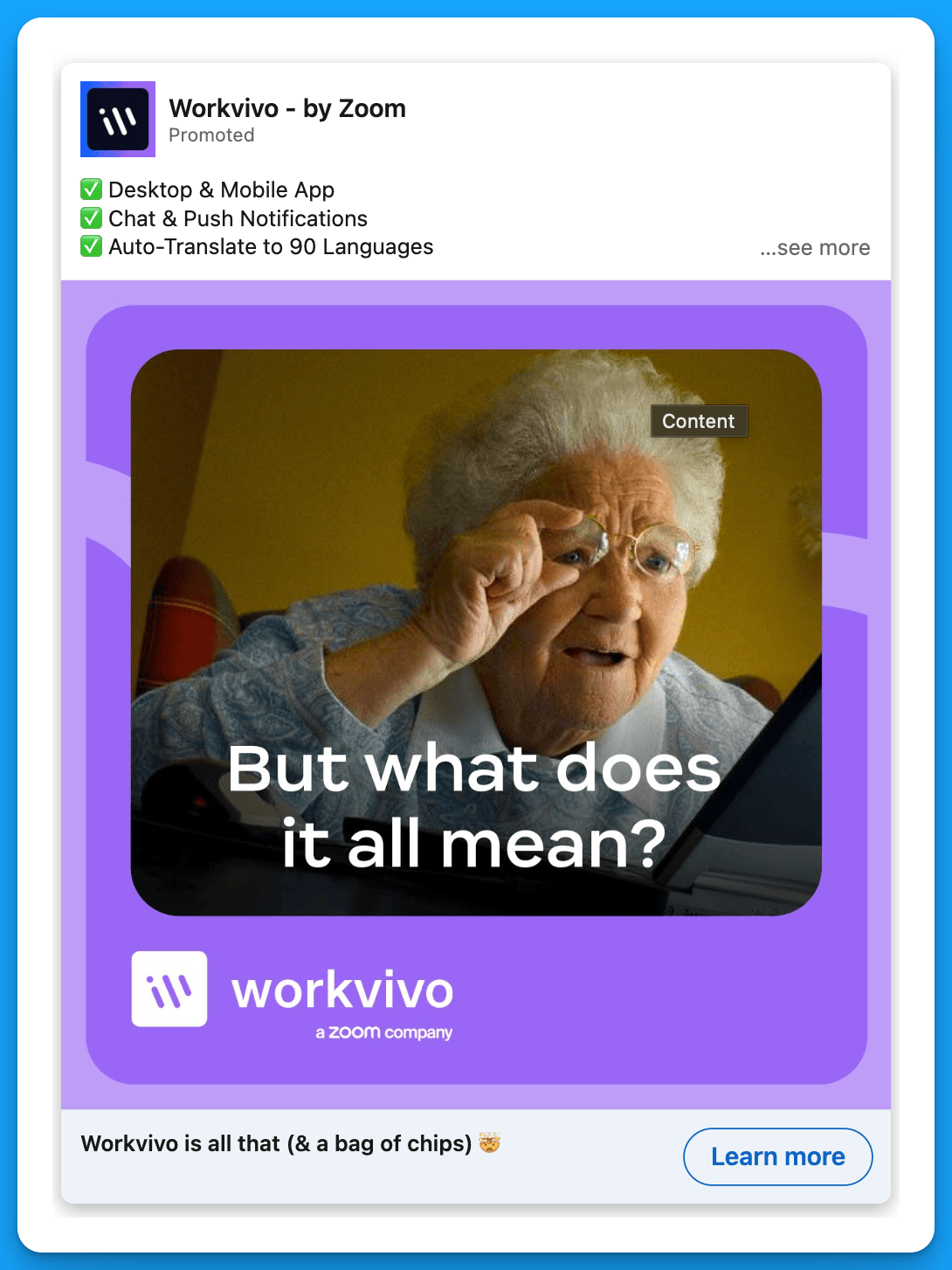
#14: Host a live demo
Promoting a live demo is a great way to get qualified prospects to see your product without having to go through the traditional (and higher commitment) demo process.
Prospects who are interested in your product may not be ready to talk to the sales team right away – a live demo can serve as a bridge, moving them further down the funnel.
Example 1: Metadata
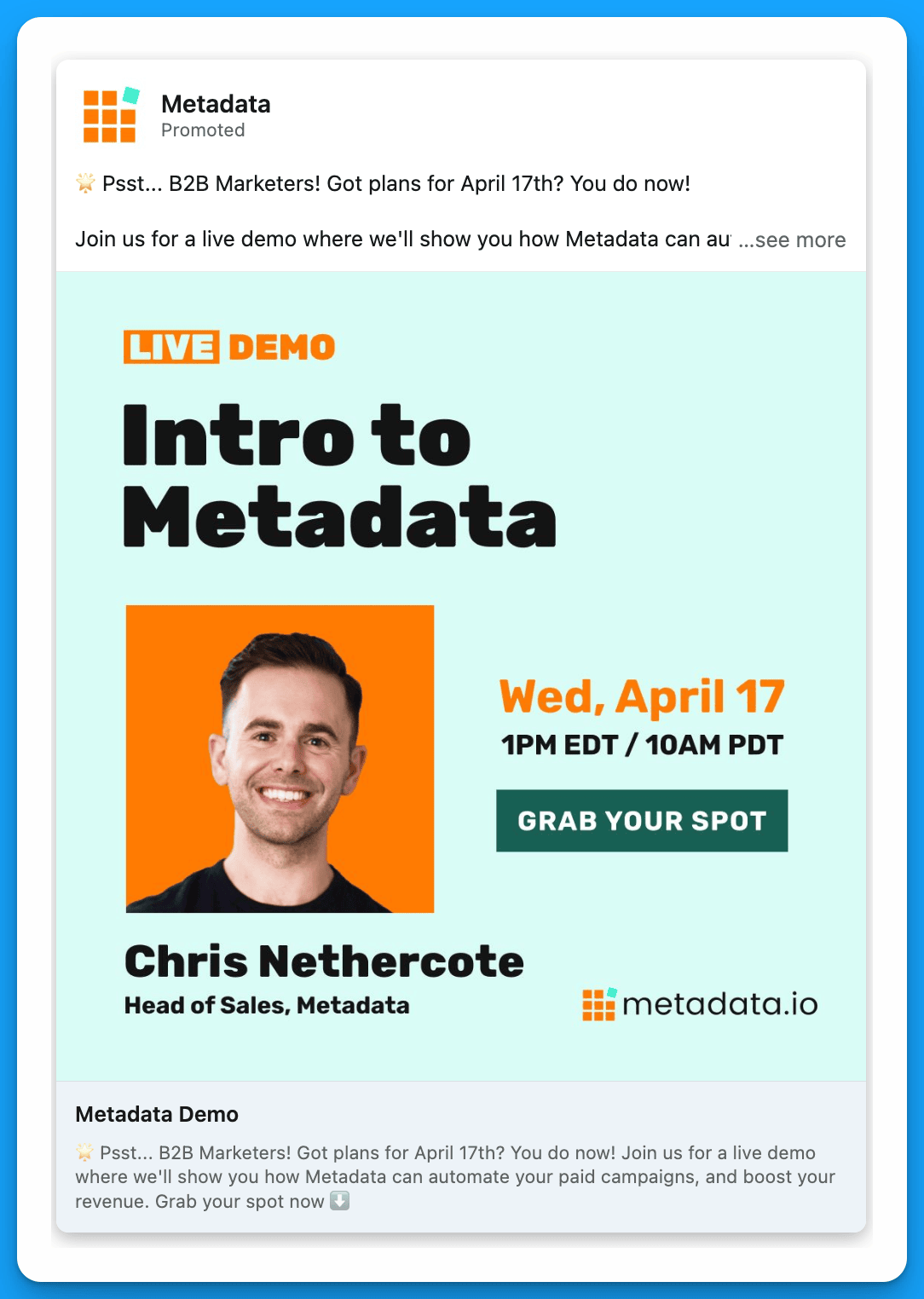
Example 2: Motion

Final Recommendations
If you’re trying to drive more demos, in addition to testing out these capture strategies, I recommend doing a comprehensive audit of your audiences. Ask yourself:
- Am I targeting my warmest prospects who have already engaged with my content in some capacity?
- Am I reaching prospects with the right company sizes, seniorities, job functions, job titles, and industries?
- Am I excluding the LinkedIn audience network and disabling audience expansion?
- Am I making all the necessary exclusions (interns, unemployed, competitors, customers, etc.)?
Without precise targeting, even the best strategies will fail.
Master B2B LinkedIn Ads with these 3 Free Courses:
If you want to become a LinkedIn Ads pro, check out our free B2B LinkedIn Ads courses, where you'll learn how to launch, optimize, and scale your campaigns to drive pipeline and revenue.

Here's what you'll learn in each course:
⚙️ B2B LinkedIn Ads 101 - The Ultimate Crash Course for New LinkedIn Advertisers
- Foundations For LinkedIn Ads Success
- Measurement: Tracking & Key Principles
- Targeting: Reaching Your Dream Buyers
- Ads: Mastering The 9 Ad Formats
🎯 B2B LinkedIn Ads 102 - The Blueprint for LinkedIn Ads Optimization
- Monitoring: How To Spot Performance Trends
- Auditing: How To Find The Darlings You Need To Kill
- Reporting: How To Transform Data Into Insights
- Optimization: How To Make Your LinkedIn Ads Profitable
🚀 B2B LinkedIn Ads 103 - Advanced Scaling Strategies From $25M In Ad Spend
- Concepts of Scaling
- Divide and Conquer
- Learnings From $25M+ In LinkedIn Ad Spend
Click Here to Join 1,000+ B2B Marketers Today and start leveling up your advertising skill set.
Takes < 90 seconds to sign up (seriously we timed it 😂)
People Also Ask
How can testimonials enhance the effectiveness of my LinkedIn ads?
Incorporating testimonials from satisfied clients builds trust and encourages prospects to engage with your brand, as they see real-world validation of your product or service. 
Why is it beneficial to highlight well-known clients in my LinkedIn advertising?
Showcasing recognizable companies that utilize your offerings can quickly establish credibility and attract attention from potential customers, leveraging the influence of established brands. 
What role does humor play in LinkedIn ad campaigns?
Utilizing humor in your ads can make your content more memorable and engaging, helping your brand stand out in a professional environment and fostering a positive association. 
How can hyper-personalized messaging improve LinkedIn ad performance?
Crafting messages that directly address the specific needs and pain points of your target audience can significantly increase engagement and conversion rates by resonating more deeply with potential clients. 
What is the advantage of announcing new product updates in LinkedIn ads?
Promoting new features or updates keeps your audience informed and demonstrates ongoing innovation, encouraging existing and potential customers to explore the latest offerings.

How to Choose The Best Ad Platforms For B2B SaaS
Don’t want to make a mistake investing in an ad platform that won’t work?
Regardless of what you hear online, no one can promise you that ( including me).
But thankfully success leaves clues and we surveyed 60 B2B marketers to find the answer.
So regardless if you’re a new advertiser, startup founder, or agency owner reading this.
We’ve got you covered, let’s dive in 👇
TABLE OF CONTENTS:
- Where can you advertise online?
- How to decide on the best ad platform?
- Which ad platforms are best for B2B lead generation?
- Which ad platforms are best for B2B awareness?
- Which ad platforms are most popular for B2B?
- Which ad platforms are most B2B marketers planning to invest in?
- Making your final decision on where to advertise
Where can you advertise online?
There is no shortage of opportunities where you can advertise online.
Most channels can be grouped into these five primary categories:
This isn’t an exhaustive list of every available ad platform but it gives you a sense of what’s possible.
Now that you’re aware of the various ad platforms available, how do you decide which to choose?
How to decide on the best ad platform?
When considering investing in a new ad platform here’s four key criteria to consider:
With these four criteria in mind let’s go through the qualitative results from our study and what B2B marketers have reported as their best ad platforms.
Which ad platforms are best for B2B lead generation?
After reviewing the responses from 60 B2B marketers here’s what we found:
- 52.7% reported Google Ads
- 38.2% reported LinkedIn Ads
- 3.6% reported Facebook Ads
- 1.8% reported Capterra Ads
- 1.8% reported Instagram Ads
- 1.8% reported Native Ads

Which ad platforms are best for B2B awareness?
After reviewing the responses from 60 B2B marketers here’s what we found:
- 56.1% reported LinkedIn Ads
- 12.3% reported Facebook Ads
- 12.3% reported YouTube Ads
- 10.5% reported Google Ads
- 3.5% reported Connected TV
- 3.5% reported Display Ads
- 1.8% reported Instagram Ads

Which ad platforms are most popular for B2B?
After reviewing the responses from 60 B2B marketers here’s what we found:
- 20.2% reported Google Ads
- 18.8% reported LinkedIn Ads
- 13.0% reported Facebook Ads
- 11.2% reported Instagram Ads
- 9.0% reported YouTube Ads
- 8.3% reported Microsoft Ads
- 5.8% reported Capterra Ads
- 5.& reported Display Ads
- 2.5% reported Reddit Ads
- 2.2% reported Native Ads
- 1.8% reported X (Twitter Ads)
- 1.1% reported Connected TV
- 0.4% reported Quora Ads

Which ad platforms are most B2B marketers planning to invest in?
After reviewing the responses from 60 B2B marketers here’s what we found:
- 13.5% reported YouTube Ads
- 12.1% reported X (Twitter) Ads
- 10.6% reported Reddit Ads
- 9.9% reported Connected TV
- 9.2% reported Audio Ads
- 7.8% reported Display Ads
- 7.1% reported Microsoft Ads
- 7.1% reportedFacebook Ads
- 7.1% reported Capterra Ads
- 5.7% reported Instagram Ads
- 4.3% reported Native Ads
- 3.5% reported Apple Search Ads
- 1.4% reported LinkedIn Ads
- 0.7% reported Tiktok Ads

Making your final decision on where to advertise
All in all take these survey results as suggestions to see what other B2B marketers are reporting is working for them and what platforms they’re interested in exploring.
Ultimately don’t forget the four key criteria when making your decision of where to advertise.
When you finally decide, run a small pilot of $100-$1,000 just to get your baselines.
From here you’ll have a better idea of if this channel will make sense.
Hope you found this article helpful!
Resources for mastering B2B advertising
If you’re serious about mastering B2B advertising then you definitely need to join 1,000+ B2B marketers leveling up their paid advertising skill sets in AdConversion.
Here’s 4 reasons why you should consider joining. Every one of our on-demand courses are:
✅ 100% free access.
✅ Taught by vetted industry experts.
✅ Have workbooks, resources, and templates.
✅ Less than 10 minutes per lesson.
We believe every marketer should know how to scale paid ads so they can:
- Scale their ideas
- Level up their careers
- Make a positive impact
Click Here to Join 1,000+ B2B Marketers Today and start leveling up your advertising skill set.
Takes < 90 seconds to sign up (seriously we timed it 😂)
People Also Ask
Which ad platforms are most effective for B2B lead generation?
According to an AdConversion survey of 60 B2B marketers, the top platforms for lead generation are Google Ads and LinkedIn Ads.
What are the best ad platforms for building B2B brand awareness?
LinkedIn Ads is particularly effective for B2B brand awareness due to their professional audience.
What are the key metrics to monitor when evaluating the performance of ad campaigns across different platforms?
Focus on metrics such as click-through rates (CTR), conversion rates, cost per acquisition (CPA), and return on ad spend (ROAS). These indicators provide insights into the effectiveness and efficiency of your campaigns.
How can I effectively allocate my advertising budget across multiple platforms to maximize ROI?
Start with a diversified approach, allocating a portion of your budget to each platform. Monitor performance closely and reallocate funds towards platforms yielding higher returns, ensuring continuous optimization.
How can I stay updated on the latest trends and best practices in B2B SaaS advertising?
Regularly engage with industry blogs, attend webinars, and participate in professional networks. Staying informed about platform updates and emerging trends ensures your strategies remain current and effective.
What factors should be considered when choosing an ad platform for B2B SaaS marketing?
Key considerations include:
- Target Audience Alignment: Ensure the platform’s user base matches your ideal customer profile.
- Ad Format Suitability: Choose platforms offering ad formats that effectively convey your message.
- Budget and ROI: Assess the cost-effectiveness and potential return on investment.
- Platform Capabilities: Evaluate targeting options, analytics, and integration with your marketing stack.
Aligning these factors with your marketing objectives will help in selecting the most appropriate ad platform.
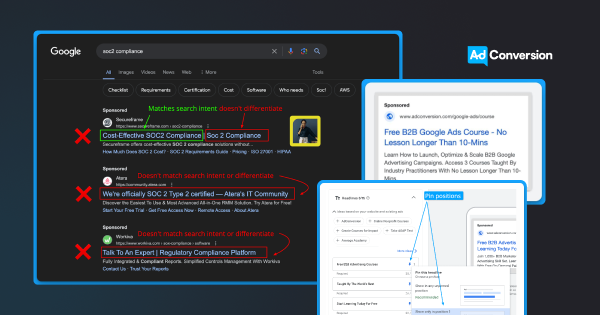
How to Write Effective Responsive Search Ads in 3 Simple Steps
Google Ads responsive search ads (RSA) don’t leave a ton of room available.
With 30 character headlines, and 90 character descriptions.
It’s tough to write persuasive and effective copy.
In this article you’ll learn a simple 3-step framework to write responsive search ads.
Let’s dive into it 👇
TABLE OF CONTENTS:
- The 3-Part RSA Writing Framework
- The Anatomy of a Responsive Search Ad
- Should you pin headlines and descriptions in Google Ads?
- Advanced copy tips for writing Responsive Search Ads
The 3-Part Google Ads RSA Writing Framework
Here's a simple 3-part framework for writing Google Ads copy:
- The goal of headline 1 = match intent
- The goal of headline 2 = differentiate between other results
- The goal of headline 3 = provide a clear CTA
Keyword: b2b google ads course
- H1: Free B2B Google Ads Course (matches intent)
- H2: No Lesson Longer Than 10-Mins (differentiates)
- H3: Join 1,000+ B2B Marketers (clear CTA)
Here's what it looks like in practice (image below):
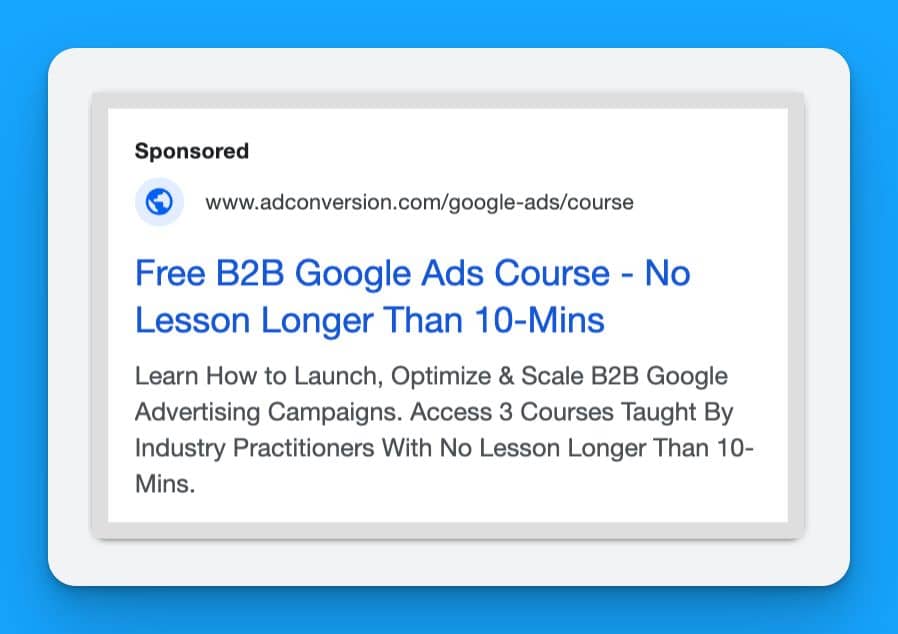
When writing, always assume the H3 isn't visible, and if only the H1 was displayed would they get it?
(Google is always testing different display variations)
From here you would write different variations per position.
With ensuring legibility between headline combinations.
Simple but effective ✌️let’s dive into each headline further.
The goal of headline 1 = match intent
You’ve got a fraction of a second for a prospect searching on Google to understand if your ad is relevant to their search term.
Don’t mess this up by being vague, asking rhetorical questions, or wasting valuable characters.

When it comes to Google Ads the headline 1 position would be eighty cents out of your dollar.
Maximize your headline 1 by adding the primary keyword in your copy to match intent.
This is such a simple thing to do, and equally not to.
The goal of headline 2 = differentiate between other results
Now that you’ve caught the searchers attention by matching intent it’s time to stand out.
Here’s a real example of what NOT to do from ads that appeared searching SOC2 compliance:
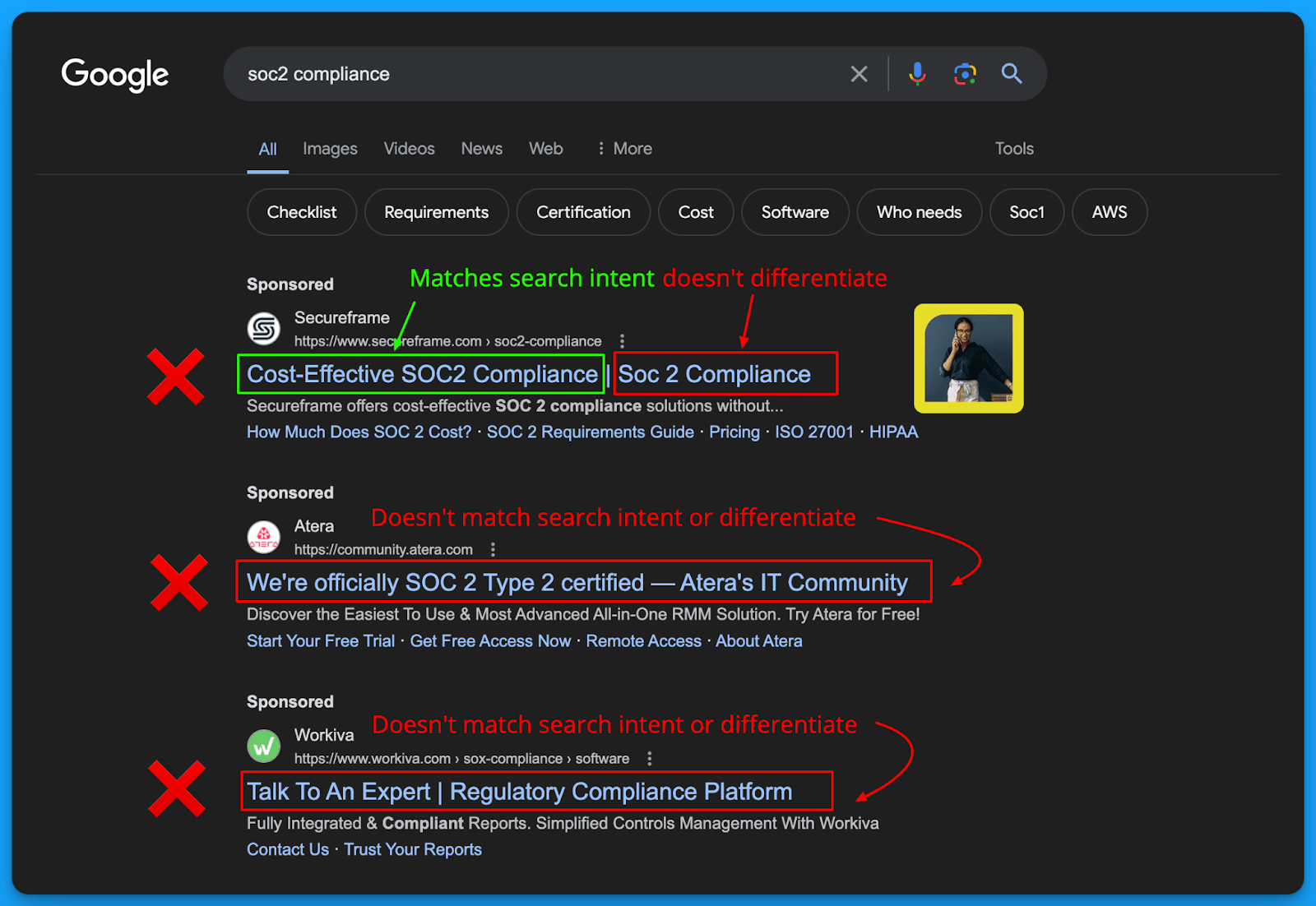
The sequence of which you write your headlines matter.
This is why I recommend following the 3-part framework as shown.
Use the headline 2 position to write a core benefit or outcome for differentiation.
The goal of headline 3 = provide a clear CTA
Finally in the third headline it’s time to provide a clear call to action.
This can be as simple as:
- Request a Demo
- See For Yourself
- Learn More Today!
When writing your H3 just assume it won’t be visible most of the time as Google is always experimenting with how they display headlines.
The Anatomy of a Responsive Search Ad
Now that you understand how to approach writing RSA copy.
Let’s discuss how responsive search ads actually function.
Character counts for Responsive Search Ads
- You can write up to 15 headlines, and 4 descriptions.
- 30 characters available per headline
- 90 characters available per description
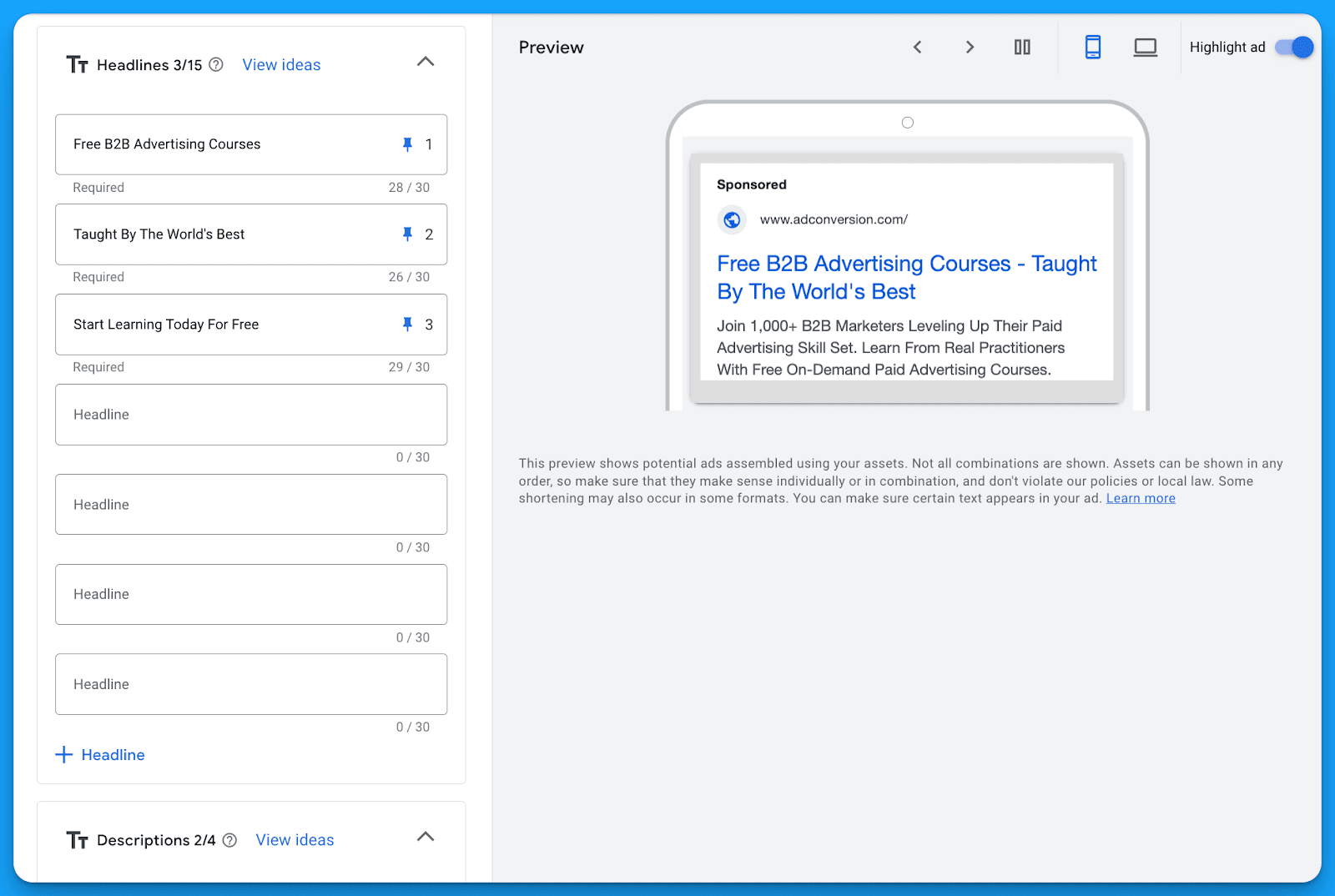
How Responsive Search Ads work
The idea behind responsive ads is Google will take your 15 headlines and 4 descriptions and automatically combine them to find the optimal variations based on machine learning.
The promise is you can leverage Google’s AI to do the heavy lifting as it will take into account a multitude of factors including keywords, search terms, devices, audience demographics and more.
Google also tries to guide advertisers on how well their doing when writing responsive search ads with their Ad Strength metric 💩(which we’ll cover in detail shortly).
With each headline and description you have the opportunity to pin positions.
This is where you’re forcing Google to only serve those variations within that specific placement.
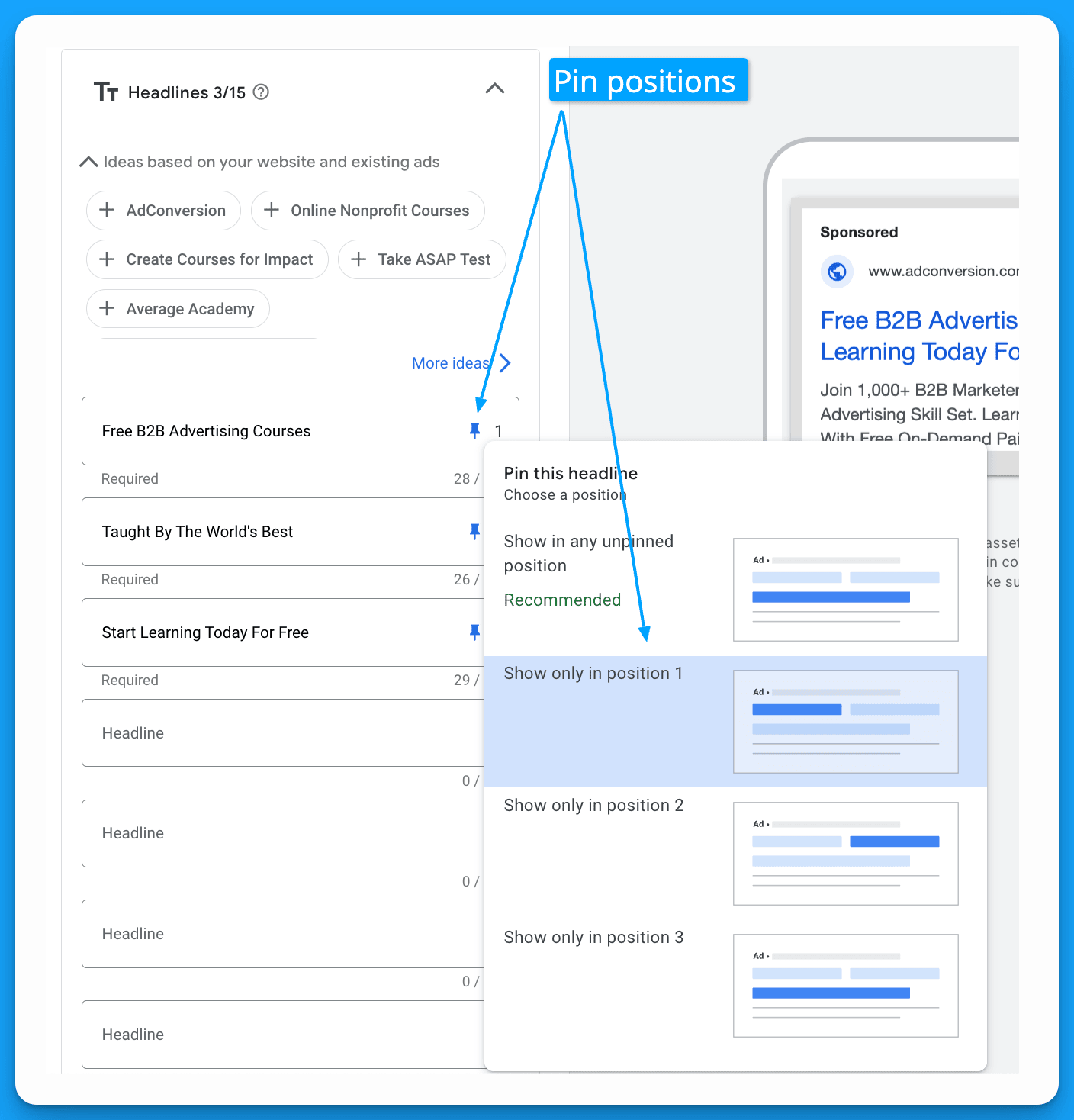
Should you pin headlines and descriptions in Google Ads?
The answer here is an unequivocal YES, because if your ads aren’t legible they won’t be clicked.
In a perfect world Google will automatically combine your headline and descriptions perfectly based on performance AND legibility but in reality it doesn’t happen.
Instead you end up with a bunch of variations like this:



I personally would LOVE ♥ ️ if Google’s AI can mix and match ads perfectly for performance and legibility but unfortunately the tech still isn’t there.
So in order to prevent this from happening I recommend strategic pinning.
How to pin Google Ads headlines strategically
In order to get the benefits of both Google’s AI to mix and match top performing headline/description combinations AND legibility you’ll need to pin strategically.
Here’s what it looks like in practice:
- Write 2-3 variations of Headline 1 and pin to position 1
- Write 2-3 variations of Headline 2 and pin to position 2
- Write 2-3 variations of Headline 3 and pin to position 3
- Write 2 variations of Description 1 and pin to position 1
- Write 2 variations of Description 2 and pin to position 2
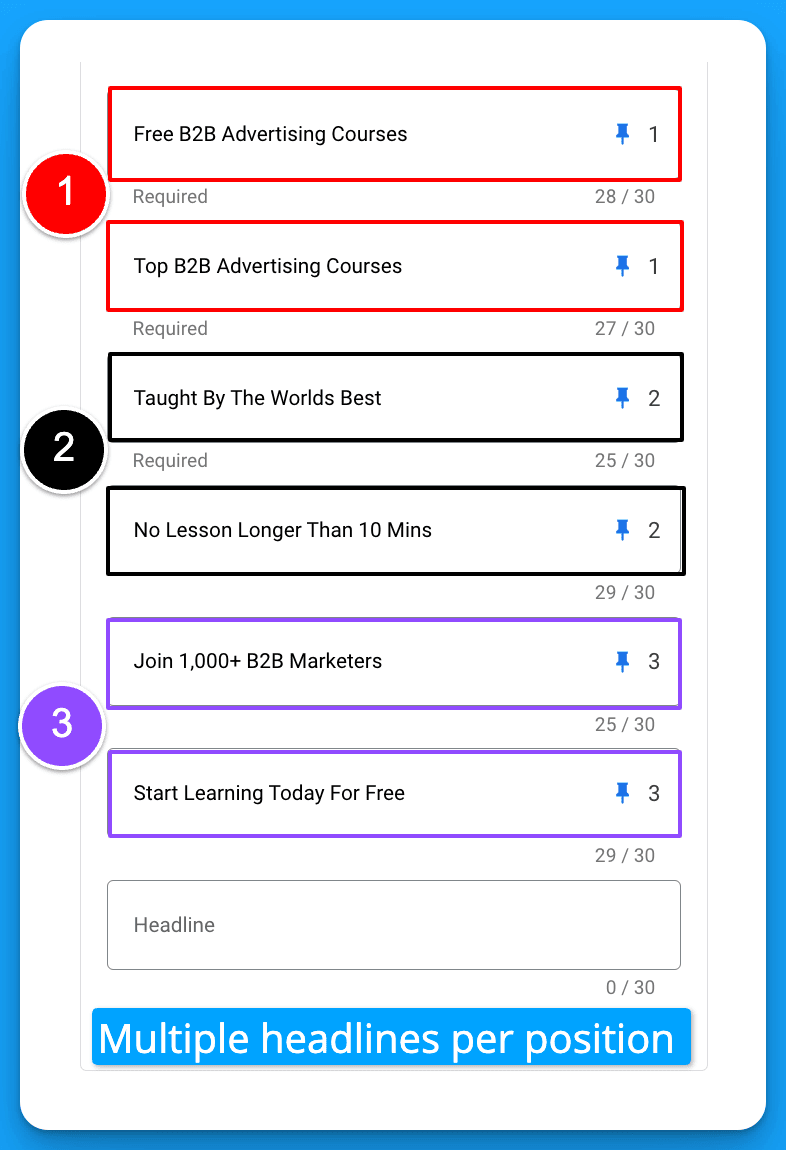
This will give you the benefit of testing multiple variations per position but safely as you can control which possible combinations are matched for legibility.
What is Ad strength and does it matter?
Ad strength is a score created by Google to help advertisers optimize their ad performance ranging from Incomplete → Poor → Average → Good → Excellent.

Ad strength misconceptions to be aware of
- Ad strength has ZERO bearing on actual performance, it's just a predictor of it.
- Having a poor ad strength doesn’t mean your ad won’t actually perform well.
- Having a poor ad strength doesn’t mean your ads won’t receive impressions.
What determines if your ad appears is your Ad Rank.

Pin strategically with 2-3 variations of headlines and you’ll be ok, it’s also what Google suggests if you decide to pin.

Advanced copy tips for writing Responsive Search Ads
Now that you know how to write effective responsive search ads let’s wrap with some advanced tips you can implement to make your ads perform even better.
Implement Dynamic Keyword Insertion (DKI)
Dynamic Keyword Insertion allows you to change your ad copy in real time based on the keywords that are triggering your ads in order to create more relevant experiences.
Currently there are 3 types of DKI available:
- Keyword Insertion = insert the keyword that triggers your ad
- Countdown = insert a timer that counts down to an event
- Location insertion = insert the location that triggers your ad

Test variations of your RSAs using relevant DKI parameters vs not to see if it impacts performance.
Leverage Business Name, Logo, and Image Ad Extensions
Now that Google allows you to highlight your business name and logo in your RSA, don't waste the characters anymore referencing your brand in your ad copy.
Save those valuable characters as you’re already getting brand awareness and instead maximize each character according to the 3-Part Google Ads RSA writing framework.
Ad extensions should always be used as a best practice but when it comes to writing effective Google Ads copy don’t forget to utilize your extensions to provide more information.
Hope you found this article helpful, best of luck on your next set of ads!
From Clicks to Conversions: Master Google Ads for B2B 🔥
If you want to become a Google Ads pro, check out our free B2B Google Ads courses, where you'll learn how to launch, optimize, and scale your campaigns to drive pipeline and revenue.

Here's what you'll learn in each course:
⚙️ B2B Google Ads 101 - How to Launch Dangerously Effective Campaigns for Beginners
- The Googleverse: The Game You're Playing & How To Win
- Measurement: How to Make Sure You're Profitable
- Targeting: How to Show Up For the Right Searcher
- Planning: Putting It All Together
🎯 Google Ads 102 - How to Clicks Into Profit
- Visibility: How To Find the Hole Sucking Profits
- Workflows: How to Optimize On a Daily, Weekly, Monthly & Quarterly Basis
- Experimentation: How to Test & Automate Profitability
- Troubleshooting: How To Solve Inevitable Problems
🚀 Google Ads 103 - How to Scale Google Ads For Advanced Advertisers
- Methodology: How to Vertically Scale Google Ads From A-Z
- Campaigns: Scaling Horizontally Through Campaign Themes
- Channels: Scaling Outside of Paid Search
Click Here to Join 1,000+ B2B Marketers Today and start leveling up your advertising skill set.
Takes < 90 seconds to sign up (seriously we timed it 😂)
People Also Ask
How can I effectively measure the performance of my RSAs?
Utilize Google’s Ad Strength indicator to assess the quality and relevance of your ads. Additionally, monitor key performance indicators (KPIs) such as click-through rates (CTR), conversion rates, and cost per conversion to evaluate ad effectiveness. 
What are the best practices for creating compelling headlines and descriptions in RSAs?
Develop diverse and unique headlines that highlight different aspects of your product or service. Incorporate relevant keywords in at least two headlines to improve ad relevance. Ensure that each headline and description provides distinct value to avoid redundancy.

Should I pin headlines and descriptions in my RSAs?
Strategically pinning headlines and descriptions can ensure legibility and relevance. Pinning specific headlines to designated positions helps maintain coherent messaging, especially when certain combinations may not make sense together. However, over-pinning can limit Google’s ability to optimize combinations. 
What role does Google’s machine learning play in the effectiveness of RSAs?
Google’s machine learning algorithms automatically test various combinations of headlines and descriptions to determine the most effective ad for each search query. By providing a diverse set of assets, you enable the system to optimize ad delivery and improve performance over time. 
How can I ensure my RSAs align with my overall marketing strategy?
Ensure that the messaging in your RSAs is consistent with your brand voice and marketing objectives. Regularly review ad performance data to make informed adjustments, and coordinate with other marketing channels to maintain a unified approach.

How to Create a Winning Google Ads Budget Strategy for B2B SaaS
Thinking about investing in Google Ads for your SaaS but not sure how much it will cost?
In this article I’ll break down how to create a winning budget strategy step by step.
You’ll walk away knowing how much you’ll need to invest on a daily, monthly, and quarterly basis.
And most importantly if Google Ads makes sense for your business.
Let’s dive into it 👇
TABLE OF CONTENTS:
- How much budget is required for a starting Google Ads budget?
- How to forecast a daily, monthly, and quarterly Google Ads budget
- How to allocate Google Ads budget by campaign strategy
- Frequently asked Google Ads budget questions
How much is required for a starting Google Ads budget?
This is the first question that usually comes to mind when considering Google Ads.
Which will then be met with a variation of questions such as:
- Is $10/day enough for Google Ads?
- Is $100/day enough for Google Ads?
- Is $1,000/day enough for Google Ads?
And so on, and so on…
When the reality is it’s all circumstantial based on the keywords you’re looking to target.
Equally important to how much is required is how many people are searching?
You could have a keyword that costs $0.01 per click but if only 5 people search is it really worth it?
So in order to answer this question you have to perform keyword research with the Keyword Planner.
Navigate to Tools > Planning > Keyword Planner within your Google Ads account to access it.
It doesn’t cost anything to open a free Google Ads account so anyone can access this tool.
Within the Google Ads Keyword Planner enter your dream keyword you want to research.
For example, I’ll use “google ads courses” as an example:

After researching I can see the following keyword costs and monthly volume estimates:
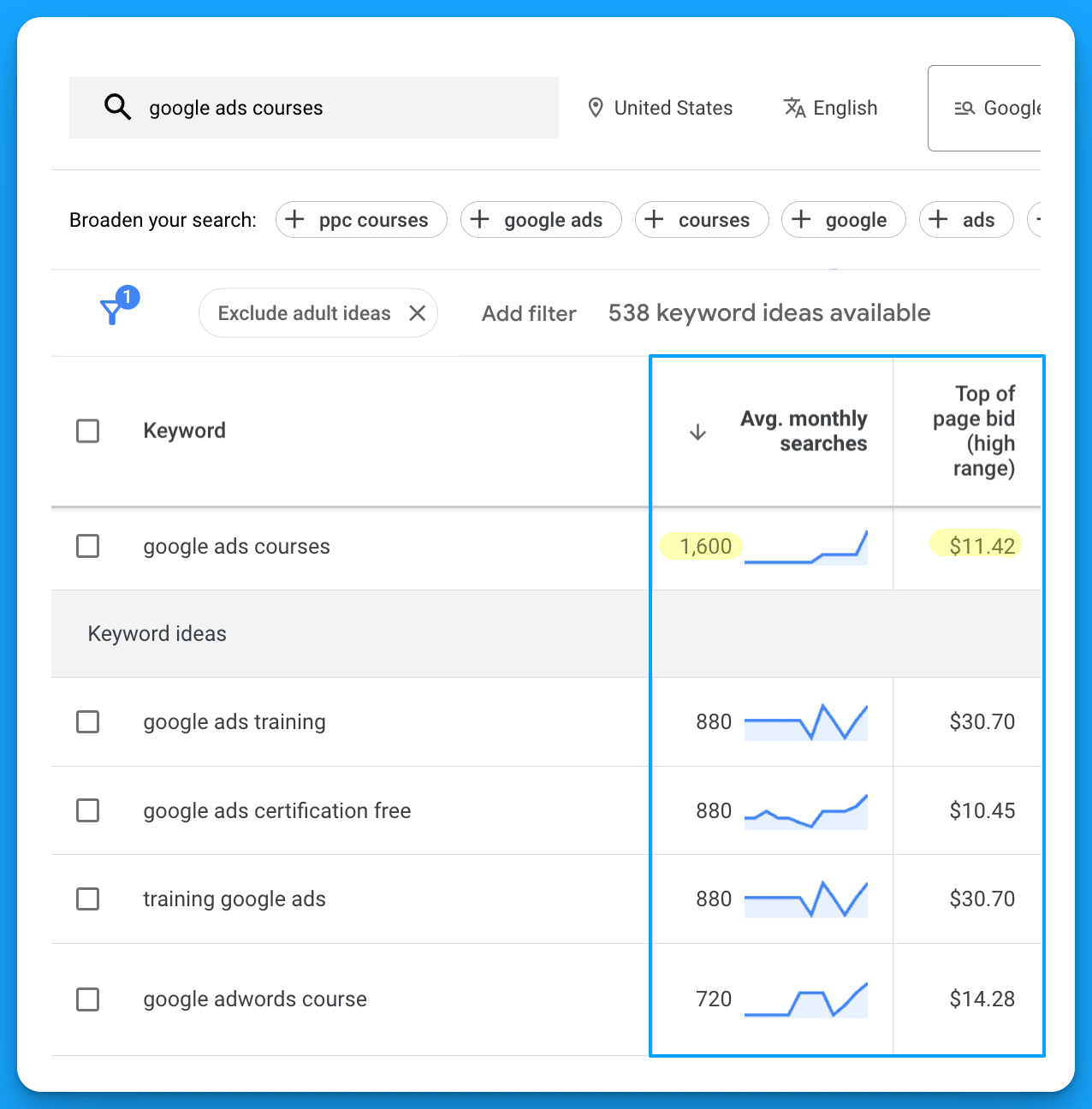
I recommend always using the top of page bid (high range) as your estimate.
I’ve never seen these estimates be 100% accurate and you’ll never know your real CPC until launch.
To account for this margin of error I recommend adding +20% on top of your top of page estimate.
This means in our google ads courses example:
- It would potentially cost me $13.7 per click ($11.42 +20%)
- I can receive up to 1,600 clicks per month in the USA.
Based on these two data points we can assume it’s possible to spend up to $21,920 per month on this keyword ($13.7 * 1,600).
Outside of the return on investment, don’t forget about return on effort.
If your dream keywords have very limited search volume (ex: < 100/month) it might not be worthwhile.
How to forecast a daily, monthly, and quarterly Google Ads budget
Once you know your estimated cost per click you’re ready to put together a forecast.
We’ve created a free Google Ads Budget Calculator tool that you can use to easily plan your daily, monthly, and quarterly budget.
You’re going to need the following information for the forecast:
- Your average cost per click (from the Keyword Planner or real data)
- Your quarterly sales goal
- Your average win rate
- Your average revenue per sale
With all this information at hand you’ll plug these different values into the calculator.
Based on your landing page conversion rates you can model a worst, moderate, and best case.

From here you can see how much it will cost to acquire a customer and the budget required to hit your sales volume target.
I highly recommend paying attention to the number of clicks required per lead, this will help frame expectations on how much traffic you’ll need and if your search volume is sufficient.
As you’ll see, your landing page effectiveness is essential at reducing costs 💥
With this forecast at hand you’ll know exactly how much to invest.
How to allocate Google Ads budget by campaign strategy
You should be clear on how much you’ll need to invest in your Google Ads campaigns.
Now the next step is to figure out how you’re going to allocate your budget.
In my experience managing Google Ads campaigns for B2B SaaS companies, there are five proven campaign themes to invest in; NonBrand, Brand, Competitive, RLSA, and Content.
Here’s my recommendation on budget allocation by each if you want to maximize volume.
Use all of these as starting points and modify the amounts based on your data/nuances.
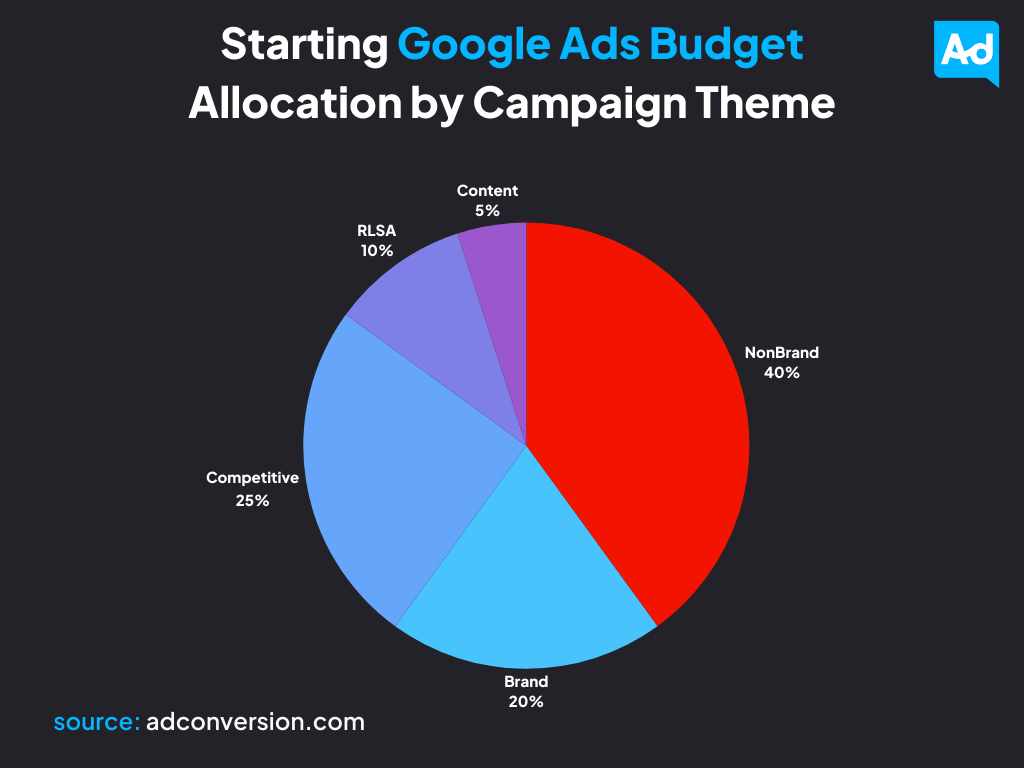
NonBrand = 40% of total budget
NonBrand campaigns are where you’re bidding on high-intent keywords that don’t include your brand, for example google ads courses would be non brand for us at AdConversion.
Think about your keywords you’d like to cover that problem aware prospects would search for.
NonBrand keywords typically contain high-intent modifiers such as:
- Software
- Platform
- Tool
- Technology
- Solution
If you have enough search volume on non brand keywords there’s no easier way to drive conversions than showing up for people looking for solutions to their problems.
Brand = 20% of total budget
Brand campaigns are commonly referred to as “defense” campaigns where you’re bidding on your own brand name to outrank competitors bidding on yours.
You can make the case that people searching your branded terms would convert anyways and it’s not worth the investment.
This is why I recommend no more than 20% of the total budget on this campaign initially.
I’ve seen exceptions here with some of our clients where they saw net new revenue decline significantly from pausing their branded campaigns.
Let your data guide your allocation.
Competitive = 25% of total budget
Competitive campaigns are the opposite of brand where you’re bidding on competitors' names to appear for their existing customers and prospects.
These campaigns can be really hit or miss depending on your execution.
Make sure you’re doing it in a classy way and have dedicated comparison pages.
This theme can be really powerful at driving qualified traffic as these searchers are solution aware.
RLSA = 10% of total budget
RLSA stands for remarketing list for search ads.
This just means search remarketing, anyone that searches your keywords AND is part of an audience.
For example, anyone that has been to your site in the past 90 days and is searching your keywords.
RLSA campaigns can be really powerful when you have enough site traffic and are dealing in competitive niches.
Depending on your available remarketing audience sizes you can decide if this makes sense initially.
Given the limitation of size we typically only allocate 10% here to begin.
Content = 5% of total budget
Content campaigns are great for supporting SEO efforts.
If you have certain keywords you’re struggling to rank for, content campaigns are worth investigating.
This is where you’re going to bid on longtail content related keywords that typically have much lower cost per click prices and drive that traffic to a blog or relevant content piece.
Depending on your content strategy I’d give this some consideration.
Hope you found this article helpful! and now know how to create a winning Google Ads budget strategy.
Frequently asked Google Ads budget questions
Does Google Ads work on a small budget?
Yes, and no. Small is relative to your average cost per click prices.
I’d recommend being able to afford at least 100 clicks per month.
Does Google Ads work for B2B SaaS?
Absolutely, intent is what makes Google Ads so powerful.
The biggest challenge for B2B SaaS is scale.
What is a good Google Ads budget?
A Google Ads budget is one where you can support your business objectives.
Using the following information you can create a forecast to understand what is good:
- Your average cost per click
- Your quarterly sales goal
- Your average win rate
- Your average revenue per sale
From Clicks to Conversions: Master Google Ads for B2B 🔥
If you want to become a Google Ads pro, check out our free B2B Google Ads courses, where you'll learn how to launch, optimize, and scale your campaigns to drive pipeline and revenue.

Here's what you'll learn in each course:
⚙️ B2B Google Ads 101 - How to Launch Dangerously Effective Campaigns for Beginners
- The Googleverse: The Game You're Playing & How To Win
- Measurement: How to Make Sure You're Profitable
- Targeting: How to Show Up For the Right Searcher
- Planning: Putting It All Together
🎯 Google Ads 102 - How to Clicks Into Profit
- Visibility: How To Find the Hole Sucking Profits
- Workflows: How to Optimize On a Daily, Weekly, Monthly & Quarterly Basis
- Experimentation: How to Test & Automate Profitability
- Troubleshooting: How To Solve Inevitable Problems
🚀 Google Ads 103 - How to Scale Google Ads For Advanced Advertisers
- Methodology: How to Vertically Scale Google Ads From A-Z
- Campaigns: Scaling Horizontally Through Campaign Themes
- Channels: Scaling Outside of Paid Search
Click Here to Join 1,000+ B2B Marketers Today and start leveling up your advertising skill set.
Takes < 90 seconds to sign up (seriously we timed it 😂)

14 Powerful LinkedIn Thought Leader Ad Strategies Worth Testing
Everyone knows that B2B buying has changed.
People trust people more than they trust companies, making thought leadership ads more important than ever before.
If you’re looking to use thought leader ads in your LinkedIn ad strategy but aren’t sure how to get started, this article is for you.
Here are 14 thought leader ad plays and examples you can test.
Let’s jump into it! 👇
TABLE OF CONTENTS:
- Play #1: Announce new product features, integrations, and partnerships
- Play #2: Highlight the main problem your product solves + the solution it provides
- Play #3: Highlight a case study featuring your own company
- Play #4: Highlight a case study featuring one of your customers
- Play #5: Generate buzz before attending an in-person event
- Play #6: Stay top of mind after an event
- Play #7: Promote your own event
- Play #8: Promote an upcoming webinar
- Play #9: Promote your newsletter
- Play #10: Celebrate Customer Wins
- Play #11: Demo different use cases of your product
- Play #12: Share long-form content with insights that your ICP would be interested in
- Play #13: Provide practical advice based on insights from your platform
- Play #14: Leverage social proof from existing customers
Play #1: Announce new product features, integrations, and partnerships
🔑 to success: Trust your audience. Target the experts and speak to them like they’re experts. Show them all the cool things they’ll be able to achieve with your product.
Example 1: Dreamdata

Example 2: Gong

Example 3: UserGems

Example 4: Dreamdata

Play #2: Highlight the main problem your product solves + the solution it provides
🔑 to success: After prospects read your content, they should be able to clearly articulate the problem your product solves + the solution it provides. If they can’t, you need to simplify your messaging.
Example 1: Apollo

Play #3: Highlight a case study featuring your own company
🔑 to success: Show how your team is using YOUR tool to reach YOUR goals – your company can serve as its own case study.
Example 1: UserGems

Example 2: Apollo

Example 3: Sendoso

Example 4: Salesloft

Play #4: Highlight a case study featuring one of your customers
🔑 to success: Clearly articulate how you’ve been helping an existing customer achieve their goals.
Example 1: Lavender

Example 2: Loxo

Play #5: Generate buzz before attending an in-person event
🔑 to success: Use an ABM list of attendees or ABM list of companies + key job functions to make sure you’re getting in front of the right people.
Example 1: HockeyStack

Play #6: Stay top of mind after an event
🔑 to success: Have an attendee post a recap after an event so that your brand is staying top of mind in the following weeks. The idea isn’t to push your product, but to keep raising awareness within key accounts.
Example 1: Sendoso

Play #7: Promote your own event
🔑 to success: Have your event speakers announce their participation on their personal pages and boost the posts to increase overall reach. This is a win for the speakers and for your company – speakers will feel supported and your event will get more registrations.
Example 1: Gleanin

Example 2: Gleanin

Play #8: Promote an upcoming webinar
🔑 to success: Clearly highlight the value of the webinar for your audience – what will they learn by attending? Make sure to tag the speakers to generate more interest.
Example 1: Sendoso

Example 2: Copy ai

Example 3: DoWhatWorks

Play #9: Promote your newsletter
🔑 to success: Keep it simple & highlight what people will get out of subscribing.
Example 1: Motion
.png)
Play #10: Celebrate customer wins
🔑 to success: Highlight customers when they win an award or achieve something big. This strategy provides social proof to help with prospecting efforts, but it’s also a great retention play, as it makes existing clients feel supported.
Example 1: Sendoso

Example 2: Lavender

Play #11: Demo different use cases of your product
🔑 to success: Have a senior leader – from your own company or one of your customers – educate prospects on how they can use your product to achieve their business goals.
Example 1: Dreamdata

Example 2: Clay

Example 3: Clay

Play #12: Share long-form content with insights that your ICP would be interested in
🔑 to success: Don’t tell everyone how great your product is – instead, show them the insights they could have access to if they used it. Also, make the content industry-specific. For example, content about conversion impact or email subject lines in B2B SaaS will be much more powerful than content about conversions or email in general.
Example 1: HockeyStack

Play #13: Provide practical advice based on insights from your platform
🔑 to success: Don’t provide generic advice that people have heard many times. Instead, give advice that your ICP may find surprising, and always back it up with data from your platform. This strategy is powerful because potential buyers will be grateful for the thought leader’s recommendations AND they’ll also relate the thought leader’s content to your organization (and hopefully be interested in learning more).
Example 1: Lavender

Play #14: Leverage social proof from existing customers
🔑 to success: Promote content from respected customers within your target industry highlighting the use cases and overall impact of your product.
Example 1: UserGems

Example 2: Clay

Putting LinkedIn Thought Leader ads into action
If you’re excited about thought leadership ads and want to start running them right away, here’s what I would recommend:
1. Find a few people at your organization that would be great thought leaders. They don’t need to be influencers with 50K followers – they simply need to have a deep understanding of your product and your ICP (bonus if they also enjoy writing).
2. Once you’ve selected your thought leaders, choose the top 3 strategies from this playbook that you’d like to begin with. I don’t recommend starting with all 14 strategies at once, since that could get pretty overwhelming.
3. Have your thought leaders post a few times per month and boost their content to your ICP.
That’s all you need to get started.
P.S.
If you’re starting out with thought leadership ads, I recommend using the engagement objective to build your retargeting audiences in a cost-effective way.
And if you want a complete masterclass on LinkedIn ads objectives, ad types, and bidding strategies, I highly recommend checking out this article by Ali Yildirim.
Master B2B LinkedIn Ads with these 3 Free Courses:
If you want to become a LinkedIn Ads pro, check out our free B2B LinkedIn Ads courses, where you'll learn how to launch, optimize, and scale your campaigns to drive pipeline and revenue.

Here's what you'll learn in each course:
⚙️ B2B LinkedIn Ads 101 - The Ultimate Crash Course for New LinkedIn Advertisers
- Foundations For LinkedIn Ads Success
- Measurement: Tracking & Key Principles
- Targeting: Reaching Your Dream Buyers
- Ads: Mastering The 9 Ad Formats
🎯 B2B LinkedIn Ads 102 - The Blueprint for LinkedIn Ads Optimization
- Monitoring: How To Spot Performance Trends
- Auditing: How To Find The Darlings You Need To Kill
- Reporting: How To Transform Data Into Insights
- Optimization: How To Make Your LinkedIn Ads Profitable
🚀 B2B LinkedIn Ads 103 - Advanced Scaling Strategies From $25M In Ad Spend
- Concepts of Scaling
- Divide and Conquer
- Learnings From $25M+ In LinkedIn Ad Spend
Click Here to Join 1,000+ B2B Marketers Today and start leveling up your advertising skill set.
Takes < 90 seconds to sign up (seriously we timed it 😂)
People Also Ask
What are LinkedIn Thought Leader Ads, and how do they differ from standard LinkedIn ads?
LinkedIn Thought Leader Ads allow companies to sponsor posts from individual profiles, such as company leaders or industry experts, rather than from the company page. This approach leverages personal connections and trust, often leading to higher engagement compared to standard company-sponsored ads. 
How can I select the right individuals for Thought Leader Ads within my organization?
Choose individuals who have a deep understanding of your product and ideal customer profile (ICP), and who are comfortable creating engaging content. They don’t need to be influencers with large followings; authenticity and expertise are key. 
What types of content work best for LinkedIn Thought Leader Ads?
Effective content includes announcing new product features, sharing case studies, promoting events or webinars, and providing practical advice based on insights from your platform. The goal is to offer valuable information that resonates with your target audience. 
How can I measure the success of my LinkedIn Thought Leader Ads?
Monitor metrics such as impressions, engagement rates, click-through rates (CTR), and conversions. Additionally, assess qualitative feedback like comments and shares to gauge how the content resonates with your audience. 
What are some best practices for creating effective LinkedIn Thought Leader Ads?
Ensure the content is authentic and aligns with the thought leader’s voice. Optimize the individual’s LinkedIn profile as it serves as a landing page for interested viewers. Use high-quality visuals, clear messaging, and include a call-to-action to guide the audience’s next steps.

10 Effective Account-Based Marketing Tactics For Modern B2B Marketers
Do you need to find out if ABM is the right approach for you & how you can get the most out of your efforts?
I had the pleasure of interviewing Brandon Alisoglu who’s achieved a 300% increase in demo bookings for B2B companies while maintaining a 50% SQL rate from ABM campaigns.
Here’s Brandon’s top 10 tips & tactics to maximize return on effort (ROE) for your ABM ads.
(In no particular order, they all matter)
TABLE OF CONTENTS
- Tip #1 - Assessing the Suitability of ABM for Your Business
- Tip #2 - Embracing the Long Game in Account-Based Marketing (ABM)
- Tip #3 - Create a Dossier of Information
- Tip #4 - Breaking Content to Audience Segmentation
- Tip #5 - Focusing on Outcomes: The "So What?" Factor in ABM
- Tip #6 - Drilling Into Personas & Messaging
- Tip #7 - A/B Testing Value Propositions
- Tip #8 - Set Aside Time to Ideate
- Tip #9 - Streamlining the Process with Templates
- Tip #10 - Don’t Skip Google
- Conclusion
- Resources for mastering B2B advertising
Tip #1 - Assessing the Suitability of ABM for Your Business
When evaluating ABM for your business, consider the nature of your target accounts and the practicality of a personalized marketing approach.
ABM is particularly effective for targeting large organizations or "whales" where the potential return justifies the extensive effort and resources required for highly tailored campaigns.
Challenges with ABM in Smaller Companies
In smaller companies, the lack of numerous distinct roles and seniority levels may limit the effectiveness of ABM strategies that rely on granular targeting and personalized messaging.
If a company is too small to segment effectively based on these criteria, the impact of a tailored ABM approach may be diminished.
ABM often involves high-ticket offerings and significant investment in marketing resources.
If the target account does not have the financial capacity or the organizational complexity, the return on investment might not be worth it.
Strategic Considerations for ABM
Evaluate potential accounts not just by their immediate size but by their strategic importance and the potential lifetime value they offer.
Consider more generalized targeted advertising strategies for smaller accounts that do not justify a full ABM approach.
These can still be effective by focusing on industry-specific pain points and solutions but do not require the level of customization and operational complexity associated with traditional ABM.
Identifying the Annual Contract Value (ACV) Benchmark
An ACV of around $20,000 is generally seen as a threshold where ABM becomes viable.
This benchmark suggests that the deal size is significant enough to warrant the detailed and personalized marketing efforts required in ABM.
Another practical measure is whether the contract value requires CFO approval.
The involvement of a CFO generally indicates that the deal is substantial enough to require careful consideration and alignment with strategic financial goals.
Tip #2 - Embracing the Long Game in Account-Based Marketing (ABM)
Unlike traditional demand generation tactics that may prioritize immediate results, ABM focuses on building engagement through a more deliberate and personalized approach.
The idea here is to build a meaningful relationship with key accounts.
In the same way, you wouldn't ask for a hand in marriage on the first date, successful B2B marketers shouldn’t ask prospects to talk to sales unless they've had some interaction before.

The Importance of Educating and Engaging
The early stages of ABM should center around education and awareness.
Allow targeted accounts to familiarize themselves with your brand and value propositions.
This foundational phase is important for setting the stage for deeper engagement.
Jumping directly to aggressive sales tactics like pushing for demos with accounts that have minimal interaction with your brand, is less likely to yield positive results.
Instead, nurturing relationships over time fosters trust and increases the likelihood of conversion when the account is ready.
Balancing Immediate Needs with Long-Term Strategy
While the emphasis on the long game is important, we realize the need to meet short-term sales targets is a pressing reality for most B2B marketers.
In such cases, employing a robust account scoring system can help identify which accounts are most ready to engage based on their behaviors such as:
- Website visits (specially high-intent pages)
- Ad engagement
- Email interactions
- Webinar attendees
For accounts that show clear signs of being in-market or closer to the decision stage, tailor your approach to convert these opportunities.
This can involve more direct calls to action, such as personalized demo invitations and running incentivized offers.
If your company is product-led, this would be a good time to offer free trials.
Sample of free trial ad by Plauti:

Tip #3 - Create a Dossier of Information
Understanding your prospects' interests, pain points, and engagement history comprehensively is the key to crafting personalized and effective ABM strategies.
This information equips sales teams with the required data to personalize their outreach effectively and accelerate the sales process.
Building & Targeting Prospect
Compile data on prospect activities, including the specific ads they clicked, pages they visited, or any communications they have sent.
This dossier should act as a dynamic document that sales teams can use to personalize their approaches.
By understanding what content the prospect has engaged with, the sales team can address specific interests or pain points, making their pitches more relevant and compelling.
Marketers can also use this data to launch 1:1 campaigns featuring social proof and objection handling.
If the list of accounts is not large enough for a 1:1 approach, then gather the top 3-5 most common objections that resonate with the majority of the accounts.
You can reduce the overall cost by dynamically excluding any account that has contacted sales.
Implementation Tips for Effective ABM
- Identify in-market accounts by using advanced analytics and account scoring to determine which of your target accounts are actively engaging with your content.
Tools like HubSpot or Marketo can help streamline the process.
- Once these engaged accounts are listed, segment them for targeted campaigns that address their specific stages in the buyer’s journey.
This segmentation allows you to apply more aggressive sales tactics appropriately while continuing to nurture less-ready accounts with educational content.
- Distribute content that educates and engages at various stages of the customer journey.
This tactical approach ensures that when you invite accounts to a demo or free trial they are informed and more likely to be receptive.
Successful ABM is a blend of patience and strategic agility, tailored to meet both the immediate and long-term goals of your business.
Tip #4 - Breaking Content to Audience Segmentation
The purpose of this step is to develop and deliver content that addresses specific pain points and interests identified in your prospect dossiers.
Strategies for Deepening Prospect Engagement
As you gather more data on your prospects' behaviors, such as the ads they click or the pages they visit, use this information to guide them through a personalized buyer's journey.
This involves crafting content that speaks directly to their needs and leading them to web pages that provide further value and deepen their engagement with your brand.
Regularly update and refine your ads to keep them in line with your audience's changing interests and needs.
Creating a Content "Buffet"
Offer a Variety of Content Options.
Imagine setting up a buffet of content options tailored to different tastes and preferences within your target accounts.
By providing a range of topics and formats—from whitepapers and case studies to webinars and interactive tools—you allow prospects to self-select the content that most resonates with them.
Use the insights from observed interactions to refine your understanding of what each prospect cares about.
This personalized approach not only enhances the relevance of your outreach but also increases the likelihood of a prospect's deeper engagement with your content.

Integrating Technology for Efficiency
While managing this level of personalized engagement can become complex, employing an ABM platform can streamline the process.
These platforms can help organize and automate content delivery based on user behavior, keeping track of interactions across different channels to maintain a cohesive and personalized marketing approach.
Pro tip:
Before fully investing in an expensive ABM tech stack, validate your strategy with simpler tools or minimal setups to prove its effectiveness.
A simple way is to use LinkedIn's demographic reporting to see which companies have been exposed to impressions, and which ones are actually engaging.
You can take it a step further and leverage a third-party data connector like data slayer to pull the demographic data from LinkedIn through API.
Tip #5 - Focusing on Outcomes: The "So What?" Factor in ABM
A critical aspect of effective ABM is ensuring that every piece of data, every content interaction, and every campaign has a clear and compelling answer to the question: "So what?"
Every action should educate, nurture, or capture leads, to bring you closer to revenue.

The Importance of Outcome-Based Messaging
In ABM, it's not enough to highlight the features of your product or the hours it can save a potential client’s team.
The key is to articulate what these benefits mean in the context of the customer’s specific business challenges and goals.
When discussing a product feature, such as "saves your engineering team 20 hours a week," it's essential to connect this benefit to tangible business outcomes.
For example, what does saving 20 hours a week mean for the company?
Could it lead to faster project completions, cost savings, or better resource allocation?
These outcomes are what will truly capture the interest of decision-makers.
By consistently focusing on the "so what?" of your actions and messaging, you can lift your ABM efforts from functional to transformational.
Pro-tip:
Establish Leading Indicators to Measure ABM Progress:
By establishing clear leading indicators across your marketing funnel, you can quantify progress and tie every action back to tangible business outcomes.
From initial awareness through engagement to conversion, each stage can be monitored and analyzed to ensure marketing efforts move potential clients closer to a sale.
These indicators provide a roadmap that justifies the investment by showing how specific activities contribute to moving accounts through the sales pipeline.
If you want to learn more about creating leading and lagging indicators along with actionable free templates check out the AdConversion Paid Media Program course; Module 2, lesson 1.

Tip #6 - Drilling Into Personas & Messaging
Within any given company, different levels of management and seniority have distinct priorities and challenges.
For example, C-suite executives might focus on strategic growth and scalability, directors on operational efficiency, and managers on tactical execution.
Tailoring your messaging to address these specific concerns can dramatically increase the relevance and impact of your communications.
Beyond role-based customization, consider the particular needs and pain points of the industry or vertical your target accounts might operate within.
Strategies for Effective A/B Testing
Implement continuous A/B testing across your campaigns to determine which messages resonate best with each persona.
Segment your target audience by role and seniority, and tailor your messages accordingly.
For example, test different value propositions with managers versus C-suite executives to determine which messages drive more engagement or conversions from each group.
Understand that the preferences and behaviors of your audience can evolve, and your ABM strategy should be agile enough to adapt to these changes.
Tip #7 - A/B Testing Value Propositions
By testing two to three variations of each message, you can discover appeals and incentives that resonate with distinct groups within the same role and seniority level.
In cases where the target company might not be large enough to segment by job titles or seniority due to LinkedIn’s filtering limitations, marketers need to think creatively about how to approach personalization and segmentation.
Alternative Segmentation Strategies:
- Use Broad Segments:
Instead of job titles, consider using job function and seniority or even adding member skills into the mix.
- Focus on Common Pain Points:
Leverage the common challenges or objectives identified in smaller organizations.
For example, if most employees are likely involved in decision-making due to the company's size, tailor messages that address broad business benefits that resonate across multiple roles.
As discussed earlier, knowing the top objections by vertical can guide the creation of content and ads that preemptively address concerns.
This is particularly useful when precise job title segmentation is not feasible.
Tip #8 - Set Aside Time to Ideate
In the fast-paced environment of account-based marketing, it's imperative to carve out dedicated time for creative thinking and experimentation.
By blocking out time on your calendar, preferably during quieter hours like Friday afternoons, you ensure that you have the space to think deeply and creatively about your ABM strategies.
Regular ideation sessions allow you to review current insights and performance data, enabling you to develop new approaches and refine existing ones.

Pro tip:
Leverage Experimentation and Documentation:
Incorporate a structured approach to experimentation.
Try out new ideas on a small scale to assess their effectiveness before rolling them out broadly.
Keep detailed records of your experiments, including:
- Hypotheses
- Execution details
- Outcomes.
This documentation enables you to capitalize on effective strategies and avoid past mistakes.
Tip #9 - Streamlining the Process with Templates
Keeping detailed and organized documentation of ABM activities, such as experiments, outcomes, and insights will save you lots of time & effort in the long run.
It can be as simple as using Google Docs with structured headings and a table of contents.
Consistent documentation helps in creating a reliable record that can be referenced in reports and strategy meetings.
Leveraging Design Templates
Design templates allow marketers to quickly generate new versions of ads or content without starting from scratch each time.
By standardizing the design elements, teams can focus on tweaking the messaging and content to better align with the target audience’s evolving preferences.
Using templates also ensures that all materials produced are aligned with the brand’s visual identity and messaging guidelines.
Effective Use of Templates and Documentation
Develop a range of design templates for different types of content and ads.
This library should include templates for social media posts, email campaigns, and other marketing materials that are frequently used in ABM campaigns.
Regularly update the documents with the latest results from A/B tests, data analysis insights, and feedback from sales and marketing teams to maintain accuracy and relevance.
Confirm that all team members are trained on how to use the chosen documentation and templates effectively.
With the design templates in place, focus on iterating on the creatives frequently.
Especially in smaller audience segments where ad fatigue can set in quickly.
Tip #10 - Don’t Skip Google
While (ABM) often focuses on direct and personalized communication channels like LinkedIn, incorporating Google Ads into your Demand Gen strategy can heavily reduce the overall cost per acquisition (CPA).
The Strategic Use of Google Ads
Google Ads allows you to address specific queries and pain points that your prospects are actively searching for.
By focusing on these queries, you can position your company as a solution provider right at the moment of need, effectively answering potential customers’ questions through targeted ads.
Often, niche or less competitive keywords related to specific industry questions or problems can be much cheaper than more general, high-intent keywords.
For example, targeting a specific industry debate or a lesser-known feature comparison can capture relevant traffic at a significantly lower cost.
This, not only increases brand awareness but also positions your company as an authoritative and helpful resource.
Creating content that addresses these queries and promoting it through Google Ads can drive highly targeted traffic to your website, increasing the chances of conversion.
Practical Tips for Implementing Google Ads
- Work with your sales and customer service teams to pinpoint the questions and topics that commonly arise during the sales process.
- Use these insights to guide your keyword and content strategy for Google Ads.
Develop content that answers these questions comprehensively.
This could be in the form of blog posts, FAQs, or educational articles.
- Use the identified keywords to set up Google Ads campaigns.
Start with a lower budget to test the effectiveness of your keywords and ads.
Monitor the performance and adjust your strategy based on the results.

Conclusion:
In this article, we discussed the significance of Account-Based Marketing (ABM) strategies through 10 practical tips and tactics to get the most out of your marketing efforts.
We explored the value of a long-term engagement strategy, emphasizing the need to build relationships through educational content and gradual interactions, rather than taking a direct approach.
Effective ABM involves understanding target accounts' specific needs and behaviors, employing analytics for better targeting, and continuously iterating on creative content to maintain relevance and combat ad fatigue.
Bookmark this blog as your comprehensive guide for your next ABM efforts to make sure your strategies align with the overall company goal.
If you’d like to reach out or get more weekly tips, please connect with Brandon via Linkedin.
Resources for mastering B2B advertising
If you’re serious about mastering B2B advertising then you definitely need to join 1,000+ B2B marketers leveling up their paid advertising skill sets in AdConversion.
Here’s 4 reasons why you should consider joining. Every one of our on-demand courses are:
✅ 100% free access.
✅ Taught by vetted industry experts.
✅ Have workbooks, resources, and templates.
✅ Less than 10 minutes per lesson.
We believe every marketer should know how to scale paid ads so they can:
- Scale their ideas
- Level up their careers
- Make a positive impact
Click Here to Join 1,000+ B2B Marketers Today and start leveling up your advertising skill set.
Takes < 90 seconds to sign up (seriously we timed it 😂)
People Also Ask
How can I effectively measure the success of my ABM campaigns?
Utilize key performance indicators (KPIs) such as engagement levels with target accounts, conversion rates, deal velocity, and revenue growth from those accounts. Implementing a robust analytics framework will help in tracking these metrics accurately.
What are the common challenges in aligning sales and marketing teams for ABM, and how can they be overcome?
Challenges include differing objectives, communication barriers, and data silos. Overcome these by establishing shared goals, fostering regular interdepartmental meetings, and utilizing integrated CRM systems to ensure both teams have access to the same account information.
How can I personalize content effectively for different stakeholders within a target account?
Develop detailed personas for each stakeholder role, understanding their specific pain points and objectives. Tailor your messaging to address these unique concerns, ensuring relevance and resonance with each individual.
What role does technology play in scaling ABM efforts, and which tools are essential?
Technology facilitates the automation and scaling of ABM strategies. Essential tools include CRM systems for managing account information, marketing automation platforms for campaign execution, and analytics tools for measuring performance.
How can I ensure data quality and accuracy in my ABM initiatives?
Regularly update and cleanse your data to maintain its accuracy. Implement data governance policies and utilize data enrichment services to fill in any gaps, ensuring your ABM efforts are based on reliable information.
.png)
Intro to B2B Google Ads: Crash Course For New Advertisers
Want to master Google Ads for B2B?
We’ll dissect Google Ads from a 10,000 foot view in this guide.
So you can walk away knowing:
- What is Google Ads?
- Is your ideal B2B buyer searching on Google?
- How can you get your ad seen on the top of Google?
- How much does Google Ads cost?
So whether you’re a SaaS founder, performance marketer, or in-house marketer looking to:
- Scale demo and trial requests for your new B2B SaaS startup
- Run Google ads for clients or launch campaigns internally
- Work with freelancers or agencies running your Google Ads
It all starts here with the fundamentals, so let’s dive in! 👇
TABLE OF CONTENTS
- What is Google Ads?
- Is Your Ideal B2B Buyer Searching on Google?
- How Much Does Google Ads Cost?
- How to Forecast Your Google Ads Budget
- Why is Google Ads So Powerful?
- How Can You Get Your Ad Seen on the Top of Google?
What is Google Ads?
Google Ads is an auction place.
Or as I like to think about it, a battleground.
Where you have thousands of advertisers competing against each other to show up on the top of Google when their ideal prospect searches for their products & services.

With 8.5B + searchers happening per day on Google there is a very HIGH likelihood your ideal B2B buyer is using Google to find information, and research solutions.
Is Your Ideal B2B Buyer Searching on Google?
Depending on the niche you’re in Google may or may not make sense.
You can create a free Google Ads account and leverage the Keyword Planner to validate demand.
All you need to do is research the ideal keyword your dream buyer would search and review the average monthly search volume and top of page bid estimates.
In the example below, I can see that for “email marketing software” there is:
- 1,000 - 10,000 average monthly searches
- $49.75 top of page bid estimate
If your ideal keyword has > 100 searches per month, Google can be a worthwhile return on effort.
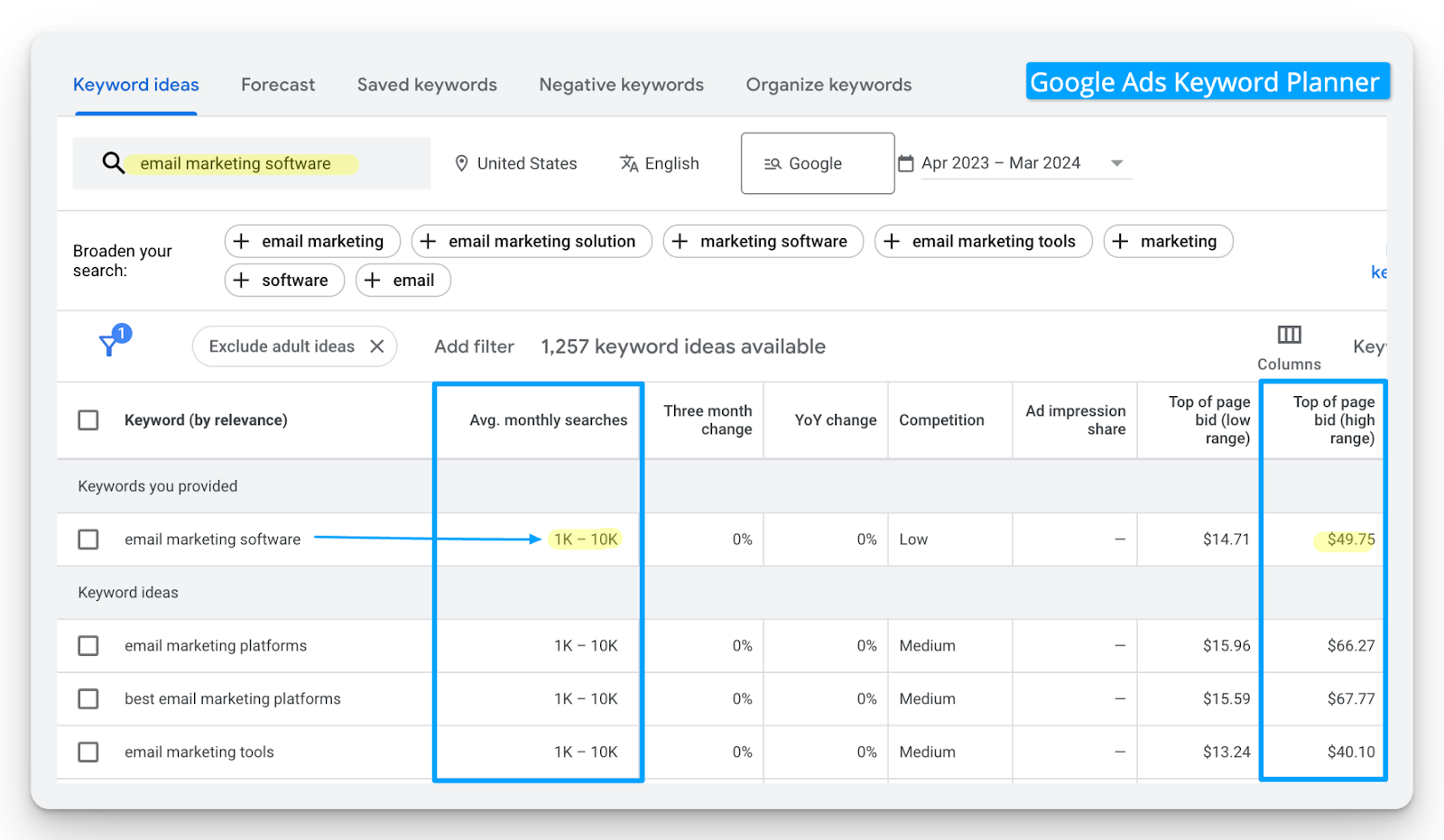
How Much Does Google Ads Cost?
Before diving into how much does Google Ads cost?
With Google Ads you’re only charged on a cost-per-click (CPC) basis.
Meaning you only pay Google if someone clicks your ad, so unlike traditional advertising you’re not being locked into a fixed contract and paying just for eyeballs (aka impressions).
So in short if someone sees your Google Ad and doesn’t click, you won’t pay.
This is what makes Google Ads so attractive, but extremely competitive.
Here’s two ways to find out how much Google Ads will cost for your ideal keywords:
1/ Review Top of Page Bid Estimates in the Google Ads Keyword Planner
As shown in the previous step you can leverage the Keyword Planner to find bid estimates.
In my experience these estimates are never 100% accurate and recommend adding 20% on top of the top of page bid estimate to be safe.
For example, with the keyword of email marketing software we have a $49.75 top of page bid estimate, adding 20% makes it $59.70 allowing us a margin of error to better set expectations.
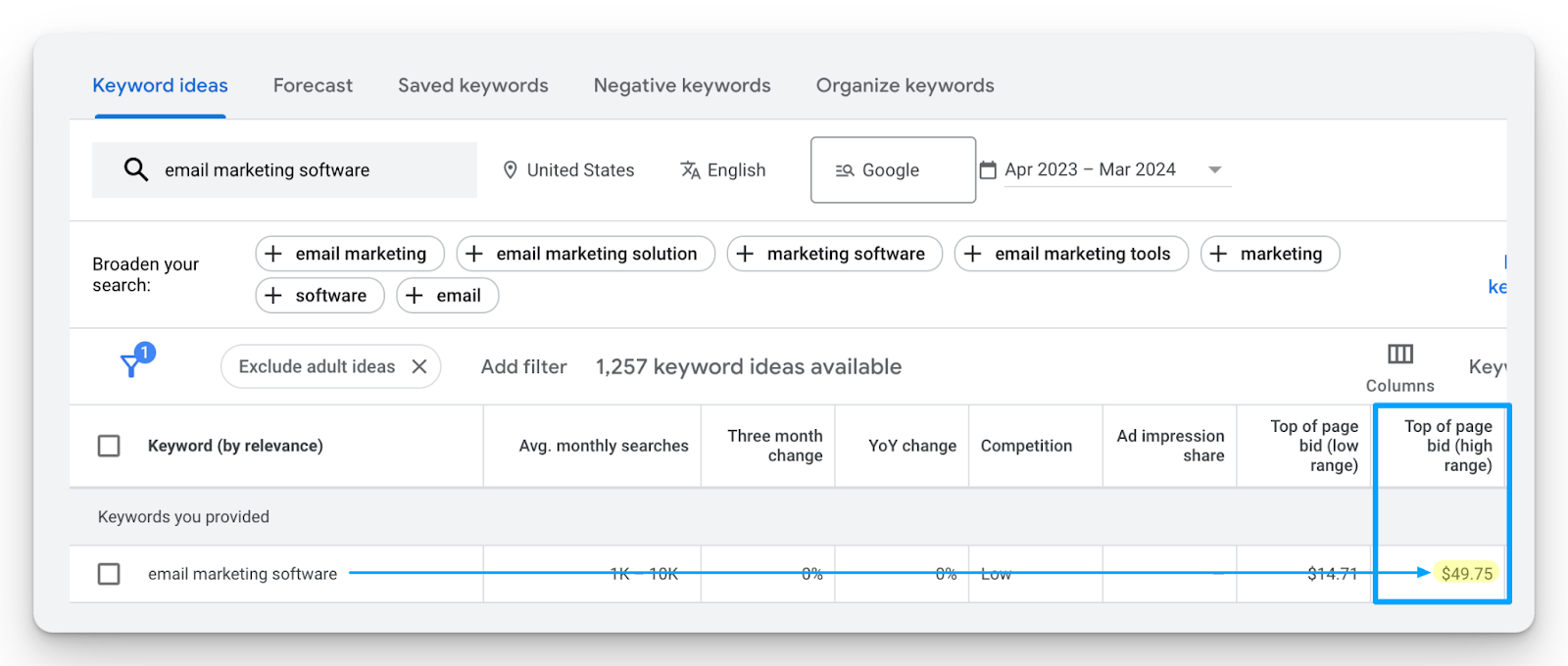
2/ Launch a Pilot Campaign for $100
Ultimately you’ll never know your real cost per click prices until launching.
If you’re seriously considering Google Ads I recommend launching a pilot campaign for $100.
The whole objective of this campaign is to understand; what is my REAL cost per click price?
Here’s a simple cheat sheet for setting up this campaign:
- Campaign Name = {Region}_{KeywordTheme}_{MatchType}
- Locations = {Your Target Country/Region/State}
- Match Type = Exact
- Bidding = Manual CPC
This setup will allow you to have the greatest control to discover your real CPC prices.
How to Forecast Your Google Ads Budget
Once you know the following:
- Your quarterly sales goal
- Average cost per click
- Opportunity win rate
- Revenue per sale
You can easily forecast a daily, monthly, and quarterly budget using our Google Ads Budget Calculator based on worst, moderate, and best case scenarios.
Give it a look, there’s a video tutorial on the page for you explaining the process.

Why is Google Ads So Powerful?
Intention Is what makes search advertising so powerful 🤝
You can reach exactly the right person, in the right place, in the right location searching for your specific product or service. At that point all you have to do is show up and not mess things up.
I always say Google Ads is a blessing and a curse; they bless you with intent, and curse you with scale.
Given your industry search volume will vary dramatically and it can become hard to scale.
The key is to win Google’s Ad Rank game to offset competitors and rising click prices.

How Can You Get Your Ad Seen on the Top of Google?
Every time you search for something on Google (or other search engines such as Yahoo, Bing, and Firefox) the results page you’re directed to afterwards is the Search Engine Results Page (SERP).
I like to think of the SERP as the Battleground in which Google Ads takes place.
The SERP is Divided Between Paid and Organic Results.
The Google SERP usually has about 3-4 paid ads at the top and 3 at the bottom.

Ad Rank Determines the Position of Your Ad on the First Page
Which determines if your ad is on top of the first page of or nowhere to be seen.
Your goal is to appear in the top 3 spots as click-through rates decline with lower positions.
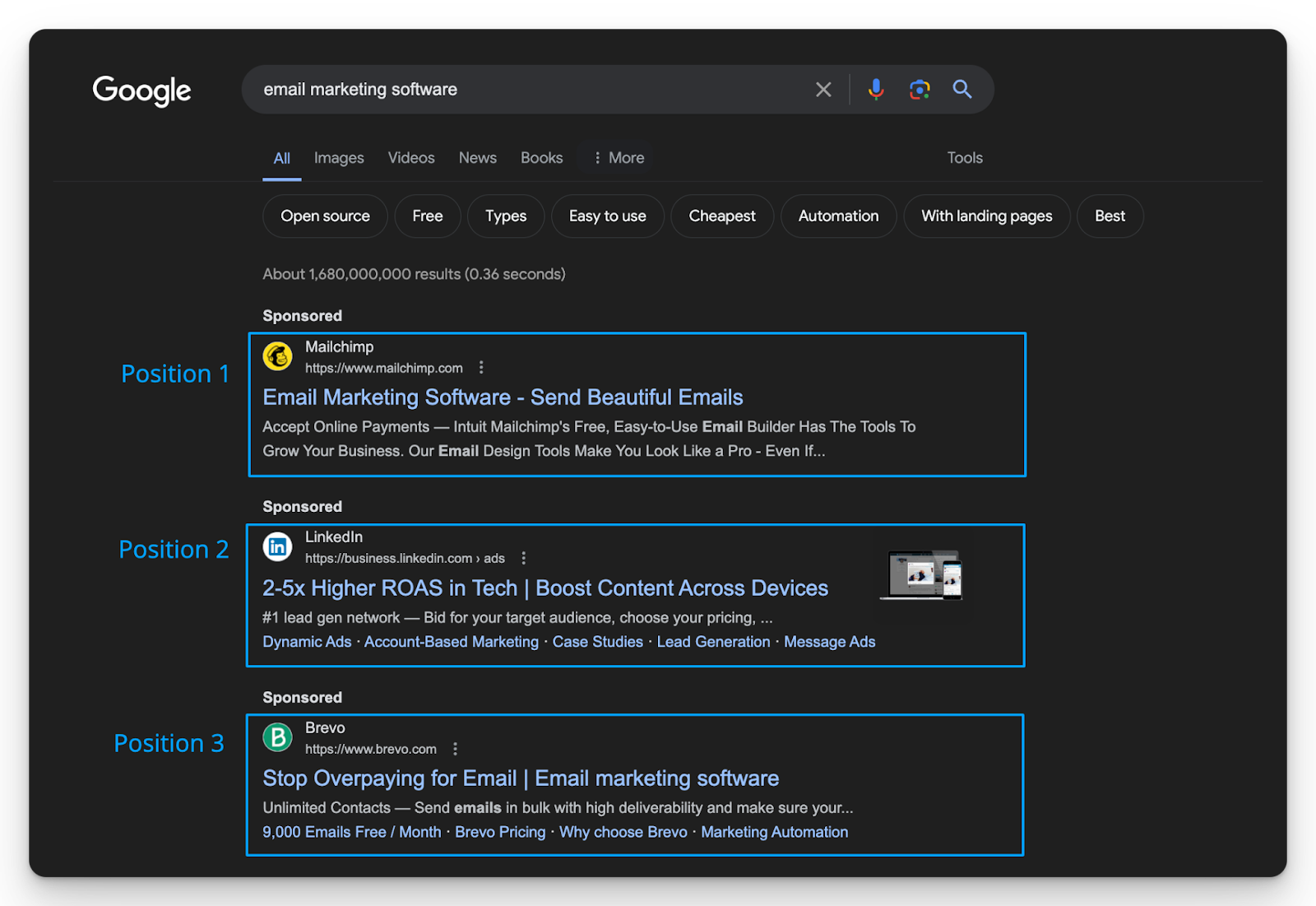
Higher Position Doesn't Always Mean Greater Cost
The remarkable thing about Google Ads is that you can be #1 on the page and pay less than your competitors who are in positions lower than you (hypothetical example below).
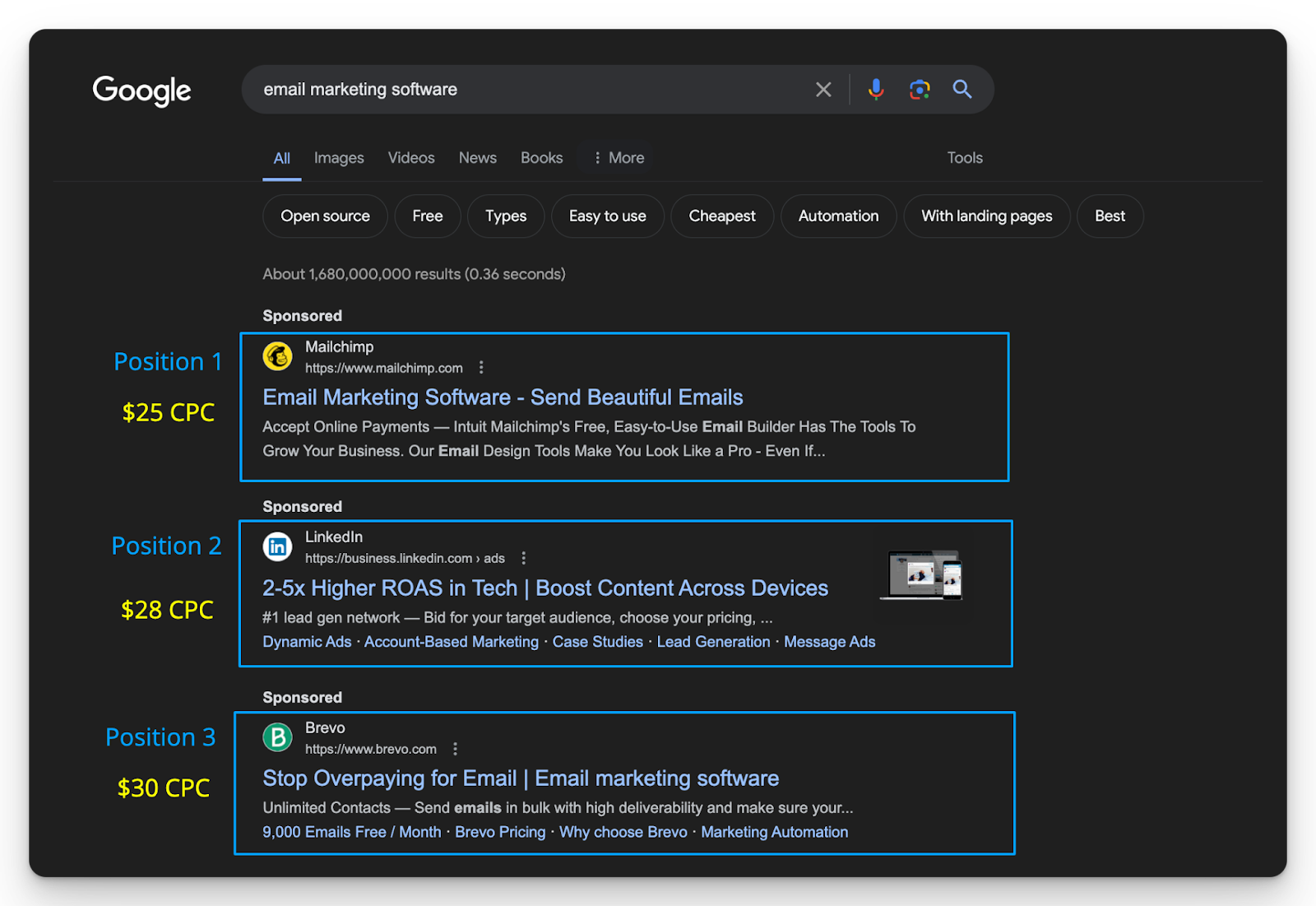
If after reading this article you believe Google Ads is worth further exploration.
Build on this fundamental understanding of Google Ads for B2B.
Hope you found this useful!
From Clicks to Conversions: Master Google Ads for B2B 🔥
If you want to become a Google Ads pro, check out our free B2B Google Ads courses, where you'll learn how to launch, optimize, and scale your campaigns to drive pipeline and revenue.

Here's what you'll learn in each course:
⚙️ B2B Google Ads 101 - How to Launch Dangerously Effective Campaigns for Beginners
- The Googleverse: The Game You're Playing & How To Win
- Measurement: How to Make Sure You're Profitable
- Targeting: How to Show Up For the Right Searcher
- Planning: Putting It All Together
🎯 Google Ads 102 - How to Clicks Into Profit
- Visibility: How To Find the Hole Sucking Profits
- Workflows: How to Optimize On a Daily, Weekly, Monthly & Quarterly Basis
- Experimentation: How to Test & Automate Profitability
- Troubleshooting: How To Solve Inevitable Problems
🚀 Google Ads 103 - How to Scale Google Ads For Advanced Advertisers
- Methodology: How to Vertically Scale Google Ads From A-Z
- Campaigns: Scaling Horizontally Through Campaign Themes
- Channels: Scaling Outside of Paid Search
Click Here to Join 1,000+ B2B Marketers Today and start leveling up your advertising skill set.
Takes < 90 seconds to sign up (seriously we timed it 😂)
People Also Ask
How can I effectively integrate Google Ads into my existing B2B marketing strategy?
Align your Google Ads campaigns with your overall marketing objectives by ensuring consistent messaging across all channels. Coordinate with sales and marketing teams to create cohesive campaigns that guide prospects through the sales funnel.
What are the best practices for managing budgets in B2B Google Ads campaigns?
Regularly monitor and adjust your budget allocation based on campaign performance. Prioritize spending on high-performing keywords and ads, and consider implementing bid strategies that align with your goals, such as target CPA or ROAS.
How can I leverage Google’s audience targeting features for B2B advertising?
Utilize features like custom intent audiences to reach users actively searching for products or services similar to yours. Combine this with demographic targeting to focus on decision-makers within your target industries.
What role does ad scheduling play in optimizing B2B Google Ads campaigns?
Implement ad scheduling (dayparting) to display your ads during times when your target audience is most active. This ensures efficient budget use and increases the likelihood of engagement during peak business hours.
How can I ensure compliance with Google’s advertising policies in B2B campaigns?
Regularly review Google’s advertising policies to ensure your ads meet all guidelines. This includes adhering to content standards, avoiding prohibited practices, and ensuring transparency in your ad copy and landing pages.

B2B vs B2C Advertising: 8 Differences & Examples You Need To Know
Hey there new B2B marketer!
Diving into the world of B2B advertising can be confusing and overwhelming.
In this article I’m going to walk you through 8 differences between B2B & B2C you need to know.
This article is part of our B2B learning track so if you’re serious about learning B2B advertising you’re in the right place!
Let’s dive into it 👏
TABLE OF CONTENTS:
- 8 Biggest Differences Between B2B and B2C
- The Cost of The Product
- How Purchase Decisions Are Made
- The Average Sales Length
- Smaller Audience Sizes
- Different Distribution Strategies
- Need to Support Multiple Sales Funnels
- Team Sport, Not Individual
- Go Further Than Just The First Conversion
8 Biggest Differences Between B2B and B2C
In no particular order of importance, here are the 8 biggest differences between business-to-business (B2B) and business-to-consumer (B2C) advertising.
The Cost of The Product
The first key difference between B2B and B2C is the cost of the product.
B2B marketers call this the average deal size or average contract value depending on what is sold.
Typically, B2B products are more expensive ranging from $1,000 to over $250,000.
How Purchase Decisions Are Made
In B2B buying, there will be more people involved in the purchase of the product compared to B2C where there is usually only one person involved.
This is often referred to as a buying committee, in B2B your job is to nurture, educate, and reach everyone in this group so they can collectively decide to purchase the product.
The Average Sales Length
There are more people involved with purchasing the B2B product or service and the product is typically a more expensive purchase, the length of time to purchase that product is typically longer.
Depending on the complexity of what is being bought, sales cycles can range from 30 days to 36 months. The higher and more complex the product or service is the longer the sales cycle typically is.
This is different from B2C because it can take me 30 seconds to buy something off an Instagram ad.
I’m not sure if that’s a good or bad thing 🤣
Smaller Audience Sizes
With B2B advertising programs, you’ll be targeting smaller audiences across ad channels.
Your audience will typically be less than 300,000 contacts with a focus on reaching the right person and company vs B2C where your audiences will typically be much broader than this since more people can purchase your product or service.
Different Distribution Strategies
Since you’ll be reaching a much more targeted audience, and you may be dealing with a specific budget – the ad channels you decide to use may look different than your B2C advertising counterparts.
It all comes down to where your audience lives and breathes, digitally.
Believe me, I’ve been behind some powerful Facebook ads for B2B. But, you may think twice about using a TV commercial during the Super Bowl as a B2B marketer (well…unless you’re Salesforce!)
But again, this will all depend on your budget and the breath of your buyers.
Need to Support Multiple Sales Funnels
In B2B, your advertising campaigns will support and fuel multiple sales funnels and processes.
The big three are product-lead, sales-lead, and a hybrid of both.
You can learn more about each revenue model in our B2B Advertising Guide.
Team Sport, Not Individual
B2B advertising requires strategic alignment across multiple teams including sales, marketing, and customer success departments to support the buyer’s journey and close deals more effectively.
Given the fact that it’s not just about reaching a specific individual but also a company.
This increases the importance and complexity of working across teams.

Go Further Than Just The First Conversion
The B2B sales processes are more complex and there's more buyers involved.
Your advertising campaigns should be designed to help impact the entire buyer journey.
Not just the first conversion like B2C advertising.

I hope you found this article helpful!
Connect with me on LinkedIn, and let’s keep the conversation going.
You can also visit my website here for more valuable content.
Jumpstart Your B2B Marketing Career

If you’re serious about mastering B2B advertising, then you definitely need to check out my free course that will teach you the foundational knowledge to becoming a high-performing B2B marketer who knows how to use advertising to drive legit business and revenue impact without the fluff or wasting your time and money learning the ropes the hard way.
- Module 1: You’ll get a crash course in the B2Bverse and master terminology, sales processes, and working across teams.
- Module 2: You’ll learn how to become your customers' psychologists and understand them deeply through buyer personas that allow you to craft effective messaging.
- Module 3: You’ll master the B2B funnel and learn how to think like a CEO to identify performance bottlenecks and convert more leads into revenue.
- Module 4: You’ll learn how to put it all together and build your go-to-market strategy that gets your ad in front of your dream buyers and converts attention.
This course was designed with absolute beginners in mind.
Accelerate your learning curve and start the course today for free.
People Also Ask
How do customer expectations differ between B2B and B2C markets?
B2B customers typically expect detailed information, personalized communication, and long-term value, focusing on how a product or service can address specific business needs. In contrast, B2C customers often seek quick solutions, emotional satisfaction, and immediate benefits, valuing convenience and brand experience.
What are the implications of these differences for customer service strategies?
In B2B markets, customer service should be consultative, offering tailored solutions and ongoing support to build strong relationships. For B2C markets, customer service should prioritize efficiency, accessibility, and positive experiences to foster customer loyalty and satisfaction.
How do pricing strategies vary between B2B and B2C businesses?
B2B pricing often involves negotiation, volume discounts, and customized quotes based on the client’s specific requirements. B2C pricing is generally fixed, with occasional promotions or discounts aimed at attracting a broad consumer base.
What role does branding play in B2B versus B2C marketing?
In B2B marketing, branding establishes credibility and trust, positioning the company as a reliable partner. In B2C marketing, branding focuses on creating an emotional connection and brand loyalty among consumers.
How do digital marketing strategies differ between B2B and B2C companies?
B2B digital marketing often leverages content marketing, LinkedIn outreach, and email campaigns targeting decision-makers. B2C digital marketing utilizes social media platforms, influencer partnerships, and broad-reaching advertising to engage consumers.
.png)
How to Craft B2B Buyer Personas For Ad Targeting
Hey there B2B marketing grasshopper 👋
In this article, we're channeling our inner Mr. Miyagi from "The Karate Kid," because we're about to master the art of creating B2B buyer personas.
Wax on, wax off style – but with less wax and more wisdom!
Let’s dive into it.
TABLE OF CONTENTS:
- What Is a B2B Buyer Persona?
- 3 Major B2B Marketing Personas
- How to Develop a B2B Buyer Persona
- The Five B2B Buyer Persona Segmentations
- B2B Buyer Persona Template
- Translating B2B Buyer Persona’s into Ad Targeting
What Is a B2B Buyer Persona?
Just like Daniel-san needed to understand his opponents in the All Valley Karate Tournament, it's important to understand your B2B buyer personas to win in the market.
It's critical because these personas are your roadmap – they guide every marketing punch and kick you make.
If you don’t do this, your marketing efforts might be as off-target as Daniel-san trying to catch a fly with chopsticks on his first try.

We're talking about misdirected resources and messaging that misses the mark, leaving your ROI down and out — so let's break it down, Karate Kid style:
What is a persona? It’s the semi-fictional characters that make up your target audience. It’s a great way to unpack who makes up your ideal customer profiles, called an “ICP”
3 Major B2B Marketing Personas
In B2B marketing there are 3 major personas or roles to understand in the sales process.
This is also referred to as a buying committee:
- Decision Maker – The person who makes the final decision to purchase
- Champion - A person who enthusiastically supports your product or service in their organization
- Influencer - A person who can influence other members of the buying committee

Your marketing and advertising efforts should address their needs and concerns when it comes to buying and using your product or service.
Knowing what these personas are looking for will help you tailor your messaging to make your ads stand out.
For example: imagine your buyer persona 'Finance-Manager-Frank'. He's in his mid-40s, loves numbers more than karate, and is always on the lookout for tools that bring efficiency and balance. Where does he find his information? → LinkedIn and financial blogs
Knowing this, you’d be able to hone in your advertising strategy to use LinkedIn ads to demonstrate how finance managers find more efficiency from their investments by using your product.
How to Develop a B2B Buyer Persona
There’s 5 major segmentation buckets to consider when putting together a B2B buyer persona:
- Demographic Segmentation
- Targeting potential customer based on their role (ex: Job Titles, Job Functions)
- Firmographic Segmentation
- Targeting potential customers based on company traits (ex: Industry, Company Size)
- Geographic Segmentation
- Targeting potential customers based on their company and physical location (ex:USA)
- Technographic Segmentation
- Targeting potential customers based on the tech they use (ex: Slack, Teams)
- Behavioral Segmentation
- Fine tune your messaging based on your potential customers Jobs To Be Done, decision-making process, and more.
Within each segmentation, there’s key information you should collect to build your personas which will ultimately inform your advertising channel strategy, targeting, and messaging.
Getting crystal clear on your buyer personas will also help you maximize your resources, build internal trust with your sales and service teams, and drive better results.
Let’s dive into the five segmentations in greater detail.
The Five B2B Buyer Persona Segmentations:
Demographic
Target potential customer based on their role
- Role: Identify the job title and role they’re in and what level in their organizations they fall (individual contributor, middle management, or in the C-suite – chief roles including CEO, CFO, CMO, etc).
- Responsibilities: Identify all the key areas they oversee and manage. Pulls who they report to.
Firmographic
Target potential customers based on company traits
- Company Industry: ex: Technology, Manufacturing
- Company Employee Size: ex: 500 - 1,000 employees
- Company Revenue Size: $1,000,000 - $10,000,000 ARR
Geographic
Target potential customers based on their company and physical location
- Company Location: ex: United States, Canada
- Employee Location: ex: United Kingdom
Technographic
Target potential customers based on the tech they use
- Tools: This breaks down the tools they use or need to do their jobs (ex: Slack, Teams)
- Company Competitors: list out any relevant competing technologies
Behavioral
Fine tune your messaging based on your potential customers Jobs To Be Done, decision-making process, and more.
- Goals: This details how their job is measured by
- Jobs to be Done/Pain Points: This elaborates on the biggest challenges they face in their role
- Decision-Making Process: This goes into detail on who they need approval from when buying a new product/service, who signs the contract, who owns the budget
- Evaluation Process: This details how this persona typically decides on a product
- Objections & Concerns: this outlines what prevents them from making a decision
- Consumption Habits: how do they gain information for their job and what social media networks do they use
B2B Buyer Persona Template
To help you put this into action get a free copy of my B2B Buyer Persona template in Module 2 - Lesson 2 of my B2B Advertising Foundations Course when you sign up for free. With this template you will be able to easily map out your buyer persona across the five segmentations.

Translating B2B Buyer Persona’s into Ad Targeting
After completing the B2B Buyer Persona template you should be very clear on who you’re going after.
Now you’ll want to review your persona’s segmentation and find possible targeting opportunities in the platforms you’re considering advertising on – your options will vary greatly by channel.
Create a draft campaign in your ad platform of choice and review all of the audience targeting options available – sometimes you’ll need to get creative! (example below of LinkedIn Ads).

And that my advertising friends is your way to craft a buyer persona you can use to identify the audiences you’ll be targeting in your B2B advertising.
Hope you found this article useful!
Connect with me on LinkedIn, and let’s keep the conversation going.
You can also visit my website here for more valuable content.
Jumpstart Your B2B Marketing Career

If you’re serious about mastering B2B advertising, then you definitely need to check out my free course that will teach you the foundational knowledge to becoming a high-performing B2B marketer who knows how to use advertising to drive legit business and revenue impact without the fluff or wasting your time and money learning the ropes the hard way.
- Module 1: You’ll get a crash course in the B2Bverse and master terminology, sales processes, and working across teams.
- Module 2: You’ll learn how to become your customers' psychologists and understand them deeply through buyer personas that allow you to craft effective messaging.
- Module 3: You’ll master the B2B funnel and learn how to think like a CEO to identify performance bottlenecks and convert more leads into revenue.
- Module 4: You’ll learn how to put it all together and build your go-to-market strategy that gets your ad in front of your dream buyers and converts attention.
This course was designed with absolute beginners in mind.
Accelerate your learning curve and start the course today for free.
People Also Ask
How can I ensure my B2B buyer personas remain accurate and relevant over time?
Regularly update your personas by conducting periodic market research and gathering feedback from sales and customer service teams. This ensures they reflect current market conditions and evolving customer needs.
What are effective methods for validating the assumptions made during persona development?
Validate assumptions by analyzing customer data, conducting interviews, and implementing surveys. Cross-referencing these insights with your personas helps confirm their accuracy.
How can I align my sales and marketing teams using B2B buyer personas?
Facilitate workshops and regular meetings to discuss and refine personas, ensuring both teams have a shared understanding of target customers. This alignment fosters cohesive strategies and messaging.
What role do negative personas play in refining marketing strategies?
Negative personas represent segments that are unlikely to convert. Identifying them helps in excluding these groups from marketing efforts, thereby improving resource allocation and campaign efficiency.
How can I leverage B2B buyer personas to enhance content marketing efforts?
Use personas to tailor content that addresses specific pain points and interests of each segment, thereby increasing engagement and conversion rates.

5 Unconventional Ways to Use The LinkedIn Ads Library
Most marketers know the LinkedIn Ads library exists.
And the basics of how to use it (ex: search a competitor and voila you’ll see their ads 🪄)
You’re going to go beyond the basics in this article and learn.
5 unconventional ways experts use the library to uncover insights and inspiration.
Let’s dive into it 👇
TABLE OF CONTENTS
- Unconventional Way #1: Finding Conversation Ads Copy
- Unconventional Way #2: Identifying Localization Campaigns
- Unconventional Way #3: Studying Competitive Offers
- Unconventional Way #4: Creative Concept Discovery
- Unconventional Way #5: Landing Page Tear Downs
Unconventional Way #1: Finding Conversation Ads Copy
When you open up the LinkedIn Ads Library you can search %FIRSTNAME% to see conversation ad copy examples from competitors and relevant brands.
Here’s how to find conversation ad copy examples step-by-step:
- Open up the LinkedIn Ads Library and search for a relevant competitor or brand.

- Enter %FIRSTNAME% under search by keyword and select your relevant country and date range filters.

- From here you can browse all available variations based on your filters 🎉

If you don’t see any conversation ad messages you’ll likely need to adjust your filters or it’s possible your competitors or the relevant brands you’re researching aren’t actively testing this ad format.
Unconventional Way #2: Identifying Localization Campaigns
Localization campaigns are when you advertise outside your primary language and draft ads, and landing pages relevant to a specific language.
We’ve seen advertising outside of the English language a reduction in costs by up to 70%.
If you have the potential to advertise outside of English it’s definitely worth testing.
Here’s how to identify localization campaigns with the ad library:
- Open up the LinkedIn Ads Library and search for a relevant competitor or brand.

- Filter by all countries and uncheck your current target locations (ex: United States)

- Browse through the results to identify different localization campaigns (look for ad copy that isn’t in your primary language, example below is an ad in German).

- Click view details on the ad to identify the targeted locations.

Write down any interesting target countries and/or languages your competitors are targeting that you might consider reaching with localization campaigns.
Unconventional Way #3: Studying Competitive Offers
Let’s say you’re a B2B SaaS company looking to drive more demo requests.
You can use the LinkedIn ad library to easily see ads from competitors or relevant brands that are also trying to drive more demo requests.
The same is true if we’re talking about free trials, webinar registrations, ebook downloads, and anything else you can think of.
Here’s how to study competitive offers with the ad library:
- Open up the LinkedIn Ads Library and search your offer in the search by keyword filter.

- From here you can browse various ad types that mention your offer within the ad copy.

- You can repeat this process and narrow down your filters for further granularity.

Unconventional Way #4: Creative Concept Discovery
Most advertisers using the library will just look at the ad examples provided and not dig much further.
Instead what you should do is look for patterns around creative concepts to understand your competitors creative strategy (or the relevant brand in question).
Creative concept = the format of which the creatives are designed off
Here’s 10 examples of creative concepts:
- Before & After
- UGC
- Meme
- Product Mockup
- Illustration (Drawings)
- Stats & Research
- Comedy Skit
- Animated
- Behind-the-Scenes
- AI Generated
Using the library take note of any patterns of creative concepts your competitor/brand in question might be repeating. If it’s significant you might want to consider testing a similar concept.
Use your best judgement when labelling concepts and look for patterns.

Unconventional Way #5: Landing Page Tear Downs
When viewing ads in the library you can click on the CTA button to open up the associated landing page the ad is driving traffic towards.
The original UTMs are also still within the URL parameter so you can reverse engineer these to better understand your competitors ad strategy (learn how here).
With this valuable information you can tear down each page for inspiration.

Hope you found this article useful!
See you in the next article or one of our free courses!
Master B2B LinkedIn Ads with these 3 Free Courses:
If you want to become a LinkedIn Ads pro, check out our free B2B LinkedIn Ads courses, where you'll learn how to launch, optimize, and scale your campaigns to drive pipeline and revenue.

Here's what you'll learn in each course:
⚙️ B2B LinkedIn Ads 101 - The Ultimate Crash Course for New LinkedIn Advertisers
- Foundations For LinkedIn Ads Success
- Measurement: Tracking & Key Principles
- Targeting: Reaching Your Dream Buyers
- Ads: Mastering The 9 Ad Formats
🎯 B2B LinkedIn Ads 102 - The Blueprint for LinkedIn Ads Optimization
- Monitoring: How To Spot Performance Trends
- Auditing: How To Find The Darlings You Need To Kill
- Reporting: How To Transform Data Into Insights
- Optimization: How To Make Your LinkedIn Ads Profitable
🚀 B2B LinkedIn Ads 103 - Advanced Scaling Strategies From $25M In Ad Spend
- Concepts of Scaling
- Divide and Conquer
- Learnings From $25M+ In LinkedIn Ad Spend
Click Here to Join 1,000+ B2B Marketers Today and start leveling up your advertising skill set.
Takes < 90 seconds to sign up (seriously we timed it 😂)
People Also Ask
What is the LinkedIn Ads Library, and how does it work?
The LinkedIn Ads Library is a tool that lets users explore active and past ads from brands. It helps analyze competitor strategies, ad creatives, and targeting methods, offering inspiration and benchmarking opportunities.
How can I use the LinkedIn Ads Library to improve my ad campaigns?
The library helps identify trends, successful ad formats, and messaging styles. Use it to refine your own strategies by studying competitors’ offers, creative approaches, and audience engagement tactics.
Are there limitations to the insights I can gather from the LinkedIn Ads Library?
Yes, while it provides access to ad creatives and some targeting details, it doesn’t reveal performance metrics like click-through rates or conversions. It’s best used for inspiration and competitor research.
Can I track changes in competitors’ ad strategies over time using the LinkedIn Ads Library?
Yes, by regularly checking competitors’ ads, you can observe shifts in their messaging, offers, and formats, helping you adapt your campaigns to stay competitive.
How does the LinkedIn Ads Library compare to other ad libraries, like Meta or Google’s?
LinkedIn’s library focuses on professional audiences, showcasing ads tailored for B2B and career-focused messaging. Meta’s library offers broader consumer insights, while Google’s is keyword-centric. Choose based on your campaign goals.
.png)
LinkedIn Spotlight Ads In 2024: Are They Worth The Investment?
Should you invest in LinkedIn Spotlight Ads?
In this article you'll learn:
- The pro's and con's of LinkedIn Spotlight Ads
- How much LinkedIn Spotlight ads cost
- Examples of LinkedIn Spotlight ads
- 3 LinkedIn Spotlight ad strategies
By the end of this article you’ll know if this ad type makes sense for you.
Let’s dive into it! 👇
Contents
- What are LinkedIn Spotlight Ads?
- LinkedIn Spotlight Ad Specs
- 4 Reasons to Invest In LinkedIn Spotlight Ads
- 4 Reasons You SHOULD NOT Invest In LinkedIn Spotlight Ads
- 3 LinkedIn Spotlight Ad Strategies Worth Testing
What are LinkedIn Spotlight Ads?
Spotlight ads are only seen on desktop devices and use a combination of your audience's LinkedIn profile data such as photo, company name, and job title to dynamically change based on the user.

LinkedIn Spotlight Ad Specs
When creating a spotlight ad you’ve got the following options:
- Ad headline = 50 characters
- Company name = 25 characters
- Company Image = logo or image in JPG or PNG that is < 2 MB
- Background Image (optional) = 300x250 in JPG or PNG
I’d personally recommend not adding a background image as it removes the ad description, and the users profile photo will not be shown, which defeats the purpose of this ad type 😅
4 Reasons to Invest In LinkedIn Spotlight Ads
Reason 1: 74% Lower Cost Per 1,000 Impressions (CPM)
After reviewing $1,726,264.56 in spend by ad type for our B2B SaaS clients, we found linkedin spotlight ads have an average CPM of $5.23, 74% lower than single image ads.

Reason 2: Increased Ad Recall
Spotlight ad placements are very “low key” and unintrusive.
They only appear on Desktop and are served on the right side of the newsfeed.
Given an average CPM of $5.23 and subtle placement you can rack large frequencies > 20 without negatively impacting your audience’s experience.
The combination of high frequency and low impression costs = greater potential ad recall
Reason 3: Low Creative Effort
Spotlight ads only require an image that is < 2MB making it an EXTREMELY low creative effort.
Compare this to formats like single image, carousel, or even video ads.
If you want more exposure without a ton of effort they’re an easy addition.
Reason 4: Flexible Bidding Strategies
Spotlight ads allow you to multiple bidding strategies depending on your campaign objectives.
- Maximum delivery = LinkedIn will automatically adjust your bids for the most exposure
- Cost cap = set a target cost per landing page click
- Manual bidding = set a specific bid per landing page click
With each of these bidding strategies you have flexibility to test and leverage the one that allows you the greatest exposure for the lowest cost.
4 Reasons You SHOULD NOT Invest In LinkedIn Spotlight Ads
Reason 1: 83% higher average CPC prices
After reviewing $1,726,264.56 in spend by ad type for our B2B SaaS clients, we found linkedin spotlight ads have an average cost per click of $7.93, 83% higher than single image ads.

Reason 2: You want to generate the most conversions
Spotlight ads have horrible engagement rates compared to other LinkedIn ad types.
If your primary objective is to drive conversions then spotlight ads are not the ideal ad type to use.
Reason 3: You’re trying to drive the most traffic to your site
Spotlight ads have below average clickthrough rates compared to other ad types which makes using them to drive site traffic a poor use case of budget.
Reason 4: You’re not already investing in other ad types
Spotlight ads are not a game changer ad type. They should be used in support alongside other more dominant ad types such as (image, video, or conversation).
The best use of spotlight ads is remarketing, allowing you to stay top of mind at a low cost in front of the audiences that already know/like/trust you.
3 LinkedIn Spotlight Ad Strategies Worth Testing
In no particular order, here’s 3 strategies worth testing with spotlight ads.
Strategy #1: Remarketing
The real advantage of spotlight ads are low distribution costs with an average CPM of $5.28.
This in combination with the fact that spotlight ads are a non-intrusive ad type on desktop devices and limited right-hand placements makes them great for remarketing.
You can leverage spotlight ads to remarket:
- All website visitors
- Company page visitors
- Past event attendees
- Contacts of customers, and leads in nurture
If you want to learn more about building a LinkedIn remarketing strategy check out our in-depth article on How to Build a Multichannel B2B Retargeting Strategy (Step-By-Step).
Strategy #2: Company Page Growth
Another potential strategy to test spotlight ads is growing your LinkedIn company page.
You can leverage this ad type to drive visitors to view your page (which will then hopefully lead to a follower), check out this example from Aurora who is using a CTA of “Follow”.

Strategy #3: Job Recruitment
Spotlight ads are available with the Job applicants campaign objective and given it’s dynamic element (automatically pulling the photo of the user) you can create personalized recruitment ads.

I hope you found this article useful!
And as promised, now know if this ad type makes sense for you.
Master B2B LinkedIn Ads with these 3 Free Courses:
If you want to become a LinkedIn Ads pro, check out our free B2B LinkedIn Ads courses, where you'll learn how to launch, optimize, and scale your campaigns to drive pipeline and revenue.

Here's what you'll learn in each course:
⚙️ B2B LinkedIn Ads 101 - The Ultimate Crash Course for New LinkedIn Advertisers
- Foundations For LinkedIn Ads Success
- Measurement: Tracking & Key Principles
- Targeting: Reaching Your Dream Buyers
- Ads: Mastering The 9 Ad Formats
🎯 B2B LinkedIn Ads 102 - The Blueprint for LinkedIn Ads Optimization
- Monitoring: How To Spot Performance Trends
- Auditing: How To Find The Darlings You Need To Kill
- Reporting: How To Transform Data Into Insights
- Optimization: How To Make Your LinkedIn Ads Profitable
🚀 B2B LinkedIn Ads 103 - Advanced Scaling Strategies From $25M In Ad Spend
- Concepts of Scaling
- Divide and Conquer
- Learnings From $25M+ In LinkedIn Ad Spend
Click Here to Join 1,000+ B2B Marketers Today and start leveling up your advertising skill set.
Takes < 90 seconds to sign up (seriously we timed it 😂)
People Also Ask
How can I measure the long-term impact of Spotlight Ads on brand awareness?
While immediate metrics like impressions and clicks are helpful, track metrics like increased brand searches, company page followers, and repeat website visits over time to assess long-term brand impact.
Are Spotlight Ads effective for industries outside of B2B, such as B2C or non-profits?
While Spotlight Ads are tailored for professional audiences, they can work for B2C or non-profits if targeting aligns with LinkedIn’s user demographics and the campaign leverages professional-related messaging.
How should Spotlight Ads be used in multi-channel marketing campaigns?
Spotlight Ads are most effective when reinforcing messages seen in other channels. For instance, use them to retarget LinkedIn users who interacted with your Google Ads or visited your website from email campaigns.
How can Spotlight Ads support account-based marketing (ABM) efforts?
Pair Spotlight Ads with LinkedIn’s account targeting to focus on specific companies or industries, delivering highly personalized ads that tie directly into your ABM campaigns.
.png)
Beginner’s Guide to Google Ads Competitor Analysis In 2024
Looking to research competitor's Google Ads?
In this guide I'll walk you through how to find their best ads, and reverse engineer their strategy.
Regardless of if your budget is as low as $10/day or $10,000/day, the same process applies.
We’ll first focus on analysis in this guide and then dive into strategy.
Let’s get into it! 👇
TABLE OF CONTENTS
- How to Find & Research Competitors Google Ads
- Free Tools to Find Examples of Competitors Google Ads
- Paid Tools to Find Examples of Competitors Google Ads
- How to Break Down Your Competitors Google Ads Strategy
How to Find & Research Competitors Google Ads
Pablo Picasso once said “good artists copy, and great artists steal” taking inspiration from what works from your competitors and transforming it into “your own” way is a sound approach.
Just remember this can sometimes lead to a situation where everyone is copying each other and no one has any real idea of what their doing in the first place 😅
Ultimately beating your own baseline performance is what you should obsess about.
With this disclaimer out of the way, you first need to know what competitors you want to research.
You can find who you’re up against with the auction insights report in Google Ads.

Find this report by navigating to Keywords > Auction Insights within your Google Ads account.
- Sort this report by Impression Share to understand how visible you are against your competitors for your targeting criteria (ex: keywords, locations, audiences).
- Review the Top of page rate as well to understand how often you and your competitors appear within the top 3 positions of Google.
Now that you have an understanding of who your competitors are.
Let’s dive into the free and paid tools you can use to conduct Google Ads competitor analysis.
Free Tools to Find Examples of Competitors Google Ads
Each of the following competitor analysis tools can be used for free, leverage whichever resonates.
Google Ads Transparency Center
Source: https://adstransparency.google.com/
The Google Ads Transparency Center was released on March 29, 2023 as a way to help you quickly and easily learn more about the ads you see on Search, YouTube and Display.
Since the release of this tool it’s become an absolute goldmine for Google advertisers.
Here’s how you can leverage the Google Ads Transparency Center for competitor analysis:
1. Visit the Google Ads Transparency Center and enter your competitors domain URL

2. Scroll down to see the most recent Search, YouTube, and Display ads
.gif)
When scrolling through the results take note of the following:
- Number of total ads to understand how active your competitor is.
- The language the ads are written in to know if your competitor is running localization strategy.
- The primary keyword your competitor is trying to target in the ad copy.
- {Parameters} in the ad copy to know if your competitor is using dynamic search ads or keyword insertion.
3. Once you find an interesting ad click on it to reveal the target location
- Click on the show anywhere button to reveal the target location for the ad.

Armed with this information you can decide if you want to advertise to these same regions.
If you only used 1 tool for Google Ads competitor analysis I’d recommend the Transparency Center.
ISearchFrom
Source: https://isearchfrom.com/
If you’re planning to advertise somewhere you’re not physically located and want to know which competitors are bidding on your target keywords, ISearchFrom is a great free tool to use.
Here’s how you can utilize ISearchFrom for google ads competitor analysis:
1. Visit ISearchFrom and enter your target country and keyword
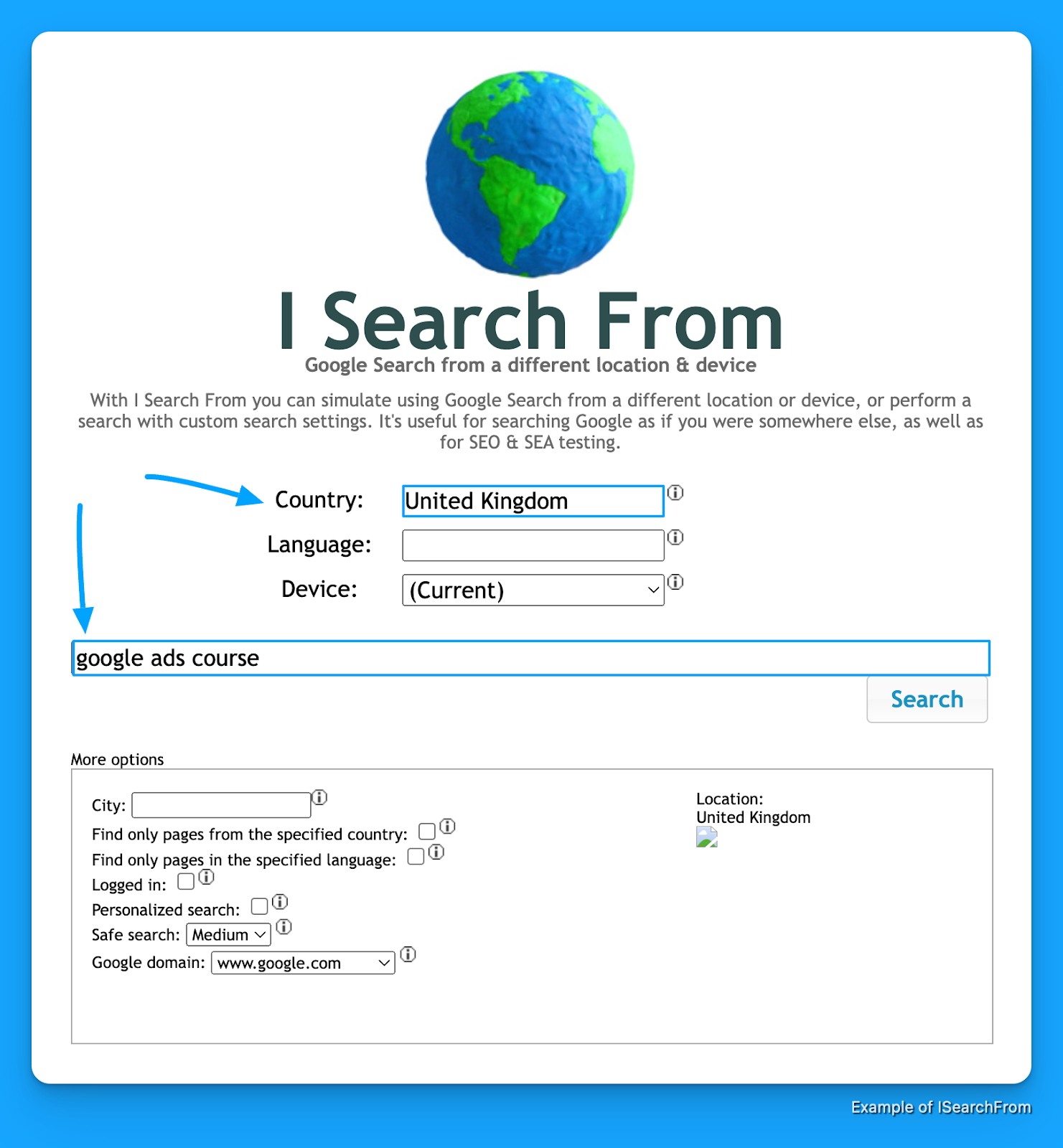
2. Review the ads to uncover advertisers in your target location you might not be aware of

From this simulated result for someone “physically” located in the United Kingdom I can see Coursera is advertising on google ads courses in this region.
From here I can leverage the Transparency Center to uncover more ad examples from them.
Again this is a great tool for finding competitors you’re not familiar with in locations you’re not in.
Paid Tools to Find Examples of Competitors Google Ads
Each of the following competitor analysis tools can be used for a fee, use whichever resonates and fits your budget.
SpyFu
Source: https://www.spyfu.com/
Price: $39-$79/month
If you’re looking for a simple tool to review examples of competitors Google Ads copy, target keywords, and landing pages.
SpyFu is a great tool to start off with, here’s how you can use it.
1. Visit SpyFu and enter your competitors domain

2. Review your competitors estimated Google Ads budget and quantity of paid keywords
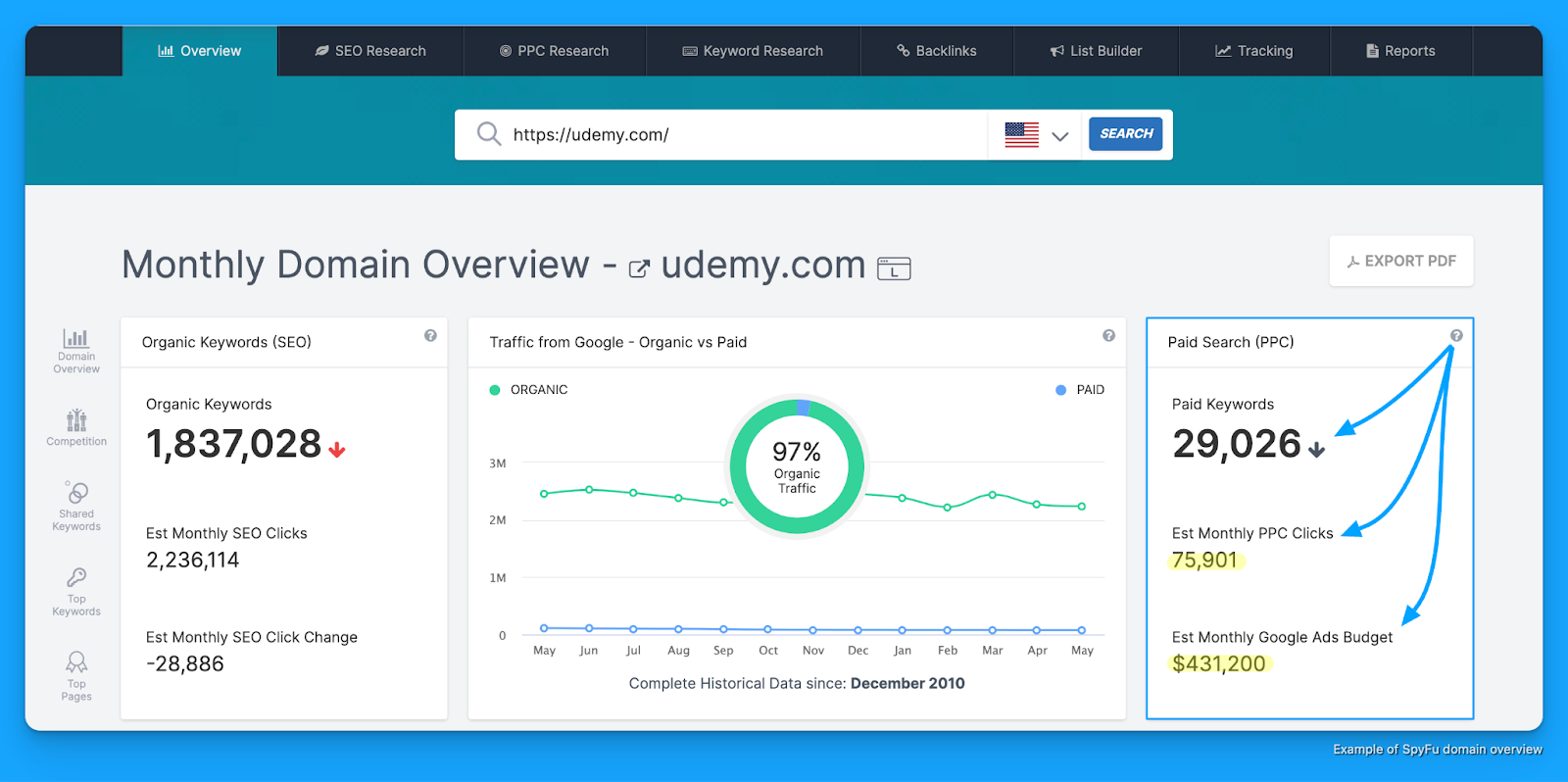
3. Navigate to “PPC Research > PPC Keywords” to see all paid keywords
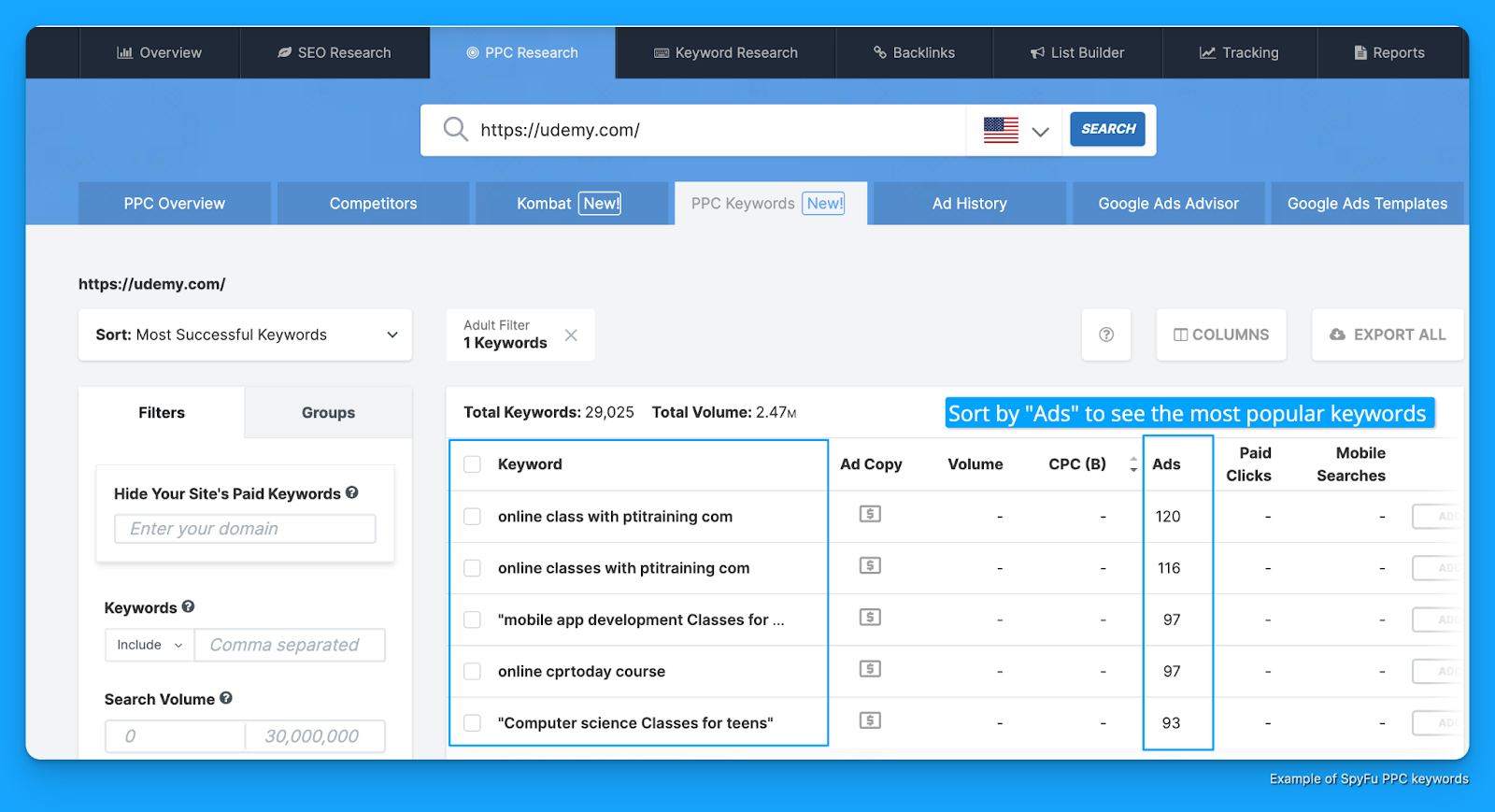
4. Head to “PPC Research > Ad History” to see all competitor ad examples by keyword

5. Uncover other top competitors “PPC Research > Competitors” you might know of

With this one tool you can get estimates of competitors' Google Ads budgets, review keywords, ads, and uncover opportunities across new competitors you might not know of.
Other paid tools:
There’s no shortage of paid tools you can use to research your competitors.
Here’s a list of some others worth exploring:
Don’t get hung up on the tools.
Achieving the end outcome is ultimately key.
Now that you know how to find and research your competitors Google Ads.
Let’s walk through how to break down their strategy.
How to Break Down Your Competitors Google Ads Strategy
Knowing what keywords and ad copy your competitors are using is a great starting point.
But getting answers to questions like:
- How are my competitors structuring their campaigns?
- How are they allocating budget?
are crucial insights that can separate you from them.
1. Reverse Engineering URL Parameters
Once you know your competitors landing pages, which you can get from:
- Searching keywords in Google and clicking on their ads
- Reviewing landing page URLs in SpyFu’s Ad History report
You’ll want to review their UTM parameters to get insights on the goal of this campaign, target keyword, and anything else around how it was set up.
URL Parameter Example #1 - Zoho
For example, I searched CRM software and clicked on this ad from Zoho:
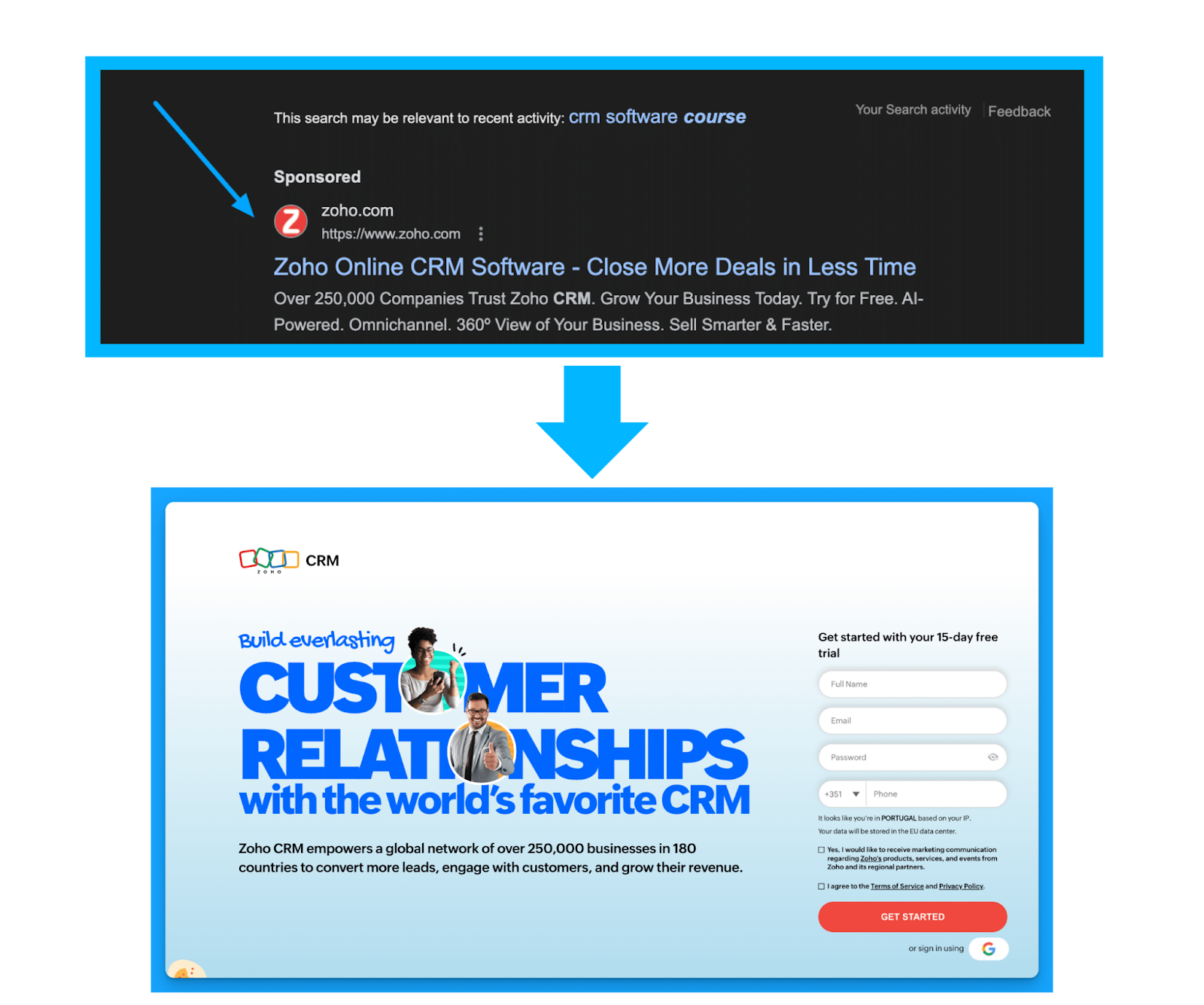
When reviewing the URL post click I can see the following parameters:
/?network=g&device=c&keyword=crm%20software&campaignid=14928929712
&creative=552506800726&matchtype=e
&adposition=&placement=&adgroup=130022006802&gad_source=1
&gclid=Cj0KCQjw3tCyBhDBARIsAEY0XNlAKXey
TKDzEJQDpeNh2giI4p8sVSnWKqsvlND5bvZa_J
q62wCqSFoaAsc1EALw_wcB

By reviewing the URL structure I can gather the following information:
- Network = g | they’re advertising on Google Search
- Device = c | they’re running ads on Desktop devices
- Keyword = crm software | they’re bidding on crm software
- Matchtype = e | they’re using exact match
URL Parameter Example #2 - Freshworks
Let’s use one more example to drive this home with the Freshworks ad that was underneath Zoho:
?tactic_id=6071454&utm_source=google-adwords&utm_medium=FSales-Search-InsideEU-FSE-RLSA-New
&utm_campaign=FSales-Search-InsideEU-FSE-RLSA New&utm_term=crm%20software&device=c
&matchtype=p&network=g
&gclid=Cj0KCQjw3tCyBhDBARIsAEY0XNkaG_AiGqCRYj-AEcuQcnvJS_3eI0bS6jIKu_
M7JRmqOYwSIGwuc6UaAvYqEALw_wcB&gad_source=1
Here’s what I’m able to gather from the URL structure:
- Source = google-adwords | they’re advertising on Google Search
- Campaign = FSales-Search-InsideEU-FSE-RLSA-New | they’re advertising in the EU and running a remarketing list for search ads campaigns.
- Term = crm software | they’re advertising on the keyword crm software
- Device = c | they’re bidding on desktop devices
- Matchtype = p | they’re using phrase match
With this information you can start to get answers into how your competitors are structuring their campaigns and it’s freely available and ready for those advertisers that are savvy enough to look.
2. Keyword Classification
How are your competitors allocating budget?
Now you’ll never know the answer to this question with absolute certainty but with some manual work here’s how you can try and piece together a sense of their strategy allocation.
You’ll need one of the paid tools listed above in order to perform this keyword analysis.
I’ll be using SEMRush for the sake of demonstration but the general process is the same across tools.
1. Export all of your competitors paid keywords into a CSV

2. Filter the Last Seen column by the most recent month to see active keywords

3. Add a new column called “Theme” and classify each keyword by campaign theme.
This step can take some significant time but can be well worth the effort to understand your competitors keyword strategy and budget allocation priorities.
With your custom column of “campaign theme” you’ll want to manually classify each keyword.
Here’s the four campaign themes you’ll utilize for classification:
- NonBrand = high-intent keywords that don’t include your brand name
- Brand = keywords containing your brand name
- Competitive = keywords that represent your competitors
- Content = keywords that are informational and research oriented
Watch this video for a deep dive on how to perform this advanced classification:
4. Summarize your classified keywords into a pivot table to understand your competitors strategy and budget priorities

From here we can make some assumptions about what is working for our competitors.
- 87% of Udemy’s keywords are NonBrand, 9% Brand, 4% Content, and barely 0% Competitive.
- It’s safe to assume that the majority of the budget is supporting NonBrand, followed by Brand, Content, and ultimately Competitive.
Based on this allocation I might want to focus on NonBrand first given the volume of investment Udemy seems to be spending on it, and avoid competitive keywords to start.
This isn't 100% exact science but an advanced way to research your competitors Google Ads.
Need help calculating your stating Google Ads Budget?
If you’re in need of help calculating your starting Google Ads budget check out our calculator.
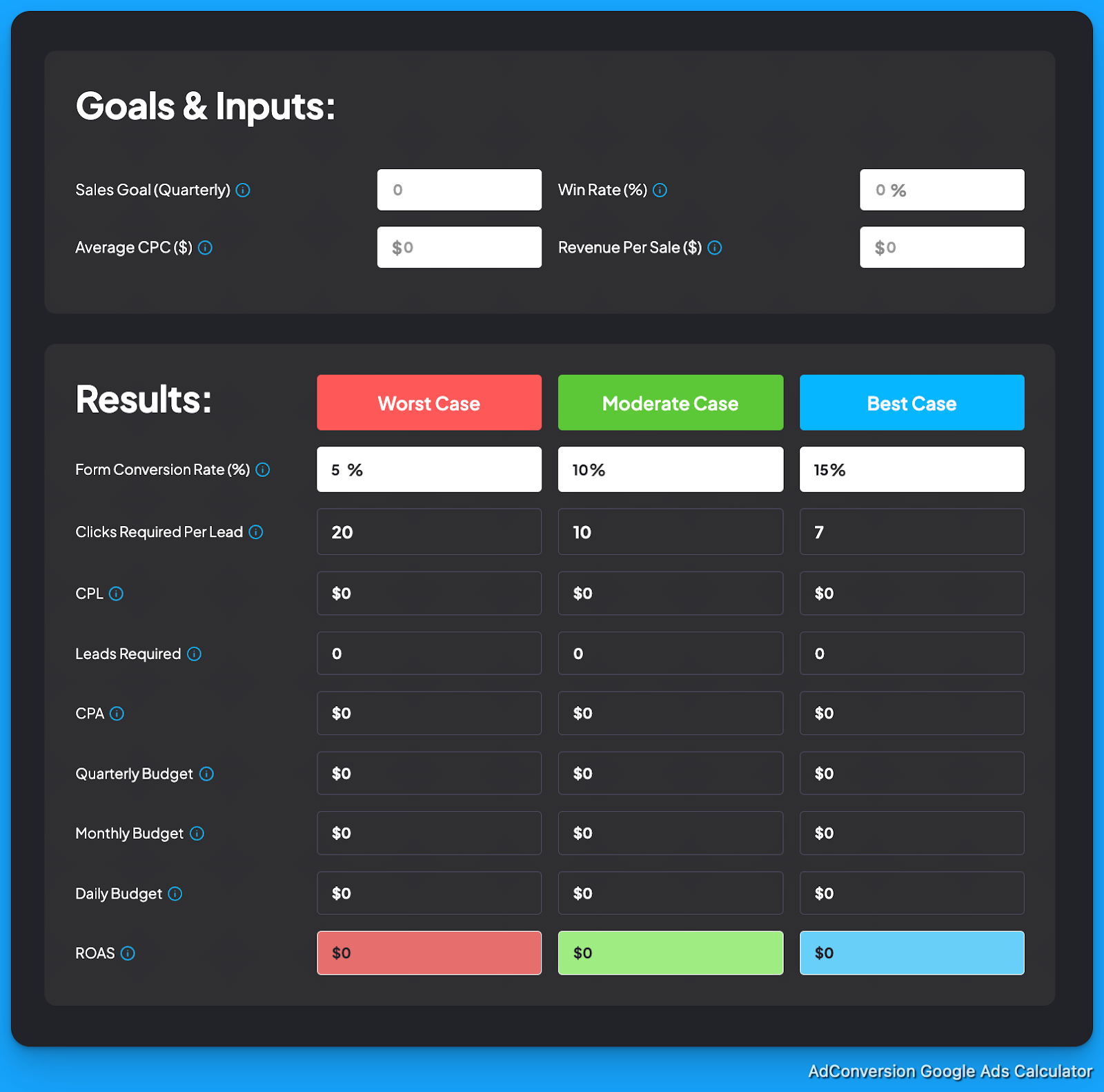
Hope you found this article useful!
See you in the next article or one of our free courses!
From Clicks to Conversions: Master Google Ads for B2B 🔥
If you want to become a Google Ads pro, check out our free B2B Google Ads courses, where you'll learn how to launch, optimize, and scale your campaigns to drive pipeline and revenue.

Here's what you'll learn in each course:
⚙️ B2B Google Ads 101 - How to Launch Dangerously Effective Campaigns for Beginners
- The Googleverse: The Game You're Playing & How To Win
- Measurement: How to Make Sure You're Profitable
- Targeting: How to Show Up For the Right Searcher
- Planning: Putting It All Together
🎯 Google Ads 102 - How to Clicks Into Profit
- Visibility: How To Find the Hole Sucking Profits
- Workflows: How to Optimize On a Daily, Weekly, Monthly & Quarterly Basis
- Experimentation: How to Test & Automate Profitability
- Troubleshooting: How To Solve Inevitable Problems
🚀 Google Ads 103 - How to Scale Google Ads For Advanced Advertisers
- Methodology: How to Vertically Scale Google Ads From A-Z
- Campaigns: Scaling Horizontally Through Campaign Themes
- Channels: Scaling Outside of Paid Search
Click Here to Join 1,000+ B2B Marketers Today and start leveling up your advertising skill set.
Takes < 90 seconds to sign up (seriously we timed it 😂)
People Also Ask
How can I identify indirect competitors in Google Ads?
Beyond direct competitors, consider businesses offering alternative solutions that address the same customer needs. Use tools like Google’s Keyword Planner to discover who is bidding on related keywords, revealing indirect competitors.
What are the ethical considerations when analyzing competitors’ ads?
While it’s acceptable to study competitors’ public ads, avoid deceptive practices like clicking on their ads to deplete budgets. Focus on gathering insights without engaging in unethical behavior.
How often should I conduct a competitor analysis for my Google Ads campaigns?
Regular analysis is crucial. Aim to review competitors’ strategies quarterly to stay informed about market trends and adjust your campaigns accordingly.
Can competitor analysis help in identifying new market opportunities?
Yes, by examining competitors’ ad strategies, you can uncover underserved niches, emerging trends, or gaps in the market, allowing you to capitalize on new opportunities.
How do I ensure my Google Ads stand out in a competitive landscape?
Focus on unique selling propositions, compelling ad copy, and high-quality visuals. Regularly test and optimize your ads to differentiate your offerings from competitors.

How To Get Your Ad Budget Approved In 2024
Looking to ask your boss or client for more ad budget?
This can feel really uncomfortable the first time but I promise it gets easier.
With a simple shift in mindset and some solid tactics you’ll be securing budget in no time.
Here are 3 simple but effective steps for you to implement before having that budget conversation.
TABLE OF CONTENTS
Step 1: Pull the numbers
Your client or boss wants to be successful.
They want to surpass their goals (just like you).
If you can show them how your increased budget will make this happen, they will gladly give it to you.
Remembering this will help you release the anxiety associated with asking for more budget.
The key is you need to sell your stakeholders on WHY they should invest more and the way you'll do that is by building a case that makes them as certain as possible.
Don’t assume your clients or managers will be able to realize this on their own.
Build a no-brainer case that makes saying anything but yes sound illogical.

This starts with pulling the numbers 👇
Answer your critical questions
Put your investor hat on and answer critical questions such as:
- Which channels are performing best?
Ex: Google Ads driving the most opps at the lowest cost
- What's the overall blended trend? (paid + organic)
Ex: Opps are increasing QoQ at a 25% lower cost
- What's the current return on investment?
Ex: $6 pipe-to-spend and 150% ROI
Depending on your company, goals, and what you’re asking budget for this will vary.
Brainstorm all of the key questions you’ll need to pull data to answer.
The difficulty of this step will vary on your current level of reporting.
If you don’t already I HIGHLY recommend building a Paid Media dashboard that connects your ad spend to pipeline and revenue performance reported in your CRM.
Here’s an example of our Paid Media Dashboard Template in our Building a Paid Media Program course:

You can get free access to this template and learn how to set it up in Module 3, Lesson 3 of the course.
It’s going to be hard to ask for more ad budget if you can’t prove that your current campaigns are actually contributing to the bottom line.
Don’t have any data?
If you’re reading this and saying, Silvio how can I pull numbers if I don’t have any?
Maybe you’re trying to secure budget for a new channel.
If this is the case I have two recommendations:
1. Run a pilot campaign for $100
Let’s say you’re trying to secure budget to test X (Twitter) Ads.
Put together $100 (most companies can afford this) and launch a pilot campaign.
The only goal of this campaign is to understand what are your real costs (ex: CPM, CPC).
Once you have this information you can work backwards from your goals to create a starting budget.
For example:
- $3 CPC at a 5% landing page conversion rate = $60 cost per lead
- $60 cost per lead at a 3% lead to opportunity ratio = $1,980 cost per opportunity
- $1,980 cost per opportunity at a 20% win rate = $9,900 cost per closed won deal
If you need help running the numbers, check out our Google Ads budget calculator.

From here you’ll have a good idea of what a starting budget would look like.
You’ll also have a sense of what’s possible on this channel.
2. Do some research
Ask around or search for benchmarks associated with the channel you’re looking to invest in.
Even just collecting anecdotal evidence (ex: screenshots of others) talking about how much success they’ve had with this specific channel, tactic, etc can go a long way.
LinkedIn polls are a great way to collect this feedback:

You can DM the respondents asking for more information.
The TL;DR here is don’t let lack of data be an excuse to show up empty handed.
Once you’ve pulled all the necessary information it’s time to find the story.
Step 2: Find the story
Behind the data there is a story being told, it's your job to find it and tell it.
Here's some key questions to answer to help find it:
- What went well? (the highlights)
- What went bad? (the lowlights)
- Where are we today vs before? (the journey)
- What were the biggest blockers? (the obstacle)
- Where do we go from here? (the opportunities)
Data alone won't persuade, and stories without data are subject to suspicion.
A combination of both is required in order to effectively present your case.

Image above is Module 6, Lesson 1 of our Building a Paid Media Program course
For example, perhaps I’m trying to secure more budget for Google Ads:
- What went well? (the highlights) some text
- Google Ads contributed 25% more opportunities at a $7 pipe-to-spend ratio.
- What went bad? (the lowlights)some text
- We missed out on 57% more volume due to budget limitations.
- Where are we today vs before? (the journey) some text
- We’ve optimized our pipe-to-spend efficiency from $3 to $7.
- What were the biggest blockers? (the obstacle)some text
- High search lost to budget for our top contributing campaigns.
- No landing page testing due to limited development resources.
- Where do we go from here? (the opportunities)some text
- With an additional $25,000 in budget we can scale our top contributing campaigns and yield up to 35% more demo requests at a $15 CPC and 5% landing page conversion rate.
Here’s a simple presentation template you can use to present your case and answer each key question:

Once you've found the story and pulled the numbers you're ready to present.
Step 3: Present your case
After steps 1-2 the majority of the prep work is done.
Now it’s time to get the meeting scheduled with your boss or client.
You could have the most beautiful slides and compelling case but if you can’t effectively communicate the significance of what you’re asking it won’t matter.
Thankfully, like any skill, communication is something you can improve on with practice.
5 unconventional tips to implement in your budget presentation:
1. Remember you both want the same thing.
Ultimately, your stakeholders want you to be right. If you can drive more pipeline/revenue they'd happily give you the budget (assuming financial availability).
The challenge though is like an investor they are analyzing the potential upside and downside of your plan, and don't believe the promises you're making.
You need to addresses their concerns with a combination of data and storytelling that makes them as certain as possible.
Just remembering this simple truth will help you show up differently.
2. It’s a conversation, not a lecture.
You’ll want to keep this discussion conversational.
Make sure to check-in frequently with your boss or client and ask things like:
- Is this making sense?
- Did you have any questions?
- Are there any concerns you have that I haven’t addressed?
The last thing you want to do is to speak to them for 30-minutes and then ask:
“soooooo did you have any questions…..? 😅”

3. Replace “I think” with “the data suggests”
You’ve pulled the data and done the homework.
Don’t water down your points by saying “I think” get in the habit of replacing this with “the data suggests” and then calling out the data point that comes to mind.
This will make your perspectives and points of view far more compelling.
Which ultimately lead to more certainty from the decision maker.
Greater certainty = greater chance of budget approval
4. Don’t forget to smile.
This might sound silly 😂 but it’s really easy to forget to smile.
This conversation is about new opportunities, and that’s exciting.
Instead of telling yourself I’m nervous, reframe it as I’m excited.
This is called anxiety reappraisal and Alison Wood a psychologist at the Harvard Business School found evidence to support.
Here’s a quick excerpt from her abstract: “Across several studies involving karaoke singing, public speaking, and math performance, I investigate an alternative strategy: reappraising anxiety as excitement. Compared to those who attempt to calm down, individuals who reappraise their anxious arousal as excitement feel more excited and perform better” — Alison Wood Brooks
Don’t knock it until you try it!
5. Turn your weakness into a strength
Maybe you’re reading this article and saying to yourself:
- I’m not a good presenter because I’m an introvert
- I’m not a good presenter because English isn’t my first language.
Whatever your weaknesses are, turn them into strengths with humor.
When you start budget approval call begin by addressing your big weakness with humor.
Here’s what this might look like for the weaknesses above:
- Hey {First Name} thanks for the time today. As you might have noticed I’m not going to be giving a Ted talk anytime soon with my English so if you’re having trouble understanding just stop me at any point.
- Hey {First Name} thanks for the time today. I just wanted to start off by saying I’d rather chug a bottle of hot sauce then give a presentation but I believe so much in what I’m going cover today that I had to do this – so I appreciate you baring with any mishaps I might have.
Whatever your weaknesses are don’t run from them.
Embrace it and transform it into a strength.
Additional Resources
If you want to learn more about securing budget checkout Module 6 - Lesson 1 of our Building a Paid Media Program course, it’s 100% free and takes < 90 seconds to sign up.

If you want to dive deeper into B2B advertising check out some of our other top articles:
- B2B Advertising in 2024: The Definitive Guide
- How to Build a Multichannel B2B Retargeting Strategy (Step-By-Step)
Thanks for reading, good luck on getting your budget approved!
(you got this) 🎉
People Also Ask
How can I address concerns about the risks associated with increasing the ad budget?
Acknowledge potential risks by presenting a risk mitigation plan. This could include strategies like phased budget increases, continuous performance monitoring, and predefined criteria for scaling back if certain KPIs aren’t met. Demonstrating proactive risk management can build stakeholder confidence.
What if my initial pilot campaign doesn’t yield strong results?
If a pilot campaign underperforms, analyze the data to identify areas for improvement. Adjust variables such as targeting, ad creatives, or bidding strategies, and consider running a second pilot. Use these learnings to refine your approach before requesting a larger budget.
How do I align my ad budget request with broader company objectives?
Ensure your proposal clearly connects the ad spend to company goals like revenue growth, market expansion, or brand awareness. Illustrate how the investment will contribute to these objectives, using data and projections to support your case.
What are some common pitfalls to avoid when presenting a budget proposal?
Avoid using jargon that stakeholders may not understand, overloading the presentation with excessive data, or failing to anticipate potential objections. Practice your presentation to ensure clarity and conciseness, and be prepared to address questions confidently.
How can I demonstrate the potential ROI of the proposed ad budget?
Utilize tools like the Google Ads Budget Calculator to forecast potential returns based on different budget scenarios. Present these projections along

Top 10 LinkedIn Tips on Mastering Objectives & Bid Strategies
Looking to increase your return on ad spend (ROAS) on LinkedIn?
Your bidding strategy and campaign objective play a critical role.
Here’s my 10 tips from over $10 million investment in LinkedIn paid ads.
(In no particular order, they all matter)
TABLE OF CONTENTS
- Tip #1: The Power Behind Manual Bidding
- Tip #2: Fine-Tuning Your Bids
- Tip #3: Aligning Ad Type & Offer with Objectives
- Tip #4: The Optimal Objective for Thought Leader Ads
- Tip #5: When to Leverage Video Views Objective
- Tip #6: Match Your Content to the Most Suitable Objective
- Tip #7: Take Advantage of Document Ads
- Tip #8: Scale Conversions with Conversation Ads
- Tip #9: Top 3 Objectives for Single Image Ads
- Tip #10: When to Avoid Reach Objective (Brand Awareness)
- Conclusion:
- Resources for Mastering B2B Advertising
Tip #1: The Power Behind Manual Bidding
Unlike automated bidding, which leaves bid amounts at LinkedIn's discretion, manual bidding allows advertisers to set clear cost boundaries.
This ensures that your campaign expenses align with your budgetary constraints and campaign goals, offering a level of precision that automated bidding simply can't match.
By specifying the maximum amount you're willing to pay for clicks, the manual bidding places you in the driver's seat.
The LinkedIn algorithm, while powerful, may not always allocate your budget most economically when given full control.
Start collecting data quickly for your new campaign by bidding above the minimum threshold recommended by LinkedIn.

When to Consider Automated Bidding:
Automated bidding can be the best choice for specific situations, such as focused Account-Based Marketing (ABM) or retargeting campaigns with small audiences.
Once the campaign starts spending and there’s a benchmark, you can switch to manual bidding to regain full control.
Tip #2: Fine-Tuning Your Bids
A successful manual bidding requires daily checks on your spending against your budget to avoid overbidding or underbidding.
This is a straightforward yet insightful process, comparing the previous day's spend against the current daily budget to adjust your bids for optimal performance.
The Process of Bid Adjustment:
By subtracting your daily budget from the previous day's total spending, you gain clear insights into your bidding strategy's effectiveness.
A negative result suggests underbidding, where you're not fully utilizing your daily budget
While a positive result indicates overbidding, where you're potentially overspending.
Previous day spent - allocated budget = + number indicated bid is too high
The previous day spent - allocated budget = - number indicated bid is too low”
One challenge of manual bidding is finding the sweet spot where your bid is high enough to consume your daily budget fully but not so high that it leads to inefficient spending.

Side note:
If your audience size is too small, even a high bid will not cover the campaign’s full budget.
Tip #3: Aligning Ad Type & Offer with Objectives
LinkedIn ad campaigns' success deeply depends on the alignment between the chosen ad type and the content you're promoting.
Understanding the nuances of each ad + offer and matching it to the applicable objective is key to maximizing engagement and conversion rate.
Selecting the Right Ad Type for Your Objective:
Video Ads:
When promoting video ads, gravitate towards the Video View or Engagement objectives.
These objectives are designed to maximize viewership and interaction with your video content, making them ideal for capturing and retaining audience attention.
Example of a video ad:

Document Ads:
The Engagement objective tends to yield the most success for document ads, which include PDFs, presentations, and other downloadable content.
Keeping document ads ungated and focusing on engagement allows your content to reach a broader audience, enhancing brand visibility and thought leadership.
Example of a document ad:

Single Image Ads:
Engagement and Website Traffic objectives can be effective when using single-image ads.
Your choice depends on whether your primary goal is to foster interaction with the ad or drive traffic to your website or landing page
Example of a single image ad:

Tip #4: The Optimal Objective for Thought Leader Ads
If you're looking to boost your presence and authority on LinkedIn, thought leader ads present an attractive option.
These ads turn organic content from individual profiles into sponsored messages, maintaining the authentic voice and personal touch that resonates with audiences.
These campaigns can achieve lower costs per engagement by leveraging the engagement objective, enhancing their effectiveness and reach.
Understanding Thought Leader Ads:
Personal Touch:
Unlike standard ads that originate from company pages, thought leader ads come from personal profiles, offering a humanized approach to advertising.
This method harnesses the inherent trust and relatability of individual thought leaders, amplifying their messages across targeted audiences on LinkedIn.
As of March 2024, businesses can promote content from any connected user on LinkedIn with Thought Leader posts, as opposed to just verified employees.
Seamless Integration:
To the audience, thought leader ads appear as regular posts but with the added benefit of targeted reach and visibility.
This seamless integration into the newsfeed portrays a natural engagement experience, hence fostering higher engagement rates compared to traditional ad formats.
Implementation and Best Practices
The success of thought leader ads hinges on selecting organic content that has already demonstrated shares and engagement.
By sponsoring high-performing posts, you capitalize on proven interest and ensure your ad budget is allocated to content with the highest potential return.
Pro tip:
When creating a new single-image campaign, you can click “browse existing content” to find the post by searching for the LinkedIn member and sending a request for approval.
Since these ads will not be sent to a landing page, it’s best to place the intended page link in the first comment and pin the comment.


Tip #5: When to Leverage Video Views Objective
When promoting video ads, selecting the Video View objective will increase the likelihood of getting the highest percentage of videos watched at the lowest cost.
This objective is designed to maximize the number of views your video receives, optimizing for visibility and engagement among your target audience.
Creative Specifications:
For video creatives, the recommendation is to use a square format (1080x1080 pixels) and include captions.
This format is not only visually appealing but also takes up the most space in the feed property.
Cost Efficiency and Performance:
The cost for video views on LinkedIn typically ranges from 10 to 15 cents per view.
While this might be higher compared to other platforms like YouTube, which has been gaining traction in B2B sectors for its cost-effectiveness, LinkedIn's targeted audience can justify the investment.
Best Practices for Video Campaigns on LinkedIn:
Starting with the lowest feasible cost per view (CPV) in your bidding strategy can help manage costs while assessing the content's performance.
Adjustments can be made based on initial results to find the optimal balance between reach and budget efficiency.
Tip #6: Match Your Content to the Most Suitable Objective
Understanding the type of content you're promoting determines the most effective objective and ad type for your campaign.
For event promotions, for example, certain ad formats have proven to yield higher results and drive registrations at a lower cost.
Let’s break down what type of assets yield the highest results for this example:
Lead Generation Forms (LGF):
The premier choice for driving event registrations.
Lead-gen forms provide a seamless and streamlined user experience, with pre-populated forms making the conversion process as frictionless as possible.
The convenience of instantly filling out forms within the LinkedIn platform significantly increases conversion rates for registrations.

Pro tip:
To improve the performance of LGF, it's best to keep the number of custom fields below three.
While leveraging pre-populated fields can maintain high conversion rates, adding more than two custom questions or actions can deter completions.
Event Ad Format:
This is one of the most effective ad types for event registries, but it is important to note that it cannot be combined with any of the conversion objectives.
Unique to this type of ad is the inclusion of social proof directly within the ad, such as the number of people who have shown interest or are planning to attend the event.
While its conversion rate may not match that of Lead Generation Forms, the added visibility and credibility from social proof make Event Ads a valuable tactic.

To learn more about promoting events, dive into these articles below:
- 4 Unique LinkedIn Ad Strategies to Drive More Webinar Registrants
- 10 Insider Tips on Event Promotion From $1M+ In Ad Spend
Website Conversion:
Directing users to a landing page for event registration is generally less preferred due to higher costs and lower conversion rates compared to previous tactics.
Exceptions exist, such as directing traffic to a calendar link or for specific targeting scenarios, but overall, this method is seen as less efficient for event promotion.
Design and Copy Considerations:
For campaigns opting to use landing pages, prioritizing copy over design is key.
The hero section, or above-the-fold content, is critical in capturing user interest.
Ensuring message consistency between your ads and landing page, alongside efficient conversion tracking, will set you up for success.
To learn more about landing page best practices, dive into the article below by Pedro Cortés:
10 Proven Landing Page Tips To Boost Your Conversion Rates
Pro-tip:
Streamlining Campaign Tracking with Dynamic URL Parameters:
LinkedIn's introduction of dynamic URL parameters at the campaign level presents a major leap forward in simplifying and enhancing tracking capabilities.
This feature allows marketers to set up the tracking once for the entire campaign, eliminating the tedious process of manually tagging each ad with unique UTM parameters.

Tip #7: Take Advantage of Document Ads
Document ads have proven highly effective for marketers looking to deepen engagement and build a robust retargeting pool.
They typically have impressive click-through rates, often reaching 6-7% or higher.
The best results from document ads are seen when paired with the engagement objective.
Users who interact with this ad type demonstrate a clear interest in your content, making them ideal candidates for subsequent, more targeted marketing efforts.
For more information on setting up your first document ads, check out this guide provided by LinkedIn
Tip #8: Scale Conversions with Conversation Ads
Conversation ads offer a unique, direct method of engaging with your target audience by delivering messages right into their LinkedIn inboxes.
These ads are billed on a cost-per-send basis, making it crucial to manage bids effectively to maximize both reach and budget efficiency.
Start your bid as low as possible and make adjustments depending on how well it’s pacing.
A good starting point is a $1 bid.
Due to LinkedIn’s second-price auction model for convo ads, they typically keep the actual cost close to the average historical cost per send.
This model charges you just enough to outbid the next highest bidder, not the maximum amount you're willing to pay.
Adaptation to Platform Changes:
Despite recent updates like the focus inbox change on LinkedIn, conversational ads have continued to perform well.
The direct nature of these ads keeps them effective, maintaining their status as a top-performing ad type.
Best Practices for Conversational Ads:
Because convo ads are more intrusive than other ad types, it’s important to ensure your targeting is precise. This precision prevents user annoyance and increases the likelihood of engagement.
The content of your conversation ads should be compelling and offer clear value to a specific job function.
Pro-tip:
The sender should resonate with the target audience for the highest credibility.
Choosing someone with a similar job function or an industry expert/influencer can immediately boost credibility.
For additional tips on convo ad’s best practices, check out this post by AdConversion

Tip #9: Top 3 Objectives for Single Image Ads
Single-image ads are versatile and can be tailored to meet various objectives, but understanding which objective to prioritize can have a noticeable impact on the effectiveness of your campaigns.
Lead Generation:
The primary objective for many single-image ad campaigns is lead generation.
LinkedIn’s Lead-gen focuses on gathering user information through forms that are pre-populated with LinkedIn profile data, making it easier for users to submit their information without leaving the platform.
Engagement:
The second most common objective for single-image ads is engagement.
This objective aims to maximize interactions such as likes, comments, and shares.
It's particularly useful for increasing brand visibility and engagement within your target audience.
Fostering interactions also enhances the organic reach of your ads through the network effects of user engagement.
The visual appeal and message of your single-image ad should resonate with your audience and encourage interaction.
Regular testing and adaptation of your ad creatives can help maintain high engagement levels.
Website Visits:
The third objective focuses on driving traffic to your website or specific landing pages to achieve conversions.
Whether your goal is to increase sign-ups, sales, or another conversion action, directing users to your website allows for more detailed tracking and nurturing of potential leads in your sales funnel.
Tip #10: When to Avoid Reach Objective (Brand Awareness)
Brand awareness, which prioritizes impressions and broad visibility, often comes under scrutiny due to its cost implications and lower engagement metrics compared to other objectives.
The reach objective operates on a cost-per-impression (CPM) model, where you are charged each time your ad is displayed, regardless of user interaction.
This can lead to higher expenditure without the guarantee of equivalent engagement or conversions.
The inherent nature of paying for mere visibility rather than actionable engagement makes this objective less appealing for many advertisers seeking tangible returns on their investment.
This objective is also inefficient for retargeting.
Building retargeting audiences requires not just impressions but meaningful interactions that signal interest or intent.
The reach objective's focus on maximizing views rather than fostering engagement makes it less effective for gathering a meaningful contribution toward the retargeting pool.
Conclusion:
In this article, we covered 10 actionable tips for matching the most suitable objectives and bidding strategies to your LinkedIn campaigns.
Whether it’s choosing manual bidding to control costs, aligning ad types with your marketing objectives, or understanding when to leverage specific ad formats, each tip offers a pathway to better performance.
By implementing these top 10 tips, you can navigate through the complexities of LinkedIn paid ads with greater precision and efficiency.
I hope you found this article insightful and that it leads to successful outcomes for your future campaigns.
If you’d like to reach out or get more tips, please connect with me via LinkedIn.
Master B2B LinkedIn Ads with these 3 Free Courses:
If you want to become a LinkedIn Ads pro, check out our free B2B LinkedIn Ads courses, where you'll learn how to launch, optimize, and scale your campaigns to drive pipeline and revenue.
%2520(1).jpeg)
Here's what you'll learn in each course:
⚙️ B2B LinkedIn Ads 101 - The Ultimate Crash Course for New LinkedIn Advertisers
- Foundations For LinkedIn Ads Success
- Measurement: Tracking & Key Principles
- Targeting: Reaching Your Dream Buyers
- Ads: Mastering The 9 Ad Formats
🎯 B2B LinkedIn Ads 102 - The Blueprint for LinkedIn Ads Optimization
- Monitoring: How To Spot Performance Trends
- Auditing: How To Find The Darlings You Need To Kill
- Reporting: How To Transform Data Into Insights
- Optimization: How To Make Your LinkedIn Ads Profitable
🚀 B2B LinkedIn Ads 103 - Advanced Scaling Strategies From $25M In Ad Spend
- Concepts of Scaling
- Divide and Conquer
- Learnings From $25M+ In LinkedIn Ad Spend
Click Here to Join 1,000+ B2B Marketers Today and start leveling up your advertising skill set.
Takes < 90 seconds to sign up (seriously we timed it 😂)
People Also Ask
How can I determine the optimal bid amount for my LinkedIn ad campaigns?
Begin by setting bids slightly above LinkedIn’s recommended minimum to gather initial data. Monitor daily performance, adjusting bids to ensure your budget is fully utilized without overspending. Regular analysis helps in finding the balance between cost-efficiency and achieving desired reach.
What are the best practices for aligning ad creatives with specific campaign objectives?
Ensure that your ad format and content match your campaign goals. For instance, use Video Ads with the Video View objective to maximize engagement, or Document Ads with the Engagement objective to share downloadable content effectively. Aligning creatives with objectives enhances campaign performance.
How do I choose between manual and automated bidding strategies?
Manual bidding offers control over costs, allowing precise budget management, while automated bidding leverages LinkedIn’s algorithm for potentially broader reach. For Account-Based Marketing (ABM) or retargeting campaigns with small audiences, automated bidding can be effective. However, starting with manual bidding can provide valuable insights and control.
What factors should I consider when selecting the appropriate campaign objective?
Identify your primary marketing goal—brand awareness, lead generation, website traffic, etc. Choose objectives that align with these goals and consider the ad formats that best support them. For example, use the Engagement objective for Thought Leader Ads to boost authority and reach.
How can I effectively measure the success of my LinkedIn ad campaigns?
Track key performance indicators (KPIs) such as click-through rates (CTR), conversion rates, cost per click (CPC), and return on ad spend (ROAS). Regularly analyze these metrics to assess performance and make data-driven adjustments to your strategies.

How to Build a Multichannel B2B Retargeting Strategy (Step-By-Step)
With long sales cycles staying top of mind is half the battle when it comes to B2B.
In this blueprint you’ll learn how to build a multichannel B2B retargeting strategy across:
- Meta (Facebook & Instagram)
- X (Twitter)
- & YouTube
So you can stay omnipresent and convert users across channels.
I know you’re going to love it, let’s get started! ❤️
TABLE OF CONTENTS
- Recommended Channels
- Step 1: Confirm Your Remarketing Pixels are Installed
- Step 2: Create all possible retargeting segments by time frame
- Step 3: Adjust targeting and exclusion parameters
- Step 4: Align on retargeting content and offers
- Step 5: Build all Relevant Retargeting Campaigns
- B2B Retargeting FAQ
- Launch Checklist
- Conclusion & Free Courses
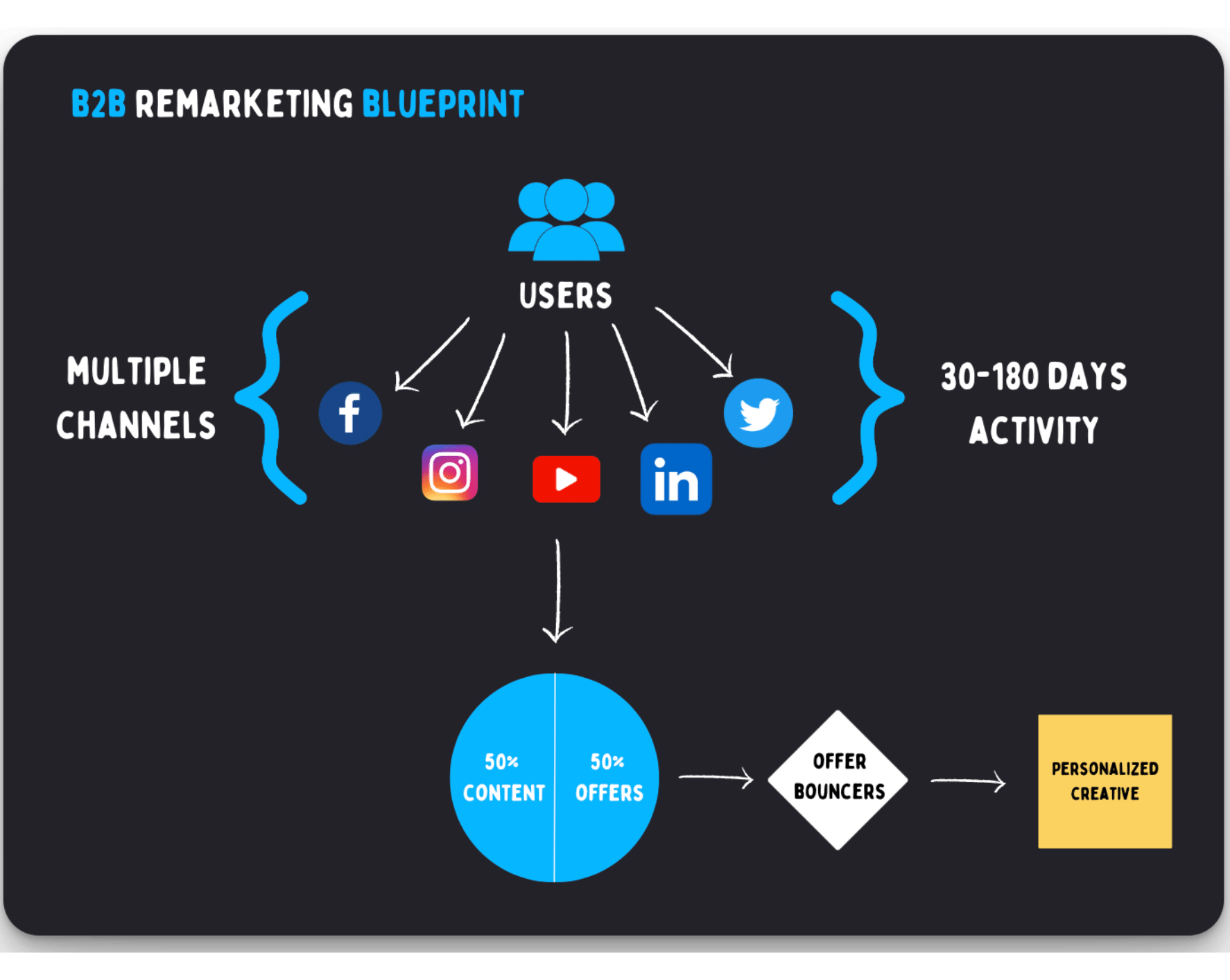
Recommended Channels:
- LinkedIn Ads
- Meta (Facebook & Instagram)
- X (Twitter)
- YouTube
Minimum Budget:
- $1,000/month (for 1 channel)
Recommended Targeting:
Step 1: Confirm Your Remarketing Pixels are Installed
This is a mandatory first step, and something that needs to be done first.
These pixels are how the ad platforms are able to track users activity and provide you the ability to remarket them with various campaigns and offers.
Even if you’re not planning to advertise soon on any channels, I HIGHLY recommend creating a free ad account and installing that platform pixel on your site to start building your remarketing pool.
Here’s what this will look like for each channel.
How to Install the LinkedIn Ads Pixel In 4 Steps
- Create a free LinkedIn Ads account
- Navigate to the “Analyze” → “Insight Tag” section
- Choose how to install your tag (recommend Google Tag Manager aka GTM)
- In Google Tag Manager, create a new tag type with LinkedIn Insight and fire on all pages
.png)
How to Install the Meta (Facebook & Instagram) Ads Pixel In 6 Steps
- Create a free Facebook Ads account
- In the Ads Manager navigate to “Events Manager” → “Connect Data Sources”
- Connect “Web” as a new data source and name your pixel (ex: Meta Pixel)
- Select your new pixel under “Data Sources” and navigate to “Overview” → “Setup Pixel”
- Choose how to install your pixel (recommend Google Tag Manager aka GTM)
- In Google Tag Manager, create a new tag type with Custom HTML and fire on all pages
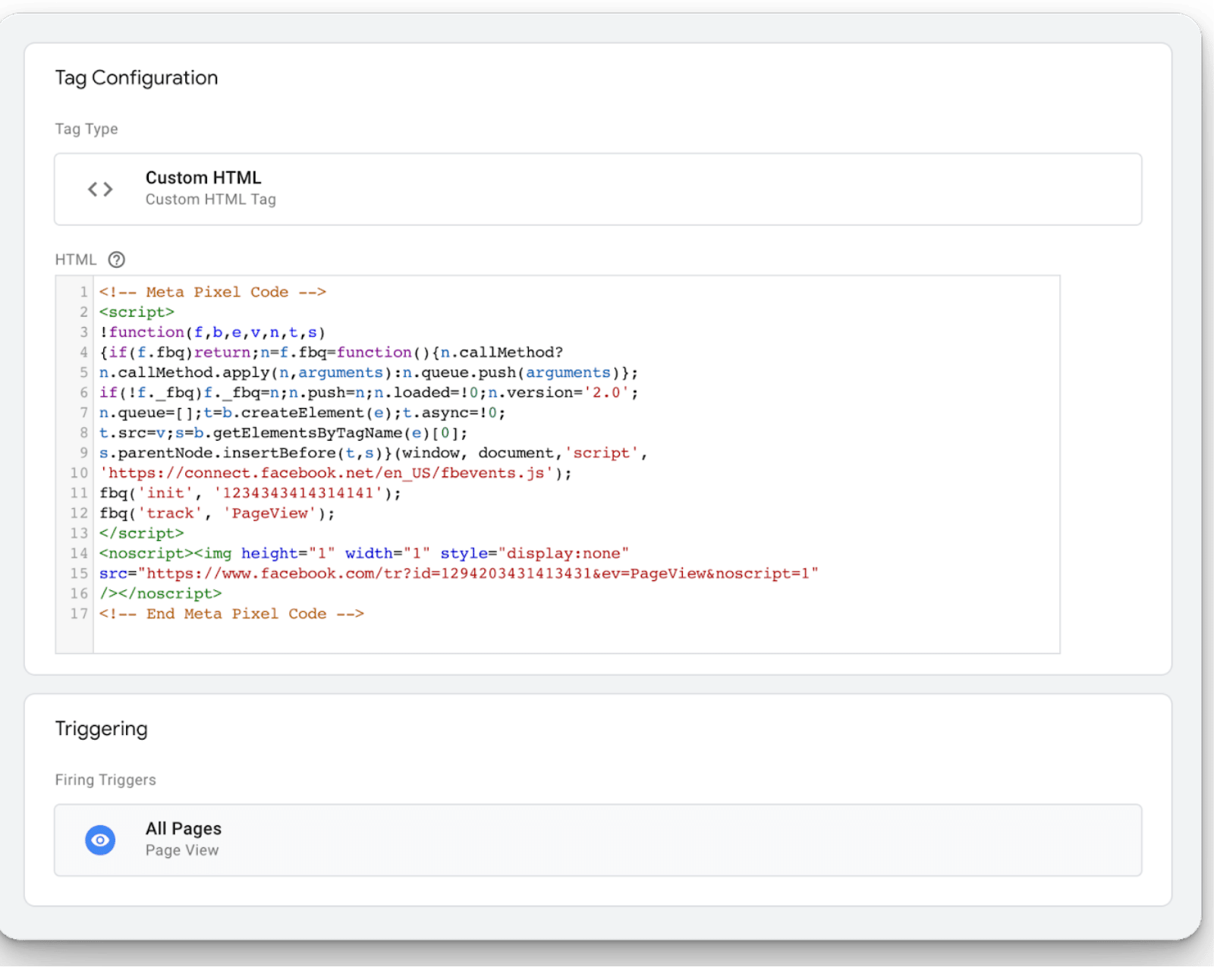
How to Install the X (Twitter) Ads Pixel In 4 Steps
- Create a free X (Twitter) Ads account
- In the Ads Manager navigate to “Events Manager” → “Add Event Source”
- Install with “Pixel code” and allow 1st-party cookies
- In Google Tag Manager, create a new tag type with Custom HTM and fire on all pages

How to Install the Google Ads Pixel In 5 Steps
By installing the Google Ads pixel you’ll be able to remarket to website visitors on YouTube because Google owns YouTube and all campaigns are created in the same ads manager.
- Create a free Google Ads account
- In the Ads Manager navigate to “Audience Manager” → “Your Data Sources”
- Select “Google Ads Tag” → “Edit Source”
- Select “Tag Setup” recommend “Use Google Tag Manager” and copy your ID
- In Google Tag Manager, create a Google Ads Remarketing tag and fire on all pages

Once complete, confirm all pixels are installed correctly on your website with GTM Preview:
.png)
Remarketing audience size requirements for Meta, YouTube, LinkedIn & X (Twitter)
- Meta (Facebook & Instagram) = 1,000 audience members
- YouTube = 100 audience members
- LinkedIn = 300 audience members
- X (Twitter) = 100 audience members
Now that you’ve installed all the pixels for the platforms you’re interested in you’ll need to allow the pixels time to build your cookie pool to meet audience minimums.
I’ve seen it take 7-30+ days depending on monthly engagement or traffic volumes for the retargeting segment you’re trying to build (ex: website visits, video views, post engagement, etc..).
Step 2: Create all possible retargeting segments by time frame.
Once your remarketing audience has met minimums it’s time to build your segments.
This step will vary depending on how large your retargeting audience is.
In a perfect world we’ll want to create retargeting segments for the following timeframes:
The advantage of creating retargeting segments by time frame is:
✅ Easily see which cohort performs best
✅ Allocate more budget to the top performing time frame
✅ Align offers and messaging accordingly
Watch this video to better understand the thought process behind leveraging different remarketing segments by timeframes:
In addition to testing timeframes we want to combine as many relevant remarketing segments together in each cohort so we can scale up our overall audience size (more on this in Step 4).
Depending on the channel you’re advertising on, the available remarketing segments will vary.
Here are my go to choices for each channel below.
Top 10 LinkedIn Ads retargeting segments:
Top 9 Meta (Facebook & Instagram) Ads retargeting segments:
Top 5 X (Twitter) Ads retargeting segments:
Top 4 YouTube Ads retargeting segments:
Depending on your audience sizes you might not be able to use shorter timeframes.
If that’s the case, default to the next longest one:
For example:
❌30 days < 1,000 audience size? Try 90 days
❌90 days < 1,000 audience size? Try 180 days
❌180 days < 1,000 audience size? Hold off on remarketing until your audience sizes build
Build out each relevant remarketing combination for the channels you want to advertise on.
Step 3: Adjust targeting and exclusion parameters.
Equally important to who you’re targeting is who you exclude.
With all your retargeting segments created it’s clear who you’re going to target.
Now it’s time to get clear on who you’ll exclude for each cohort (e.g. 30, 90, 180 days).
Exclusion audiences allow you to remove users who aren’t a good fit for your targeting.
Here’s my go-to exclusions by channel.
Top 8 LinkedIn Ads Exclusion Audiences:
Top 9 Meta (Facebook & Instagram) Ads Exclusion Audiences:
Top 6 X (Twitter) Ads Exclusion Audiences:
Top 6 YouTube Ads Exclusion Audiences:
Feel free to remove and add the exclusions that make sense for your business and who you’re ultimately trying to reach with your retargeting campaigns.
By no means should you only use the ones I outlined above, some will make sense others won’t.
Once you’re clear on who you’ll exclude it’s time to align on content and offers.
Step 4: Align on retargeting content and offers.
Now that you’re clear on who you’ll target and exclude for each cohort. Let’s chat about what content and offers you’ll want to show them.
First things first, don’t make the mistake of only showing offers to people in your remarketing audience. This is the equivalent of following someone all day asking them to buy something.
This is what Corporate Bro has to say about that 😂

Recommended B2B Remarketing Budget Allocation:
Avoid leaving a bad impression and potentially hurting your brand by also adding content in the mix.
50% of your remarketing budget should go towards adding value to your audience, and 50% goes towards asking them to convert on something (ex: Demo, Trial, Event, etc…)
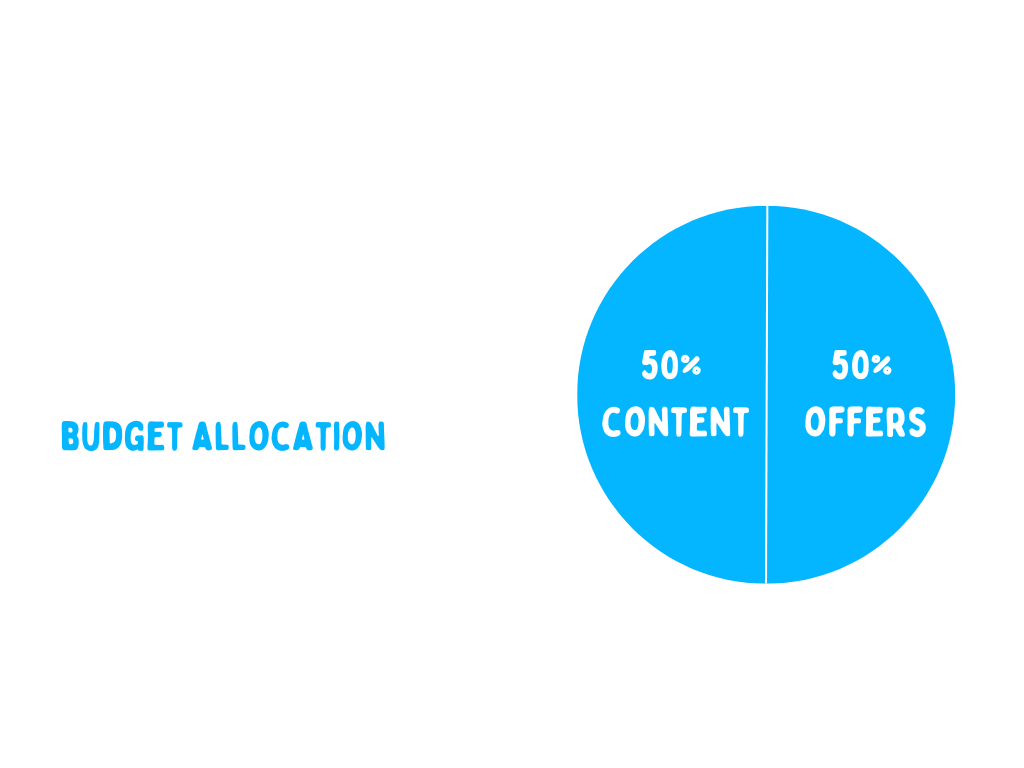
With this budget allocation you’re rotating offers and content equally to your remarketing cohorts (e.g. 30, 90, 180 days) and letting the users decide which asset they're interested in.
Which leads us to common remarketing mistakes you’ll want to avoid.
4 Common Mistakes to Avoid with Retargeting:
1. Only promoting offers
Avoid a pitch fest and split your remarketing budget 50/50 between content and offers as outlined above.
2. Retargeting on assumption instead of action
Don’t create these crazy retargeting flows where someone must do X then Y and finally you’ll give them Z. This kills your retargeting audience size and you’re assuming that you’ll be correct 3/3 times (idk about you but I’m not great at guessing).
Instead show them everything equally (content and offers) and then once they decide to click on an ad, watch a video etc… you can now create unique campaigns to remarket off that activity (now you’re no longer assuming they are interested).
3. Not using all available retargeting segments
Don’t rely on 1 segment alone like a website visitor segment. Instead combine multiple segments together with an OR statement in the same timeframe to scale up your overall retargeting audience so you have more flexibility to layer filters.
4. Failing to refresh creative to offset fatigue
There’s nothing worse than seeing the same ad 1,000 times. This can be easily avoided by creating a workflow to refresh your creatives on a monthly basis.
Just changing the creatives for the same offers and content will create a new experience for users and help offset ad fatigue.
Watch this video to learn more about how to monitor and overcome ad fatigue:
When we talk about remarketing content and offers equally – what exactly does that mean?
- White papers?
- Webinars?
- Tutorials?
- Demos?
- Trials?
The list goes on, and on…
There are 1,000s of offers and content you could potentially promote.
To help simplify and conceptualize this, here are 4 useful remarketing buckets inspired by Canberk Beker, Global Head of Paid Media at Cognism from episode 2 of Behind the Ads.
Recommended Remarketing Buckets by Timeframe:
B2B Retargeting Ad Examples:
Product Marketing
(Content that focuses on promoting the capabilities of your product)
Social Proof
(Leveraging others words and results in our ads)
.png)
Thought Leadership
(Content that educates your target audience and positions you as an expert)
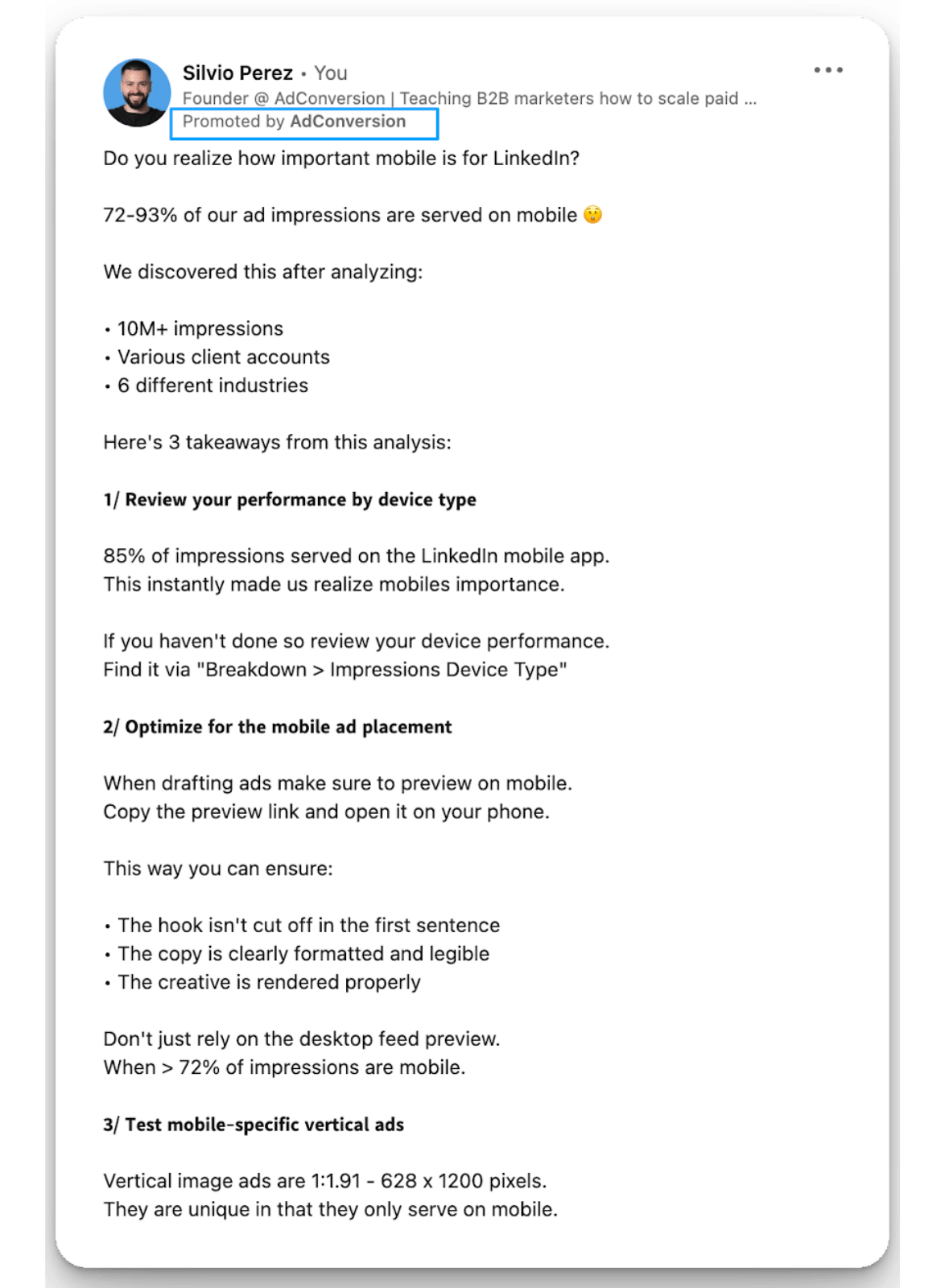
Offers
(Any other type of ad where you’re asking your target audience to convert)
.png)
Armed with your content and offers by time frame there’s one last step to do.
Step 5: Build all Relevant Retargeting Campaigns.
After going through steps 1-4 you should be clear on:
- Which channels you’re going to advertise on
- What retargeting segments you’ll leverage
- Which exclusion audiences you’ll block
- What content/offers you’ll showcase
Let’s wrap up with how these campaigns should be built.
B2B Retargeting Campaign Structure:
Here’s what the retargeting campaign structure will look like at 10,000 feet:
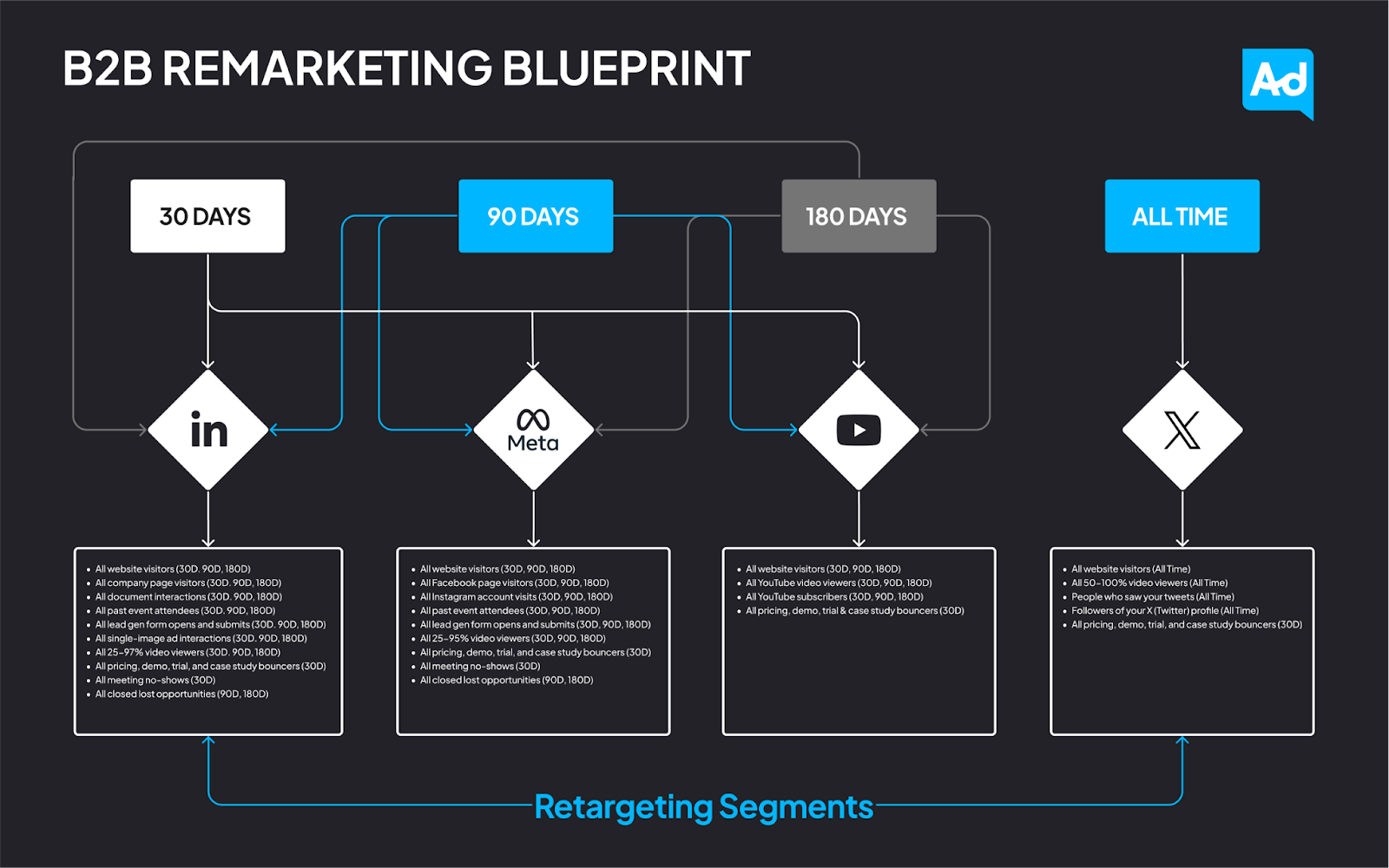
Couple of important call outs:
Every campaign has its own unique timeframe and retargeting bucket.
This makes pacing, optimization, and reporting really easy.
All retargeting segments within the same timeframe are grouped together as an OR.
This allows you to scale your retargeting audience size overall within the cohort.
Combine segments together with OR not AND.
Naming conventions are clear and consistent from the campaign to ad level.
This allows you to easily find your campaigns and reporting on performance.
Here’s how to build these campaigns out for each channel.
How to Build LinkedIn Retargeting Campaigns:
Make sure to disable Audience Expansion and the LinkedIn Audience Network for all LinkedIn retargeting cohort campaigns.


This will prevent LinkedIn from serving your ads to people not in your retargeting audiences and outside of the LinkedIn platform.
Create the following campaigns in the LinkedIn Ads campaign manager across whichever timeframes are applicable for your account:
Cohort #1: 30-Day LinkedIn Retargeting
Campaign Name: {Location} | {Offer} | Remarketing (30D) | {Ad Type} | {Objective}
- EX: USA | PM Content | Remarketing (30D) | Image | Awareness
- EX: USA | Demo | Remarketing (30D) | Video | Conversions
- EX: USA | Social Proof | Remarketing (30D) | Carousel | Engagement
Recommended Objectives:
- Content focus = Brand Awareness, Engagement, Video Views
- Conversion focus = Lead Generation or Conversion
Recommended Daily Budget: $25-$100/day
Recommended Audiences (layer titles or function if possible):
- All website visitors (30D)
- All company page visitors (30D)
- All document interactions (30D)
- All past event attendees (30D)
- All lead gen form opens and submits (30D)
- All single-image ad interactions (30D)
- All 25-97% video viewers (30D)
- All closed lost contacts (30D)
Recommended Bid Strategies:
- Content focus = Maximize delivery
- Conversion focus = Manual CPC
Ads: Product marketing content, social proof, offers (ex: Demo, Trial)
.png)
Cohort #2: 90-Day LinkedIn Retargeting
Campaign Name: {Location} | {Offer} | Remarketing (90D) | {Ad Type} | {Objective}
- EX: USA | PM Content | Remarketing (90D) | Image | Awareness
- EX: USA | Demo | Remarketing (90D) | Video | Conversions
- EX: USA | Social Proof | Remarketing (90D) | Carousel | Engagement
- EX: USA | Thought Leadership | Remarketing (90D) | Image | Awareness
Recommended Objectives:
- Content focus = Brand Awareness, Engagement, Video Views
- Conversion focus = Lead Generation or Conversion
Recommended Daily Budget: $25-$100/day
Recommended Audiences (layer titles or function if possible):
- All website visitors (90D)
- All company page visitors (90D)
- All document interactions (90D)
- All past event attendees (90D)
- All lead gen form opens and submits (90D)
- All single-image ad interactions (90D)
- All 25-97% video viewers (90D)
- All closed lost contacts (90D)
Recommended Bid Strategies:
- Content focus = Maximize delivery
- Conversion focus = Manual CPC
Ads: Product marketing content, social proof, offers (ex: Demo, Trial), thought leadership
.png)
Cohort #3: 180-Day LinkedIn Retargeting
Campaign Name: {Location} | {Offer} | Remarketing (180D) | {Ad Type} | {Objective}
- EX: USA | PM Content | Remarketing (180D) | Image | Awareness
- EX: USA | Demo | Remarketing (180D) | Video | Conversions
- EX: USA | Social Proof | Remarketing (180D) | Carousel | Engagement
- EX: USA | Thought Leadership | Remarketing (180D) | Image | Awareness
Recommended Objectives:
- Content focus = Brand Awareness, Engagement, Video Views
- Conversion focus = Lead Generation or Conversion
Recommended Daily Budget: $25-$100/day
Recommended Audiences (layer titles or function if possible):
- All website visitors (180D)
- All company page visitors (180D)
- All document interactions (180D)
- All past event attendees (180D)
- All lead gen form opens and submits (180D)
- All single-image ad interactions (180D)
- All 25-97% video viewers (180D)
- All closed lost contacts (180D)
Recommended Bid Strategies:
- Content focus = Maximize delivery
- Conversion focus = Manual CPC
Ads: Product marketing content, social proof, offers (ex: Demo, Trial), thought leadership
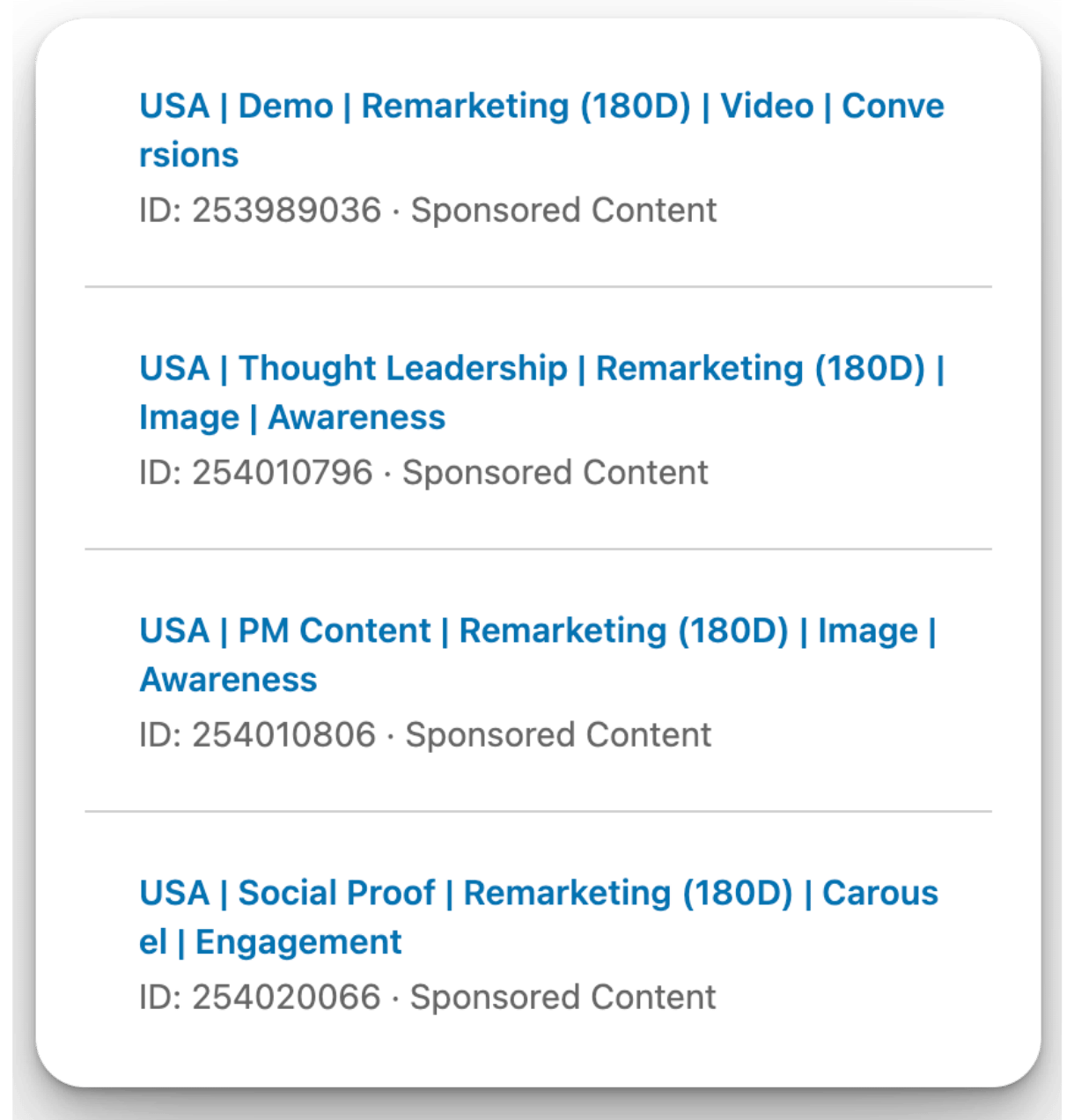
Optional: 30-Day LinkedIn Offer Bouncers Campaign
If you have the audience size available creating an offer bouncer campaign that shows personalized creative to folks who visited your intent pages and didn’t convert is worth testing.
Campaign Name: {Location} | {Offer} | {Offer Name Bouncers} (30D) | {Ad Type} | {Objective}
- EX: USA | Demo | Demo Page Bouncers (30D) | Conversation | Lead Gen
Recommended Objectives:
- Conversion focus = Lead Generation or Conversion
Recommended Daily Budget: $25-$100/day
Recommended Audiences (layer titles or function if possible):
- All pricing, demo, trial, and case study bouncers
- All meeting no-shows
Recommended Bid Strategies:
- Conversion focus = Manual CPC
Ads: Offers
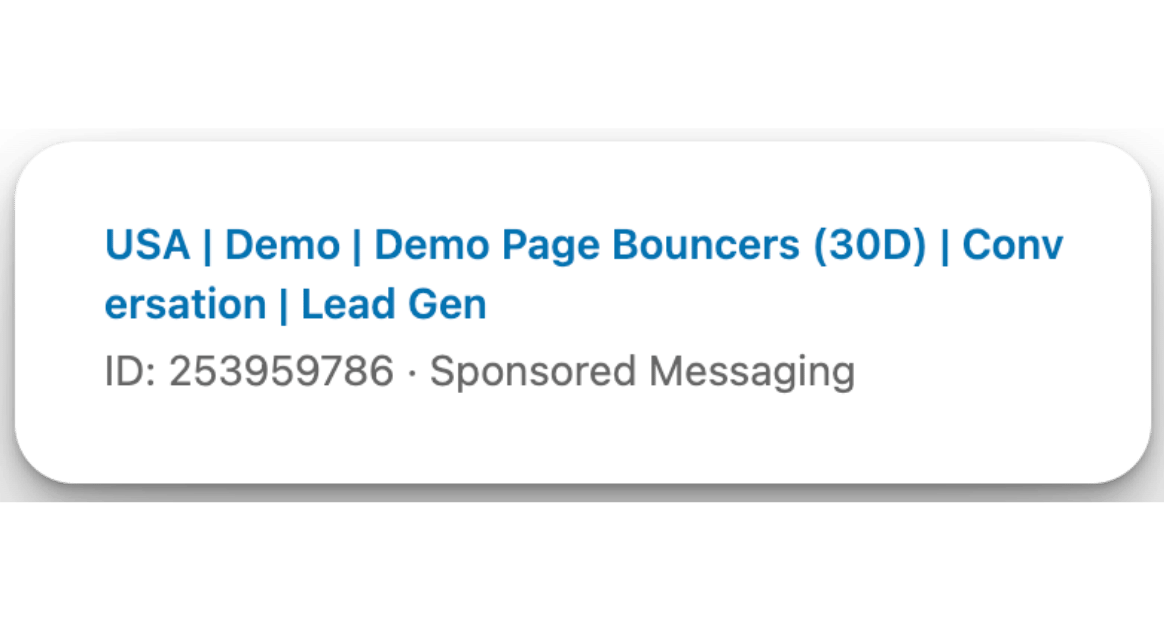
How to Build Meta (Facebook & Instagram) Retargeting Campaigns:
Highly recommend selecting manual placements of feeds and stories for Facebook & Instagram with creative in the correct dimensions to prevent your ads from appearing in the wrong formats.
Also don’t recommend delivering on the Audience Network or Video Feeds based on our past results, and make sure to not to run on Reels unless you have unique creative for that placement.
Always make sure your creative matches the placement it appears for.

Create the following campaigns in the Meta Ads campaign manager across whichever timeframes are applicable for your account:
Cohort #1: 30-Day Meta Retargeting
Campaign Name: {Location} | {Offer} | Remarketing (30D) | {Ad Type} | {Objective}
- EX: USA | PM Content | Remarketing (30D) | Image | Awareness
- EX: USA | Demo | Remarketing (30D) | Video | Sales
- EX: USA | Social Proof | Remarketing (30D) | Carousel | Traffic
Recommended Objectives:
- Content focus = Awareness, Traffic, Engagement
- Conversion focus = Leads or Sales
Recommended Daily Budget: $25-$100/day
Recommended Audiences:
- All website visitors (30D)
- All Facebook page visitors (30D)
- All Instagram page visitors (30D)
- All past event attendees (30D)
- All lead gen form opens and submits (30D)
- All 25-95% video viewers (30D)
- All closed lost contacts (30D)
Recommended Bid Strategies:
- Content focus = Maximize reach of ads, link clicks, engagement, or views
- Conversion focus = Maximize number of conversions or leads
Ads: Product marketing content, social proof, offers (ex: Demo, Trial)

Cohort #2: 90-Day Meta Retargeting
Campaign Name: {Location} | {Offer} | Remarketing (90D) | {Ad Type} | {Objective}
- EX: USA | PM Content | Remarketing (90D) | Image | Awareness
- EX: USA | Demo | Remarketing (90D) | Video | Sales
- EX: USA | Social Proof | Remarketing (90D) | Carousel | Traffic
- EX: USA | Thought Leadership | Remarketing (90D) | Image | Engagement
Recommended Objectives:
- Content focus = Awareness, Traffic, Engagement
- Conversion focus = Leads or Sales
Recommended Daily Budget: $25-$100/day
Recommended Audiences:
- All website visitors (90D)
- All Facebook page visitors (90D)
- All Instagram page visitors (90D)
- All past event attendees (90D)
- All lead gen form opens and submits (90D)
- All 25-95% video viewers (90D)
- All closed lost contacts (90D)
Recommended Bid Strategies:
- Content focus = Maximize reach of ads, link clicks, engagement, or views
- Conversion focus = Maximize number of conversions or leads
Ads: Product marketing content, social proof, offers (ex: Demo, Trial), thought leadership

Cohort #3: 180-Day Meta Retargeting
Campaign Name: {Location} | {Offer} | Remarketing (180D) | {Ad Type} | {Objective}
- EX: USA | PM Content | Remarketing (180D) | Image | Awareness
- EX: USA | Demo | Remarketing (180D) | Video | Sales
- EX: USA | Social Proof | Remarketing (180D) | Carousel | Traffic
- EX: USA | Thought Leadership | Remarketing (180D) | Image | Engagement
Recommended Objectives:
- Content focus = Awareness, Traffic, Engagement
- Conversion focus = Leads or Sales
Recommended Daily Budget: $25-$100/day
Recommended Audiences:
- All website visitors (180D)
- All Facebook page visitors (180D)
- All Instagram page visitors (180D)
- All past event attendees (180D)
- All lead gen form opens and submits (180D)
- All 25-95% video viewers (180D)
- All closed lost contacts (180D)
Recommended Bid Strategies:
- Content focus = Maximize reach of ads, link clicks, engagement, or views
- Conversion focus = Maximize number of conversions or leads
Ads: Product marketing content, social proof, offers (ex: Demo, Trial), thought leadership
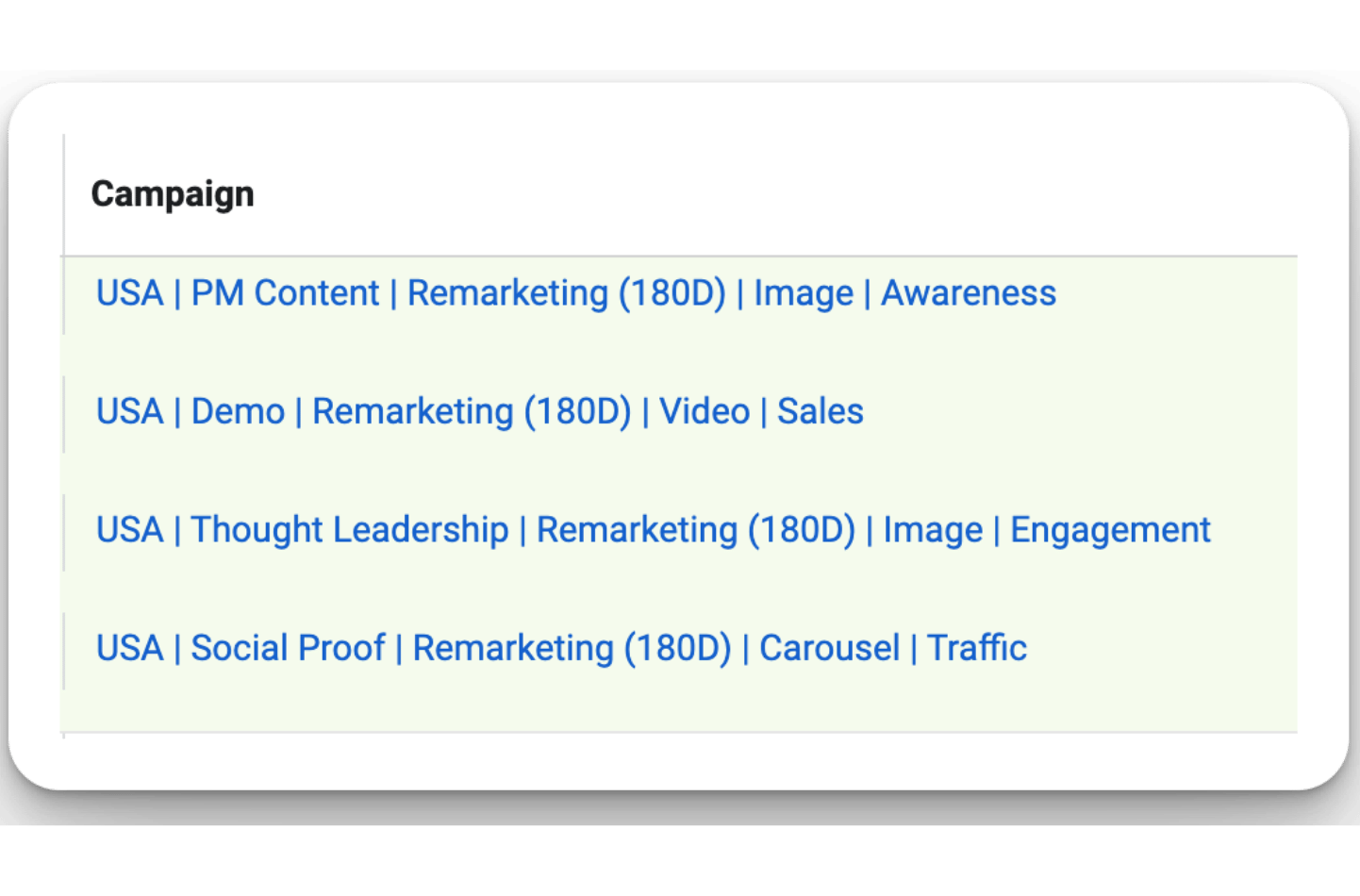
Optional: 30-Day Meta Offer Bouncers Campaign
If you have the audience size available creating an offer bouncer campaign that shows personalized creative to folks who visited your intent pages and didn’t convert is worth testing.
Campaign Name: {Location} | {Offer} | {Offer Name Bouncers} (30D) | {Ad Type} | {Objective}
- EX: USA | Demo | Demo Page Bouncers (30D) | Image | Leads
Recommended Objectives:
- Conversion focus = Leads or Sales
Recommended Daily Budget: $25-$100/day
Recommended Audiences:
- All pricing, demo, trial, and case study bouncers
- All meeting no-shows
Recommended Bid Strategies:
- Conversion focus = Maximize number of conversions or leads
Ads: Offers
.png)
How to Build X (Twitter) Retargeting Campaigns:
With X (Twitter) we don’t have the ability to filter by time frame so we’ll create the following campaigns in the ads manager:
Cohort #1: All Time (Twitter) Retargeting
Campaign Name: {Location} | {Offer} | Remarketing (All Time) | {Ad Type} | {Objective}
- EX: USA | PM Content | Remarketing (All Time) | Image | Reach
- EX: USA | Demo | Remarketing (All Time) | Video | Conversions
- EX: USA | Social Proof | Remarketing (All Time) | Carousel | Engagement
- EX: USA | Thought Leadership | Remarketing (All Time) | Image | Reach
Recommended Objectives:
- Content focus = Reach, Video Views, Engagement, Website Traffic
- Conversion focus = Conversions or Keywords
Recommended Daily Budget: $25-$100/day
Recommended Audiences:
- All website visitors (All Time)
- All 50-100% video viewers (All Time)
- People who saw your tweets (All Time)
- Followers of your X (Twitter) profile (All Time)
Recommended Bid Strategies:
- Content or conversion focus = Autobid
Ads: Product marketing content, social proof, offers (ex: Demo, Trial), thought leadership
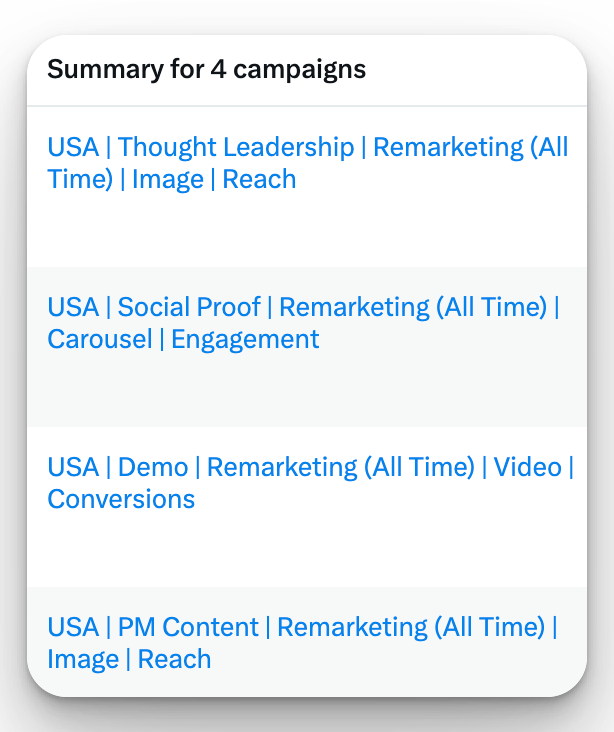
Optional: All Time X (Twitter) Offer Bouncers Campaign
If you have the audience size available creating an offer bouncer campaign that shows personalized creative to folks who visited your intent pages and didn’t convert is worth testing.
Campaign Name: {Location} | {Offer} | {Offer Name Bouncers} (All Time) | {Ad Type} | {Objective}
- EX: USA | Demo | Demo Page Bouncers (All Time) | Image | Conversions
Recommended Objectives:
- Conversion focus = Conversions or Keywords
Recommended Daily Budget: $25-$100/day
Recommended Audiences:
- All pricing, demo, trial, and case study bouncers
- All meeting no-shows
Recommended Bid Strategies:
- Content or conversion focus = Autobid
Ads: Offers
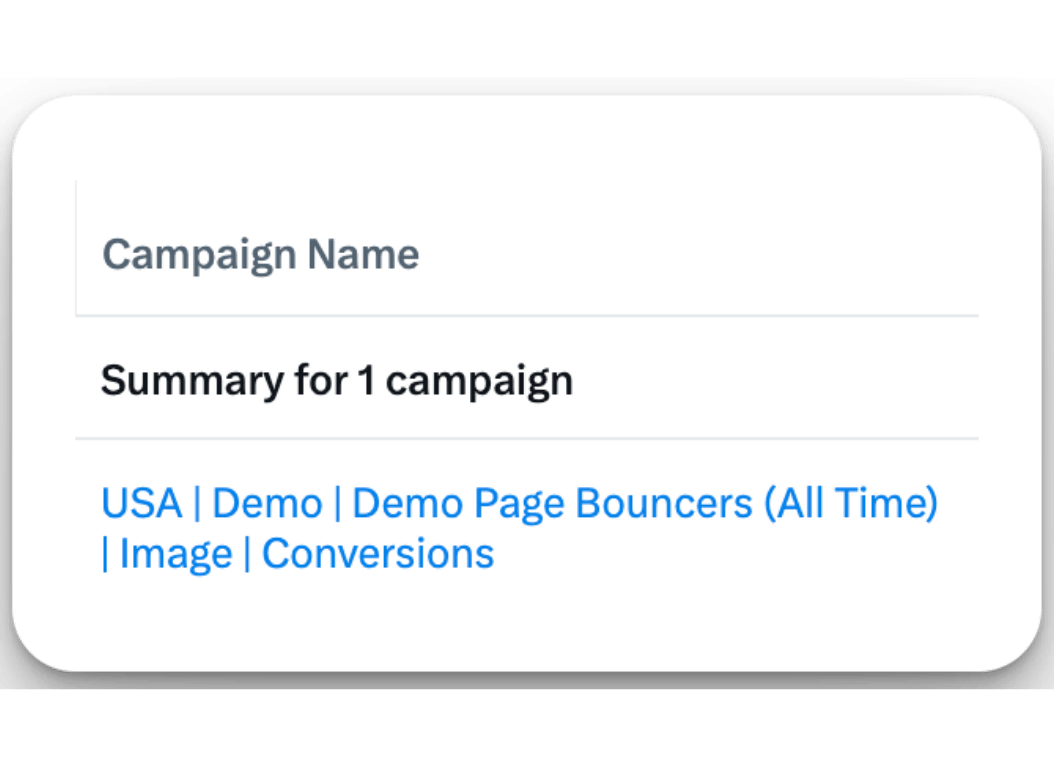
How to Build YouTube Retargeting Campaigns:
Create the following campaigns in the YouTube Ads campaign manager across whichever timeframes are applicable for your account:
Cohort #1: 30-Day YouTube Retargeting
Campaign Name: {Location} | {Offer} | Remarketing (30D) | {Ad Type} | {Objective}
- EX: USA | PM Content | Remarketing (30D) | In-Stream | Views
- EX: USA | Demo | Remarketing (30D) | In-Stream | Conversions
- EX: USA | Social Proof | Remarketing (30D) | In-Stream | Views
Recommended Objectives:
- Content focus = Get views
- Conversion focus = Drive conversions
Recommended Daily Budget: $25-$100/day
Recommended Audiences:
- All website visitors (30D)
- All YouTube video viewers (30D)
- All YouTube subscribers (30D)
Recommended Bid Strategies:
- Content focus = Max CPV
- Conversion focus = Maximize conversions
Ads: Product marketing content, social proof, offers (ex: Demo, Trial)
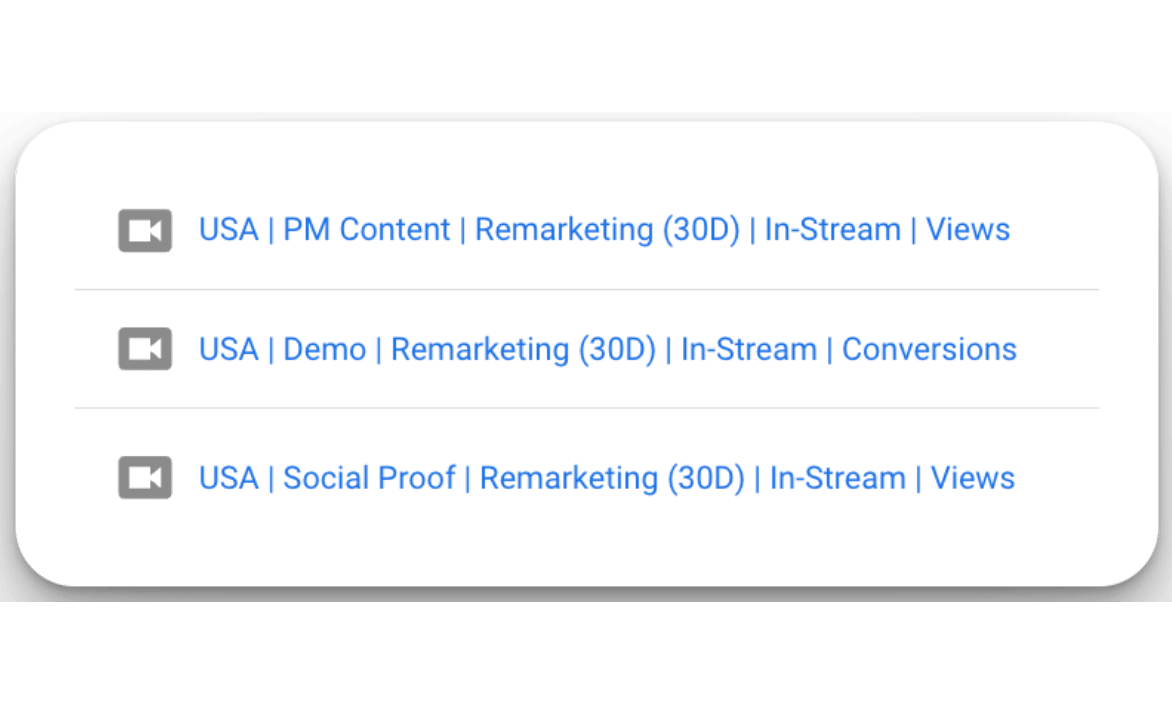
Cohort #2: 90-Day YouTube Retargeting
Campaign Name: {Location} | {Offer} | Remarketing (90D) | {Ad Type} | {Objective}
- EX: USA | PM Content | Remarketing (90D) | In-Stream | Views
- EX: USA | Demo | Remarketing (90D) | In-Stream | Conversions
- EX: USA | Social Proof | Remarketing (90D) | In-Stream | Views
- EX: USA | Thought Leadership | Remarketing (90D) | In-Stream | Views
Recommended Objectives:
- Content focus = Get views
- Conversion focus = Drive conversions
Recommended Daily Budget: $25-$100/day
Recommended Audiences:
- All website visitors (90D)
- All YouTube video viewers (90D)
- All YouTube subscribers (90D)
Recommended Bid Strategies:
- Content focus = Max CPV
- Conversion focus = Maximize conversions
Ads: Product marketing content, social proof, offers (ex: Demo, Trial), thought leadership
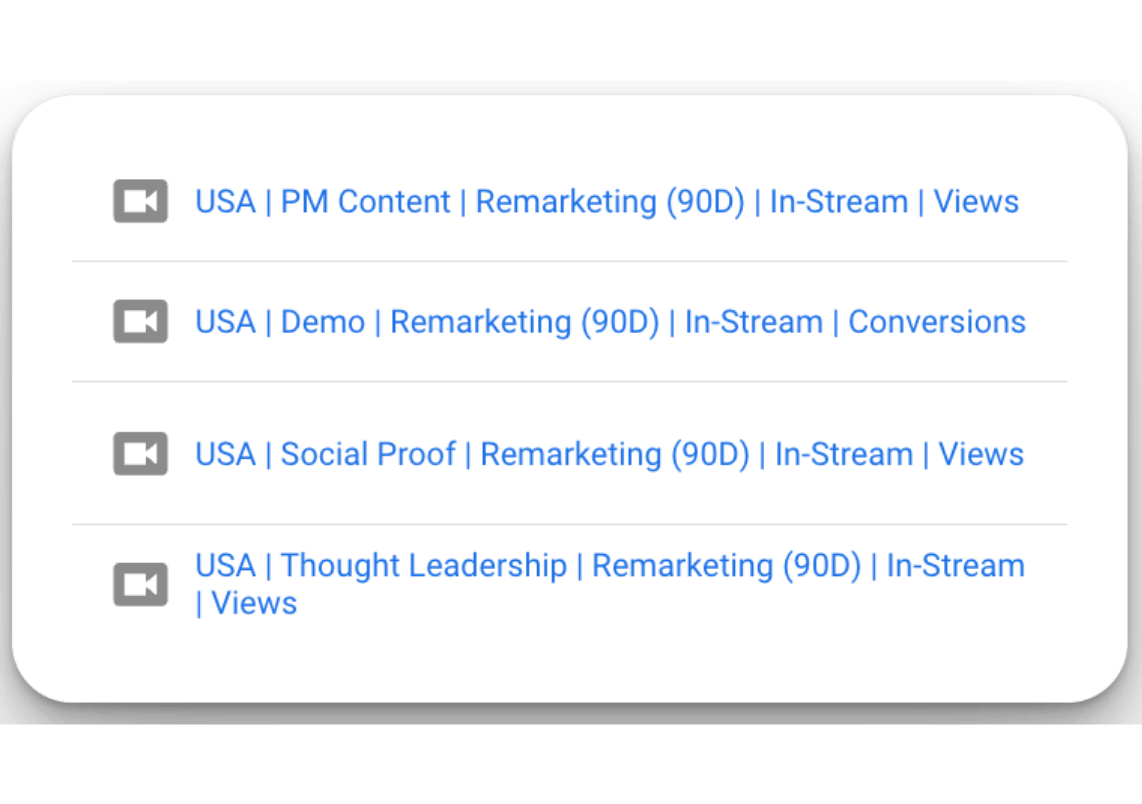
Cohort #3: 180-Day YouTube Retargeting
Campaign Name: {Location} | {Offer} | Remarketing (180D) | {Ad Type} | {Objective}
- EX: USA | PM Content | Remarketing (180D) | In-Stream | Views
- EX: USA | Demo | Remarketing (180D) | In-Stream | Conversions
- EX: USA | Social Proof | Remarketing (180D) | In-Stream | Views
- EX: USA | Thought Leadership | Remarketing (180D) | In-Stream | Views
Recommended Objectives:
- Content focus = Get views
- Conversion focus = Drive conversions
Recommended Daily Budget: $25-$100/day
Recommended Audiences:
- All website visitors (180D)
- All YouTube video viewers (180D)
- All YouTube subscribers (180D)
Recommended Bid Strategies:
- Content focus = Max CPV
- Conversion focus = Maximize conversions
Ads: Product marketing content, social proof, offers (ex: Demo, Trial), thought leadership

Optional: 30-Day YouTube Offer Bouncers Campaign
If you have the audience size available creating an offer bouncer campaign that shows personalized creative to folks who visited your intent pages and didn’t convert is worth testing.
Campaign Name: {Location} | {Offer} | {Offer Name Bouncers} (30D) | {Ad Type} | {Objective}
- EX: USA | Demo | Demo Page Bouncers (30D) | In-Stream | Conversions
Recommended Objectives:
- Conversion focus = Drive conversions
Recommended Daily Budget: $25-$100/day
Recommended Audiences (layer titles or function if possible):
- All pricing, demo, trial & case study visits
Recommended Bid Strategies:
- Conversion focus = Maximize conversions
Ads: Offers
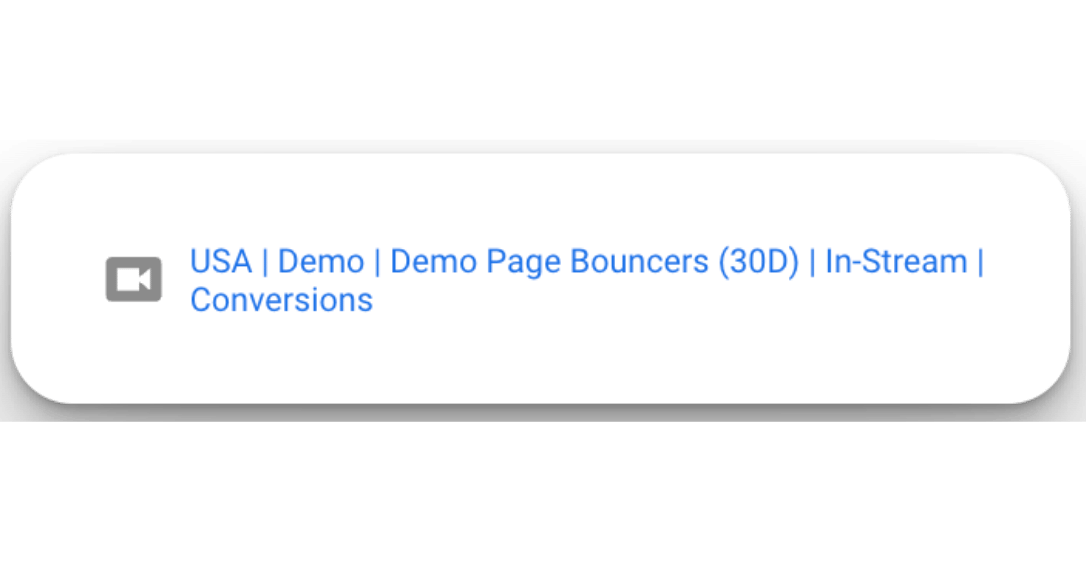
B2B Retargeting FAQ
There’s no shortage of questions around implementing successful retargeting campaigns.
We completely understand the complexity (especially when it’s your first time building them).
Here’s 5 of the most common retargeting questions we hear from clients:
How long does it take to build a retargeting audience?
- 7-30+ days depending on monthly engagement or traffic volumes for the retargeting segment you’re trying to build (ex: website visits, video views, post engagement, etc..)
How many channels should you advertise on?
- Focus on one advertising channel at a time when you have a limited budget (ex: < $3,000/month) master it and then expand to other channels over time.
How do you calculate your starting retargeting budget?
- $25-$100/day is a general rule of thumb you can follow as it’s enough to support the average costs per platform and coverage for small retargeting audiences when starting out.
How does retargeting work?
- Leveraging first party and third party data ad platforms are able to track user behavior in-app and out of platform allowing you to remarket to them based on past behavior.
How often do you need to refresh creatives for retargeting?
- A smaller audience size (ex: < 50,000) typically requires more frequent creative refreshes vs a larger one (ex: > 50,000) to prevent ad fatigue. At minimum you should aim to refresh ad creatives on a monthly basis to stay ahead of ad fatigue.
Launch Checklist
We’ve covered quite a bit in this blueprint!
Here’s a checklist we put together to help you easily reference when launching your retargeting campaigns to make sure you don’t forget anything and avoid common pitfalls.
- LinkedIn Retargeting: Launch Checklist
- Meta Retargeting: Launch Checklist
- X (Twitter) Retargeting: Launch Checklist
- YouTube Retargeting: Launch Checklist
Conclusion & Free Courses
Hope you received a tremendous amount of value from the blueprint! 🎉
If you’re serious about mastering B2B advertising then you definitely need to join 1,000+ B2B marketers leveling up their paid advertising skill sets in AdConversion.
Every one of our on-demand courses are:
✅ 100% free access.
✅ Taught by vetted industry experts.
✅ Have workbooks, resources, and templates.
✅ Less than 10 minutes per lesson.
We believe every marketer should know how to scale paid ads so they can:
• Scale their ideas
• Level up their careers
• Make a positive impact
Click here to join 1,000+ B2B marketers today and start leveling up your advertising skill set.
Takes < 90 seconds to sign up (seriously I timed it 😂)

Insider Benchmarks From $1,041,978 In YouTube Ads Cost Data
If you’ve ever asked yourself:
- How much does YouTube Ads cost?
- What’s a good view rate for YouTube Ads?
- What’s a good CTR for YouTube Ads?
We analyzed $1,041,978 In YouTube Ads data from 2023-2024 to find the answers.
Now It’s important to stress that benchmarks and stats should not be seen as law.
Use these benchmarks and stats as helpful starting point for perspective.
But ultimately you should hold yourself accountable to your own results.
The data set is comprised of the following sample:
- Companies with > $10,000 in YouTube spend
- Historical performance from 2023-2024
- 100% B2B SaaS organizations
For my fellow nerds 🤓 you can review and play with the anonymized data set here <<

Let’s jump into the insights!
TABLE OF CONTENTS
- How much does YouTube Ads cost?
- Average Cost Per Click (CPC)
- Average Cost Per Thousand Impressions (CPM)
- What’s a good view rate for YouTube Ads?
- What’s a good CTR for YouTube Ads?
- Additional Resources
How Much Does YouTube Ads Cost?
Average Cost Per View (CPV)
The average cost per view for YouTube in-stream ads is $0.05, ranging from $0.01-$0.19.
A view is only counted if someone watches at least 30 seconds of your video.

Average Cost Per Click (CPC)
The average cost per click for YouTube Ads is $3.56, ranging from $0.05 - $10.71.

Average Cost Per Thousand Impressions (CPM)
The average cost per thousand impressions (CPM) for YouTube Ads is $9, ranging from $1 - $23.

What’s a Good View Rate for YouTube Ads?
The average view rate for YouTube in-stream ads is 29.24%, ranging from 3.47% - 51.39%.

What’s a Good CTR for YouTube Ads?
The average clickthrough rate for YouTube in-stream ads is 0.51%, ranging from 0.09% - 1.64%.

Additional Resources
If you’re looking to uplevel your paid advertising skill set check out our free on-demand courses and join 1,000+ B2B marketers leveling up their skill sets.
If you want to dive deeper into B2B advertising check out some of our other top articles:
- B2B Advertising in 2024: The Definitive Guide
- How to Build a Multichannel B2B Retargeting Strategy (Step-By-Step)
- How to get LinkedIn-like Targeting with YouTube Ads for B2B
Hope these benchmarks and stats gave you some insight on YouTube Ads.
As mentioned at the beginning of this article benchmarks should only be used as a starting point.
Your performance and beating your current benchmarks is ultimately all that matters most.
People Also Ask
How can I optimize my YouTube Ads to achieve a lower Cost Per View (CPV)?
To reduce CPV, focus on creating engaging content that resonates with your target audience. Utilize precise targeting options to reach viewers more likely to engage with your ad, and experiment with different ad formats to determine which yields the best performance.
What factors influence the Cost Per Thousand Impressions (CPM) for YouTube Ads?
CPM is affected by factors including audience demographics, geographic location, industry competition, and seasonal demand. Understanding these elements can help in strategizing your ad placements and budgeting effectively.
How does the bidding strategy impact the overall cost of YouTube Ads?
Choosing between bidding strategies like Cost-Per-View (CPV) and Cost-Per-Thousand Impressions (CPM) can significantly influence ad costs. Selecting a strategy that aligns with your campaign objectives—whether focusing on views or impressions—can optimize spending.
What are some best practices for achieving a higher click-through rate (CTR) on YouTube Ads?
Enhance CTR by crafting compelling ad creatives with clear calls-to-action, ensuring relevance to the target audience, and conducting A/B testing to refine ad elements. Monitoring performance metrics allows for continuous optimization.
How can I effectively measure the return on investment (ROI) for my YouTube Ad campaigns?
Calculate ROI by comparing the revenue generated from the ad campaign to the total ad spend. Utilize tracking tools to monitor conversions and assess the profitability of your campaigns, adjusting strategies as needed to improve outcomes.

10 Proven Landing Page Tips You Can Apply Today To Boost Your Conversion Rates
Increase your SaaS landing page conversions with strategies you can apply today.
I’ve had the pleasure of crafting more than 100+ landing pages for top SaaS brands.
Here are my top 10 tips and landing page best practices for increasing conversion rates.
(In no particular order, they all matter)
TABLE OF CONTENTS
- Tip #1 - Showing the “Aha Moments” in the Hero Section
- Tip #2 - Switching from “Call to Action” to “Call to Value”
- Tip #3 - The Art of Showcasing True Value
- Tip #4 - Contrast: The Psychology Behind Decision-Making in SaaS
- Tip #5 - The Art of Show vs Tell
- Tip #6 - Increase Conversion by Selling Indirectly
- Tip #7 - Showcasing the Crucial 20% That Truly Resonates
- Tip #8 - Minimizing Risk to Maximize Conversion
- Tip #9 - How to Find Those “Aha Moments”
- Tip #10 - The Three Pillars for an Effective Landing Page
- Bonus Tip: Enhance Your Mental Reference
- Conclusion
- Resources for Mastering B2B Advertising
Tip #1 - Showing the “Aha Moments” in the Hero Section
Unlike traditional approaches that cram the hero section with exhaustive product details, the most effective strategy is to spark curiosity.
The hero's purpose transcends mere product selling; it's about unveiling those 'aha' moments that resonate deeply with the audience, compelling them to explore further.
'Aha' moments are those instances of sudden insight or discovery that leave a lasting impression on the audience.
In the hero section, showcasing these moments effectively can be the difference between a visitor bouncing off the page and one who stays to learn more.
For example, rather than just stating that a product simplifies a complex process, demonstrating this transformation through a brief, engaging visual or interactive element can be far more compelling.

The Case for Clarity and Creativity:
Consider a tool that converts audio instructions into a polished presentation.
A straightforward statement like "You talk, we'll write" paired with a generic AI-themed image does little to convey the true potential of the product.
A more effective strategy would involve a dynamic display of an audio clip evolving into a complete slide deck right within the hero section.
This visual demonstration not only clarifies the product's purpose but also instantly showcases its efficiency and innovative approach, making the value proposition clear and compelling from the outset.
Tip #2 - Switching from “Call to Action” to “Call to Value”
A compelling call to action (CTA) is effective not just because it tells users what to do, but because it clearly shows the value they'll get from taking action.
This principle is particularly relevant when discussing how to entice potential users to engage with a SaaS product, whether through booking a demo, signing up for a trial, or merely exploring the features of a tool.
The Strategy of Value-Driven CTAs:
A common misstep in crafting CTAs is the assumption that a straightforward directive—such as "Sign up for free" or "Book a demo"— suffices to motivate action.
However, this overlooks the critical need to communicate the unique benefits that await the user.
We need to shift from a generic call to action to one that vividly presents a 'value proposition'.
For instance, rather than merely inviting potential customers to "book a demo," a more effective approach would illustrate what they can expect to gain from that demo, such as “Book a 30-Minute Demo & Walk Away With 5 Tailored Tips”
Tailoring Experiences to Overcome Skepticism:
Marketers need to ensure that CTAs are not just gateways to product features but also to experiences that address the visitors' needs and concerns.
Particularly in industries where customers are overwhelmed with choices, standing out requires demonstrating immediate and tangible value.
Practical Example:
A service offering insights into optimizing YouTube ad placements might offer a "Free consultation to uncover 10 high-impact ad placements you're missing."
This approach directly speaks to the user's desire to gain an advantage and assures them of receiving valuable insights regardless of their decision to commit to the service.

Leveraging Trust Through Transparency and Results:
Trust plays a major role in converting users from interested observers to active participants. This trust can be significantly bolstered by transparency and evidence of potential results.
A case in point involves a service that automates customer feedback collection, where the CTA emphasizes the realistic outcomes users can expect, such as "Join our trial and see how businesses gain 10+ new reviews in just a week."
Such a statement not only sets clear expectations but also addresses common concerns around efficacy and value for time spent.
Tip #3 - The Art of Showcasing True Value
The debate between emphasizing features versus benefits has long been a topic of discussion.
However, a more profound approach focuses on selling outcomes—a strategy that transcends the traditional split by aligning a product's capabilities directly with the customer's success.
This method does not just highlight what the product can do or the advantages it offers but rather, it shows the tangible impact it will have on a user's objectives, such as enhancing profitability, efficiency, or operational insights.
For example, instead of stating that an analytics tool provides comprehensive data analysis (a feature) or delivers actionable insights (a benefit), outcome-based selling would focus on how it enables businesses to identify and rectify inefficiencies in their ad spend, ultimately increasing ROI.
Crafting an Indirect Promise:
One of the critical nuances of this approach is the subtlety of the promise being made.
Directly stating that a product will lead to more revenue or savings might trigger skepticism. Thus, the art lies in painting a scenario that leads the customer to reach these outcomes naturally.
By detailing the insights or efficiencies a tool provides, customers begin to see the path to increased profits or reduced costs themselves, making the conclusion feel like their discovery rather than a bold claim from the company.

Practical Example:
Consider a service that offers AI-driven call answering for small businesses. Rather than simply stating it answers calls, the marketing message could focus on the outcome:
"Never miss a sale again with our AI receptionist, ensuring you capture every opportunity, 24/7."
Such framing not only addresses the immediate feature but also connects it to a desirable business outcome—increasing sales by capturing every call.
Tip #4 - Contrast: The Psychology Behind Decision-Making in SaaS
Mastering the subtle technique of drawing contrasts does more than just emphasize a product's strengths;
It vividly contrasts the potential customers' current challenges with the brighter prospects that the right solution can offer.
Fundamentally, selling through contrast means outlining the challenges or limitations customers currently face and comparing these with the transformative benefits the product can provide.
The effectiveness of this strategy lies in its ability to magnify the perceived value of a solution, making the switch or become not just logical but, essentially, inevitable.
Crafting Compelling Contrasts:
Creating compelling contrasts requires a deep understanding of the customer's current struggles and how they align with the unique capabilities of the SaaS solution.
This involves asking probing questions that uncover pain points and limitations of current tools or processes and demonstrating how the product not only addresses these issues but also offers additional, unforeseen benefits

Tip #5 - The Art of Show vs Tell
Transcend beyond the superficial allure of adjectives like "fast," "easy," or "better," which, while enticing, often fall short of conveying the true essence and capability of a product.
Demonstrating Value Through Evidence:
The key lies in demonstrating value through clear, undeniable evidence.
For instance, showcasing a time-lapse video of creating a 25-email sequence in 15 minutes delivers a powerful, visual affirmation of the tool's efficiency.
This method not only captures attention but also dispels doubts by providing a visual benchmark for the tool's capability.
The Synergy with Earlier Strategies:
"Show, don't tell" beautifully complements earlier discussed strategies like focusing on outcomes and creating contrast.
It provides the tangible proof that underpins these approaches, ensuring that the marketing message is not just heard but felt and understood.
The landing page below has a short video demonstrating the value to prospects.
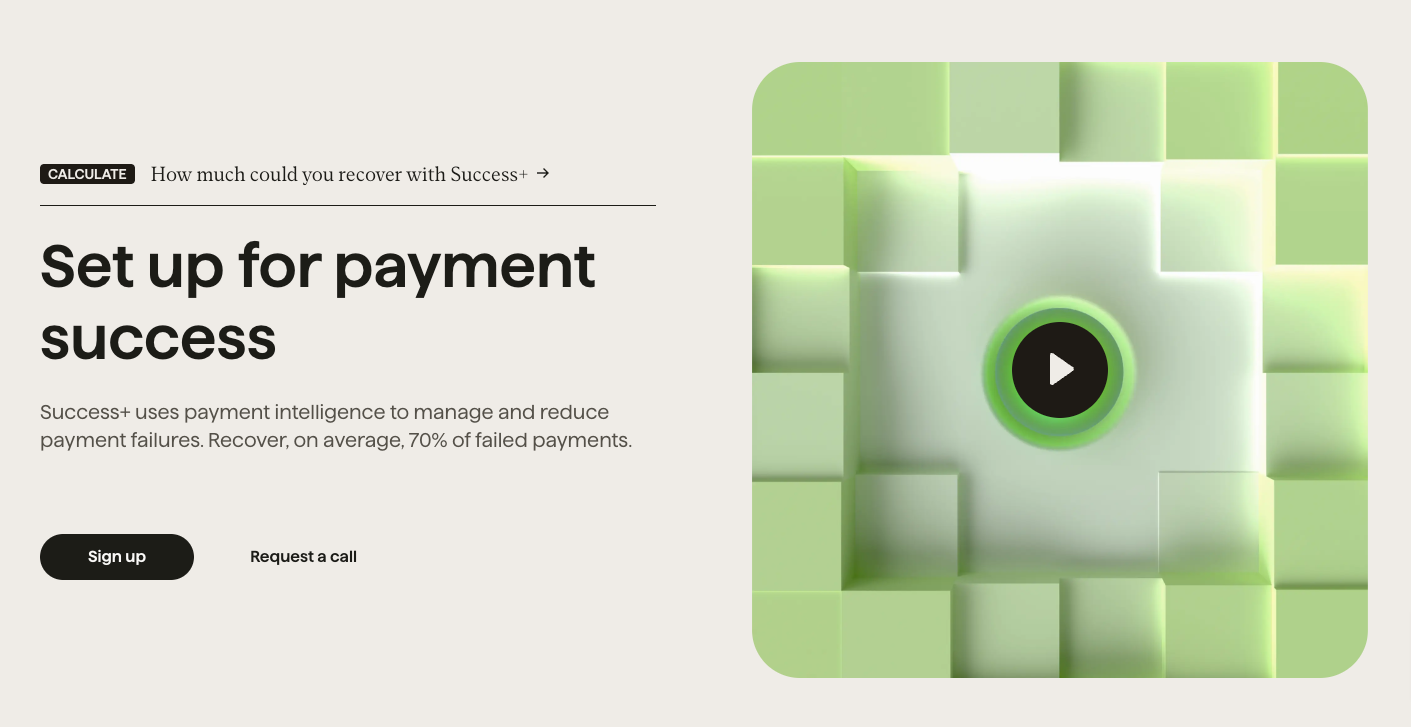
Tip #6 - Increase Conversion by Selling Indirectly
The ability to sell outcomes indirectly is not just a tactic; it's an art form.
The essence of this approach lies in the subtle but powerful shift from telling prospects about the benefits of a product to showing them the tangible impact it can have on their operations, revenue, or efficiency.
Direct claims often invite skepticism, whereas indirect suggestions inspire imagination and belief.
The Power of Indirect Selling:
Direct selling, especially when it involves bold claims like being the "number one CRM for a niche," tends to be met with skepticism.
Prospects are bombarded with similar claims daily, making them numb to such assertions.
The challenge, therefore, is to engage their imagination and lead them to the conclusion that your product is the superior choice without explicitly stating it.
This involves painting a picture of the outcomes in a way that the prospect can see themselves achieving these results with your product.
Practical Example:
Consider the scenario of a dental practice missing calls—and thereby potential business—outside of office hours.
Instead of merely stating that an AI receptionist tool can save them money and time, the narrative is constructed around the loss incurred when calls go unanswered.
By quantifying the potential loss (e.g., "every missed call could cost you a thousand dollars"), the message effectively highlights the cost of inaction.
This approach leverages the fear of loss, a potent motivator, making the solution offered by the product not just desirable but necessary.
Another innovative approach is using analytics and user feedback mechanisms within the product itself to remind users of the value they're missing by not upgrading.

Tip #7 - Showcasing the Crucial 20% That Truly Resonates
The effectiveness of a landing page can significantly influence a company's conversion rates.
Simplicity is one of the most important components of a successful landing page, yet it is often overlooked.
Rather than bombarding potential customers with every detail and feature of the product, present just enough information to pique interest and guide visitors to the next step.
The primary goal of a landing page is not to sell the product in its entirety but to entice visitors with a compelling overview that encourages them to explore further.
Say more with less:
- Show, Don't Overwhelm: overloading a page with information can deter potential leads.
- Simplify the Decision-Making Process: by offering a snapshot rather than a deep dive, companies can make it easier for prospects to decide and engage further with the product.
- Address Key Objections Proactively: incorporating elements that address key objections can transform a passive viewer into an active lead.

Every potential customer comes with a set of preconceived notions and concerns that could hinder their willingness to engage with a product.
Successful landing pages anticipate these objections and address them upfront.
This proactive strategy serves two purposes:
- Reassures visitors that their concerns are recognized
- Positions the company as attentive and customer-centric.
For instance, if a common objection is the perceived complexity of integrating a new software tool into existing workflows, a landing page might feature testimonials from users who found the process straightforward and supported.
This kind of social proof can alleviate concerns and motivate visitors to take the next step.
Practical Example:
Consider a SaaS product designed to enhance project management.
Instead of listing every feature and tool available, focus on showcasing how it simplifies project tracking, enhances team collaboration, and leads to better project outcomes.
Use visuals and brief case studies to demonstrate the benefits.
This method not only captures interest but also sets the stage for visitors to discover more by trying the product themselves.
The Role of the Landing Page in the Sales Process:
The landing page itself is not the end goal but a means to an end.
The ultimate objective is to guide visitors toward making a decision.
So, the landing page should be designed with this goal in mind, ensuring that the call-to-action (CTA) is clear, compelling, and aligned with what visitors are seeking.
This concept extends to product-led growth companies, where even free products require a degree of selling.
In this context, the landing page must convincingly communicate the value of trying the product, addressing any barriers to action, such as time investment or skepticism based on past experiences with similar tools.
Tip #8 - Minimizing Risk to Maximize Conversion
Removing perceived risk is often more straightforward and impactful than detailing the outcome.
This approach centers on simplifying the decision-making process for potential users by alleviating their concerns and highlighting ease of use.
The Challenge of Clarifying Outcomes:
Clarifying the outcome a product or service offers can be a complex task, requiring precise language and a deep understanding of the audience's needs and expectations.
It involves not just stating what the product does, but also communicating its value in a way that resonates with potential users.
This can be particularly challenging when dealing with innovative or complex solutions where the benefits are not immediately apparent.
Easing the Path to Conversion:
Contrary to the complex process of defining outcomes, mitigating risk for the user often follows a more straightforward path.
It involves clear, actionable steps that directly address common concerns and barriers to entry.
Possible actions include:
- Enhancing Call to Actions
- Addressing Objections Proactively
- Showcasing Practical Examples
Removing risk transforms the decision-making process from a calculation into an opportunity.
When potential users feel that they have nothing to lose and everything to gain, the barrier to taking the next step lowers significantly.

Tip #9 - How to Find Those “Aha Moments”
Identifying “ Aha Moments” requires a deep understanding of the user experience, often achieved through collaboration with teams directly interacting with customers, such as sales and support.
Once identified, these moments should be prominently featured on the landing page.
This could involve detailed case studies, interactive demos, or succinct bullet points that directly address common questions or concerns.
For instance, if a product offers unprecedented ease of use, showing a quick video of someone setting up a complex task in minutes can be incredibly persuasive.

Practical Example:
Illustrating how a product can solve a problem in a way that no other can, such as automating a task that typically takes hours into just a few clicks, can instantly communicate its value.
Practical examples not only aid in understanding but also help potential users envision themselves benefiting from the product.
Tip #10 - The Three Pillars for an Effective Landing Page
Creating an effective landing page is like constructing a building.
It requires a solid foundation and supportive pillars to ensure stability and function.
There are three critical pillars that, when thoroughly crafted and harmonized, can significantly enhance the page's effectiveness and conversion rates.
These pillars are:
- Results: the promise of value
- Perceived Superiority: standing out from the competition
- Risk Mitigation: lowering the barriers to adoption
This approach ensures that every element of the landing page works in harmony to support the ultimate goal:
Driving conversions and achieving business objectives.
Bonus Tip: Enhance Your Mental Reference
Just as artists draw from a vast mental library of images and concepts to create something novel and breathtaking, landing page designers and copywriters must build their own collection of inspirational references.
This mental database enables them to recognize and apply successful elements from various sources, combining them in innovative ways that resonate with their specific audience.
How to build your mental reference:
- Curate Examples: actively seek out and save examples of landing pages, ads, copy, and designs that catch your attention. some text
- Tools like Pinterest or dedicated design inspiration websites can be invaluable.
- Tools like Pinterest or dedicated design inspiration websites can be invaluable.
- Analyze What Works: don't just collect examples; study them.some text
- What makes a particular landing page effective?
- How does it engage its audience?
- How are the visuals and copy aligned to convey a compelling message?
- Learn from Various Industries: broaden your horizons by exploring successful landing pages across different sectors.
- Stay Updated: the digital landscape is ever-evolving, and so are the trends in landing page design and copywriting. Keeping up-to-date with the latest trends ensures your mental reference is not only vast but also relevant.
Conclusion:
In crafting effective landing pages, the key lies in simplicity, clarity, and focusing on the product's true value.
By enticing users with outcomes rather than overwhelming them with features, addressing their concerns upfront, and demonstrating the tangible benefits they stand to gain, companies can significantly boost conversions.
This holistic approach, from spotlighting product essence to leveraging contrast and indirect selling, transforms landing pages from mere entry points into powerful catalysts for customer engagement and success.
Resources for Mastering B2B Advertising
If you’re serious about mastering B2B advertising then you definitely need to join 1,000+ B2B marketers leveling up their paid advertising skill sets in AdConversion.
Here’s 4 reasons why you should consider joining. Every one of our on-demand courses are:
✅ 100% free access.
✅ Taught by vetted industry experts.
✅ Have workbooks, resources, and templates.
✅ Less than 10 minutes per lesson.
We believe every marketer should know how to scale paid ads so they can:
- Scale their ideas
- Level up their careers
- Make a positive impact
Click Here to Join 1,000+ B2B Marketers Today and start leveling up your advertising skill set.
Takes < 90 seconds to sign up (seriously we timed it 😂)
People Also Ask
How can I effectively measure the success of my landing page optimizations?
Utilize analytics tools to monitor key performance indicators (KPIs) like conversion rates, bounce rates, and average session duration. A/B testing different elements can also provide insights into what changes resonate with your audience.
What are common pitfalls to avoid during landing page optimization?
Avoid cluttered designs, slow load times, and unclear calls-to-action. Ensuring mobile responsiveness and aligning content with user intent are also crucial to prevent high bounce rates.
How often should I update or test my landing pages?
Regularly review performance metrics and conduct A/B tests, especially when introducing new products or campaigns. Continuous optimization helps maintain relevance and effectiveness.
What role does SEO play in landing page optimization?
Incorporating relevant keywords, optimizing meta tags, and ensuring fast load times can improve search engine rankings, driving more organic traffic to your landing page.
How can I personalize landing pages for different audience segments?
Use dynamic content to tailor messages based on user demographics, behavior, or referral sources, creating a more personalized and engaging experience.

10 Insider Tips on Event Promotion From $1M+ In Ad Spend
Looking to boost registrations for your next event?
I’ve been a part of a team that has driven 10,000+ registrations for events like Ascend, and Innovation Day.
Here are my top 10 event promotion best practices for increasing registrations through paid ads.
(In no particular order, they all matter)
TABLE OF CONTENTS
- Tip #1: The Four-Stage Framework for Event Marketing
- Tip #2: Utilizing Partnerships & Internal Networks
- Tip #3: Mastering Segmentation & Efficiency
- Tip #4: Remarketing Mastery: Capitalizing on Targeted Engagement
- Tip #5: Cross-Channel Integration
- Tip #6: Geo-Targeted Ads: Precision Marketing for Event Success
- Tip #7: Gamification: Turning Engagement into a Competitive Advantage
- Tip #8: Display Advertising & Maximizing Visibility
- Tip #9: Remarketing Campaigns: Sharpening the Focus for Better ROI
- Tip #10: Mastering ROI: The North Star of Marketing Success
- Conclusion
- Resources for Mastering B2B Advertising
Tip #1: The Four-Stage Framework for Event Marketing
Maximizing ROI on event marketing demands more than just throwing money at promotions.
It requires a carefully structured budget across four critical stages:
- Pre-Event
- Event-Day
- Post-Event
- Repurpose-Phase

Let’s break down each stage.
1/ Pre-Event: The Hype Machine:
The goal here is to generate buzz and build anticipation. It's about investing wisely in creating brand awareness with assets like videos, static images, that get people excited and start conversations.
The aim? To discover what truly resonates with your audience.


2/ During the Event Day: Capturing Attention:
As the event unfolds, there's a golden opportunity to keep marketing with timely emails and live updates.
It's not just about informing; it's about keeping the engagement needle moving by reminding attendees of the value they're getting, right as it happens.

3/ Post-Event: Leveraging Assets:
Post-event, the focus shifts to capitalizing on the event's content.
Recorded sessions and dedicated landing pages become key tools in extending the event's lifecycle.
How? By marketing these assets to both attendees for reinforcement and to those who missed out, providing them a chance to engage.

4/ After The Event - The Repurpose Phase:
Finally, we enter the "Repurpose-Phase," where content from the event transcends its original context.
This is where smart marketers reuse and recycle event content in ads or promotions for future events, turning one-time efforts into long-term assets.

Budget distribution:
Whatever your budget may be, the principle remains the same—allocate strategically.
Invest heavily in the “Pre-Event Phase” to find your audience's pulse and save a portion for the "Repurpose Phase" to fuel future events.
This staggered approach not only maximizes exposure at each stage but also ensures that registrations and engagement peak when it matters most.
Practical Budgeting Example
With a $1,000 budget, consider allocating $600 towards the Pre-event phase to test and refine your marketing approach.
Reserve $200 for live engagement during the event, and use the remaining $200 to promote your post-event content and seed future events, ensuring your marketing efforts continue to bear fruit long after the event has concluded.
Tip #2: Utilizing Partnerships & Internal Networks
When your marketing budget seems like a drop in the ocean, it's time to get creative with what you have.
Even with $5,000 in hand, there's a wealth of untapped potential lying within your LinkedIn connections and internal team networks.
Strategic Content Sharing:
Kickstart your campaign by encouraging your team to engage with your event posts on LinkedIn.
This simple action can significantly boost your visibility, pushing the algorithm into recognizing your content's importance.
Influencer Collaboration:
Whether it's through LinkedIn, Instagram, or niche forums like Reddit, reaching out to influencers with a teaser of your event will extend your reach beyond your immediate circle.
Pro-tip:
Offer influencers engaging assets like short videos to make sharing easier and more appealing. The goal is to make your event resonate within their networks, amplifying your message through trusted voices in the community.

How to Craft Influencer Outreach:
Semrush: When faced with promoting an event with limited resources, leveraging Semrush to identify key content creators in your domain can be a game-changer.
Once you find out which websites are most suitable, cold emails to these targeted individuals proposing collaboration opportunities can open doors to new audiences.

LinkedIn Strategies: Joining LinkedIn groups and engaging with active members can also unearth opportunities for partnership.
It's about finding mutual benefits, even if it comes with a price tag.
Influencers typically have set rates, so budget accordingly. However, when reaching out directly to content creators or platforms, there's more room for negotiation.

Boosting Organic Posts: Another proven method is enhancing your LinkedIn posts organically through employee engagement before opting for paid promotions.
Remember, it's not just about spending money but making every dollar work smarter.
Example of Boosting an organic post for LinkedIn

For additional tips on promoting events, check out this LinkedIn post by AdConversion.
Tip #3: Mastering Segmentation & Efficiency
Let’s start with critical pitfalls to steer clear of.
Broad targeting equals wasted effort.
Dial into the specifics of your audience to ensure your content reaches the right eyes and ears.
- Segmentation is Non-negotiable: Specificity in targeting not only enhances engagement but also optimizes your budget by focusing on the most promising prospects.
- Creativity within Constraints: Don't let the perfect be the enemy of the good. "Good Enough" can often be your best starting point. Launch with what you have, then adapt and improve.
- ROI vs. ROE: While ROI (Return on Investment) reigns supreme, don't overlook the ROE (Return on Effort).
Evaluate the potential returns against the effort required. Sometimes, the simplest strategies yield the best results without exhaustive planning and resource allocation.
Pro-tip:
- Launching event promotion comes with its share of delays and edits. Start early and simplify.
- Overcomplicating creative requests can bottleneck the process, jeopardizing your timeline.Embrace minimalism in your initial creative assets.
- Focus on refining the message rather than getting lost in the design details. There will be room to iterate and enhance based on real-world feedback.
Tip #4: Remarketing Mastery: Capitalizing on Targeted Engagement
After laying the groundwork with audience segmentation, remarketing emerges as the strategic follow-through that ensures your message continually reaches those most likely to act.
It’s about reconnecting with website visitors, video-view watchers, image interactors, etc.
Reaching to those who demonstrated interest but haven't yet taken the desired action.
By targeting these engaged users with specific, relevant ads, the probability of conversion (registration) significantly increases.
If you want a crash course on remarketing check out this 35-page blueprint on How to Build a Multichannel B2B Remarketing Strategy by Silvio Perez.

Tip #5: Cross-Channel Integration
Using just one platform for event promotion is like whispering in the midst of a loud crowd.
The essence of cross-channel integration lies in presenting a unified brand narrative across various platforms.
From LinkedIn's precise targeting capabilities to the broad reach of YouTube and the personal touch of Meta's networks, each channel plays a critical role in amplifying your event's visibility.
Pro tip: Check this article to learn how to get LinkedIn-like targeting on YouTube ads for B2B.
Platform-Specific Strategies: A Closer Look:
YouTube: Leveraging YouTube for its vast audience and cost-effective view rates turns your event promotion into an engaging visual narrative.
Here, remarketing shines, allowing you to reconnect with interested viewers through compelling video content.
- LinkedIn: With unmatched segmentation options, LinkedIn stands out for B2B event promotion. Tailoring your message to reach specific professional demographics ensures your event resonates with the right audience.
- Meta: Often underestimated in B2B contexts, Meta (Facebook and Instagram) offer a unique space for testing and remarketing. Here, the personal intersects with the professional
Navigating the Creative Challenge:
A common hurdle in cross-channel marketing is content creation, especially video for platforms like YouTube.
The solution? Creativity and repurposing. Utilize existing assets, from high-engagement talks to website walkthroughs, and repurpose them into new video content with minimal effort.
Think of content as modular components that can be assembled and reassembled to suit different platforms.
A blog post can transform into an infographic, a webinar clip, or a social media snippet, maximizing your content's reach and lifespan.

Tip #6: Geo-Targeted Ads: Precision Marketing for Event Success
For events that offer both in-person and virtual attendance options, geo-targeted ads stand out as a proven tactic.
By targeting potential attendees within a specific radius of the event location, you ensure that your advertising dollars are spent on those most likely to attend in person.
Example of Meta’s radius targeting:

Measuring the Impact of Geo-Targeted Campaigns:
Leveraging tools like Gradual allows for detailed tracking of event registrations, distinguishing between virtual and in-person sign-ups.
This segmentation is key in evaluating the effectiveness of geo-targeted campaigns, providing insights into lead quality and audience relevance.
Creative and Tactical Considerations:
While geo-targeting primarily focuses on the pre-event phase, its implications for brand visibility are vast.
Creative tactics, such as mobile digital billboards, can also play a role in maximizing local awareness, even in relation to competitors' events.
Pro-tip
- For events with significant local interest, consider augmenting your digital geo-targeting with physical advertising moves.
- This can create a buzz around your event and ensure your brand remains top-of-mind among your target audience.
Tip #7: Gamification: Turning Engagement into a Competitive Advantage
Gamification: A strategy to break through the noise!
By switching up event promotion into an interactive and competitive experience, you not only capture attention but also foster a sense of community and excitement around your event.
Practical Example
- Offering a free drone to the attendees with the most referrals turns the event sign-ups into an engaging competition.
- This not only increases exposure but also incentivizes participants to become advocates for the event, effectively turning them into an extension of the sales team.
Operationalizing Gamified Content:
Using tools like Gradual, attendees receive a virtual ticket upon registration, complete with a unique referral link for sharing on social platforms.
This system not only simplifies sharing but also tracks referrals back to the source, enabling a competitive leaderboard to emerge.
Tip #8: Display Advertising & Maximizing Visibility
Stepping beyond traditional advertising channels can lead to remarkable visibility.
Display advertising, mainly used through Google Display Network or programmatic ads, holds untapped potential when approached through direct publisher partnerships.
Direct Publisher Engagement:
The strategy here isn’t just to place ads but to place your event promotions on websites specifically relevant to your niche.
By using tools like SEMRush to identify these niche publishers and reaching out directly, you can secure ad placements that speak directly to an engaged audience.
The Operational Dynamics:
Differentiating from the wide net cast by typical display networks, focusing on publisher partnership involves negotiating directly with site owners.
This can range from pop-up ads to dedicated ad slots on their site, leveraging their audience for your event’s gain.
Reducing Variables for Success:
The common pitfalls of display advertising come from an overwhelming array of variables. From ad dimensions and placements to the diversity of websites.
By choosing a direct partnership with publishers, you drastically reduce these variables, focusing on what matters most: context and audience relevance.

Tip #9: Remarketing Campaigns: Sharpening the Focus for Better ROI
We touched on the importance of remarketing in tip #4 but this is such an easy win for most brands that it deserves emphasizing. Since users have interacted with the brand before, remarketing can be ideal for high-intent offers such as "demos" or "free trial". The initial challenge often lies in cultivating a large enough audience size.
Start by building broad prospecting campaigns to stir interest and engagement across your target demographics. This boosts awareness and seeds your remarketing pool with individuals who have shown an initial interest in your offerings.
Remarketing should be viewed not just as a conversion approach but as a nurturing mechanism. With the ability to promote a mix of content—from event announcements to demos and trials—remarketing can support the entire customer journey, especially in B2B contexts where sales cycles are longer.
If you want a crash course on remarketing check out this 35-page blueprint on How to Build a Multichannel B2B Remarketing Strategy by Silvio Perez.
Tip #10: Mastering ROI: The North Star of Marketing Success
Knowing your numbers and directly tying marketing efforts to revenue generation and pipeline acceleration is fundamental. The ultimate measure of marketing’s effectiveness lies in its ability to influence revenue.
Every campaign, ad, and event should be scrutinized through the lens of its potential to contribute to the bottom line. This requires a deep understanding of your audience, the sales cycle, and the points at which marketing interventions can make a tangible difference.
Operationalizing ROI-Focused Strategies:
Quantitative Analysis: Adopt a data-driven approach to every marketing initiative.
This means setting clear, measurable objectives upfront, rigorously tracking performance, and continually refining tactics based on empirical evidence of what works.
- Strategic Alignment: Ensure that marketing activities are fully aligned with broader business goals. Collaboration with sales, product development, and customer success teams can provide valuable insights that help tailor marketing efforts for maximum impact on revenue and pipeline progression.
- Cultivating a Business Mindset: Transitioning from a pure marketing perspective to thinking like a CEO involves a broader appreciation for how marketing activities contribute to the overall health and growth of the business.
It’s about seeing beyond immediate metrics to understand the strategic importance of marketing as a driver of long-term success.
Conclusion
In this article, we covered 10 actionable tips for promoting your next successful event through paid ads.
Just to highlight a few key points, we talked about the 4 pillars of event promotion and how to distribute your budget in each phase, utilizing partnerships & internal networks, audience segmentation, and thinking like an investor to maximize your return on investment (ROI) and return on effort (ROE).
Each of the 4 event planning stages plays an important role, from generating buzz and capturing live attention to extending the event's influence and repurposing its content for future efforts. The power of partnerships, strategic content sharing, and influencer collaborations cannot be overlooked. It’s an effective way of broadening reach without proportionally increasing spend.
Remarketing and audience segmentation are essential for converting initial interest into conversions (registrations), while cross-channel integration expands your digital footprint to reach your audience on all key platforms.
I hope you got a ton of insights from this article and wish you fruitful results for your next events.
Resources for Mastering B2B Advertising
If you’re serious about mastering B2B advertising then you definitely need to join 1,000+ B2B marketers leveling up their paid advertising skill sets in AdConversion.
Here’s 4 reasons why you should consider joining. Every one of our on-demand courses are:
✅ 100% free access.
✅ Taught by vetted industry experts.
✅ Have workbooks, resources, and templates.
✅ Less than 10 minutes per lesson.
We believe every marketer should know how to scale paid ads so they can:
- Scale their ideas
- Level up their careers
- Make a positive impact
Click Here to Join 1,000+ B2B Marketers Today and start leveling up your advertising skill set.
Takes < 90 seconds to sign up (seriously we timed it 😂)
People Also Ask
How can I effectively measure the success of my event promotion campaigns?
Utilize key performance indicators (KPIs) like registration numbers, attendance rates, engagement levels during the event, and post-event feedback. Tools like Google Analytics and social media insights can help track these metrics.
What are some common pitfalls to avoid in event promotion?
Avoid neglecting audience segmentation, underestimating the importance of follow-up communications, and failing to allocate sufficient budget across all promotional phases. Ensuring a balanced approach can prevent these issues.
How can I leverage user-generated content to enhance event promotion?
Encourage attendees to share their experiences on social media using a dedicated event hashtag. Feature this content in your promotional materials to build credibility and engage potential attendees.
What role does influencer marketing play in promoting events?
Collaborating with industry influencers can expand your event’s reach and add credibility. Influencers can share event details with their followers, potentially increasing registrations.
How can I ensure a seamless transition from online promotion to on-site engagement?
Maintain consistent messaging across all platforms and provide clear information about the event schedule, location, and activities. Utilize event apps or social media groups to keep attendees informed and engaged before and during the event.

10 Tips to Boost B2B SaaS Marketing Beyond Ad Platforms
Are you looking to drive a greater return from your paid ads?
The answer often lies outside of the ad platforms themselves.
Here are 10 actionable tips to improve ad performance outside the ad managers.
Let’s dive into it! 👇
TABLE OF CONTENTS
- Tip #1: Unleash the Power of GA4’s Page Path Report
- Tip #2: Leverage Multiple Data Sources to Measure Performance
- Tip #3: Work with the Product or Service Team to Design Lead Magnets
- Tip #4: Meet with Sales & Customer Success for Insights
- Tip #5: Get Hands-on with Your Product or Service
- Tip #6: Dive Into CRM Metrics for a Holistic View
- Tip #7: Get Regular Insights from the Sales team
- Tip #8: Link Marketing Efforts to Business Results
- Tip #9: Incorporate Leading Indicators into Your Success Metrics
- Tip #10: Practice Patience
- Conclusion
- Resources for mastering B2B advertising
Tip #1: Unleash the Power of GA4’s Page Path Report
Have you ever wondered how visitors wander around your site before hitting that sweet 'convert' button?
In B2B, it's pretty rare for someone to convert after just one page visit. So, imagine discovering that a whopping 90% of your future clients check out your pricing page before deciding you're the one.
That's your cue! With this intel, you can strategically place pricing info where it matters most, like in your ads or on key landing pages. It's all about making that path to conversion as smooth as possible.
GA4's Page Path report is like a treasure map showing you the most popular pit stops.
You can access the page path report by signing into your GA4 account, on the left-hand side, click on “explore” and select the pre-made template called “path exploration”.
In the example below, we can see out of 1,958 page views, we had 17 form submissions ↓

Bonus tip from episode insights:
Tools like Hotjar can be like a pair of X-ray glasses for your website. They let you peek into how users navigate your pages, showing you exactly where they bounce off or get hooked. This information can help tweak your landing page by identifying unaddressed user concerns or areas for expansion.
Tip #2: Leverage Multiple Data Sources to Measure Performance
Effective marketing decisions require more than just ad platform insights.
The in-platform metrics are a great starting point, but what you gain out of it is quite limited.
You can get the initial results for optimization such as CTR, CPC, frequency, open rate, or impression share depending on the channel, but the true source of data would have to be combined with CRM data.
By bringing together data from Google Analytics 4 and your CRM, you can create a multidimensional view of your campaigns' effectiveness.
This is more important than ever before with the deprecation of third-party cookies.
Bonus tip from episode insights:
Ideally, you would have at least 3 supporting data points to back up recommendations.
This is especially true for recommendations that will require a major lift.

Tip #3: Work with the Product or Service Team to Design Lead Magnets
A lead magnet involves providing valuable content in return for information such as a name, email address, job title, and company name.
To stand out, we need to create offerings that genuinely attract and provide value to our audience, moving beyond ebooks and webinars to create lead magnets that are both informative and irresistible.
Rather than offering an e-book that your prospect may or may not find valuable, try offering resources or workshops that speak to the prospect’s unique pain points.
This shift not only aligns with consumer preferences but also sets the stage for more meaningful interactions.
Now, the question still remains: "Do content lead magnets contribute to the pipeline?"
For most B2B SaaS companies, less than 5% of content actually leads to pipeline conversions.
The most effective conversions come from meetings that address the prospect's real issues without any intention of selling them something (absolutely no hidden agendas!).

Tip #4: Meet with Sales & Customer Success for Insights
Use the insights from the Sales and CS team to fine-tune your strategy, offers, audience, ad copy, or any key piece of information that might be misaligned with current campaigns.
Understanding customer pain points, questions, and feedback directly can guide you in creating content that resonates deeply and addresses real needs.
Sales and CS teams possess in-depth knowledge about the demographics, pain points, and motivations of existing customers.
Marketers can leverage this information to refine buyer personas, ensuring that marketing messages and content resonate effectively with target audiences.
Tip #5: Get Hands-on with Your Product or Service
There’s no substitute for experiencing what you’re marketing firsthand.
Dive into demos, use the product daily, or participate in the service being offered.
This deep dive helps you understand the nuances and unique selling points from a user's perspective.
Understanding the core value of the product or services will help you communicate the value proposition when writing your ad copy.
It also provides your clients with a fresh perspective to fill any potential gaps.
If you are not sold on the product/service, then how can you sell it to someone else?

Tip #6: Dive Into CRM Metrics for a Holistic View
Regularly reviewing CRM data helps you see the real-world impact of your campaigns.
This feedback loop is crucial for making data-driven decisions that can improve campaign performance and ROI over time.
3 key metrics you should always consider as a B2B Marketer:
- Pipeline-to-spend ratio
- Average time to close
- Average deal size
If you have not already, request CRM access from your clients so you have context around the key metrics and speak the same language as your clients.
As a marketer, you must connect all activities directly to revenue since that's ultimately what matters most to businesses.
It will make clients see you as a strategic partner in their business.
Tip #7: Get Regular Insights from the Sales team
Adding on to tip #4, the sales team’s daily interactions with prospects and customers are a treasure of insights that can refine your marketing approach.
Often, marketing and sales operate in silos, even though they're both working towards the same goal.
Having a monthly or quarterly meeting with your main point of contact (POC) can help close the gap, but if that is not possible then download the CRM notes to make necessary adjustments to your campaigns.
Bonus tip from episode insights:
If you've got a substantial list of prospects who passed on your offering due to specific reasons (ex: product gaps), you can build an audience list of these closed lost customers and run ads against them when you roll out a new product feature that addresses those concerns.

Tip #8: Link Marketing Efforts to Business Results
Awareness campaigns might not deliver immediate conversions, but their role in nurturing leads and supporting the customer journey is crucial.
Work with other Marketing team members to build case studies and analytics to illustrate how awareness campaigns contribute to overall business goals.
A compelling way to validate the impact of awareness campaigns is to assess the performance disparity between remarketing campaigns and cold audience initiatives.
For example, showing a significantly lower cost per demo from prospects with prior brand exposure can justify the investment for awareness campaigns.
Tip #9: Incorporate Leading Indicators into Your Success Metrics
By understanding what early success looks like, you can refine your strategies in real time, ensuring your marketing efforts are always moving in the right direction.
These leading indicators could be top-of-funnel metrics such as:
- Clickthrough rate (CTR)
- Cost per click (CPC)
- Engagement rate
Leading indicators are vital for navigating the complex B2B landscape, offering the insights needed to steer your marketing efforts toward success, even when immediate sales results are not visible.
Tip #10: Practice Patience
B2B sales cycles are naturally longer than B2C, requiring a mindset that values persistence and long-term strategy over instant results.
By analyzing attribution data and understanding the nuances of traffic sources, you can refine the strategies.
The key is to establish a robust measurement system and integrate leading indicators to track progress.
Recognize and celebrate the small milestones along the way to keep morale high and maintain focus on the long-term goals.
Conclusion
Yielding results for your B2B SaaS marketing is not about quick wins; it's a marathon, not a sprint.
Deeply understanding your product, closely aligning with sales and customer success teams, and strategically utilizing a variety of data sources lay the foundation for sustainable success.
Real growth comes from consistently applying insights, adjusting based on performance indicators, and staying committed to your long-term vision.
Here's to marketing smarter, not harder, and seeing your efforts pay off!
Resources for mastering B2B advertising
If you’re serious about mastering B2B advertising then you definitely need to join 1,000+ B2B marketers leveling up their paid advertising skill sets in AdConversion.
Here’s 4 reasons why you should consider joining. Every one of our on-demand courses are:
✅ 100% free access.
✅ Taught by vetted industry experts.
✅ Have workbooks, resources, and templates.
✅ Less than 10 minutes per lesson.
We believe every marketer should know how to scale paid ads so they can:
- Scale their ideas
- Level up their careers
- Make a positive impact
Click Here to Join 1,000+ B2B Marketers Today and start leveling up your advertising skill set.
Takes < 90 seconds to sign up (seriously we timed it 😂)
People Also Ask
How can I effectively measure the impact of these non-advertising strategies on my overall marketing performance?
Utilize analytics tools to track key performance indicators (KPIs) such as website traffic, lead generation, and conversion rates. Implement UTM parameters to monitor the effectiveness of specific campaigns and assess their contribution to your marketing goals.
What are some common challenges when integrating these strategies, and how can I overcome them?
Challenges may include aligning cross-departmental goals, ensuring consistent messaging, and accurately attributing results. Overcome these by fostering collaboration between teams, maintaining clear communication channels, and employing comprehensive attribution models to understand the impact of each strategy.
How can I ensure that the insights gathered from sales and customer success teams are effectively incorporated into my marketing campaigns?
Establish regular meetings with sales and customer success teams to share insights and feedback. Create a centralized repository for this information and integrate it into your marketing content and strategies to ensure alignment with customer needs and preferences.
What are some best practices for designing lead magnets that resonate with my target audience?
Develop lead magnets that address specific pain points or challenges faced by your target audience. Ensure they provide actionable value, are easily accessible, and align with your brand’s expertise. Formats like e-books, whitepapers, and webinars can be particularly effective.
How can I maintain patience while waiting for these strategies to yield results, especially under pressure to demonstrate immediate ROI?
Set realistic expectations by establishing short-term milestones that lead to long-term goals. Communicate the anticipated timeline and benefits to stakeholders, emphasizing the importance of sustainable growth over quick wins.

B2B Advertising in 2024: The Definitive Guide
Today I’m going to give you a crash course in B2B advertising.
In this comprehensive guide I’ll cover:
- What is B2B advertising?
- 7 ways B2B differs from B2C
- 20 B2B Terms and Metrics you need to know
- Top 3 B2B Revenue Models
- B2B ad examples by revenue model
- How to create a B2B advertising strategy
- The Five Stages Model
- The Best B2B Ad Channels
- Advice from 20 B2B Advertising Experts
So if you need to get up-to-speed on B2B as quickly as possible, you’ll love this guide.
Let’s get started 🔥
What Is Business-to-Business Advertising?
B2B advertising is the process of any paid marketing efforts directed toward influencing multiple individuals within a company for a purchase decision (known as a buying committee) vs a single consumer.
7 Differences between B2B and B2C Advertising:
- Longer sales cycles (3 - 36 months)
- Larger average deal sizes (< $1,000 - $250,000+)
- More stakeholders involved in the purchase decision (ex: c-suite, finance)
- Focus on impacting the entire buyer's journey not just the first conversion (unlike B2C).
- Smaller audiences (< 300,000) with a focus on reaching the right person and company vs B2C with broad audiences ( > 300,000) as more people can purchase your product.
- B2B requires strategic alignment between marketing and sales as you’re joining forces (inbound and outbound) to win accounts.
- B2B supports multiple revenue models, the big three being; product-led, sales-led, and hybrid. Whereas e-commerce is solely product-led.
Check out more examples in the article: B2B vs B2C Advertising: 8 Differences & Examples You Need To Know.
20 B2B Terms and Metrics you Need to Know
One of the first things you realize when you get into B2B is how much jargon there is! MQL, SQL, ACV, ARR, and the list goes on!
In order to make sure you understand the language, here’s 20 B2B terms and metrics you need to know:
Unfortunately there are many more terms you’ll need throughout your B2B career 😂 and every company creates their own (it’s a constant struggle) but these 20 will give you a solid foundation. For a great list of b2b terms check out our B2B Advertising Glossary.
Top 3 B2B Revenue Models
If you’re working in B2B there are three common revenue models you’ll likely work with.
If your job is to promote this organization, understanding the revenue model is key as it will change everything from how you approach your strategy, the offers you choose, channels, and more.

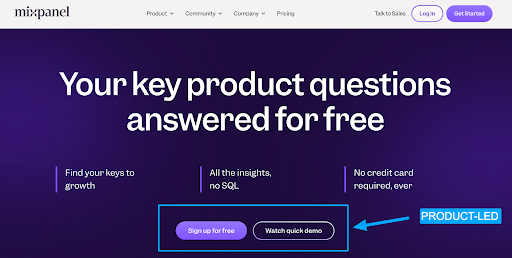

B2B Ad Examples by Revenue Model:
Sales Led
Product Led
How to build a full-funnel B2B Advertising Strategy
Now that you know how B2B differs from B2C.
How do you build a full-funnel B2B advertising strategy?
Full-funnel refers to building a strategy that covers all touch points along the customer journey.
This means advertising to individuals who are (e.g. Eugene's Schwartz Stages of Awareness):
- Unaware = have no clue they even have a problem in the first place (ex: blissfully mismanaging customer relationships)
- Problem Aware = know they have a problem but are not sure how to solve it (ex: realize managing customer relationships is important but don't know how).
- Solution Aware = need help deciding on the right solution (ex: should I use Google Sheets, a filing cabinet 😂 or a CRM?).
- Product Aware = know of your brand/product but not sure if you're the best option (ex: comparing CRM software; Salesforce vs HubSpot vs Pipedrive).
- Offer Aware = know of your brand and exactly how you can help but need some nudging (ex: pricing discounts, better contract terms, customer references).
- Most Aware = Existing customers, familiar with your brand and working with you (ex: referral program).
Understanding your prospects' stage of awareness allows you to create messaging, and offers that better resonate with where they are in the customer journey.
It helps to have a model (think of it like a map) to make complicated topics simple.
We’re going to use The Five Stages model covered in our course Building a Paid Media Program.
Here’s how it works:
Based on the stage; the outcome, awareness level, offers, tactics, and KPIs differ.
- Outcome = the end goal you're trying to achieve in each stage.
- Awareness = the familiarity level of your brand/product/solution.
- Offers = what you're providing your target audience in each stage.
- Tactics = how you're going to actually execute your strategy per stage.
- KPIs = how you're going to measure success in each stage.
Let's dive into examples for each stage so you really understand!
The Five Stages Model
Stage 1: Create
Stage 2: Capture
Stage 3: Accelerate (Sales Led) / Activate (Product Led)
Stage 4: Revive
Stage 5: Expand
The Five Stages model allows you to plan across all the lifecycle stages past initial conversion.
Ultimately no one knows for certain where someone is in their buyer's journey and everyone moves through it at different speeds. Use your best judgment.
If you're confused on which stage someone would be, remember the target audience's level of awareness dictates the stage they fall under.
Which stage should you invest in?
Generally speaking if you want to maximize ROI in the short-term you should work from the bottom of the Five Stages and move towards the top (Expand → Create).
You don't have to build a full-funnel strategy at once, take it one stage at a time.
Putting The Five Stages into practice
- Decide on which stage you want to focus on based on the outcome you’re after. If you have a smaller budget (ex: < $5,000/month) focus exclusively on one stage first.
- Once you’ve decided on the stage fill in your budget, and leading + lagging KPIs. If you’re unsure of what KPIs to select refer to Module 5- Lesson 1 of Building a Paid Media Program.
- Next decide on which channels you’ll advertise on to reach individuals in this stage and how you’ll target them and exclude the wrong audience. If you’re unsure of what channels to advertise on, refer to Choosing the BEST channels.
- Finally decide on what offers you’re going to promote in these channels for this stage (the offers listed above are only examples to give you ideas).
- If you’re targeting multiple stages repeat steps 1-4 for each.
Click here to become an AdConversion student and get free access to The Five Stages planning template in Module 2 - Lesson 1 where we cover how to build your paid media strategy in depth.

After you’ve filled in The Five Stages planning template you now have your strategy in place and can easily move into execution and start assembling your campaigns, creatives, and messaging.
What are the BEST B2B advertising channels?
The obvious answer is where your audience hangs out online!
But not all channels are equal, some are more effective at certain stages.
Most channels can be grouped into these 5 primary categories ↓
How to decide on the best channel?
There's four key criteria to consider when deciding on a channel:
- Targeting options
- Media cost
- Reach
- Policy
Let's dive into each ↓
If the channel you’re considering meets all four of these criteria then you should consider running a test campaign for $100 to get your real average CPC & CPM.
Recommended Channels by Stage
Based on my experience these channels work best for each stage:
(Use this as inspiration not restriction)
Let this be a guide to help you get started, take what serves you and abandon the rest.
Test what works for you until proven otherwise.
Advice from 20 B2B advertising experts
One of the best parts about being in B2B is the quality of marketers in this space.
We asked 20 B2B advertising experts:
What’s 1 tip you’d share with new marketers getting into B2B advertising?

50+ Ad Specs for The Top 10 Ad Platforms
Have you ever wondered what dimensions does that ad require? 🤔
Then started searching to find the answer? (same here lol)
To save you (and ourselves) trouble, we gathered the most popular ad specs across 10 channels in one place:
- Google Display Ad Specs
- LinkedIn Ad Specs
- Twitter (X) Ad Specs
- Quora Ad Specs
- Reddit Ad Specs
- YouTube Ad Specs
- Google Discovery / Demand Gen Ad Specs
- TikTok Ad Specs
- Meta Ad Specs
⭐️ Bookmark this article and refer back to it when you need ad specs.
Google Display Ad Specs
Source: support.google.com
Browse examples at adstransparency.google.com
LinkedIn Ad Specs
Source: business.linkedin.com
Browse examples at: linkedin.com/ad-library/home
X (Twitter) Ad Specs
Source: business.twitter.com
- You can request to have video lengths increased up to 10 minutes
- Carousel can use images or videos but must be in the same aspect ratio (ex: 1:1 or 16:9)
Quora Ad Specs
Source: image ads, video ads
Reddit Ad Specs
Source: reddit.my.site.com
* Headlines will be truncated to 100 characters on mobile/mobile web for the conversation placement.
Youtube Ad Specs
Source: support.google.com
Browse examples at adstransparency.google.com
Google Discovery / Demand Gen Ad Specs
Source: support.google.com
Browse examples at adstransparency.google.com
TikTok Ad Specs
Source: ads.tiktok.com
Browse examples at library.tiktok.com/ads
Meta Ad Specs (Facebook/Instagram)
Source: business.facebook.com
Browse examples at: www.facebook.com/ads/library
Resources for Mastering B2B Advertising
Hope you found this ad specs article useful!
If you’re serious about mastering B2B advertising then you definitely need to join 1,000+ B2B marketers leveling up their paid advertising skill sets in AdConversion.
Here’s 4 reasons why you should consider joining. Every one of our on-demand courses are:
✅ 100% free access.
✅ Taught by vetted industry experts.
✅ Have workbooks, resources, and templates.
✅ Less than 10 minutes per lesson.
We believe every marketer should know how to scale paid ads so they can:
• Scale their ideas
• Level up their careers
• Make a positive impact
Click Here to Join 1,000+ B2B Marketers Today and start leveling up your advertising skill set.
Takes < 90 seconds to sign up (seriously I timed it 😂)
People Also Ask
How often do ad platforms update their ad specifications, and how can I stay informed about these changes?
Ad platforms periodically update their ad specs to accommodate new features or policies. To stay informed, regularly check the official guidelines of each platform and subscribe to their newsletters or blogs for updates.
What are the common pitfalls to avoid when designing ads to meet platform specifications?
Common pitfalls include using incorrect dimensions, exceeding file size limits, and neglecting safe zones, which can lead to ad disapproval or poor display. Always adhere to the latest specifications and test your ads across devices.
How can I ensure that my ad creatives are optimized for both desktop and mobile viewing?
Design responsive ads that adapt to various screen sizes. Utilize platform-specific preview tools to see how your ads render on different devices, ensuring readability and visual appeal across all formats.
Are there tools available to streamline the creation of ad creatives that comply with multiple platform specifications?
Yes, tools like Canva, Adobe Creative Cloud, and Figma offer templates tailored to various platform specs, simplifying the design process and ensuring compliance.
How do ad specifications impact the performance and effectiveness of my advertising campaigns?
Adhering to specifications ensures that your ads display correctly, preventing issues like cropping or distortion. Properly formatted ads enhance user experience, leading to better engagement and higher conversion rates.

3 Powerful Strategies For Scaling SaaS Google Ads You Need To Know
Google Ads is a blessing and a curse.
You're blessed with intent and cursed with scale.
It’s a powerful channel for scaling pipeline for SaaS startups but low search volume is a challenge.
In this article you’re going to learn 3 powerful strategies for scaling your SaaS google ads further.
This won’t solve your limited search volume issues that's just the nature of your target keywords and B2B SaaS but these strategies will help you squeeze more performance from your account.
Let’s dive into it 👇
TABLE OF CONTENTS
- Strategy #1: Broad Match Discovery
- Strategy #2: Advertising outside of English
- Strategy #3: Industry campaigns
Strategy #1: Broad Match Discovery
Before you click away I’m not talking about using broad match in the traditional sense.
Where you let Google show your ads for WHATEVER they think is relevant.
Broad match discovery is where you combine broad match keywords AND an audience.
It essentially means you’re giving Google the flexibility to show your ads for whatever they feel is relevant but within the confines of your targeted audience.
I would not recommend testing this approach unless you have:
- Strong negative keyword lists
- Proven converting phrase match keywords
- Significant conversion volume (> 15/month)
The benefit is you get to scale your top keywords safely past phrase match.
How to implement broad match discovery:
Step 1: Find proven converting phrase match keywords
Review your performance across converting phrase match keywords to identify which you’re going to prioritize testing with broad match discovery.
Don’t rely on “total conversions” make sure you’re viewing performance by keyword based on the custom metrics that matter for your business (ex: Demo, Trial, SQL, SAL, Opp, etc).

Once you’ve identified some worthwhile keywords it’s time for step 2.
Step 2: Brainstorm your targeted audiences
Google has 5 audience types you can leverage for targeting in your search campaigns.
- Your data = website visitors or contact lists
- In-market = people actively researching a given topic
- Life events = people who’ve accomplished a life milestone (ex: create a business, get married)
- Detailed demographics = industries, company sizes, education level.
- Affinity = people who are interested in a certain topic

You can use a mixture of all these different types of audiences to layer on top of your broad match discovery campaigns.
If you’re dealing with < 500 searches/month for your keywords I recommend clustering a minim of 10-15 audiences on top of your campaigns to help with delivery.
Step 3: Setup a campaign experiment
The safest way you can test broad match discovery is in a 50/50 experiment alongside your top converting phrase match campaign.
You can easily AB test in Google Ads using the campaign experiments feature.
Located under Campaigns > Experiments
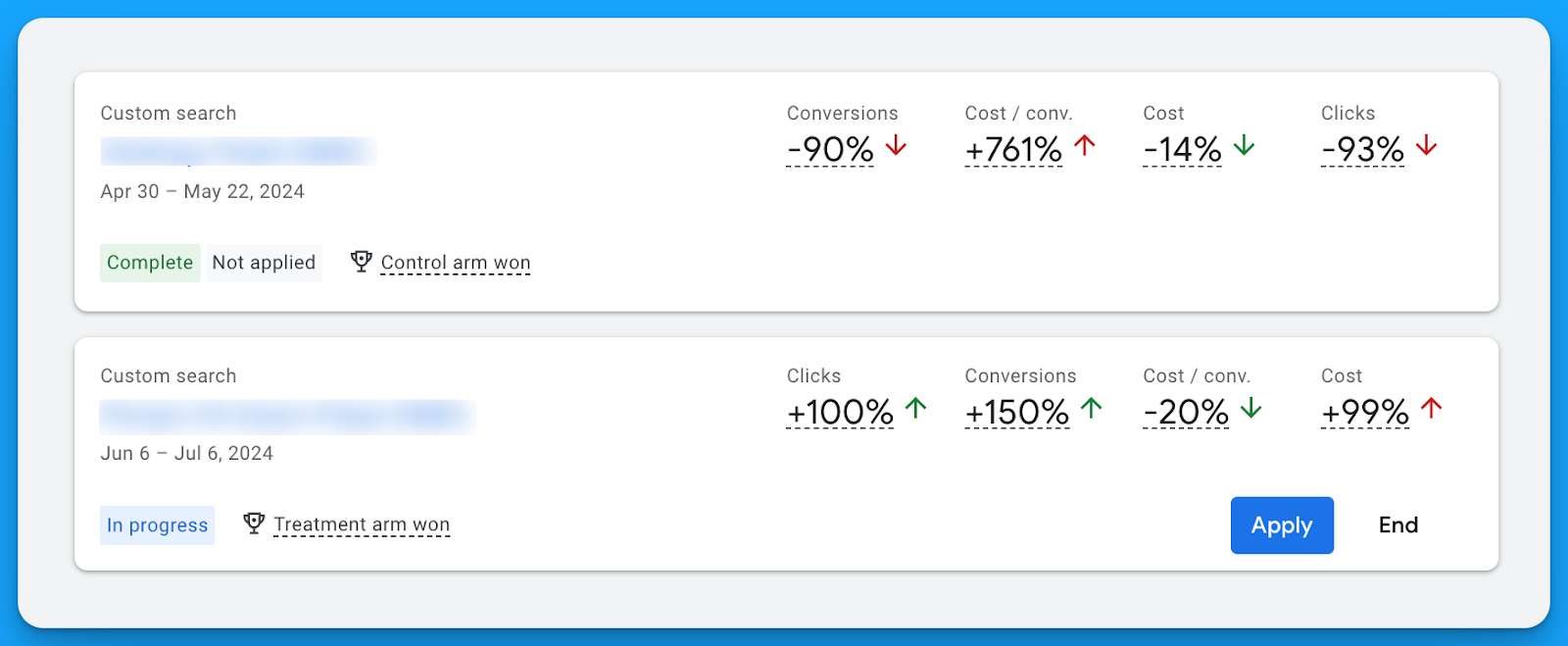
Using this feature build an experiment splitting the traffic by 50% for your original campaign vs the experiment version using broad match AND the targeted audiences you brainstormed in step 2.
Strategy #2: Advertising outside of English
English is the most competitive language in the world with the majority of advertisers.
We’ve seen reductions of up to 70% in our average CPC targeting other languages.
If your company has the resources to sell in multiple languages – take advantage of localization!
Localization campaigns are when you target keywords, write ad copy, and design landing pages that all are in your audience's native language (ex: Spanish, German, Portuguese).
You’ll reap the benefits of lower costs due to less competition.
The downside however with localization is search volume.
If you’re already advertising in English outside of North America and finding success, definitely recommend testing this strategy.
How to implement localized campaigns:
Step 1: Find proven converting phrase match keywords
Review your performance across converting phrase match keywords to identify which you’re going to prioritize testing with broad match discovery.
Don’t rely on “total conversions” make sure you’re viewing performance by keyword based on the custom metrics that matter for your business (ex: Demo, Trial, SQL, SAL, Opp, etc).

Step 2: Brainstorm your targeted languages
Ask your internal team what languages your sales team is able to sell in.
Based on your options make a list of potential languages.
Next, if you’re advertising outside of North America, review the top performing countries and identify their local languages and see if you have the internal resources that can speak that language.
If you can’t sell in this language then this strategy won’t make sense.
Step 3: Hire a local translator
Don’t make the mistake of relying on Google Translate to perform the bulk of your translation.
You’ll want to hire a translator that grew up in the area in which you want to advertise.
For instance, if you’re advertising in Portuguese.
The dialect for Europeans living in Portugal and those living in Brazil is very different.
A local Brazilian can tell if it’s not their dialect just like a native Portuguese.
I recommend hiring locals off Upwork can be as low as $12/hour depending on the language.

These translations will make a world difference in your ad and landing page copy.
Strategy #3: Industry campaigns
Industry campaigns can be great for coverage and quality.
This is where you’re going to bid on a desired keyword and add a related industry term.
For example, let’s say bidding on the keyword “crm software” here’s how you can modify this keyword to make it industry specific:
- healthcare crm software
- crm software for fintech
- crm software for small businesses
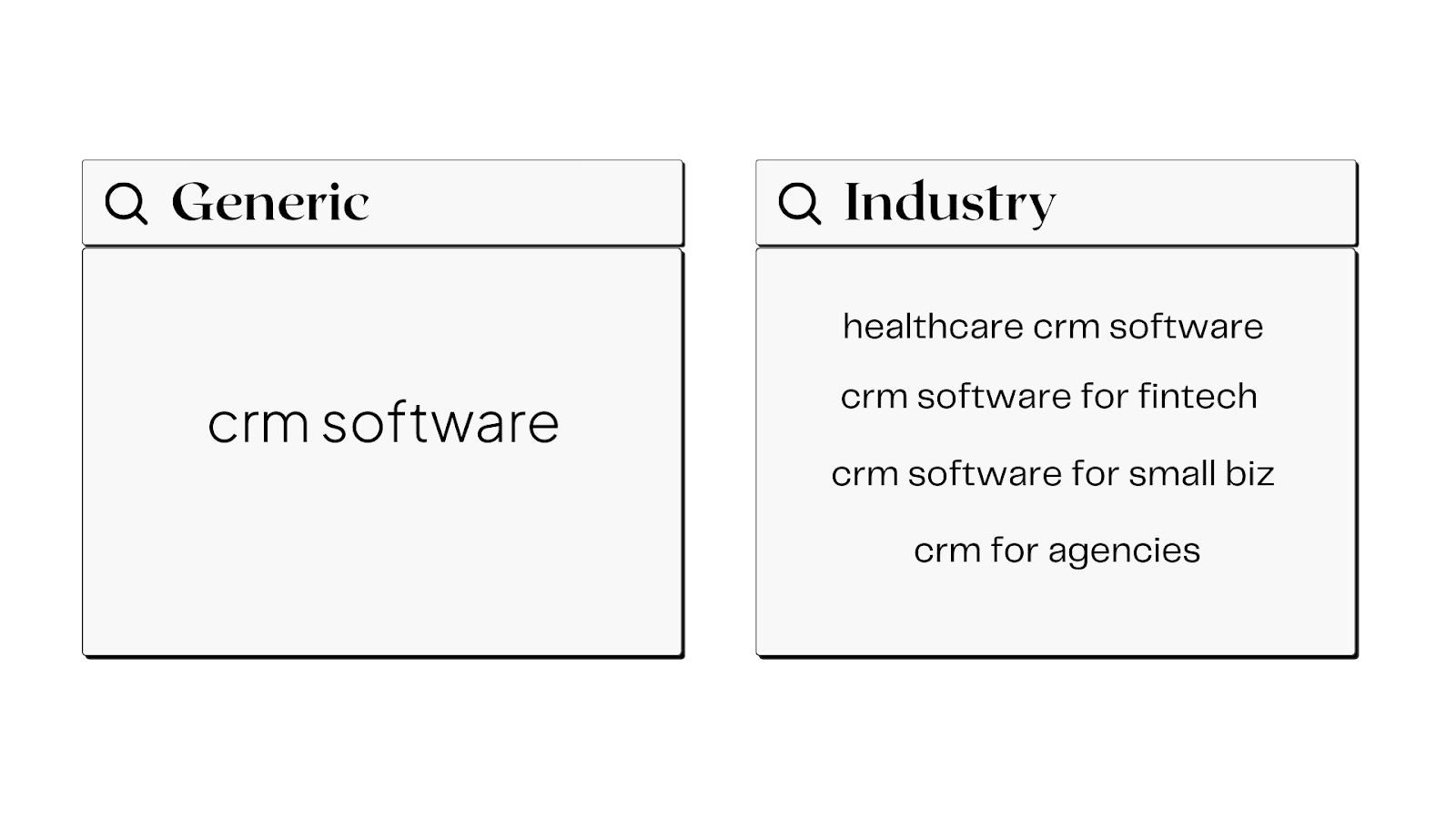
The benefits of industry campaigns:
- Personalized ad copy that can yield greater CTRs
- Higher quality leads due to a more qualified search term
- Lower cost per click prices due to less competition
The downside however is search volume (the constant struggle of Google for SaaS 😅).
How to implement industry campaigns:
Step 1: Find proven converting phrase match keywords
Just like the other strategies we’re going to identify proven keywords first that we can create industry variations for.
Step 2: Brainstorm your target industries
Run a win rate analysis in your CRM and understand which industries have the shortest sales cycles and largest deal sizes? Based on your findings, prioritise the industries in which you want to target.
Step 3: Build and prevent keyword overlap
Once you have your keywords and target industries you’re ready to build your campaigns.
Make sure to add your industry terms as negative keywords in your generic non-brand campaigns.
Otherwise you can have people seeing your generic ads for your industry terms.
Hope you found this article helpful!
Best of luck scaling your Google Ads campaigns for your SaaS.
From Clicks to Conversions: Master Google Ads for B2B 🔥
If you want to become a Google Ads pro, check out our free B2B Google Ads courses, where you'll learn how to launch, optimize, and scale your campaigns to drive pipeline and revenue.

Here's what you'll learn in each course:
⚙️ B2B Google Ads 101 - How to Launch Dangerously Effective Campaigns for Beginners
- The Googleverse: The Game You're Playing & How To Win
- Measurement: How to Make Sure You're Profitable
- Targeting: How to Show Up For the Right Searcher
- Planning: Putting It All Together
🎯 Google Ads 102 - How to Clicks Into Profit
- Visibility: How To Find the Hole Sucking Profits
- Workflows: How to Optimize On a Daily, Weekly, Monthly & Quarterly Basis
- Experimentation: How to Test & Automate Profitability
- Troubleshooting: How To Solve Inevitable Problems
🚀 Google Ads 103 - How to Scale Google Ads For Advanced Advertisers
- Methodology: How to Vertically Scale Google Ads From A-Z
- Campaigns: Scaling Horizontally Through Campaign Themes
- Channels: Scaling Outside of Paid Search
Click Here to Join 1,000+ B2B Marketers Today and start leveling up your advertising skill set.
Takes < 90 seconds to sign up (seriously we timed it 😂)
People Also Ask
How can I effectively measure the success of my Google Ads campaigns for SaaS products?
Utilize key performance indicators (KPIs) such as conversion rates, cost per acquisition (CPA), and return on ad spend (ROAS). Implement tracking tools like Google Analytics to monitor user behavior and campaign performance.
What are the best practices for creating compelling ad copy that resonates with my target audience?
Focus on highlighting unique selling propositions (USPs), addressing customer pain points, and including clear calls-to-action (CTAs). A/B testing different ad variations can help determine what resonates most with your audience.
How can I optimize my landing pages to improve conversion rates from Google Ads traffic?
Ensure landing pages are relevant to the ad content, load quickly, and have a clear, concise design. Incorporate strong CTAs and minimize distractions to guide users toward the desired action.
What role does keyword research play in the success of Google Ads for SaaS, and how should I approach it?
Keyword research is crucial for targeting the right audience. Use tools like Google Keyword Planner to identify high-intent keywords relevant to your SaaS product, and consider long-tail keywords to capture more specific search queries.

Become a part of the best B2B Ads community ❤️








%20-%20new%20v2.png)



























